~'83
~'86
~'89
~'92
~'95
~'98
~'01
~'04
~'07
~'10
~'17
~'20
~'23
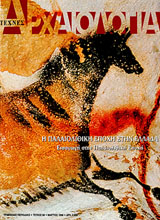
The molluscs are organisms who live in defined ecosystems. Their presence in an archaeological site reveals at least a part of the activities of the inhabitans. If the sea-shell is punched, then it has probably been used as an ornament or implement. As regards the Greek area in particular, our information on the importance of sea-shells is limited. From what we know until today, sea-shells have been mainly used for nutrition and decoration, while their use as tools has not been evidenced as yet. Their significance, especially for nutrition, will be better elucidated, when the relevant material from the cave of the Cyclope on Youra island will be published. The study of the material found in the Greek area leads to the conclusion that the species used and their purpose of use present both sequence and continuity.
From the Medieval period on, the Bible was the source of all theories concerning the origin of man and Prehistory. The impulse for a more realistic interpretation of Prehistoric tools was given by the explorations of the 15th and 16th century. They brought to light the existance of primitive people who were practising hunting and collecting and were using stone and bone tools. Later the observation of the succession of the finds containing strata started, a fact which introduced the dimension of time in the study of the History of Nature and man. The acceptance of the contemporary presence on earth of man and the mammals -which had been considered as ante diluvium- as well as the reconciliation of Natural Science and Archaeology were achieved in the mid-19th century by the French J. Boucher de Perthes. In the second half of the 19th century the promotion of Palaeolithic Archaeology is owed to the excavations at the caves and rock-shelters in NW France. The research objective was to define the evolution of the Palaeolithic and its chronological framework, The work of E. Larnet and H. Christy but mainly that of G. de Mortillet contributed to this direction. The first half of the 20th century is marked by the activity of H. Breuil who studied a great number of Palaeolithic works of art. Together with D. Peyrony they re-examined the archaeological material from old excavations and established the subdivisions and the cultural sequence of Late Palaeolithic. In the second half of our century F. Bordes, who was the first to use Statistics, invented a method for studying tool groups and introduced a theory, according to which the similarities or differences of the tool groups are owed to cultural and chronological reasons. He also contributed significantly to the development of Experimental Archaeology and especially to the sector of the technology of stone chipped tools. A. Leroi-Gourhan advanced the ethno-archaeologic study of Palaeolithic sites and applied to his excavations the method of the horizontal uncovering of strata: he also engaged himself with Palaeolithic art. "New Archaeology" turned towards Palaeolithic Archaeology, by proposing the theory of the functional interpretation of stone tool groups, which, however, was not successful in its application. Finally, the Soviet school promoted the study of habitation and dwelling structures by applying in a wide range the method of the horizontal uncovering of strata as well as the research of the lithic use-wear.
The research objective of the Palaeolithic is the representation of the way of man's life in his natural environment, the natural and human sediments as well as the archaeological material which comes to light in the caves, rock-shelters and open air sites -which have functioned as habitation and activity locations- function as sources. The research methodology includes two phases: the fieldwork and the treatment of the material in the laboratory. The interdisciplinary cooperation of many specialists, such as archaeologists-prehistorians, geologists, sedimentists, palaeobotanologists, palaeoontologists-archaeozoologists, is the necessary prerequisite for a successful research. The fieldwork starts with a survey which seeks to locate as many sites as possible, to determine their nature and to evaluate their significance. It is followed by an excavation trench which aims at: the establishment of a first stratigraphic sequence; the estimation of the number and arrangement of the human sediment strata; their chronology and the abundance or not of the archaeological material. The fiedwork leads to the proper excavation of the site, which is performed either according to the method of the vertical stratigraphic trench or according to that of the horizontal uncovering of strata. The laboratory treatment of the material completes the data of the first phase and contributes to the solution of three main problems; that of dating, of the representation of the natural environment and of the human habitation and activity. It employs methods of relative and absolute dating, such as Carbon 14, the K40-A40 method and thermoluminescence. It analyses the sediment samples in order to elucidate the natural and mainly the climatologic factors, effective during the period of the site inhabitation. It examines the vegetable fossilized remnants (pollen, seeds) and the bone residues of animals in order to determine the flora and fauna of the period. Both flora and fauna reflect the climatologic circumstances of the period. Finally, it studies the archaeological material coming to light, which, in the case of a Palaeolithic site, includes dwelling components (hearths, walls, trenches, etc.), groups of implements made of stone or bone raw materials, burials, ornaments and works of art.
The Palaeolithic commences around 2.6 million years in Africa, with the appearance of the first stone implements chipped by man, and concludes in 10,000 years, a period which is characterized by the melting of glaciers and the steady improvement of climate. It is divided in three stages, the Early, Middle and Late Palaeolithic which reflect the technologic development of tools, although often they coincide with the paleoanthro-pologic evolution and the climatologic changes. The Early Palaeolithic (2.6 million - 200,000 years) starts in Africa with the Oldowan cultural phase, which is characterized by implements of the chopping type, and is continued in Europe with the Acheulean phase, the typical tool of which is the biface, that is developing simultaneously with the Clactonian and Tayacian phase. The Middle Palaeolithic (200,000-35,000 years) is characterized by the Mousterian cultural phase which expands over the broader European area and the Middle East. The flake technique prevails and its most typical type of implements are the points and the scrapers, while at the same time the Levallois technique is developed. The metaphysic concern of man is expressed by the burials, which then appear. The Late Palaeolithic (35,000-10,000 years) exhibits many novelties, which are connected with the appearance of Homo sapiens. The stone implements come to perfection by the invention of the blade technique. Characteristic types of tools are the end-scraper and the burin. New materials of animal origin, such as bone, mammoth tusk and deer antler, are used now for the making of implements. The aesthetic criterion is evolved and is expressed in the development of ornaments and in the appearance of art which culminates during the same period. The cultural sequence of the Late Palaeolithic presents a great variety, depending on the geographic region. However, in the broader European area the Aurignacian, Gravettian, Solutrean, Magdalenian and Epigravettian phases prevail, which, to a certain extent, also occur in Greece.
Caves, rock-shelters and open air sites were the places of settlement of Palaeolithic man. Depending on the character of the settlement we distinguish the permanent or camp-base, which was comprising mainly dwellings, the killing-sites as well as the butchering-sites. We have a very good knowledge of the function of a broader area of habitation and trafficking of human groups only as regards these regions which present a dense habitation and have been thoroughly studied. There, already since the Middle Palaeolithic, a series of small, clearly defined territory exists, each comprising a main permanent or camp-base and a row of satellite sites around it, where other activities, such as hunting, collecting, working of stone raw materials, were taking place. The structural element of dwellings which have been preserved are protective low walls, heaps of stones, hearths, pits, pave surfaces, piles of mammoth bones and tusks, etc. The oldest remains of dwellings came to light at the locations Olduvai and Melka Kontoure in Africa and were dated around 1.7 million years ago. In Europe, sites of Early Palaeolithic dwellings have been located in France (Solheilac, Terra Amata, Lazaret) and in Italy (Isemia, La Pineta), while many other dwellings of the Middle Palaeolithic have been located in the broader European area (Molodova, Fontmaure). The inhabitation of caves has also produced structures which offered to man shelter from cold and humidity. The Late Palaeolithic presents a great variety of materials and forms of dwellings. In West Europe stone was used for pavements and low protective walls, while the superstructure was made from perishable materials, such as wood. The dwellings had a circular form and lied on the surface of the ground (Pincevent. Etiolles, etc). In East Europe animal materials were used, such as mammoth tusks. The form of structures, of large dimensions in general, varied, while most of the dwellings lied almost under the ground (Meziritch, Kostenki). In Greece, dwelling structures of the Late Palaeolithic came to light at the site Kleidi in Epirus.
The economy of the Palaeolithic period was based on the direct exploitation of nature and the close environment, which supplied the animal, vegetable and mineral raw materials, necessary for nutrition, tool-making, energy production, building of dwellings, clothing, orndments and art. The major economic activities were hunting, collecting and fishing. Hunting was the main way of approaching the animal world. During the Archaic Palaeolithic cadaver devouring and hunting, primarily of small animals, coexisted. With the appearance of Homo erectus the hunting methods, based on the use of fire and new weapons, facilitated the systematic hunting of big mammals. The climate aggravation, which commenced during the Middle Palaeolithic, resulted to the elimination of species and thus to the specialization of hunting, which also continued in the Late Palaeolithic. The introduction of animal materials in technology caused a real revolution: now the bone spearheads and the spear throwers offered new possibilities. Collecting was primarily directed to vegetable materials, from which only the pollen, seeds and charcoals supply information on the vegetable world, although they do not specify the preferences of Palaeolithic man. Molluscs were also collected for nutrition as well as for decoration. The bone remains offish and their representation in art prove the exercise of fishing in lakes and rivers but also in the sea. However, this activity would be fully developed only towards the end of the Late Palaeolithic. Finally, the production, use and control of fire significantly changed the potentialities of man and his relation with environment. The oldest traces of fire, in the form of hearth, were located in more than one European sites and were dated around 400,000 years.
Man started to bury the dead during the Middle Palaeolithic. The geographic distribution of graves from this period is quite broad. Burial sites have been located in West Europe, Near East and in Asia, as far as Uzbekistan. The oldest of them have been found in Skhul and Tabun in Near East and are about 120.000 years old. The practice of burial is the same for both sexes: a trench is dug, the corpse is covered with a slab, burial offerings -tools, animal horns or even flowers- are placed by the dead. The burials of the Late Palaeolithic have been better preserved, therefore they are more numerous. They occur in every cultural phase and are distributed throughout Europe, from Siberia (Malta) to West France (Cro-Magnon, La Madeleine). During the Late Palaeolithic special attention was paid to the construction of the grave. The burials vary, being individual or group ones, while examples of double or triple graves occur. The body orientation and its position present a wide variety. All burials contain offerings, however, in certain cases these offerings are significantly numerous as at the site Sungir in Russia. In Greece, Palaeolithic burials are unknown as yet.
Ornaments appear in the beginning of the Late Palaeolithic. They mainly come from burials but also from dwellings and comprise natural finds and shaped articles. Animal teeth are the oldest ornaments and come from certain animals such as fox, wolf, bear. The canines and incisors are prefered, which bear a hole at the fang and an incised decoration. Sea-shells form another important group, Paleolithic man was collecting fossilized sea-sells, however live species were always more numerous. The presence of sea-shells is indicative of emigration, exchange and broader contacts of the Palaeolithic population. The shaped objects comprise pendants and beads. The pendants are rare, they appear in a variety of shape and have an incised geometric or realistic decoration with the representation of animals, reptiles and birds. Figurines, mainly female, also belong to pendants. The beads have a spherical or hemispherical shape and are made of animal raw materials. They are found by thousands in Palaeolithic sites and they rarely copy forms of abstract representations of Palaeolithic art. In Greece, ornaments occur in sites of the Late Paleolithic, such as at Kleidi in Epirus.
Art appears in the Late Paleolithic and reaches its climax in the Magdalenian. The works of art which have survived represent only a part of the Palaeolithic artistic production and especially the one which is made of hard natural, or animal material. The works of art are divided in two categories: the movable works of art, which comprise tools, weapons, pendants and incised slabs; and the art of caves, which includes works of sculpture, engraving and painting. Palaeolithic art was developed and expanded in the European area exclusively. In regions such as the Francocantabrian zone it occurs frequently, while elsewhere it appears sporadically or it is absent. The art of caves prevails in Western Europe, while in Eastern Europe the mobiliary art is found in abundance. The subject repertoire comprises animals, the horse and bison having the leading role. Human figures, hands and signs also appear. Narrative representations or compositions are absent as well as any attempt to indicate landscape. All the known techniques have been used in yellow, orange, brown and black colours, while green and blue are excluded. According to A. Leroi-Gourhan, Palaeolithic art presents four stages of evolution; in the preliminary stages the figures are modelled in a completely schematic and linear way, while later their caracteristics start to become standard. The artist follows the proportions of the visual reality, but still the subjective motion prevails. The works of prime are full of realism, power and expression; the combination of painting, engraving and relief is now developing. The theories concerning the interpretation of this art have followed the evolution of the anthropologic thought from the 19th century until today. In Greece, Palaeolithic art is unknown as yet.
The Quaternary, the most recent and short geologic period in the Earth's 4.5 billion years long history, is characterized by the appearance of Man and the large glaciers. Hence sedimentation is directly related to cold climatic conditions and to rapid changes in sea-level. These in turn are related to alternations of short climatic cycles (cold-warm, glacial and interglacial stages). The theory of glaciers was first developed in the Alps, where four major glacial stages (Gunz, Mindel, Riss. Wurrn) were discribed. In Greece, traces of glaciers have been identified, among others, in Olympus, Pieria and Athamania mountains. Glacier accumulation and glacial processes are directly related with the volume of the ocean water and consequently with variations in sea-level. However, fluctuations of eustatic sea-level do not depend only on climatic changes, but also on the isostatic and tectonic processes active in each region. In Greece, traces of Pleistocene marine deposition or erosion have been identified in many sites along the external Aegean Arc (Ionian Islands, W. Peloponnese, Crete, Dodecanese)- During Holocene there was an intense tectonic activity in the Eastern Mediterranean. In Greece this tectonic activity was evident, either as uplift like in NW Euboea, or as subsidence, as in Argolid.
Knowledge about the environment during the Pleistocene is still quite limited, especially as Environmental Archaeology is only recently participating in this exploration. All the branches of Archaeobotany are involved and, amongst others, the main ones being Palynology, Palaeoethnobotany and Wood studies. Each branch brings in a different source of information, in as much as, all and each one separately, contributes, in different and complementary ways, to the understanding of the environment of Prehistoric man. The area of exploration is not only understanding what was the vegetation like, but also grasping what was man's behaviour in and towards that environment and how the dialogue between man and the environment evolved through time. This study has used, mainly, published pollen data and the Palaeoethnobotanical investigation of Franchthi cave in Argolid. Our knowledge about the flora of the Pleistocene is still far from complete. There is a great need for studying more thoroughly radio-carbon dated pollen samples and involve all branches of Environmental Archaeology, in order not only to understand the vegetation succession between and within glacials, interglacials and interstadials, but also to conceive how man interacted with his environment through space and time.
The study of humanity fascinates humans. The main question we ask is this: why are humans so different from their closest relatives? In this paper the hominid species of the last 5 millennia are treated. Also, their hominid adaptations are described giving primacy to bipedal walking which predates the expansion of the brain. What characters make Australopithecines, which are considered a stable evolutionary package? A pattern, that does not exist today, but is intermediate between apes and humans. The problem of assigning fossils to Homo habilis is debated today in the Anthropological circles. Are they one highly dimorphic species, or two different species, one Homo habiiis and the other still unnamed? What follows them is a stable and long lasting species, Homo erectus, that was to become the first human type to spread from Africa to Asia. Homo erectus was either followed or overlaped in time by the "archaic" Homo sapiens, a variable species whose better known representatives are the Neanderthals. These late Neanderthals were highly evolved humans but probably not our direct ancestors. The disappearance of Neanderthals from Europe and W. Asia (Levant), may have had to do with the appearance of the anatomically modern Homo sapiens, a species far superior behaviourally.
In Europe, the Quaternary, a period which started around 1,8 million years ago -according to a generally accepted, although much debated, theory-, is characterized by significantly extensive glacial and mid-glacial climatologic phenomena. The study of fauna, which was directly affected by climatologic conditions, contributes to the understanding of man's environment during the Palaeolithic period. In the Heliadic area, a great part of our information on the Quaternary comes from Palaeontology, a science which investigates life in the past. Thus, we possess essential information on the animal species (morphology, biometry) and their evolution. However, the connection of Palaeontology with Prehistory is only at its beginning, since relevant, significant analyses -with the exception of studies referring to the rocky shelters of Epirus during the Early Palaeolithic- are for the time being almost absent: those concerning man s management of the environment, methods of obtaining games, the fauna composition in the settlements, the periodic choice of animal species, the age of comestible animals, the exploitation of animals as raw materials for tool equipment, the choice of hunting spots and temporary residence. The chief game of man and carnoyores were the herbivorous animals; their presence in the encampment is related to the climatologic data of each period and to the geomorphology of each site. For example, deers are abundant in the fauna, especially that of the Upper Palaeolithic. The elk appears sporadically, while the megaceros occurs in Middle Palaeolithic strata. The mammoth and the hairy rhinocerus appear rather incidentally (e.g. Drama's basin), as well as in a quite south latitude (e.g. Megalopolis basin). The wild goat is an animal of the inaccessible, rocky regions (e.g. Epirus, Franchthi in Peloponnese), while the horse requires flat plains (Drama's basin in Thessaly). The carnovores (bears, wolves, foxes, lions, hyaenae of the caves, panthers, wild cats, lynx, etc) either were hunted by men or killed by their game, a well known picture of the cave fauna. In this article, on the basis of the available data, we try to follow the evolution of species from the Lower to the Upper Pleistocene and to present the ecologic framework of each period, regardless of whether or not the bones were found in archaeological contexts.
On the initiative of the Archaeological Service of the Fribourg canton (Switzerland, in charge: D. Ramseyer) an International Meeting was held at Marigny (Chalain Lake France) on the 29th and 30th of September 1994, in cooperation with the Direction of Conservation of Museums of Jura Region (France, in charge: M.- J. Lambert). The topic of the meeting was: Archaeology and Erosion. Protective Measures for the Preservation of Lakeside, Settlements. The organizers' objective was to facilitate the contact between specialists, in conservation on the one hand and in preserving sites of ecologic and archaeological significance on the other. In this meeting the first of its kind in Europe, expert scientists were participating who had taken protective measures for stemming lake-shore erosion and preserving archaeological sites in riparian, underwater and marshy areas. The significance of these Prehistoric sites is unique, both for the international cultural heritage and science, since the objects and architecturai structures made of organic materials, mainly wood, have been preserved in an excellent state due to the humid conditions of their environment; thus, the method of dendrochronology can be successfully applied for the accurate dating of these finds. The scientific reports and discussions were targeting to the evaluation of the preservation efforts and to the improvement of the systems tested so far. Even if the results were not always positive, their presentation helped so that the same mistakes to be avoided in the future. The evaluation of the methods used in various countries and under different environmental conditions proved that each case should have been thoroughly studied before taking any measures; and also that their efficiency should have been sooner estimated. The experience obtained so far is based on experimentations which are, however, susceptible of criticism and improvement. Needless to say, that it is extremely difficult to be decided to which of the numerous sites, endangered by erosion, must be given the first priority.
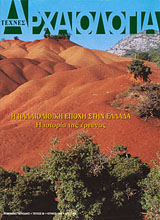
Eric Higgs came to Archaeology after an earlier career in a different subject. Being at the Museum of Archaeology and Ethnography in Cambridge, he was attracted to Prehistory, and particularly the Palaeolithic. In the late 1950's much work had been done on the classi-ficasion of the Palaeolithic in Europe, which was based largely on available data from central and western Europe, since at this time there was only minimal evidence for Palaeolithic traces in Greece. Eric Higgs saw that there were obvious analogies between North Africa and the Greek region and proposed the theory that there might be evidence for Palaeolithic activity in Greece; and that Greece ought to form a geographical link between Africa and Europe. Thus, he started to research in order to locate Palaeolithic sites in Greece. The results of this survey were published in the Proceedings of the Prehistoric Society of England in 1964. The method applied was to comb the surveyed area, sampling whatever was relevant to the research. Higgs, with the eager support of Sotiris Dakaris, conducted excavations in the Agios Georgios area, north of Preveza, which produced flint finds and handaxes. The investigation continued during the period from 1962 to 1967, with surveys and excavations at Aspro-chaliko and Kastritsa as well as at Kokkinopilos. Higgs was able to establish and define chronologically the sequence of stone workshops in Epirus. Higgs' achievements, not only in Epirus, but in his whole approach to the field of Prehistory, received full recognition with his appointment in 1967 as Director of the British Academy's major research project on the Early Prehistory of Agriculture. Hjggs interpreted the context of his discoveries in the light of the present practice of seasonal migration, demonstrated by the Sarakatsani shepherds in Epirus. The interpretation principles which supported his ideas remain fundamental: it is essential, that is, the archaeological sites and the material which comes from them to be interpreted in terms of the environment to which they belonged; and imperative, as regards the Palaeolithic period, to be properly appreciated that the ancient environment would have been radically different from the present one. Also, that this interpretation should not be restricted to the immediate surroundings, but that it should be extended to the broader environment as an element of great significance. Higgs pioneering work gave the initial impetus to the study of Palaeolithic period in modern Greece. It is particularly in this respect that this issue of Αρχαιολογία και Τέχνες is a fitting tribute to Eric Higgs' achievements.
Palaeolithic research, being overshadowed by a brilliant, broader "classical" past, was only recently recognized as a self-sustained scientific branch of Archaeology. The Ephorate of Palaeoanthropology-Spelaeology is only two decades old, a time proven unequally effective. The dual character of the Ephorate as a public service and a recearch center (not enacted by law as yet) is both an advantage and a disadvantage: on the one hand we must apppease our collegues in other Ephorates of Antiquities that we are also civil servants and on the other we have to reassure our academic colleagues that we are also scholars. However, if the objective is an organized and effective dealing with a correct approach to the Palaeolithic in Greece, then the open-air sites, being an intergal element, must be supervised by only one institution for their protection, which will be reinforced with instituted competences and will retain, in any case, the right and capability to cooperate with the local Ephorates. The collaboration with foreign and Greek institutions will be fruitful, while the increase of the number of experts in this field is a permanent demand. Needless to say that the research subject in itself dictates the need for interdisciplinary and cooperative procedures on the base of the equality of the various specialities and the evaluation of priorities. As regards the research categories of the Ephorate in progress, they are the following: - Survey excavations which produced Palaeolithic finds and they were staffed in their cource by specialists in the Palaeolithic. - Long-planned projects and excavations with research targets on an iterdisciplinary base. - Cooperative programs with foreign archaeological schools. - Supervision of foreign schools programs or of other institutions. Now, that as it seems, the Palaeolithic in Greece has been founded as an itegral branch of the science of Archaeology, we hope to have the chance to prove it also practically in 1997 in a celebration for the 20 years of the Ephorate, which will be focused on its entire work during these years.
The interest in human habitation during the Palaeolithic period in Greece was first expressed in the second half of the 19th century by scholars of Greek antiquity (F. Lenormant), who had become sensitive to the issues of the appearance of man and the beginning of Prehistory, then in vogue among the intellectuals of West Europe. In the years between the two World Wars foreign scientists, but now prehistorians (H. Breuil, H. Obermaier, D. Garrod), in the framework of their research also became interested in Greece and specifically in its position and role in European Prehistory. During the same period the first excavations (Zaimi and Ulbrich caves) were carried out by the Austrian A. Markovits, which however did not attract the interest they deserved for a number of reasons. After the excavation at Seindi, Boeotia, in 1941, the investigation of the Palaeolithic was continued after the War, mostly within the framework of research programs orientated to later periods. In the sixties research was focused on mainland Greece and was mainly undertaken by foreign archaeological schools. The British worked in Epirus (Kastritsa, Asprochalico, Kokkinopilos and later Kleidi), the French in the Eleia plain, the Germans around the Thessalian Peneios river and the Americans in the Argolid (Franchthi). Among the Greek archaeoligists who became interested in the Prehistoric period, the name of D. Theocharis is distinguished. In recent years the activity of a new generation of Greek prehistorians, specialized in the Palaeolithic abroad, as well as the realization of a series of interdisciplinary research programs on Palaeolithic (Theopetra, Boila, Kalamakia, Kleisoura) by the Ephorate of Palaeo-anthropology-Spelaeology gave a new impulse to the research and opened new prospects of scientific cooperation. Finally, the 1st International Congress on "The Palaeolithic Period in Greece and in the Neighbouring Regions", which took place in loannina in September 1994, proved to be a milestone in the course of the relevant field. However, the progress of the research into the Palaeolithic in Greece will be successful only if the Palaeolithic period is included in the curriculum of Greek universities, the interdisciplinary groups are activated and the programs of cooperation and exchange with colleagues from the neighbouring countries are developed.
Palaeolithic archaeology in our country has remained until recently out of the limelight of research, in the universities as well as in the Archaeological Service. Some relevant efforts which started a few years ago, still remain in the initial stage. The systematic development of this scientific field requires the coordinated activities of the two main vehicles of archaeological research in Greece, that is the universities and the Archaeological Service.
The sling was originally used in the 7th millennium B.C. when writing was still unknown. The contemporary research has reached the conclusion that the propagation of the Neolithic way of life coincides with the wide diffusion of the sling's use. Clay or stone missiles of biconical, sphaerical of elliptical shape, weighing about 30 gr each, are placed in a leather or woven socket; two stripes, attached to its ends, allow the rapid rotation of the missile. As a result, when one of the stripes in let loose, the rotation energy is transmitted to the missile which thus is hurled in a speed of over 100 km/h. Most of the Neolithic missiles are biconical. Their aerodynamic cross-section decreases the air resistance and at the same time increases their range which can reach almost 500 m, that is much longer than the range of an arrow. About the end of the Bronze Age and during the successive historical periods lead missiles are made, which represent a technological achievement in the evolution of war methods. Archaeology cannot easily establish the use of the sling. A large amount of pebbles, found nearby the entrance to the small Protocycladic fortification "Korfari ton Amygdalion" on Naxos, has been interpreted by the excavator Christos Doumas - in relation with the destruction and devastation of the site in the second half of the 3rd millennium B.C. - as a result of enemy invasion. Similar is the case in another fortified settlement of the same period, in "Kastri" on Syros. At Sesklo, Thessaly, Christos Tsountas had already pointed out, during his first excavations, the existence of heaps of clay sling missiles in the ruined houses of the acropolis, a find verified later by Dimitris Theocharis not only in the houses of the acropolis but also in those of the town itself. This phenomenon finds its parallel in a settlement of the Karanovo II Civilization. The ancient historian Xenophon in his Third Book of Anavasis describes the misfortunes of the Greek expedition force after the Kounaxa battle (401 B.C.). assigning them to the lack of slingers who could have kept the enemy to a far distance. In the course of centuries the sling has been replaced by other weapons, however, in our time, during the Spanish Civil War. It was by slings that grenades were hurled at the Alcazar fortress.
A number of everyday objects with themes inspired by the Greek war of independence began circulating, in 1821, in Germany as well as in other European countries, thus documenting the philhellenic sentiments of a great number of contemporary Europeans. These objects, board games, decks of cards, wallpapers and other similar items, were ephemeral by nature and so, although we have testimonies of their existence, the actual objects have rarely been conserved. It is for this reason that the description of a deck of cards with philhellenic themes, which has survived to this day, complete and in good condition, through a series of happy coincidences, is of particular interest. This deck consists of 52 cards, each of 8.4 x 5.5 cm, and decorated by hand-painted etchings. The association of the playing cards' symbols with the personages depicted on them shows this to be the result of careful consideration.
The Memorials of Balkan Wars (1912-1913), erect during the mid-wars years in Greece, contributed, in a spontaneous way and without compulsion, to the creation of a cultural unity in the provinces of Epirus, Macedonia, Thrace, and the Aegean islands, the union of which with the motherland was the result of these wars. The Heroa of lannitsa, Bizani, Kilkis, Lachanas, Doirane and Serres belong to the history of art, being works of Sculpture, but at the same time they represent parts of the Greek history. They symbolize the nation and express the idea of patriotism. Their function, especially in the period in which they were erected, has an additional, important parameter: made of ancient white marble from Penteli Mount and modelled according to the style of the Athenian scuiputre, which was orientated to the revival of tradition, they conveyed to the new territories the message of building a national physiognomy through civilization.
For many years now I have been collecting pots from Aggeiokastro (Canak-vase, Kale-castle in Turkish), an old toponym at the right side of the entrance to the Dardanelles, the narrowest section of the Hellespont Straits. Although the various bibliographical sources mention that the first samples of this pottery date from the late 17th to the early 18th centuries and they are products of Greek and Armenian craftsmen, they have internationally been considered as Islamic. Aggeiokastro (Canakkale) used to be a supply port, mainly of Greek trading and transportation ships travelling to the Black Sea. It prospers in the 19th century, and if we consult 20th century diaries, we will read that the 5,000 out of its 8,000 inhabitants were Christian orthodox, mainly Greeks. The people of Aggeiokastro managed to propagate their pottery to Russia, the Balkans and the Aegean islands and also to produce for a Turkish-speaking clientele. The plastic values of this pottery affected the later, modern Greek ceramics, and this influence is combined with the settlement of leading craftsmen in various areas of mainland Greece (Florina, Mytilene, Thessaloniki) after the Asia Minor catastrophe of 1922. The pot I am presenting must have been made in the middle of the 19th century. Its appearance is strange, anthropomorphic, with an applied decoration of flower petals and the distinct figure of Christ on the Cross at its front. It is 38 cm. high, the width of its base is 12 cm. and it has been glazed in a deep green colour. I suggest that it has been made for a high-ranking Church official and that in all probability it was used during tha Passion week in a church. On the occasion of this presentation I want to stress that, regardless of how daring this may seem, we must institute a Museum of Islamic Art in Greece. As opposed to our Folk Art Museums, it would elucidate many such ambiguous issues and it would take back in a skilful way whatever Greek the Turks have cleverly appropriated.
Photography is a mechanical -and therefore trustworthy- method of recording the visible wold- Because of its nature, it has been assisting the science of Archaeology and also conservation through the process of recording and cataloguing objects, as well as by illustrating books and all kinds of publications. For the photographic record to be exact, a working knowledge of the equipment and the technique is necessary, while certain rules must be followed depending to the subject and the desired result. This article deals with certain elements concerning the photographic equipment, underlines some photographic techniques relevant to problems of archaeological photography and clarifies the pontetial and constraints of photographic recording.
The Ministry of Culture in Greece was called upon by the religious magistrate and the Arabic-speaking community of the city of Nazareth to attend to the conservation of the historic Greek Orthodox Church of The Annunciation in this city. A mission was sent to Nazareth consisting of a specialized team of conservators by the Minister of Culture, Mr. N. Sifounakis. The problems of deterioration of the sculpted wooden (walnut) iconostasis of the church were related to tunneling by woodworm, overpaying with copper-based paint (inimation gold) and other former interventions. Conservation treatment of the iconostasis consisted of the mechanical and chemical removal (ethanol, paintstripper) of the overpaintingand filling of missing areas with polyurethane resin and walnut wood which was adhered with a PVA emulsion adhesive. Conservation treatment was completed with the cleaning, color integration (Liquitex acrylic paints) of compensated areas and lacquering (Rembrandt Matt and Gloss Varnish). Fumigation is planned for the continued preservation of the iconostasis.
A lot has been written and discussed lately about the monuments of the Argolid, known as "pyramids". Therefore I thought it would be expedient to restate my opinion, since all my accounts and relevant data are contained in my recently published monograph (G. A. Picoulas, Road Net-Work and Defence, Athens 1995, in Greek). Thus, from the conclusions of an almost ten years long research in the region of the Argolid and Corinthia, I quote in this article whatever concerns the specific monument. All the crucial evidence, such as the edifice form, masonry, site of erection, concept of planning and construction, analogies to the rest relevant monuments, etc, support the dating of the building in the late 4th century B.C. In addition, the use of such a scale of construction, undoubtedly costly and technically innovating, reveals a state planning and realization. Exactly in front of it passed an arterial road with major deviations; close to it laid the important settlement of Zoga; the entire inner coast of the Argolid bay laid at its feet, while it surveyed the problematic borderline of the permanently hostile Laconian territory. At some time, towards the end of the 4th century B.C., when the region becomes a battlefield, and the defence plan for controlling and shielding a neuralgic for Argos area changes, the guardian post of Ellenikon is erected: a rectangular tower which stands on a solid pyramidoid base and is equipped in its interior with a completely controlled approach. Similar and contemporary, in all probability, would have been the edifice close to Ligourio. There are many who lecture and write articles abour the protection of the monument. Howerever, two things must precede any attempt for "saving" it: first, the relocation of the sports field, which lies at the foot of the hill, elsewhere and the reconstruction of the area; second, the removal of the church, which was erected close to the monument at hard times.
The "urban center" of Lesbos has been excavated by the archaeologist Ms Lamb at Thermi. It seems, however, that there is a considerable dispersion of the inhabitants outside these "centres". Clusters of houses, of an agricultural and stock-breeding character, gathered probably around a matriarchal tutelage of an extensive family, are located on the peaks of selected hillocks which offer some natural fortification that is further reinforced by simple stone walls. Flat cultivation land surrounds the habitation site, while the finding of millstones and pestles of various types in all these settlements has become a rule as well as the spring of water at the foot of the hillocks. Flywheels are included among the finds, which indicate cattle-breeding and also molluscs from the sea-side areas. The vertical elements on which the hinges of the wooder doors turned are the only surface finds from I dwellings, while stone axes made from black basalt are scattered everywhere. The blades and scrapes are exclusively made from colourful flint as the abundance of its flakes indicates. Quite many quarries have been located, the most important being the one at Pochi. More than thirty Prehistoric sites have been discovered on Lesbos and it is absolutely certa that their number will increase in the future. Their proper excavation will furnish answers to many complex questions. Until then myth is bound with reality and colourful stone flakes will complement the marvelous coloured shades of the petrified trees.
The exhibition which monopolizes presently the cultural interest in Italy is dedicated to the Greek colonizers of the West. In the Palazzo Grassi of Venice homage is paid to "Magna Grecia" in recognition of its fundamental role in the formation of European culture. Professor Giovanni Pugliese Caratelli, president of the Scientific Committee of the exhibition states: "Our intention is to elevate, through a choice of archaeological documents and works of art, the civilization which was developed in the Greek colonies of the West, from South Italy to Sicily and Cyrene and from Provence to the Iberian Peninsula, as well as the exemplary coexistence with the native peoples. But mainly we have tried to follow the course which led to the birth of the concept of Europe, mother land of dialectic thought and cultural tradition". The creation of the institution ofpoiis, the independent society of free citizens, is the historic fact which gave an impulse to the colonization movement. The colonies can exhibit an excellent fine arts production which is presented in a complete and thorough way through 2,000 exhibits which come from 75 museums. A series of panels on the galleries walls, in the form of "information atlas", relates the exhibits on the one hand with their place of origin (aerophotographies, plans, maps), and on the other with religion, social and political structure, theater, mythology, town-planning, cultural and artistic activities. It is a parallel course which offers to the visitor-spectator useful information for the comprehension of the ancient society. Besides, this is the novelty of this exhibition: the artistic production is not presented merely as an object, but as a creation of a specific society, of a certain way of life. Special emphasis is naturally laid on architecture and philosophy by portraying the celebrated philosophers of antiquity, who lived in Magna Grecia: Parmenides, Empedocles, Pythagoras, Plato. The exhibition, open until December 8, 1996, is accompanied by parallel exhibitions and organized excursions to the grounds of Magna Grecia, screenings, videos and infromative web pages in the Internet.
Geoff Bailey (1948) English prehistorian. He took part in the excavation of Kastritsa, Epirus, in 1967, with E. S. Higgs, before reading Archaeology and Anthropology at Cambridge University, where he graduated in 1975 (Doctoral Thesis: "The Role of Shell Middens in Prehistoric Economies"). He was appointed lecturer of Archaeology at Cambridge University in 1976 and professor of Archaeology at the University of Newcastle in 1996. Geoff Bailey returned to Epirus in 1979, together with P. Carter, H. Higgs and C. Gamble. While there, he undertook to reappraise the material from Kastritsa and Asprochaliko and initiated a new search on the site. He discovered Klithi with P. Carter and collected new dating material from Asprochaliko, with John Cowlett, in 1981. Excavations at Klithi began in 1983. The initial team was joined by C. Roubet ,Institut de Paleontologie Humaine, Paris (stone implements) and D. Sturdy (palaeogeography). The team was later enlarged by the presence of G. King, Institut de Physique du Globe, Paris (neotectonics), C. Turner, Open University, Milton Keynes (palynology), M. Macklin, Leeds University and J, Lewin, University College of Wales, Aberystwyth (river geomorphology), E. Moss, Harvard Unisversity (usage traces), N. Winder , Cambridge University (statistics) and S. Green, University of Manchester (ethnography). The team which worked at Klithi included students, who subsequently initiated their own independent research later: E. Adam, N. Galanidou, E, Kotzabopoulou, V. Papakonstantinou, A. Sinclair, F. Wenban-Smith, K. Willis and J. Woodward. Geoff Bailey has began field research in Australia. He is interested in the domestication of the horse in Kazakstan and the role of water resources in the development of civilisations around the Nile. He is the author of many books, such as: Economic Archaeology, Oxford 1981, Hunter-gatherer Economy in Prehistory: A European Perspective, Cambridge 1983, Stone Age Prehistory: Studies in Memory of Charles McBurney, Cambridge 1986, Publication of the research results in Epirus is expected at the end of 1996, under the title Klithi: Archaeology of a Late Glacial Landscape in Epirus, Northwest Greece, Cambridge. Henri Breuil (1877-1961) French clergyman and prehistorian. He was attracted from an early age to Natural History, Geology and Palaeontology. From 1905 to 1906 he taught Prehistory at the University of Freiburg in Switzerland and in 1910 he was appointed professor at the Institut de Paleontologie Humaine in Paris. From 1929 until 1947 he held the chair of Prehistory at the College de France. He was awarded honorary doctorates by many European universities, such as Cambridge, Oxford and Lisbon. Thanks to his reexamination of the stromatography of many sites in France and his study of sets of stone implements, H. Breuil established the cultural continuity of the Late Palaeolithic period, which enjoys general acceptance to this day. At the same time, he studied and made graphic reproductions of a large number of works of art and contributed to the acceptance of antiquity and the authenticity of Palaeolothic art. Breuil travelled extensively and worked tirelessly in many European countries, in North Africa, Ethiopia, Kenya, the Near East and China. We owe him a considerable number of publications, some of which are: The Cave of Altamira, Madrid 1935 (with H. Obermaier), Les subdivisions du Paleoiithique superieur et leur signification, Paris 1937. and 400 siecles d' art parietal, Montignac 1952. Jean Chavaillon (1925) French prehistorian. He studied Ethnology and Natural Sciences in Paris, and in 1964 he submitted his doctoral thesis: "The Quartenary's Deposits in the Northwest of the Sahara". Director of Research at the Centre National de Recherches Scientifiques, since 1989, he participated in the Arcy-sur-Cure excavations, in France, and led many scientific expenditions in the Sahara, in Spain, Turkey, Lebanon, and, since 1965, in Ethiopia, where he excavated well-known sites of the Early Palaeolithic period, Melka Kontoure among them, At the Paris-I University, Chavaillon set up and conducted the seminar on "Prehistory and Archaeology of Africa". In Greece, in collaboration with his wife Nicole Chavaillon, he worked on the surface research of the region of Eleia, from 1962 till 1964. Among his writings we note his recent work L'Age d'Or de I'Humanite, Paris 1996. Francis Hours (1921-1987). French Jesuit clergyman and prehistorian. He made his debut during the Arcy-sur-Cure excavations, as a close associate of A. Leroi-Gourhan. In the mid-fifties he established himself in Lebanon, where he and his collaborators, L. Copeland, J. Besanson, P. Sanlaville, O.Aurenche, J. and M.-C. Cauvin, dedicated themselves οn Prehistoric research. After 1976 he settled in Lyon, where he carried out pioneering work in many fields. In the field of Methodology, Hours elaborated and presented a list of types for the study of Middle East sets of implements. He applied computer technology for the statistical analysis of his material, as well as for stromatographic research. In the field of Chronology, he emphasised the role of absolute dating for the establishment of a strict chronological framework. His third field of interest touched on Theoretical Archaeology: Hours contributed substantially to the New Archaeology's propagation in France. He collaborated with J. Chavaillon in surface surveys in Eleia, NW Peloponnese, but also in the Melka Kontoure's excavations in Ethiopia, and was among the first to put forward the hypothesis that Homo erectus moved from Africa to Near East and from there onto Europe. Together with professor 0. Bar-Yosef, of Harvard University, he was the only prehistorian who was so well versed in the Prehistory of the Near East, from the Early Palaeolithic to the Neolithic Age. He is the author of many publications and the organiser of the Symposia for the Prehistory of the Near East. Sotiris Dakaris (1916) Greek archaeologist and academic. He studied at the University of Athens and did postgraduate work at the University of Tubingen. In 1965 he was elected as full professor at the University of loannina. He was among the fist to contribute to the establishment and promotion of this newly founded university, where he taught both Classical and Prehistoric Archaeology. From 1968 to 1974 he worked for the Athens Oekistics Centre (Town-Planning) and engaged himself to excavating and writing. In 1976-1977 he was appointed Rector of the University of loannina. Author of almost 50 works, most of which concern the Archaeology and History of Epirus, he has been honoured by the German Archaeological Institute of Berlin, the Town Council of Clermont-Ferrand in France and the Panepirotic Union of Greece. Dakaris' first active period as an academic teacher coincided with the research carried out by the British under E.S. Higgs in Epirus, which he warmly and effectively assisted in more ways than one. Thomas W. Jacobsen (1935) American archaeologist, professor of Classical Archaeology at the University of Indiana in the USA. He headed the "Argolid Exploration Project", which had been organised by professor M. Jameson, of the University of Pennsylvania, to whom we owe the first Palaeolithic finding in the Argolid. Jacobsen set up and directed an international interdisciplinary team, which undertook the excavation of the Frangthi cave in the Argolid, between 1967 and 1979. For the coordination of the research and the ensuing publications, he also organised two Symposia in Bloomington, in 1978 and 1982. The team which worked at Frangti consisted of scientists from various disciplines, a fact which ensured that all aspects of the excavational research at a Prehistoric site were covered. We note the presence of the following: W. R. Ferrand (excavation issues), University of Michigan, Τ. Η. Van Andel (palaeoenvironment), University of Stanford, C. Perles (stone implements), University of Paris X, C. Runnels (surface survey), University of Boston, J. C Shacleton (molluscs), Cambridge University, J. M. Hansen (palaeoethnobotany), University of Boston, S, Payne (fauna), and others. Janusz K. Kozlowski (1936) Polish prehistorian and academic. Professor of Prehistory at the Jagellon University of Krakow, since 1974. His interests center around the Late Palaeolithic and the Neolithic periods. He has headed many excavations and scientific expeditions in Europe, as in Poland, Slovakia, Bulgaria, former Yugoslavia, but also in Greece, the Near East, Egypt, Turkey, Central America and the Greater Antilles. His research target is to provide solutions to three major problems of world Prehistory, namely the process from the Middle to the Late Palaeolithic period and the origins of modern man in Europe (Temnata, Bulgaria), the effects of the glaciers' expansion on Central European habitation, according to Gravettia (Moravany, Slovakia and Krakow-Spadzista, Poland), and the beginnings of the Neolithic period in the Balkans and the Danube area. Janusz Kozlowski holds a honorary doctorate from the University of Bordeaux I, he is a member of the Deutsches Archaologisches Institut and of the Istituto .liano de Preistoria e Protostoria, a honorary member of the British Prehistoric Society, a member of the executive committee of the Union Internationale des Sciences Prehistoriques et Protohistoriques (UISPP) and, since 1980, president of the Committee VIII (Late Palaeolithic). He has been awarded the British Europa Prize. He is the author of many synthetic works, such as: Il Paleolitico: Uomo, ambiente e culture, Milano 1987, Hommes et climats a l' Age du mammouth, Paris 1988. L'Art de la Prehistoire en Europe orientale, Paris 1992, Atlas du Neolithique europeen, vol. I, Liege 1993, Preistoria, Milano 1993. Frangois Lenormant (1837-1883) French archaeologist, historian and numismatist, son of the well-known Charles Lenormant another famous archaeologist and numismatist who followed Champollion in Egypt and died in Athens in 1859. F. Lenormant was one of the founders of the journal La Gazette Archeologique. Together with his numismatic work, he was interested in ancient history and the civilisations of the Near East. He published the following works: Manuel d'Histoire Ancienne de I'Orient jusqu aux Guerres Mediques, 1968, Lettres assyriologiques sur I' histoire et les antiquites de l'Asie, 1871, as well as the three volume work: La monnaie dans l' Antiquite, 1873-1879. His work, Origines de I'histoire d'apres la Bible et les traditions des peuples orientaux, 1880-1882, appeared shortly before his death. Andre Leroi-Gourhan (1911-1986) French academic, prehistorian and ethnologist. At the age of 25 he was awarded a doctorate in Human and Natural Sciences and degrees in Chinese and Russian from the Institut National des Langues et Civilisations Orientales in Paris, In 1936 he headed an ethnological expedition of the Musee de l' Homme, in the Far East. In 1945 he was appointed professor in Lyon. In 1956 he was appointed to the chair of Prehistoric Ethnology at the Sorbonne and taught at the College de France from 1970 up to his death. He excavated intensively at two of the greatest Palaeolithic sites in France, the caves of Arcy-sur-Cure and the open-air site of Pincevent; there he was the first to apply the method of horizontal strata revelation, which permitted the horizontal distribution of finds to be studied, thus opening up a new vista for Prehistoric research. He also applied himself to the study of art and proposed a new interpretation, based on the symbolism of sexuality. He was the author of many works, some of which are: Evolution et techniques, Paris 1943-1946, Les fouilles prehistoriques: techniques et methodes, Paris 1950, Le geste et la parole, Paris 1964, Prehistoire de I'art occidental, Paris 1965. He was also the editor of the journal Gallia Prehistoire. The surface survey in Eleia, NW Peloponnese, was not followed up by an excavation, and so Leroi-Gourhan was unable to put his techniques and excavation methods for Palaeolithic sites into practice. Had been able to apply his methods in the field, the course of Prehistoric research might have been different.
(cont. from part I) Paris 1965. He was also the editor of the journal Gallia Prehistoire. The surface survey in Eleia, NW Peloponnese, was not followed up by an excavation, and so Leroi-Gourhan was unable to put his techniques and excavation methods for Palaeolithic sites into practice. Had he been able to apply his methods in the field, the course of Prehistoric research might have been different. Henry de Lumley (1934) French prehistorian. Professor of Prehistory and Director of the Musee National d' Histoire Naturelle in Paris. He has been involved with the Early and Middle Prehistoric periods and has headed excavations on many Palaeolithic sites in the south of France, as in the Tautavel caves, where the well-known human skull, Hortus, Lazaret, Terra Amata, was discovered. He also directed the research on Mount Bego, in the Vallee des Merveilles, in the south of France, where the rock paintings of the Bronze-Stone Age and the Bronze Age were discovered. He organised the 9th Congress of the Union Internationale des Sciences Prehistoriques et Protohistoriques (UISPP), wich took place in Nice, France, in 1976. Within the framework of the Prehistory laboratory he is in charge of, he promotes interdisciplinary cooperation, with emphasis on the Quarternarys Geology and the study ot the palaeoenvironment. His works include; Le Paleolithique inferieur et Moyen du Midi mediterraneen dans son carde geologique, Paris 1969-1971, Une cabane acheuleenne dans la grotte du Lazaret (Nice), Paris 1969, Le Grandiose et le Sacre, Aix-en-Provence 1995. He has edited the three volume work La Prehistoire Frangaise, Paris 1976, and he is also the editor of the journal L'Anthropoiogie. Adalbert Markovitz (1897-1941) An active member of Austria's and Germany's spelaeological organisations, Markovitz was initially involved in the scientific research of karstic formations in Central Europe, Austria in particular. During the period 1928-1940, he carried out extensive spelaeological research and systematic excavations in Greece, with the assistance of the Anthropology Museum of the University of Athens. His research aimed to confirm his belief, that human presence and habitation in the Helladic region occurred as early as the Palaeolithic period. This was contrary to the established archaeological view of the time, both in Greece and abroad, which held that the Greek geographical region had been settled for the first time during the Neolithic period, through migrations from the north. The Zaimi cave (no 413), at Kakia Skala in the Megarid, was the first to produce positive results, with the discovery of stromatographic horizons and cultural remains belonging to an earlier period than the Neolithic one. This has become his better known search, through his publications in the Annals of the Hellenic Anthropological Society of 1928, 1929, 1930, 1931, the Spelaeological Jahrbuch (Wien), 1932-1933, the Mitteilungen der Geographischen Gesellschaft.. 1932, the Mitteilungen uber Hoelen und Karstforschung, 1933, the Forschungen und Fortschitte (Berlin), 1933. The later excavations of the Ulbrich cave in Nauplia, confirmed the basic conclusions from the Kakia Skala region. In recognition of his research, Markovitz was awarded a doctorship in Prehistory by the University of Vienna and was appointed professor of Prehistory and Geography in Paris. A direct follow-up of Markovitz' research activities in Greece were the excavations of R. Stampfuss in the Seidi cave of Kopais and those of L. Reisch in the Kefalari cave of the Argolid, which brought to light Upper Palaeolithic habitattional horizons. Vladimir Milojcic (1918-1978) German prehistorian. Professor of Prehistory and Director of the institute of Prehistory and Protohistory at Heidelberg University in Germany. He taught at the Universities of Munich and Saarbruken, and from 1958 at the University of Heidelberg. From 1953 he headed the German expedition in Thessaly, Greece, where he excavated a large number of Neolithic and Bronge Age sites. Milojcic was among the first to support the thesis that the Balkan peninsula represented, in chronological and cultural terms, the interim zone between the Near East and Central Europe. His scholarly works include: Chronologie der Jungeren Steinzeit Mittel- und Sudosteuropas, Berlin 1953, Hauptergebnisse der deutschen Ausgrabungen in Thessaiien 1953-1958, Bonn 1961, Das prakeramische Neolithikum sowie die Tier- und Pfianzenreste, Bonn 1965. He was also the editor of the series Beitrage zum Ur- und Frugeschichtlichen Archaologie des Mittelmeer-Kulturaumes. Milojcic promoted research in Thessaly's Palaeolithic period through a series of surface surveys of archaeological character, which was combined with the systematic study of the remains in the Thessalic plain sediments, by H. Schneider and D. Jung, and that of its fauna, by J. Boessneck. The conclusions were published in a classic work, for the Palaeolithic period of Greece, entitled Paiaolithikum urn Larissa in Thessaiien, Bonn 1965. Hugo Obermaier (1877-1946) German clergyman and archaeologist. He studied Theology and Prehistoric Archaeology at the University of Vienna, where he submitted his doctoral thesis "Beitrage zur Kenntnis des Quartars in den Pyrenaen" (Contribution to the Knowledge of the Quarternary in the Pyrenees). From 1909 until 1911 he taught Prehistory in Vienna and from 1910 until 1914 at the Institut de Paleontologie Humaine in Paris, where Breuil was also a professor. During the next twenty years, he devoted himself to field research in many European countries, among which Spain: Italy and Switzerland. In 1939 he was appointed professor of Prehistory at the University of Freiburg in Switzerland. His publications include: Der Mensch der Vorzeit, Berlin 1912, Fossil Man in Spain, London 1924, Las pinturas rupestres de !os Allaedores de Tromon, Teruel, Madrid 1927 (with Breuil). Aris Poulianos (1924) Greek anthropologist. Born on the island of Ikaria, he studied at the University of New York and was awarded his Ph.D. by the University of Moskow. He has been an active Member of New York's Academy of Sciences, since 1987. As a member of the Executive Committee of the University of Patras (1965-1967), he founded the first Faculty of Biology in a Greek university. During his stay in Moscow, he worked mainly in the Faculty of the Origins of Races at the Institute of Anthropology: of the Academy of Sciences. He is the author of five books and numerous anthropological publications. He has formulated substantial theories on the biological continuity of Greece's population and he is the founder of the Anthropological Society of Greece (with many annexes throughout the country). He is a member of the Permanent International Council of Anthropological and Ethnological Sciences. He founded the Anthropology Museum of Petralona, which houses exhibits from all over Greece. He publishes the journal Anthropos. He carries out Palaeoantropological excavations in Halkidiki (Petralona: where the well-known ossified human skull was found, Nea Triglia, Vrasta, etc.), in Western Macedonia (Pentavrysso, Perdika, Ptolemais, etc.), surface surveys throughout Greece since 1965, as well as human measurements of individuals, ranging from the Pacific (Ainou) to the Atlantic Ocean (Basques). Elisabeth Schmid (1912-1994) German prehistorian and academic. She studied Prehistory, Geology, Palaeontology and Ancient Zoology at the University of Freiburg in Germany. From 1937 until 1962 she taught at the Universities of Bonn, Cologne and Freiburg. In 1960 she was appointed professor of Prehistory at the University of Basle and in 1976 she was the first woman to become Rector of the Shool of Natural Sciences. In 1953 she founded, with pofessor R. Laur-Belart, the Prehistory Research Centre, in collaboration with the Swiss Archaeological Society. Together with her teaching and research activities, she worked for the establishment of a permanent exhibition of Prehistory at the Basle Ethnographic Museum, and was an active member of the Swiss Prehistoric Society. Her Atlas of Animal Bones, Amsterdam 1972, is her most well-known publication. Schmid broadened the horizons of Prehistoric research by using the Natural Sciences and especially Enzymatology and Ancient Zoology, a pioneering approach at the time. Moreover, the purpose of her excavation trench at Seidi was, as she herself emphasised, "... die noch offenen Fragen vor allern der Sediments und der Fauna zu beantworten". Avgoustos Sordinas (1927) Professor emeritus of the Ionian University. He studied Anthropology and Prehistoric Archaeology at Harvard University, where he submitted his doctoral thesis: "The Prehistory of the Ionian Islands" (1968). During the years 1958 to 1960 he carried out research on the Midpalaeolithic period (Sangoan) in West Africa, under Oliver Davies of the Legon University in Ghana. From 1961 till 1964 he specialised in France's Upper Palaeolithic period, under professor Hallam Movius (Harvard University's excavations in Abri Pataud, in the Dordogne). As professor of Anthropology, at Memphis State University in the USA, he undertook various research expeditions, e.g. in Greece (Palaeontology and Archaeology of Pleistocene, as well as studies on the material equipment of traditional agricultural groups), in Colombian-Ecuador (Prehistoric Archaeology), on lake Titikaka (the material equipment of the Oury tribe) and on other locations. Works: investigations of the Prehistory of Corfu during 1964-1966, Contributions to the Archaeology of Saudi Arabia, The Papyrus Boat: A Primitive Navigational Craft in Western Corfu, and others. Rudolf Stampfuss (1904-) German archaeologist. He studied Archaeology at Tubingen. In 1928 he was appointed Director of the Museum of Duisburg and in 1935 he took over the teaching of Prehistory at the Paedagogic Academy of Dortmund. He published numerous texts on Germany's Prehistory and Protohistory. His publications are, to a large extent, archaeological studies of the Neolithic and the Bronze Age, mainly in the Rhineland. Dimitris Theocharis (1919-1977) Greek archaeologist, prehistorian and academic, one of the pioneers in the Remotest Prehistory of Greece. He studied at the University of Thessaloniki and did post-graduate work at the University of Heidelberg (1958-1960) in Germany. He continued his studies at the Musee de I'Homme in Paris, at Cambridge University and the Institute of Archaeology in London. As Ephor of Antiquities in Thessaly, he organised the new exhibition in the Museum of Volos. In collaboration with his wife, archaeologist M. Theochari, the then assistant professor G. Hourmouziades and a team of German archaeologists under V. Milojcic, he promoted research in Thessaly's Prehistoric age, excavating numerous Neolithic sites and extending Sesklo's excavations, thus continuing Ch. Tsounta's work. He taught at the University of Thessaloniki during the last years of his life. Theocharis is the first Greek archaeologist to take a direct and effective interest in the study of the Prehistoric period, by undertaking surface surveys and by publishing his findings on sets of stone implements. In his texts a scientific, descriptive terminology in Greek was tested for the first time. Among his publications we single out two monumental works: The Dawn of Thessalic Prehistory, Volos 1967, and Neolithic Greece, Athens 1971.
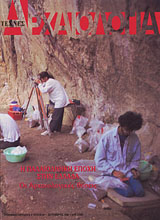
THRACE The first Palaeolithic sites in Thrace came to light in the 1960s thanks to the research Professor D. Theocharis carried out in the Evros river triangle. New sites have been located recently, in a new geomorphological research held in the Rodope plain. The older as well as the new sites, the open-air locations and finds are the product of survey. Nevertheless, an excavation has yet to be carried out and indications of Palaeolithic habitation have not been located in caves or rock-shelters till now. The sets of tools indicate exclusively the Middle Palaeolithic Era. This first data of human habitation in Thrace during the Palaeolithic era combined with the geographic position of the region -being on the threshold of Europe, from the Asiatic to the European area- and the wealth of finds from the neighbouring countries calls for pertinent research.
This is a preliminary report on survey work which was carried out by the Ephorate of Antiquities of Komotini in the southeastern part of the Rhodope plain in Thrace. For the first time in this part of Greece the research, still in progress, led to the discovery of Palaeolithic material which dates to the Middle Palaeolithic period. Four different findspots with stone elements of this period have been located in the area of "Krovili-Petrota". Among the finds is a biface made on lamina, one of the very few artifacts of this kind that have been recovered in Greece so far.
Today Macedonia belongs to those particularly rich regions in anthropological and archaeological finds of the Palaeolithic age, which however are still unexploited. Western Macedonia, where the research of the English expedition under E.S. Higgs was originally focused in the 1960s, has produced interesting finds, such as a hand-axe, probably of the Early Palaeolithic era, a bifacial leaf-shaped spike and another one of the Levallois technique from the Middle Palaeolithic era. All three finds come from Palaiokastro. Grevena. In central Macedonia and specifically in the Chalkidiki peninsula lies the well-known Petralona cave, where a human ossified skull was discovered, probably at least 250.000 years old . In spite of the particular interest of this find, it is difficult today to fully support the argument that the cave was inhabited by humans, because the cultural remains have not yet been located and studied. Eastern Macedonia came late to the fore of Paleolithic research. A preliminary survey research was held there in 1989-1990 and a short excavation was carried out recently in the Maara cave, Drama. The habitation in Maara is assigned to the Middle Palaeolithic era.
Careful observation of the map of Palaeolithic Greece, as it was shaped in the late 1980s, led us to acknowledge that the region of Northern Greece, from the foot of Mount Pindos to the Evros river, was terra incognita, although there were indications of Palaeolithic habitation in this region as well as in the neighboring countries. So a project was decided on which would investigate the Palaeolithic habitation in Eastern Macedonia, an area which had not yet supplied any evidence of human beings in the Palaeolithic period in spite of the wealth of finds from the Neolithic and Bronze Age. The first results of the project were positive, although not sufficient enough for creating a complete picture of this habitation. Such a picture can only be completed by continuing the research and the detailed study of the available archaeological material.
The "Springs of Aggitis" cave lies on the northern outskirts of the Drama basin in Eastern Macedonia, the flat part of which occupies 750 km. West of the natural cave entrance, where lie the springs of Aggitis river, a tributary of Strymonas river, animal bones from the Upper Pleistocene have accidentally been discovered. The bones come from the Ursus spelaeus, Mammuthus primige-nius, Equus caballus, Coelodonta antiquitatis, Megaloceros giganteus and Cervus speaes and have been found in red argilic layers, approximately 10 m below the present ground surface. The trial trench (4 x 1.5 m), east of the artificial cave entrance, proved that these Pleistocene fossil-bearing layers were 2.60 m. thick, the bone material was accompanied by Mousterian stone artifacts and its absolute dating was ± 50,000 years old. In this article we suggest that this was probably a killing-site, judging on the one hand from the limited amount of the stone materials and on the other from the absence of both the tool core and the exterior cover.Furthermore the tenure indicated that the tools were brought to the site already finished and the presence of humans did not last long.
Epirus is the most thoroughly researched region in the country. Two English expeditions by Cambridge University have been organized (since the beginning of the 1960s until today). The first, under E. S. Higgs, brought to light and excavated the rock shelter of Asprochaliko, the Kastritsa cave and the open-air location of Kokkinopilos. The second, under G. Bailey, located and excavated the rock shelters of Klithi and Megalakkos. An American expedition under C. Runnels continued the research at Kokkinopilos and started a survey in the area of Nikopolis in collaboration with the IB' Ephorate of Prehistoric and Classical Antiquities. Finally the Ephorate of Palaeoanthropology and Spelaology started a new excavation in the rock shelter of Boila a few years ago. Tens of open-air sites have similarly been located which complete the picture of the Paleolithic habitation in the area, that goes back to the Middle and Late Paleolithic era, while probable clues that point to the Early Paleolithic era do exist. In 1994 ,the 1st "International Congress on the Paleolithic Period in Greece and the Neighboring Regions" was held in loannina, capital of Epirus.
The interest both of American archaeologists as well as of the American School of Classical Studies, was first expressed in 1958, when Michael Jameson made the chance discovery of a stone implement of the Middle Palaeolithic period on the slopes of Profitis Elias, not far from Didyma, southern Argolid. A few years later (1967) they started systematic excavations in the Franchthi cave, Ermionis. Since then the interest of the American archaeologists, regarding the study of the Palaeolithic and the Stone Age in Greece in general, has remained undiminished. The last thirty years,apart from the excavations in Franchthi, the American School of Classical Studies has supported a series of projects in which the search and study of Palaeolithic sites are included. The Peloponnese: Franchthi Cave and the Argolid. The American excavations in the Franchthi cave, Ermionis, proved to be of exceptional importance for Prehistoric research in the Greek region.For the first time they brought to life a sequence of stratigraphic sets from the Late Palaeolithic to the end of the Neolithic period. The Franchthi finds redefined the position of Greece in the broader area of European Prehistory and especially of Palaeolithic archaeology. The excavations were carried out berween the years 1967-1974 under Thomas W. Jacobsen, with the support of Pennsylvania and Indiana Universities and of the American School of Classical Studies. The important results of the exploration of Franchthi led to a systematic survey of the southern Argolid a few years later. The project was headed by M. H. Jameson, T. H. van Andel and C. N. Runnels and supported by the American School of Classical Studies. It also included submarine geophysical research with modern methods (high-resolution seismic reflection profiling/bathymetry), in order that the geomorphology of the district be investigated and sunken areas be located. On the basis of the submarine and survey results in southern Argolid and of the Franchthi stratigraphical study we can reconstruct today quite accurately the geomorphology, flora and fauna as well as the human activities in the Ermionis vicinity during the Palaeolithic period. Thessaly: A Survey in the Larissa district C. Runnels, of Boston University, supported by the American School of Classical Studies, has recently (1987, 1989, 1991) carried out a series of surveys in the Larissa district, aiming at the re-examination of the research conclusions Milojcic and his collaborators reached in the 1960s. Runnels identified seven locations of the late Early Palaeolithic period, six in the vicinity of Megalo Monastiri and one not far from Rodia, north of Larissa. On the basis of the strata dating at the site Rodia, the Early Palaeolithic period in Thessaly must be assigned to the period 400,000-200,000 years BC. Epirus: A survey in the Preveza district In the framework of the Nikopolis project and with the support of the American School of Classical Studies, in 1991 C. Runnels carried out a survey in the district of Preveza . A hand-axe in an argilic layer was found at the site Kokkinopilos, which was dated (U/Th disequilibrium method) to approximately 250,000 years ago. The hand-axe is made of flint stone and its typology belongs to the lithotechny of the Acheulean cultural phase. The hand-axe, although common to the Acheulean lithotechny of Europe, is an extremely rare find in Greece and in Europe in general. It should be mentioned here that the Acheulean lithotechny discovered at Kokkinopilos is contemporary with the Clactonian lithotechny of the chopping tool type, found in Thessaly. The discovery of the hand-axe is a special contribution to the study of Palaeolithic archaeology, since it thus confirms -in combination with the finds from Thessaly- the human presence ("Archaic Homo sapiens") in Greece in the end of the Early Palaeolithic period (400,000-200,000 BC).
The Boila site lies on the east bank of the Voidomatis river, exactly on the western entry to the valley, at an altitude of approximately 500 m. Facing the North and situated on the banks of a stream on an Eocenian limestone layer, it appears today as an elongated shallow rock shelter (max. dim. 17 Χ 5 m.); however, geological observations led to the conclusion that it had been better protected in the past, since its natural protection gradually receded due to erosion and tectonic incidents. Its overall stratigraphic sequence belongs to the late Upper Palaeolithic period and to the so-called Epigravettian cultural phase.
Already since the beginning of the 1960s Thessaly has been a field of research thanks to the work of Professors D. Theocharis and Vlad. Milojcc. A plethora of open-air sites came to light during repeated surveys which were conducted in the late 1980s by C. Runnels, head of an American expedition. The sites are located along the Pineios river as well as in the south-eastern, northern and western regions of the plain of Thessaly.Human habitation is assigned to the Middle and Late Palaeolithic era and there are certain indications pointing even to the last phase of the Early Palaeolithic era. Along with all these survey finds, the excavation of the Palaeolithic deposits of Theopetra cave by the Ephorate of Paiaeoanthropology-Spelaeology of the Greek Ministry of Culture will contribute greatly to our knowledge of the Palaeolithic period, not only of the area but of the entire country as well. Theopetra is one of the few Palaeolithic sites of Greece, where habitation has undoubtedly been continued from the Middle to the Late Palaeolithic era and exists in an unbroken line up to the Neolithic period.
During the nine years of its excavation (1987-1996) the Theopetra cave brought to light deposits of the Middle and Upper Palaeolithic and Neolithic periods. It is not only the first excavated cave in Thessaly, where stratified deposits of the forementioned periods have been found, but it is also the first site in Thessaly in which the Mesolithic period is represented by a separate layer. The transition from the Mesolithic to the Upper Palaeolithic in the cave is characterized by a hard sediment, about 40 cm. thick, formed during the end of the Upper Palaeolithic phase by dripping or running water. Two more hard sediments have been located, one in Upper Palaeolithic and the other in Middle Palaeolithic layers, which reflect glacial periods of the Pleistocene. Two human skeletons from the Upper Palaeolithic and the Mesolithic have been found, while the masses of unbaked clay, which has been located in very old layers, indicate the use of clay in very early times, long before it started being baked. The stone tools of chocolate colour flint are of perfect quality and exhibit a fine technique, while the bone artifacts and perforated teeth belong to the finds from the Upper Palaeolithic era. Over 30 samples of 14C analysis gave dates ranging from 44,000 years BC to 4,000 years BC.
In the southern part of mainland Greece called Sterea, and specifically in Boetia lies the rock shelter Seidi, one of the first Palaeolithic sites of the country to be excavated. A thorough reference to it is included in the issue 59 of this magazine (pp. 9-12). Other indications of human habitation come from Aetolia and Akarnania.Stone sets of chopping implements, assigned to the Palaeolithic era, have been surveyed by Dr. V. Papakonstantinou in the Agrinion district, on the west shore of lake Amvrakia and elsewhere. Euboea has repeatedly been a research field.
Research in flint deposits of central Euboea resulted in the discovery of Palaeolithic quarries. In 1977 and 1978 two sites of local flint tool workshops were located at Phaneromeni and Voleri in the Nea Artaki region. On these sites, lying a mile apart, great numbers of cores, flakes and intact, broken and incomplete tools have been surveyed as well as pebbles, which had probably been used as hammers. The finds amount to thousands and, compared to artifacts of stratified sites, can be dated to the Middle and Late Palaeolithic era and Mesolithic era, while some of them may be assigned to the Early Palaeolithic period. The stone artifacts indicate a long series of Prehistoric cultural levels existing in Euboea. Some Middle Palaeolithic shells, Neolithic opsidian tools and a few pottery sherds from the historic period have also been surveyed. Nevertheless, no excavations have been carried out, while sites and artifacts are being destroyed and disappear everyday due to the authorities' indifference.
The Palaeolithic period on Euboea is confirmed by quite a few relevant elements from its centre as well as by certain indications from other parts of the island. Our limited information is undoubtedly due to the fact that no systematic research of this period has been carried out until today. The first effort for the proper approach to the subject started in 1991 with the Ephorate of Antiquites of Euboea in collaboration with this period's specialist Dr. E.S. Papakonstantinou. It was, however, no more than an investigation of the progress in research regarding Palaeolithic Euboea. Besides tools from the Nea Artaki area, various other finds of the Palaeolithic period come from the following locations: The nearby sites Kotsika and Agali on the northeast coast of Euboea; the Manika peninsula, on the west coast, close to Chalkida; the Hagios Vasileios-Hagia Anna site at the Hagios Vasileios bay, on the northeast part of the island; on the northwestern part of Euboea the sites Hagios Athanasios and Hagios Georgios Limnis; and the site Tabouri Kirinthou, south of Agali. It is not certain whether the sites of central Euboea, as well as of Velos further to the south, are in fact Palaeolithic as they have been regarded in various publications. The systematic research of specialists, which will also evaluate the major or minor groups of Palaeolithic implements, will provide the final answers to questions concerning the Palaeolithic period on Euboea.
Although a systematic excavation of the location of Palaeolithic sites on Euboea has not been carried out until today, quite many Paleolithic sites have been found among numerous Neolithic ones, during the surveys conducted in the 1970s and 1980s. Most of them lie in Northern and central Euboea.The northern part of the island, especially, being more wooded and with an abundance of water, seems to have better served the living of the people of that time. All the sites of Northern Euboea, such as Hagios Georgios, Hagios Athanassios, Prokopi, Agia Anna. Kotsikia, Kerassia, Paliochori Rovion, have produced lithic material excusively of the Middle Palaeolithic era, while on central Euboea tools of the Lower and Upper Palaeolithic era have been found. Although no Palaeolithic site has yet been located on Northern Euboea, it is certain that this picture will be changed by the results of a systematic excavation. The habitation of places on mountains or close to rivers must be related to the presence of game. The Palaeolithic hunters might had moved to the highlands in the summer, where there would have been an abundance of grass for the animals. The sites at Nea Artaki, Kotsikia, Hagia Anna, which lie close to the sea, can be considered as winter settlements. The Palaeolithic sites on Euboea must generally be related to the emigration of animals and must had been situated either on the animals' routes or close to springs. Quite many Middle Palaeolithic sites have also been found on the Northern Sporades. At a time when the sea level was much lower than it is now, this insular group was united with Thessaly and Northern Euboea. In recent years, with the occasion of the Kyklopas cave excavation on Joura, a survey of all the small islands of the group was carried out, which brought to light more Palaeolithic sites, beside the two already known. On Alonnessos, Kyra Panaghia, Gramiza, Joura and Psathoura the Palaeolithic sites, which have been located, also show the existence of primitive navigation, since the desert islands of Northern Sporades had not always been united. The excavation in the Kyklopas cave proved that during the Mesolithic period (8th millennium BC) there was specialized fishing and quite advanced navigation, thus suggesting the existence of a tradition in similar activities in the area of the Northern Sporades . Human activity in the area of Sporades seems to be related with the existence of game. Beside Kokkinokastro on Alonnessos, excavated in the past as well as recently, a rich fauna must have had also existed on the other small islands. However, Prehistoric people might well have been interested in fishing, since the sea around the Sporades has always offered the best fishing in the entire Aegean. We believe that in the future research should be targeted at the location of sites on the bigger islands, such as Skopelos, Skiathos and Alonnessos, which exhibit rich feeding sources.
The Peloponnese is a productive field for Palaeolithic research and today presents a large number of sites. The oldest reference to an implement which was assigned to the Early Palaeolithic era comes from Arcadia. In the Argolid two caves have been excavated: Franchthi, by an international interdisciplinary team under T. W. Jacobsen, and Kephalari, by a German expedition under L. Reisch. Both Franchthi and Kephalari, where, however, the research has not advanced beyond the preliminary stages, are key-sites for the understanding of the Palaeolithic habitation of Greece. The survey of the American team under C. Runnels has located quite a few sites. Presently excavations are carried out in rock shelters at the Kleisoura canyon, within the framework of a Greek-Polish collaboration,that of the University of Krakow, under Professor J. K. Kozlowski, and the Ephorate of Palaeoanthropology-Spelaeology of the Greek Ministry of Culture. Finally, a brief excavation at the Kokkinovrachos site, in Nauplia, should be mentioned, which was conducted by A. Protonotahou-Deilaki in 1974. The Western Peloponnese does not have any excavated site, although the research of the French expedition in Eleia under A. Leroi-Gourhan and his collaborators, during the 1960s, proved to be quite fruitful. Recently, new sites came to light in Achaia owing to the research of the Ephorate of Palaeo-anthropology-Spelaeology. Finally, in Laconia two caves were excavated, Apidima, by Professor Th. Pitsios. and Kalamakia, the latter within the framework of a Greek-French cooperation between the French National Museum of Natural History, under H. de Lumley, and the Greek Ephorate of Palaeoanthropology-Spelaeology. Human habitation in the Peloponnese covers the Middle and Late Palaeolithic period.
The Kleisoura canyon is part of the important road linking the Argolid plain and the Prosymna basin (Berbati). Research,starting in 1993 led to the location of about 30 caves and rock shelters, two of which were explored with trial trenches; later, in 1994 and 1995, a systematic excavation was carried out in the rock shelter no.1. The results of these investigations allow us to outline the evolution of the Prehistoric habitation during the last cold phase of the Glacial period (25.000-15,000 BC.), the Late Glacial (15,000-10,000 BC.) and the Early and Middle Holocene. This outcome therefore includes the Upper and Final Palaeolithic period, the Mesolithic period, as well as traces of the Middle and Late Neolithic, and ends with traces of the Bronze Age.
The "Kalamakia" cave, on the west shore of Mani, shows significant deposits of the last Mesoglacial and Glacial period.The archaeological strata date from the first half of the last Mesoglacial period and belong to the Middle Palaeolithic period. The discovery of successive layers of habitation supplied information about the "dwelling" habits of Palaeolithic man and the organization of space, while it also brought to light stone "structures". Almost all bone remains belong to wild goats and deer. The implements, mainly scrapers and points, are of good quality; they are made of a great variety of rocks, some of which had been brought from far away.
Stone tools dating from almost all the Prehistoric periods and mainly from the Middle and Upper Palaeolithic have been collected from the littoral plain in the northern region of West Achaia. Most of the finds come from the coastal gradients and the valley of Peiros river, where the first two open-air Palaeolithic sites have also been located. They are dwelling settlements from which only the stone tools have been preserved. The Mavri Myti settlement, of which only a small part has survived, lies on a coastal gradient and dates from the Middle Palaeolithic period. Its artefacts feature many pebble tools, along with typical Mousterian ones, as well as a few samples of the Levallois technique. The Aurignacian settlement at Elaeochori is quite extensive. It has produced early Aurignacian stone artifacts, which are assigned to the traditional phase from the Middle to the Upper Palaeolithic period.
Paleoanthropological research of many years on the coastal site of Apidima - west of Areopolis - resulted in the discovery of a uniform area of Paleolithic habitation in the wider region of western Mani. The important Paleoanthropological finds from Apidima, resulting from research which was done under exceptionally difficult circumstances, have proved the great scientific significance of this site and of the wider Mani in general for the study of Paleoanthropology in Greece and for the evolution of man in Europe. Research was carried out by the Anthropological Museum in collaboration with the Laboratory of Historical Geology-Paleontology of Athens University and the Institute of Geological and Mining Research of Thessaloniki University. Apidima Layers of Palaeolithic habitation, dating from different periods, and important human skeletal finds coming from six to eight different individuals have been located at Apidima. The importance of the Paleoanthropological finds, mainly of the human fossils of earlier geological periods, lies in the fact that they permit the study of the biological evolution of man. Cro-Magnon (Homo Sapiens) A number of Paleoanthropological finds, belonging to ossified types of the contemporary Homo Sapiens, have been discovered in the Upper-Paleolithic layers of Apidima. The most interesting among them is a female skeleton. The bone formation of the woman, who had lived about 30,000 years ago, refers to the Cro-Magnon anthropological type, known from similar Upper-Paleolithic sites in Europe and Middle Paleolithic ones in Eastern Mediterranean. Early Homo Sapiens Finds The most important Paleoanthropological finds from Apidima are two ossifed skulls (ΛΑΟ1/Σ1 and ΛΑΟ2/Σ2). On the basis of the available data, the human finds from cave A are dated between 100 and 300 thousand years and are classified in the Homo sapiens types (Pre-Neanderthal). The systematic name Homo (Sapiens) Taenarius has been proposed for these finds, until their laboratory cleaning has been completed and their age has been secured by absolute dating. The Neanderthal Man Human fossils of the Wurm Glacial (c. 100-40 thousand years), which have been named "classical Neanderthal", have been located at quite many European sites in the beginning of our century. A series of early European finds, to which the skulls (ΛΑΟ1/Σ1 and ΛΑΟ2/Σ2) from Apidima must also belong, such as the Petralona, the Arago (France) and the Atapuerta (Spain) man, have extended the phylogenetic history of the Neanderthal man 200 to 300 thousand years in the past, dictating his phylogenetic origin from the archaic forms of Homo Sapiens.
Paleolithic research in the Ionian Islands was started in the 1960s by Professor Aug. Sordinas who excavated the rock shelter Grava on Corfu and located many open-air sites on Corfu and Zakynthos. G. Kavadias surveyed later Paleolithic stone implements in the Phiskardo area, northern Kephallonia, as did G.A. Cubuk in the district of Nea Skala, in the south-eastern part of the island. A similar survey was carried out in Lefkada by A. Douzougli-Zachou. Recently, new sites have been located in Zakynthos. Human habitation in the Ionian Islands is assigned to the Middle and Late Paleolithic era. However, certain data from the geological research in SW Corfu is probably indicative of earlier habitation.
Paleolithic research in the area of the Ionian Islands revealed an Epigravettian wide goal economy, showing tendencies of domestication. We stand on the threshold of the partial, at least, and still aceramic, domesticated cattle-breeding in the Balkans, Everyday, these scattered, limited sequences become better known and are confirmed by the survival of many Epigravettian elements (especially backed bladelets and lunates) in purely Neolithic layers, to mention only a small example from mountainous Albania across Corfu. Such a perspective would be the greatest service offered by the Late and Post-Paleolithic Archaeology. A Paleolithic station was located in May 1966 in Grava of Hagios Matthaios, a former extensive rock shelter, the roof of which has fallen in.
Although no systematic archaeological research exists, chopped stone implements have been repeatedly surveyed on Zakynthos, specifically from the Basiliko peninsula, by geologists who visited the island occasionally. The location of an open-air site at Hagios Nikolaos recently, a community of Basiliko, supported the argument that Zakynthos had already been inhabited since the Middle Palaeolithic. The identification of the character of this site -a workshop of raw material- comes to elucidate one of the most interesting expressions of Palaeolithic man, that of his behaviour and adjustement to the natural enviroment.
Little research has been done on the Aegean Islands unlike the rest of Greece, therefore indications of Palaeolithic habitation are few. Geomorphological phenomena, such as changes of the sea level, intense erosion, etc. undoubtedly contribute to this scarcity. The available data come on the one hand from Thasos, where a Late Palaeolithic ochre mine has been discovered and excavated recently by Ch. Koukouli-Chryssanthaki; and on the other from the Northern Sporades, where D. Theocharis was the first to study implements of the Middle Palaeolithic period. A. Sampson makes a thorough reference to these indications as well as to more recent ones in the present issue. The lack of indications from the Cyclades, the Dodecanese, and the other Aegean islands as well as Crete remains apparent. A reference of surveying bone implements from the Rethymnon district, Crete, is by no means proof of human habitation, not to mention that there is no further use of this information.
Extracting ochre, the "gold", as it was called, of the Palaeolithic period, was the earliest mining activity of man and his first acquaintance with metals. The Palaeolithic mines of Thasos have been added to the excavational activities in Europe. The Prehistoric mine on Thasos was located in 1956. The 18th Ephorate of Prehistoric and Classical Antiquities of Kavala, evaluating the importance and uniqueness of the find, undertook its excavational research on the one hand with the cooperation of the archaeologist G. Weisgerber -from Bergbaumuseum, Bochum-, a specialist in the archaeology of mines and a member of the project "Archaeometallurgic Research on Thasos"; and on the other with the scientific support of the IGSG of Xanthi, represented by G. Jialoglou. During the excavational project only a few mines have been located: Mine T1 with two galeries, dating from the Later Palaeolithic era. Mine T2 clearly shows that a different technique of striking and extracting the deposit has been applied. The excavational research carried out in the T3 and T6 mines is limited, therefore their dating as well as that of the mine T2 is not yet possible. The stone forging tools and flint blades found in the mines T3 and T6 indicate that the technology applied in these mines is close to that of the mine T1. The excavational research will probably locate on Thasos more traces of the Palaeolithic men who extracted ochre from the haematite deposits using technology that was advanced for their time.
Computers are making unprecedented aesthetic experiences possible and offer a revolutional way to how art is perceived and taught. The profound impact of digital technology on art during the last years and what it portends for the future, is only beginning to be appreciated. Although enthusiastically welcomed by the film and broadcasting industries, computers have not been readily accepted by most of the art community. With their enormous potential as visualizing tools, the reticence of the art community is somewhat perplexing. While it is certainly true that the liaison between art and technology has been an uneasy one for some art historians and art educators, their ideas and apprehensions are becoming outdated in the current context of computer knowledge regarding available machines and programs-Today, the wide availability and portability of persona! computers and very sophisticated programs invite the art historians to work directly on their own computers, so that intermediaries are no longer required. However, there is still a need for art historians and teachers to work alongside programmers to improve the familiarity and the simplicity of the user interface towards the artistic and educational directions of art software.
Between 1972 and 1981 Greek, English, French and Belgian archaeologists and epigraphists, published texts in linear A script, incised on three pins made of precious metals, found in Crete and belonging to the Late Minoan IA period (1600-1450 BC). The importance and interest in these three pins lies in the fact that they bear the longest known dedicatory inscriptions, in a language which has just started being deciphered. In my opinion, it is an Indo-European language, one of those that make up the Classical Greek language. The text on one of these pins contains 11 different words written with 45 signs. As the pin is broken at both ends, we must accept that the text would have originally included two more words, divided from the others by a small antenna, thus comprising a total of about 50 signs. The presence of words on the three Cretan pins, which have survived in Classical Greek, such as κέλωρ, εκείνο, α(υ)τά+δε, of a verb ending in -μι (za-ki-se-nu-ti), of a sigmatic past tense fte-su-de-se), names such as Αμασις, Αδάλα, Θασσαλός, a genitive case in -olo and an instrumental in -φι, allow us to believe not only that we understand the main part of this text; but also that the language written and spoken in the Aegean basin around 1500 BC is not very different from the Mycenean language of 200 years later in the linear Β script.
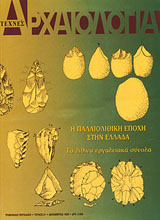
Chiseled stone tools are records of human activity. They were invented by Homo habilis, about 2.6 million years ago, along with his bipedal character, which is, of course, a preceding stage of development.The above two events as well as the enlargement of the anthropoid's brainpan are considered today as the three basic features of the evolution and gradual development of the human species. For this reason the study of stone tool industries, which appear in every Palaeolithic site and represent 99% of the archaeological material, is a crucial step for the understanding of the intelligence, behaviour, activities and social structures of the humans who lived during the Palaeolithic period. The first handling of this material goes back to the 16th century AD, when stone tools found in Italy were recognized as human products. The study of Prehistoric stone industries evolved quickly since. The problems and objectives in the study of stone tool industries reflect the most representative intellectual conditions in each period as well as the influence of its scientific trends on these studies. Today the research and study of the stone tool industries are organized into four major sectors, which, however, have not developed at the same rate.The raw material sector aims at defining the quality of the raw stone material chosen and used by Palaeolithic man for making his tools, the sector also traces sources and investigates the procedures used for supplying and distributing the raw material. The technology sector examines technical procedures followed during all stages of the making of stone tools, from the flaking of the raw material to the final creation of an object. Its objective is to reconstruct "the technical chain" and to determine the position of stone findings within it. The typology sector takes into consideration the different shapes of stone finds, especially of tools, and introduces types, the listing of which permits their chronological and cultural categorization. The technology sector locates and analyzes under a microscope, the deteriorations caused by time on stone tools, which, when effected by human activity, are called "utilization traces". Experimental Archaeology makes a decisive contribution to different areas of research and to the study of the stone tool industries of the Palaeolithic period.
The modern research approach to Prehistory, which contributes to the understanding of man's behaviour and the organization of his life during the Paleolithic period, consists of the definition of the raw stone material chosen and used by Paleolithic man for making his tools, the location of the sources of raw material , and the investigation of the procedure for the supply, transportation and distribution of raw material.
Experimental Archaeology may have proved that flakes, blades, miniature blades and other artefacts produced from either chips or fragments of stone can be used for various tasks. However, only those of the above items whose sides and tips have been refined, are officially cosidered as tools. Most often the working procedure defines the form of the tool, which is a decisive factor for its typological analysis. The establishment of types became the main objective of specialists during the first half of the 20th century. The classification of types in a list depending on time and place, made a chronological and cultural approach possible which remains valid till today in the world of Prehistory.
For decades scholars have avoided any utilization approach to tools because of their ( the scholars') justified mistrust in the extravagant imagination of the pioneer prehistorians regarding the tools' use. In 1963 J. Tixier himself, the well-known French technologist and typologist had written that the time had not yet come - if ever -to leave behind "Prehistoric Typology" and to advance to "Prehistoric Utilization".He further added that this second stage of research was very extensive and included many traps which could mislead scholars. One year later the Western world was informed through the English edition of S.A. Semenov's work "Prehistoric Technology" about his research on on the utilization traces of tools.
The description of stone tool industries, seen as an indispensable prerogative for the propagation of knowledge and communication, is never complete enough to allow the reader to visualise one such artefact in his mind's eye. Therefore, an acurate drawing, showing all traces of working, retouching and utilizing a tool, must accompany every publication. The evolution of the graphic representation of Prehistoric stone tools advances simultaneously with that of typology and technology.
Stone implements are the only material remnants which permit us to follow the evolution and differentiation of technology throughout the Palaeolithic period. They supply composite information which, to be understood, needs to be decoded and interpreted. The basic technical components, knowledge, materials and actions, are correlated and form standards, quite recognizable even in the early phases of human activity. The technological approach enables us to analyse the basic methods for the hammering and carving of stone and to determine the ideas leading to these endeavours during the Lower, Middle and Upper Palaeolithic period. We present in this article the various versions of stone carving techniques as well as the methods of manufacturing stone implements through a simple or complex procedure. Stone carving techniques clarify a. certain ways hunters and food collectors thought at that time and their ways of dealing with the environment as a source of raw materials;b. the degree of technical innovations, both their conception in the abstract and their organized realization; and c. the introduction of technical novelties and their coexistence or combination with the technical standards with a future to them.
In the 17th century, Kastoria was a wealthy city of about 10,000 inhabitants, mostly Christians, who occupied the eastern, northern and southern regions outside the city walls and the area of the Byzantine citadel. Their spiritual and social self-administration was regulated by the Bishopric. The degree of their religious freedom is confirmed by the number of old and new churches, which have been renovated or founded, respectively. According to the surviving monuments, sixteen churches dating from 1605/6 to 1663 are decorated with wall-paintings. Their dedicatory inscriptions together with literary sources reveal social, professional and financial parameters, which allow us to reconstruct the everyday life of Kastoria's Christian population. In the subject matter of these wall-paintings, 14th-and 15th-century artistic trends prevail from northern and western Macedonia and the adjacent regions, beyond Greece's present frontiers.These trends however are filtered through the local tradition. In spite of the apparent eclecticism of these works, they show a unity of style which belongs to the so-called "anti-classical" tradition with its various manifestations - The styles of Macedonia, Epirus and that of the "Kastoria Workshop" . Thirteen different artists can be distinguished -mainly locals with a limited range of intercommunal activity- three of the above belong to the same group to which the decoration of five churches can be assigned. They seem equally well to master the technique of icon painting as well as of monumental painting. The 17th-century wall-paintings of Kastoria are multi-dimentional artistic works of art, which do not mark the end of a school of painting but represent the link between 16th-century conservatism and the 18th century boom of folk art painting. Furthermore, they prove the coexistence of two worlds, the one that is conventionally known as post-Byzantine and the world of modern Greece that was only just emerging at the time.
A concise presentation is attempted in this brief note of three major research issues of contemporary Palaeolithic Archaeology. Archaeological evidence of the Palaeolithic period in Greece is investigated within the framework of these issues and there is proof that owing to its geographical position at the crossroads the Near East and Europe, our country is an area of special interest for their approach. 1. The origin of the human species and its propagation in Europe/The Lower Palaeolithic period. 2. The origin of contemporary man (Homo sapiens sapiens) and his propagation in Europe/The transition from the Middle to the Upper Palaeolithic period. 3. The transition from the Palaeolithic to the Mesolithic period. From this brief survey it becomes obvious that in Greece we are in a position to locate an abundance of archaeological evidence. This will contribute decisively to the investigation of the great financial, social and cultural changes that took place during the Palaeolithic period. In years to come, the objective of scholars must not only be the discovery of new sites but also the completion of a reference system in which the Greek data will be combined with those from abroad for a better understanding of the past.
1. Social and cultural aspects of tourism in Athens During the four centuries of Turkish rule (1452-1828) Greece was hardly visited by foreigners. Travel contacts developed slowly but steadily during the first fifty years of independent national life. During the first decade the active involvement of foreign scholars (e.g. L. Ross, G. Muller, H. Ulrichs, A. Brandis, G. Finlay, N. L. Fraas, etc.) in the social and scientific life of young Greek society contributed even more decisively to Greece again approaching the family of European states. Some rare exclusive visitors came to Athens on their own initiative on their way to lengthy trips in the Middle East, for example the German writer and landscape specialist Furst Puckler-Muskau ( Athens 1836), the French novelist Gustave Flaubert (in 1851) or the French philosopher Ernest Renan (in 1865) . They were considered as cultivated travellers (Bildungsreisende). Organized visits for tourists were still non existent. At the time some early photographers, mainly architects and draftsmen (e.g. G. M. Bridges 1848, J. Robertson 1850, A. Normand 1851 and F. A. Beato 1857) organized the first photographic campaigns in Athens, focusing mainly on the documentation of the city's antique monuments. In these early days a special kind of group was to be seen on the Acropolis with the presence of crowds of young midshipmen from foreign fleets anchored in the bay of Phaleron. This was a calamity for the monuments as vividly described by Ross in his memoirs. This period of individual travelling, during which organized tours were very rare,was followed -starting in the last decade of the 19th century- by an era of early group (not mass!) tourism.The guidebooks of Joanne Murray and Baedeker were indispensable travel companions. Their high standard still amazes us today. Already, however in the 1890ies Mr.Cook in person visited Greece and conceived a vast program of regular tours. In 1914 an official office for tourism was founded, followed in the 30ies by a specific ministry for "Press and Tourism". By the late 1920ies air connections had already been established between Athens and some European cities. The first tourist brochures were issued and for the first time ancient sites were "reanimated". Cultural events with international appeal took place in Athens (performances of antique drama at the Odeion of Herodes Atticus, in Delphi in 1927, and the Delphic festival in 1930) and in Olympia (festivities in the Altis on the occasion of the 1936 Olympic Games). The elitist nature of the tourist flow to Athens and Greece persisted, however, until the Second World War. Immediately after the war there was a growing awareness in Athens of the inevitable opening up of the country to mass tourism. Today, package tours absurdly promise the tourist, two days in which to "do" the whole of Athens and all the museums of the city with a "comprehensive guided tour" and in the evenings still be able to be confronted with "real life" in the city's central districts. In addition "experience" (the word education is strictly avoided) is combined with relaxation. Therefore groups of tourists are herded outside of Athens as soon as possible. Today, although Greece still strives for "educational tourism" based on different itineraries, the flow has degenerated into a twofold phenomenon. Mass summer vacations on coastal regions and islands of an average duration of 8 days and a mass inundation of Athens for a ritual and rather unconcious visit of the famous "antiquities" in the polluted city by people anxious to leave the place as soon as possible. 2. Tourist infrastructure and tourist policy in Greece during the last decades. Tourism in Athens as an economic factor.Tthe city and its heritage as tourist attractions. In the beginning of the 50ies Greek authorities became aware of the importance of tourism. With tourist planning came the generous expansion of central ports and airports. 3. The implications of the influx of tourists on the monumental heritage of Athens Specific living habits and the rather low awareness (by the majority of Athenian population) of the artistic value of the city's historical heritage create many varieties of exploitation of the different antiquities. The wear and tear of the rock surface of the Acropolis, caused by the footsteps of millions of visitors, reached an alarming degree. By 1980 a light, reversible concrete covering was foreseen in situ in order to create a pedestrian pathway on the plateau. Visiting the interior of the Parthenon was prohibited. This brings us to the delicate problem of human behaviour in cultural public spaces. Visitors hinder one another in the crush of the crowd, and more so because their own physical presence is often so dense that it prevents the lower parts of the buildings or exhibits in the museums from being seen. The qualitative aspect of the phenomenon is in certain circumstances more serious than the quantitative one. The human mass does not assemble together as a visually indifferent entity dominated by the monuments,rather groups of people prevail, competing with the aesthetic appearance of the monuments. Thus, it seems that the openminded ,playful and "tactile" experience of historical sites combined with the security of the monuments care has still to be invented!
Kleitor, a city of NW Arcadia called Azania in antiquity, lies about 3 km. west of the village of Kato Kleitoria and today belongs administratively to the Kalavryta county of Achaia. It owes its name (kleistos-closed) to its enclosed landscape, mythological tradition, however, relates it to Kleitor, son of Azania, the founder of the Arcadian tribe of Azanoi. Texts by Pausanias are the most important historical sources for the topography, monuments and myths of the region. Nevertheless, the relevant testimony of earlier writers, such as Pindar, Xenophon, Plutarch, Polybius, Libius, is also enlightening. The city has been excavated since 1987, and its cultural physiognomy has emerged progressively through the combination of random finds, excavational data and survey results. Its Hellenistic fortification wall, of which the NW and W gates have been located, encloses an area of 145 acres approximately. Its cemeteries are dated from the Geometric to the Late Roman years; while the ancient theater,the houses and kilns for ceramics have started being revealed by the city itself. None of its sanctuaries mentioned by Pausanias -those of Asclepius, Demeter, Eilethia, Dioskouroi, Koria Athena- have as yet been identified although there are positive indications of the cult of Artemis. Moreover, at the site of Frangoklessi, which today dominates the archaeological area and echoes the Frankish conquest of the land, an Early Christian basilica has been located. Random Prehistoric finds, products of surveys or excavations - place the use of the site in the Early Mycenean period. The city seems to have prospered in Classical and Hellenistic times, it was a trading center in the Roman era, while its administrative nucleus in later days probably moved west to the town going by the name of Kleitor since Mediaeval times.
Until recently the Mesolithic period in Greece was considered as a doubtful period and in certain cases even its existence was questioned. The achaeologist D. Theocharis defined the Mesolithic period as a transitional phase, with its use of stone continuing the Late Palaeolithic tradition. However, relevant finds in Greece have multiplied day by day and the Mesolithic period has obtained its real dimensions and special features. Remnants of habitation from the Frangthi cave, the Theopetra cave in Kalambaka, the Cyclopas cave on the island of Joura, Alonnessos, and the outdoor site on Kythnos exhibit are remarkably similar where stone masonry and food remnants are concerned. The excavational data from the cave on Joura -the huge accumulation of fish bones and the technical perfection of the relevant equipment- prove an astonishing fishing boom. Dozens of bone hooks dating from between 8500-7000 BC bear witness to the highest quality of minor arts. The stone work recovered from the above mentioned sites follows the Palaeolithic tradition and shows typical Mesolithic characteristics; however, shortly after 8.000 BC, pigs, the first domesticated animals appear in the cave of Joura, while the primitive cultivation of plants probably begins in the Frangthi cave. This latter phase could thus be seen as "Early Neolithic" or "Preceramic" and corresponding to a similar phase which, in the Middle East and Asia Minor (Yarmo, Cayonu, Beida, Jericho), is dated back to the 9th millennium. In this case, however, the problem of the chronological definition of the Mesolithic period emerges. What is primarily established is that the Mesolithic period in Eastern Greece and the Aegean begins earlier, while in Western Greece (Corfu) and the Balkans (Lepenski Vir) there is a time lag. It seems that new achievements such as cultivation of land, domestication of animals probably came to the Balkans from the East via the Aegean sea routes. Thus, it is natural that the Aegean sites appear more developed that those of Western Greece. The recent excavation of a Mesolithic settlement on Kythnos testifies to intense marine activity in the Aegean already from the 9th-8th millennium BC. The study of the lithic material from Joura (J. Kozlowski, personal communication) has also established the relationship with the stone masonry of SWestern Asia Minor (Attaleia region). Progress in research must also clarify the chronological limits of the Preceramic phase which was first established by Theocharis and Milojcic in Thessaly. This phase, the duration of which was probably short, does not appear everywhere in Greece, while its lithotechny is almost identical with that of the Early Neolithic period.
Since antiquity, metals have been appreciated in Greece, where the metalwork tradition still remains important and has created "schools", such as those of the Dodecanese, Stemnitsa or loannina. This article deals with three different traditional techniques, one of which refers to the casting of a ring (small object) on a cuttle-fish bone mould. The second one refers to the reproduction of a flat model by using soot, the third one to the mounting of a stone or gem.
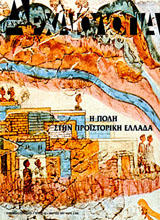
The so-called "Town Mosaic", the fragmentary faience composition found in the palace of Knossos and dating, in all probability, from the dawn of the Neopalatial period, opens a very significant thematic cycle in Aegean art, in which the town is a steady point of reference. For the first time in the Aegean ,the plethora of private, urban houses makes obvious the realization of the concept of the town. At the same time, however, this composition introduces the elements of landscape, narration and historiography to art. The thematic cycle of the town is expanded and disseminated outside Crete in various artistic forms during the Late Bronze Age I. The most striking example is that of the miniature "frieze of the fleet" from the West House of Akrotiri, Thera, in which at least five towns, different in architecture, landscape and topography are represented. A diagnosis of the reasons which led to the creation and diffusion of this thematic cycle is attempted in this article. Furthermore, the artistic principles of the town representations are critically approached and discussed as well as their identification and interpretation in the complex historic framework of the era.
The author of the article first makes a concise reference to the theoretical approach of space during Prehistoric antiquity i.e., its development, organization and use. The purpose of this reference is to present, in codified form, not only general theoretical schemes which serve to identify the analysis of intra- and inter- community relations developing in this space.Those schemes which are formulated as general conclusions are also presented. Since the author considers the settlement as the basic objective measurement for the study of space, he attempts to formulate proposals regarding "space archaeology". The first proposal has to do with the introduction of the term "ecospace", in which the concepts of organization and use coexist. The other proposals concern the way Prehistoric settlements develop and are relevant to their functional "properties". Thus, two development procedures are acccepted by the author: (a) the diachronic and (b) the synchronic. In the former the research approach refers to the identification and analysis of the elements responsible for the form of a settlement; while in the latter it tries to recognize four ways of synchronic development, (a) the cyclic, (b) the solid, (c) the polycentric and (d) the vertical to the productive source.
The author of the article first presents the factors affecting the formation of a Prehistoric settlement and of architectural structures in general. These factors, through their application, refer to the organization of space, to food-supplying and ideological inventions. In the process,the author attempts to analyze ways through which these inventions affect the Prehistoric habitation and concludes with a proposal referring to distinctions between forms of Prehistoric habitation. On the basis of this proposal the author distinguishes two basic forms of Prehistoric habitation: (a) the single-space and simple one, and (b) the multi-space and composite one, which appears in two versions, the megaroid house and the megaron. The article presents sound descriptions of both kinds of houses, analyses the reasons for the invention and construction of the megaroid type and comprises all the theories on the origin and character of the megaron.
On the island of Cyprus, not far from the village Deneia lies an extensive ancient cemetery, which has been used since the Bronze Age. The cemetery, known to the inhabitants of the adjacent villages, has been looted by illegal excavations. As a result the landscape, being full of trenches, looks as if it has been bombed. The illegal excavators, having collected whatever seems important or valuable to them, break or leave behind all the rest of the finds. An inscribed phiale comes from this cemetery. The illegal excavator did not appreciate its value, but he found it useful as a watering-jar for the poultry in his back yard. There it was noticed by a collector of ancient objects, who bought it and delivered it to us to read its inscription. The phiale had been made of red clay including fine grains of sand and has a red coating. The lips slant outwards and the base is wide and circular . The phiale, which can be probably dated to the fourth century BC, bears a syllabic inscription, incised with a sharp instrument before firing.
As mountain peaks scattered in the sea, the Aegean islands did not favour population explosions. In order to survive on their rocks, the islanders developed skills and techniques for the maximum exploitation of their natural resources.They acquired empirical knowledge in fields, such as physics, chemistry, meteorology, astronomy, from their activities in mining, metalwork, shipbuilding and seafaring. This resulted in the development of technology, whose products were exchanged for subsistence commodities from mainland communities. Thus, in the islands' craft specialisation,the division of trade and labour, all archaeologically documented as very early in the third millennium BC have contributed to the process of urbanization.This was different not only from that of the mainland but even among the various island communities themselves. The relatively large size of the eastern Aegean islands of Lemnos, Lesbos, Chios and Samos together with their geomorphology as well as their being geographically placed near the coast of Asia Minor not only guaranteed their survival but also favoured the development of harbour-settlements which controlled the sea routes from South to North and vise versa. Poliochni on Lemnos, thanks to its location just opposite the Dardanelles, seems to have developed as a proto-urban centre as early as the beginning of the third millennium BC, rightly claiming the title of the first European city . Town planning, paved streets, communal wells, a sewage system as well as an impressive wall for its defense are among the visible works of the so-called Yellow period (c. 2300 BC), but the communal "Granary' and the so-called "Assembly Hall" or Bouleuterion date back to the beginnings of the city ( Blue period). Some of these proto-urban features of Poliochni are also found in other known Early Bronze Age settlements of the Northeastern Aegean islands. But Poliochni's early and rapid development seems to have been due to the early introduction of metals and metallurgical technology from the Caucasus area, as is reflected in many ancient Greek myths and confirmed by archaeological discoveries. The process of urbanization in the Northeastern Aegean islands was cut short towards the end of the third millennium BC for reasons still unknown to us. The size, lay-out and distribution of Early Cycladic I (3200-2700 BC) cemeteries as well as the custom of single burials in each grave suggest that isolated farmsteads were dispersed throughout the islands. Fewer but larger cemeteries and the practice of multiple inhumations suggest the existence of sizeable villages, preferably coastal, during the Early Cycladic II period (2700-2300 BC.). Such villages seem to have been created by the synoecism of the scattered farmsteads in coastal locations guaranteeing safe anchorage. Skarkos on los is the best known example of an EC II coastal village with clear urban characteristics such as a townplan, and a network of streets bordered by rows of two-storey houses. Similar settlements developed at Gratta on Naxos, Paroikia on Paros, Ayia Irini on Kea, Akrotiri on Thera, Phylakopi on Melos, Chalandriani on Syros etc. Craft specialisation and division of labour are reflected in metallurgy, stonecarving and, above all, in shipbuilding and seafaring, while some form of social stratification is evident from the burial customs. Some small, short-lived, fortified settlements, like Kastri on Syros and Panormos on Naxos, were perhaps a hasty solution in the face of an emergency and do not seem to constitute examples of smooth urban development. Little is known about the Early Cycladic II (2300-2000 BC) settlements which are buried under subsequent phases of habitation. Limited in numbers -no more than one in every island - they occupy the same coastal sites as the preceding E.C. II centres, which apparently developed into ports. These towns developed further during the Middle Cycladic period (2000-1600 BC) into real cities of a cosmopolitan character, of which Akrotiri on Thera is the best example. Akrotiri was buried early in the Late Bronze Age under thick deposits of volcanic ash. However, other towns, such as Paroikia on Paros, Phylakopi on Melos, Grotta on Naxos, Agia Irini on Kea continued to exist throughout the Late Bronze Age.
What was once lake Copais lies in surroundings that are both natural and cultural .These are defined on one hand by the nature of the environment-originally it was a lake and after its drainage a cultivated plain. On the other by the different creative activities exercized on it and by the various socio-economic relations which have developed in this environment at every stage of its existence. Copais is a tectonic recess which is surrounded by mountains and receives the waters of the adjacent rivers. Since the days of antiquity, the lake's drainage has been a constant preoccupation of its neighbouring population. In the fourteenth century BC the ancient Minyes managed to harness the waters of the lake waters and thus created the first techno-hydraulic work in Europe. In modern Greece the drainage and exploitation of lake Copais was carried out by the English company "Lake Copais Co. Ltd" (1886-1952), while the next manager of the work was until recently the "Copais Organization" (1953-1996). The former English installations (buildings, technical works, mechanical equipment) have been characterized by the Greek Ministry of Culture as historical monuments to be preserved, since they form "a complete agricultural and industrial complex, unique to Greece, with historical importance for the habitation and socio-economic development of Boeotia and Greece in general". The nature of this agricultural and industrial complex (natural, technical and built environment) demands an overall approach, interpretation and management of the monument. The creation of an eco-museum will serve as the cultural medium protecting and utilizing its distinctive features. The function of such an institution should be combined with special forms of tourism -agricultural, ecological, cultural— which, are mild forms of tourism compared to mass tourism, respect the environment and do not cause cultural downgrading. These proposals suggest possibilities and choices for the protection and utilization of the Greek cultural heritage.
The article examines how the Greek mainland gradually became urban, mostly in its central and southern regions, during the Early Bronze Age (3rd millennium BC). This is the period known as Early Helladic (EH).The specific questions to be answered are whether or not the first urban centers came into existence during the course of this period, what was the level of urbanization achieved, and what were the different ranks in the urban hierarchy. The available evidence is reviewed on three spatial levels; those of a) inter-settlement, b)settlement, c) intra- settlement. There follows an attempt to identify the main characteristics of urbanization on the basis of the material available. Detailed inspection shows that several settlements of the Early Helladic period, and especially in its second and more advanced phase, the EH II, display features generally connected with urbanization, either of a socio-economic character such as increased agricultural production,the specializing of crafts, exchange networks, organization of politics, social stratification, etc., or related to the internal structure and architecture of the settlement such as the big size of public works, monumental architecture of specialised function, etc. These characteristics, however, appear in a rather rudimentary form and, consequently, the stage of urbanization reached by the EH II settlements may be termed formative or early. As far as settlement hierarchy is concerned, the sites can be put into three categories: 1) sites with a rather advanced level of early urbanization, which developed into regional poles or central places, with a cluster of satellite sites spread over a large area around them, 2) sites with a moderate level of early urbanization, which, because of their geographical position, served as autonomous trade-transportation centers, and 3) small satellite communities, where urban traits are almost absent.
This article presents a thorough study and investigation of lime mortar, which serves as bed for wall mosaics, through the application of physico-chemical methods. The methods employed are three: a. the XRD. which examines the mortar surface, b. the SEM, which analyses the chemical components of the materials and c. the 14C, a method of absolute dating. Samples for this study come from two churches in Thessaloniki, dating from the Early Christian and Early Byzantine period, also from the katholikon of Hosios Loukas Monastery in Boeotia and that of Daphni Monastery in Attica, both of the Middle Byzantine period. The conclusions of the study are the following: First, the striking difference in craftmanship and technique of the mosaic bed between the earlier and later period is more than obvious. Second, the application of the 14C method leads to a precise dating of lime mortar, thus solving dating problems concerning those Byzantine monuments, which were decorated with wall mosaics more than once over a period of time.
The present article starts by defining what a settlement is, arguing that morphological definitions are misleading compared to sociological ones. The settlement is seen as a social phenomenon with certain geographical features. There follows a discussion concerning the delimitation of the city. Different aspects of cities are presented in brief such as human ecology, economics of the city, human geography, social anthropology, sociology, and cities' archaeology . On this basis, the main characteristics of any city are formulated and the concept of the city is integrated with that of a group of settlements . Related to the above are the factors to which the city owes its emergence, otherwise called urbanization factors. Theoretical approaches to this question are divided into two opposite categories. Ths first "objective" category of thought includes economic and (in this context) Marxist, sociological and military approaches, ascribing the appearance of the city to material processes. The second category, the "subjective one, refers to subjective representations and ideology, i.e. the semiotic factor; thus, the religious theory relates the appearance of the city to sacred places administered by a priesthood which offers metaphysical protection. The same epistemological polarization is observed in those scientific fields concerned with the study of space, such fields of study and their polarization being the subject of the last part of the article. It is observed that postmodernism represents the latest form of subjectivism and limits the study of space only to spatial meaning, denying the existence of any material or other reality outside of it. It is finally argued that we should go beyond the fragmentation created by the objective and subjective schools of thought and consider the combined approach, the synthesis which Marxism offers.
The region of Edessa is free from the usual erosion factors of urban areas,but another uncontrollable action of nature causes an intense problem and sets limitations to archaeological knowledge, especially in such a important Macedonian town. The problem, roughly described, is created by the sediment crust which covers movable and unmovable archaeological finds and thus restricts their historical, stylistic, morphological and chronological study as well as their proper exhibition in museums and other relevant institutions.
The sepulchral inscriptions of antiquity are an important source of data for social history. Initially, this kind of "immortality", recorded in epic poetry, was preserved only for aristocrat warriors. From the 7th century BC onwards new political circumstances created an "equality" in the face of death for most people which materialized in the new type of "immortality", that of the sepulchral inscription. Women as well as men, had the right to be commemorated on their tomb , though this commemoration was strictly of a private character: Women died mostly in childbirth, or, peacefully in bed and their memory was preserved by their family, whereas men usually died on the battlefield and they were commemorated by the state. During the hellenistic and roman eras, women of the elite were commemorated not only for their matronly virtues but also for social roles such as that of athletes or evergetists. Of course it cannot be argued that there was a radical change in the position of women in society. However the social role of women which was minimal in classic times became more active . This becomes evident even from the platitudes that are inscribed on their tombs.
In the area of Mikri Volvi, around the present refugee village by the lake, there is sufficient evidence of the importance this eastern part of the Byzantine Empire held for the emperor Justinian, as is also documented in the writings of Procopios. Basilicas, cisterns, breakwaters, fortresses exist as proof, while there is more evidence from later periods in time. New data, however, came from a very remote era to testify to the "liveliness" of the area; an elephant tusk. The elephant was not unknown in this region, since a very important and relevant find the "Protoelephant", was discovered by the anthropologist Aris Poulianos and his son Nikos in the Ptolemais basin in October of 1977. the Ptolemais find, dismembered by a group of primitive hunters, was dated by Poulianoi to about 2.5 million years ago. Moreover, the name ''Kokala" (= huge bone) of an area to the NW of Mikri Volvi, as well as the name "Kokalou" of another site east of ancient Apollonia, is etymologically related to the enormous bones of a certain elephant species, which is usually characterized as "Archidiskodon meridionalis", or perhaps related to the bones of rhinoceros and other huge animals, The find from the area of Mikri Volvi, if studied by an expert paleontologist, might produce very interesting results.
Palaeolithic research in the Ionian Islands brought to light an Epigravettian wild goat economy, with a tendency towards domestication. We stand on the threshold of partial, but still aceramic, domesticated cattle-breeding in the Balkans. These scattered, limited sequences become better known everyday and are confirmed by the survival of many Epigravettian elements (especially backed bladelets and lunates) in Neolithic layers, to mention only a small example from the mountains of Albania opposite Kerkyra. Such information would be the greatest service that Late and Post-Palaeolithic Archaeology could offer. A Palaeolithic farm was located in May 1966 in Hagios Matthaios in Grava, which was an extensive rock shelter before its roof caved in.
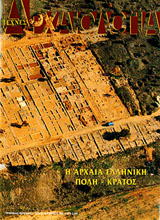
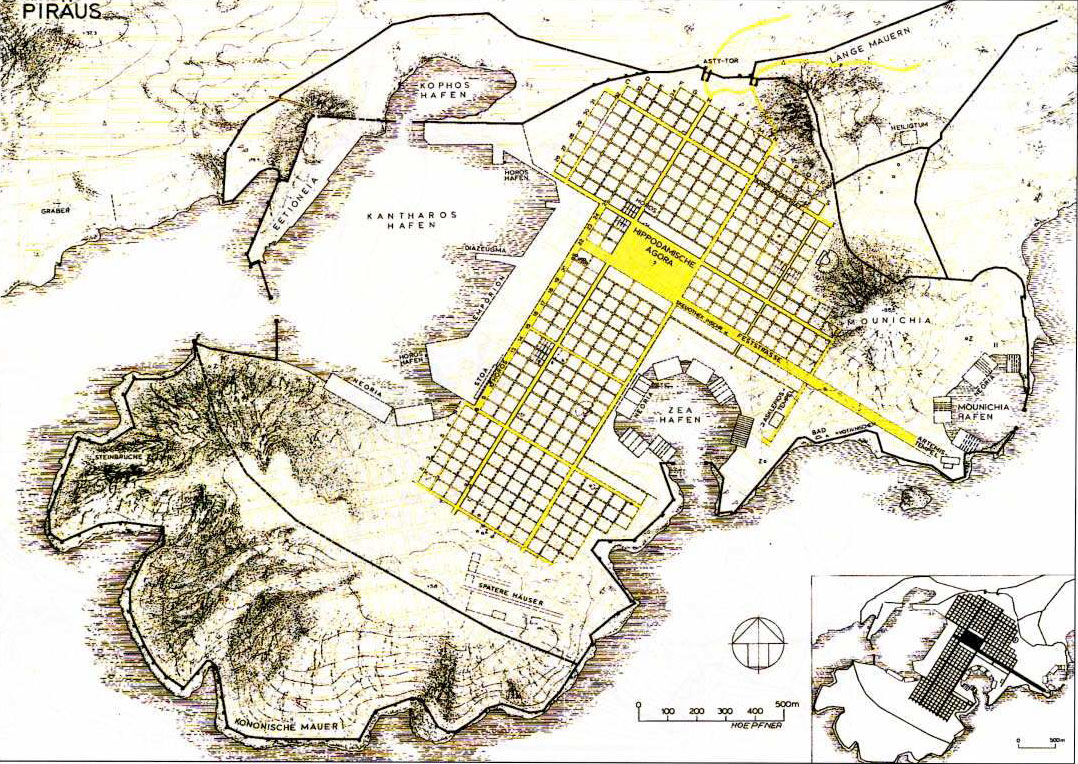 Πειραιάς. Σχέδιο της πόλης από τον Ιππόδαμο.
Στην κοινωνία της Κλασικής περιόδου ο δημόσιος χώρος αποκτά ιδιαίτερη σημασία. Χαρακτηριστικές είναι οι εκτεταμένες δημόσιες περιοχές μέσα στις πόλεις, το φαινόμενο της «τυποποίησης των κατοικιών» σε πόλεις νεόδμητες κατ’ επιταγή της αρχής της ισονομίας, η πολιτιστική σημασία που αποκτά ο ανδρώνας των συμποσίων, ενός θεσμού που ενίσχυε την τάση για την καταξίωση της ύπαρξης του πολίτη μέσα από τη δημόσια ζωή. Ο συγγραφέας παρουσιάζει έξι πόλεις (Μίλητος, Πειραιάς, Αθήνα, Όλυνθος, Ρόδος, Πριήνη) και ένα ηπειρώτικο χωριό (Όρραον) επισημαίνοντας ομοιότητες και διαφορές.
Η Μίλητος είναι η πρώτη ελληνική πόλη-μητρόπολη που ανεγέρθηκε βάσει σχεδίου, έργο αναμφίβολα του Ιππόδαμου. Το σφιχτοπλεγμένο οδικό της δίκτυο είναι πρωτοφανές. Ισομεγέθη τεμάχια ευνοούσαν τις «μονοκατοικίες σε σειρά». Προορισμένο για τα κοινά, το κέντρο της πόλης σχημάτιζε Η, σχήμα που συναντάμε στις πόλεις έως την Ελληνιστική περίοδο.
Ο Πειραιάς είναι η πρώτη πόλη που έχει ανεγερθεί βάσει σαφώς επιστημονικού πολεοδομικού σχεδιασμού. Εκφράζοντας την εκτίμησή τους, οι Αθηναίοι έδωσαν στον Ιππόδαμο το δικαίωμα του πολίτη. Ο Πειραιάς είχε το πιο πυκνό οδικό δίκτυο. Στη δεκαετία του 470 π.Χ. η πόλη έμοιαζε με σύγχρονη συνοικία «κατοικιών σε σειρά». Ο ανδρώνας είχε σχεδιαστεί για να χωράει επτά ανάκλιντρα.
Σε αντίθεση με τη Μίλητο, στις συνοικίες της Αθήνας η ανοικοδόμηση έγινε πάνω στο παλαιό σχέδιο. Σε αντίθεση με τον Πειραιά, δεν υπήρχαν εντυπωσιακοί προθάλαμοι με κίονες και ο ανδρώνας δεν χωρούσε συνήθως πάνω από τρία ανάκλιντρα. Αθήνα, Μίλητος και Πειραιάς τεκμηριώνουν τον βασικό πολεοδομικό κανόνα της εποχής που υπαγόρευε τη διάθεση μεγάλης έκτασης που να διασχίζει την πόλη από άκρη σε άκρη για την ανέγερση μνημείων και δημόσιων οικοδομημάτων. Οι ναοί χτίζονταν κατά προτίμηση πάνω σε ύψωμα για να φαίνονται από μακριά.
Η μακεδονική Όλυνθος ιδρύθηκε το 432 π.Χ. Στο οδικό δίκτυο δεν αντανακλάται το ιπποδάμειο σύστημα. Ο τύπος των τυποποιημένων σπιτιών χαρακτηρίζεται ως οικία με παστάδα. Οι κίονες των παστάδων, που αποτελούσαν ένα είδος πρόσοψης, τεκμηριώνουν και κάποιο χαρακτήρα επίδειξης, άγνωστο στην Αθήνα της εποχής.
Όταν το 408 π.Χ. οι τρεις παλαιές πόλεις της Ρόδου ενώθηκαν σε ενιαίο κράτος, ίδρυσαν στο βορειότερο σημείο του νησιού τη Ρόδο με τα πέντε λιμάνια, τη μεγαλύτερη πόλη που είχε ιδρυθεί έως τότε. Πόλη πρότυπο, η Ρόδος απέκτησε το πυκνότερο οδικό δίκτυο και τους μεγαλύτερους κλήρους για κατοικίες. Για πρώτη φορά, τεράστιοι χώροι αφήνονται κενοί προβλέποντας τη μελλοντική ανάπτυξη.
Τα κατάλοιπα των πιο καλοδιατηρημένων κατοικιών της Κλασικής περιόδου βρίσκονται στο χωριό Όρραον. Το τειχισμένο ωοειδές χωριό με τα 100 περίπου σπίτια δεν είχε θέατρο ούτε γυμνάσιο. Τα σπίτια διαθέτουν χώρο συμποσίων και λουτρό, υπνοδωμάτια και δωμάτια υπηρεσίας. Όπως και οι αγροικίες που έχουν ανασκαφεί στην Αττική, τα σπίτια στο Όρραον δεν υστερούν σε τίποτα από τις κατοικίες των πόλεων.
Η Πριήνη αποτελεί την κορωνίδα του κλασικού αστικού σχεδιασμού. Ολόκληρη η πόλη μπορεί να θεωρηθεί ένα κομψοτέχνημα. Ο αρχιτέκτων Πυθέας δεν κατασκεύασε μόνο ένα σύστημα από ορθογώνιους, παράλληλους δρόμους και τετράγωνα. Ακολουθώντας την πυθαγόρεια φιλοσοφία ενσωμάτωσε τις γωνίες όλων των κτιρίων σε αυτό το περίτεχνο γεωμετρικό δίκτυο. Το σχέδιο περιλαμβάνει τις τυποποιημένες ατομικές κατοικίες και κορυφώνεται στο περίφημο ναό της Αθηνάς που βρίσκεται σε υπερυψωμένη βάση πάνω από την αγορά.
Πειραιάς. Σχέδιο της πόλης από τον Ιππόδαμο.
Στην κοινωνία της Κλασικής περιόδου ο δημόσιος χώρος αποκτά ιδιαίτερη σημασία. Χαρακτηριστικές είναι οι εκτεταμένες δημόσιες περιοχές μέσα στις πόλεις, το φαινόμενο της «τυποποίησης των κατοικιών» σε πόλεις νεόδμητες κατ’ επιταγή της αρχής της ισονομίας, η πολιτιστική σημασία που αποκτά ο ανδρώνας των συμποσίων, ενός θεσμού που ενίσχυε την τάση για την καταξίωση της ύπαρξης του πολίτη μέσα από τη δημόσια ζωή. Ο συγγραφέας παρουσιάζει έξι πόλεις (Μίλητος, Πειραιάς, Αθήνα, Όλυνθος, Ρόδος, Πριήνη) και ένα ηπειρώτικο χωριό (Όρραον) επισημαίνοντας ομοιότητες και διαφορές.
Η Μίλητος είναι η πρώτη ελληνική πόλη-μητρόπολη που ανεγέρθηκε βάσει σχεδίου, έργο αναμφίβολα του Ιππόδαμου. Το σφιχτοπλεγμένο οδικό της δίκτυο είναι πρωτοφανές. Ισομεγέθη τεμάχια ευνοούσαν τις «μονοκατοικίες σε σειρά». Προορισμένο για τα κοινά, το κέντρο της πόλης σχημάτιζε Η, σχήμα που συναντάμε στις πόλεις έως την Ελληνιστική περίοδο.
Ο Πειραιάς είναι η πρώτη πόλη που έχει ανεγερθεί βάσει σαφώς επιστημονικού πολεοδομικού σχεδιασμού. Εκφράζοντας την εκτίμησή τους, οι Αθηναίοι έδωσαν στον Ιππόδαμο το δικαίωμα του πολίτη. Ο Πειραιάς είχε το πιο πυκνό οδικό δίκτυο. Στη δεκαετία του 470 π.Χ. η πόλη έμοιαζε με σύγχρονη συνοικία «κατοικιών σε σειρά». Ο ανδρώνας είχε σχεδιαστεί για να χωράει επτά ανάκλιντρα.
Σε αντίθεση με τη Μίλητο, στις συνοικίες της Αθήνας η ανοικοδόμηση έγινε πάνω στο παλαιό σχέδιο. Σε αντίθεση με τον Πειραιά, δεν υπήρχαν εντυπωσιακοί προθάλαμοι με κίονες και ο ανδρώνας δεν χωρούσε συνήθως πάνω από τρία ανάκλιντρα. Αθήνα, Μίλητος και Πειραιάς τεκμηριώνουν τον βασικό πολεοδομικό κανόνα της εποχής που υπαγόρευε τη διάθεση μεγάλης έκτασης που να διασχίζει την πόλη από άκρη σε άκρη για την ανέγερση μνημείων και δημόσιων οικοδομημάτων. Οι ναοί χτίζονταν κατά προτίμηση πάνω σε ύψωμα για να φαίνονται από μακριά.
Η μακεδονική Όλυνθος ιδρύθηκε το 432 π.Χ. Στο οδικό δίκτυο δεν αντανακλάται το ιπποδάμειο σύστημα. Ο τύπος των τυποποιημένων σπιτιών χαρακτηρίζεται ως οικία με παστάδα. Οι κίονες των παστάδων, που αποτελούσαν ένα είδος πρόσοψης, τεκμηριώνουν και κάποιο χαρακτήρα επίδειξης, άγνωστο στην Αθήνα της εποχής.
Όταν το 408 π.Χ. οι τρεις παλαιές πόλεις της Ρόδου ενώθηκαν σε ενιαίο κράτος, ίδρυσαν στο βορειότερο σημείο του νησιού τη Ρόδο με τα πέντε λιμάνια, τη μεγαλύτερη πόλη που είχε ιδρυθεί έως τότε. Πόλη πρότυπο, η Ρόδος απέκτησε το πυκνότερο οδικό δίκτυο και τους μεγαλύτερους κλήρους για κατοικίες. Για πρώτη φορά, τεράστιοι χώροι αφήνονται κενοί προβλέποντας τη μελλοντική ανάπτυξη.
Τα κατάλοιπα των πιο καλοδιατηρημένων κατοικιών της Κλασικής περιόδου βρίσκονται στο χωριό Όρραον. Το τειχισμένο ωοειδές χωριό με τα 100 περίπου σπίτια δεν είχε θέατρο ούτε γυμνάσιο. Τα σπίτια διαθέτουν χώρο συμποσίων και λουτρό, υπνοδωμάτια και δωμάτια υπηρεσίας. Όπως και οι αγροικίες που έχουν ανασκαφεί στην Αττική, τα σπίτια στο Όρραον δεν υστερούν σε τίποτα από τις κατοικίες των πόλεων.
Η Πριήνη αποτελεί την κορωνίδα του κλασικού αστικού σχεδιασμού. Ολόκληρη η πόλη μπορεί να θεωρηθεί ένα κομψοτέχνημα. Ο αρχιτέκτων Πυθέας δεν κατασκεύασε μόνο ένα σύστημα από ορθογώνιους, παράλληλους δρόμους και τετράγωνα. Ακολουθώντας την πυθαγόρεια φιλοσοφία ενσωμάτωσε τις γωνίες όλων των κτιρίων σε αυτό το περίτεχνο γεωμετρικό δίκτυο. Το σχέδιο περιλαμβάνει τις τυποποιημένες ατομικές κατοικίες και κορυφώνεται στο περίφημο ναό της Αθηνάς που βρίσκεται σε υπερυψωμένη βάση πάνω από την αγορά.
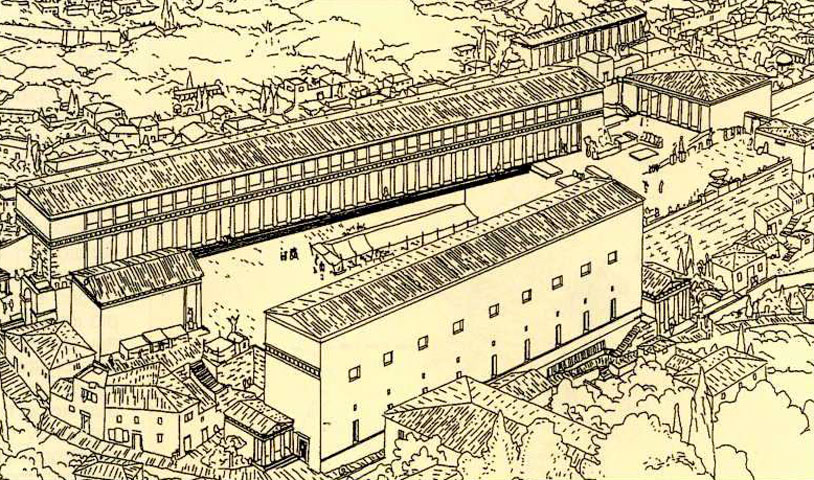 Η αγορά της Άσσου.
Η κυριαρχία των Μακεδόνων βασιλέων είχε μεγάλη επίδραση στις πόλεις του ελληνιστικού κόσμου που έχουν πλέον χάσει την πολιτική τους ανεξαρτησία. Λίγες μόνο πόλεις εξαιρούνται από τις εισφορές που επιβάλλουν οι βασιλείς, οι οποίες όμως αντισταθμίζονται με παροχές και χορηγίες.
Οι νέες πόλεις δημιουργούνται συνήθως από τη συνένωση γειτονικών οικισμών. Έτσι ιδρύεται η Θεσσαλονίκη από τον Κάσσανδρο το 316 π.Χ. και η Δημητριάς στον Παγασητικό από τον Δημήτριο τον Πολιορκητή το 393 π.Χ. Η ταχύτερη μέθοδος για τη δημιουργία νέων πόλεων ήταν η χρήση ενός συστηματικού ιπποδάμειου σχεδίου. Οι νεόδμητες πόλεις σχεδιάζονται ως σειρές από επαναλαμβανόμενα οικοδομικά τετράγωνα, τις νησίδες (insulae). Οι διαστάσεις της κάθε νησίδας ανάγονται στην απλή αναλογία 2 προς 1, και όλα τα κτήρια προσαρμόζονται στο μέγεθος της νησίδας ή των πολλαπλασίων της. Μια εικόνα της διαρρύθμισης των νησίδων κατοικίας μας δίνει η Κασσώπη.
Οι Σελευκίδες βασιλείς ίδρυσαν πάνω από εξήντα πόλεις. Τα πολεοδομικά σχέδια ακολουθούσαν και εδώ ένα στερεότυπο μοντέλο. Οι περισσότερες πόλεις ήταν προσαρμοσμένες στο πρότυπο που χαρακτηρίζει την Αντιόχεια επί του Ορόντη, την οποία διάλεξε για πρωτεύουσά του ο Σέλευκος Α' το 300 π.Χ. Η εγκατάσταση μεγάλου αριθμού αποίκων καθιστούσε αναγκαία την εφαρμογή ενός απλουστευμένου πολεοδομικού σχεδίου, στρατιωτικού τύπου, που συγχρόνως υπογράμμιζε την ισότητα των νέων κατοίκων.
Θύλακες ελληνικού πολιτισμού μέσα σε ένα κόσμο βαρβάρων, οι ελληνιστικές πόλεις επιτηρούσαν τη διατήρηση της αποκλειστικότητάς τους. Από τα σπουδαιότερα μέσα διατήρησης της ελληνικής ανωτερότητας ήταν το γυμνάσιο. Εκπαιδευτικό ίδρυμα που σκόπευε στη φυσική και πνευματική διάπλαση της νεολαίας, το γυμνάσιο ήταν και μια κοινωνική λέσχη με μέλη που προέρχονταν από την άρχουσα τάξη. Από τον 4ο αιώνα π.Χ. το γυμνάσιο αρχίζει να καλλωπίζεται αρχιτεκτονικά ενώ το γεγονός ότι συμπεριλαμβάνεται μέσα στα τείχη και συχνά τοποθετείται κοντά στην αγορά δείχνει την αυξανόμενη σημασία του. Οι εκτεταμένοι εξωραϊσμοί και οι πειραματικές συνθέσεις μνημειακών κτισμάτων βρίσκουν χαρακτηριστικό παράδειγμα στην αγορά της πόλης της Άσσου.
Η πόλη Δούρα-Εύρωπος ιδρύθηκε από τον Σέλευκο Α΄ γύρω στο 300 π.Χ. Βρισκόταν στην κορυφή απόκρημνου οροπεδίου και ήταν περιτειχισμένη με ισχυρά τείχη. Ήταν ο κύριος εμπορικός σταθμός στον Ευφράτη και σε αυτό οφείλεται η κοσμοπολίτικη ανάπτυξή της. Όπως η Δήλος στο Αιγαίο και οι πόλεις των καραβανιών, η Πέτρα, η Παλμύρα και η Γέρασα, η Δούρα-Εύρωπος προσήλκυσε πραματευτές κι εμπόρους κάθε εθνικότητας με αποτέλεσμα ένα εντυπωσιακό μείγμα ελληνικού, παρθικού, σημιτικού και ρωμαϊκού πολιτισμού.
Η Πέργαμος αναμφίβολα αντιπροσωπεύει το αποκορύφωμα του ελληνιστικού πολεοδομικού σχεδιασμού. Χτισμένη σε μια κορυφογραμμή, πρόβαλε με θεαματικό τρόπο την ιδιομορφία του εδάφους χρησιμοποιώντας εκτεταμένες και περίπλοκες βαθμίδες. Στη χαμηλότερη βαθμίδα υπήρχε η επιβλητική αγορά και στην παραπάνω βαθμίδα ένα γυμνασιακό συγκρότημα. Το θεαματικότερο τμήμα της πόλης ήταν, στην κορυφή του βουνού, η ακρόπολη, με το θέατρο στο κεντρικό της σημείο. Στηριγμένο σε ένα ογκώδες αντιτείχισμα, το θέατρο βρισκόταν στην απόκρημνη δυτική πλευρά του χώρου, με θέα τα εδάφη του βασιλείου. Εδώ υπήρχε άλλη μια αγορά, αρκετοί ναοί, ο μεγάλος βωμός του Δία, στρατόπεδο, οπλοστάσιο και το βασιλικό ανάκτορο.
Η αγορά της Άσσου.
Η κυριαρχία των Μακεδόνων βασιλέων είχε μεγάλη επίδραση στις πόλεις του ελληνιστικού κόσμου που έχουν πλέον χάσει την πολιτική τους ανεξαρτησία. Λίγες μόνο πόλεις εξαιρούνται από τις εισφορές που επιβάλλουν οι βασιλείς, οι οποίες όμως αντισταθμίζονται με παροχές και χορηγίες.
Οι νέες πόλεις δημιουργούνται συνήθως από τη συνένωση γειτονικών οικισμών. Έτσι ιδρύεται η Θεσσαλονίκη από τον Κάσσανδρο το 316 π.Χ. και η Δημητριάς στον Παγασητικό από τον Δημήτριο τον Πολιορκητή το 393 π.Χ. Η ταχύτερη μέθοδος για τη δημιουργία νέων πόλεων ήταν η χρήση ενός συστηματικού ιπποδάμειου σχεδίου. Οι νεόδμητες πόλεις σχεδιάζονται ως σειρές από επαναλαμβανόμενα οικοδομικά τετράγωνα, τις νησίδες (insulae). Οι διαστάσεις της κάθε νησίδας ανάγονται στην απλή αναλογία 2 προς 1, και όλα τα κτήρια προσαρμόζονται στο μέγεθος της νησίδας ή των πολλαπλασίων της. Μια εικόνα της διαρρύθμισης των νησίδων κατοικίας μας δίνει η Κασσώπη.
Οι Σελευκίδες βασιλείς ίδρυσαν πάνω από εξήντα πόλεις. Τα πολεοδομικά σχέδια ακολουθούσαν και εδώ ένα στερεότυπο μοντέλο. Οι περισσότερες πόλεις ήταν προσαρμοσμένες στο πρότυπο που χαρακτηρίζει την Αντιόχεια επί του Ορόντη, την οποία διάλεξε για πρωτεύουσά του ο Σέλευκος Α' το 300 π.Χ. Η εγκατάσταση μεγάλου αριθμού αποίκων καθιστούσε αναγκαία την εφαρμογή ενός απλουστευμένου πολεοδομικού σχεδίου, στρατιωτικού τύπου, που συγχρόνως υπογράμμιζε την ισότητα των νέων κατοίκων.
Θύλακες ελληνικού πολιτισμού μέσα σε ένα κόσμο βαρβάρων, οι ελληνιστικές πόλεις επιτηρούσαν τη διατήρηση της αποκλειστικότητάς τους. Από τα σπουδαιότερα μέσα διατήρησης της ελληνικής ανωτερότητας ήταν το γυμνάσιο. Εκπαιδευτικό ίδρυμα που σκόπευε στη φυσική και πνευματική διάπλαση της νεολαίας, το γυμνάσιο ήταν και μια κοινωνική λέσχη με μέλη που προέρχονταν από την άρχουσα τάξη. Από τον 4ο αιώνα π.Χ. το γυμνάσιο αρχίζει να καλλωπίζεται αρχιτεκτονικά ενώ το γεγονός ότι συμπεριλαμβάνεται μέσα στα τείχη και συχνά τοποθετείται κοντά στην αγορά δείχνει την αυξανόμενη σημασία του. Οι εκτεταμένοι εξωραϊσμοί και οι πειραματικές συνθέσεις μνημειακών κτισμάτων βρίσκουν χαρακτηριστικό παράδειγμα στην αγορά της πόλης της Άσσου.
Η πόλη Δούρα-Εύρωπος ιδρύθηκε από τον Σέλευκο Α΄ γύρω στο 300 π.Χ. Βρισκόταν στην κορυφή απόκρημνου οροπεδίου και ήταν περιτειχισμένη με ισχυρά τείχη. Ήταν ο κύριος εμπορικός σταθμός στον Ευφράτη και σε αυτό οφείλεται η κοσμοπολίτικη ανάπτυξή της. Όπως η Δήλος στο Αιγαίο και οι πόλεις των καραβανιών, η Πέτρα, η Παλμύρα και η Γέρασα, η Δούρα-Εύρωπος προσήλκυσε πραματευτές κι εμπόρους κάθε εθνικότητας με αποτέλεσμα ένα εντυπωσιακό μείγμα ελληνικού, παρθικού, σημιτικού και ρωμαϊκού πολιτισμού.
Η Πέργαμος αναμφίβολα αντιπροσωπεύει το αποκορύφωμα του ελληνιστικού πολεοδομικού σχεδιασμού. Χτισμένη σε μια κορυφογραμμή, πρόβαλε με θεαματικό τρόπο την ιδιομορφία του εδάφους χρησιμοποιώντας εκτεταμένες και περίπλοκες βαθμίδες. Στη χαμηλότερη βαθμίδα υπήρχε η επιβλητική αγορά και στην παραπάνω βαθμίδα ένα γυμνασιακό συγκρότημα. Το θεαματικότερο τμήμα της πόλης ήταν, στην κορυφή του βουνού, η ακρόπολη, με το θέατρο στο κεντρικό της σημείο. Στηριγμένο σε ένα ογκώδες αντιτείχισμα, το θέατρο βρισκόταν στην απόκρημνη δυτική πλευρά του χώρου, με θέα τα εδάφη του βασιλείου. Εδώ υπήρχε άλλη μια αγορά, αρκετοί ναοί, ο μεγάλος βωμός του Δία, στρατόπεδο, οπλοστάσιο και το βασιλικό ανάκτορο.
 Αρχαία Σμύρνη, κατά φαντασία αναπαράσταση του οικισμού προς το τέλος του 7ου αι. π.Χ.
Μεμονωμένα πολεοδομικά στοιχεία δοκιμάζονται για να τεκμηριώσουν απαντήσεις στα ερωτήματα ως προς τη γένεση και την εξέλιξη της πόλης-κράτους. Τέτοια στοιχεία είναι το τείχος, η αγορά, κάποιο τέμενος, το δίκτυο ύδρευσης, ένας αναλημματικός τοίχος κ.ά. Στα αρχαϊκά Μέγαρα Υβλαία, η ανάπτυξη των κατοικιών γύρω από την τραπεζοειδούς σχήματος αγορά εξηγεί την παρέκκλιση από το αυστηρά ορθογωνικό πολεοδομικό σχέδιο. Πολεοδομικές εικόνες προσφέρουν και οι πολεοδομικοί πυρήνες, που συνήθως συνίστανται από τις ομάδες των κατοικιών. Το παράδειγμα του οικισμού της Λαθούριζας, λίγο νοτιότερα της υστερογεωμετρικής και αρχαϊκής πόλης των Αθηνών, αν και επιδεικνύει ποικιλία αρχιτεκτονικών τύπων κατοικιών και ένα πολεοδομικό ιστό ανένταχτο στις συνήθεις τυπολογήσεις, συνιστά χαρακτηριστικό παράδειγμα πολεοδομικού πυρήνα πρόδρομου αυτών που κατόπιν αναπτύχθηκαν στις εν άστει οικιστικές συγκεντρώσεις. Τέλος, τα πολεοδομικά σύνολα συνίστανται από συστηματοποιημένες ομαδοποιήσεις πολεοδομικών στοιχείων και πολεοδομικών πυρήνων.
Για την τυπολόγηση πολεοδομικών συνόλων έχουν χρησιμοποιηθεί μορφολογικά και λειτουργικά κριτήρια. Πιο στέρεη βάση όμως προσφέρει το κριτήριο του ευρύτερου γεωγραφικού χώρου μέσα στον οποίο εμφανίζεται το πολεοδομικό σύνολο.
Α. Σε μια πρώτη κατηγορία ομαδοποιούνται οι πολεοδομικοί τύποι του μικρασιατικού χώρου: Έφεσος, Σμύρνη, Μίλητος, Μελίη, Λάρισα επί του Έρμου, Νεανδρία. Στη Μελίη ο οικισμός απεικονίζει τον πρώτο πολεοδομικό τύπο οικισμού, τον τόπο κατοικίας του νεοαφιχθέντος ηγεμόνος από τον ελλαδικό χώρο. Η Σμύρνη και η Μίλητος όμως δεν επαληθεύουν το πολεοδομικό πρότυπο της Μελίης. Στη Μίλητο δεν αλλάζει μόνο η πολεοδομική κλίμακα αλλά επιπλέον διακρίνεται αμυδρά η τήρηση αξόνων προσανατολισμού στους καμπυλόσχημους πολεοδομικούς πυρήνες της Υστερογεωμετρικής περιόδου, γεγονός που προαγγέλλει την προσχεδιασμένη σύλληψη του χώρου.
Β. Στη δεύτερη κατηγορία κατατάσσονται οι τύποι που προδιαγράφουν τις απαρχές της πολεοδομικής σχεδίασης στο χώρο της νοτίου Ιταλίας και της Σικελίας: Μέγαρα Υβλαία, Κασμέναι, Σελινούς, Μεταπόντιο, Ακράγας. Ο αρχαϊκός πολεοδομικός ιστός στις περισσότερες από τις αποικίες συνίσταται από τα γνώριμα ορθογώνια τετράγωνα που ορίζονται από παράλληλους και κάθετους μεταξύ τους δρόμους. Η σύλληψη του σχήματος αυτού αποδίδεται από κάποιους στις απαρχές της εξορθολογισμένης πολεοδόμησης των μητροπόλεων της Μ. Ασίας και δη της Μιλήτου. Παρά το ασύμβατο των χρόνων, στον πολεοδομικό χώρο αναγνωρίζεται η υλοποίηση των αλλαγών που συνέβησαν στον πνευματικό χώρο των Ιώνων φιλοσόφων.
Γ. Στην τρίτη κατηγορία ανήκουν οι εντελώς ιδιόμορφοι τύποι των εσχατιών του αποικιακού χώρου, η Ολβία στον Πόντο αλλά και η Κυρήνη στη Βόρειο Αφρική.
Δ. Οι τύποι που εμφανίζονται στον ελλαδικό χώρο απεικονίζουν μια αυτόχθονη, μη προσχεδιασμένη πολεοδομία.
Τίθεται το ερώτημα: μπορούμε μέσω της θεώρησης της υστερογεωμετρικής-αρχαϊκής πολεοδομίας να ιχνηλατήσουμε ιστορικά φαινόμενα ή και γεγονότα αλλά και πνευματικές δραστηριότητες όπως είναι ο πολεοδομικός σχεδιασμός; Η ποικιλία των υστερογεωμετρικών πολεοδομικών τύπων, η καθόλου αυτονόητη μετεξέλιξή τους προς τα ευανάγνωστα και εξορθολογισμένα σχήματα πόλεων του τέλους της αρχαϊκής περιόδου, οι επιβιώσεις προγενέστερων πολεοδομικών διευθετήσεων αλλά και οι ασυνέχειες εντός των πολεοδομικών ιστών, κάθε άλλο παρά οδηγούν σε μονόπλευρες ερμηνευτικές προσεγγίσεις. Αν εξαιρέσουμε τις πόλεις του αποικιακού χώρου που αναδύθηκαν εκ του μηδενός, οι ερμηνείες της πολεοδομικής εξέλιξης των πόλεων της μητροπολιτικής Ελλάδας και της Μικράς Ασίας είναι δέσμιες των ιστοριών της κάθε πόλης-κράτους, ιδιαίτερα των γεωφυσικών παραμέτρων του περιβάλλοντος χώρου.
Αρχαία Σμύρνη, κατά φαντασία αναπαράσταση του οικισμού προς το τέλος του 7ου αι. π.Χ.
Μεμονωμένα πολεοδομικά στοιχεία δοκιμάζονται για να τεκμηριώσουν απαντήσεις στα ερωτήματα ως προς τη γένεση και την εξέλιξη της πόλης-κράτους. Τέτοια στοιχεία είναι το τείχος, η αγορά, κάποιο τέμενος, το δίκτυο ύδρευσης, ένας αναλημματικός τοίχος κ.ά. Στα αρχαϊκά Μέγαρα Υβλαία, η ανάπτυξη των κατοικιών γύρω από την τραπεζοειδούς σχήματος αγορά εξηγεί την παρέκκλιση από το αυστηρά ορθογωνικό πολεοδομικό σχέδιο. Πολεοδομικές εικόνες προσφέρουν και οι πολεοδομικοί πυρήνες, που συνήθως συνίστανται από τις ομάδες των κατοικιών. Το παράδειγμα του οικισμού της Λαθούριζας, λίγο νοτιότερα της υστερογεωμετρικής και αρχαϊκής πόλης των Αθηνών, αν και επιδεικνύει ποικιλία αρχιτεκτονικών τύπων κατοικιών και ένα πολεοδομικό ιστό ανένταχτο στις συνήθεις τυπολογήσεις, συνιστά χαρακτηριστικό παράδειγμα πολεοδομικού πυρήνα πρόδρομου αυτών που κατόπιν αναπτύχθηκαν στις εν άστει οικιστικές συγκεντρώσεις. Τέλος, τα πολεοδομικά σύνολα συνίστανται από συστηματοποιημένες ομαδοποιήσεις πολεοδομικών στοιχείων και πολεοδομικών πυρήνων.
Για την τυπολόγηση πολεοδομικών συνόλων έχουν χρησιμοποιηθεί μορφολογικά και λειτουργικά κριτήρια. Πιο στέρεη βάση όμως προσφέρει το κριτήριο του ευρύτερου γεωγραφικού χώρου μέσα στον οποίο εμφανίζεται το πολεοδομικό σύνολο.
Α. Σε μια πρώτη κατηγορία ομαδοποιούνται οι πολεοδομικοί τύποι του μικρασιατικού χώρου: Έφεσος, Σμύρνη, Μίλητος, Μελίη, Λάρισα επί του Έρμου, Νεανδρία. Στη Μελίη ο οικισμός απεικονίζει τον πρώτο πολεοδομικό τύπο οικισμού, τον τόπο κατοικίας του νεοαφιχθέντος ηγεμόνος από τον ελλαδικό χώρο. Η Σμύρνη και η Μίλητος όμως δεν επαληθεύουν το πολεοδομικό πρότυπο της Μελίης. Στη Μίλητο δεν αλλάζει μόνο η πολεοδομική κλίμακα αλλά επιπλέον διακρίνεται αμυδρά η τήρηση αξόνων προσανατολισμού στους καμπυλόσχημους πολεοδομικούς πυρήνες της Υστερογεωμετρικής περιόδου, γεγονός που προαγγέλλει την προσχεδιασμένη σύλληψη του χώρου.
Β. Στη δεύτερη κατηγορία κατατάσσονται οι τύποι που προδιαγράφουν τις απαρχές της πολεοδομικής σχεδίασης στο χώρο της νοτίου Ιταλίας και της Σικελίας: Μέγαρα Υβλαία, Κασμέναι, Σελινούς, Μεταπόντιο, Ακράγας. Ο αρχαϊκός πολεοδομικός ιστός στις περισσότερες από τις αποικίες συνίσταται από τα γνώριμα ορθογώνια τετράγωνα που ορίζονται από παράλληλους και κάθετους μεταξύ τους δρόμους. Η σύλληψη του σχήματος αυτού αποδίδεται από κάποιους στις απαρχές της εξορθολογισμένης πολεοδόμησης των μητροπόλεων της Μ. Ασίας και δη της Μιλήτου. Παρά το ασύμβατο των χρόνων, στον πολεοδομικό χώρο αναγνωρίζεται η υλοποίηση των αλλαγών που συνέβησαν στον πνευματικό χώρο των Ιώνων φιλοσόφων.
Γ. Στην τρίτη κατηγορία ανήκουν οι εντελώς ιδιόμορφοι τύποι των εσχατιών του αποικιακού χώρου, η Ολβία στον Πόντο αλλά και η Κυρήνη στη Βόρειο Αφρική.
Δ. Οι τύποι που εμφανίζονται στον ελλαδικό χώρο απεικονίζουν μια αυτόχθονη, μη προσχεδιασμένη πολεοδομία.
Τίθεται το ερώτημα: μπορούμε μέσω της θεώρησης της υστερογεωμετρικής-αρχαϊκής πολεοδομίας να ιχνηλατήσουμε ιστορικά φαινόμενα ή και γεγονότα αλλά και πνευματικές δραστηριότητες όπως είναι ο πολεοδομικός σχεδιασμός; Η ποικιλία των υστερογεωμετρικών πολεοδομικών τύπων, η καθόλου αυτονόητη μετεξέλιξή τους προς τα ευανάγνωστα και εξορθολογισμένα σχήματα πόλεων του τέλους της αρχαϊκής περιόδου, οι επιβιώσεις προγενέστερων πολεοδομικών διευθετήσεων αλλά και οι ασυνέχειες εντός των πολεοδομικών ιστών, κάθε άλλο παρά οδηγούν σε μονόπλευρες ερμηνευτικές προσεγγίσεις. Αν εξαιρέσουμε τις πόλεις του αποικιακού χώρου που αναδύθηκαν εκ του μηδενός, οι ερμηνείες της πολεοδομικής εξέλιξης των πόλεων της μητροπολιτικής Ελλάδας και της Μικράς Ασίας είναι δέσμιες των ιστοριών της κάθε πόλης-κράτους, ιδιαίτερα των γεωφυσικών παραμέτρων του περιβάλλοντος χώρου.
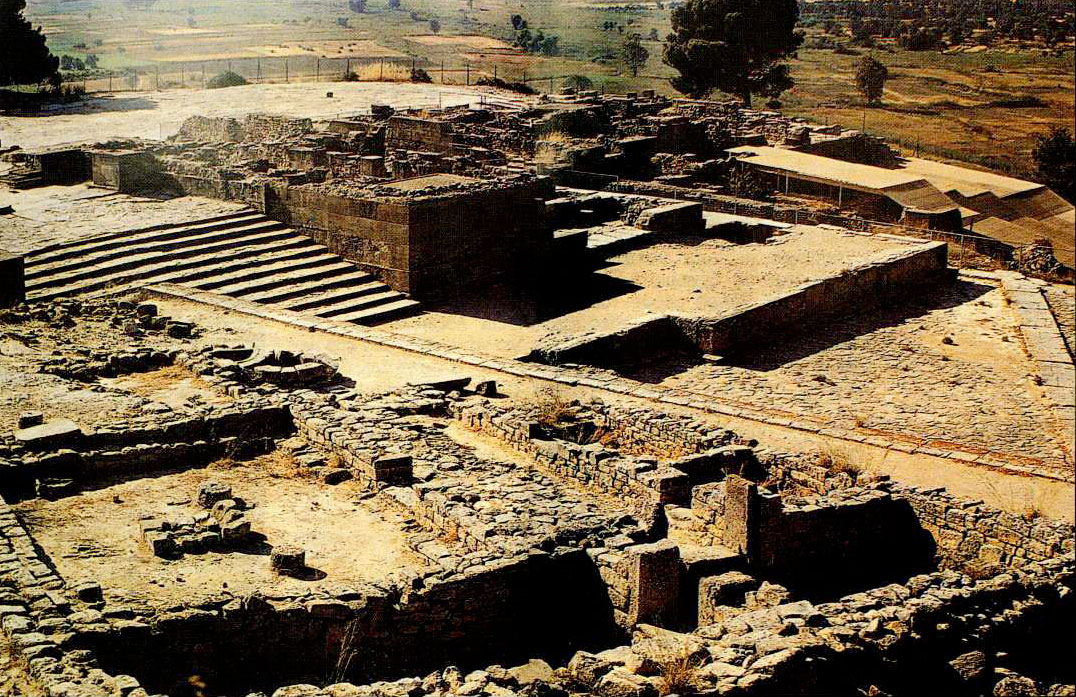 Φαιστός, γεωμετρικός οικισμός.
Στην ανακτορική κοινωνία της Μυκηναϊκής περιόδου το θρησκευτικό και διοικητικό κέντρο βρισκόταν μέσα στην τειχισμένη ακρόπολη, στο ανάκτορο του μονάρχη, που διηύθυνε συνολικά μια μεγάλη περιφέρεια με πολλά και μικρά οικιστικά σύνολα. Αντίθετα, η πόλη-κράτος των Ιστορικών χρόνων μαζί με την περιφέρειά της αποτελούσε αυτόνομη πολιτική ενότητα με ένα κύριο μεγάλο οικισμό, στον οποίο από πολεοδομική άποψη κυριαρχούσε το ιερό της πολιούχου θεότητας και η αγορά με τα δημόσια οικοδομήματα. Ο όρος «Σκοτεινοί χρόνοι» ορίζει την περίοδο που μεσολαβεί από το τέλος του μυκηναϊκού πολιτισμού έως τη δημιουργία της πόλης-κράτους (περ. 1100-750 π.Χ.). Σήμερα, ύστερα από τα ευρήματα των νεκροταφείων στο Λευκαντί και την Κνωσό, υποδηλώνει κυρίως την αποσπασματική μας γνώση για τους οικισμούς της μεταμυκηναϊκής περιόδου.
Ο αριθμός των οικισμών δεν μπορεί να προσδιοριστεί, είναι όμως σαφές πως έχουμε συνθήκες μόνιμης εγκατάστασης. Τα μεγαλύτερα οικοδομήματα που εμφανίζονται στους μικρούς οικιστικούς πυρήνες ερμηνεύονται συνήθως ως «οικίες αρχόντων». Στις περισσότερες θέσεις, όπου αργότερα αναπτύσσονται μεγάλες πόλεις-κράτη, εντοπίζονται περιφερειακά πολλοί οικιστικοί πυρήνες, οι οποίοι επιβεβαιώνουν τον αριστοτελικό όρο για την «κατά κώμας οίκησιν» που προηγήθηκε της πόλης. Οι μυκηναϊκές ακροπόλεις θα μείνουν ακατοίκητες και, από τον 8ο αιώνα π.Χ. και μετά, θα φιλοξενήσουν μόνο το ναό της θεότητας. Αντίθετα, η κατοίκηση των μινωικών κέντρων είναι συχνά συνεχής. Ιδιαίτερη κατηγορία αποτελούν τα μεγάλα κέντρα του ανατολικού Αιγαίου (Σάμος, Σμύρνη, Μίλητος) που ιδρύονται στο πλαίσιο του ιωνικού αποικισμού και αναπτύσσονται ταχύτατα σε μεγάλα αστικά κέντρα. Ιδιότυπη κατηγορία οικισμών αυτής της περιόδου αποτελούν οι «οικισμοί φυγάδων» σε δυσπρόσιτες θέσεις της ανατολικής Κρήτης.
Η αγορά εμφανίζεται μόλις κατά τον 8ο αιώνα π.Χ. Θρησκευτικά κέντρα πριν από τον 9ο αιώνα π.Χ. δεν ταυτίζονται γιατί η λατρεία είναι υπαίθρια και συντελείται γύρω από κάποιο βωμό. Τα νεκροταφεία είναι κατά κανόνα παρόδια και καλά οργανωμένα. Οι παλιότεροι οικισμοί των Σκοτεινών χρόνων είναι ατείχιστοι. Το πρωιμότερο τείχος των Ιστορικών χρόνων είναι το τείχος της Σμύρνης (περί το 850 π.Χ.).
Φαιστός, γεωμετρικός οικισμός.
Στην ανακτορική κοινωνία της Μυκηναϊκής περιόδου το θρησκευτικό και διοικητικό κέντρο βρισκόταν μέσα στην τειχισμένη ακρόπολη, στο ανάκτορο του μονάρχη, που διηύθυνε συνολικά μια μεγάλη περιφέρεια με πολλά και μικρά οικιστικά σύνολα. Αντίθετα, η πόλη-κράτος των Ιστορικών χρόνων μαζί με την περιφέρειά της αποτελούσε αυτόνομη πολιτική ενότητα με ένα κύριο μεγάλο οικισμό, στον οποίο από πολεοδομική άποψη κυριαρχούσε το ιερό της πολιούχου θεότητας και η αγορά με τα δημόσια οικοδομήματα. Ο όρος «Σκοτεινοί χρόνοι» ορίζει την περίοδο που μεσολαβεί από το τέλος του μυκηναϊκού πολιτισμού έως τη δημιουργία της πόλης-κράτους (περ. 1100-750 π.Χ.). Σήμερα, ύστερα από τα ευρήματα των νεκροταφείων στο Λευκαντί και την Κνωσό, υποδηλώνει κυρίως την αποσπασματική μας γνώση για τους οικισμούς της μεταμυκηναϊκής περιόδου.
Ο αριθμός των οικισμών δεν μπορεί να προσδιοριστεί, είναι όμως σαφές πως έχουμε συνθήκες μόνιμης εγκατάστασης. Τα μεγαλύτερα οικοδομήματα που εμφανίζονται στους μικρούς οικιστικούς πυρήνες ερμηνεύονται συνήθως ως «οικίες αρχόντων». Στις περισσότερες θέσεις, όπου αργότερα αναπτύσσονται μεγάλες πόλεις-κράτη, εντοπίζονται περιφερειακά πολλοί οικιστικοί πυρήνες, οι οποίοι επιβεβαιώνουν τον αριστοτελικό όρο για την «κατά κώμας οίκησιν» που προηγήθηκε της πόλης. Οι μυκηναϊκές ακροπόλεις θα μείνουν ακατοίκητες και, από τον 8ο αιώνα π.Χ. και μετά, θα φιλοξενήσουν μόνο το ναό της θεότητας. Αντίθετα, η κατοίκηση των μινωικών κέντρων είναι συχνά συνεχής. Ιδιαίτερη κατηγορία αποτελούν τα μεγάλα κέντρα του ανατολικού Αιγαίου (Σάμος, Σμύρνη, Μίλητος) που ιδρύονται στο πλαίσιο του ιωνικού αποικισμού και αναπτύσσονται ταχύτατα σε μεγάλα αστικά κέντρα. Ιδιότυπη κατηγορία οικισμών αυτής της περιόδου αποτελούν οι «οικισμοί φυγάδων» σε δυσπρόσιτες θέσεις της ανατολικής Κρήτης.
Η αγορά εμφανίζεται μόλις κατά τον 8ο αιώνα π.Χ. Θρησκευτικά κέντρα πριν από τον 9ο αιώνα π.Χ. δεν ταυτίζονται γιατί η λατρεία είναι υπαίθρια και συντελείται γύρω από κάποιο βωμό. Τα νεκροταφεία είναι κατά κανόνα παρόδια και καλά οργανωμένα. Οι παλιότεροι οικισμοί των Σκοτεινών χρόνων είναι ατείχιστοι. Το πρωιμότερο τείχος των Ιστορικών χρόνων είναι το τείχος της Σμύρνης (περί το 850 π.Χ.).
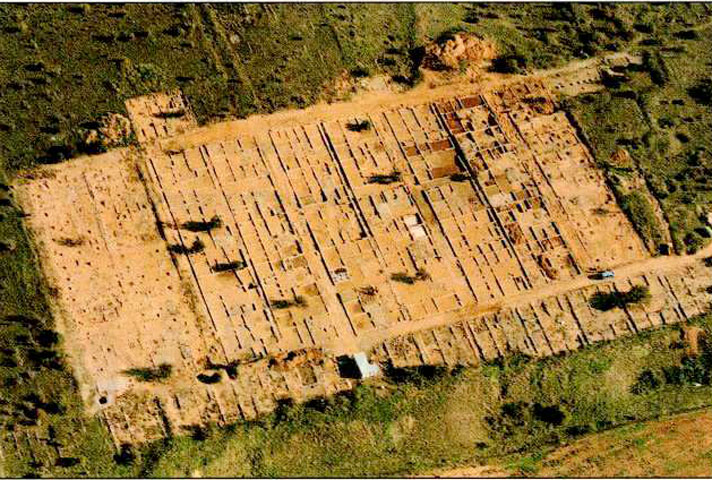 Αεροφωτογραφία κεντρικού τομέα οικισμού Βόρειου Λόφου Ολύνθου κατά τη διάρκεια των αναστηλωτικών εργασιών.
Το δεύτερο τεύχος του αφιερώματος για την πόλη της Ελλάδας, συντονισμένο πάντοτε από τον Α.-Φ. Λαγόπουλο, διεισδύει στην πρώτη χιλιετία π.Χ. για να μελετήσει αυτήν την πολιτική και χωρική ενότητα που είναι η πόλις, η πόλη-κράτος. Οι συγγραφείς καταγράφουν την περίοδο εκκόλαψης αυτού του νέου κοινωνικού μορφώματος, τη φάση ανάδυσής του, το απόγειό του κατά την Κλασική περίοδο και την εκ των έσω φθορά του, την Ελληνιστική. Τα πέντε γενικά άρθρα του αφιερώματος εμπλουτίζουν τέσσερις μονογραφίες για την Κεντρική Μακεδονία.
Αεροφωτογραφία κεντρικού τομέα οικισμού Βόρειου Λόφου Ολύνθου κατά τη διάρκεια των αναστηλωτικών εργασιών.
Το δεύτερο τεύχος του αφιερώματος για την πόλη της Ελλάδας, συντονισμένο πάντοτε από τον Α.-Φ. Λαγόπουλο, διεισδύει στην πρώτη χιλιετία π.Χ. για να μελετήσει αυτήν την πολιτική και χωρική ενότητα που είναι η πόλις, η πόλη-κράτος. Οι συγγραφείς καταγράφουν την περίοδο εκκόλαψης αυτού του νέου κοινωνικού μορφώματος, τη φάση ανάδυσής του, το απόγειό του κατά την Κλασική περίοδο και την εκ των έσω φθορά του, την Ελληνιστική. Τα πέντε γενικά άρθρα του αφιερώματος εμπλουτίζουν τέσσερις μονογραφίες για την Κεντρική Μακεδονία.
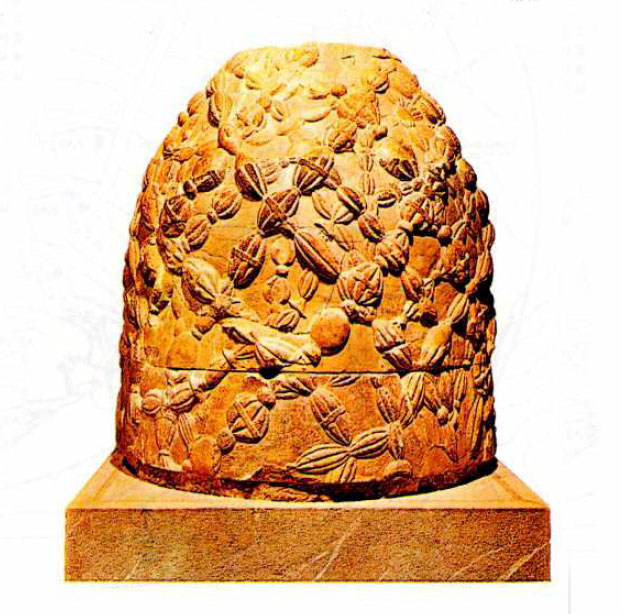 Ο ομφαλός των Δελφών (σύμφωνα με τον Basil Petrakos, «Delphi», Clio Editions, Athens 1977).
Η παραγωγή του χώρου στην αρχαία Ελλάδα είναι αδύνατο να αποσυνδεθεί από μια ιδεολογία που κυριαρχείται από μυθικά πρότυπα. Η ακρόπολη του Διμηνίου, που περιβάλλεται από έξι ομόκεντρα τείχη, ίσως υποδηλώνει κάποιον κοσμικό συμβολισμό. Κάτι ανάλογο πιθανόν συμβαίνει με το ανάκτορο της Κνωσού, το οποίο ταυτίζεται με το λαβύρινθο που, με τη σειρά του, ταυτίζεται με εικόνα του κόσμου.
Στον πρώτο μύθο για την ίδρυση του μυκηναϊκού οικισμού της Καδμείας, ο ήρωας θανατώνει ένα δράκο που αντιπροσωπεύει το χάος. Ο οικισμός που ακολουθεί τη νίκη ταυτίζεται με την τάξη του σύμπαντος.
Ο κοσμικός άξονας διέρχεται από το κέντρο του κόσμου που ταυτίζεται με ομφαλό. Το μαντείο των Δελφών κατείχε μια κοσμική κεντρικότητα. Με την έννοια του ομφαλού είναι στενά συνδεδεμένη η θεά Εστία. Στην κοσμολογία των Πυθαγορείων κοσμικό κέντρο είναι η εστία μαζί με τη φωτιά. Στην πόλη-κράτος κοσμικό κέντρο είναι και η αγορά. Στην Αθήνα, η μεταρρύθμιση του Κλεισθένη στηρίχτηκε στην αρχή της ισονομίας που συνδέεται στενά με την έννοια της συμμετρίας. Στο χωρικό μοντέλο του Κλεισθένη, ο χώρος υπακούει στη σύμμετρη τάξη του «κόσμου».
Ο Ιππόδαμος οργάνωσε τον αστικό χώρο με ένα οδικό δίκτυο αποτελούμενο από μια σχάρα παράλληλων και κάθετων αρτηριών. Η πολεοδομική του σύλληψη είναι άρρηκτα συνδεδεμένη με τους αριθμούς 3 και 10. Κοσμολογικές έννοιες καθώς και η έννοια της συμμετρίας χαρακτηρίζουν την ιδανική πόλη-κράτος του Πλάτωνα στους Νόμους. Η γεωμετρία και η αριθμολογία των Νόμων συγγενεύει στενά με την πλατωνική κοσμογονία και κοσμολογία του Τίμαιου, καθώς και με την περιγραφή της Ατλαντίδας στον Κριτία.
Ο ομφαλός των Δελφών (σύμφωνα με τον Basil Petrakos, «Delphi», Clio Editions, Athens 1977).
Η παραγωγή του χώρου στην αρχαία Ελλάδα είναι αδύνατο να αποσυνδεθεί από μια ιδεολογία που κυριαρχείται από μυθικά πρότυπα. Η ακρόπολη του Διμηνίου, που περιβάλλεται από έξι ομόκεντρα τείχη, ίσως υποδηλώνει κάποιον κοσμικό συμβολισμό. Κάτι ανάλογο πιθανόν συμβαίνει με το ανάκτορο της Κνωσού, το οποίο ταυτίζεται με το λαβύρινθο που, με τη σειρά του, ταυτίζεται με εικόνα του κόσμου.
Στον πρώτο μύθο για την ίδρυση του μυκηναϊκού οικισμού της Καδμείας, ο ήρωας θανατώνει ένα δράκο που αντιπροσωπεύει το χάος. Ο οικισμός που ακολουθεί τη νίκη ταυτίζεται με την τάξη του σύμπαντος.
Ο κοσμικός άξονας διέρχεται από το κέντρο του κόσμου που ταυτίζεται με ομφαλό. Το μαντείο των Δελφών κατείχε μια κοσμική κεντρικότητα. Με την έννοια του ομφαλού είναι στενά συνδεδεμένη η θεά Εστία. Στην κοσμολογία των Πυθαγορείων κοσμικό κέντρο είναι η εστία μαζί με τη φωτιά. Στην πόλη-κράτος κοσμικό κέντρο είναι και η αγορά. Στην Αθήνα, η μεταρρύθμιση του Κλεισθένη στηρίχτηκε στην αρχή της ισονομίας που συνδέεται στενά με την έννοια της συμμετρίας. Στο χωρικό μοντέλο του Κλεισθένη, ο χώρος υπακούει στη σύμμετρη τάξη του «κόσμου».
Ο Ιππόδαμος οργάνωσε τον αστικό χώρο με ένα οδικό δίκτυο αποτελούμενο από μια σχάρα παράλληλων και κάθετων αρτηριών. Η πολεοδομική του σύλληψη είναι άρρηκτα συνδεδεμένη με τους αριθμούς 3 και 10. Κοσμολογικές έννοιες καθώς και η έννοια της συμμετρίας χαρακτηρίζουν την ιδανική πόλη-κράτος του Πλάτωνα στους Νόμους. Η γεωμετρία και η αριθμολογία των Νόμων συγγενεύει στενά με την πλατωνική κοσμογονία και κοσμολογία του Τίμαιου, καθώς και με την περιγραφή της Ατλαντίδας στον Κριτία.
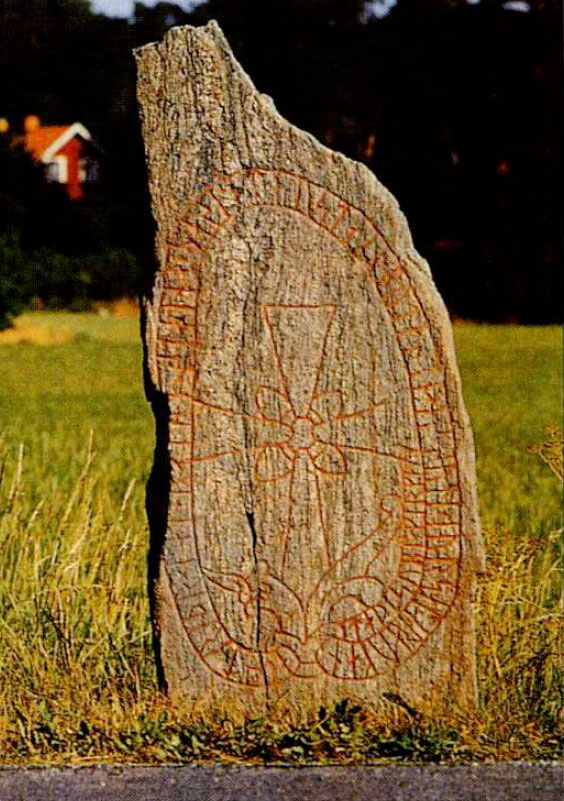 Ρουνική επιγραφή σε πέτρα που μας μιλά για κάποιον άντρα ο οποίος ήταν στην Ελλάδα και πήρε μερίδιο από το χρυσάφι.
Το μόνο είδος γραπτού λόγου στη Σκανδιναβία στα χρόνια της Βυζαντινής αυτοκρατορίας ήταν οι ρούνοι, γράμματα σμιλευμένα σε πέτρα, που εμφανίστηκαν τον 11ο αιώνα. Οι ρούνοι περιείχαν είτε απλά χαραγμένες λέξεις και ονόματα είτε επίσημες, διακοσμημένες επιγραφές στη μνήμη κάποιων προσώπων.
Εικοσιέξι ρούνοι πληροφορούν για ταξίδια Σκανδιναβών στο Βυζάντιο. Σε δεκαπέντε από αυτούς, οι άντρες που αόριστα εμφανίζονται να έχουν πεθάνει στην Ελλάδα, δεν αποκλείεται να υπήρξαν ξένοι μισθοφόροι στρατιώτες. Είναι άλλωστε γνωστό το σώμα των Βαράγκων που δημιούργησε στις αρχές του 10ου αιώνα ο Βασίλειος Β΄ για να τους χρησιμοποιήσει στην προσωπική του φρουρά. Δυο ρουνικές επιγραφές δηλώνουν πως ορισμένοι άντρες πήγαν στην Ελλάδα για «να μοιράσουν χρυσό». Ήταν άραγε μισθοφόροι ή έμποροι;
Από τα βυζαντινά αντικείμενα που βρέθηκαν στη Σκανδιναβία, 635 νομίσματα βρέθηκαν στη Σουηδία σε θησαυρούς, τάφους ή ανάμεσα σε άλλα ευρήματα σε κατοικίες, όλα από την εποχή των Vikings (800-1150). Τα περισσότερα είναι ασημένια και βρέθηκαν στο νησί Gotland. Έχει διαπιστωθεί πως τα νομίσματα ήταν θαμμένα κάτω από τα θεμέλια των σπιτιών για πολλές γενιές.
Τα άλλα βυζαντινά αντικείμενα της Σκανδιναβίας έχουν σχεδόν όλα θρησκευτικό χαρακτήρα. Ξεχωρίζουν δυο σφραγίδες από το Hedeby/Ribe της Δανίας με ελληνικές επιγραφές που δηλώνουν την ταυτότητα του κατόχου τους.
Τέλος, σε γυναικείους και ανδρικούς τάφους του 9ου και του 10ου αιώνα στο νησί Birka της Σουηδίας βρέθηκαν κομμάτια μεταξωτά υφάσματα με χρυσό και ασήμι στη διακόσμησή τους, σύμφωνα με τα βυζαντινά πρότυπα.
Ρουνική επιγραφή σε πέτρα που μας μιλά για κάποιον άντρα ο οποίος ήταν στην Ελλάδα και πήρε μερίδιο από το χρυσάφι.
Το μόνο είδος γραπτού λόγου στη Σκανδιναβία στα χρόνια της Βυζαντινής αυτοκρατορίας ήταν οι ρούνοι, γράμματα σμιλευμένα σε πέτρα, που εμφανίστηκαν τον 11ο αιώνα. Οι ρούνοι περιείχαν είτε απλά χαραγμένες λέξεις και ονόματα είτε επίσημες, διακοσμημένες επιγραφές στη μνήμη κάποιων προσώπων.
Εικοσιέξι ρούνοι πληροφορούν για ταξίδια Σκανδιναβών στο Βυζάντιο. Σε δεκαπέντε από αυτούς, οι άντρες που αόριστα εμφανίζονται να έχουν πεθάνει στην Ελλάδα, δεν αποκλείεται να υπήρξαν ξένοι μισθοφόροι στρατιώτες. Είναι άλλωστε γνωστό το σώμα των Βαράγκων που δημιούργησε στις αρχές του 10ου αιώνα ο Βασίλειος Β΄ για να τους χρησιμοποιήσει στην προσωπική του φρουρά. Δυο ρουνικές επιγραφές δηλώνουν πως ορισμένοι άντρες πήγαν στην Ελλάδα για «να μοιράσουν χρυσό». Ήταν άραγε μισθοφόροι ή έμποροι;
Από τα βυζαντινά αντικείμενα που βρέθηκαν στη Σκανδιναβία, 635 νομίσματα βρέθηκαν στη Σουηδία σε θησαυρούς, τάφους ή ανάμεσα σε άλλα ευρήματα σε κατοικίες, όλα από την εποχή των Vikings (800-1150). Τα περισσότερα είναι ασημένια και βρέθηκαν στο νησί Gotland. Έχει διαπιστωθεί πως τα νομίσματα ήταν θαμμένα κάτω από τα θεμέλια των σπιτιών για πολλές γενιές.
Τα άλλα βυζαντινά αντικείμενα της Σκανδιναβίας έχουν σχεδόν όλα θρησκευτικό χαρακτήρα. Ξεχωρίζουν δυο σφραγίδες από το Hedeby/Ribe της Δανίας με ελληνικές επιγραφές που δηλώνουν την ταυτότητα του κατόχου τους.
Τέλος, σε γυναικείους και ανδρικούς τάφους του 9ου και του 10ου αιώνα στο νησί Birka της Σουηδίας βρέθηκαν κομμάτια μεταξωτά υφάσματα με χρυσό και ασήμι στη διακόσμησή τους, σύμφωνα με τα βυζαντινά πρότυπα.
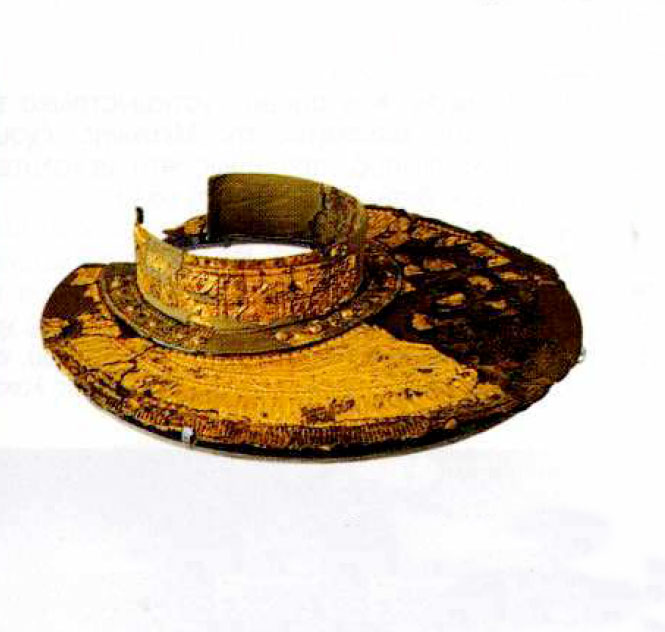 Μακρύγιαλος, βόρειο νεκροταφείο Πύδνας. Περιτραχήλιο, 4ος αι. π.Χ.
Στη βόρεια Πιερία, νότια από τον σύγχρονο οικισμό του Μακρύγιαλου, βρίσκεται η αρχαία Πύδνα. Η πρώτη κατοίκηση στην περιοχή, ένας από τους πιο εκτεταμένους οικισμούς της Νεότερης Νεολιθικής, εντοπίζεται νοτιοδυτικά του Μακρύγιαλου. Διακρίνονται δύο φάσεις, μια προδιμηνιακή και μια σύγχρονη με το κλασικό Διμήνι. Στην εποχή του Χαλκού ιδρύονται για πρώτη φορά οικισμοί στα παράλια της βόρειας Πιερίας, ο ένας στη θέση της αρχαίας Πύδνας, στα νότια του νεολιθικού οικισμού. Μεγάλη επέκταση του οικισμού σημειώνεται την Πρώιμη εποχή του Σιδήρου. Για πρώτη φορά στη Μακεδονία εμφανίζονται θαλαμωτοί τάφοι.
Την αρχαϊκή εποχή η Πύδνα συρρικνώνεται σημαντικά. Η πόλη, που οι ιστορικοί χαρακτηρίζουν «μακεδονική», γνωρίζει τη μεγάλη της ακμή τον 5ο αιώνα π.Χ. Στα χρόνια του Αλέξανδρου Α' γίνεται το μεγαλύτερο αστικό κέντρο του βασιλείου. Η ακμή της ανακόπηκε μετά την αποστασία της, που πρέπει να αποδοθεί στις μεταρρυθμίσεις του Αρχέλαου (413-399 π.Χ.). Τιμωρώντας τους, ο Αρχέλαος μετέφερε τους κατοίκους σε μεσόγεια θέση, στο σημερινό Κίτρος. Σύντομα όμως εκείνοι επέστρεψαν κερδίζοντας μάλιστα και την αυτονομία τους, μάλλον χάρη σε ευνοϊκές ρυθμίσεις του βασιλιά Αμύντα Γ'. Το 357 π.Χ. ο Φίλιππος Β' καταλαμβάνει την πόλη και την επαναφέρει στη σφαίρα επιρροής των Μακεδόνων. Μετά την ολοκληρωτική εγκατάλειψη της Μεθώνης το 354 π.Χ., η αστικοποίηση της Πύδνας εντείνεται. Στο χώρο της Πύδνας το 168 π. Χ. οι Ρωμαίοι συνέτριψαν τις μακεδονικές δυνάμεις του Περσέα. Στα βυζαντινά χρόνια η Πύδνα γνωρίζει πάλι μεγάλη ακμή ως Κίτρος, οχυρωμένος οικισμός με έδρα επισκοπής. Στην Τουρκοκρατία ο παράλιος οικισμός εγκαταλείπεται για να μεταφερθεί στη σημερινή θέση του Κίτρους.
Μακρύγιαλος, βόρειο νεκροταφείο Πύδνας. Περιτραχήλιο, 4ος αι. π.Χ.
Στη βόρεια Πιερία, νότια από τον σύγχρονο οικισμό του Μακρύγιαλου, βρίσκεται η αρχαία Πύδνα. Η πρώτη κατοίκηση στην περιοχή, ένας από τους πιο εκτεταμένους οικισμούς της Νεότερης Νεολιθικής, εντοπίζεται νοτιοδυτικά του Μακρύγιαλου. Διακρίνονται δύο φάσεις, μια προδιμηνιακή και μια σύγχρονη με το κλασικό Διμήνι. Στην εποχή του Χαλκού ιδρύονται για πρώτη φορά οικισμοί στα παράλια της βόρειας Πιερίας, ο ένας στη θέση της αρχαίας Πύδνας, στα νότια του νεολιθικού οικισμού. Μεγάλη επέκταση του οικισμού σημειώνεται την Πρώιμη εποχή του Σιδήρου. Για πρώτη φορά στη Μακεδονία εμφανίζονται θαλαμωτοί τάφοι.
Την αρχαϊκή εποχή η Πύδνα συρρικνώνεται σημαντικά. Η πόλη, που οι ιστορικοί χαρακτηρίζουν «μακεδονική», γνωρίζει τη μεγάλη της ακμή τον 5ο αιώνα π.Χ. Στα χρόνια του Αλέξανδρου Α' γίνεται το μεγαλύτερο αστικό κέντρο του βασιλείου. Η ακμή της ανακόπηκε μετά την αποστασία της, που πρέπει να αποδοθεί στις μεταρρυθμίσεις του Αρχέλαου (413-399 π.Χ.). Τιμωρώντας τους, ο Αρχέλαος μετέφερε τους κατοίκους σε μεσόγεια θέση, στο σημερινό Κίτρος. Σύντομα όμως εκείνοι επέστρεψαν κερδίζοντας μάλιστα και την αυτονομία τους, μάλλον χάρη σε ευνοϊκές ρυθμίσεις του βασιλιά Αμύντα Γ'. Το 357 π.Χ. ο Φίλιππος Β' καταλαμβάνει την πόλη και την επαναφέρει στη σφαίρα επιρροής των Μακεδόνων. Μετά την ολοκληρωτική εγκατάλειψη της Μεθώνης το 354 π.Χ., η αστικοποίηση της Πύδνας εντείνεται. Στο χώρο της Πύδνας το 168 π. Χ. οι Ρωμαίοι συνέτριψαν τις μακεδονικές δυνάμεις του Περσέα. Στα βυζαντινά χρόνια η Πύδνα γνωρίζει πάλι μεγάλη ακμή ως Κίτρος, οχυρωμένος οικισμός με έδρα επισκοπής. Στην Τουρκοκρατία ο παράλιος οικισμός εγκαταλείπεται για να μεταφερθεί στη σημερινή θέση του Κίτρους.
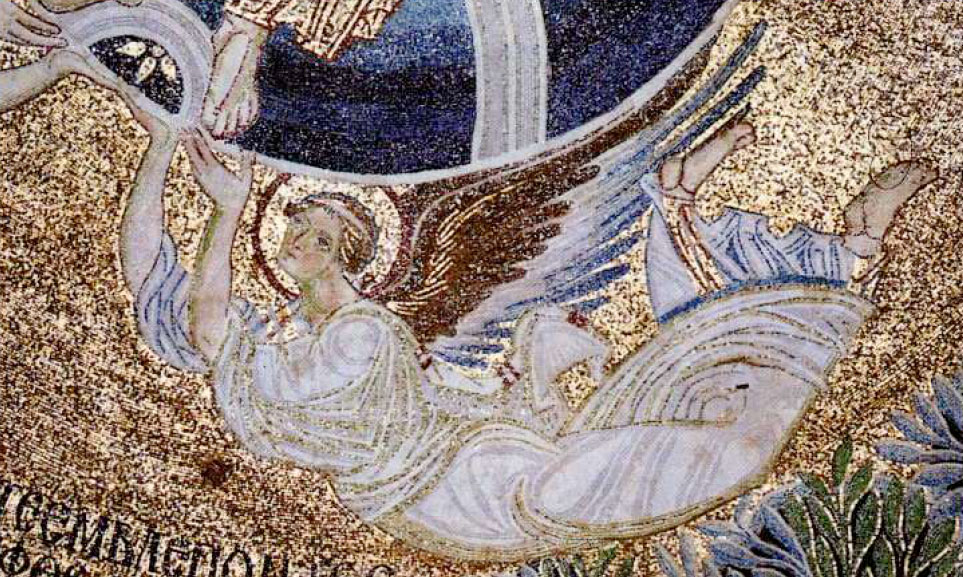 Αγία Σοφία. Ψηφιδωτό τρούλου. Ανάληψη (λεπτομέρεια).
Τον 5ο και 6ο αιώνα, περίοδο ακμής για την πολυάνθρωπη πόλη, η Θεσσαλονίκη μεταβάλλεται από ρωμαϊκή σε χριστιανική. Η Ροτόντα, ο Άγιος Δημήτριος, η Αχειροποίητος και η Μονή Λατόμου είναι οι πιο πειστικοί μάρτυρες μιας καλλιτεχνικής δημιουργίας παράλληλης με εκείνη της Κωνσταντινούπολης.
Από τα περίφημα ψηφιδωτά της Ροτόντας, περίκεντρου ρωμαϊκού οικοδομήματος που μετατράπηκε σε χριστιανικό ναό στα τέλη του 4ου αιώνα, γνωστότερη είναι η ζωφόρος των μαρτύρων.
Η εκκλησία του πολιούχου Αγίου Δημητρίου του 5ου αιώνα ξανακτίστηκε τον 7ο αιώνα, μετά από πυρκαγιά. Πεντάκλιτη ελληνιστική βασιλική διακρίνεται για τον μεγαλοπρεπή της διάκοσμο. Τα ψηφιδωτά και οι τοιχογραφίες αποτελούνται από πίνακες, αφιερώματα πιστών, και συνιστούν πολύτιμα τεκμήρια για την ιστορία της ζωγραφικής από τον 5ο έως τον 15ο αιώνα.
Στην Αχειροποίητο, μεγάλη τρίκλιτη ελληνιστική βασιλική με εξαιρετικά αρχιτεκτονικά στοιχεία και γλυπτά, τα ψηφιδωτά απεικονίζουν φυτικά κοσμήματα σε συνδυασμό με συμβολικές παραστάσεις του χριστιανισμού.
Η Μονή Λατόμου –Όσιος Δαβίδ- κτίστηκε στα τέλη του 5ου αιώνα και σήμερα διατηρείται κατά τα δύο τρίτα. Θεωρείται προδρομικός τύπος του σταυροειδή με τρούλο ναού και διασώζει σύγχρονα με την κατασκευή του ψηφιδωτά και τοιχογραφίες κομνήνειες και παλαιολόγειες.
Η τέχνη από τον 7ο αιώνα έως το τέλος της χιλιετίας εκπροσωπείται κυρίως από τη β΄ φάση του Αγίου Δημητρίου και από την Αγία Σοφία που η ίδρυσή της τοποθετείται στον 7ο αιώνα. Ανήκει στον μεταβατικό σταυροειδή με τρούλο και περίστωο τύπο. Εξαιρετικό ενδιαφέρον παρουσιάζουν ψηφιδωτά και τοιχογραφίες, με προεξάρχον το ψηφιδωτό της Ανάληψης στον τρούλο (τέλη 8ου αιώνα).
Στον 11ο αιώνα ανήκει η Παναγία των Χαλκέων, σταυροειδής εγγεγραμμένος με τρούλο ναός. Κτισμένη μόνο με τούβλα, πιστοποιεί τη γενικότερη διάδοση των αντικλασικών τάσεων του αιώνα της.
«Χρυσός αιώνας» της ζωγραφικής στη Θεσσαλονίκη θεωρούνται οι τελευταίες δεκαετίες του 13ου και το πρώτο μισό του 14ου αιώνα. Από την πρωτεύουσα της Μακεδονίας, επώνυμοι ζωγράφοι της μετακαλούνται και εργάζονται έξω από τα όριά της, ο Πανσέληνος, ο Καλλιέργης, ο Ευτύχιος, ο Μιχαήλ Αστραπάς.
Στην Αχειροποίητο, στα υπολείμματα από την παράσταση των Σαράντα Μαρτύρων (1225-1230), διαφαίνονται οι τάσεις των δημιουργών στην προβαθμίδα της παλαιολόγειας «αναγέννησης». Τις αναζητήσεις της παλαιολόγειας αρχιτεκτονικής της πόλης στα τέλη του 13ου και στις αρχές του 14ου αιώνα εκφράζει ο Άγιος Παντελεήμων.
Σύνθετος τετρακιόνιος σταυροειδής με νάρθηκα με περίστωο, ο ναός των Αγίων Αποστόλων (1310-1314) φέρει στις γωνίες τέσσερις, μικρότερους από τον κεντρικό, δορυφόρους τρούλους. Υψηλής τέχνης είναι τόσο τα ψηφιδωτά όσο και οι τοιχογραφίες του. Από τα πιο ωραία κτίσματα της εποχής είναι ο ναός της Αγίας Αικατερίνης, εγγεγραμμένος σταυροειδής με πέντε τρούλους και στοά που περιτρέχει το ναό από τις τρεις πλευρές. Οι τοιχογραφίες του διατηρούν αναμνήσεις από τη μνημειακή τεχνοτροπία του τέλους του 13ου αιώνα.
Ένα από τα πιο προικισμένα εργαστήρια της Θεσσαλονίκης έχει τοιχογραφήσει την εκκλησία του Αγίου Νικολάου του Ορφανού. Στο πρώτο μισό του αιώνα χρονολογείται και ο ναός των Ταξιαρχών, ιδιότυπη διώροφη ξυλόστεγη μονόχωρη βασιλική με περιμετρική στοά.
Μετά το ιδιαίτερα ταραγμένο β΄τέταρτο του 14ου αιώνα έως την πρώτη άλωσή της από τους Τούρκους (1387), η Θεσσαλονίκη ζει την τελευταία περίοδο ακμής. Εξίσου δημιουργικές υπήρξαν η αρχιτεκτονική και ζωγραφική της πόλης, όπως αυτό αποτυπώνεται στο καθολικό του Προφήτη Ηλία, το μνημείο της Μονής Βλατάδων και το ναΐδιο της Μεταμόρφωσης του Σωτήρος.
Αγία Σοφία. Ψηφιδωτό τρούλου. Ανάληψη (λεπτομέρεια).
Τον 5ο και 6ο αιώνα, περίοδο ακμής για την πολυάνθρωπη πόλη, η Θεσσαλονίκη μεταβάλλεται από ρωμαϊκή σε χριστιανική. Η Ροτόντα, ο Άγιος Δημήτριος, η Αχειροποίητος και η Μονή Λατόμου είναι οι πιο πειστικοί μάρτυρες μιας καλλιτεχνικής δημιουργίας παράλληλης με εκείνη της Κωνσταντινούπολης.
Από τα περίφημα ψηφιδωτά της Ροτόντας, περίκεντρου ρωμαϊκού οικοδομήματος που μετατράπηκε σε χριστιανικό ναό στα τέλη του 4ου αιώνα, γνωστότερη είναι η ζωφόρος των μαρτύρων.
Η εκκλησία του πολιούχου Αγίου Δημητρίου του 5ου αιώνα ξανακτίστηκε τον 7ο αιώνα, μετά από πυρκαγιά. Πεντάκλιτη ελληνιστική βασιλική διακρίνεται για τον μεγαλοπρεπή της διάκοσμο. Τα ψηφιδωτά και οι τοιχογραφίες αποτελούνται από πίνακες, αφιερώματα πιστών, και συνιστούν πολύτιμα τεκμήρια για την ιστορία της ζωγραφικής από τον 5ο έως τον 15ο αιώνα.
Στην Αχειροποίητο, μεγάλη τρίκλιτη ελληνιστική βασιλική με εξαιρετικά αρχιτεκτονικά στοιχεία και γλυπτά, τα ψηφιδωτά απεικονίζουν φυτικά κοσμήματα σε συνδυασμό με συμβολικές παραστάσεις του χριστιανισμού.
Η Μονή Λατόμου –Όσιος Δαβίδ- κτίστηκε στα τέλη του 5ου αιώνα και σήμερα διατηρείται κατά τα δύο τρίτα. Θεωρείται προδρομικός τύπος του σταυροειδή με τρούλο ναού και διασώζει σύγχρονα με την κατασκευή του ψηφιδωτά και τοιχογραφίες κομνήνειες και παλαιολόγειες.
Η τέχνη από τον 7ο αιώνα έως το τέλος της χιλιετίας εκπροσωπείται κυρίως από τη β΄ φάση του Αγίου Δημητρίου και από την Αγία Σοφία που η ίδρυσή της τοποθετείται στον 7ο αιώνα. Ανήκει στον μεταβατικό σταυροειδή με τρούλο και περίστωο τύπο. Εξαιρετικό ενδιαφέρον παρουσιάζουν ψηφιδωτά και τοιχογραφίες, με προεξάρχον το ψηφιδωτό της Ανάληψης στον τρούλο (τέλη 8ου αιώνα).
Στον 11ο αιώνα ανήκει η Παναγία των Χαλκέων, σταυροειδής εγγεγραμμένος με τρούλο ναός. Κτισμένη μόνο με τούβλα, πιστοποιεί τη γενικότερη διάδοση των αντικλασικών τάσεων του αιώνα της.
«Χρυσός αιώνας» της ζωγραφικής στη Θεσσαλονίκη θεωρούνται οι τελευταίες δεκαετίες του 13ου και το πρώτο μισό του 14ου αιώνα. Από την πρωτεύουσα της Μακεδονίας, επώνυμοι ζωγράφοι της μετακαλούνται και εργάζονται έξω από τα όριά της, ο Πανσέληνος, ο Καλλιέργης, ο Ευτύχιος, ο Μιχαήλ Αστραπάς.
Στην Αχειροποίητο, στα υπολείμματα από την παράσταση των Σαράντα Μαρτύρων (1225-1230), διαφαίνονται οι τάσεις των δημιουργών στην προβαθμίδα της παλαιολόγειας «αναγέννησης». Τις αναζητήσεις της παλαιολόγειας αρχιτεκτονικής της πόλης στα τέλη του 13ου και στις αρχές του 14ου αιώνα εκφράζει ο Άγιος Παντελεήμων.
Σύνθετος τετρακιόνιος σταυροειδής με νάρθηκα με περίστωο, ο ναός των Αγίων Αποστόλων (1310-1314) φέρει στις γωνίες τέσσερις, μικρότερους από τον κεντρικό, δορυφόρους τρούλους. Υψηλής τέχνης είναι τόσο τα ψηφιδωτά όσο και οι τοιχογραφίες του. Από τα πιο ωραία κτίσματα της εποχής είναι ο ναός της Αγίας Αικατερίνης, εγγεγραμμένος σταυροειδής με πέντε τρούλους και στοά που περιτρέχει το ναό από τις τρεις πλευρές. Οι τοιχογραφίες του διατηρούν αναμνήσεις από τη μνημειακή τεχνοτροπία του τέλους του 13ου αιώνα.
Ένα από τα πιο προικισμένα εργαστήρια της Θεσσαλονίκης έχει τοιχογραφήσει την εκκλησία του Αγίου Νικολάου του Ορφανού. Στο πρώτο μισό του αιώνα χρονολογείται και ο ναός των Ταξιαρχών, ιδιότυπη διώροφη ξυλόστεγη μονόχωρη βασιλική με περιμετρική στοά.
Μετά το ιδιαίτερα ταραγμένο β΄τέταρτο του 14ου αιώνα έως την πρώτη άλωσή της από τους Τούρκους (1387), η Θεσσαλονίκη ζει την τελευταία περίοδο ακμής. Εξίσου δημιουργικές υπήρξαν η αρχιτεκτονική και ζωγραφική της πόλης, όπως αυτό αποτυπώνεται στο καθολικό του Προφήτη Ηλία, το μνημείο της Μονής Βλατάδων και το ναΐδιο της Μεταμόρφωσης του Σωτήρος.
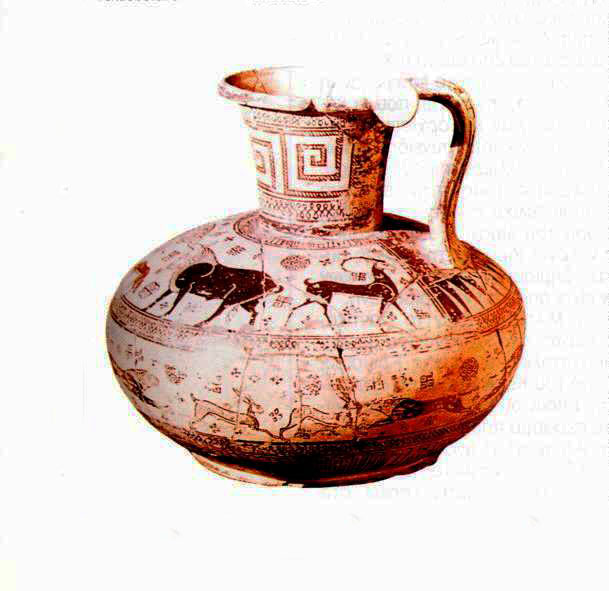 Λάγυνος από το Τεμίρ-Γκορά (Κερτς), β΄ μισό του 7ου αι. π.Χ. «Ανατολίζοντος» ρυθμού, το αγγείο πιθανόν κατασκευάστηκε στη Ρόδο.
Οι πρώτες μαρτυρίες της ελληνικής παρουσίας στα βόρεια παράλια της Μαύρης θάλασσας εντοπίζονται στο νησάκι Μπερεζάν, την αρχαία Βορυσθενίδα, που ιδρύθηκε στο β΄ μισό του 7ου αιώνα π.Χ. Αναζητώντας καλλιεργήσιμα εδάφη, οι κάτοικοι του νησιού στράφηκαν στην απέναντι ηπειρωτική γη, όπου τελικά έχτισαν την Όλβια. Αποικία των Μιλησίων ήταν και το Παντικάπαιο, το σημερινό Κερτς. Οι ανασκαφές αποκάλυψαν ότι τα πρώτα θεμέλια της ελληνικής αποικίας είχαν χτιστεί πάνω στα ερείπια μη ελληνικού οικισμού. Τα ευρήματα πρέπει να αποδοθούν στο λαό των Κιμμερίων που κυριαρχούσαν κάποτε στο Βόσπορο. Οι γλωσσολόγοι εντάσσουν τη γλώσσα των Κιμμερίων στην οικογένεια της αρχαίας περσικής. Περσικής προέλευσης θεωρείται το τοπωνύμιο Άξενος, που είχε αποδοθεί στη Μαύρη θάλασσα, ακόμη και το ίδιο το όνομα του Παντικάπαιου. Τα κύρια ονόματα περσικής προέλευσης που αναφέρονται σε επιγραφές μαρτυρούν ότι στους αρχαίους Έλληνες του Παντικάπαιου είχαν εισχωρήσει και εκπρόσωποι αυτόχθονων εθνοτήτων. Υπήρξαν όμως πάντοτε οι μεταξύ τους σχέσεις ειρηνικές; Οι γραπτές πηγές αναφέρουν ότι οι Έλληνες εξεδίωξαν από τον τόπο τούς Σκύθες προκειμένου να ιδρύσουν το Παντικάπαιο και τις άλλες πόλεις στο Βόσπορο. Οι λεηλατικές επιδρομές των Σκυθών κάθε που τα νερά του Βοσπόρου πάγωναν δημιουργούσαν φόβο και ανασφάλεια στους Έλληνες. Ισχυρό οχυρωματικό τείχος προστάτευε το Παντικάπαιο ήδη από τον 6ο αιώνα π.Χ. Στην περίπτωση της πόλης Ιλούρατον το πλάτος των τειχών έφτανε τα 8μ.
Εν κατακλείδι οι Έλληνες εγκαταστάθηκαν και εδραιώθηκαν στα βόρεια παράλια του Εύξεινου πόντου καταφέρνοντας να αφομοιώσουν τους αυτόχθονες κατοίκους.
Λάγυνος από το Τεμίρ-Γκορά (Κερτς), β΄ μισό του 7ου αι. π.Χ. «Ανατολίζοντος» ρυθμού, το αγγείο πιθανόν κατασκευάστηκε στη Ρόδο.
Οι πρώτες μαρτυρίες της ελληνικής παρουσίας στα βόρεια παράλια της Μαύρης θάλασσας εντοπίζονται στο νησάκι Μπερεζάν, την αρχαία Βορυσθενίδα, που ιδρύθηκε στο β΄ μισό του 7ου αιώνα π.Χ. Αναζητώντας καλλιεργήσιμα εδάφη, οι κάτοικοι του νησιού στράφηκαν στην απέναντι ηπειρωτική γη, όπου τελικά έχτισαν την Όλβια. Αποικία των Μιλησίων ήταν και το Παντικάπαιο, το σημερινό Κερτς. Οι ανασκαφές αποκάλυψαν ότι τα πρώτα θεμέλια της ελληνικής αποικίας είχαν χτιστεί πάνω στα ερείπια μη ελληνικού οικισμού. Τα ευρήματα πρέπει να αποδοθούν στο λαό των Κιμμερίων που κυριαρχούσαν κάποτε στο Βόσπορο. Οι γλωσσολόγοι εντάσσουν τη γλώσσα των Κιμμερίων στην οικογένεια της αρχαίας περσικής. Περσικής προέλευσης θεωρείται το τοπωνύμιο Άξενος, που είχε αποδοθεί στη Μαύρη θάλασσα, ακόμη και το ίδιο το όνομα του Παντικάπαιου. Τα κύρια ονόματα περσικής προέλευσης που αναφέρονται σε επιγραφές μαρτυρούν ότι στους αρχαίους Έλληνες του Παντικάπαιου είχαν εισχωρήσει και εκπρόσωποι αυτόχθονων εθνοτήτων. Υπήρξαν όμως πάντοτε οι μεταξύ τους σχέσεις ειρηνικές; Οι γραπτές πηγές αναφέρουν ότι οι Έλληνες εξεδίωξαν από τον τόπο τούς Σκύθες προκειμένου να ιδρύσουν το Παντικάπαιο και τις άλλες πόλεις στο Βόσπορο. Οι λεηλατικές επιδρομές των Σκυθών κάθε που τα νερά του Βοσπόρου πάγωναν δημιουργούσαν φόβο και ανασφάλεια στους Έλληνες. Ισχυρό οχυρωματικό τείχος προστάτευε το Παντικάπαιο ήδη από τον 6ο αιώνα π.Χ. Στην περίπτωση της πόλης Ιλούρατον το πλάτος των τειχών έφτανε τα 8μ.
Εν κατακλείδι οι Έλληνες εγκαταστάθηκαν και εδραιώθηκαν στα βόρεια παράλια του Εύξεινου πόντου καταφέρνοντας να αφομοιώσουν τους αυτόχθονες κατοίκους.
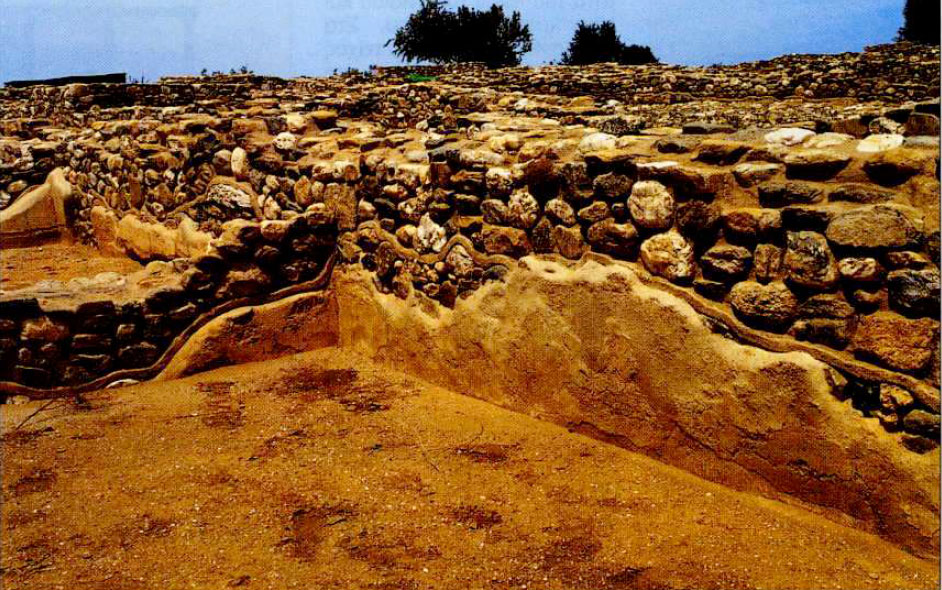 Αρχαία Όλυνθος. Συντηρημένα επιχρίσματα τοίχων οικίας ΑVI 8.
Η αρχαία Όλυνθος εκτείνεται στο επίπεδο πλάτωμα και στις ανατολικές πλαγιές δυο φυσικών λόφων. Ο Ηρόδοτος αναφέρει ότι την Όλυνθο ίδρυσαν οι Βοττιαίοι που εγκαταστάθηκαν στον Νότιο λόφο, στη θέση μικρού νεολιθικού οικισμού. Την αρχαϊκή και κλασική πόλη κατέστρεψαν οι Πέρσες το 479 π.Χ. Όταν η Όλυνθος γίνεται η έδρα του Κοινού των Χαλκιδέων το 432 π.Χ., ο πληθυσμός της τριπλασιάζεται και η πόλη επεκτείνεται στον Βόρειο λόφο, όπου οργανώνεται με βάση το ιπποδάμειο σύστημα. Κάθε οικοδομικό τετράγωνο αποτελείται από δέκα σπίτια σε δύο σειρές που ανήκουν στον τύπο της «οικίας με παστάδα». Γύρω από τη λιθόστρωτη αυλή διατάσσονται οκτώ έως δεκατρία δωμάτια. Οι ανασκαφές αποκάλυψαν την ύπαρξη και δευτέρου ορόφου στη βόρεια πλευρά του σπιτιού.
Πολλά σπίτια έχουν παρόμοια κάτοψη με συνεχόμενους τοίχους, επομένως χτίστηκαν σύμφωνα με συνταγμένο εκ των προτέρων πολεοδομικό σχέδιο. Περιμετρικά του οικισμού εντοπίστηκαν τα τρία νεκροταφεία της πόλης. Στα νοτιοανατολικά του, εντοπίστηκαν οι κατοικίες των εύπορων πολιτών, οι «βίλλες», διακοσμημένες με ιδιαίτερα σημαντικά ψηφιδωτά από φυσικά βότσαλα. Ιδιαίτερο ενδιαφέρον παρουσιάζουν οι επιγραφές με συμβόλαια αγοραπωλησίας, οι οποίες βρίσκονταν μάλλον τοποθετημένες πλάι στην κεντρική είσοδο κάθε σπιτιού.
Μετά την καταστροφή της από τον Φίλιππο το 348 π.Χ., η Όλυνθος δεν ξανακατοικήθηκε ποτέ πια. Οι πρώτες ανασκαφές έγιναν στα 1928-1938 από την Αμερικανική Αρχαιολογική Σχολή και τον καθηγητή D. M. Robinson. Η ΙΣΤ΄ Εφορεία Προϊστορικών και Κλασικών Αρχαιοτήτων υλοποιεί σήμερα (1992 – 1999) εργασίες αποκατάστασης με στόχο την ανάδειξη της πολεοδομίας, της αρχιτεκτονικής, της τέχνης και, γενικά, της καθημερινής ζωής της αρχαίας Ολύνθου.
Αρχαία Όλυνθος. Συντηρημένα επιχρίσματα τοίχων οικίας ΑVI 8.
Η αρχαία Όλυνθος εκτείνεται στο επίπεδο πλάτωμα και στις ανατολικές πλαγιές δυο φυσικών λόφων. Ο Ηρόδοτος αναφέρει ότι την Όλυνθο ίδρυσαν οι Βοττιαίοι που εγκαταστάθηκαν στον Νότιο λόφο, στη θέση μικρού νεολιθικού οικισμού. Την αρχαϊκή και κλασική πόλη κατέστρεψαν οι Πέρσες το 479 π.Χ. Όταν η Όλυνθος γίνεται η έδρα του Κοινού των Χαλκιδέων το 432 π.Χ., ο πληθυσμός της τριπλασιάζεται και η πόλη επεκτείνεται στον Βόρειο λόφο, όπου οργανώνεται με βάση το ιπποδάμειο σύστημα. Κάθε οικοδομικό τετράγωνο αποτελείται από δέκα σπίτια σε δύο σειρές που ανήκουν στον τύπο της «οικίας με παστάδα». Γύρω από τη λιθόστρωτη αυλή διατάσσονται οκτώ έως δεκατρία δωμάτια. Οι ανασκαφές αποκάλυψαν την ύπαρξη και δευτέρου ορόφου στη βόρεια πλευρά του σπιτιού.
Πολλά σπίτια έχουν παρόμοια κάτοψη με συνεχόμενους τοίχους, επομένως χτίστηκαν σύμφωνα με συνταγμένο εκ των προτέρων πολεοδομικό σχέδιο. Περιμετρικά του οικισμού εντοπίστηκαν τα τρία νεκροταφεία της πόλης. Στα νοτιοανατολικά του, εντοπίστηκαν οι κατοικίες των εύπορων πολιτών, οι «βίλλες», διακοσμημένες με ιδιαίτερα σημαντικά ψηφιδωτά από φυσικά βότσαλα. Ιδιαίτερο ενδιαφέρον παρουσιάζουν οι επιγραφές με συμβόλαια αγοραπωλησίας, οι οποίες βρίσκονταν μάλλον τοποθετημένες πλάι στην κεντρική είσοδο κάθε σπιτιού.
Μετά την καταστροφή της από τον Φίλιππο το 348 π.Χ., η Όλυνθος δεν ξανακατοικήθηκε ποτέ πια. Οι πρώτες ανασκαφές έγιναν στα 1928-1938 από την Αμερικανική Αρχαιολογική Σχολή και τον καθηγητή D. M. Robinson. Η ΙΣΤ΄ Εφορεία Προϊστορικών και Κλασικών Αρχαιοτήτων υλοποιεί σήμερα (1992 – 1999) εργασίες αποκατάστασης με στόχο την ανάδειξη της πολεοδομίας, της αρχιτεκτονικής, της τέχνης και, γενικά, της καθημερινής ζωής της αρχαίας Ολύνθου.
 Στάγειρα. Ληνός (πατητήρι) λαξευμένος στο βράχο.
Τα Στάγειρα, γνωστά ως η γενέτειρα του Αριστοτέλη, βρίσκονται στα ΒΑ του σημερινού χωριού της Ολυμπιάδας, πάνω σε μια πανέμορφη ορεινή χερσόνησο. Η αρχαία πόλη ήταν χτισμένη στους δυο συνεχόμενους και χαμηλούς λόφους αυτής της χερσονήσου, τον Βόρειο και τον Νότιο.
Από τα πιο σημαντικά ευρήματα των ανασκαφών είναι το πρώιμο κλασικό τείχος στο Νότιο λόφο της πόλης, επειδή μας επιτρέπει να υπολογίσουμε την ακριβή της έκταση, καθώς σε όλες της τις άλλες πλευρές η πόλη βρεχόταν από τη θάλασσα. Στον αντίστοιχο βόρειο λόφο ήρθε στο φως μεγάλο τμήμα του υστεροκλασικού τείχους. Πρόκειται για το τείχος που, σύμφωνα με τις πηγές, έχτισε ο Φίλιππος Β', κατά παράκληση του Αριστοτέλη, αφού πρώτα ο ίδιος είχε καταστρέψει την πόλη το 348 π.Χ. Στην ίδια περιοχή βρέθηκαν διάφορα οικοδομήματα του 6ου αιώνα, όπως ένα Θεσμοφόριο κι ένα αρχαϊκό Ιερό. Στην ακρόπολη αποκαλύφθηκαν τμήματα στρατιωτικών εγκαταστάσεων και μεγάλη δεξαμενή νερού. Βρέθηκε επίσης ο κεντρικός υδροδοτικός αγωγός της πόλης. Τα πολλά σπίτια της Κλασικής και της Ελληνιστικής περιόδου που αποκαλύφθηκαν θυμίζουν την οικιστική οργάνωση στις «Χώρες» των ελληνικών νησιών. Στην αγορά αποκαλύφθηκαν τμήματα κτηρίων του 6ου και του 5ου αιώνα π.Χ., λιθόστρωτοι δρόμοι και μια κλασική Στοά.
Οι τομές που διενεργήθηκαν τον περασμένο χρόνο οδήγησαν σε νέα ευρήματα. Ανάμεσά τους, μεγάλος αρχαϊκός ναός στην κορυφή του Βόρειου λόφου, χτισμένος με τεράστιους γρανίτινους γωνιόλιθους. Από τις ανασκαφικές ενδείξεις συνάγεται ότι ο ναός ήταν δωρικού ρυθμού, με μαρμάρινα αρχιτεκτονικά γλυπτά και με πλαστική διακόσμηση εξαιρετικής τέχνης στα αετώματα και στις μετόπες του.
Στάγειρα. Ληνός (πατητήρι) λαξευμένος στο βράχο.
Τα Στάγειρα, γνωστά ως η γενέτειρα του Αριστοτέλη, βρίσκονται στα ΒΑ του σημερινού χωριού της Ολυμπιάδας, πάνω σε μια πανέμορφη ορεινή χερσόνησο. Η αρχαία πόλη ήταν χτισμένη στους δυο συνεχόμενους και χαμηλούς λόφους αυτής της χερσονήσου, τον Βόρειο και τον Νότιο.
Από τα πιο σημαντικά ευρήματα των ανασκαφών είναι το πρώιμο κλασικό τείχος στο Νότιο λόφο της πόλης, επειδή μας επιτρέπει να υπολογίσουμε την ακριβή της έκταση, καθώς σε όλες της τις άλλες πλευρές η πόλη βρεχόταν από τη θάλασσα. Στον αντίστοιχο βόρειο λόφο ήρθε στο φως μεγάλο τμήμα του υστεροκλασικού τείχους. Πρόκειται για το τείχος που, σύμφωνα με τις πηγές, έχτισε ο Φίλιππος Β', κατά παράκληση του Αριστοτέλη, αφού πρώτα ο ίδιος είχε καταστρέψει την πόλη το 348 π.Χ. Στην ίδια περιοχή βρέθηκαν διάφορα οικοδομήματα του 6ου αιώνα, όπως ένα Θεσμοφόριο κι ένα αρχαϊκό Ιερό. Στην ακρόπολη αποκαλύφθηκαν τμήματα στρατιωτικών εγκαταστάσεων και μεγάλη δεξαμενή νερού. Βρέθηκε επίσης ο κεντρικός υδροδοτικός αγωγός της πόλης. Τα πολλά σπίτια της Κλασικής και της Ελληνιστικής περιόδου που αποκαλύφθηκαν θυμίζουν την οικιστική οργάνωση στις «Χώρες» των ελληνικών νησιών. Στην αγορά αποκαλύφθηκαν τμήματα κτηρίων του 6ου και του 5ου αιώνα π.Χ., λιθόστρωτοι δρόμοι και μια κλασική Στοά.
Οι τομές που διενεργήθηκαν τον περασμένο χρόνο οδήγησαν σε νέα ευρήματα. Ανάμεσά τους, μεγάλος αρχαϊκός ναός στην κορυφή του Βόρειου λόφου, χτισμένος με τεράστιους γρανίτινους γωνιόλιθους. Από τις ανασκαφικές ενδείξεις συνάγεται ότι ο ναός ήταν δωρικού ρυθμού, με μαρμάρινα αρχιτεκτονικά γλυπτά και με πλαστική διακόσμηση εξαιρετικής τέχνης στα αετώματα και στις μετόπες του.
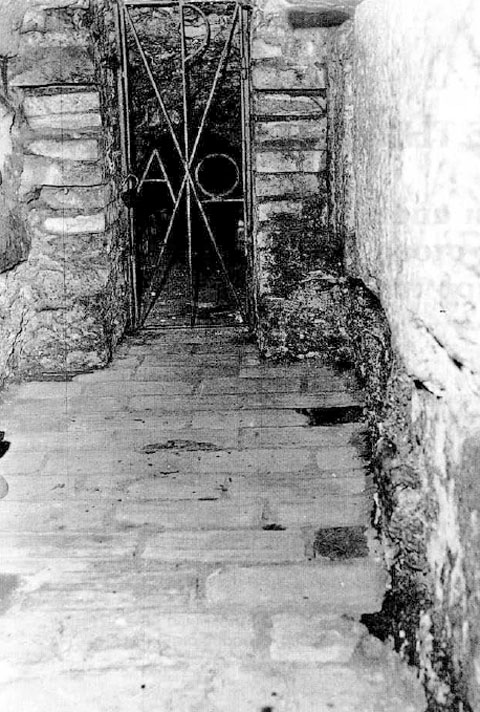 Βάσεις τειχών, αρχαίο μάρμαρο και βυζαντινό κεραμικό. Τα χριστιανικά σύμβολα εν είδει σιδερόφραχτης θύρας υπενθυμίζουν την ιερότητα και το μυστήριο του χώρου.
Τα μυστικά υπόγεια του κέντρου της πόλης. Υπόγειες στοές, που ερμηνεύονται ως αρχαϊκές διέξοδοι ακροπόλεων, φρουρίων και άλλων οχυρώσεων, άλλες κατασκευές που έγιναν ανεξάρτητες κατακόμβες και κρύπτες.
Ένα υπόγειο δίκτυο εξακτινώνεται με επίκεντρο την περιοχή της πλατείας Συντάγματος. Κάτω από τη Ρωσική εκκλησία της οδού Φιλελλήνων (Σώτειρα Λυκοδήμου) αποκαλύπτεται μεγάλη κατακόμβη. Τα σκαλοπάτια τελειώνουν στην είσοδο των μεγάλων στοών. Εδώ τα ψηφιδωτά εντυπωσιάζουν με τα απαλά τους χρώματα. Αφήνοντας πίσω μας τη μεγάλη κατακόμβη και τις μικρότερες πλευρικές της, μια σήραγγα μας οδηγεί στην περιοχή που βρέθηκε το παλαιοχριστιανικό νεκροταφείο. Μια ακόμη σημαντική κατακόμβη βρίσκεται κάτω από το εκκλησάκι του Αγίου Ανδρέα, κοντά στη Μητρόπολη.
Από το χώρο της χριστιανικής «νεκρόπολης», η μεγάλη στοά συνεχίζει στην οδό Αμαλίας, κάτω από το Μέγαρο Μποδοσάκη, και πορεύεται προς το Κολωνάκι. Άλλη μακριά σήραγγα ξεκινά από το Κολωνάκι, καταλήγει στο πίσω μέρος της Βουλής και, συνεχίζοντας κάτω από τον Εθνικό κήπο, κατηφορίζει έως το Παλαιό Φάληρο. Έχει στο μεταξύ συναντηθεί με άλλες διαδοχικές στοές, μια στο Ηλιακό ρολόι, άλλη στο άγαλμα του Βύρωνα και άλλη που έρχεται από την Ακρόπολη. Πολλές από αυτές παραμένουν βατές, όπως αυτή της Βουλής που χρησιμοποιήθηκε επί Γερμανών αλλά και επί χούντας. Μια άλλη σήραγγα που χρησιμοποιήθηκε κατά την περίοδο της Κατοχής είναι αυτή που, από το άγαλμα του Βύρωνα, καταλήγει στους πρόποδες της Ακρόπολης. Μέσα από μια δίοδο πέρασαν ο Μανώλης Γλέζος και ο Απόστολος Σάντας για να φτάσουν στον Παρθενώνα και να κατεβάσουν τη γερμανική σημαία.
Βάσεις τειχών, αρχαίο μάρμαρο και βυζαντινό κεραμικό. Τα χριστιανικά σύμβολα εν είδει σιδερόφραχτης θύρας υπενθυμίζουν την ιερότητα και το μυστήριο του χώρου.
Τα μυστικά υπόγεια του κέντρου της πόλης. Υπόγειες στοές, που ερμηνεύονται ως αρχαϊκές διέξοδοι ακροπόλεων, φρουρίων και άλλων οχυρώσεων, άλλες κατασκευές που έγιναν ανεξάρτητες κατακόμβες και κρύπτες.
Ένα υπόγειο δίκτυο εξακτινώνεται με επίκεντρο την περιοχή της πλατείας Συντάγματος. Κάτω από τη Ρωσική εκκλησία της οδού Φιλελλήνων (Σώτειρα Λυκοδήμου) αποκαλύπτεται μεγάλη κατακόμβη. Τα σκαλοπάτια τελειώνουν στην είσοδο των μεγάλων στοών. Εδώ τα ψηφιδωτά εντυπωσιάζουν με τα απαλά τους χρώματα. Αφήνοντας πίσω μας τη μεγάλη κατακόμβη και τις μικρότερες πλευρικές της, μια σήραγγα μας οδηγεί στην περιοχή που βρέθηκε το παλαιοχριστιανικό νεκροταφείο. Μια ακόμη σημαντική κατακόμβη βρίσκεται κάτω από το εκκλησάκι του Αγίου Ανδρέα, κοντά στη Μητρόπολη.
Από το χώρο της χριστιανικής «νεκρόπολης», η μεγάλη στοά συνεχίζει στην οδό Αμαλίας, κάτω από το Μέγαρο Μποδοσάκη, και πορεύεται προς το Κολωνάκι. Άλλη μακριά σήραγγα ξεκινά από το Κολωνάκι, καταλήγει στο πίσω μέρος της Βουλής και, συνεχίζοντας κάτω από τον Εθνικό κήπο, κατηφορίζει έως το Παλαιό Φάληρο. Έχει στο μεταξύ συναντηθεί με άλλες διαδοχικές στοές, μια στο Ηλιακό ρολόι, άλλη στο άγαλμα του Βύρωνα και άλλη που έρχεται από την Ακρόπολη. Πολλές από αυτές παραμένουν βατές, όπως αυτή της Βουλής που χρησιμοποιήθηκε επί Γερμανών αλλά και επί χούντας. Μια άλλη σήραγγα που χρησιμοποιήθηκε κατά την περίοδο της Κατοχής είναι αυτή που, από το άγαλμα του Βύρωνα, καταλήγει στους πρόποδες της Ακρόπολης. Μέσα από μια δίοδο πέρασαν ο Μανώλης Γλέζος και ο Απόστολος Σάντας για να φτάσουν στον Παρθενώνα και να κατεβάσουν τη γερμανική σημαία.
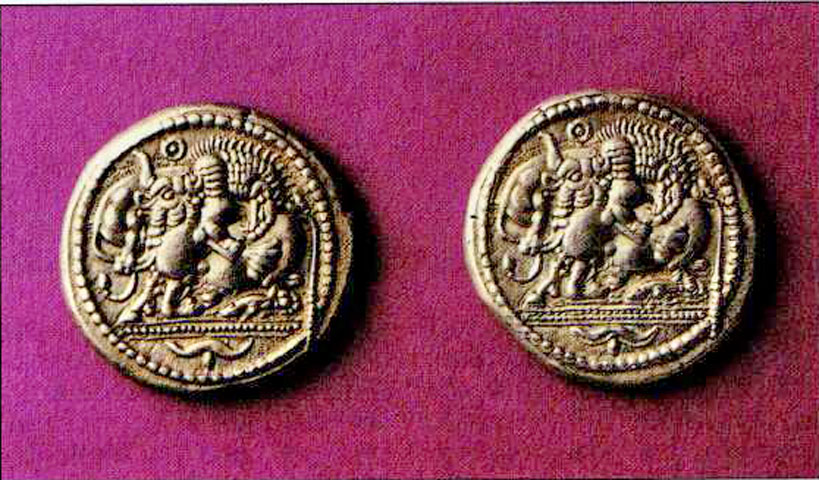 Ασημένια τετράδραχμα Ακάνθου κλασικών χρόνων.
Η Άκανθος, που ιδρύθηκε στα μέσα του 7ου αιώνα π.Χ., υπήρξε είτε αποικία των Ανδρίων ή μικτή αποικία Ανδρίων και Χαλκιδέων.
Η σημαντικότερη πόλη της ΒΑ Χαλκιδικής γρήγορα αναπτύχθηκε σε ακμάζουσα πόλη-κράτος. Σε Ανατολή και Δύση έχουν βρεθεί τα ασημένια της νομίσματα που κυκλοφόρησαν γύρω στο 530 π.Χ. Η πόλη θα επιβιώσει και μετά τη ρωμαϊκή κατάκτηση γνωρίζοντας άνθιση και ευημερία. Στα παλαιοχριστιανικά και βυζαντινά χρόνια διατηρείται με το τοπωνύμιο Ερισσός. Όταν το παλιό χωριό της Ιερισσού εγκαταλείπεται μετά το σεισμό του 1932, διακόπτεται μια συνεχής κατοίκηση τριάντα τουλάχιστον αιώνων.
Η Άκανθος αναπτύχθηκε σε θέση προϊστορικού οικισμού, όπως μαρτυρείται από τμήμα λιθόκτιστης αψιδωτής κατασκευής, άφθονα όστρακα και ένα «πιθεώνα» από την εποχή του Σιδήρου. Τμήματα της οχύρωσης της Ακάνθου αποκαλύπτονται σταδιακά. Στα τείχη του περιβόλου εντοπίζονται δύο οικοδομικές φάσεις. Η αρχαιότερη έχει επιμελημένη ισόδομη τοιχοδομία από μεγάλες πλίνθους τοπικού γρανίτη. Η νεότερη, με ψευδοϊσόδομη τοιχοδομία, φαίνεται να ανάγεται στα κλασικά ή στα πρώιμα ελληνιστικά χρόνια. Στους λόφους της πόλης ερευνώνται δυο ενδιαφέροντα κτίρια των κλασικών χρόνων. Πρόκειται για ένα μνημειακό ναό πιθανά αφιερωμένο στην Αθηνά και για ένα ορθογώνιο κτίσμα με αίθριο και τοιχογραφημένο διάκοσμο που θυμίζει οικίες της Πέλλας. Αν δεν είναι έπαυλη πλουσίων Ακανθίων ίσως πρόκειται για το Πρυτανείο της Ακάνθου. Σε κεντρική διασταύρωση της Ιερισσού βρέθηκε και τρίτο οικοδόμημα που εντάσσεται στο χώρο του νεκροταφείου και έχει ανεγερθεί πάνω από τάφους του αρχαιότερου νεκροταφείου της Ακάνθου. Γνωστότερο είναι το παράλιο νεκροταφείο των Ακανθίων αποίκων, μια νεκρόπολη 60 στρεμμάτων, που χρησιμοποιήθηκε από τον 7ο αιώνα π.Χ. έως τον 17ο αιώνα μ.Χ.
Ασημένια τετράδραχμα Ακάνθου κλασικών χρόνων.
Η Άκανθος, που ιδρύθηκε στα μέσα του 7ου αιώνα π.Χ., υπήρξε είτε αποικία των Ανδρίων ή μικτή αποικία Ανδρίων και Χαλκιδέων.
Η σημαντικότερη πόλη της ΒΑ Χαλκιδικής γρήγορα αναπτύχθηκε σε ακμάζουσα πόλη-κράτος. Σε Ανατολή και Δύση έχουν βρεθεί τα ασημένια της νομίσματα που κυκλοφόρησαν γύρω στο 530 π.Χ. Η πόλη θα επιβιώσει και μετά τη ρωμαϊκή κατάκτηση γνωρίζοντας άνθιση και ευημερία. Στα παλαιοχριστιανικά και βυζαντινά χρόνια διατηρείται με το τοπωνύμιο Ερισσός. Όταν το παλιό χωριό της Ιερισσού εγκαταλείπεται μετά το σεισμό του 1932, διακόπτεται μια συνεχής κατοίκηση τριάντα τουλάχιστον αιώνων.
Η Άκανθος αναπτύχθηκε σε θέση προϊστορικού οικισμού, όπως μαρτυρείται από τμήμα λιθόκτιστης αψιδωτής κατασκευής, άφθονα όστρακα και ένα «πιθεώνα» από την εποχή του Σιδήρου. Τμήματα της οχύρωσης της Ακάνθου αποκαλύπτονται σταδιακά. Στα τείχη του περιβόλου εντοπίζονται δύο οικοδομικές φάσεις. Η αρχαιότερη έχει επιμελημένη ισόδομη τοιχοδομία από μεγάλες πλίνθους τοπικού γρανίτη. Η νεότερη, με ψευδοϊσόδομη τοιχοδομία, φαίνεται να ανάγεται στα κλασικά ή στα πρώιμα ελληνιστικά χρόνια. Στους λόφους της πόλης ερευνώνται δυο ενδιαφέροντα κτίρια των κλασικών χρόνων. Πρόκειται για ένα μνημειακό ναό πιθανά αφιερωμένο στην Αθηνά και για ένα ορθογώνιο κτίσμα με αίθριο και τοιχογραφημένο διάκοσμο που θυμίζει οικίες της Πέλλας. Αν δεν είναι έπαυλη πλουσίων Ακανθίων ίσως πρόκειται για το Πρυτανείο της Ακάνθου. Σε κεντρική διασταύρωση της Ιερισσού βρέθηκε και τρίτο οικοδόμημα που εντάσσεται στο χώρο του νεκροταφείου και έχει ανεγερθεί πάνω από τάφους του αρχαιότερου νεκροταφείου της Ακάνθου. Γνωστότερο είναι το παράλιο νεκροταφείο των Ακανθίων αποίκων, μια νεκρόπολη 60 στρεμμάτων, που χρησιμοποιήθηκε από τον 7ο αιώνα π.Χ. έως τον 17ο αιώνα μ.Χ.
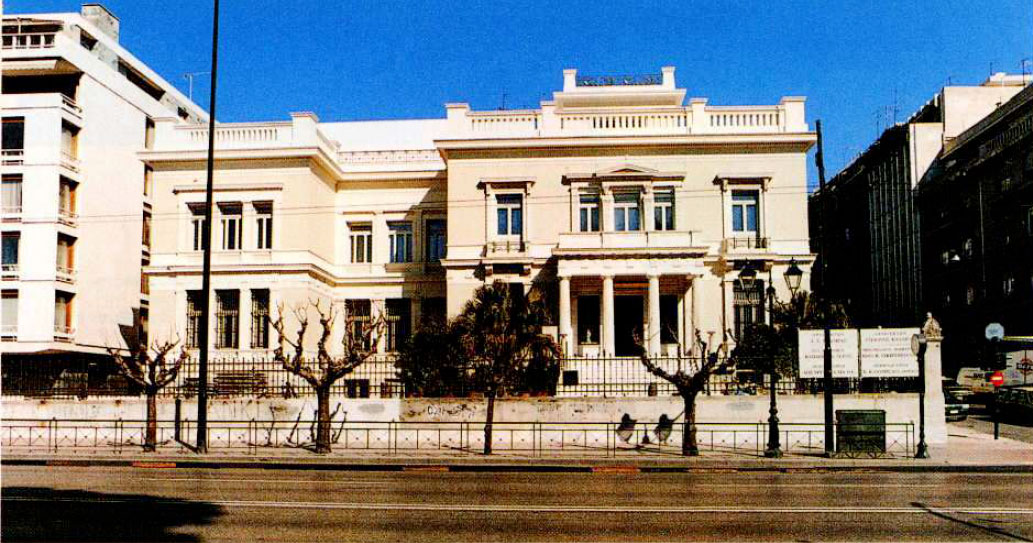 Το Μουσείο Μπενάκη μετά την προσθήκη της νέας πτέρυγας και την επισκευή των εξωτερικών του όψεων (Μάρτιος 1997).
Το νεοκλασικό αρχοντικό που στέγασε την οικογένεια Μπενάκη όταν εγκαταστάθηκε στην Αθήνα το 1910 μετατράπηκε σε Μουσείο όταν, το 1930, ο Αντώνης Μπενάκης πρόσφερε τη συλλογή του στο ελληνικό έθνος. Οι σημαντικές δωρεές που ακολούθησαν μαζί με τον μεγάλο αριθμό των αγορών έχουν μετατρέψει το Μουσείο Μπενάκη σε θησαυροφυλάκιο που στεγάζει πάνω από 45.000 μουσειακά αντικείμενα. Σε αυτά πρέπει να προσμετρηθούν οι τόμοι της Βιβλιοθήκης, τα αρνητικά και οι φωτογραφίες του Φωτογραφικού Αρχείου, τα έγγραφα του Ιστορικού Αρχείου. Στο μεταξύ οι νεότερες μουσειολογικές αντιλήψεις επέβαλαν τη δημιουργία Τμημάτων Συντήρησης, Εκπαιδευτικών Προγραμμάτων και Ηλεκτρονικής Τεκμηρίωσης. Οι τρεις προσθήκες που έγιναν στο κτήριο τα χρόνια 1965-1973 δεν μπορούσαν να ανταποκριθούν στις αυξανόμενες ανάγκες, τις δραστηριότητες και τις εκδηλώσεις ενός Μουσείου που επαναπροσδιορίζει τη φυσιογνωμία του. Η νέα μουσειακή του δομή, στηριγμένη στις αρχές των λεγόμενων «δορυφορικών συστημάτων», θα αποσυμφορήσει υλικό και υπηρεσίες. Η ισλαμική συλλογή μεταστεγάζεται στο κτηριακό συγκρότημα του Κεραμεικού, η κινεζική συλλογή στο σπίτι του Ν. Χατζηκυριάκου Γκίκα, τα Ιστορικά Αρχεία μεταστεγάζονται στο σπίτι της Πηνελόπης Δέλτα και το Φωτογραφικό Αρχείο μετακινείται σε γειτονικό διαμέρισμα της οδού Κουμπάρη.
Στο κέντρο αυτού του δορυφορικού συστήματος θα εξακολουθεί να βρίσκεται το γνωστό νεοκλασικό μέγαρο του Μουσείου με εκσυγχρονισμένες τις κτηριακές του εγκαταστάσεις και με διπλασιασμένους τους ωφέλιμους χώρους του, χάρη στην προσθήκη νέας πτέρυγας στο πίσω μέρος του οικοπέδου. Στους εκθεσιακούς χώρους θα αναπτυχθούν οι ελληνικές και μόνο συλλογές, έτσι ώστε να προσφέρεται στον επισκέπτη μια συνολική εικόνα της ιστορικής διαδρομής του ελληνισμού.
Το Μουσείο Μπενάκη μετά την προσθήκη της νέας πτέρυγας και την επισκευή των εξωτερικών του όψεων (Μάρτιος 1997).
Το νεοκλασικό αρχοντικό που στέγασε την οικογένεια Μπενάκη όταν εγκαταστάθηκε στην Αθήνα το 1910 μετατράπηκε σε Μουσείο όταν, το 1930, ο Αντώνης Μπενάκης πρόσφερε τη συλλογή του στο ελληνικό έθνος. Οι σημαντικές δωρεές που ακολούθησαν μαζί με τον μεγάλο αριθμό των αγορών έχουν μετατρέψει το Μουσείο Μπενάκη σε θησαυροφυλάκιο που στεγάζει πάνω από 45.000 μουσειακά αντικείμενα. Σε αυτά πρέπει να προσμετρηθούν οι τόμοι της Βιβλιοθήκης, τα αρνητικά και οι φωτογραφίες του Φωτογραφικού Αρχείου, τα έγγραφα του Ιστορικού Αρχείου. Στο μεταξύ οι νεότερες μουσειολογικές αντιλήψεις επέβαλαν τη δημιουργία Τμημάτων Συντήρησης, Εκπαιδευτικών Προγραμμάτων και Ηλεκτρονικής Τεκμηρίωσης. Οι τρεις προσθήκες που έγιναν στο κτήριο τα χρόνια 1965-1973 δεν μπορούσαν να ανταποκριθούν στις αυξανόμενες ανάγκες, τις δραστηριότητες και τις εκδηλώσεις ενός Μουσείου που επαναπροσδιορίζει τη φυσιογνωμία του. Η νέα μουσειακή του δομή, στηριγμένη στις αρχές των λεγόμενων «δορυφορικών συστημάτων», θα αποσυμφορήσει υλικό και υπηρεσίες. Η ισλαμική συλλογή μεταστεγάζεται στο κτηριακό συγκρότημα του Κεραμεικού, η κινεζική συλλογή στο σπίτι του Ν. Χατζηκυριάκου Γκίκα, τα Ιστορικά Αρχεία μεταστεγάζονται στο σπίτι της Πηνελόπης Δέλτα και το Φωτογραφικό Αρχείο μετακινείται σε γειτονικό διαμέρισμα της οδού Κουμπάρη.
Στο κέντρο αυτού του δορυφορικού συστήματος θα εξακολουθεί να βρίσκεται το γνωστό νεοκλασικό μέγαρο του Μουσείου με εκσυγχρονισμένες τις κτηριακές του εγκαταστάσεις και με διπλασιασμένους τους ωφέλιμους χώρους του, χάρη στην προσθήκη νέας πτέρυγας στο πίσω μέρος του οικοπέδου. Στους εκθεσιακούς χώρους θα αναπτυχθούν οι ελληνικές και μόνο συλλογές, έτσι ώστε να προσφέρεται στον επισκέπτη μια συνολική εικόνα της ιστορικής διαδρομής του ελληνισμού.
Ancient Pydna lies in north Pieria, to the south of Makrygialos. The first settlement of the region, one of the most extensive settlements of the Late Neolithic period, is located to the south-west of Makrygialos. The settlement was built during two periods of time, one part is pre-Diminian, covering an area of approximately 75 acres and bounded by a trench system, and another part of the settlement is contemporary to that of Dlmini. In the Bronze Age the settlement was transferred about 1500 m. south-east to the coast of the Thermaikos bay, where, due to sea erosion, only a small part of the tumulus has survived. In the Early Iron Age the settlement also extended around the tumulus, while later it obtained its maximum expansion. Bounded by a trench, it covered an area of over 50 acres, while during the Archaic period, due to colonization, it diminished considerably. Pydna reached a high point of prosperity in the fifth century BC.In the years of Alexander I (498-45) it expanded even further, covering an area of over 62 acres, a unique size in the Macedonian kingdom of which Pydna was the major port. Its defection and defeat by Archeiaos (413-399) temporarily halted its prosperity. Archeiaos transferred the Pydnaeans to the hinterland, but they soon came back and for a certain period enjoyed autonomy - until 357 BC, when Philip resubmitted the city to the Macedonian sphere of influence. The rise of Pydna continued in Hellenistic years when it became the main urban center of northern Pieria. After the battle of Pydna in 168 BC the role played by the town diminished considerably. However, during the Byzantine era Pydna once again rose to prosperity, though under another name, Kitros, and became the seat of an episcope. The coastal settlement was finally abandoned in the fifteenth century, after the Turkish conquest.
The subject is approached within the context of existing research.Scholars have long disagreed on the concepts of the city-settlement and the city-state (polis) during the Early Geometric and Geometric period.In this essay the subject is broached at a time in Protohistory when the two concepts -the one of the settlement, the other of the state-, asymptotic in time as regards their appearance, started to coexist. This probably took place from the mid-eighth century BC onwards in specific regions of Greece, Asia Minor and colonies. The characteristics of the parallel course — of the city-polis hereafter— until the end of the Archaic period are the following: 1. Some critical figures are relatively measurable and inter-comparable. Considering the official number of communities in the Greek state that can be called settlements ( the 1991 census shows 12,817 settlements), findings from the Early Geometric period have been recorded in 336 settlements, while there are findings from the Geometric period in 554 settlements. Within the context of architecture and town-planning, findings from the Late Geometric and Archaic periods have been recorded in 137 settlements in Greece and in Asia Minor. 2. The history of the town-planning of the time not only includes the few existing indications of town-planning complexes, but also takes into account the town-planning cores, as well as architecture, which is a component of the town-planning network: walls, the agora, temples, the sanctuaries, technical works. A typical feature of a city plan is, generally speaking, the evolution from the curved to the quadrilateral and rectangular schemes. The progress towards the architecture of beams on columns is thus reflected in this evolution, as well as a social evolution signaling the final abandonment of nomadic life, the determinant relation with the land and the nomads' coexistence with the land's earlier inhabitants. 3. Reviewing town-planning in terms of geographical patterns, the study first turns to examples of town-planning complexes in Asia Minor. The inability to reach a conclusion, due to the diversity of cases, reorientates the study to "readable" examples in the Greek colonies in Sicily and South Italy. Even here however, a town planning model that is common to all Greek towns, clear town-planning schemes, heralds of the Hippodamean system are not recognizable. 4. Finally, when reviewing the phases of Greek Protohistory, we come to the conclusion that the history of town-planning of the Late Geometric and Archaic periods can only be seen in the light of certain cities of the period, until research both in quality and quantity will permit us to draw a clearer picture of the town-planning of the period.
Success in the Persian Wars inspired the Greeks with self-confidence, which the polis (cities) reflected both in their architecture and in their politics. Miletos, rebuilt according to a new plan, and the plan for Piraeus, are based on a scientific approach which takes into account functional, aesthetic and social factors. A network of parallel streets of differing width, spacious public squares and temples on the highest locations became standard elements of city planning. Hippodamos from Miletos not only drew up plans for the first European metropolis in Pireus, but also designed a standardized house which was repeatedly constructed in most cities with astonishing success. In contrast, the reconstruction of Athens followed the old street plan. In Olynthos in Macedonia, in 432 BC the houses were remarkably comfortable and there was no lack of public installations, but as the population grew the city became crowded and housing was constructed even outside the city walls. The city port of Rhodes was planned along ambitious lines towards the end of the 5th century. Good use was made of earlier planning experience. Five harbours show the demands made by commerce, splendid houses bear witness to the expectations of wealth on the part of the citizens, and for the first time huge spaces are left empty to accomodate future growth. In Kassope in Epiros, built around 360BC as a residential area, conditions are very different, though here too we find all the elements of a Classic polis such as the agora which is the citizens' meeting place, the marketplace, private houses, a stoa (arcade) with statues in honour of notable citizens serving as a record of the city's history, the Prytaneion serving as office space and reception area for the Prytaneis, the Bouleuterion in which the Bouleutes discuss and vote on important issues, the theatre in which the Demos assembly makes the final decision. In Epiros there is also to be found a well preserved village from the same period. Both here in Orraon and in Attika we note that life in the country was not fundamentally different from life in the cities. New houses in villages and small towns conform to the same standards as those in cities, as is also shown by the characteristic andrones (men's quarters). Participation in symposia marked cultural activities in the countryside as well, but the gymnasion and the theatre were institutions of the polis. The high point of classical urban planning is Priene. This is a unique case of the city being built as an enormous work of art. Pytheos, the architect, not only constructed a system of right-angle, parallel streets and squares, but following Pythagorean philosophy he integrated the corners of all buildings into this artful geometric network. The plan includes private houses conforming to standards of the time and culminates in the famous temple of Athena on a raised terrace high above the agora.
The polis-state as state and as autonomous political entity, covered a large area with several minor settlements and a main large urban centre, whose architecture was dominated over by the agora and the temple. In this sense it is completely different from Mycenaean society, whose main architectural feature was the palace. The polis-state as such came into being towards the end of the eighth century BC. What followed the destruction of Mycenaean palaces in still largely unknown. The aim of this paper is to discuss settlements in the Aegean during the first phase of the transitional period that precedes the era of the polis-state of Classical times.This period, well known by now, is still known in current scholarchip as the "Dark Ages", due to the many difficulties that lie in the way of understanding the historical process that led to the creation of the polis-state. Settlement seem to have been of a permanent nature, though a standard form of town-planning does not seem to exist. At the beginning, the settlements are small and close to each other, confirming the Aristotelian description. A special type of settlement, known as "place of refuge" is to be found in some remote and steep regions of Crete. In the Eastern Aegean the settlements destined to become big urban Ionian centers were probably built in a movement going by the name of "Ionian colonization". Later in this period, that is in the eighth century BC, the first town fortifications are to be found. The dwellings of the small settlements are built in accordance to the geomorphology of the enviroment and there is a preference for the apsidal plans of ellipsoid buildings, although rectangular ones are not absent. Bigger buildings found in some settlements are considered as "dwellings of the nobility". The agora appears in its final form only in the eighth century at Dreros. Religious buildings cannot be identified with certainty before the 8th century, and worship usually took place out in the open around an altar. A unique and without precedent big apsidal building of the tenth century at Lefkanti in Euboea was found in the area of the cemetery built above a grand double burial, which for this reason is thought to be a heroon (a hero's tomb).
A member of a precapitalist society is a homo religiosus, his life governed by mythical and sacred prototypes. Undoubtedly, living space in ancient Greece was determined by material conditions, but cannot be seen in isolation from these prototypes. The acropolis of Dimini in the 4th millennium, consisting of concentric walls, may imply a cosmic model, this may also be the case of the palace of Knossos, due to its association with the labyrinth. The foundation of the Mycenaean settlement of Kadmeia (Thebes) is related to the slaughter of a dragon symbolizing chaos, while the decoration of the walls of Mycenaean settlements is associated with music. In the case of Athens, from Mycenaean times down to the Archaic period, the centre of the world is spatially transferred to the" omphalos" of a town. In the same city, Cleisthenes's reform was based on the principle of "isonomia", closely akin to "symmetria", a word with a semi-aesthetic meaning deriving from the cosmic order of the Pythagoreans. Symmetria is also the governing principle of the sculptural, pictorial and architectural production of the Classical period. The concept of symmetria and other cosmological notions lie behind Hippodamus's urban grid. The same is the case with Plato's ideal city-state in the Laws, which is based on a radial concentric pattern. Both geometry and arithmology are closely related to Plato's cosmogony and cosmology in Timaeus, and to the description of Atlantis in Kritias.
Alexander's conquests transformed Greece and Asia, and the city was essential to this process of transformation. The city was a means to propagate the Greek way of life throughout the east , to maintain Greek political and cultural supremacy over newly conquered lands, Hellenistic dynasts also found found an important and enduring means of propaganda and self-promotion in the city. However, the new political, social and economic conditions resulting from the establishment of the Hellenistic kingdoms profoundly affected the Greek city. With the notable exception of the Ptolemies in Egypt, the Hellenistic kings built new cities and renovated and refurbished existing ones. The result was that urban life flourished thoughout the Greek east. City builders continued to rely on grid planning to create new cities, and the barrack-like residential blocks, the strong city walls and the independently fortified acropolis are often a reflection of the military nature of the new cities. At the same time such uniform arrangements allowed for the rapid settlement of a large incoming population and emphasized the essential equality of all the new citizens, whatever their origins. In both new cities and existing ones grandiose public buildings were erected for the benefit of the citizens both by the Hellenistic kings and the local aristocracy. This spate of new construction visually transformed the Greek city and created some of the most stunning visual urban landscapes of the ancient world. The Hellenistic city is often seen as a hiatus between the achievements of the Classical world and the new impetus brought by the Romans to urban life.This view is untenable. Hellenistic kings and the local aristocracy had a beneficial effect on the Greek city transforming it and offering a high level of prosperity and material comfort to many ordinary citizens.
One of the most interesting chapters of ancient Greek history is that in which the ancient Greeks make heroic attempts to make commercial and cultural contact with peoples and nations of lands that were until then unknown to them. The Greek ships carried the seafarers, who defying all danger responded positively to the great challenge for charting and conquering new lands. This activity, which peaked during the late eighth century and continued until the sixth century BC was named the "Age of Adventures" by R.Hopper. From the late seventh century BC on, Greeks not only settled and made their presence firm on the northern shores of the Black Sea (Euxinos Pontos), but also managed to hellenize and assimilate the natives, armed with the huge cultural heritage, which they carried with them far from their Helladic metropoles.
According to Herodotus, ancient Olynthos was founded in the mid-seventh century BC by the Viottieans. The first town was erected on the South Hill without a specific town-plan and was destroyed by the Persians in 479 BC. The ruins of a small Neolithic settlement have also been located on the same site. The establishment of the Common of the Chalkideans in 432 BC marked the increase of the town's population and its extension to the North Hill. It was then that the town was rebuilt according to the Hippodamean town-plan.Parallel avenues intersecting perpandicular streets, created a network of building blocks with ten houses to each block. The houses of Olynthos belong to the "pastada" type.Each is organized around an open-air courtyard with a roofed Doric stoa, the "pastada", to its north, to which the dwelling quarters give access. The north side of the house was two-storeyed. Other identifiable building areas are the kitchen, oikos, bathroom, men's quarters, store-rooms, work-houses and shops. The floor mosaics of Olynthos, among the earliest in Greece, are especially treasured in the history of art. Olynthos was destroyed by Philip II in 348 BC and was never again reinhabited. The first excavations were carried out by the American School of Archaeology under the direction of Professor D. M. Robinson from 1928 to 1938. An important project for the restoration and promotion of the North Hill settlement has been developed since 1990 by the XVItti Ephorate of Prehistoric and Classical Antiquities, with the financial support of the European Union and Greek Ministry of Culture.
Excavations on the site of ancient Stageira commenced in September 1990 and continue every summer to this day. In this short period of time, the boundaries of the ancient town were marked out on the small mountainous "Liotopi" peninsula, not far from Olympiada. The southern wall of the Classical phase of the town, which blocked the peninsula from one end to the other, from sea to sea, was located and revealed, thus contributing to the location of the town's limits. Recent excavations have brought to light, beside the large sections of the Stageira fortification, the acropolis, several houses of the Classical and Hellenistic period, an Archaic sanctuary, a stoa of the Classical age, etc. As the excavations progressed, the archaeological site as a whole was put in order.Relevant works were scheduled or are in progress, so that the site, properly organized, can be opened to the public. Needless to say, Aristotle's birthplace, which is visited by hosts of "pilgrims" from Greece and abroad, must remain clean and pure, unspoiled by any industrial or other pollution, so that the site's features both historical and archaeological can come down to future generations as an important heritage.
APXAIOΛΟΓΙΑ went down into the catacombs, the ancient galleries and labyrinthine passages that connect the Russian Church on Philhellenon St. with the Greek Parliament,and the Acropolis with other sites.Furthermore, following a network of underground extensions and age old connections which begin from under the center of Athens, it even managed to reach Pireus, haven of the capital. A secret world of unknown dimensions, use and age was revealed. Catacombs and cemeteries end up at underground necropoles, tunnels and galleries racing from Amalias Avenue towards various directions lead to sites of worship.Early Christian crypts enliven escape exits to ancient fortifications. All these monuments represent another expression of religious architecture in which the terms "guarding" and "protection" have a real content, since they refer to people, monuments, history and to quantities of moveable archaeological treasures.
Ancient Akanthos, the founding of which is mentioned in various ancient written sources, is the most important town of north-eastern Chalkidiki and a major port in the north Aegean. It owes its development to its geographic position and its mineral and forest wealth. Around 530 BC, the broad circulation of its coins - they have been found in Egypt, Sicily, Persia and elsewhere— is indicative of the commercial and financial role played by the city. Akanthos appears at the forefront of history during the Persian wars. In modern times, the earthquake of 1932 caused the abandonment of ths town, and thus a continuous habitation of at least three centuries came to an end. The systematic excavation of the ancient settlers started only in 1994 and brought to light prehistoric finds, mainly of the Bronze and Iron Age. A storage area of the Iron Age, part of the Classical-Hellenistic fortifications, extending over an area of approximately 140 acres, and remnants of a monumental temple, probably of the Classical period came to light. An important large edifice with an atrium and wall painting brings to mind houses of Pella. The finds from this building date from the Hellenistic period. Moreover, two cemeteries have been located, which in twenty years of excavational research have produced over 9,000 graves and valuable information about the everyday life and the cultural level of the inhabitants of the town.
The only form of writing in Scandinavia, during the years of the Byzantine Empire, were the runes, official inscriptions on stone, wood or bone, written in the phonetic alphabet. Some inscriptions refer to travels of the Scandinavians to Byzantium. This relation of Scandinavians, mainly with Constantinople, is also supported by the little archaeological evidence found in our days. We should hope that the archaeological excavations will reveal more findings, thus shedding light on the relation of Scandinavian mercenaries and traders with the Byzantine Empire.
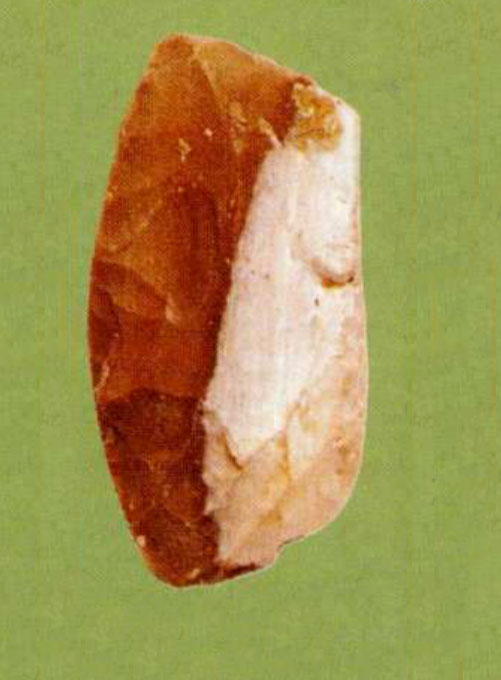 Λίθινο εργαλείο για το ξύσιμο του δέρματος.
Οι τεχνικές κατεργασίας του δέρματος εφαρμόστηκαν ήδη από την παλαιολιθική περίοδο. Θα παραμείνουν περίπου κοινές για όλη την αρχαιότητα ενώ ορισμένες θα διατηρηθούν στην Ευρώπη έως και τον Μεσαίωνα. Με κοφτερά «ξύστρα» αφαιρούσαν από το τομάρι το τρίχωμα και το λίπος. Τα ξύστρα της κλασικής αρχαιότητας δεν διαφέρουν πολύ από τα παλαιολιθικά αλλά ούτε από τις σύγχρονες φαλτσέτες. Μετά τον πλήρη καθαρισμό, συχνά ακολουθούσε το «άργασμα» του δέρματος. Οι πληροφορίες για τη βυρσοδεψία είναι λίγες αλλά η ορολογία που παραδόθηκε είναι πλούσια. Οι βυρσοδέψες της Αθήνας είχαν τα εργαστήριά τους απόμερα, στην περιοχή Κυδαθήναιον, λόγω της δυσοσμίας που συνοδεύει την κατεργασία των δερμάτων.
Λίθινο εργαλείο για το ξύσιμο του δέρματος.
Οι τεχνικές κατεργασίας του δέρματος εφαρμόστηκαν ήδη από την παλαιολιθική περίοδο. Θα παραμείνουν περίπου κοινές για όλη την αρχαιότητα ενώ ορισμένες θα διατηρηθούν στην Ευρώπη έως και τον Μεσαίωνα. Με κοφτερά «ξύστρα» αφαιρούσαν από το τομάρι το τρίχωμα και το λίπος. Τα ξύστρα της κλασικής αρχαιότητας δεν διαφέρουν πολύ από τα παλαιολιθικά αλλά ούτε από τις σύγχρονες φαλτσέτες. Μετά τον πλήρη καθαρισμό, συχνά ακολουθούσε το «άργασμα» του δέρματος. Οι πληροφορίες για τη βυρσοδεψία είναι λίγες αλλά η ορολογία που παραδόθηκε είναι πλούσια. Οι βυρσοδέψες της Αθήνας είχαν τα εργαστήριά τους απόμερα, στην περιοχή Κυδαθήναιον, λόγω της δυσοσμίας που συνοδεύει την κατεργασία των δερμάτων.
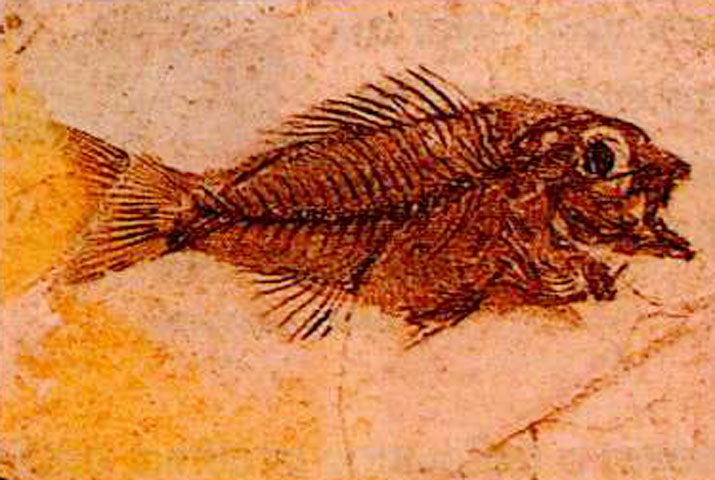 Η Παλαιοντολογία εξετάζει τα απολιθώματα, λείψανα οργανισμών που διατηρήθηκαν μέσα στην πέτρα.
Πριν 4 εκ. χρόνια εμφανίστηκε στην Αφρική ο μακρινότερος πρόγονος του ανθρώπου, ο Αυστραλοπίθηκος. Ο Επιδέξιος άνθρωπος, που πρώτος κατασκεύασε τα λίθινα εργαλεία, έζησε πριν 2 εκ. χρόνια. Λίγο αργότερα ο Όρθιος άνθρωπος θα ανακαλύψει τη φωτιά. Ο Σκεπτόμενος άνθρωπος, ο άμεσος πρόγονός μας, πρωτοεμφανίστηκε 250.000 χρόνια πριν από σήμερα.
Από τις επιστήμες, η γεωλογία εξετάζει την ιστορία της γης. Ένας από τους κλάδους της, η παλαιοντολογία, μελετά τους ζωντανούς οργανισμούς που έζησαν κατά τη διάρκεια των παλαιών εποχών και εντοπίζει τα αποτυπώματά τους στα απολιθώματα. Η αρχαιολογία εξετάζει τα υλικά κατάλοιπα της ανθρώπινης δραστηριότητας.
Η Παλαιοντολογία εξετάζει τα απολιθώματα, λείψανα οργανισμών που διατηρήθηκαν μέσα στην πέτρα.
Πριν 4 εκ. χρόνια εμφανίστηκε στην Αφρική ο μακρινότερος πρόγονος του ανθρώπου, ο Αυστραλοπίθηκος. Ο Επιδέξιος άνθρωπος, που πρώτος κατασκεύασε τα λίθινα εργαλεία, έζησε πριν 2 εκ. χρόνια. Λίγο αργότερα ο Όρθιος άνθρωπος θα ανακαλύψει τη φωτιά. Ο Σκεπτόμενος άνθρωπος, ο άμεσος πρόγονός μας, πρωτοεμφανίστηκε 250.000 χρόνια πριν από σήμερα.
Από τις επιστήμες, η γεωλογία εξετάζει την ιστορία της γης. Ένας από τους κλάδους της, η παλαιοντολογία, μελετά τους ζωντανούς οργανισμούς που έζησαν κατά τη διάρκεια των παλαιών εποχών και εντοπίζει τα αποτυπώματά τους στα απολιθώματα. Η αρχαιολογία εξετάζει τα υλικά κατάλοιπα της ανθρώπινης δραστηριότητας.
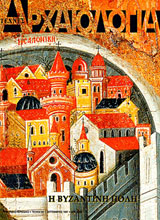
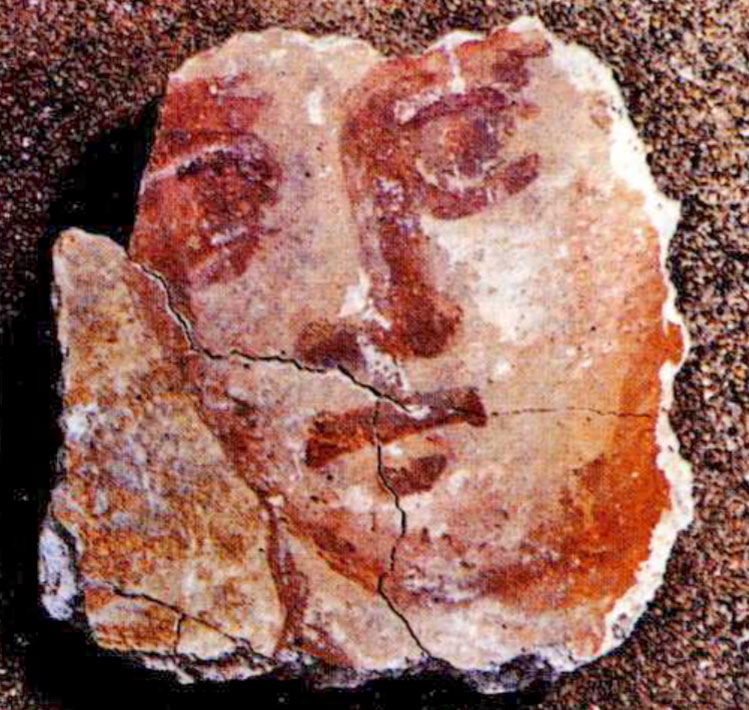 Στόμπι, προσωπογραφία από τοιχογραφία του βαπτιστηρίου.
Το Ανατολικόν Ιλλυρικόν με την περιοχή της Μακεδονίας ήταν κατοικημένο από ισχυρές φυλές, οργανωμένες εθνικά και πολιτικά έτσι ώστε να συνιστούν ένα ξεχωριστό αλλά και συνυφασμένο σύνολο. Το 168 π.Χ., ή ακριβέστερα το 146 π.Χ., περιήλθαν στην ηγεμονία της Ρώμης. Εκείνη την εποχή η Μακεδονία ήταν χωρισμένη σε τέσσερις επαρχίες.
Από το β΄μισό του 2ου αιώνα η Ρωμαϊκή αυτοκρατορία και τα αστικά της κέντρα ζούσαν υπό την απειλή βαρβαρικών επιδρομών από το βορρά. Σε ολόκληρο το Ιλλυρικόν και τη Μακεδονία αρχίζει η αποκατάσταση των πόλεων και των οχυρών που είχαν παραμεληθεί κατά τους ειρηνικούς χρόνους. Το γεγονός αυτό επηρεάζει την αστική οργάνωση των πόλεων.
Για να επανδρωθούν οι μονάδες που φύλαγαν τα οχυρά στις γραμμές του Δούναβη, στρατολογήθηκαν άντρες από απομακρυσμένες ανατολικές επαρχίες, γεγονός που συνέβαλε στην ταχεία ανάπτυξη της λατρείας των ανατολικών θρησκειών. Εκεί οφείλεται η άνοδος του ελληνικού και του ρωμαϊκού πολυθεϊσμού στο Ιλλυρικόν.
Ο Χριστιανισμός άρχισε να διαδίδεται εν μέσω μιας εξαιρετικά σύνθετης πολιτικής και θρησκευτικής συγκυρίας για ολόκληρη τη Ρωμαϊκή αυτοκρατορία, επομένως και για τη Μακεδονία. Την εμφάνισή του έκανε πολύ νωρίς. Σύμφωνα με γραπτές πηγές, η ιεραποστολική δραστηριότητα του Αποστόλου Παύλου ξεπέρασε τις διάφορες μεσογειακές χώρες, φτάνοντας και στα σύνορα του Ιλλυρικού.
Η ελεύθερη και ειρηνική διάδοση του Χριστιανισμού διακόπηκε αιφνίδια το 64 μ.Χ. Η χρονιά αυτή σηματοδοτεί την απαρχή οργανωμένων και σκληρών διώξεων που, με ελάχιστες παύσεις, συνεχίστηκαν έως το 313 μ.Χ., όταν ο Κωνσταντίνος ο Α΄ προκήρυξε την ανοχή στον Χριστιανισμό.
Μετά την επιβολή της θρησκευτικής ειρήνης, ο Χριστιανισμός άρχισε να εκπροσωπεί μια εξωστρεφή εκδήλωση ισχύος την οποία ασκούσε το ίδιο το κράτος. Στις πόλεις οι επίσκοποι είχαν ίση δύναμη με τους υπερασπιστές του κράτους (defensor civitatis). Κάθε πολιτεία ή πόλη είχε έναν επίσκοπο που ήταν το πρόσωπο με τη μεγαλύτερη επιρροή.
Κατά την περίοδο ανάμεσα στην εδραίωση της θρησκευτικής ειρήνης και το τέλος του 6ου αιώνα, η αποαστικοποίηση της αρχαίας πόλεως υπήρξε ραγδαία. Η Εκκλησία ήταν η μόνη που αναλάμβανε την πρωτοβουλία και την διεκπεραίωση δημόσιων κατασκευαστικών έργων.
Στην περιοχή της Μακεδονίας ανακαλύφθηκαν αρκετές παλαιοχριστιανικές επισκοπικές έδρες και χριστιανικοί ναοί. Πέρα από τις αστικές επισκοπικές έδρες, στο φως ήρθε και ένας σημαντικός αριθμός εκκλησιών που υπάγονταν στη δικαιοδοσία επισκόπων.
Τα μεγάλα παλαιοχριστιανικά εκκλησιαστικά κέντρα στη Μακεδονία είναι το Σκούπι, η Ηράκλεια η Λυγκηστική, η Λυχνιδός, η Μπαργκάλα, η Ζαπάρα, το Στόμπι, η Στρούμιτσα και η Prima Justiniana.
Στόμπι, προσωπογραφία από τοιχογραφία του βαπτιστηρίου.
Το Ανατολικόν Ιλλυρικόν με την περιοχή της Μακεδονίας ήταν κατοικημένο από ισχυρές φυλές, οργανωμένες εθνικά και πολιτικά έτσι ώστε να συνιστούν ένα ξεχωριστό αλλά και συνυφασμένο σύνολο. Το 168 π.Χ., ή ακριβέστερα το 146 π.Χ., περιήλθαν στην ηγεμονία της Ρώμης. Εκείνη την εποχή η Μακεδονία ήταν χωρισμένη σε τέσσερις επαρχίες.
Από το β΄μισό του 2ου αιώνα η Ρωμαϊκή αυτοκρατορία και τα αστικά της κέντρα ζούσαν υπό την απειλή βαρβαρικών επιδρομών από το βορρά. Σε ολόκληρο το Ιλλυρικόν και τη Μακεδονία αρχίζει η αποκατάσταση των πόλεων και των οχυρών που είχαν παραμεληθεί κατά τους ειρηνικούς χρόνους. Το γεγονός αυτό επηρεάζει την αστική οργάνωση των πόλεων.
Για να επανδρωθούν οι μονάδες που φύλαγαν τα οχυρά στις γραμμές του Δούναβη, στρατολογήθηκαν άντρες από απομακρυσμένες ανατολικές επαρχίες, γεγονός που συνέβαλε στην ταχεία ανάπτυξη της λατρείας των ανατολικών θρησκειών. Εκεί οφείλεται η άνοδος του ελληνικού και του ρωμαϊκού πολυθεϊσμού στο Ιλλυρικόν.
Ο Χριστιανισμός άρχισε να διαδίδεται εν μέσω μιας εξαιρετικά σύνθετης πολιτικής και θρησκευτικής συγκυρίας για ολόκληρη τη Ρωμαϊκή αυτοκρατορία, επομένως και για τη Μακεδονία. Την εμφάνισή του έκανε πολύ νωρίς. Σύμφωνα με γραπτές πηγές, η ιεραποστολική δραστηριότητα του Αποστόλου Παύλου ξεπέρασε τις διάφορες μεσογειακές χώρες, φτάνοντας και στα σύνορα του Ιλλυρικού.
Η ελεύθερη και ειρηνική διάδοση του Χριστιανισμού διακόπηκε αιφνίδια το 64 μ.Χ. Η χρονιά αυτή σηματοδοτεί την απαρχή οργανωμένων και σκληρών διώξεων που, με ελάχιστες παύσεις, συνεχίστηκαν έως το 313 μ.Χ., όταν ο Κωνσταντίνος ο Α΄ προκήρυξε την ανοχή στον Χριστιανισμό.
Μετά την επιβολή της θρησκευτικής ειρήνης, ο Χριστιανισμός άρχισε να εκπροσωπεί μια εξωστρεφή εκδήλωση ισχύος την οποία ασκούσε το ίδιο το κράτος. Στις πόλεις οι επίσκοποι είχαν ίση δύναμη με τους υπερασπιστές του κράτους (defensor civitatis). Κάθε πολιτεία ή πόλη είχε έναν επίσκοπο που ήταν το πρόσωπο με τη μεγαλύτερη επιρροή.
Κατά την περίοδο ανάμεσα στην εδραίωση της θρησκευτικής ειρήνης και το τέλος του 6ου αιώνα, η αποαστικοποίηση της αρχαίας πόλεως υπήρξε ραγδαία. Η Εκκλησία ήταν η μόνη που αναλάμβανε την πρωτοβουλία και την διεκπεραίωση δημόσιων κατασκευαστικών έργων.
Στην περιοχή της Μακεδονίας ανακαλύφθηκαν αρκετές παλαιοχριστιανικές επισκοπικές έδρες και χριστιανικοί ναοί. Πέρα από τις αστικές επισκοπικές έδρες, στο φως ήρθε και ένας σημαντικός αριθμός εκκλησιών που υπάγονταν στη δικαιοδοσία επισκόπων.
Τα μεγάλα παλαιοχριστιανικά εκκλησιαστικά κέντρα στη Μακεδονία είναι το Σκούπι, η Ηράκλεια η Λυγκηστική, η Λυχνιδός, η Μπαργκάλα, η Ζαπάρα, το Στόμπι, η Στρούμιτσα και η Prima Justiniana.
 Richard Estes, 1936, «Gordon’s Gin» (ιδιωτική συλλογή).
Οι ιστορικοί γεωγράφοι που επικεντρώνονται στο άστυ ασχολήθηκαν με δυο αλληλένδετα θέματα: με την πόλη αυτή καθαυτή (την προφανή δομημένη μορφή της) και με τη γενικότερη έννοια της αστικοποίησης (τη γενική οικονομική, κοινωνική, πολιτική και πολιτισμική διαδικασία, την οποία η δομημένη μορφή της πόλης αντιπροσωπεύει και εκφράζει). Ως προς την ίδια την πόλη, δύο όψεις κυριάρχησαν, η μορφολογία της (η χωρική της διάταξη) και η κοινωνική και οικονομική της λειτουργία. Και οι δυο τους έδωσαν λαβή σε διαφωνίες τόσο ως προς τη φύση τους όσο και ως προς το βαθμό στον οποίο, με διάφορους τρόπους μέσα στο χρόνο, κάποια από τις δύο υπερίσχυσε της άλλης. Βασισμένοι στην άποψη του David Harvey, ότι η μοναδική μέγιστη συνέχεια στην ιστορία της αστικοποίησης είναι εκείνη της αστικοποίησης ως τρόπου παραγωγής (η πόλη ως η οργανώτρια και η γεωγραφική εστία της πλεονάζουσας παραγωγής, της πλεονάζουσας συσσώρευσης και, ποικιλότροπα στα χρόνια του φεουδαλισμού και του καπιταλισμού, της πλεονάζουσας ανακατανομής ή ανταλλαγής), οι ιστορικοί γεωγράφοι υπερθεμάτισαν σπεύδοντας να καταδείξουν ακριβώς με ποιο τρόπο τέτοιες εκφράσεις εκδηλώθηκαν κάτω από διάφορες τεχνολογικές απαιτήσεις.
Το γεγονός αυτό τους οδήγησε σε διαφορετικές κατευθύνσεις. Αντλώντας από οικονομικές θεωρίες αλλά και από θεωρίες Κοινωνικού Δαρβινισμού, οι ιστορικοί γεωγράφοι κατασκεύασαν χωρικά δυναμικά μοντέλα της μοντέρνας βιομηχανικής πόλης αλλά και της φεουδαρχικής προ-βιομηχανικής πόλης. Όλες αυτές οι προσεγγίσεις της μορφής της πόλης υπογραμμίζουν τη δυναμικά μεταβαλλόμενη φύση της.
Άλλοι στράφηκαν προς την ερμηνεία του σχήματος της αστικής κατανομής και των δεσμών –αρχικά τοπικών, στη συνέχεια περιφερειακών και τέλος εθνικών και διεθνών- που αμφότερα υποστήριξαν την αστικοποίηση, την αποσυνέδεσαν όλο και περισσότερο από την οικεία της σχέση με την τοπική ενδοχώρα, και, μέσω της ανταλλαγής, χάλκευσαν νέα έθνη-κράτη και νέες διεθνείς πολιτικές. Σε αυτό το σημείο τόσο οι θεωρίες περί της διάδοσης μέσω των μεταφορών και των βελτιώσεων στις επικοινωνίες, όσο και περί της ιεραρχικής κυριαρχίας ενθάρρυναν μια ευρύτερη εστίαση όσον αφορά τη χωρική κλίμακα και την αστική επιρροή.
Αυτές οι δύο προσεγγίσεις, μορφή ενάντια στη λειτουργία και δια-αστικές ενάντια σε ενδο-αστικές προοπτικές, συμπληρώθηκαν από ένα πολύ πιο γενικό επιχείρημα για τη θεμελιώδη φύση της αστικοποίησης, ανεξαρτήτως τόπου και χρόνου. Οι θεωρίες της αστικοποίησης από τις καταβολές της έως τις μέρες μας είναι ανταγωνιστικές: α) οικονομικό φαινόμενο (μια μέθοδος πλεονασματικής εξαγωγής και κατανάλωσης), β) κοινωνικό φαινόμενο (ένα μέσο οργάνωσης μιας συλλογικής αλλά άνισης κοινωνίας), γ) πολιτικό φαινόμενο (ο έλεγχος, μέσα από αστικά δίκτυα, του εθνικού κράτους καθώς και της καθημερινής ζωής) και δ) πολιτισμικό φαινόμενο (η έκφραση και απεικόνιση της συμβολικής γνώσης). Πρόσφατες συγκρίσεις ανάμεσα στην παρακμή της φυσικής πόλης και την ευρωστία της αστικοποίησης κατά τη μεταμοντέρνα περίοδο τελικά υπογραμμίζουν το βαθμό στον οποίο η μορφή και η λειτουργία, όπως η πόλη και η αστικοποίηση, συνδημιούργησαν μια τέλεια σύνθεση κατά τους πρωτο-μοντέρνους και μοντέρνους χρόνους στη Δυτική Ευρώπη και τώρα, για μία ακόμη φορά, διαχωρίζονται.
Τέλος, η προθυμία της ιστορικής γεωγραφίας να αγκαλιάσει την ευρύτερη ιστορική προοπτική –από τις αστικές καταβολές το 5οοο π.Χ. έως τη σημερινή παγκοσμιοποιημένη αστικοποίηση της μεταμοντέρνας περιόδου- εξασφάλισε για την πόλη και την αστικοποίηση μια θέση στις γεωγραφικές σπουδές που παραμένει αμφιλεγόμενη, υπόκειται σε μόνιμη επανερμηνεία και είναι εξαιρετικά ερεθιστική.
Richard Estes, 1936, «Gordon’s Gin» (ιδιωτική συλλογή).
Οι ιστορικοί γεωγράφοι που επικεντρώνονται στο άστυ ασχολήθηκαν με δυο αλληλένδετα θέματα: με την πόλη αυτή καθαυτή (την προφανή δομημένη μορφή της) και με τη γενικότερη έννοια της αστικοποίησης (τη γενική οικονομική, κοινωνική, πολιτική και πολιτισμική διαδικασία, την οποία η δομημένη μορφή της πόλης αντιπροσωπεύει και εκφράζει). Ως προς την ίδια την πόλη, δύο όψεις κυριάρχησαν, η μορφολογία της (η χωρική της διάταξη) και η κοινωνική και οικονομική της λειτουργία. Και οι δυο τους έδωσαν λαβή σε διαφωνίες τόσο ως προς τη φύση τους όσο και ως προς το βαθμό στον οποίο, με διάφορους τρόπους μέσα στο χρόνο, κάποια από τις δύο υπερίσχυσε της άλλης. Βασισμένοι στην άποψη του David Harvey, ότι η μοναδική μέγιστη συνέχεια στην ιστορία της αστικοποίησης είναι εκείνη της αστικοποίησης ως τρόπου παραγωγής (η πόλη ως η οργανώτρια και η γεωγραφική εστία της πλεονάζουσας παραγωγής, της πλεονάζουσας συσσώρευσης και, ποικιλότροπα στα χρόνια του φεουδαλισμού και του καπιταλισμού, της πλεονάζουσας ανακατανομής ή ανταλλαγής), οι ιστορικοί γεωγράφοι υπερθεμάτισαν σπεύδοντας να καταδείξουν ακριβώς με ποιο τρόπο τέτοιες εκφράσεις εκδηλώθηκαν κάτω από διάφορες τεχνολογικές απαιτήσεις.
Το γεγονός αυτό τους οδήγησε σε διαφορετικές κατευθύνσεις. Αντλώντας από οικονομικές θεωρίες αλλά και από θεωρίες Κοινωνικού Δαρβινισμού, οι ιστορικοί γεωγράφοι κατασκεύασαν χωρικά δυναμικά μοντέλα της μοντέρνας βιομηχανικής πόλης αλλά και της φεουδαρχικής προ-βιομηχανικής πόλης. Όλες αυτές οι προσεγγίσεις της μορφής της πόλης υπογραμμίζουν τη δυναμικά μεταβαλλόμενη φύση της.
Άλλοι στράφηκαν προς την ερμηνεία του σχήματος της αστικής κατανομής και των δεσμών –αρχικά τοπικών, στη συνέχεια περιφερειακών και τέλος εθνικών και διεθνών- που αμφότερα υποστήριξαν την αστικοποίηση, την αποσυνέδεσαν όλο και περισσότερο από την οικεία της σχέση με την τοπική ενδοχώρα, και, μέσω της ανταλλαγής, χάλκευσαν νέα έθνη-κράτη και νέες διεθνείς πολιτικές. Σε αυτό το σημείο τόσο οι θεωρίες περί της διάδοσης μέσω των μεταφορών και των βελτιώσεων στις επικοινωνίες, όσο και περί της ιεραρχικής κυριαρχίας ενθάρρυναν μια ευρύτερη εστίαση όσον αφορά τη χωρική κλίμακα και την αστική επιρροή.
Αυτές οι δύο προσεγγίσεις, μορφή ενάντια στη λειτουργία και δια-αστικές ενάντια σε ενδο-αστικές προοπτικές, συμπληρώθηκαν από ένα πολύ πιο γενικό επιχείρημα για τη θεμελιώδη φύση της αστικοποίησης, ανεξαρτήτως τόπου και χρόνου. Οι θεωρίες της αστικοποίησης από τις καταβολές της έως τις μέρες μας είναι ανταγωνιστικές: α) οικονομικό φαινόμενο (μια μέθοδος πλεονασματικής εξαγωγής και κατανάλωσης), β) κοινωνικό φαινόμενο (ένα μέσο οργάνωσης μιας συλλογικής αλλά άνισης κοινωνίας), γ) πολιτικό φαινόμενο (ο έλεγχος, μέσα από αστικά δίκτυα, του εθνικού κράτους καθώς και της καθημερινής ζωής) και δ) πολιτισμικό φαινόμενο (η έκφραση και απεικόνιση της συμβολικής γνώσης). Πρόσφατες συγκρίσεις ανάμεσα στην παρακμή της φυσικής πόλης και την ευρωστία της αστικοποίησης κατά τη μεταμοντέρνα περίοδο τελικά υπογραμμίζουν το βαθμό στον οποίο η μορφή και η λειτουργία, όπως η πόλη και η αστικοποίηση, συνδημιούργησαν μια τέλεια σύνθεση κατά τους πρωτο-μοντέρνους και μοντέρνους χρόνους στη Δυτική Ευρώπη και τώρα, για μία ακόμη φορά, διαχωρίζονται.
Τέλος, η προθυμία της ιστορικής γεωγραφίας να αγκαλιάσει την ευρύτερη ιστορική προοπτική –από τις αστικές καταβολές το 5οοο π.Χ. έως τη σημερινή παγκοσμιοποιημένη αστικοποίηση της μεταμοντέρνας περιόδου- εξασφάλισε για την πόλη και την αστικοποίηση μια θέση στις γεωγραφικές σπουδές που παραμένει αμφιλεγόμενη, υπόκειται σε μόνιμη επανερμηνεία και είναι εξαιρετικά ερεθιστική.
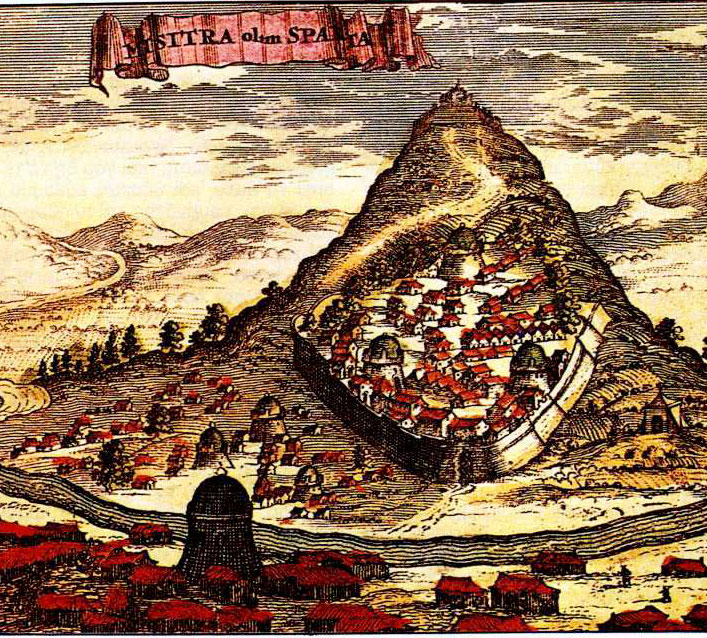 Μυστράς. Χαρακτικό V. Gonelli, «Mémoires de la Morée», Άμστερνταμ 1686.
Το άρθρο σκιαγραφεί την εικόνα της βυζαντινής πόλης κατά την εποχή των Παλαιολόγων (1261-1453). Στα χρόνια αυτά η διοικητική διαίρεση του Βυζαντίου στηρίζεται στα «κατεπανίκια». Ένα καπετανίκιο συνιστούσε μια πόλη με τη γύρω της περιοχή. Κάτοικοι των πόλεων ήταν οι άρχοντες, «οι μέσοι» και ο δήμος. Ανάμεσά τους τη μεγαλύτερη ισχύ είχαν οι γαιοκτήμονες. Οι μέσοι ασχολούνται με εμπορικές δραστηριότητες, που αναπτύσσονται συνήθως έξω από τα τείχη, και ποτέ δεν απόκτησαν πρόσβαση στην εξουσία. Η συνύπαρξη αριστοκρατίας και μέσων, η οποία διαφοροποιούσε τη βυζαντινή πόλη από τη σύγχρονή της δυτικοευρωπαϊκή, επέδρασε αποφασιστικά στη διαμόρφωση του αστικού χώρου.
Ανάμεσα στις πόλεις αυτής της εποχής, διακρίνουμε πόλεις με πολλαπλές λειτουργίες, «πόλεις-εμπόρια» και «πόλεις-κάστρα». Όλες τους είναι τειχισμένες. Το τείχος ορίζει και περιορίζει τον αστικό χώρο. Μέσα από τα τείχη, η έλλειψη σχεδιασμού είναι βασικό γνώρισμα της βυζαντινής πόλης.
Συζητώντας την οργάνωση του αστικού χώρου ως φαινομένου ιστορικά προσδιορισμένου, η συγγραφέας ανατρέχει στην τοιχογραφία που βρίσκεται στη Βλαχέρνα της Άρτας και αναπαριστά τη λιτανεία της εικόνας της Παναγίας της Οδηγήτριας στην Κωνσταντινούπολη. Άντρες και γυναίκες ακολουθούν την εικόνα ενώ κοντά τους, στο αριστερό άκρο της παράστασης, μικρέμποροι πουλάνε τα εμπορεύματά τους σε άντρες που πίνουν και κουβεντιάζουν μεταξύ τους. Είναι δημόσιος ο χώρος όπου τελείται η λιτανεία; Ο περίβολος ενός ναού ή ο ανοιχτός χώρος μπροστά του είναι μεν δημόσιος χώρος, δεν έχει όμως τα χαρακτηριστικά της πλατείας, δεν έχει δηλαδή προβλεφθεί ως τέτοιος. Τη λειτουργία αυτή αποκτα εκ των υστέρων, λόγω της στενής του σύνδεσης με τη μονή.
Οι εκκλησίες αποτελούν σημεία αναφοράς και κοινωνικής ζωής μέσα στην πόλη. Στο χώρο των ναών όχι μόνο αναπτύσσεται κοινωνική ζωή αλλά ασκούνται και κάποιες στοιχειώδεις πολιτικές δραστηριότητες. Γύρω από μια εκκλησία οργανώνονται οι συνοικίες ενώ στους περιβόλους τους συγκεντρώνεται κόσμος για να διασκεδάσει ή να εμπορευτεί.
Τα περιθώρια για κοινωνική ζωή μέσα στην πόλη ήταν περιορισμένα. Η τοπογραφία της βυζαντινής πόλης αποτυπώνει, ήδη από τη μέση εποχή, τον ατομοκεντρικό χαρακτήρα της βυζαντινής κοινωνίας. Η πόλη δεν έδινε στον Βυζαντινό δυνατότητες για να κατασκευάσει τον δημόσιο χώρο του, γιατί ο δημόσιος χώρος δεν ήταν στοιχείο της ζωής του ως υπηκόου του αυτοκράτορα.
Μυστράς. Χαρακτικό V. Gonelli, «Mémoires de la Morée», Άμστερνταμ 1686.
Το άρθρο σκιαγραφεί την εικόνα της βυζαντινής πόλης κατά την εποχή των Παλαιολόγων (1261-1453). Στα χρόνια αυτά η διοικητική διαίρεση του Βυζαντίου στηρίζεται στα «κατεπανίκια». Ένα καπετανίκιο συνιστούσε μια πόλη με τη γύρω της περιοχή. Κάτοικοι των πόλεων ήταν οι άρχοντες, «οι μέσοι» και ο δήμος. Ανάμεσά τους τη μεγαλύτερη ισχύ είχαν οι γαιοκτήμονες. Οι μέσοι ασχολούνται με εμπορικές δραστηριότητες, που αναπτύσσονται συνήθως έξω από τα τείχη, και ποτέ δεν απόκτησαν πρόσβαση στην εξουσία. Η συνύπαρξη αριστοκρατίας και μέσων, η οποία διαφοροποιούσε τη βυζαντινή πόλη από τη σύγχρονή της δυτικοευρωπαϊκή, επέδρασε αποφασιστικά στη διαμόρφωση του αστικού χώρου.
Ανάμεσα στις πόλεις αυτής της εποχής, διακρίνουμε πόλεις με πολλαπλές λειτουργίες, «πόλεις-εμπόρια» και «πόλεις-κάστρα». Όλες τους είναι τειχισμένες. Το τείχος ορίζει και περιορίζει τον αστικό χώρο. Μέσα από τα τείχη, η έλλειψη σχεδιασμού είναι βασικό γνώρισμα της βυζαντινής πόλης.
Συζητώντας την οργάνωση του αστικού χώρου ως φαινομένου ιστορικά προσδιορισμένου, η συγγραφέας ανατρέχει στην τοιχογραφία που βρίσκεται στη Βλαχέρνα της Άρτας και αναπαριστά τη λιτανεία της εικόνας της Παναγίας της Οδηγήτριας στην Κωνσταντινούπολη. Άντρες και γυναίκες ακολουθούν την εικόνα ενώ κοντά τους, στο αριστερό άκρο της παράστασης, μικρέμποροι πουλάνε τα εμπορεύματά τους σε άντρες που πίνουν και κουβεντιάζουν μεταξύ τους. Είναι δημόσιος ο χώρος όπου τελείται η λιτανεία; Ο περίβολος ενός ναού ή ο ανοιχτός χώρος μπροστά του είναι μεν δημόσιος χώρος, δεν έχει όμως τα χαρακτηριστικά της πλατείας, δεν έχει δηλαδή προβλεφθεί ως τέτοιος. Τη λειτουργία αυτή αποκτα εκ των υστέρων, λόγω της στενής του σύνδεσης με τη μονή.
Οι εκκλησίες αποτελούν σημεία αναφοράς και κοινωνικής ζωής μέσα στην πόλη. Στο χώρο των ναών όχι μόνο αναπτύσσεται κοινωνική ζωή αλλά ασκούνται και κάποιες στοιχειώδεις πολιτικές δραστηριότητες. Γύρω από μια εκκλησία οργανώνονται οι συνοικίες ενώ στους περιβόλους τους συγκεντρώνεται κόσμος για να διασκεδάσει ή να εμπορευτεί.
Τα περιθώρια για κοινωνική ζωή μέσα στην πόλη ήταν περιορισμένα. Η τοπογραφία της βυζαντινής πόλης αποτυπώνει, ήδη από τη μέση εποχή, τον ατομοκεντρικό χαρακτήρα της βυζαντινής κοινωνίας. Η πόλη δεν έδινε στον Βυζαντινό δυνατότητες για να κατασκευάσει τον δημόσιο χώρο του, γιατί ο δημόσιος χώρος δεν ήταν στοιχείο της ζωής του ως υπηκόου του αυτοκράτορα.
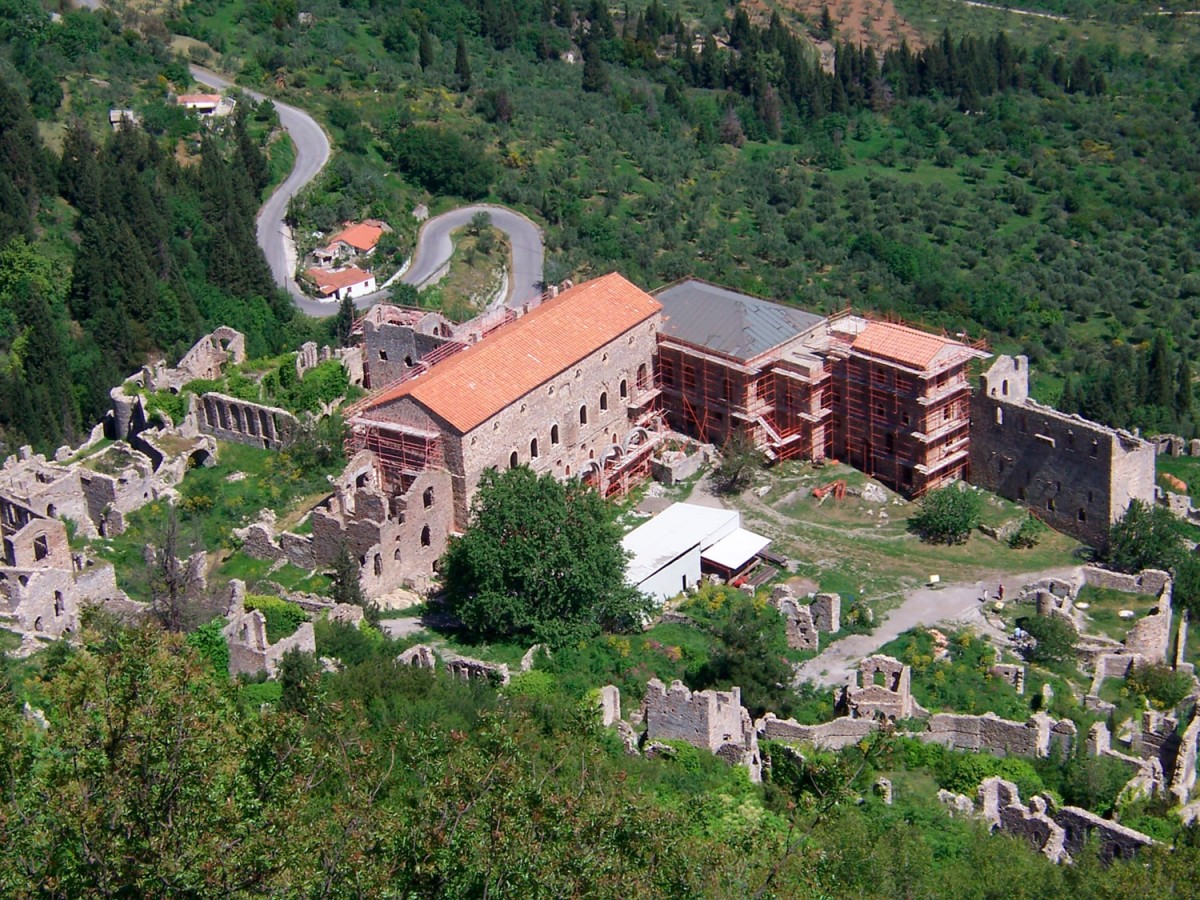 Άποψη του Μυστρά.
Το παρόν τεύχος αποτελεί το τρίτο μέρος του αφιερώματος στην ελληνική πόλη. Όπως η αρχαία ελληνική πόλη μεταφυτεύτηκε, μέσα από τη δυναμική των αποικιών, σε ένα γεωγραφικό χώρο πολύ ευρύτερο από την Ελλάδα, με τρόπο ανάλογο η μεταγενέστερή της βυζαντινή πόλη διαχύθηκε στα Βαλκάνια.
Τα πέντε γενικά άρθρα του αφιερώματος ακολουθούνται από τρεις μονογραφίες για τρεις οικισμούς της Κεντρικής Μακεδονίας. Οι μονογραφίες αυτές, μαζί με τις τέσσερις του προηγούμενου τεύχους, αποτελούν ένα σύνολο που παρέχει πληροφορία αιχμής πάνω στη μακεδονική αρχαιολογία.
Άποψη του Μυστρά.
Το παρόν τεύχος αποτελεί το τρίτο μέρος του αφιερώματος στην ελληνική πόλη. Όπως η αρχαία ελληνική πόλη μεταφυτεύτηκε, μέσα από τη δυναμική των αποικιών, σε ένα γεωγραφικό χώρο πολύ ευρύτερο από την Ελλάδα, με τρόπο ανάλογο η μεταγενέστερή της βυζαντινή πόλη διαχύθηκε στα Βαλκάνια.
Τα πέντε γενικά άρθρα του αφιερώματος ακολουθούνται από τρεις μονογραφίες για τρεις οικισμούς της Κεντρικής Μακεδονίας. Οι μονογραφίες αυτές, μαζί με τις τέσσερις του προηγούμενου τεύχους, αποτελούν ένα σύνολο που παρέχει πληροφορία αιχμής πάνω στη μακεδονική αρχαιολογία.
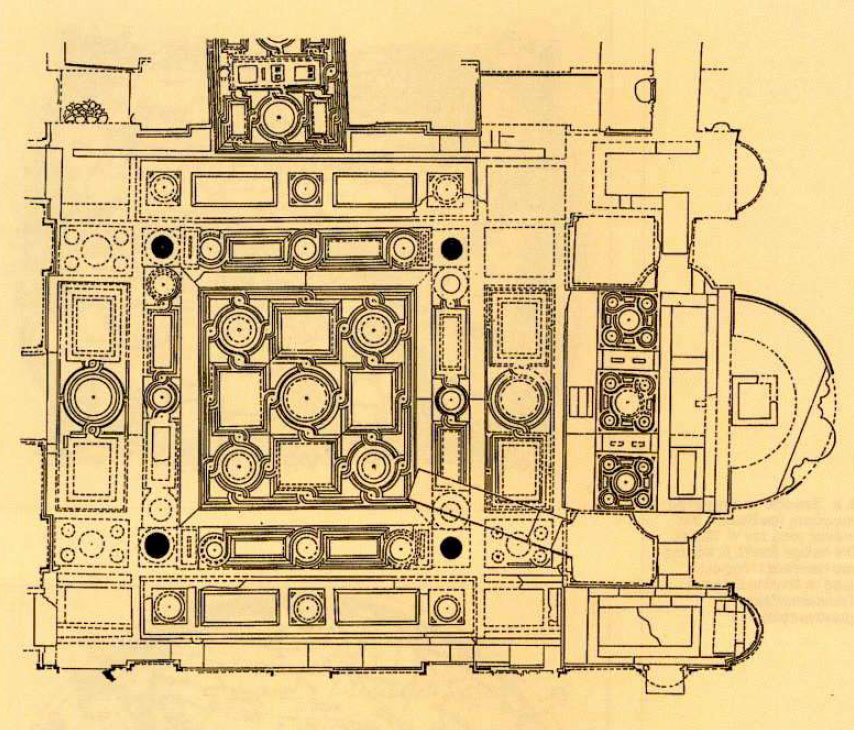 Το πενταόμφαλο του ναού του Παντοκράτορα της Κωνσταντινούπολης.
Ο χριστιανικός ναός έχει διπλή συμβολική διάσταση, την κοσμική και την ουράνια. Ήδη από τους πρώτους χριστιανικούς χρόνους αποτελεί μια εικόνα του κόσμου όντας παράλληλα μια πραγματοποίηση του ουράνιου κόσμου και του Παραδείσου. Ο ναός υπήρξε και μια κατεξοχήν ενσωμάτωση της Ουράνιας Ιερουσαλήμ, στην οποία παραπέμπει.
Ο τύπος του εγγεγραμμένου σταυροειδούς ναού με τρούλο ενσωματώνει συμβολικά τον Σταυρό και τον Εσταυρωμένο. Στα βιβλικά κείμενα , η γη και ο κόσμος είναι τετράγωνα ή κυκλικά και διαιρούνται σε τέσσερις περιοχές από έναν κεντρικό σταυρό, του οποίου το κέντρο, ο «ομφαλός», υποδεικνύει το κέντρο του κόσμου. Τη γη συμβολίζει το τετράγωνο που ορίζεται από τέσσερις κεντρικές κολόνες, κάτω από τον τρούλο, σύμβολο του ουρανού. Ο «ομφαλός» υποδέχεται το ομφάλιο. Στον Δυτικό ναό στο ομφάλιο αντιστοιχεί ο «λαβύρινθος». Με τετραμερή κύκλο απέδωσε ο Δυτικός Μεσαίωνας την Ουράνια Ιερουσαλήμ που, στην Αποκάλυψη του Ιωάννη έχει κάτοψη τετράγωνη και τετραμερή και δώδεκα πύλες.
Η πραγματοποίηση της Ουράνιας Ιερουσαλήμ σε χωρικές κλίμακες που δεν περιορίζονταν στην αρχιτεκτονική αποτέλεσε σκοπό και πόθο όλου του χριστιανισμού. Αυτός ήταν και ο σκοπός του Μεγάλου Κωνσταντίνου κατά την ίδρυση της Κωνσταντινούπολης. Ο αυτοκράτορας διατήρησε τον ρωμαϊκό σταυρό των κύριων οδικών και κοσμικών αρτηριών της ρωμαϊκής πόλης, decumanus (Α-Δ) και cardo (Β-Ν). Το χριστιανικό αντίστοιχο του decumanus ήταν τώρα η κύρια αρτηρία της πόλης που καλούνταν «Λεωφόρος Μέση». Το βορειοδυτικό της τμήμα αντιστοιχούσε στον cardo της Ρώμης, την προβολή πάνω στη γη του κοσμικού άξονα που ενώνει το κέντρο της γης και του κόσμου με τον πολικό αστέρα. Η Βασιλεύουσα είναι το επίκεντρο ενός κοσμικού κέντρου διότι το κράτος είναι ο «οφθαλμός της γης». Κέντρο της πόλης ήταν ο «φόρος» (το ρωμαϊκό forum) που με την ελλειπτική του μορφή παρέπεμπε στον κοσμικό ωκεανό γύρω από τη γη. Το ελλειπτικό forum του Κωνσταντίνου είχε στο κέντρο του μια θεόρατη κολόνα με το κολοσσιαίο άγαλμα του αυτοκράτορα, τη βάση της οποίας περιέκλειαν τέσσερις ναοί που σχημάτιζαν σταυρό. Τόσο αυτό το κεντρικό στοιχείο του forum όσο και εκείνο του μεταγενέστερου forum του Θεοδόσιου Β΄ ήταν τοποθετημένα στην Μέση και ταυτίζονταν με ομφαλό, το κοσμικό κέντρο που βρίσκουμε και στις εκκλησίες. Τα κύρια συμβολικά στοιχεία του χώρου της Κωνσταντινούπολης δείχνουν ότι αυτή εκπροσωπεί μια γιγαντιαία πραγματοποίηση, στο συμβολικό επίπεδο, της μορφής που είναι «εγγεγραμμένη σταυροειδής με τρούλο». Χρήση στοιχείων από αυτό το χριστιανικό πρότυπο διαπιστώνεται σε σημαντικές βυζαντινές πόλεις, όπως η Θεσσαλονίκη, η Μονεμβασία και ο Μυστράς.
Ο Κωνσταντίνος εφάρμοσε το αρχέτυπο της ουράνιας Ιερουσαλήμ και στη χριστιανική Ρώμη. Εκχριστιανίζοντας τον ρωμαϊκό οδικό σταυρό έχτισε βασιλικές στα τέσσερα άκρα του. Η Ρώμη οργανώθηκε έτσι συμβολικά γύρω από ένα «σταυρό (τεσσάρων) βασιλικών», που συνδυαζόταν με την έννοια ενός κυκλικού τείχους με κέντρο το Κολοσσαίο.
Το πενταόμφαλο του ναού του Παντοκράτορα της Κωνσταντινούπολης.
Ο χριστιανικός ναός έχει διπλή συμβολική διάσταση, την κοσμική και την ουράνια. Ήδη από τους πρώτους χριστιανικούς χρόνους αποτελεί μια εικόνα του κόσμου όντας παράλληλα μια πραγματοποίηση του ουράνιου κόσμου και του Παραδείσου. Ο ναός υπήρξε και μια κατεξοχήν ενσωμάτωση της Ουράνιας Ιερουσαλήμ, στην οποία παραπέμπει.
Ο τύπος του εγγεγραμμένου σταυροειδούς ναού με τρούλο ενσωματώνει συμβολικά τον Σταυρό και τον Εσταυρωμένο. Στα βιβλικά κείμενα , η γη και ο κόσμος είναι τετράγωνα ή κυκλικά και διαιρούνται σε τέσσερις περιοχές από έναν κεντρικό σταυρό, του οποίου το κέντρο, ο «ομφαλός», υποδεικνύει το κέντρο του κόσμου. Τη γη συμβολίζει το τετράγωνο που ορίζεται από τέσσερις κεντρικές κολόνες, κάτω από τον τρούλο, σύμβολο του ουρανού. Ο «ομφαλός» υποδέχεται το ομφάλιο. Στον Δυτικό ναό στο ομφάλιο αντιστοιχεί ο «λαβύρινθος». Με τετραμερή κύκλο απέδωσε ο Δυτικός Μεσαίωνας την Ουράνια Ιερουσαλήμ που, στην Αποκάλυψη του Ιωάννη έχει κάτοψη τετράγωνη και τετραμερή και δώδεκα πύλες.
Η πραγματοποίηση της Ουράνιας Ιερουσαλήμ σε χωρικές κλίμακες που δεν περιορίζονταν στην αρχιτεκτονική αποτέλεσε σκοπό και πόθο όλου του χριστιανισμού. Αυτός ήταν και ο σκοπός του Μεγάλου Κωνσταντίνου κατά την ίδρυση της Κωνσταντινούπολης. Ο αυτοκράτορας διατήρησε τον ρωμαϊκό σταυρό των κύριων οδικών και κοσμικών αρτηριών της ρωμαϊκής πόλης, decumanus (Α-Δ) και cardo (Β-Ν). Το χριστιανικό αντίστοιχο του decumanus ήταν τώρα η κύρια αρτηρία της πόλης που καλούνταν «Λεωφόρος Μέση». Το βορειοδυτικό της τμήμα αντιστοιχούσε στον cardo της Ρώμης, την προβολή πάνω στη γη του κοσμικού άξονα που ενώνει το κέντρο της γης και του κόσμου με τον πολικό αστέρα. Η Βασιλεύουσα είναι το επίκεντρο ενός κοσμικού κέντρου διότι το κράτος είναι ο «οφθαλμός της γης». Κέντρο της πόλης ήταν ο «φόρος» (το ρωμαϊκό forum) που με την ελλειπτική του μορφή παρέπεμπε στον κοσμικό ωκεανό γύρω από τη γη. Το ελλειπτικό forum του Κωνσταντίνου είχε στο κέντρο του μια θεόρατη κολόνα με το κολοσσιαίο άγαλμα του αυτοκράτορα, τη βάση της οποίας περιέκλειαν τέσσερις ναοί που σχημάτιζαν σταυρό. Τόσο αυτό το κεντρικό στοιχείο του forum όσο και εκείνο του μεταγενέστερου forum του Θεοδόσιου Β΄ ήταν τοποθετημένα στην Μέση και ταυτίζονταν με ομφαλό, το κοσμικό κέντρο που βρίσκουμε και στις εκκλησίες. Τα κύρια συμβολικά στοιχεία του χώρου της Κωνσταντινούπολης δείχνουν ότι αυτή εκπροσωπεί μια γιγαντιαία πραγματοποίηση, στο συμβολικό επίπεδο, της μορφής που είναι «εγγεγραμμένη σταυροειδής με τρούλο». Χρήση στοιχείων από αυτό το χριστιανικό πρότυπο διαπιστώνεται σε σημαντικές βυζαντινές πόλεις, όπως η Θεσσαλονίκη, η Μονεμβασία και ο Μυστράς.
Ο Κωνσταντίνος εφάρμοσε το αρχέτυπο της ουράνιας Ιερουσαλήμ και στη χριστιανική Ρώμη. Εκχριστιανίζοντας τον ρωμαϊκό οδικό σταυρό έχτισε βασιλικές στα τέσσερα άκρα του. Η Ρώμη οργανώθηκε έτσι συμβολικά γύρω από ένα «σταυρό (τεσσάρων) βασιλικών», που συνδυαζόταν με την έννοια ενός κυκλικού τείχους με κέντρο το Κολοσσαίο.
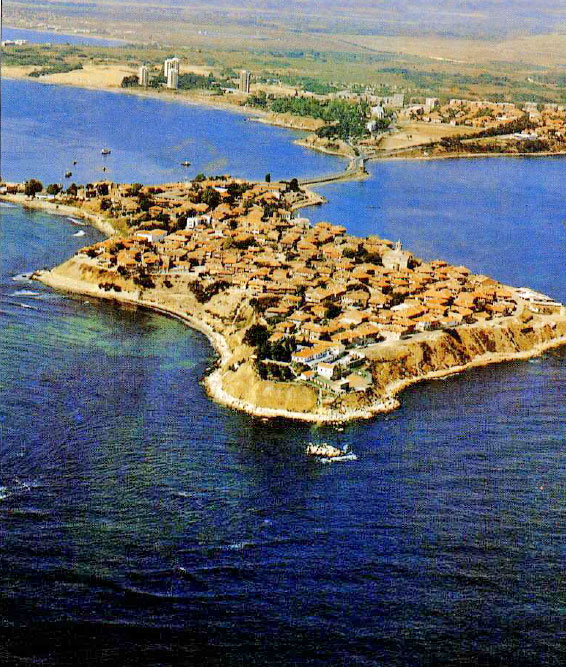 Αεροφωτογραφία της Μεσημβρίας του Ευξείνου.
Το άρθρο σκιαγραφεί τη μετάπλαση της αρχαίας και της ρωμαϊκής πόλης σε παλαιοχριστιανική και, μετά τη θύελλα των βαρβαρικών επιδρομών και εγκαταστάσεων, τη μεταμόρφωσή της, στις ίδιες ή σε νέες θέσεις, σε μεσοβυζαντινή πόλη. Προσδιορίζεται επίσης και η διαδικασία μετάβασης από την πόλη στο κάστρο.
Βασικά κέντρα γύρω από τα οποία διαδραματίστηκαν οι κοσμογονικές αυτές μεταλλαγές στο βαλκανικό χώρο είναι η Κωνσταντινούπολη, η Θεσσαλονίκη και το Σίρμιον. Τα γεγονότα που θα διαδραματιστούν μέσα σε αυτό το τρίγωνο δεν θα αλλάξουν μόνο την πορεία του ιστορικού βίου των ευρωπαϊκών πόλεων και οικισμών του Ανατολικού Ρωμαϊκού κράτους, αλλά θα αλλοιώσουν και την πληθυσμιακή του σύνθεση. Στα μεγάλα αστικά κέντρα, ιδίως όμως στην ύπαιθρο, οι Ρωμαίοι πολίτες, μετά τις βαθύτατες δημογραφικές ανακατατάξεις που ακολούθησαν τις εισβολές και εγκαταστάσεις των επιδρομέων, θα μεταμορφωθούν σε ορισμένες ορεινές περιοχές σε «Αρμάνους»-Βλάχους και, κατά γεωγραφικές περιοχές, οι σλαβικοί πληθυσμοί αναμεμειγμένοι με Βουλγάρους θα παραλάβουν τελικά το όνομα της δυναμικής αυτής μειονότητας. Τέλος, αλλού θα παραμείνουν Σλάβοι, Σέρβοι, Κροάτες, Σλοβένιοι, ενώ βόρεια από τον Ίστρο θα σημειωθεί η λατινογένεση του ρουμανικού έθνους. Σε καμιά πόλη οι κάτοικοι δεν αποτελούν αδιατάρακτη συνέχεια του αρχικού πληθυσμού. Αξιοσημείωτο είναι ότι στις μεγάλες πόλεις δεν έπαψε ποτέ να ομιλείται η ελληνική γλώσσα.
Από τις σλαβικές επιδρομές στη Βαλκανική οι αρχαίες πόλεις μπόρεσαν να επιβιώσουν είτε κρατώντας την αρχαία ονομασία και την πρωταρχική τους θέση, είτε εγκαταλείποντας τη μία από τις δύο.
Ήδη από τον 4ο αιώνα φανερή ήταν η υποβάθμιση και εγκατάλειψη όλων εκείνων των στοιχείων που και κατά την ύστερη ρωμαϊκή εποχή έδιναν την ψευδαίσθηση ότι το πρότυπο της αρχαίας πόλης είναι ζωντανό.
Κατά τον 6ο και τον 7ο αιώνα, τα θέατρα, τα αμφιθέατρα, οι αθλητικές εγκαταστάσεις, τα βουλευτήρια εγκαταλείπονται, όπως και κάθε δημόσιο κτίριο του παρελθόντος, γιατί τώρα πια έχει αλλάξει «εκ βάθρων» η κοινωνική ζωή των πόλεων. Τώρα η εκκλησία, μεγάλη και επιβλητική, και η μικρή πλατεία που τη συνοδεύει αποτελούν το κέντρο της πόλης.
Αν η Πρώιμη Βυζαντινή αυτοκρατορία ήταν ένα σύνολο πόλεων, η Μέση Βυζαντινή αυτοκρατορία, γράφει ο Cyril Mango, μπορεί να χαρακτηριστεί ως ένα σύνολο κάστρων. Αυτή η μετάβαση από την πόλη στο κάστρο είναι ιδιαίτερα χαρακτηριστική στον ελλαδικό χώρο.
Οι βυζαντινολόγοι συμφωνούν ότι, από τον 7ο αιώνα, όλες οι πρώιμες βυζαντινές πόλεις αντικαθίστανται από κάστρα.
Πολλές από τις πόλεις που είχαν καταστραφεί ανοικοδομούνται και συνοικίζονται ήδη από τον 8ο αιώνα. Τον 9ο αιώνα πολλές από τις παλιές πόλεις ανακτούν τον αστικό τους χαρακτήρα, ενώ παράλληλα η οικονομία ξαναγεννιέται βαθμιαία. Η ανακαίνιση ακριβώς του αστικού βίου αποτελεί ένα από τα σπουδαιότερα φαινόμενα της αναγέννησης του 9ου αιώνα. Ας σημειωθεί όμως, ότι οι νέοι οικισμοί δεν έχουν πια καθόλου τον μνημειακό χαρακτήρα της Ύστερης Αρχαιότητας.
Αεροφωτογραφία της Μεσημβρίας του Ευξείνου.
Το άρθρο σκιαγραφεί τη μετάπλαση της αρχαίας και της ρωμαϊκής πόλης σε παλαιοχριστιανική και, μετά τη θύελλα των βαρβαρικών επιδρομών και εγκαταστάσεων, τη μεταμόρφωσή της, στις ίδιες ή σε νέες θέσεις, σε μεσοβυζαντινή πόλη. Προσδιορίζεται επίσης και η διαδικασία μετάβασης από την πόλη στο κάστρο.
Βασικά κέντρα γύρω από τα οποία διαδραματίστηκαν οι κοσμογονικές αυτές μεταλλαγές στο βαλκανικό χώρο είναι η Κωνσταντινούπολη, η Θεσσαλονίκη και το Σίρμιον. Τα γεγονότα που θα διαδραματιστούν μέσα σε αυτό το τρίγωνο δεν θα αλλάξουν μόνο την πορεία του ιστορικού βίου των ευρωπαϊκών πόλεων και οικισμών του Ανατολικού Ρωμαϊκού κράτους, αλλά θα αλλοιώσουν και την πληθυσμιακή του σύνθεση. Στα μεγάλα αστικά κέντρα, ιδίως όμως στην ύπαιθρο, οι Ρωμαίοι πολίτες, μετά τις βαθύτατες δημογραφικές ανακατατάξεις που ακολούθησαν τις εισβολές και εγκαταστάσεις των επιδρομέων, θα μεταμορφωθούν σε ορισμένες ορεινές περιοχές σε «Αρμάνους»-Βλάχους και, κατά γεωγραφικές περιοχές, οι σλαβικοί πληθυσμοί αναμεμειγμένοι με Βουλγάρους θα παραλάβουν τελικά το όνομα της δυναμικής αυτής μειονότητας. Τέλος, αλλού θα παραμείνουν Σλάβοι, Σέρβοι, Κροάτες, Σλοβένιοι, ενώ βόρεια από τον Ίστρο θα σημειωθεί η λατινογένεση του ρουμανικού έθνους. Σε καμιά πόλη οι κάτοικοι δεν αποτελούν αδιατάρακτη συνέχεια του αρχικού πληθυσμού. Αξιοσημείωτο είναι ότι στις μεγάλες πόλεις δεν έπαψε ποτέ να ομιλείται η ελληνική γλώσσα.
Από τις σλαβικές επιδρομές στη Βαλκανική οι αρχαίες πόλεις μπόρεσαν να επιβιώσουν είτε κρατώντας την αρχαία ονομασία και την πρωταρχική τους θέση, είτε εγκαταλείποντας τη μία από τις δύο.
Ήδη από τον 4ο αιώνα φανερή ήταν η υποβάθμιση και εγκατάλειψη όλων εκείνων των στοιχείων που και κατά την ύστερη ρωμαϊκή εποχή έδιναν την ψευδαίσθηση ότι το πρότυπο της αρχαίας πόλης είναι ζωντανό.
Κατά τον 6ο και τον 7ο αιώνα, τα θέατρα, τα αμφιθέατρα, οι αθλητικές εγκαταστάσεις, τα βουλευτήρια εγκαταλείπονται, όπως και κάθε δημόσιο κτίριο του παρελθόντος, γιατί τώρα πια έχει αλλάξει «εκ βάθρων» η κοινωνική ζωή των πόλεων. Τώρα η εκκλησία, μεγάλη και επιβλητική, και η μικρή πλατεία που τη συνοδεύει αποτελούν το κέντρο της πόλης.
Αν η Πρώιμη Βυζαντινή αυτοκρατορία ήταν ένα σύνολο πόλεων, η Μέση Βυζαντινή αυτοκρατορία, γράφει ο Cyril Mango, μπορεί να χαρακτηριστεί ως ένα σύνολο κάστρων. Αυτή η μετάβαση από την πόλη στο κάστρο είναι ιδιαίτερα χαρακτηριστική στον ελλαδικό χώρο.
Οι βυζαντινολόγοι συμφωνούν ότι, από τον 7ο αιώνα, όλες οι πρώιμες βυζαντινές πόλεις αντικαθίστανται από κάστρα.
Πολλές από τις πόλεις που είχαν καταστραφεί ανοικοδομούνται και συνοικίζονται ήδη από τον 8ο αιώνα. Τον 9ο αιώνα πολλές από τις παλιές πόλεις ανακτούν τον αστικό τους χαρακτήρα, ενώ παράλληλα η οικονομία ξαναγεννιέται βαθμιαία. Η ανακαίνιση ακριβώς του αστικού βίου αποτελεί ένα από τα σπουδαιότερα φαινόμενα της αναγέννησης του 9ου αιώνα. Ας σημειωθεί όμως, ότι οι νέοι οικισμοί δεν έχουν πια καθόλου τον μνημειακό χαρακτήρα της Ύστερης Αρχαιότητας.
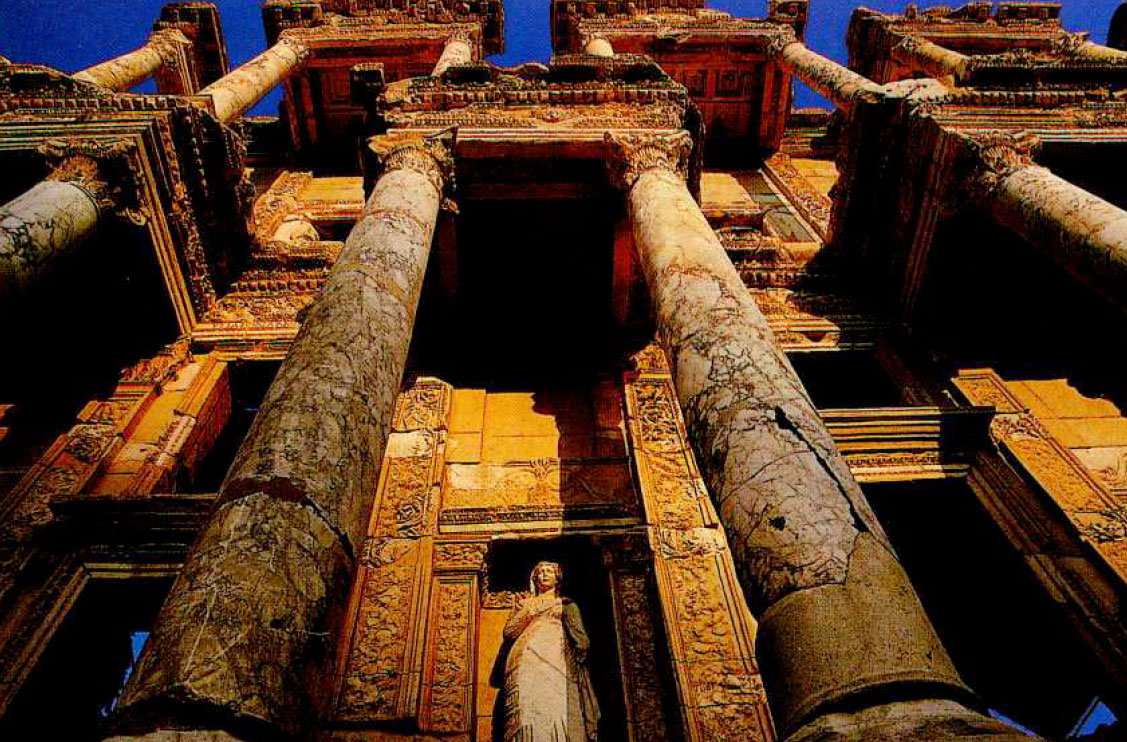 Πρόσοψη της αναστηλωμένης Βιβλιοθήκης του Κέλσου στην Έφεσο (2ος αι. μ.Χ.).
Κατά τη διάρκεια της κλασικής περιόδου η πόλη υπήρξε το βασικό πολιτειακό κύτταρο του ελληνικού κόσμου. Χαρακτηριστικό της γνώρισμα οι δημόσιοι χώροι και τα κτίρια: η αγορά, το βουλευτήριο, το πρυτανείο, το γυμναστήριο, το θέατρο, τα βαλανεία και, βέβαια, οι ναοί.
Στα χρόνια των Ρωμαίων, οι πόλεις της κυρίως Ελλάδας δεν μπορούν να συγκριθούν με τις πόλεις της Μ. Ασίας, όπου ο ελληνικός «αστικός» πολιτισμός συνεχίζει να ακμάζει οικονομικά και πολιτιστικά: στην Έφεσο, την Πέργαμο, τη Σμύρνη, κέντρα αξιόλογα, άκμασε το φαινόμενο του ευεργετισμού. Αντίθετα, η φτωχή γεωργικά κυρίως Ελλάδα στηριζόταν στην καλή θέληση κάποιων ευεργετών για την επισκευή δημόσιων χώρων ή την αναζωογόνηση τελετών.
Οι πόλεις υπέφεραν επίσης από τη βαριά φορολογία που επέβαλλαν οι Ρωμαίοι. Από το γενικό κλίμα της παρακμής στην κυρίως Ελλάδα ξέφυγαν μόνο όσες πόλεις δημιουργήθηκαν ή επανιδρύθηκαν από τους Ρωμαίους ως αποικίες (Νικόπολη, Πάτρα, Κόρινθος), καθώς και οι δύο πρώην μεγάλες δυνάμεις, Αθήνα και Σπάρτη, που προορισμός τους ήταν να λειτουργούν ως πόλεις-μουσεία και τουριστικά αξιοθέατα για τους Ρωμαίους με εκλεπτυσμένα γούστα.
Την παρακμή της δημοκρατίας επιβεβαιώνει η απολιτικοποίηση δημόσιων κτιρίων, όπως το γυμνάσιο και το πρυτανείο. Το γυμνάσιο έχει γίνει κέντρο αναψυχής στο οποίο συχνάζουν κυρίες της αριστοκρατίας. Θρησκευτική έγινε η κύρια λειτουργία του πρυτανείου και ο πρύτανης ήταν συχνά γυναίκα. Η αγορά αλλάζει αρχιτεκτονικό σχεδιασμό και περιορίζεται στον οικονομικό της ρόλο. Το θέατρο μετατρέπεται σε χώρο θεάματος.
Από τη μεταβολή της λειτουργίας των δημόσιων χώρων του άστεως, γίνεται φανερή η μετατροπή του άστεως από αυτόνομη πολιτική μονάδα σε τμήμα του διοικητικού μηχανισμού του ρωμαϊκού κράτους.
Πρόσοψη της αναστηλωμένης Βιβλιοθήκης του Κέλσου στην Έφεσο (2ος αι. μ.Χ.).
Κατά τη διάρκεια της κλασικής περιόδου η πόλη υπήρξε το βασικό πολιτειακό κύτταρο του ελληνικού κόσμου. Χαρακτηριστικό της γνώρισμα οι δημόσιοι χώροι και τα κτίρια: η αγορά, το βουλευτήριο, το πρυτανείο, το γυμναστήριο, το θέατρο, τα βαλανεία και, βέβαια, οι ναοί.
Στα χρόνια των Ρωμαίων, οι πόλεις της κυρίως Ελλάδας δεν μπορούν να συγκριθούν με τις πόλεις της Μ. Ασίας, όπου ο ελληνικός «αστικός» πολιτισμός συνεχίζει να ακμάζει οικονομικά και πολιτιστικά: στην Έφεσο, την Πέργαμο, τη Σμύρνη, κέντρα αξιόλογα, άκμασε το φαινόμενο του ευεργετισμού. Αντίθετα, η φτωχή γεωργικά κυρίως Ελλάδα στηριζόταν στην καλή θέληση κάποιων ευεργετών για την επισκευή δημόσιων χώρων ή την αναζωογόνηση τελετών.
Οι πόλεις υπέφεραν επίσης από τη βαριά φορολογία που επέβαλλαν οι Ρωμαίοι. Από το γενικό κλίμα της παρακμής στην κυρίως Ελλάδα ξέφυγαν μόνο όσες πόλεις δημιουργήθηκαν ή επανιδρύθηκαν από τους Ρωμαίους ως αποικίες (Νικόπολη, Πάτρα, Κόρινθος), καθώς και οι δύο πρώην μεγάλες δυνάμεις, Αθήνα και Σπάρτη, που προορισμός τους ήταν να λειτουργούν ως πόλεις-μουσεία και τουριστικά αξιοθέατα για τους Ρωμαίους με εκλεπτυσμένα γούστα.
Την παρακμή της δημοκρατίας επιβεβαιώνει η απολιτικοποίηση δημόσιων κτιρίων, όπως το γυμνάσιο και το πρυτανείο. Το γυμνάσιο έχει γίνει κέντρο αναψυχής στο οποίο συχνάζουν κυρίες της αριστοκρατίας. Θρησκευτική έγινε η κύρια λειτουργία του πρυτανείου και ο πρύτανης ήταν συχνά γυναίκα. Η αγορά αλλάζει αρχιτεκτονικό σχεδιασμό και περιορίζεται στον οικονομικό της ρόλο. Το θέατρο μετατρέπεται σε χώρο θεάματος.
Από τη μεταβολή της λειτουργίας των δημόσιων χώρων του άστεως, γίνεται φανερή η μετατροπή του άστεως από αυτόνομη πολιτική μονάδα σε τμήμα του διοικητικού μηχανισμού του ρωμαϊκού κράτους.
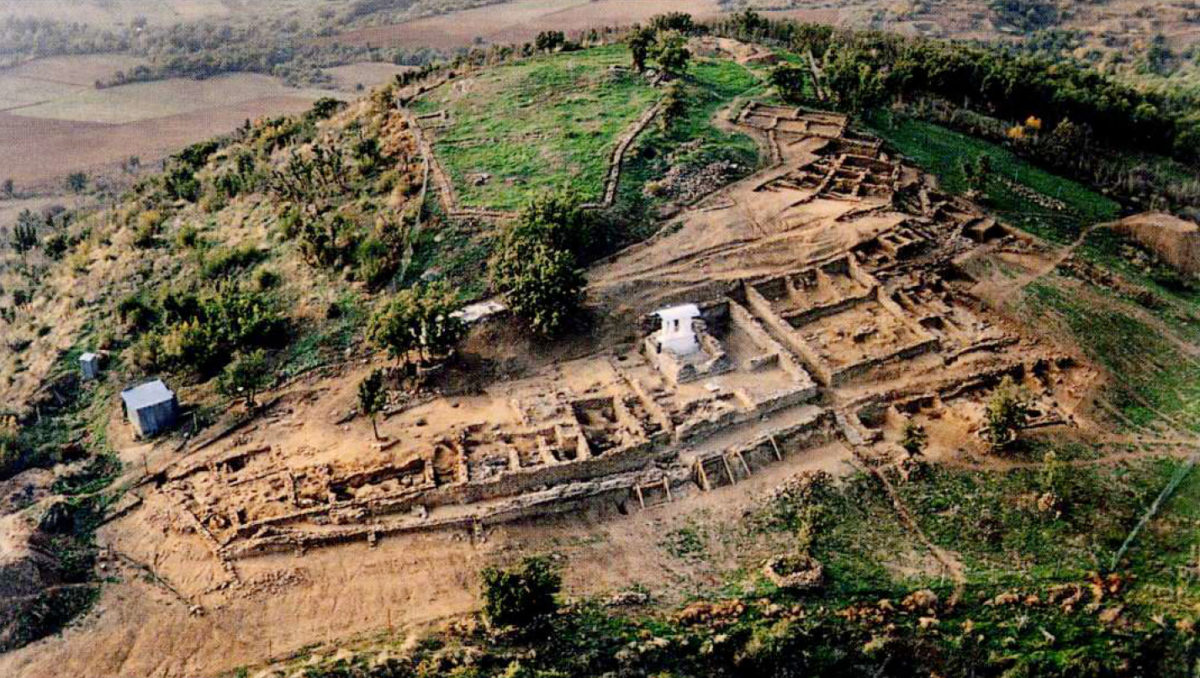 Παλατιανό, το αρχαίο Ίωρον. Το ανασκαμμένο τμήμα της πόλης το 1996.
Η Κρηστωνία τοποθετείται στο ανατολικό τμήμα της εύφορης πεδιάδας που ξεκινάει από τον ποταμό Αξιό και φθάνει έως τον ορεινό όγκο του Δυσώρου. Το αρχαιολογικό ενδιαφέρον εντοπίζεται στα τέσσερα αστικά κέντρα της, τις πόλεις των Κλιτών, της Μορρύλου, των Βραγυλών και του Ιώρου, των οποίων η θέση είχε άμεση σχέση με τις οδικές αρτηρίες της περιοχής. Το αρχαίο Ίωρον, που τοποθετείται στον σύγχρονο οικισμό του Παλατιανού του νομού Κιλκίς, είχε τον έλεγχο της διάβασης που συνέδεε τη Σιντική και την Παρορβηλία με την Κρηστωνία και τη Μυγδονία.
Η ανεύρεση αγάλματος του Διονύσου, επιγραφής και αγγείων με διονυσιακές παραστάσεις συνηγορούν υπέρ της τοποθέτησης σε αυτό το χώρο του διάσημου στην Κρηστωνία ιερού του Διονύσου. Το πιο αξιόλογο μνημείο του χώρου είναι το ηρώο του Παλατιανού. Το μνημειακό ταφικό κτίσμα φέρει πάνω στο βάθρο του τέσσερα μαρμάρινα αγάλματα που παριστάνουν, αφηρωισμένα, τα μέλη μιας επιφανούς οικογένειας της περιοχής. Τα ονόματά τους, Πάτραος, Αμμία, Αλέξανδρος, Ζόιλος και Μήδης, είναι κοινά στη Μακεδονία. Το ηρώο δεν βρίσκεται σε χώρο νεκροταφείου αλλά σε δημόσιο χώρο της πόλης, ίσως στην Αγορά, όπως συμβαίνει με το ανάλογο παράδειγμα της Πριήνης. Ένα δεύτερο ηρώο βρέθηκε κοντά στο πρώτο.
Η συστηματική ανασκαφή του Παλατιανού άρχισε το 1993 φέρνοντας στο φως πολλά στοιχεία που επιτρέπουν τον προσδιορισμό της κατοίκησής της από τον 4ο αιώνα π.Χ. έως τον 3ο αιώνα μ.Χ. καθώς και σημαντικές ενδείξεις για την κατοίκηση του χώρου κατά τον 6ο, 7ο και 8ο αιώνα π.Χ. Ο οικισμός των ρωμαϊκών χρόνων που εγκαταλείφθηκε τον 3ο αιώνα, διαδέχθηκε την πόλη της ελληνιστικής περιόδου που είχε αναπτυχθεί στον ίδιο χώρο από τον 4ο έως τον 1ο αιώνα π.Χ. Τα κινητά ευρήματα, μήτρες κατασκευής ειδωλίων, αγγείων, λυχναριών, πήλινων πλακιδίων, τα λίθινα, σιδερένια, χάλκινα και οστέινα εργαλεία, οι πήλινες και μολύβδινες αγνύθες, τα πήλινα και χάλκινα ειδώλια θεών, όπως της Κυβέλης, του Δία Υψίστου, του Ερμή, της Αθηνάς, του Διονύσου, του Αιγύπτιου Bes μαρτυρούν την ύπαρξη εργαστηριακών χώρων και χώρων λατρείας.
Παλατιανό, το αρχαίο Ίωρον. Το ανασκαμμένο τμήμα της πόλης το 1996.
Η Κρηστωνία τοποθετείται στο ανατολικό τμήμα της εύφορης πεδιάδας που ξεκινάει από τον ποταμό Αξιό και φθάνει έως τον ορεινό όγκο του Δυσώρου. Το αρχαιολογικό ενδιαφέρον εντοπίζεται στα τέσσερα αστικά κέντρα της, τις πόλεις των Κλιτών, της Μορρύλου, των Βραγυλών και του Ιώρου, των οποίων η θέση είχε άμεση σχέση με τις οδικές αρτηρίες της περιοχής. Το αρχαίο Ίωρον, που τοποθετείται στον σύγχρονο οικισμό του Παλατιανού του νομού Κιλκίς, είχε τον έλεγχο της διάβασης που συνέδεε τη Σιντική και την Παρορβηλία με την Κρηστωνία και τη Μυγδονία.
Η ανεύρεση αγάλματος του Διονύσου, επιγραφής και αγγείων με διονυσιακές παραστάσεις συνηγορούν υπέρ της τοποθέτησης σε αυτό το χώρο του διάσημου στην Κρηστωνία ιερού του Διονύσου. Το πιο αξιόλογο μνημείο του χώρου είναι το ηρώο του Παλατιανού. Το μνημειακό ταφικό κτίσμα φέρει πάνω στο βάθρο του τέσσερα μαρμάρινα αγάλματα που παριστάνουν, αφηρωισμένα, τα μέλη μιας επιφανούς οικογένειας της περιοχής. Τα ονόματά τους, Πάτραος, Αμμία, Αλέξανδρος, Ζόιλος και Μήδης, είναι κοινά στη Μακεδονία. Το ηρώο δεν βρίσκεται σε χώρο νεκροταφείου αλλά σε δημόσιο χώρο της πόλης, ίσως στην Αγορά, όπως συμβαίνει με το ανάλογο παράδειγμα της Πριήνης. Ένα δεύτερο ηρώο βρέθηκε κοντά στο πρώτο.
Η συστηματική ανασκαφή του Παλατιανού άρχισε το 1993 φέρνοντας στο φως πολλά στοιχεία που επιτρέπουν τον προσδιορισμό της κατοίκησής της από τον 4ο αιώνα π.Χ. έως τον 3ο αιώνα μ.Χ. καθώς και σημαντικές ενδείξεις για την κατοίκηση του χώρου κατά τον 6ο, 7ο και 8ο αιώνα π.Χ. Ο οικισμός των ρωμαϊκών χρόνων που εγκαταλείφθηκε τον 3ο αιώνα, διαδέχθηκε την πόλη της ελληνιστικής περιόδου που είχε αναπτυχθεί στον ίδιο χώρο από τον 4ο έως τον 1ο αιώνα π.Χ. Τα κινητά ευρήματα, μήτρες κατασκευής ειδωλίων, αγγείων, λυχναριών, πήλινων πλακιδίων, τα λίθινα, σιδερένια, χάλκινα και οστέινα εργαλεία, οι πήλινες και μολύβδινες αγνύθες, τα πήλινα και χάλκινα ειδώλια θεών, όπως της Κυβέλης, του Δία Υψίστου, του Ερμή, της Αθηνάς, του Διονύσου, του Αιγύπτιου Bes μαρτυρούν την ύπαρξη εργαστηριακών χώρων και χώρων λατρείας.
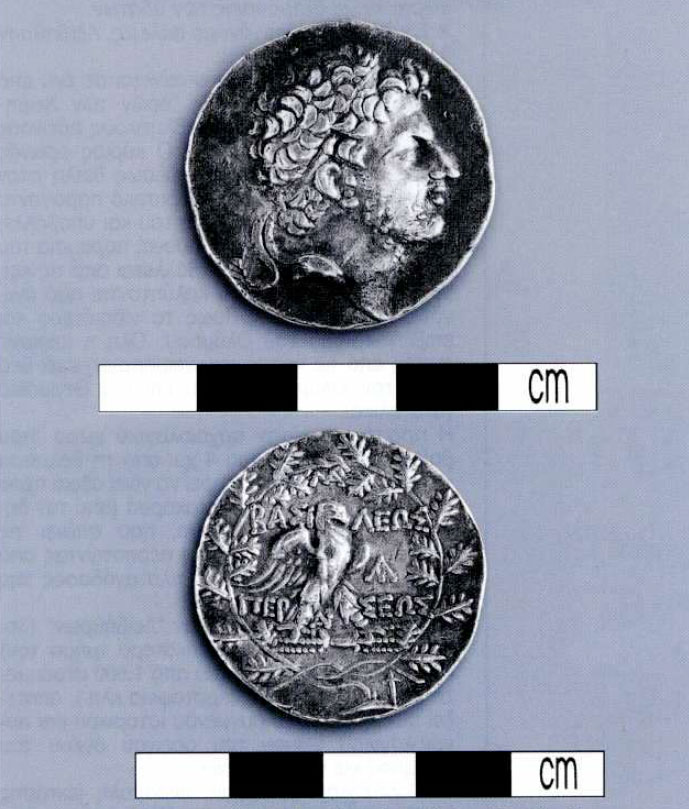 Αργυρό τετράδραχμο Περσέως από τα Λείβηθρα, 179-168 π.Χ.
Τα Λείβηθρα βρίσκονται στο νότιο τμήμα του νομού Πιερίας, μπροστά στη μεγάλη πτυχή που χωρίζει τον Άνω από τον Κάτω Όλυμπο. Κοντά στα Λείβηθρα, σε μια από τις σπηλιές του Ολύμπου, γεννήθηκε ο Ορφέας. Γιατί οι Θράσσες και οι Μακεδόνισσες γυναίκες της Πιερίας σκότωσαν τον Ορφέα; Στα Λείβηθρα βρισκόταν το πρώτο «τελεστήριον» των μυστηρίων του, εδώ και το ιερό με τον τάφο του, για τις γυναίκες «παντελώς άβατον».
Ο αρχαιολογικός χώρος των «Λειβήθρων» περιλαμβάνει α) περιτειχισμένη αρχαία ακρόπολη που μοιάζει να εγκαταλείφθηκε στα ελληνιστικά χρόνια, β) αρχαίο οικισμό που χρονολογείται από τα προϊστορικά ίσως χρόνια έως και τα βυζαντινά και γ) αρχαία νεκροταφεία που χρονολογούνται από τα προϊστορικά χρόνια έως και τα ελληνιστικά.
Αργυρό τετράδραχμο Περσέως από τα Λείβηθρα, 179-168 π.Χ.
Τα Λείβηθρα βρίσκονται στο νότιο τμήμα του νομού Πιερίας, μπροστά στη μεγάλη πτυχή που χωρίζει τον Άνω από τον Κάτω Όλυμπο. Κοντά στα Λείβηθρα, σε μια από τις σπηλιές του Ολύμπου, γεννήθηκε ο Ορφέας. Γιατί οι Θράσσες και οι Μακεδόνισσες γυναίκες της Πιερίας σκότωσαν τον Ορφέα; Στα Λείβηθρα βρισκόταν το πρώτο «τελεστήριον» των μυστηρίων του, εδώ και το ιερό με τον τάφο του, για τις γυναίκες «παντελώς άβατον».
Ο αρχαιολογικός χώρος των «Λειβήθρων» περιλαμβάνει α) περιτειχισμένη αρχαία ακρόπολη που μοιάζει να εγκαταλείφθηκε στα ελληνιστικά χρόνια, β) αρχαίο οικισμό που χρονολογείται από τα προϊστορικά ίσως χρόνια έως και τα βυζαντινά και γ) αρχαία νεκροταφεία που χρονολογούνται από τα προϊστορικά χρόνια έως και τα ελληνιστικά.
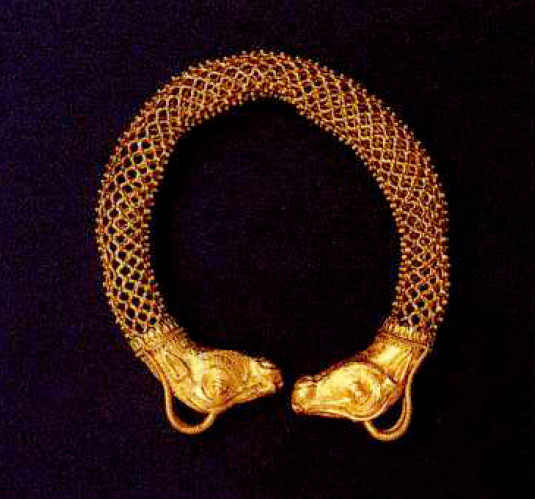 Ευρωπός. Το χρυσό βραχιόλι του κιβωτιόσχημου τάφου ξέφυγε από τους αρχαίους τυμβωρύχους.
Τα αρχαιότερα λείψανα κατοίκησης της αρχαίας Ευρωπού εντοπίζονται στο κέντρο του σημερινού χωριού, στον προϊστορικό οικισμό που έχει τη μορφή τούμπας. Παρά την έλλειψη ανασκαφής, τα διάσπαρτα όστρακα αγγείων αποδεικνύουν μια πρώιμη ανταλλαγή στον τομέα του εμπορίου με τη νότια Ελλάδα, όπως μαρτυρεί και ο αρχαϊκός Κούρος που σήμερα βρίσκεται στο Μουσείο Κιλκίς.
Φαίνεται ότι η Ευρωπός στη διάρκεια του 5ου-4ου αιώνα ήταν από τα πλέον αναπτυγμένα και σε δεσπόζουσα θέση πολίσματα. Για το λόγο αυτό ο Θραξ εισβολέας Σιτάλκης κατέβαλε προσπάθεια να την εκπορθήσει. Τα τεράστια πιθάρια που αποκαλύφθηκαν σε κάθε οικιακό χώρο μαρτυρούν την οικονομική της ευμάρεια και την αφθονία των προϊόντων της γης της.
Η έρευνα των νεκροταφείων μας δίνει απτά την κοινωνική διαστρωμάτωση της εποχής. Η αποκάλυψη μιας συστάδας τάφων, ενός μακεδονικού, ενός κιβωτιόσχημου και μιας θήκης, με χρυσά κτερίσματα αποδεικνύει την ύπαρξη εταίρων στην κοινωνία της Ευρωπού. Τα ευρήματα των απλών κεραμοσκεπών τάφων αποδεικνύουν την ομοιογένεια των ταφικών εθίμων και πρακτικών με ολόκληρη την υπόλοιπη Μακεδονία και το κοινό πολιτισμικό επίπεδο. Στα χρόνια των Ρωμαίων, η αλματώδης ανάπτυξη της πόλης είναι έκδηλη στα ταφικά της μνημεία. Από τα εντυπωσιακότερα ευρήματα είναι οι καμαροσκέπαστοι υπόγειοι μονοθάλαμοι ή διθάλαμοι τάφοι με οικογενειακό χαρακτήρα.
Η ακρόπολη σταδιακά ερημώνεται κατά τον 5ο και τις αρχές του 6ου αιώνα, και σε μεγάλα τμήματά της εγκαθίστανται κεραμείς με τα εργαστήριά τους.
Με την ανάδειξη του αρχαιολογικού χώρου η Ευρωπός τού 1997 θα μπορεί δικαιωματικά να νιώθει περήφανη για το επίθετο «Ευρωπαίος», το οποίο δάνεισε στην Ενωμένη Ευρώπη η ομώνυμη προκάτοχός της.
Ευρωπός. Το χρυσό βραχιόλι του κιβωτιόσχημου τάφου ξέφυγε από τους αρχαίους τυμβωρύχους.
Τα αρχαιότερα λείψανα κατοίκησης της αρχαίας Ευρωπού εντοπίζονται στο κέντρο του σημερινού χωριού, στον προϊστορικό οικισμό που έχει τη μορφή τούμπας. Παρά την έλλειψη ανασκαφής, τα διάσπαρτα όστρακα αγγείων αποδεικνύουν μια πρώιμη ανταλλαγή στον τομέα του εμπορίου με τη νότια Ελλάδα, όπως μαρτυρεί και ο αρχαϊκός Κούρος που σήμερα βρίσκεται στο Μουσείο Κιλκίς.
Φαίνεται ότι η Ευρωπός στη διάρκεια του 5ου-4ου αιώνα ήταν από τα πλέον αναπτυγμένα και σε δεσπόζουσα θέση πολίσματα. Για το λόγο αυτό ο Θραξ εισβολέας Σιτάλκης κατέβαλε προσπάθεια να την εκπορθήσει. Τα τεράστια πιθάρια που αποκαλύφθηκαν σε κάθε οικιακό χώρο μαρτυρούν την οικονομική της ευμάρεια και την αφθονία των προϊόντων της γης της.
Η έρευνα των νεκροταφείων μας δίνει απτά την κοινωνική διαστρωμάτωση της εποχής. Η αποκάλυψη μιας συστάδας τάφων, ενός μακεδονικού, ενός κιβωτιόσχημου και μιας θήκης, με χρυσά κτερίσματα αποδεικνύει την ύπαρξη εταίρων στην κοινωνία της Ευρωπού. Τα ευρήματα των απλών κεραμοσκεπών τάφων αποδεικνύουν την ομοιογένεια των ταφικών εθίμων και πρακτικών με ολόκληρη την υπόλοιπη Μακεδονία και το κοινό πολιτισμικό επίπεδο. Στα χρόνια των Ρωμαίων, η αλματώδης ανάπτυξη της πόλης είναι έκδηλη στα ταφικά της μνημεία. Από τα εντυπωσιακότερα ευρήματα είναι οι καμαροσκέπαστοι υπόγειοι μονοθάλαμοι ή διθάλαμοι τάφοι με οικογενειακό χαρακτήρα.
Η ακρόπολη σταδιακά ερημώνεται κατά τον 5ο και τις αρχές του 6ου αιώνα, και σε μεγάλα τμήματά της εγκαθίστανται κεραμείς με τα εργαστήριά τους.
Με την ανάδειξη του αρχαιολογικού χώρου η Ευρωπός τού 1997 θα μπορεί δικαιωματικά να νιώθει περήφανη για το επίθετο «Ευρωπαίος», το οποίο δάνεισε στην Ενωμένη Ευρώπη η ομώνυμη προκάτοχός της.
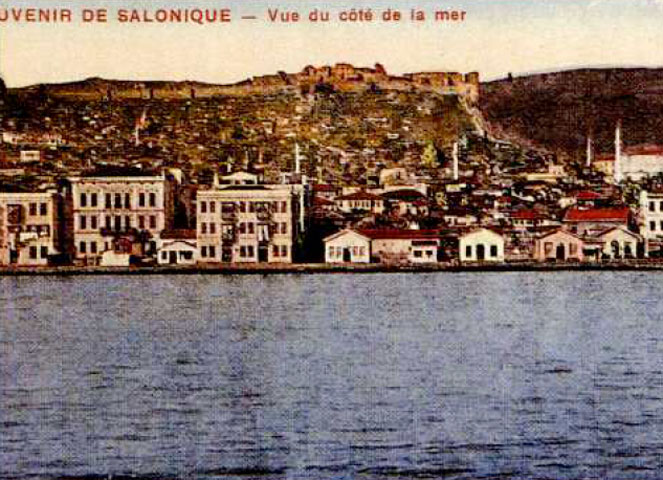 Η Θεσσαλονίκη από τη θάλασσα στα τέλη του 19ου αιώνα.
Στα πεντακόσια χρόνια της οθωμανικής κυριαρχίας (1430-1912) η βυζαντινή φυσιογνωμία της Θεσσαλονίκης αλλοιώθηκε και η πόλη απόκτησε το ανατολίτικο χρώμα που τόσο γοήτευε τους ταξιδιώτες περιηγητές. Κύριο ρόλο στη διαμόρφωση της πόλης έπαιξε η νέα εθνολογική σύσταση του πληθυσμού της, καθώς στους Χριστιανούς κατοίκους προστέθηκαν Μουσουλμάνοι και Εβραίοι, και αργότερα μικρότερες μειονότητες από Σλάβους, Βουλγάρους, Ρουμάνους, Λεβαντίνους και άλλους Ευρωπαίους.
Οι Μουσουλμάνοι έχτισαν πολλά τζαμιά, μεντρεσέδες, πτωχοκομεία, λουτρά, τεκέδες, χάνια, κρήνες κ.ά. και ακόμη εκσυγχρόνισαν και συντήρησαν την οχύρωση. Οι Εβραίοι, αν και αποτελούσαν την πολυπληθέστερη κοινότητα και σημαντικό παράγοντα της οικονομικής και πολιτισμικής ζωής, δεν άφησαν δείγματα της δικής τους οικοδομικής δραστηριότητας. Η οικοδομική δραστηριότητα του χριστιανικού στοιχείου γίνεται αισθητή στην πόλη από τις αρχές του 19ου αιώνα και μετά, οπότε εμφανίζονται οι πρώτες μεταβυζαντινές εκκλησίες.
Τον 19ο αιώνα ο αέρας του εξευρωπαϊσμού που φυσάει στην Υψηλή Πύλη φέρνει διάθεση εκσυγχρονισμού στη Θεσσαλονίκη. Ο τριπλασιασμός του πληθυσμού, η απαρχή της εκβιομηχάνισης, η ραγδαία οικονομική ανάπτυξη, η εγκατάσταση δημοτικής αρχής και, τέλος, το Μακεδονικό ζήτημα οδηγούν σε έντονη οικοδομική δραστηριότητα. Το πρώτο «σχέδιο πόλεως» συντάσσεται το 1880. Τα παραθαλάσσια τείχη κατεδαφίζονται, δημιουργείται προκυμαία και η πόλη ανοίγεται στη θάλασσα. Η Θεσσαλονίκη μεταμορφώνεται σε διεθνές λιμάνι με κοσμοπολίτικο χαρακτήρα. Στο διάστημα 1890-1912 η οθωμανική κυβέρνηση κτίζει σειρά μεγαλοπρεπών δημόσιων κτιρίων. Η ισραηλιτική κοινότητα εγκαταλείπει την τακτική της αφάνειας. Η θρησκευτική αρχιτεκτονική της ελληνικής κοινότητας ακολουθεί νεοβυζαντινά πρότυπα, η δημόσια αρχιτεκτονική της συμβαδίζει με τον Νεοκλασικισμό την ώρα που η πλειονότητα των ιδιωτικών αρχοντικών ακολουθεί τον Εκλεκτικισμό.
Η Θεσσαλονίκη από τη θάλασσα στα τέλη του 19ου αιώνα.
Στα πεντακόσια χρόνια της οθωμανικής κυριαρχίας (1430-1912) η βυζαντινή φυσιογνωμία της Θεσσαλονίκης αλλοιώθηκε και η πόλη απόκτησε το ανατολίτικο χρώμα που τόσο γοήτευε τους ταξιδιώτες περιηγητές. Κύριο ρόλο στη διαμόρφωση της πόλης έπαιξε η νέα εθνολογική σύσταση του πληθυσμού της, καθώς στους Χριστιανούς κατοίκους προστέθηκαν Μουσουλμάνοι και Εβραίοι, και αργότερα μικρότερες μειονότητες από Σλάβους, Βουλγάρους, Ρουμάνους, Λεβαντίνους και άλλους Ευρωπαίους.
Οι Μουσουλμάνοι έχτισαν πολλά τζαμιά, μεντρεσέδες, πτωχοκομεία, λουτρά, τεκέδες, χάνια, κρήνες κ.ά. και ακόμη εκσυγχρόνισαν και συντήρησαν την οχύρωση. Οι Εβραίοι, αν και αποτελούσαν την πολυπληθέστερη κοινότητα και σημαντικό παράγοντα της οικονομικής και πολιτισμικής ζωής, δεν άφησαν δείγματα της δικής τους οικοδομικής δραστηριότητας. Η οικοδομική δραστηριότητα του χριστιανικού στοιχείου γίνεται αισθητή στην πόλη από τις αρχές του 19ου αιώνα και μετά, οπότε εμφανίζονται οι πρώτες μεταβυζαντινές εκκλησίες.
Τον 19ο αιώνα ο αέρας του εξευρωπαϊσμού που φυσάει στην Υψηλή Πύλη φέρνει διάθεση εκσυγχρονισμού στη Θεσσαλονίκη. Ο τριπλασιασμός του πληθυσμού, η απαρχή της εκβιομηχάνισης, η ραγδαία οικονομική ανάπτυξη, η εγκατάσταση δημοτικής αρχής και, τέλος, το Μακεδονικό ζήτημα οδηγούν σε έντονη οικοδομική δραστηριότητα. Το πρώτο «σχέδιο πόλεως» συντάσσεται το 1880. Τα παραθαλάσσια τείχη κατεδαφίζονται, δημιουργείται προκυμαία και η πόλη ανοίγεται στη θάλασσα. Η Θεσσαλονίκη μεταμορφώνεται σε διεθνές λιμάνι με κοσμοπολίτικο χαρακτήρα. Στο διάστημα 1890-1912 η οθωμανική κυβέρνηση κτίζει σειρά μεγαλοπρεπών δημόσιων κτιρίων. Η ισραηλιτική κοινότητα εγκαταλείπει την τακτική της αφάνειας. Η θρησκευτική αρχιτεκτονική της ελληνικής κοινότητας ακολουθεί νεοβυζαντινά πρότυπα, η δημόσια αρχιτεκτονική της συμβαδίζει με τον Νεοκλασικισμό την ώρα που η πλειονότητα των ιδιωτικών αρχοντικών ακολουθεί τον Εκλεκτικισμό.
Eastern Illyricum and Macedonia were populated by powerful tribes, that were organized ethnically and politically so as to exist both separately and as an entity. In 168 BC or, more precisely, in 146 BC, they came under Roman rule. At that time Macedonia was divided into four districts. From the second half of the 2nd century onward the Roman Empire and its cities were threatened by barbarian incursions from the north.The restoration of towns and their fortresses that had been neglected in peacetime began all over Illyricum and Macedonia. This had its influence on the urban organization of the towns. Soldiers were recruited from remote eastern provinces to man fortifications along the lines of the Danube. This contributed to the rapid development of eastern religious cults. The worship of ancient and oriental cults and deities also contributed to the rise of Greek and Roman polytheism in Illyricum. Christianity began to develop during an extremely complex political and religious state of affairs in the area of the Roman Empire and Macedonia . It appeared very early. According to literary sources, the missionary activity of the Apostle Paul, apart from numerous Mediterranean countries, reached the borders of Illyricum. The free growth and peaceful development of Christianity was abruptly interrupted in 64 AD. This year marked the onset of organized and cruel persecutions which, with minor interruptions, were to last until 313 AD, when Constantine I advocated tolerance towards Christianity. After religious peace had been established, Christianity began to represent an outward manifestation of the power exerted by the state. In cities, bishops were equal in power to the defenders of the state (defensor civitatis). Each town or city had a bishop who became the city's most influential figure. The period between the establishment of religious peace and the end of the 6th century saw a rapid deurbanization of the ancient polis. The church was the only initiator and organizer of civil engineering and of construction works. In Macedonia, a number of Early Christian episcopal centres have been discovered, and a large number of Christian churches has been explored. Outside the urban diocesan centres a considerable number of churches, under the jurisdiction of bishops, has also come to light.
Systematic archaeological research carried out in the archaeological site of Palatiano -where loron, one of the most important towns of ancient Krestonia is located— brought to light data contributing to our knowledge of the settlement and social organization of this remote area which, since 479 BC followed the historic course of the Macedonian state.
Historical geographers with an interest in cities have been concerned with two interrelated issues, that of the city itself and its buildings and with the more general concept of urbanism (the general economic, social, political and cultural process which the built form of the city variously represents and expresses). In terms of the city itself, two aspects have been dominant; that of its morphology (its spatial arrangement) and that of its social and economic function. Debate has surrounded both the nature of these two and the extent to which, either aspect has been dominant over a period of time.Motivated by David Harvey's notion that the single greatest continuity in the history of urbanism is that of urbanism as mode of production (the city as the organiser and geographical focus of surplus production, surplus accumulation and variously, under feudalism and capitalism, of surplus redistribution or market exchange), historical geographers tried to establish precisely how this theory manifests iteself under different technological circumstance. This has led them in different directions. Some have sought to see how increasingly large and sophisticated cities organised their own space and internal functions, and have charted the rise of the ordered city in which segregation and the articulation of functions led to an increasingly coherent pattern of spatial display. Such models not only draw upon economic theories of land-market organisation, in which the underlying evaluation and exchange of land increasingly determines the functions which it is forced to sustain, but also upon theories of Social Darwinism which have sought to explain the distribution of different population groups, social classes and life-cycle related migrations. From such material, historical geographers have fashioned spatially dynamic models of the modern industrial city as well as of the feudal pre-industrial city, though controversy rages over the latter, based upon the division between those who envisage the feudal city as being constructed upon an actively negotiated land market, and those who believe that its order and arrangement stemmed from more socially-based (i.e., more strictly feudal) considerations. These approaches to the form of the city only serve to emphasise its dynamically changing nature. Others have sought to interpret the pattern of urban distribution and the links - first local, then regional and ultimately national and international- which have sustained urbanism, increasingly disconnecting it from its intimate relationship with the local hinterland, and, through exchange, forged new nation-states and new international polities. Here theories both of diffusion through improvement in transport and communication (see telecommunicate functions of the urban network in the modern era) and of hierarchical dominance have encouraged a wider focus in terms of spatial scale and urban influence. These two approaches, that of form versus function and intraurban versus inter-urban perspectives, have been complemented by a much more general argument concerning the fundamental nature of urbanism, irrespective of period or place. Here competing theories of urbanism (from its origins down to the present) exist: Urbanism as an economic phenomenon (a mode of surplus extraction and redistribution), as a social phenomenon (a means of organising a collectivised but unequal civil society), a political phenomenon (the control, through urban networks, of the nation state as well as everyday lives) and as cultural phenomenon (the expression and representation of symbolic knowledge). Recent comparisons between the decline of the physical city and the contrasting vigour of urbanism in the post-modern period serve only to highlight the extent to which form and function, the city and urbanism both came together in a perfect synthesis during the early modem and modern periods in Western Europe and are now once again coming apart. Finally, historical geography's willingness to engage in the widest historical perspective -from urban origins in 5,000 BC to the present globalised urbanism of the postmodern period- ensure that the place of the city and urbanism within geographical study remain controversial, subject to constant re-interpretation and uniquely stimulating.
This article concentrates on the Late Byzantine town. Here, the position of towns in the administrative system of the Byzantine Empire is examined, as well as the privileges some of them enjoyed, in context of the gradual weakening of the central power and the establishment of the landed aristocracy as the leading social class. The social stratification of the urban population in this period is also examined, and emphasis is given to the role and function of the "middle" classes, active in trade and entrepreneurial activities. The forementioned aspects are the context within which the organization of social life in towns of the time is studied, in relation to the evolution of their urban character, also their function during the last three centuries of Byzantium.
The study of the symbolism of the Byzantine city becomes more accessible with reference to the crowning building in Byzantium, the church. The combination of a cubic form with a dome, on one hand, a cosmogramme presenting the earth (the base of the complex) and the firmament (the dome); on the other, it materializes in the form of a church. From earliest Christian times on, the church is an image of the world and of the Heavenly Jerusalem. The main type of the Byzantine church has a cruciform plan. In biblical texts, the earth and the world are presented as square or circular and divided in four parts by a cross, the centre of which indicates the centre of the world. The two plans are closely related. The cupola's keystone corresponds vertically to the centre of the cruciform plan, its "Omphalos" (-navel), symbolizes the sky, and the square between the four central columns of the church symbolizes the earth. The iconography of the cupola is adapted to its heavenly meaning. The church is also, like the earthly Jerusalem, the centre of the world. The mythical location of Jerusalem in the cosmic centre is reflected in Western medieval cartography, which puts this city in the centre of a circular earth encircled by a cosmic ocean. The construction of a new Jerusalem, and through it that of the heavenly city, has always been the desire of all Christianity. This was the aim of Constantine the Great when he founded Constantinople. The emperor kept both the Roman ritual for the foundation of a city, and the Roman urban and cosmic cross of streets, composed by the decumanus (E-W) and the cardo (N-S). The Christian equivalent of the decumanus was now the "Leoforos Mesi" (Middle Avenue). Constantine's elliptical forum ( also carrying cosmic symbolism) had at its centre a huge column with a colossal statue of the emperor on top; the base of the column was surrounded by four chapels, together constituting a cross. Both this central element of the forum and that of the later forum of Theodosius II were located on the Leoforos Mesi and are to be identified by the omphalos, the cosmic centre which is also to be found in the church. This symbolic conception by Constantine is corroborated by his interventions in Rome, where he built basilicas linked to the extremities of the urban street cross of the city. With his urban interventions in Constantinople and Rome, Constantine was not simply christianizing the Roman plan, but he very specifically aimed at the realization on earth of the Heavenly Jerusalem. Available data reveals the use of elements of this Christian model in important Byzantine cities, such as Thessaloniki, Monemvasia and Mystras. This settlement model has survived down to our times in the Greek countryside.
The town was the basic political unit in the Helladic area during the classical era. In the Hellenistic and Roman periods, many towns, especially in mainland Greece, suffered heavily from the wars of conquest of the Romans and then from the civil fights of the late years of the Republica. In the Greek mainland, Patras, Corinth and Nikopolis, all Roman colonies, were the only towns that prospered. Athens and Sparta, on the contrary, became a shadow of their glorious past, functioning as centres of a peculiar cultural tourism. The transformation of the Greek town from an autonomous state to a part of the Roman Empire is certified by the changes observed in the architectural function of its public buildings.
In this article we attempt to clarify the circumstances and means that affected the transformation of the ancient Balkan town to Roman and then to Early Christian. It is already known from Pausanias' Ελλάδος Περιήγησις (Travels in Greece X: 4,14) what a settlement must include so that it can be characterized a town: public buildings, gymnasium, theater, fountains and an agora. The ancient Greek town is transformed into Roman without any alteration of the general urban form; the public areas, theaters, amphitheaters, agora and stadia continue to exist, although the style and order of architectural expansion, such as the scale, change. The basic centers in and around which the cosmogo-nic evolution towards the Early Byzantine town took place in the Balkans are Constantinople, Thessaloniki and Sirmium. This geographic triangle will experience the crucial events which not only changed the historical course of the European towns of the Eastern Roman Empire, but also altered their population composition . The Roman citizens, the Romano! of the Middle Byzantine period, after the invasions, tre barbaric settlements and the deep population changes, will become Armano- Wai I achians; the Slavic popula-j tion, mixed in certain geographic areas with Bulgarians, will finally adopt the name of this dynamic minority; however, in other regions they will manage to keep their identify as Slavs, Serbs, Croats, Slovenians, while I north of the Danube the Latinogenesis of the Romanian nation will take place. After the Slavic invasions and settlements in the Balkans, many ancient towns survive in their original location, but with urban alterations, others arel transferred, some change their original name. In this area, certain Roman towns were founded in antiquity, such as Nikopolis in Epirus, some on the ruins of Hellenistic Greek towns, such as Sardiki, Nikopolis ad Istrum, Trajanopolis, etc. To these, the Roman colonies founded close to or on ancient towns, such as Photiki, Kassandreia, Dion, Corinth and Knossos, among others, should also be added. After the period of the Slavic invasions and settlements and the destruction of the Roman and Early Christian towns that followed, there was a reshaping of the town from the Roman fortified urban cell to a castrum (castle): this form of town was built on new fortified sites according to different town-planning principles and presented a different fortification and different choices as regards building forms (dwellings, workshops). The agora, public buildings and theaters no longer exist, the fortifications are a specific feature of the settlement-castrum, and the acropolis and the cisterns constitute an indispensable factor for the survival of the population in periods of invasions. Th constructions are poor and ancient building material is reused in the new edifices. In the Middle Byzantine capitals which survived thf barbaric invasions, such as Constantinople and Thessaloniki, the ancient public buildings (theaters, the hippodrome) as well as the palaces and agorae continue to exist. Already in the Early Byzantine period the church (episcopal basilica) takes a predominant position in the settlement and becomes the center of social activities. Central squares do not exist. An irregular, often labyrinthine street network leads to the blocks of houses; due to the sloping ground the roads (rhymae) have often a stepped formation and sometimes lead to a blind end. In the eleventh century, the houses are also extended outside the town walls, where they sometimes form separate quarters (exovourga). The walls are reinforced, as in the Roman and Early Christian period, with towers and the town proper is strongly fortified. Despite the invasions, destructic and finally the barbaric settlements, mainly the Slavic ones, the people of the East Roman Empire, the later Byzantium, managed to survive. The Byzantines took care to colonize the devastated areas with Greeks who were transferred there from remote districts. The Slavic population which settled around the major urban centers, such as Thessaloniki, was soon assimilated by the Greek-Byzantine population, were converted to Christianity and finally became Greeks: they were absorbed in the Byzantine administrative mechanis and became tax-payers as well as soldiers in the army of the Empire. No Slavic towns or major settlements of any form have survived, but only scattered clusters of one-aisled, usually wooden and very often underground constructions (izba), identical to those described in the books with the miracles of Saint Demetrius.
The project "Leivethra: Conservation and Promotion of the Archaeological Site" refers to the development of an archaeological area in the county of Pieria , which extends at the foot of Mount Olympus, close to the communities of Leptokaria and Skotina. Leivethra lies not far from the sea and the National Road 1 (Thessaloniki-Athens), next to the mountain road connecting National Roads 1 and 13 (the Old National Road Thessaloniki-Athens via Elassona] and on one of the first hillocks of Olympus, which juts out like a promontory in the exceptionally beautiful basin torrents that form the Zeliana river bed. This project has been designed for the conservation and promotion of the ancient acropolis of Leivethra, so that one of the most important historic sites in one of the most impressive landscapes of Mount Olympus can develop in the right way. It also includes plans to create a scenic route in the region (the south coast of Pieria, Mount Olympus and foothills, Skotina, Palia Skotina, Palios Panteleimon, the castle of Platamonas). This area is mentioned repeatedly in ancient literature, in relation to Orpheus and the myth of the Olympian Muses.
Europos, a town in Macedonia, occupies an important geographical position on the west bank of Axios river and was continuously inhabited from the Prehistoric period down to the end of antiquity. Recent excavations brought to light sections of the town, workshop sectors (ceramic kilns) and parts of cemeteries that reveal the successive phases of the town's course in history. (Classical and Hellenistic years, Macedonian, Imperial and Late Roman periods). The cemeteries of Europos offer us the opportunity to follow the diachronic evolution of burial customs and practices within the entire spectrum of the social classes of each separate era. The grave finds supply information about all sectors of private and public life. Part of the Roman cemetery with its monumental vaulted tombs will be promoted with the help of the Regional Community Support Framework. Since work on the promotion of the site has already started, we hope that Europos will soon become a cultural nucleus for the development of the entire region.
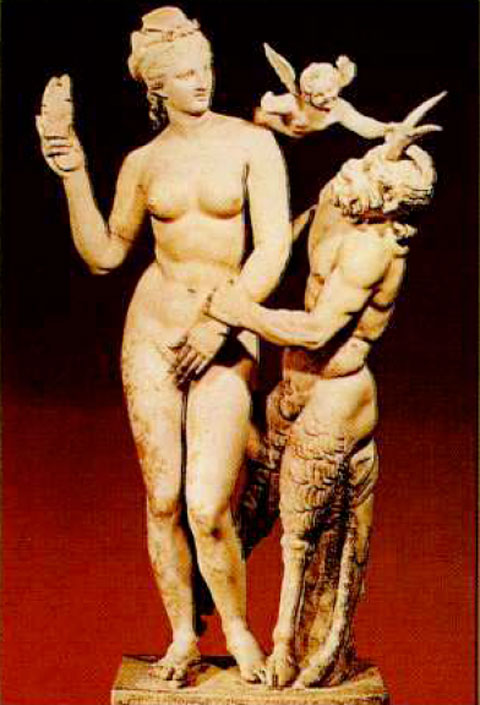 Στο σανδάλι, με το οποίο η Αφροδίτη φοβερίζει τον Σάτυρο, φαίνεται καθαρά η κατασκευή της σόλας με τα καρφιά.
Ο αρχαίος υποδηματοποιός επεξεργαζόταν τόσο τη σόλα (το κάττυμα), όσο και το επάνω μέρος του υποδήματος. Η ένωση των δύο μερών γινόταν με λωρίδες από νεύρα βοδιού, με προσήλωσιν (κάρφωμα) ή με δερμάτινα νήματα. Τρύπες για τους ιμάντες άνοιγαν με τα οπέατα. Το δέρμα συνήθως βαφόταν μαύρο, κόκκινο ή κίτρινο. Το τελειωμένο υπόδημα στιλβωνόταν με μούργα ελαιολάδου ή με ειδικό λίθο, τον αγήρατον. Διακοσμητικά σχέδια χαράσσονταν πάνω στο δέρμα με πυρακτωμένη ακίδα.
Οι βασικοί τύποι υποδημάτων είχαν ποικιλία παραλλαγών με εξίσου ποικίλα ονόματα, όπως: η εμβάς, το σάνδαλον, το σανδάλιον, η ενδρομίς, αι βαυκίδες, αι αρβύλαι, αι βασσάραι κ.ά.
Στο σανδάλι, με το οποίο η Αφροδίτη φοβερίζει τον Σάτυρο, φαίνεται καθαρά η κατασκευή της σόλας με τα καρφιά.
Ο αρχαίος υποδηματοποιός επεξεργαζόταν τόσο τη σόλα (το κάττυμα), όσο και το επάνω μέρος του υποδήματος. Η ένωση των δύο μερών γινόταν με λωρίδες από νεύρα βοδιού, με προσήλωσιν (κάρφωμα) ή με δερμάτινα νήματα. Τρύπες για τους ιμάντες άνοιγαν με τα οπέατα. Το δέρμα συνήθως βαφόταν μαύρο, κόκκινο ή κίτρινο. Το τελειωμένο υπόδημα στιλβωνόταν με μούργα ελαιολάδου ή με ειδικό λίθο, τον αγήρατον. Διακοσμητικά σχέδια χαράσσονταν πάνω στο δέρμα με πυρακτωμένη ακίδα.
Οι βασικοί τύποι υποδημάτων είχαν ποικιλία παραλλαγών με εξίσου ποικίλα ονόματα, όπως: η εμβάς, το σάνδαλον, το σανδάλιον, η ενδρομίς, αι βαυκίδες, αι αρβύλαι, αι βασσάραι κ.ά.
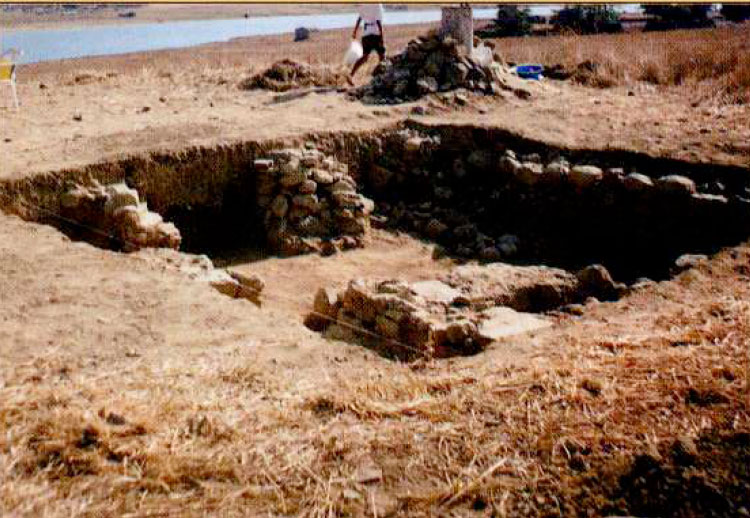 Όψη ανασκαφής.
Στο οικόπεδο όπου θα χτιζόταν ένα καινούριο σχολείο, τα σκαφτικά μηχανήματα χτύπησαν ξαφνικά σε κάτι σκληρό που έμοιαζε με τοίχο. Ο μηχανικός κάλεσε τους αρχαιολόγους κι αυτοί ξεκίνησαν τις ανασκαφές. Οι αρχαιολόγοι δουλεύουν πολύ συστηματικά. Ανοίγουν μεγάλους τετράγωνους λάκκους και βλέπουν στα τοιχώματά τους τα διαφορετικά στρώματα του εδάφους. Όσο βαθύτερο είναι ένα στρώμα τόσο αρχαιότερα είναι τα κατάλοιπα που περιέχει. Τα αντικείμενα που έρχονται στο φώς με τις ανασκαφές μας πληροφορούν για τις δραστηριότητες των ανθρώπων που κατοικούσαν εκεί και μας βοηθούν να τις χρονολογήσουμε.
Όψη ανασκαφής.
Στο οικόπεδο όπου θα χτιζόταν ένα καινούριο σχολείο, τα σκαφτικά μηχανήματα χτύπησαν ξαφνικά σε κάτι σκληρό που έμοιαζε με τοίχο. Ο μηχανικός κάλεσε τους αρχαιολόγους κι αυτοί ξεκίνησαν τις ανασκαφές. Οι αρχαιολόγοι δουλεύουν πολύ συστηματικά. Ανοίγουν μεγάλους τετράγωνους λάκκους και βλέπουν στα τοιχώματά τους τα διαφορετικά στρώματα του εδάφους. Όσο βαθύτερο είναι ένα στρώμα τόσο αρχαιότερα είναι τα κατάλοιπα που περιέχει. Τα αντικείμενα που έρχονται στο φώς με τις ανασκαφές μας πληροφορούν για τις δραστηριότητες των ανθρώπων που κατοικούσαν εκεί και μας βοηθούν να τις χρονολογήσουμε.
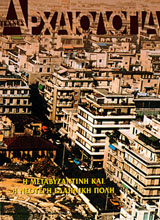
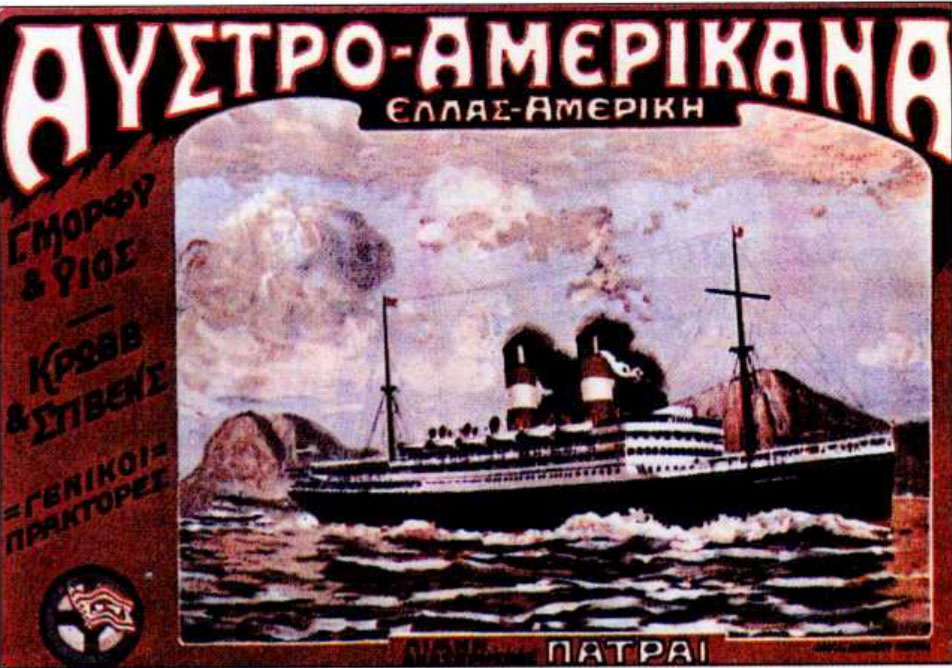 Υπερατλαντική μετανάστευση. Η Υπερωκεάνειος Αυστριακή Ατμοπλοϊκή Εταιρεία διέθετε πρακτορεία στην Τεργέστη, την Πάτρα και το Βελιγράδι.
Ως τυπική περίπτωση «φαινομένου αστικής ολοκλήρωσης» και ως ένα από τα πιο σημαντικά κομμάτια της συλλογικής μας ψυχής χαρακτηρίζει η συγγραφέας την αστική ανάπτυξη της περιόδου του μεσοπολέμου στην Ελλάδα. Κομβικό συμβάν αποτελεί η Μικρασιατική καταστροφή που έφερε στην Ελλάδα 1.300.000 πρόσφυγες. Η ένταξή τους έθιξε όλους τους τομείς ανάπτυξης της χώρας, συμπεριλαμβανομένου του τομέα των πολεοδομικών εξελίξεων.
Στην ημιπεριφέρεια, όπου κατατάσσεται και η Ελλάδα, η αστική ολοκλήρωση οφείλεται λιγότερο σε δυτικο-ευρωπαϊκού τύπου σύνθετα μοντέλα ανάπτυξης και περισσότερο ή και αποκλειστικά σε τοπικά φαινόμενα. Έτσι, στην πορεία της νεοελληνικής πόλης εξέχουσα σημασία έχει όχι μόνο η αγροτική έξοδος αλλά και ο ιδιαίτερος χαρακτήρας που πήρε, όπως, συνακόλουθα, ο ιδιόρρυθμος τρόπος σχηματισμού της αστικής εργατικής δύναμης. Στις παραμονές των βαλκανικών πολέμων, ο αγροτικός πληθυσμός αν και στρέφεται προς τις πόλεις, συγκρατείται παρόλα αυτά σε ισχυρά ποσοστά και στην ύπαιθρο. Ρόλο καταλύτη θα έχει η προσφυγική παρουσία καθώς χιλιάδες μικροί κλήροι θα μοιραστούν ενώ με πρωτοφανή τρόπο οι πόλεις θα πλημμυρίσουν από άστεγους και αναξιοπαθούντες.
Ενώ οι αγροτικοί οικισμοί που πραγματοποιήθηκαν ήταν μορφολογικά υπεραπλουστευμένοι δημιουργώντας χώρους αδιάφορους και μονότονους, οι γειτονιές στην πρωτεύουσα αλλά και στις επαρχιακές πόλεις αναπτύσσονται αυθόρμητα και δυναμικά, αποτελώντας μοναδικά ζωντανά κύτταρα. Οι αγρότες στρέφονται προς την υπερατλαντική μετανάστευση. Από τη μεριά τους, οι πρόσφυγες θα ενισχύσουν την αστική δυναμικότητα στο χώρο του καταμερισμού της εργασίας και θα καταφέρουν να μετασχηματίσουν ορισμένες συνοικίες μέσα στα αστικά κέντρα σε ολοκληρωμένους βιοτεχνικούς και βιομηχανικούς «οικισμούς», άγνωστους για τα μέτρα της εποχής.
Ο μεσοπόλεμος υπήρξε καθοριστικός για την ενίσχυση της ταξικής διαίρεσης και της περιθωριοποίησης μεγάλων ομάδων πληθυσμού στα αστικά κέντρα και ιδίως στην πρωτεύουσα. Το πολυάριθμο προσφυγικό στοιχείο, αποτελώντας μια διαστρωματωμένη κοινωνία, εμπλούτισε «ταξικά» την κοινωνία υποδοχής, ενέτεινε τον υπάρχοντα καταμερισμό εργασίας και ενδυνάμωσε όλες τις γηγενείς κοινωνικές τάξεις: από τους καπνεργάτες της Καβάλας, τους αγρότες του θεσσαλικού κάμπου και την εργατιά της Κοκκινιάς έως τους κατοπινούς εμπόρους και επιχειρηματίες της πρωτεύουσας.
Τα δεδομένα αυτής της περιόδου του μεσοπολέμου καθρεφτίζονται σε κάποιο τμήμα της ζωντανής πολεοδομικής ιστορίας των ελληνικών πόλεων. Την πρωτοπορία στους μετασχηματισμούς κρατάει η Αθήνα. Η οικοδομική αναβαθμίζεται στα κτίσματα της εύπορης τάξης, ο ελληνικός νεοκλασικισμός συνδιαλέγεται με τον εκλεκτικισμό και τις νέες ευρωπαϊκές τάσεις. Δημιουργείται η Αρχιτεκτονική Σχολή του Εθνικού Μετσόβιου Πολυτεχνείου. Το ρεύμα του κοινωνισμού, τα μηνύματα του Bauhaus και της «ευτυχισμένης πόλης» θα αποκτήσουν την ελληνική εκδοχή τους. Το κυριότερο: με καινοτόμες πολεοδομικές ενέργειες και οικιστικά μέτρα, και με αλλεπάλληλες νομοθετικές ρυθμίσεις αρχιτεκτονικού και κτηριοδομικού περιεχομένου, τίθενται τα πλαίσια ανάπτυξης των λειτουργιών και της μορφής της σύγχρονης πόλης.
Από την άλλη μεριά, οι ασφυκτικές πιέσεις των νεοφερμένων πληθυσμών ωθούν τις πόλεις προς την επέκτασή τους που διασφαλίζεται μέσω ή ερήμην Ρυθμιστικών Σχεδίων ενώ παράλληλα τίθενται οι βάσεις της άναρχης, ανεξέλεγκτης ανάπτυξης. Η αυθαίρετη δόμηση ξεκινά, και αυτή, από την περίοδο τούτη. Οι πόλεις αποκτούν την ικανότητα να στεγάζουν πολυπληθείς κοινωνικές κατηγορίες διαφορετικών εισοδηματικών επιπέδων: η αστική «πολυ-κατοικία» που εμφανίζεται στην Αθήνα συμβαδίζει με την «κοινωνική κατοικία» για χαμηλές εισοδηματικές τάξεις. Σταδιακά η κρατική παρέμβαση σε όλους τους τομείς παραγωγής κτισμένου περιβάλλοντος και κατοικίας παραχωρεί τη θέση της στην ιδιωτική πρωτοβουλία. Η αντιληπτική οργάνωση της πόλης θα ακολουθήσει αντίστοιχη πορεία.
Υπερατλαντική μετανάστευση. Η Υπερωκεάνειος Αυστριακή Ατμοπλοϊκή Εταιρεία διέθετε πρακτορεία στην Τεργέστη, την Πάτρα και το Βελιγράδι.
Ως τυπική περίπτωση «φαινομένου αστικής ολοκλήρωσης» και ως ένα από τα πιο σημαντικά κομμάτια της συλλογικής μας ψυχής χαρακτηρίζει η συγγραφέας την αστική ανάπτυξη της περιόδου του μεσοπολέμου στην Ελλάδα. Κομβικό συμβάν αποτελεί η Μικρασιατική καταστροφή που έφερε στην Ελλάδα 1.300.000 πρόσφυγες. Η ένταξή τους έθιξε όλους τους τομείς ανάπτυξης της χώρας, συμπεριλαμβανομένου του τομέα των πολεοδομικών εξελίξεων.
Στην ημιπεριφέρεια, όπου κατατάσσεται και η Ελλάδα, η αστική ολοκλήρωση οφείλεται λιγότερο σε δυτικο-ευρωπαϊκού τύπου σύνθετα μοντέλα ανάπτυξης και περισσότερο ή και αποκλειστικά σε τοπικά φαινόμενα. Έτσι, στην πορεία της νεοελληνικής πόλης εξέχουσα σημασία έχει όχι μόνο η αγροτική έξοδος αλλά και ο ιδιαίτερος χαρακτήρας που πήρε, όπως, συνακόλουθα, ο ιδιόρρυθμος τρόπος σχηματισμού της αστικής εργατικής δύναμης. Στις παραμονές των βαλκανικών πολέμων, ο αγροτικός πληθυσμός αν και στρέφεται προς τις πόλεις, συγκρατείται παρόλα αυτά σε ισχυρά ποσοστά και στην ύπαιθρο. Ρόλο καταλύτη θα έχει η προσφυγική παρουσία καθώς χιλιάδες μικροί κλήροι θα μοιραστούν ενώ με πρωτοφανή τρόπο οι πόλεις θα πλημμυρίσουν από άστεγους και αναξιοπαθούντες.
Ενώ οι αγροτικοί οικισμοί που πραγματοποιήθηκαν ήταν μορφολογικά υπεραπλουστευμένοι δημιουργώντας χώρους αδιάφορους και μονότονους, οι γειτονιές στην πρωτεύουσα αλλά και στις επαρχιακές πόλεις αναπτύσσονται αυθόρμητα και δυναμικά, αποτελώντας μοναδικά ζωντανά κύτταρα. Οι αγρότες στρέφονται προς την υπερατλαντική μετανάστευση. Από τη μεριά τους, οι πρόσφυγες θα ενισχύσουν την αστική δυναμικότητα στο χώρο του καταμερισμού της εργασίας και θα καταφέρουν να μετασχηματίσουν ορισμένες συνοικίες μέσα στα αστικά κέντρα σε ολοκληρωμένους βιοτεχνικούς και βιομηχανικούς «οικισμούς», άγνωστους για τα μέτρα της εποχής.
Ο μεσοπόλεμος υπήρξε καθοριστικός για την ενίσχυση της ταξικής διαίρεσης και της περιθωριοποίησης μεγάλων ομάδων πληθυσμού στα αστικά κέντρα και ιδίως στην πρωτεύουσα. Το πολυάριθμο προσφυγικό στοιχείο, αποτελώντας μια διαστρωματωμένη κοινωνία, εμπλούτισε «ταξικά» την κοινωνία υποδοχής, ενέτεινε τον υπάρχοντα καταμερισμό εργασίας και ενδυνάμωσε όλες τις γηγενείς κοινωνικές τάξεις: από τους καπνεργάτες της Καβάλας, τους αγρότες του θεσσαλικού κάμπου και την εργατιά της Κοκκινιάς έως τους κατοπινούς εμπόρους και επιχειρηματίες της πρωτεύουσας.
Τα δεδομένα αυτής της περιόδου του μεσοπολέμου καθρεφτίζονται σε κάποιο τμήμα της ζωντανής πολεοδομικής ιστορίας των ελληνικών πόλεων. Την πρωτοπορία στους μετασχηματισμούς κρατάει η Αθήνα. Η οικοδομική αναβαθμίζεται στα κτίσματα της εύπορης τάξης, ο ελληνικός νεοκλασικισμός συνδιαλέγεται με τον εκλεκτικισμό και τις νέες ευρωπαϊκές τάσεις. Δημιουργείται η Αρχιτεκτονική Σχολή του Εθνικού Μετσόβιου Πολυτεχνείου. Το ρεύμα του κοινωνισμού, τα μηνύματα του Bauhaus και της «ευτυχισμένης πόλης» θα αποκτήσουν την ελληνική εκδοχή τους. Το κυριότερο: με καινοτόμες πολεοδομικές ενέργειες και οικιστικά μέτρα, και με αλλεπάλληλες νομοθετικές ρυθμίσεις αρχιτεκτονικού και κτηριοδομικού περιεχομένου, τίθενται τα πλαίσια ανάπτυξης των λειτουργιών και της μορφής της σύγχρονης πόλης.
Από την άλλη μεριά, οι ασφυκτικές πιέσεις των νεοφερμένων πληθυσμών ωθούν τις πόλεις προς την επέκτασή τους που διασφαλίζεται μέσω ή ερήμην Ρυθμιστικών Σχεδίων ενώ παράλληλα τίθενται οι βάσεις της άναρχης, ανεξέλεγκτης ανάπτυξης. Η αυθαίρετη δόμηση ξεκινά, και αυτή, από την περίοδο τούτη. Οι πόλεις αποκτούν την ικανότητα να στεγάζουν πολυπληθείς κοινωνικές κατηγορίες διαφορετικών εισοδηματικών επιπέδων: η αστική «πολυ-κατοικία» που εμφανίζεται στην Αθήνα συμβαδίζει με την «κοινωνική κατοικία» για χαμηλές εισοδηματικές τάξεις. Σταδιακά η κρατική παρέμβαση σε όλους τους τομείς παραγωγής κτισμένου περιβάλλοντος και κατοικίας παραχωρεί τη θέση της στην ιδιωτική πρωτοβουλία. Η αντιληπτική οργάνωση της πόλης θα ακολουθήσει αντίστοιχη πορεία.
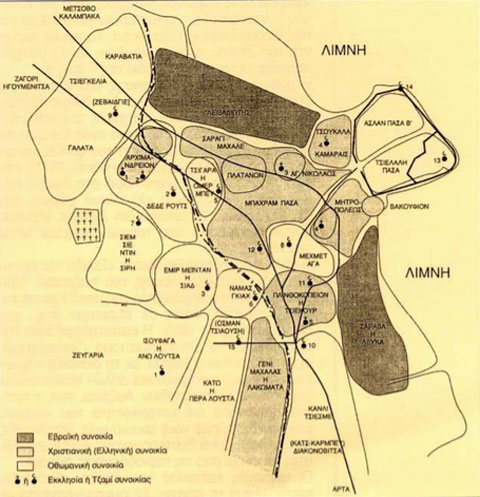 Τύπος «πόλης-παζαριού»: Γιάννενα στο β’ μισό του 19ου αιώνα
Η νεοελληνική πόλη του μεσοπολέμου.
Κατά τη διάρκεια του 18ου και του 19ου αιώνα το οικιστικό δίκτυο του ελληνικού χώρου εμφανίζει δυο περιόδους ανάπτυξης, με σημείο τομής την ίδρυση του εθνικού κράτους (1827). Από τον ενιαίο και υπόδουλο ελληνικό χώρο της πρώτης περιόδου ξεχωρίζουν οι μονογραφικές περιγραφές οικισμών, αποτέλεσμα της οικονομικής ανάπτυξης του ορεινού χώρου στα χρόνια 1774-1821. Στη δεύτερη περίοδο (1821/1827-1913), που αποτελείται από δύο επιμέρους ενότητες, ο ελληνικός χώρος μετατρέπεται σε μη ενιαίο οικιστικά. Στην πρώτη ενότητα αντιστοιχούν τα ιστορικά οικιστικά κέντρα της Βόρειας Ελλάδας που ακολουθούν τη βαλκανική διαμόρφωση και δεν είναι σχεδιασμένα από ειδικούς. Στη δεύτερη ενότητα διακρίνουμε το οικιστικό δίκτυο που αντιστοιχεί στο νότιο και ελεύθερο τμήμα της Ελλάδας, το οποίο έχει υπόσταση κράτους. Οι οικισμοί είναι κατά κανόνα καινούργιοι και σχεδιασμένοι από ειδικούς μηχανικούς κατά το νεοκλασικό πρότυπο.
Κατά το τέλος της περιόδου του ενιαίου οικιστικού χώρου (1774-1821/1827), η οικονομική δραστηριότητα στον ελληνικό χώρο συγκεντρώνεται: 1. Στα ορεινά βιοτεχνικά κέντρα διαμερισμάτων, όπως στη Μακεδονία, στην Ήπειρο και στη Θεσσαλία. 2. Στις πλουσιότερες σταφιδοπαραγωγικές πεδινές περιοχές, όπου αναπτύσσεται και ο καινοτόμος μεταπρατικός αγροτικός χώρος, κυρίως της σταφίδας. 3. Στα ναυτικά νησιά, κυρίως Ύδρα, Σπέτσες, Ψαρά, αλλά και Μύκονο, Πόρο, Κάσο, Σύμη, Σκόπελο, που αποκτούν, κάτω από τις διεθνείς συγκυρίες, εμπορικούς στόλους και συμμετέχουν στις διεθνείς μεταφορές.
Κατά την περίοδο του μη ενιαίου οικιστικού χώρου, οι πόλεις του βόρειου ελληνικού χώρου έχουν ιστορικά διαμορφώσει έναν ιδιότυπο χαρακτήρα «αστικής ζωής», όπου κυριαρχεί η πολυεθνική/πολυπολιτισμική σύνθεση του πληθυσμού. Η κοινωνική κυριαρχία κάποιας από αυτές τις ομάδες προβάλλεται στον κεντρικό χώρο της πόλης. Η περιοχή αυτή χαρακτηρίζεται αρχικά από το μοντέλο της «πόλης-παζαριού», που κυριαρχείται από την οθωμανική κουλτούρα. Από το τρίτο τέταρτο του 19ου αιώνα εμφανίζεται το μοντέλο της «πόλης-πρακτορείου», που οφείλεται στην επικράτηση της χριστιανικής κυρίως κουλτούρας. Παράλληλα εμφανίζονται και άλλα μοντέλα οικισμών, όπως η «πόλη-λιμάνι» της Θεσσαλονίκης.
Στο νεοσύστατο εθνικό κράτος ευρωπαϊκού τύπου αντιμετωπίζονται προνομιακά ο κεντρικός σχεδιασμός και η διευθέτηση της πόλης. Η Αθήνα καθορίζεται ως ο μοναδικός πόλος της πολιτικής και οικονομικής εξουσίας. Στην πρώτη υπο-φάση (1821-1880) της περιόδου των σχεδιασμένων πόλεων στο νότιο ελληνικό οικιστικό χώρο η αστικοποίηση είναι περιορισμένη. Έως το 1845 σχεδιάζονται όλα τα σημαντικά κέντρα του τότε ελληνικού κράτους με νεοκλασικά πολεοδομικά σχέδια, δίνοντας προτεραιότητα (α) στα τοπικά λιμάνια και (β) στους σημαντικούς οικισμούς μέσα στη διοικητική ιεραρχία (π.χ. Κόρινθος, Πάτρα, Ερέτρια, Σπάρτη, Ναύπακτος κ.ά.) ενώ έως το 1879 αποκτούν σχέδιο 93 οικισμοί (με 500 έως 25000 κατοίκους). Στην δεύτερη υπο-φάση (1880-1907/13) η χωρική πόλωση αυξάνεται. Στη διάρκεια του 19ου αιώνα ανακαινίζονται οι οικισμοί του νότιου ελληνικού χώρου και καλύπτονται παράλληλα οι ανάγκες στέγασης των πληθυσμών σε κατεστραμμένους από τις πολεμικές συγκρούσεις οικισμούς. Έως το 1912, 174 οικισμοί με 500 έως 20.000 κατοίκους αποκτούν νέο σχέδιο. Η ομογενοποίηση του αστικού χώρου σύμφωνα με τις νεοκλασικές αρχές σχεδιασμού αποτελεί μια κεντρική διχοτομία με τα υπόλοιπα αστικά κέντρα του βόρειου ελληνικού χώρου, που την ίδια εποχή αναπτύσσονται κατά το πρότυπο της βαλκανικής πόλης. Προς το τέλος του αιώνα, στο πλαίσιο της εσωτερικής ανασυγκρότησης, η βιομηχανική πόλη θα θέσει κοινούς προβληματισμούς, ανάλογους με αυτούς που εμφανίζονται στα άλλα νέα εθνικά βαλκανικά κράτη.
Τύπος «πόλης-παζαριού»: Γιάννενα στο β’ μισό του 19ου αιώνα
Η νεοελληνική πόλη του μεσοπολέμου.
Κατά τη διάρκεια του 18ου και του 19ου αιώνα το οικιστικό δίκτυο του ελληνικού χώρου εμφανίζει δυο περιόδους ανάπτυξης, με σημείο τομής την ίδρυση του εθνικού κράτους (1827). Από τον ενιαίο και υπόδουλο ελληνικό χώρο της πρώτης περιόδου ξεχωρίζουν οι μονογραφικές περιγραφές οικισμών, αποτέλεσμα της οικονομικής ανάπτυξης του ορεινού χώρου στα χρόνια 1774-1821. Στη δεύτερη περίοδο (1821/1827-1913), που αποτελείται από δύο επιμέρους ενότητες, ο ελληνικός χώρος μετατρέπεται σε μη ενιαίο οικιστικά. Στην πρώτη ενότητα αντιστοιχούν τα ιστορικά οικιστικά κέντρα της Βόρειας Ελλάδας που ακολουθούν τη βαλκανική διαμόρφωση και δεν είναι σχεδιασμένα από ειδικούς. Στη δεύτερη ενότητα διακρίνουμε το οικιστικό δίκτυο που αντιστοιχεί στο νότιο και ελεύθερο τμήμα της Ελλάδας, το οποίο έχει υπόσταση κράτους. Οι οικισμοί είναι κατά κανόνα καινούργιοι και σχεδιασμένοι από ειδικούς μηχανικούς κατά το νεοκλασικό πρότυπο.
Κατά το τέλος της περιόδου του ενιαίου οικιστικού χώρου (1774-1821/1827), η οικονομική δραστηριότητα στον ελληνικό χώρο συγκεντρώνεται: 1. Στα ορεινά βιοτεχνικά κέντρα διαμερισμάτων, όπως στη Μακεδονία, στην Ήπειρο και στη Θεσσαλία. 2. Στις πλουσιότερες σταφιδοπαραγωγικές πεδινές περιοχές, όπου αναπτύσσεται και ο καινοτόμος μεταπρατικός αγροτικός χώρος, κυρίως της σταφίδας. 3. Στα ναυτικά νησιά, κυρίως Ύδρα, Σπέτσες, Ψαρά, αλλά και Μύκονο, Πόρο, Κάσο, Σύμη, Σκόπελο, που αποκτούν, κάτω από τις διεθνείς συγκυρίες, εμπορικούς στόλους και συμμετέχουν στις διεθνείς μεταφορές.
Κατά την περίοδο του μη ενιαίου οικιστικού χώρου, οι πόλεις του βόρειου ελληνικού χώρου έχουν ιστορικά διαμορφώσει έναν ιδιότυπο χαρακτήρα «αστικής ζωής», όπου κυριαρχεί η πολυεθνική/πολυπολιτισμική σύνθεση του πληθυσμού. Η κοινωνική κυριαρχία κάποιας από αυτές τις ομάδες προβάλλεται στον κεντρικό χώρο της πόλης. Η περιοχή αυτή χαρακτηρίζεται αρχικά από το μοντέλο της «πόλης-παζαριού», που κυριαρχείται από την οθωμανική κουλτούρα. Από το τρίτο τέταρτο του 19ου αιώνα εμφανίζεται το μοντέλο της «πόλης-πρακτορείου», που οφείλεται στην επικράτηση της χριστιανικής κυρίως κουλτούρας. Παράλληλα εμφανίζονται και άλλα μοντέλα οικισμών, όπως η «πόλη-λιμάνι» της Θεσσαλονίκης.
Στο νεοσύστατο εθνικό κράτος ευρωπαϊκού τύπου αντιμετωπίζονται προνομιακά ο κεντρικός σχεδιασμός και η διευθέτηση της πόλης. Η Αθήνα καθορίζεται ως ο μοναδικός πόλος της πολιτικής και οικονομικής εξουσίας. Στην πρώτη υπο-φάση (1821-1880) της περιόδου των σχεδιασμένων πόλεων στο νότιο ελληνικό οικιστικό χώρο η αστικοποίηση είναι περιορισμένη. Έως το 1845 σχεδιάζονται όλα τα σημαντικά κέντρα του τότε ελληνικού κράτους με νεοκλασικά πολεοδομικά σχέδια, δίνοντας προτεραιότητα (α) στα τοπικά λιμάνια και (β) στους σημαντικούς οικισμούς μέσα στη διοικητική ιεραρχία (π.χ. Κόρινθος, Πάτρα, Ερέτρια, Σπάρτη, Ναύπακτος κ.ά.) ενώ έως το 1879 αποκτούν σχέδιο 93 οικισμοί (με 500 έως 25000 κατοίκους). Στην δεύτερη υπο-φάση (1880-1907/13) η χωρική πόλωση αυξάνεται. Στη διάρκεια του 19ου αιώνα ανακαινίζονται οι οικισμοί του νότιου ελληνικού χώρου και καλύπτονται παράλληλα οι ανάγκες στέγασης των πληθυσμών σε κατεστραμμένους από τις πολεμικές συγκρούσεις οικισμούς. Έως το 1912, 174 οικισμοί με 500 έως 20.000 κατοίκους αποκτούν νέο σχέδιο. Η ομογενοποίηση του αστικού χώρου σύμφωνα με τις νεοκλασικές αρχές σχεδιασμού αποτελεί μια κεντρική διχοτομία με τα υπόλοιπα αστικά κέντρα του βόρειου ελληνικού χώρου, που την ίδια εποχή αναπτύσσονται κατά το πρότυπο της βαλκανικής πόλης. Προς το τέλος του αιώνα, στο πλαίσιο της εσωτερικής ανασυγκρότησης, η βιομηχανική πόλη θα θέσει κοινούς προβληματισμούς, ανάλογους με αυτούς που εμφανίζονται στα άλλα νέα εθνικά βαλκανικά κράτη.
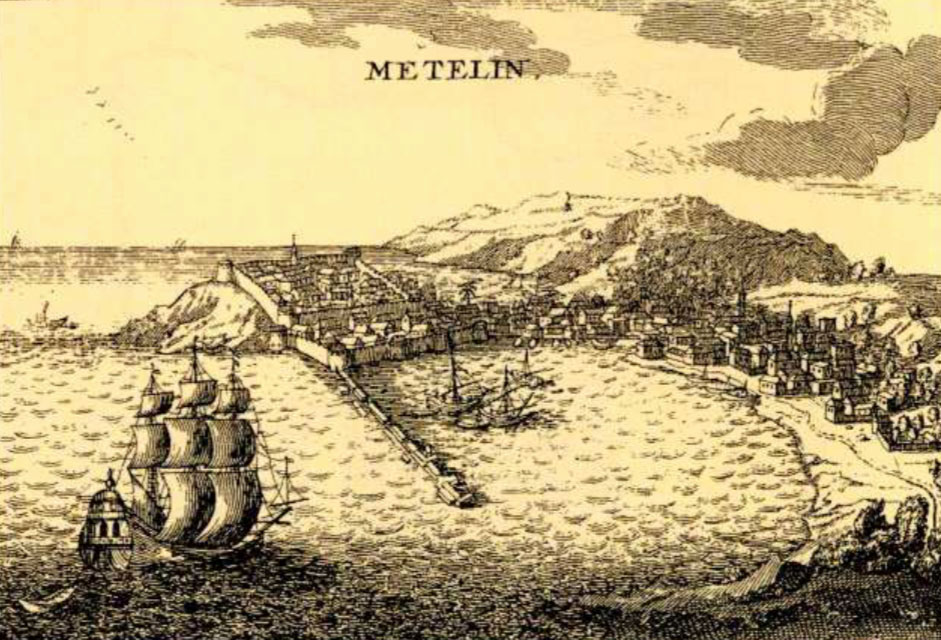 Άποψη της Μυτιλήνης, γύρω στο 1700. Χαλκογραφία, Γεννάδειος Βιβλιοθήκη.
Το άρθρο αναφέρεται στους δύο πρώτους αιώνες της οθωμανικής κατοχής και περιορίζεται στις περιπτώσεις οικισμών για τους οποίους υπάρχει κάλυψη από ασφαλείς πηγές έρευνας, όπως είναι οι αρχειακές οθωμανικές πηγές. Έμφαση δίνεται σε τομείς της κοινωνικής και οικονομικής ιστορίας.
Σε συνθήκες που κατά τον πρώτο αιώνα της οθωμανικής κατοχής ευνοούσαν την ανάπτυξη της αγροτικής οικονομίας, στα περισσότερα χωριά ο πληθυσμός υπερδιπλασιάστηκε. Στην αγροτική ενδοχώρα, τα πληθυσμιακά μεγέθη και οι μεταβολές τους στο χρόνο προσδιορίζονταν από πολλούς παράγοντες, με σπουδαιότερους όσους αφορούσαν το παραγωγικό δυναμικό της κάθε περιοχής και τις μετακινήσεις πληθυσμών από μια περιοχή σε άλλη.
Τα θετικά μεγέθη πληθυσμιακών μεταβολών στις πόλεις από τα μέσα του 15ου έως τα μέσα του 16ου αιώνα, οφείλουν να συνεξεταστούν με τα στοιχεία της υπαίθρου. Ιδιαίτερη σημασία έχουν οι παράγοντες μηχανικής αύξησης του πληθυσμού, όπως είναι οι συνθήκες καταμερισμού εργασίας πόλης-υπαίθρου. Παράλληλα, με την πρακτική μετακινήσεων πληθυσμού και σε συνδυασμό με στοιχεία διοίκησης-φορολογίας, διασφαλίζονταν και η οικονομία και ο πληθυσμός της υπαίθρου. Η διερεύνηση των στοιχείων για την παραγωγική δραστηριότητα και την άσκηση επαγγελμάτων στις πόλεις, ιδίως μέσα από το πλαίσιο των εθνικο-θρησκευτικών κατηγοριών του πληθυσμού, αναιρεί παλαιότερες απόψεις της ελληνικής ιστοριογραφίας, όπως εκείνη που υποστήριζε ότι ο γηγενής χριστιανικός πληθυσμός των πόλεων «πήρε τα βουνά» μετά την οθωμανική επικράτηση.
Στο πλαίσιο των αναπτυξιακών ωθήσεων που γνώρισαν οι πόλεις και τα χωριά στην πρώιμη τουρκοκρατία, ο κτισμένος χώρος της όψιμης Βυζαντινής και Φράγκικης περιόδου ανασυντάχθηκε και οργανώθηκε σε διαφορετική βάση. Τα παλαιά μεσαιωνικά τείχη προσδιόριζαν κατά κανόνα την τριπλή διαίρεση των πόλεων σε Κάστρο/Χώρα/Εξέχωρο. Σε πολλές περιπτώσεις σταδιακά τα τείχη γκρεμίστηκαν και οι πόλεις επεκτάθηκαν σημαντικά στην περιοχή του Εξέχωρου. Στις μεγαλύτερες πόλεις η εικόνα και η φυσιογνωμία του κτισμένου χώρου μεταβλήθηκε ριζικά με την ανέγερση των νέων κτιρίων, όπως τα τζαμιά, τα χαμάμ, οι μεντρεσέδες, τα μπεζεστένια, τα χάνια κ.ά. Πάντως αυτός ο νέος χαρακτήρας στις πόλεις δεν υποδεικνύει μια, δήθεν, διαδικασία ισλαμοποίησης των πρώην βυζαντινών κέντρων.
Για την ανάπτυξη των πόλεων, μια συνολική δέσμη μέτρων έλεγχε και κατεύθυνε την πολεοδομική εξέλιξη. Οι μαχαλάδες, που διαφοροποιούνταν σαφέστατα κατά εθνικο-θρησκευτικές κατηγορίες πληθυσμού, συνιστούσαν το «μοναδιαίο» στοιχείο πολεοδομικής συγκρότησης, το οποίο είχε ένα κέντρο αναφοράς μια εκκλησία ή ένα τζαμί. Το κέντρο της πόλης αποτελεί μια διακεκριμένη ενότητα με δημόσια κτίρια, εργαστήρια και καταστήματα, από την οποία απουσιάζει η κατοικία. Το δίκτυο των δρόμων που συνδέει το κέντρο της πόλης με την αγροτική της ενδοχώρα υπακούει σε μια ιεραρχία κινήσεων. Η μέση πυκνότητα στις πόλεις δεν ξεπερνούσε συνήθως τα 80 άτομα/εκτάριο. Οι αξίες της γης ήταν συνάρτηση του ανταγωνισμού για την κατάληψη των θέσεων με κύρος που βρίσκονταν στο εμπορικό-διοικητικό κέντρο της πόλης, την αγορά. Η πληθώρα των κτιρίων που αναφέρονταν σε θρησκευτικές και κοσμικές-διοικητικές λειτουργίες όριζαν μια ισχυρή πολεοδομική ενότητα, το bazaar, της οποίας μέρος μόνο συνιστούσε η οικονομική λειτουργία της αγοράς. Η ύπαρξη τρουλοσκέπαστων αγορών σε πόλεις όπως η Λάρισα και η Θεσσαλονίκη ήταν ευθέως συναρτημένη με το ρόλο των πόλεων αυτών ως κέντρων διαμετακομιστικού εμπορίου.
Άποψη της Μυτιλήνης, γύρω στο 1700. Χαλκογραφία, Γεννάδειος Βιβλιοθήκη.
Το άρθρο αναφέρεται στους δύο πρώτους αιώνες της οθωμανικής κατοχής και περιορίζεται στις περιπτώσεις οικισμών για τους οποίους υπάρχει κάλυψη από ασφαλείς πηγές έρευνας, όπως είναι οι αρχειακές οθωμανικές πηγές. Έμφαση δίνεται σε τομείς της κοινωνικής και οικονομικής ιστορίας.
Σε συνθήκες που κατά τον πρώτο αιώνα της οθωμανικής κατοχής ευνοούσαν την ανάπτυξη της αγροτικής οικονομίας, στα περισσότερα χωριά ο πληθυσμός υπερδιπλασιάστηκε. Στην αγροτική ενδοχώρα, τα πληθυσμιακά μεγέθη και οι μεταβολές τους στο χρόνο προσδιορίζονταν από πολλούς παράγοντες, με σπουδαιότερους όσους αφορούσαν το παραγωγικό δυναμικό της κάθε περιοχής και τις μετακινήσεις πληθυσμών από μια περιοχή σε άλλη.
Τα θετικά μεγέθη πληθυσμιακών μεταβολών στις πόλεις από τα μέσα του 15ου έως τα μέσα του 16ου αιώνα, οφείλουν να συνεξεταστούν με τα στοιχεία της υπαίθρου. Ιδιαίτερη σημασία έχουν οι παράγοντες μηχανικής αύξησης του πληθυσμού, όπως είναι οι συνθήκες καταμερισμού εργασίας πόλης-υπαίθρου. Παράλληλα, με την πρακτική μετακινήσεων πληθυσμού και σε συνδυασμό με στοιχεία διοίκησης-φορολογίας, διασφαλίζονταν και η οικονομία και ο πληθυσμός της υπαίθρου. Η διερεύνηση των στοιχείων για την παραγωγική δραστηριότητα και την άσκηση επαγγελμάτων στις πόλεις, ιδίως μέσα από το πλαίσιο των εθνικο-θρησκευτικών κατηγοριών του πληθυσμού, αναιρεί παλαιότερες απόψεις της ελληνικής ιστοριογραφίας, όπως εκείνη που υποστήριζε ότι ο γηγενής χριστιανικός πληθυσμός των πόλεων «πήρε τα βουνά» μετά την οθωμανική επικράτηση.
Στο πλαίσιο των αναπτυξιακών ωθήσεων που γνώρισαν οι πόλεις και τα χωριά στην πρώιμη τουρκοκρατία, ο κτισμένος χώρος της όψιμης Βυζαντινής και Φράγκικης περιόδου ανασυντάχθηκε και οργανώθηκε σε διαφορετική βάση. Τα παλαιά μεσαιωνικά τείχη προσδιόριζαν κατά κανόνα την τριπλή διαίρεση των πόλεων σε Κάστρο/Χώρα/Εξέχωρο. Σε πολλές περιπτώσεις σταδιακά τα τείχη γκρεμίστηκαν και οι πόλεις επεκτάθηκαν σημαντικά στην περιοχή του Εξέχωρου. Στις μεγαλύτερες πόλεις η εικόνα και η φυσιογνωμία του κτισμένου χώρου μεταβλήθηκε ριζικά με την ανέγερση των νέων κτιρίων, όπως τα τζαμιά, τα χαμάμ, οι μεντρεσέδες, τα μπεζεστένια, τα χάνια κ.ά. Πάντως αυτός ο νέος χαρακτήρας στις πόλεις δεν υποδεικνύει μια, δήθεν, διαδικασία ισλαμοποίησης των πρώην βυζαντινών κέντρων.
Για την ανάπτυξη των πόλεων, μια συνολική δέσμη μέτρων έλεγχε και κατεύθυνε την πολεοδομική εξέλιξη. Οι μαχαλάδες, που διαφοροποιούνταν σαφέστατα κατά εθνικο-θρησκευτικές κατηγορίες πληθυσμού, συνιστούσαν το «μοναδιαίο» στοιχείο πολεοδομικής συγκρότησης, το οποίο είχε ένα κέντρο αναφοράς μια εκκλησία ή ένα τζαμί. Το κέντρο της πόλης αποτελεί μια διακεκριμένη ενότητα με δημόσια κτίρια, εργαστήρια και καταστήματα, από την οποία απουσιάζει η κατοικία. Το δίκτυο των δρόμων που συνδέει το κέντρο της πόλης με την αγροτική της ενδοχώρα υπακούει σε μια ιεραρχία κινήσεων. Η μέση πυκνότητα στις πόλεις δεν ξεπερνούσε συνήθως τα 80 άτομα/εκτάριο. Οι αξίες της γης ήταν συνάρτηση του ανταγωνισμού για την κατάληψη των θέσεων με κύρος που βρίσκονταν στο εμπορικό-διοικητικό κέντρο της πόλης, την αγορά. Η πληθώρα των κτιρίων που αναφέρονταν σε θρησκευτικές και κοσμικές-διοικητικές λειτουργίες όριζαν μια ισχυρή πολεοδομική ενότητα, το bazaar, της οποίας μέρος μόνο συνιστούσε η οικονομική λειτουργία της αγοράς. Η ύπαρξη τρουλοσκέπαστων αγορών σε πόλεις όπως η Λάρισα και η Θεσσαλονίκη ήταν ευθέως συναρτημένη με το ρόλο των πόλεων αυτών ως κέντρων διαμετακομιστικού εμπορίου.
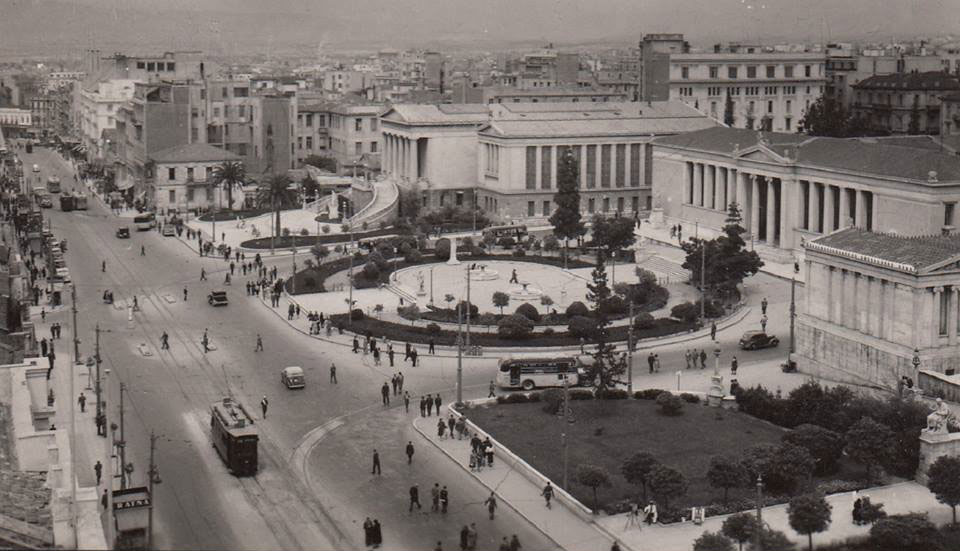 Αθήνα, οδός Πανεπιστημίου.
Πρόκειται για το τέταρτο και τελευταίο τεύχος του αφιερώματος για την πόλη στην Ελλάδα, στο οποίο καταγράφηκε –ίσως για πρώτη φορά- η μακραίωνη πορεία της ελληνικής πόλης. Στόχοι του περιοδικού και του συντονιστή του αφιερώματος Α.-Φ. Λαγόπουλου ήταν: α) η διαχρονική παρακολούθηση της εξέλιξης της διάρθρωσης της πόλης στην Ελλάδα, β) ο όσο το δυνατόν μεγαλύτερος συντονισμός ανάμεσα σε επιστήμονες με διαφορετικό υπόβαθρο και διαφορετικές προσεγγίσεις στο θέμα, γ) η ένταξη της ανάλυσης της μορφής και της διάρθρωσης της πόλης μέσα σε πολυποίκιλα ευρύτερα πλαίσια και δ) η πρόσκληση επιστημόνων με αναγνωρισμένη πείρα και προσφορά στη γνώση των περιόδων που μελετήθηκαν. Στο παρόν τεύχος, Δ. Ν. Καρύδης και Ν. Κ. Μουτσόπουλος γράφουν για την περίοδο της πρώιμης τουρκοκρατίας, ενώ στην όψιμη τουρκοκρατία στρέφει την προσοχή μας ο Ε. Π. Δημητριάδης. Την ελληνική πολεοδομία στον 19ο αιώνα εξετάζει ο Π. Τσακόπουλος. Στον Μεσοπόλεμο μας μεταφέρουν η Β. Δ. Γκιζελή και ο Μ. Γ. Μπίρης. Ο Π. Λουκάκης κλείνει το αφιέρωμα με μια συζήτηση για τις τάσεις μεταλλαγών στη χωρική διάχυση της αστικοποίησης.
Αθήνα, οδός Πανεπιστημίου.
Πρόκειται για το τέταρτο και τελευταίο τεύχος του αφιερώματος για την πόλη στην Ελλάδα, στο οποίο καταγράφηκε –ίσως για πρώτη φορά- η μακραίωνη πορεία της ελληνικής πόλης. Στόχοι του περιοδικού και του συντονιστή του αφιερώματος Α.-Φ. Λαγόπουλου ήταν: α) η διαχρονική παρακολούθηση της εξέλιξης της διάρθρωσης της πόλης στην Ελλάδα, β) ο όσο το δυνατόν μεγαλύτερος συντονισμός ανάμεσα σε επιστήμονες με διαφορετικό υπόβαθρο και διαφορετικές προσεγγίσεις στο θέμα, γ) η ένταξη της ανάλυσης της μορφής και της διάρθρωσης της πόλης μέσα σε πολυποίκιλα ευρύτερα πλαίσια και δ) η πρόσκληση επιστημόνων με αναγνωρισμένη πείρα και προσφορά στη γνώση των περιόδων που μελετήθηκαν. Στο παρόν τεύχος, Δ. Ν. Καρύδης και Ν. Κ. Μουτσόπουλος γράφουν για την περίοδο της πρώιμης τουρκοκρατίας, ενώ στην όψιμη τουρκοκρατία στρέφει την προσοχή μας ο Ε. Π. Δημητριάδης. Την ελληνική πολεοδομία στον 19ο αιώνα εξετάζει ο Π. Τσακόπουλος. Στον Μεσοπόλεμο μας μεταφέρουν η Β. Δ. Γκιζελή και ο Μ. Γ. Μπίρης. Ο Π. Λουκάκης κλείνει το αφιέρωμα με μια συζήτηση για τις τάσεις μεταλλαγών στη χωρική διάχυση της αστικοποίησης.
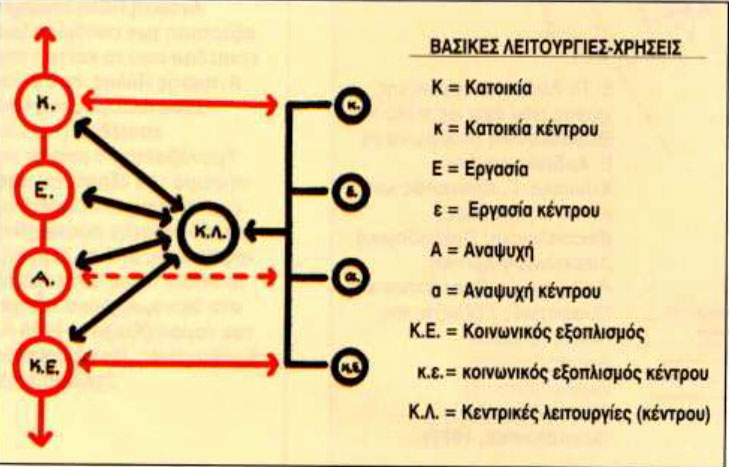 Διάγραμμα της τυπικής διάρθρωσης της σύγχρονης ελληνικής πόλης (κατά τον Π. Λουκάκη, «Σημειώσεις Χωροταξίας»).
Ως χρονική αφετηρία αναζήτησης των σημερινών δομών της σύγχρονης ελληνικής πόλης τοποθετούμε την περίοδο μετά το 1923, όταν διαμορφώθηκε το σύνολο σχεδόν της σημερινής ελληνικής επικράτειας. Ο κύριος όγκος του νέου πληθυσμού, που προήλθε από την ανταλλαγή του 1923, εγκαταστάθηκε στο ανατολικό τόξο της ηπειρωτικής Ελλάδας. Στο διάστημα αυτό δημιουργήθηκαν νέοι αγροτικοί και νέοι προαστιακοί οικισμοί, καθώς και νέες συνοικίες σε επαφή με τον τότε αστικό ιστό. Από τις εκσυγχρονιστικές μεταρρυθμίσεις που σχετίζονται άμεσα με την ανάπτυξη των ελληνικών πόλεων, ιδιαίτερα σημαντική είναι η θεσμοθέτηση του Π.Δ. του 1923 «Πρί Σχεδίου Πόλεων και Κωμών». Τότε δημιουργήθηκε και το καθεστώς των «προϋφισταμένων του 1923 οικισμών» και ο πρώτος Γενικός Οικοδομικός Κανονισμός (Γ.Ο.Κ.). Το δίκτυο οικισμών της χώρας στις αρχές της δεκαετίας του ’50 διατηρεί τα χαρακτηριστικά της περιόδου του μεσοπολέμου. Κυρίαρχος πόλος αστικής ανάπτυξης παραμένει η πρωτεύουσα. Από το τέλος, όμως, της δεκαετίας του ’70, εμφανίζονται τάσεις μεταλλαγών στο οικονομικό και κοινωνικό επίπεδο. Οι πόλεις μεγαλώνουν και διαχέονται προς τον αγροτικό χώρο. Αυτή τη χωρική διάχυση ανατέμνει το παρόν άρθρο.
Την εξέλιξη των οικισμών της χώρας επηρέασαν παράμετροι οικονομικές και κοινωνικές, λειτουργικές και θεσμικές.Οι θεσμικές διαστάσεις του συστήματος των οικισμών αναφέρονται στην Διοικητική τους ιεράρχηση, στην ιεράρχηση κατά την Εθνική Στατιστική Υπηρεσία και στην Προγραμματική ιεράρχηση κατά το Υ.ΠΕ.ΧΩ.Δ.Ε. Η μεγαλύτερη χωρική ανάπτυξη παρατηρείται στο S που συνθέτουν στο χώρο οι δυο μητροπολιτικές περιοχές της πρωτεύουσας και της Θεσσαλονίκης μαζί με τους περιφερειακούς αστικούς πόλους. Οι παράκτιοι οικισμοί και περιοχές υποδέχονται ολοένα και εντονότερα αστικές δραστηριότητες, ενώ ο τουρισμός αποτελεί την κυρίαρχη δραστηριότητα. Ως προς το δίκτυο των αγροτικών οικισμών, οι τάσεις της μόνιμης εσωτερικής μετανάστευσης έχουν περιοριστεί αλλά φαινόμενα εγκατάλειψης οικισμών χαρακτηρίζουν τις ορεινές περιοχές και τον νησιωτικό χώρο.
Η δομή των νεότερων ελληνικών πόλεων διαμορφώθηκε ιστορικά σε ένα τυπικό σχήμα μονοκεντρικού πυρήνα, που αποτελεί κατά περίπτωση το ιστορικό κέντρο τους. Προς τον κεντρικό αυτόν πυρήνα συγκλίνουν κατά ακτινωτό τρόπο οι βασικές αρτηρίες προσπέλασης της πόλης από την ενδοχώρα της. Η υπόλοιπη πόλη αναπτύσσεται γενικώς ομόκεντρα, περιλαμβάνοντας στο μέγιστο μέρος της τις περιοχές κατοικίας.Μέσα ή σε επαφή με το ιστορικό κέντρο είχαν αναπτυχθεί στο παρελθόν βιομηχανικές και βιοτεχνικές επιχειρήσεις της πόλης. Μετά το 1970 περίπου, οι βασικές τάσεις των μεταβολών στη δομή των πόλεων εντοπίζονται στα κέντρα των πόλεων, στις βιομηχανικές συγκεντρώσεις, στην ανάπτυξη των περιαστικών περιοχών δεύτερης κατοικίας, στη χωροθέτηση υπηρεσιών υπερτοπικής, περιφερειακής ή και εθνικής εμβέλειας στον περιαστικό χώρο, στη διάχυση των δικτύων υποδομής και στην υποβάθμιση του φυσικού και δομημένου περιβάλλοντος. Σημειωτέον ότι οι τρεις τύποι χώρων που διαχέονται στην πολη, δηλαδή οι θέσεις απασχόλησης, οι θέσεις κατοίκησης και οι θέσεις αναψυχής, επηρεάζονται από τα νέα δεδομένα στη ζωή των κατοίκων που ισχύουν εδώ και μια εικοσαετία.
Από τις θεωρητικές προσεγγίσεις των φαινομένων των πληθυσμιακών μετακινήσεων και της εξέλιξης των μεγάλων μητροπολιτικών κέντρων, ενδιαφέρουσα είναι εκείνη του περιφερειακού κύκλου. Σύμφωνα με αυτή την άποψη, η ανάπτυξη των μητροπολιτικών κέντρων και της περιβάλλουσας περιφέρειάς τους διαμορφώνεται στα εξής τέσσερα στάδια: αστικοποίηση, προαστιοποίηση, αποαστικοποίηση και επαναστικοποίηση. Στην πρωτεύουσαβρισκόμαστε σε φάση αποαστικοποίησης, δημιουργίας νέων πόλεων ή νέων οικισμών, ενώ στη Θεσσαλονίκη σε φάση έντονης προαστιοποίησης.
Διάγραμμα της τυπικής διάρθρωσης της σύγχρονης ελληνικής πόλης (κατά τον Π. Λουκάκη, «Σημειώσεις Χωροταξίας»).
Ως χρονική αφετηρία αναζήτησης των σημερινών δομών της σύγχρονης ελληνικής πόλης τοποθετούμε την περίοδο μετά το 1923, όταν διαμορφώθηκε το σύνολο σχεδόν της σημερινής ελληνικής επικράτειας. Ο κύριος όγκος του νέου πληθυσμού, που προήλθε από την ανταλλαγή του 1923, εγκαταστάθηκε στο ανατολικό τόξο της ηπειρωτικής Ελλάδας. Στο διάστημα αυτό δημιουργήθηκαν νέοι αγροτικοί και νέοι προαστιακοί οικισμοί, καθώς και νέες συνοικίες σε επαφή με τον τότε αστικό ιστό. Από τις εκσυγχρονιστικές μεταρρυθμίσεις που σχετίζονται άμεσα με την ανάπτυξη των ελληνικών πόλεων, ιδιαίτερα σημαντική είναι η θεσμοθέτηση του Π.Δ. του 1923 «Πρί Σχεδίου Πόλεων και Κωμών». Τότε δημιουργήθηκε και το καθεστώς των «προϋφισταμένων του 1923 οικισμών» και ο πρώτος Γενικός Οικοδομικός Κανονισμός (Γ.Ο.Κ.). Το δίκτυο οικισμών της χώρας στις αρχές της δεκαετίας του ’50 διατηρεί τα χαρακτηριστικά της περιόδου του μεσοπολέμου. Κυρίαρχος πόλος αστικής ανάπτυξης παραμένει η πρωτεύουσα. Από το τέλος, όμως, της δεκαετίας του ’70, εμφανίζονται τάσεις μεταλλαγών στο οικονομικό και κοινωνικό επίπεδο. Οι πόλεις μεγαλώνουν και διαχέονται προς τον αγροτικό χώρο. Αυτή τη χωρική διάχυση ανατέμνει το παρόν άρθρο.
Την εξέλιξη των οικισμών της χώρας επηρέασαν παράμετροι οικονομικές και κοινωνικές, λειτουργικές και θεσμικές.Οι θεσμικές διαστάσεις του συστήματος των οικισμών αναφέρονται στην Διοικητική τους ιεράρχηση, στην ιεράρχηση κατά την Εθνική Στατιστική Υπηρεσία και στην Προγραμματική ιεράρχηση κατά το Υ.ΠΕ.ΧΩ.Δ.Ε. Η μεγαλύτερη χωρική ανάπτυξη παρατηρείται στο S που συνθέτουν στο χώρο οι δυο μητροπολιτικές περιοχές της πρωτεύουσας και της Θεσσαλονίκης μαζί με τους περιφερειακούς αστικούς πόλους. Οι παράκτιοι οικισμοί και περιοχές υποδέχονται ολοένα και εντονότερα αστικές δραστηριότητες, ενώ ο τουρισμός αποτελεί την κυρίαρχη δραστηριότητα. Ως προς το δίκτυο των αγροτικών οικισμών, οι τάσεις της μόνιμης εσωτερικής μετανάστευσης έχουν περιοριστεί αλλά φαινόμενα εγκατάλειψης οικισμών χαρακτηρίζουν τις ορεινές περιοχές και τον νησιωτικό χώρο.
Η δομή των νεότερων ελληνικών πόλεων διαμορφώθηκε ιστορικά σε ένα τυπικό σχήμα μονοκεντρικού πυρήνα, που αποτελεί κατά περίπτωση το ιστορικό κέντρο τους. Προς τον κεντρικό αυτόν πυρήνα συγκλίνουν κατά ακτινωτό τρόπο οι βασικές αρτηρίες προσπέλασης της πόλης από την ενδοχώρα της. Η υπόλοιπη πόλη αναπτύσσεται γενικώς ομόκεντρα, περιλαμβάνοντας στο μέγιστο μέρος της τις περιοχές κατοικίας.Μέσα ή σε επαφή με το ιστορικό κέντρο είχαν αναπτυχθεί στο παρελθόν βιομηχανικές και βιοτεχνικές επιχειρήσεις της πόλης. Μετά το 1970 περίπου, οι βασικές τάσεις των μεταβολών στη δομή των πόλεων εντοπίζονται στα κέντρα των πόλεων, στις βιομηχανικές συγκεντρώσεις, στην ανάπτυξη των περιαστικών περιοχών δεύτερης κατοικίας, στη χωροθέτηση υπηρεσιών υπερτοπικής, περιφερειακής ή και εθνικής εμβέλειας στον περιαστικό χώρο, στη διάχυση των δικτύων υποδομής και στην υποβάθμιση του φυσικού και δομημένου περιβάλλοντος. Σημειωτέον ότι οι τρεις τύποι χώρων που διαχέονται στην πολη, δηλαδή οι θέσεις απασχόλησης, οι θέσεις κατοίκησης και οι θέσεις αναψυχής, επηρεάζονται από τα νέα δεδομένα στη ζωή των κατοίκων που ισχύουν εδώ και μια εικοσαετία.
Από τις θεωρητικές προσεγγίσεις των φαινομένων των πληθυσμιακών μετακινήσεων και της εξέλιξης των μεγάλων μητροπολιτικών κέντρων, ενδιαφέρουσα είναι εκείνη του περιφερειακού κύκλου. Σύμφωνα με αυτή την άποψη, η ανάπτυξη των μητροπολιτικών κέντρων και της περιβάλλουσας περιφέρειάς τους διαμορφώνεται στα εξής τέσσερα στάδια: αστικοποίηση, προαστιοποίηση, αποαστικοποίηση και επαναστικοποίηση. Στην πρωτεύουσαβρισκόμαστε σε φάση αποαστικοποίησης, δημιουργίας νέων πόλεων ή νέων οικισμών, ενώ στη Θεσσαλονίκη σε φάση έντονης προαστιοποίησης.
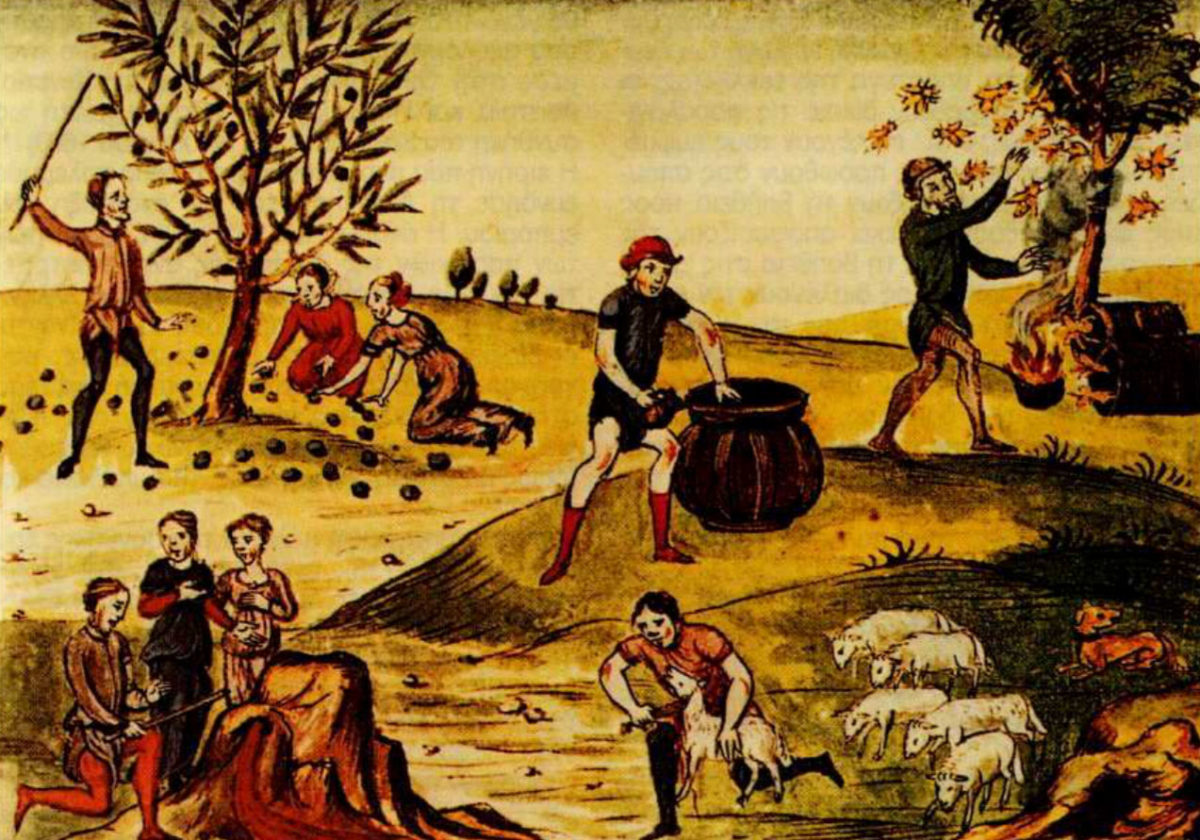 Αγροτικές εργασίες στα χρόνια της τουρκοκρατίας (Παρίσι, Εθνική Βιβλιοθήκη).
Μετά τις συστηματικές εγκαταστάσεις τουρκικών πληθυσμών, οι κάτοικοι πεδινών περιοχών αναζητούν καταφύγιο στα βουνά και ιδίως στην Πίνδο και τις παραφυάδες της. Ο τόπος καταγωγής, τα επαγγέλματα και οι ασχολίες των κατοίκων, ο άγιος προστάτης της παλιάς τους πατρίδας δίνουν την ονομασία τους στους νέους τόπους. Πολλά ορεινά χωριά της δυτικής Μακεδονίας και της ΒΑ Ηπείρου συνοικίζονται. Η φτώχεια του εδάφους στρέφει τους κατοίκους προς την κτηνοτροφία.
Στην Πίνδο βρίσκουμε συγκεντρωμένο έναν πολυάριθμο βλάχικο πληθυσμό που βρίσκει διέξοδο σε άλλους ορεινούς όγκους. Την εποχή αυτή ιδρύθηκαν ή συνοικίστηκαν από σκόρπιες βλαχοποιμενικές εγκαταστάσεις οι περισσότεροι ορεινοί οικισμοί της Μακεδονίας που θα γνωρίσουν μεγάλη άνθηση.
Οι υπόδουλοι Έλληνες συσπειρώθηκαν γύρω από τον κλήρο και τη δημογεροντία. Στα αστικά κέντρα και τα κεφαλοχώρια μοναδικό κοινωνικό κέντρο της γειτονιάς ήταν η εκκλησία.
Ένας άλλος θεσμός που λειτούργησε στα χρόνια της τουρκοκρατίας ήταν οι βιοτεχνικές συσσωματώσεις. Στις νέες ορεινές εστίες του 15ου και του 16ου αιώνα η ανάπτυξη της βιοτεχνικής επεξεργασίας του μαλλιού και των δερμάτων υπήρξε η κυριότερη πηγή πλουτισμού. Ο Τσελεμπή αναφέρει το εμπόριο των μεταξωτών και της αργυροχοϊας στα Γιάννενα, τα ταπητουργεία και τα υφαντουργεία της Μοσχόπολης. Στα Αμπελάκια και τη Ραψάνη αναπτύχθηκε ιδιαίτερα η τεχνική της ερυθροβαφής των νημάτων. Στην Καστοριά, κατασκεύαζαν αριστοτεχνικά γούνες από κοψίδια. Στην ανάπτυξη της οικονομίας των ορεινών περιοχών συνέβαλαν και οι συνθήκες του Κάρλοβιτς (1699) και του Passarowitz (1718), που ελευθέρωσαν τους δρόμους του εμπορίου. Ωστόσο, απώτερος λόγος της επιβίωσης και ανάπτυξης του Ελληνισμού υπήρξαν τα «προνόμια» εκείνα που είχε εκχωρήσει στον Πατριάρχη ο Πορθητής.
Αγροτικές εργασίες στα χρόνια της τουρκοκρατίας (Παρίσι, Εθνική Βιβλιοθήκη).
Μετά τις συστηματικές εγκαταστάσεις τουρκικών πληθυσμών, οι κάτοικοι πεδινών περιοχών αναζητούν καταφύγιο στα βουνά και ιδίως στην Πίνδο και τις παραφυάδες της. Ο τόπος καταγωγής, τα επαγγέλματα και οι ασχολίες των κατοίκων, ο άγιος προστάτης της παλιάς τους πατρίδας δίνουν την ονομασία τους στους νέους τόπους. Πολλά ορεινά χωριά της δυτικής Μακεδονίας και της ΒΑ Ηπείρου συνοικίζονται. Η φτώχεια του εδάφους στρέφει τους κατοίκους προς την κτηνοτροφία.
Στην Πίνδο βρίσκουμε συγκεντρωμένο έναν πολυάριθμο βλάχικο πληθυσμό που βρίσκει διέξοδο σε άλλους ορεινούς όγκους. Την εποχή αυτή ιδρύθηκαν ή συνοικίστηκαν από σκόρπιες βλαχοποιμενικές εγκαταστάσεις οι περισσότεροι ορεινοί οικισμοί της Μακεδονίας που θα γνωρίσουν μεγάλη άνθηση.
Οι υπόδουλοι Έλληνες συσπειρώθηκαν γύρω από τον κλήρο και τη δημογεροντία. Στα αστικά κέντρα και τα κεφαλοχώρια μοναδικό κοινωνικό κέντρο της γειτονιάς ήταν η εκκλησία.
Ένας άλλος θεσμός που λειτούργησε στα χρόνια της τουρκοκρατίας ήταν οι βιοτεχνικές συσσωματώσεις. Στις νέες ορεινές εστίες του 15ου και του 16ου αιώνα η ανάπτυξη της βιοτεχνικής επεξεργασίας του μαλλιού και των δερμάτων υπήρξε η κυριότερη πηγή πλουτισμού. Ο Τσελεμπή αναφέρει το εμπόριο των μεταξωτών και της αργυροχοϊας στα Γιάννενα, τα ταπητουργεία και τα υφαντουργεία της Μοσχόπολης. Στα Αμπελάκια και τη Ραψάνη αναπτύχθηκε ιδιαίτερα η τεχνική της ερυθροβαφής των νημάτων. Στην Καστοριά, κατασκεύαζαν αριστοτεχνικά γούνες από κοψίδια. Στην ανάπτυξη της οικονομίας των ορεινών περιοχών συνέβαλαν και οι συνθήκες του Κάρλοβιτς (1699) και του Passarowitz (1718), που ελευθέρωσαν τους δρόμους του εμπορίου. Ωστόσο, απώτερος λόγος της επιβίωσης και ανάπτυξης του Ελληνισμού υπήρξαν τα «προνόμια» εκείνα που είχε εκχωρήσει στον Πατριάρχη ο Πορθητής.
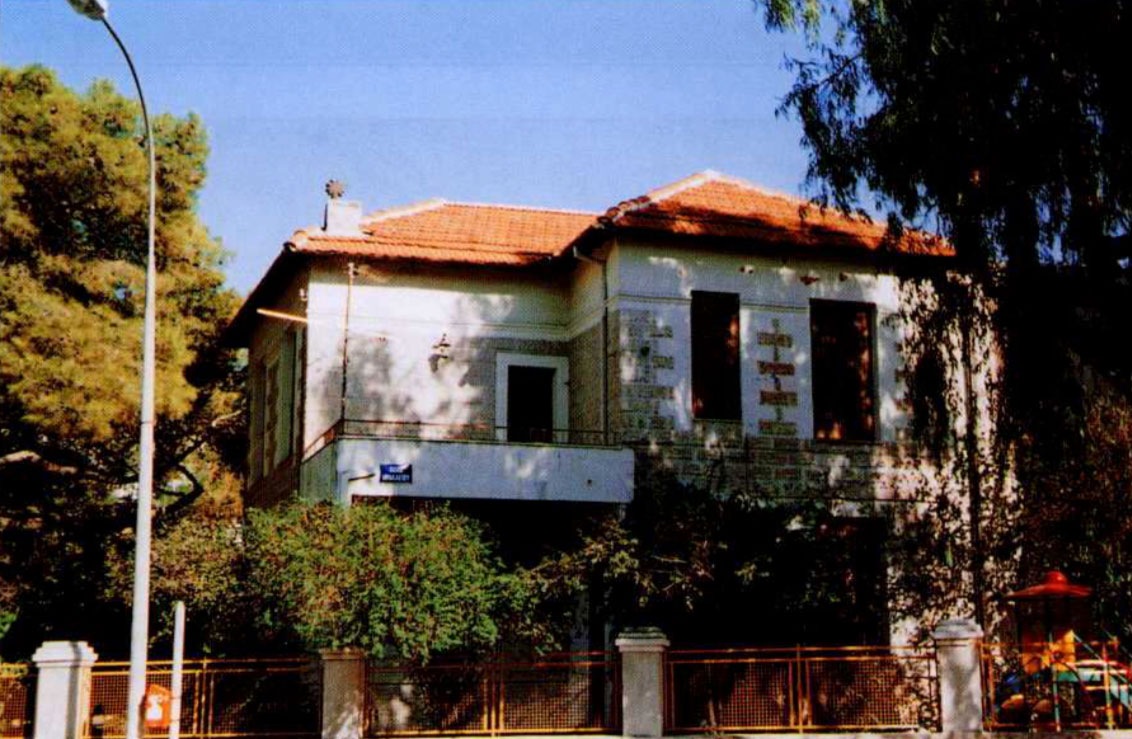 Σωζόμενο σπίτι του 1927, στη γωνία των οδών Ηρακλείου και Αγ. Λαύρας, Αθήνα. Η μορφολόγηση και κατασκευή του χαρακτηρίζουν τον προσχεδιασμό του οικισμού Κυπριάδου.
Υπό το πρόσχημα του προσφυγικού προβλήματος, στην Αθήνα δόθηκαν αφειδώς μεγάλες εκτάσεις εκτός των ορίων του σχεδίου για την πλήρη πολεοδομική εκμετάλλευσή τους από ιδιώτες. Η πλέον χαρακτηριστική περίπτωση είναι εκείνη του επιχειρηματία Μίνωα Κυπριάδη, που απέκτησε μια κατάφυτη περιοχή ανάμεσα στο ρέμα του Ποδονίφτη Πατησίων και της δυτικής πλαγιάς των Τουρκοβουνίων. Σκοπός του ήταν να οικοδομήσει εκεί «υποδειγματική κηπούπολη». Το πολεοδομικό παράλογο της υπόθεσης έγκειται στο ότι αυτή του η πρόθεση ισοδυναμούσε με την επέκταση του ρυμοτομικού σχεδίου εκτός εγκεκριμένου ορίου. Το ημερολόγιο του Κώστα Μπίρη, στελέχους τότε του Αρχιτεκτονικού Τμήματος του Δήμου Αθηναίων, προσφέρει άμεση μαρτυρία για τις αντιδράσεις μελών του Δημοτικού Συμβουλίου κυρίως εξαιτίας των δυσβάσταχτων για το Δήμο οικονομικών επιπτώσεων.
Όταν καταργήθηκε το εγκεκριμένο και εκσυγχρονιστικό σχέδιο Καλλιγά (1926), τα ζητήματα της πολεοδόμησης επιδεινώθηκαν, αφού επανήλθαν σε ισχύ πρόχειρα πυροσβεστικού τύπου διατάγματα, ιδανικά για «παρερμηνείες» και κάθε είδους καταχρήσεις. Ενδεικτικά ο Μπίρης σημειώνει: «Άλλαι διατάξεις έμειναν ανεφάρμοστοι και άλλαι έδωσαν διέξοδον προς κατάχρησιν να εκδίδονται από καιρού εις καιρόν νομοθετήματα τροποποιητικά ή συμπληρωματικά. Εις τρόπον ώστε η νομοθεσία περί σχεδίων πόλεων να ομοιάζει προς μία κουρελού η οποία υφάνθη εξαρχής από διάφορα κουρέλια δια να καλύψει ένα σαλόνι, εις το οποίο άξιζε ένα ταπέτο πολύ καλής ποιότητος...»
Σωζόμενο σπίτι του 1927, στη γωνία των οδών Ηρακλείου και Αγ. Λαύρας, Αθήνα. Η μορφολόγηση και κατασκευή του χαρακτηρίζουν τον προσχεδιασμό του οικισμού Κυπριάδου.
Υπό το πρόσχημα του προσφυγικού προβλήματος, στην Αθήνα δόθηκαν αφειδώς μεγάλες εκτάσεις εκτός των ορίων του σχεδίου για την πλήρη πολεοδομική εκμετάλλευσή τους από ιδιώτες. Η πλέον χαρακτηριστική περίπτωση είναι εκείνη του επιχειρηματία Μίνωα Κυπριάδη, που απέκτησε μια κατάφυτη περιοχή ανάμεσα στο ρέμα του Ποδονίφτη Πατησίων και της δυτικής πλαγιάς των Τουρκοβουνίων. Σκοπός του ήταν να οικοδομήσει εκεί «υποδειγματική κηπούπολη». Το πολεοδομικό παράλογο της υπόθεσης έγκειται στο ότι αυτή του η πρόθεση ισοδυναμούσε με την επέκταση του ρυμοτομικού σχεδίου εκτός εγκεκριμένου ορίου. Το ημερολόγιο του Κώστα Μπίρη, στελέχους τότε του Αρχιτεκτονικού Τμήματος του Δήμου Αθηναίων, προσφέρει άμεση μαρτυρία για τις αντιδράσεις μελών του Δημοτικού Συμβουλίου κυρίως εξαιτίας των δυσβάσταχτων για το Δήμο οικονομικών επιπτώσεων.
Όταν καταργήθηκε το εγκεκριμένο και εκσυγχρονιστικό σχέδιο Καλλιγά (1926), τα ζητήματα της πολεοδόμησης επιδεινώθηκαν, αφού επανήλθαν σε ισχύ πρόχειρα πυροσβεστικού τύπου διατάγματα, ιδανικά για «παρερμηνείες» και κάθε είδους καταχρήσεις. Ενδεικτικά ο Μπίρης σημειώνει: «Άλλαι διατάξεις έμειναν ανεφάρμοστοι και άλλαι έδωσαν διέξοδον προς κατάχρησιν να εκδίδονται από καιρού εις καιρόν νομοθετήματα τροποποιητικά ή συμπληρωματικά. Εις τρόπον ώστε η νομοθεσία περί σχεδίων πόλεων να ομοιάζει προς μία κουρελού η οποία υφάνθη εξαρχής από διάφορα κουρέλια δια να καλύψει ένα σαλόνι, εις το οποίο άξιζε ένα ταπέτο πολύ καλής ποιότητος...»
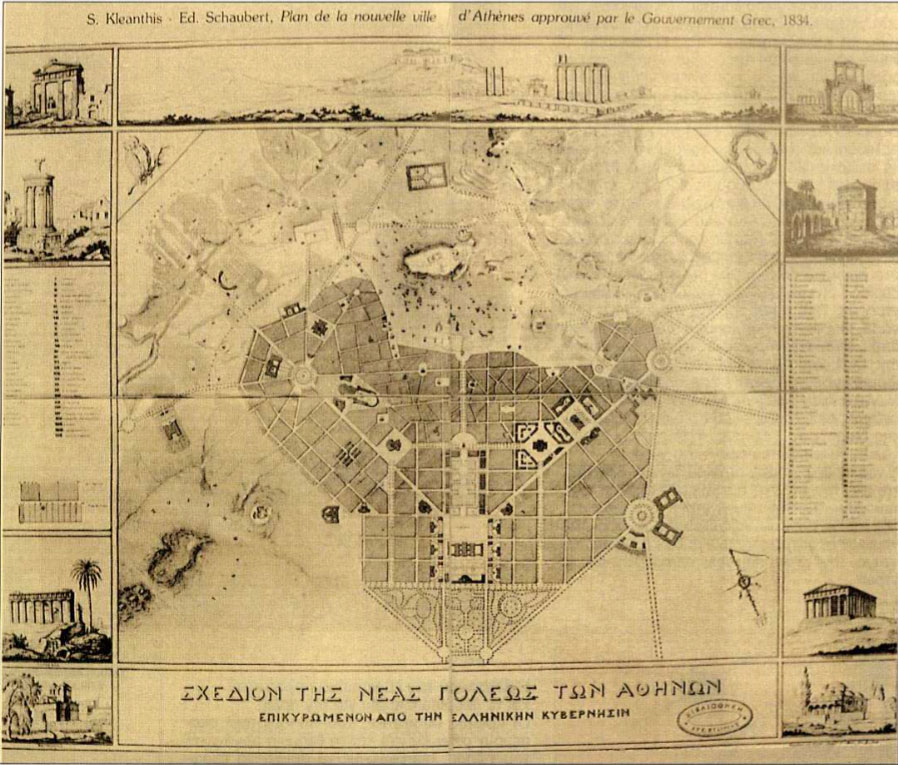 Αθήνα, το σχέδιο Κλεάνθη-Schaubert, 1832.
Στην ιστορία της ελληνικής πόλης του 19ου αιώνα διακρίνονται δυο κύριες φάσεις. Η πρώτη καλύπτει την περίοδο της διοίκησης Καποδίστρια (1828-1832) και τα πρώτα χρόνια της Αντιβασιλείας και της βασιλείας του Όθωνα (1833-1843), ενώ η δεύτερη την περίοδο 1856-1912. Στο ενδιάμεσο (1843-1856), η αποχώρηση των ξένων μηχανικών και αρχιτεκτόνων από τις δημόσιες υπηρεσίες και η πολιτική και οικονομική αστάθεια προκαλούν αδράνεια τόσο στο θεσμικό όσο και στο σχεδιαστικό επίπεδο.
Στην περίοδο του Καποδίστρια σχεδιάζονται κυρίως τα κατεστραμμένα από τον πόλεμο κέντρα της Πελοποννήσου, ενώ στην πρώτη οθωνική περίοδο δίνεται βάρος σε εμπορικά κέντρα της Πελοποννήσου και της Στερεάς και στις παράλιες πόλεις, όπου είναι εντονότερες οι τάσεις αστικοποίησης.
Στα χρόνια της Αντιβασιλείας, στο νεοσυσταθέν «Γραφείο Δημοσίου Οικονομίας» εκχωρούνται ευρείες αρμοδιότητες πάνω στον έλεγχο και την οργάνωση του χώρου. Επιχειρείται η αστικοποίηση μέσω της δημιουργίας νέων πόλεων – αποικιών, ενώ νέο πλέγμα νόμων αποβλέπει στην ενθάρρυνση της βιομηχανίας, στην επέκταση του οδικού δικτύου και στον έλεγχο της κατασκευής και της υγιεινής των πόλεων. Γάλλοι αξιωματικοί του Μηχανικού και στρατιωτικοί γεωγράφοι, Βαυαροί αρχιτέκτονες και γεωμέτρες, ετερόχθονες Έλληνες γίνονται το μέσο μεταφοράς στο νέο κράτος της σύγχρονης ευρωπαϊκής σκέψης και πρακτικής για την οργάνωση του χώρου. Ωστόσο, στη μετεπαναστατική Ελλάδα, ο σχεδιασμός των πόλεων δεν ήταν πρόβλημα καθαρά τεχνικό. Ήταν και μέσο ρήξης με το παρελθόν σε επίπεδο ιδεολογικό και μορφολογικό. Ο σχεδιασμός της νέας πόλης των Αθηνών από τους αρχιτέκτονες Schaubert και Κλεάνθη συνδυάζει άξονες και εστιακά σημεία σε μια γεωμετρική σύνθεση με έντονο συμβολικό χαρακτήρα και ένα συνεχή διάλογο της αρχαίας τοπογραφίας με τους σημαίνοντες χώρους της νέας πόλης. Το σχέδιο της Αθήνας θα επηρεάσει ευθέως τη σύνθεση του γεωμέτρη Stauffert για τη νέα πόλη της Σπάρτης.
Αμέσως μετά τα μέσα του 19ου αιώνα αρχίζει μια περίοδος εσωτερικής ανασυγκρότησης. Μοχλός εκσυγχρονισμού και οικονομικής ανάπτυξης αποτελεί η εντατικοποίηση των δημοσίων έργων, εγγειοβελτιωτικών, οδικών και λιμενικών. Το 1878 συστήνεται η Διεύθυνσις Δημοσίων Έργων ως ανεξάρτητη υπηρεσία του Υπουργείου των Εσωτερικών. Σημαντική είναι η πρόοδος που συντελείται κατά την περίοδο του Τρικούπη (1881-1892).
Ο αστικός πληθυσμός αυξάνεται σημαντικά μετά το 1870, με αιχμή τα παράλια κέντρα της βόρειας και της δυτικής Πελοποννήσου. Μετά το 1856 σχεδιάζονται μια σειρά πόλεις και κωμοπόλεις που θα λειτουργήσουν ως κέντρα συγκέντρωσης και εξαγωγής της σταφίδας στην Πελοπόννησο, ως λιμάνια τοπικής σημασίας στη Στερεά και ως βασικοί οικισμοί στις Κυκλάδες.
Το νέο στοιχείο του πολεοδομικού σχεδιασμού στο δεύτερο μισό του 19ου αιώνα είναι η συστηματική πλέον πρόβλεψη ενός συγκεκριμένου οικιστικού εξοπλισμού για την πόλη ή το λιμάνι της και δικτύων υποδομής. Παράλληλα συστηματοποιείται το θεσμικό πλαίσιο για την ενίσχυση της αστικοποίησης και τον έλεγχο της ανάπτυξης των πόλεων. Η δεύτερη περίοδος της ελληνικής πολεοδομίας σηματοδοτείται με το σχέδιο της Νέας Κορίνθου που συντάσσεται το 1858. Ακολουθείται ένα νέο μοντέλο που βασίζεται σε απλό ορθογωνικό πλέγμα, χωρίς ιδιαίτερη σήμανση κύριων αξόνων και μνημειακότητα.
Η νεοελληνική πόλη, που αναπτύσσει δυναμικά τα αστικά χαρακτηριστικά της στις αρχές του 20ού αιώνα και που αφομοιώνει την οικιστική ανάπτυξη του μεσοπολέμου, θα διατηρήσει την αυτοτέλεια και την κλίμακά της έως την πλήρη πολεοδομική της παραμόρφωση στις πρόσφατες μεταπολεμικές δεκαετίες.
Αθήνα, το σχέδιο Κλεάνθη-Schaubert, 1832.
Στην ιστορία της ελληνικής πόλης του 19ου αιώνα διακρίνονται δυο κύριες φάσεις. Η πρώτη καλύπτει την περίοδο της διοίκησης Καποδίστρια (1828-1832) και τα πρώτα χρόνια της Αντιβασιλείας και της βασιλείας του Όθωνα (1833-1843), ενώ η δεύτερη την περίοδο 1856-1912. Στο ενδιάμεσο (1843-1856), η αποχώρηση των ξένων μηχανικών και αρχιτεκτόνων από τις δημόσιες υπηρεσίες και η πολιτική και οικονομική αστάθεια προκαλούν αδράνεια τόσο στο θεσμικό όσο και στο σχεδιαστικό επίπεδο.
Στην περίοδο του Καποδίστρια σχεδιάζονται κυρίως τα κατεστραμμένα από τον πόλεμο κέντρα της Πελοποννήσου, ενώ στην πρώτη οθωνική περίοδο δίνεται βάρος σε εμπορικά κέντρα της Πελοποννήσου και της Στερεάς και στις παράλιες πόλεις, όπου είναι εντονότερες οι τάσεις αστικοποίησης.
Στα χρόνια της Αντιβασιλείας, στο νεοσυσταθέν «Γραφείο Δημοσίου Οικονομίας» εκχωρούνται ευρείες αρμοδιότητες πάνω στον έλεγχο και την οργάνωση του χώρου. Επιχειρείται η αστικοποίηση μέσω της δημιουργίας νέων πόλεων – αποικιών, ενώ νέο πλέγμα νόμων αποβλέπει στην ενθάρρυνση της βιομηχανίας, στην επέκταση του οδικού δικτύου και στον έλεγχο της κατασκευής και της υγιεινής των πόλεων. Γάλλοι αξιωματικοί του Μηχανικού και στρατιωτικοί γεωγράφοι, Βαυαροί αρχιτέκτονες και γεωμέτρες, ετερόχθονες Έλληνες γίνονται το μέσο μεταφοράς στο νέο κράτος της σύγχρονης ευρωπαϊκής σκέψης και πρακτικής για την οργάνωση του χώρου. Ωστόσο, στη μετεπαναστατική Ελλάδα, ο σχεδιασμός των πόλεων δεν ήταν πρόβλημα καθαρά τεχνικό. Ήταν και μέσο ρήξης με το παρελθόν σε επίπεδο ιδεολογικό και μορφολογικό. Ο σχεδιασμός της νέας πόλης των Αθηνών από τους αρχιτέκτονες Schaubert και Κλεάνθη συνδυάζει άξονες και εστιακά σημεία σε μια γεωμετρική σύνθεση με έντονο συμβολικό χαρακτήρα και ένα συνεχή διάλογο της αρχαίας τοπογραφίας με τους σημαίνοντες χώρους της νέας πόλης. Το σχέδιο της Αθήνας θα επηρεάσει ευθέως τη σύνθεση του γεωμέτρη Stauffert για τη νέα πόλη της Σπάρτης.
Αμέσως μετά τα μέσα του 19ου αιώνα αρχίζει μια περίοδος εσωτερικής ανασυγκρότησης. Μοχλός εκσυγχρονισμού και οικονομικής ανάπτυξης αποτελεί η εντατικοποίηση των δημοσίων έργων, εγγειοβελτιωτικών, οδικών και λιμενικών. Το 1878 συστήνεται η Διεύθυνσις Δημοσίων Έργων ως ανεξάρτητη υπηρεσία του Υπουργείου των Εσωτερικών. Σημαντική είναι η πρόοδος που συντελείται κατά την περίοδο του Τρικούπη (1881-1892).
Ο αστικός πληθυσμός αυξάνεται σημαντικά μετά το 1870, με αιχμή τα παράλια κέντρα της βόρειας και της δυτικής Πελοποννήσου. Μετά το 1856 σχεδιάζονται μια σειρά πόλεις και κωμοπόλεις που θα λειτουργήσουν ως κέντρα συγκέντρωσης και εξαγωγής της σταφίδας στην Πελοπόννησο, ως λιμάνια τοπικής σημασίας στη Στερεά και ως βασικοί οικισμοί στις Κυκλάδες.
Το νέο στοιχείο του πολεοδομικού σχεδιασμού στο δεύτερο μισό του 19ου αιώνα είναι η συστηματική πλέον πρόβλεψη ενός συγκεκριμένου οικιστικού εξοπλισμού για την πόλη ή το λιμάνι της και δικτύων υποδομής. Παράλληλα συστηματοποιείται το θεσμικό πλαίσιο για την ενίσχυση της αστικοποίησης και τον έλεγχο της ανάπτυξης των πόλεων. Η δεύτερη περίοδος της ελληνικής πολεοδομίας σηματοδοτείται με το σχέδιο της Νέας Κορίνθου που συντάσσεται το 1858. Ακολουθείται ένα νέο μοντέλο που βασίζεται σε απλό ορθογωνικό πλέγμα, χωρίς ιδιαίτερη σήμανση κύριων αξόνων και μνημειακότητα.
Η νεοελληνική πόλη, που αναπτύσσει δυναμικά τα αστικά χαρακτηριστικά της στις αρχές του 20ού αιώνα και που αφομοιώνει την οικιστική ανάπτυξη του μεσοπολέμου, θα διατηρήσει την αυτοτέλεια και την κλίμακά της έως την πλήρη πολεοδομική της παραμόρφωση στις πρόσφατες μεταπολεμικές δεκαετίες.
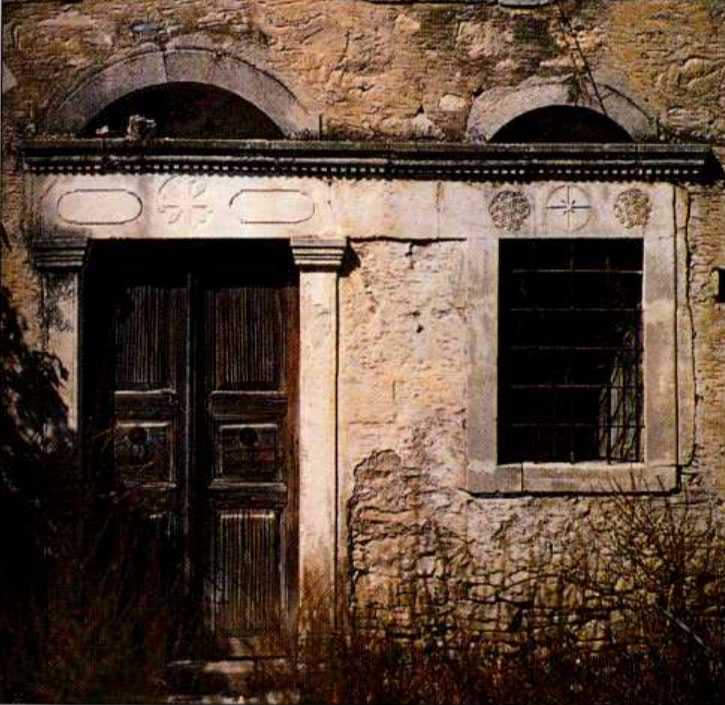 «Κύριο αποτρόπαιο γίνεται πλέον ο σταυρός, που εξακολουθεί να χαράσσεται στα ανώφλια ως τις μέρες μας...»
Ο συγγραφέας, με οδηγό κυρίως τις επιγραφές, διαπραγματεύεται έθιμα και δοξασίες που σχετίζονται με την πανάρχαιη αγωνία του ανθρώπου να προσελκύσει το καλό και να ξορκίσει το κακό.
Προάγγελοι της Ευετηρίας, της Καλοχρονιάς, ήταν τα παιδιά που γύριζαν από σπίτι σε σπίτι για να πουν τα κάλαντα. Φαίνεται ότι τα πιο αρχαία κάλαντα, που ονομάζονταν Ειρεσιώνη, τα έψαλε ο ίδιος ο Όμηρος στη Σάμο. Αλεξιφάρμακον ήταν στην αρχαιότητα η σκιλλοκρεμμύδα της δικής μας Πρωτοχρονιάς.
Καλύτερα όμως αλεξιφάρμακα ήταν οι θεοί και οι ήρωες που προστάτευαν τις εισόδους και τις πύλες. Εκτός από τον Απόλλωνα Προπύλαιον ή Αποτροπαίον και Αγυιέα, που λατρευόταν στην κλασική αρχαιότητα, μεγάλες αποτροπαϊκές ιδιότητες είχε ο Ηρακλής, ο ίδιος ή το ρόπαλό του, αλλά και οι Διόσκουροι.
Ενώ στα χριστιανικά χρόνια κύριο αποτρόπαιο γίνεται ο Σταυρός και οι εικόνες, στην αρχαιότητα μέσα σε σπίτια ή και εργαστήρια κρέμονταν τα «βασκάνια». Όπως και σήμερα, τον μεγαλύτερο φόβο γεννούσε «το μάτι», ο φθόνος. Για να εξουδετερώσουν «το μάτι», οι αρχαίοι φορούσαν διάφορα φυλαχτά, γνωστά ως ιερώματα: πάπυροι με μαγικές επωδούς, γοργόνεια, φαλλοί, νομίσματα. Για να προσελκύσουν το καλό φορούσαν διαφόρων ειδών περίαπτα, ενώ τα ενεπίγραφα κουδουνάκια συνδύαζαν αποτροπαϊκό και εφελκυστικό χαρακτήρα. Για τους αρχαίους ο κατεξοχήν θεός της Καλής Τύχης ήταν ο Ερμής, που λατρευόταν, όπως και ο Πρίαπος, ως Τύχων. Έρμαια ονομάζονταν τα ανέλπιστα δώρα της καλής τύχης. Τυχαία ονομάζονταν τα αγαλματίδια της θεάς Τύχης που θεωρούνταν ότι φέρνουν γούρι. Η έκφραση «Αφροδίτη καλή» ήταν πιθανότατα μια επίκληση στην καλή Τύχη.
«Κύριο αποτρόπαιο γίνεται πλέον ο σταυρός, που εξακολουθεί να χαράσσεται στα ανώφλια ως τις μέρες μας...»
Ο συγγραφέας, με οδηγό κυρίως τις επιγραφές, διαπραγματεύεται έθιμα και δοξασίες που σχετίζονται με την πανάρχαιη αγωνία του ανθρώπου να προσελκύσει το καλό και να ξορκίσει το κακό.
Προάγγελοι της Ευετηρίας, της Καλοχρονιάς, ήταν τα παιδιά που γύριζαν από σπίτι σε σπίτι για να πουν τα κάλαντα. Φαίνεται ότι τα πιο αρχαία κάλαντα, που ονομάζονταν Ειρεσιώνη, τα έψαλε ο ίδιος ο Όμηρος στη Σάμο. Αλεξιφάρμακον ήταν στην αρχαιότητα η σκιλλοκρεμμύδα της δικής μας Πρωτοχρονιάς.
Καλύτερα όμως αλεξιφάρμακα ήταν οι θεοί και οι ήρωες που προστάτευαν τις εισόδους και τις πύλες. Εκτός από τον Απόλλωνα Προπύλαιον ή Αποτροπαίον και Αγυιέα, που λατρευόταν στην κλασική αρχαιότητα, μεγάλες αποτροπαϊκές ιδιότητες είχε ο Ηρακλής, ο ίδιος ή το ρόπαλό του, αλλά και οι Διόσκουροι.
Ενώ στα χριστιανικά χρόνια κύριο αποτρόπαιο γίνεται ο Σταυρός και οι εικόνες, στην αρχαιότητα μέσα σε σπίτια ή και εργαστήρια κρέμονταν τα «βασκάνια». Όπως και σήμερα, τον μεγαλύτερο φόβο γεννούσε «το μάτι», ο φθόνος. Για να εξουδετερώσουν «το μάτι», οι αρχαίοι φορούσαν διάφορα φυλαχτά, γνωστά ως ιερώματα: πάπυροι με μαγικές επωδούς, γοργόνεια, φαλλοί, νομίσματα. Για να προσελκύσουν το καλό φορούσαν διαφόρων ειδών περίαπτα, ενώ τα ενεπίγραφα κουδουνάκια συνδύαζαν αποτροπαϊκό και εφελκυστικό χαρακτήρα. Για τους αρχαίους ο κατεξοχήν θεός της Καλής Τύχης ήταν ο Ερμής, που λατρευόταν, όπως και ο Πρίαπος, ως Τύχων. Έρμαια ονομάζονταν τα ανέλπιστα δώρα της καλής τύχης. Τυχαία ονομάζονταν τα αγαλματίδια της θεάς Τύχης που θεωρούνταν ότι φέρνουν γούρι. Η έκφραση «Αφροδίτη καλή» ήταν πιθανότατα μια επίκληση στην καλή Τύχη.
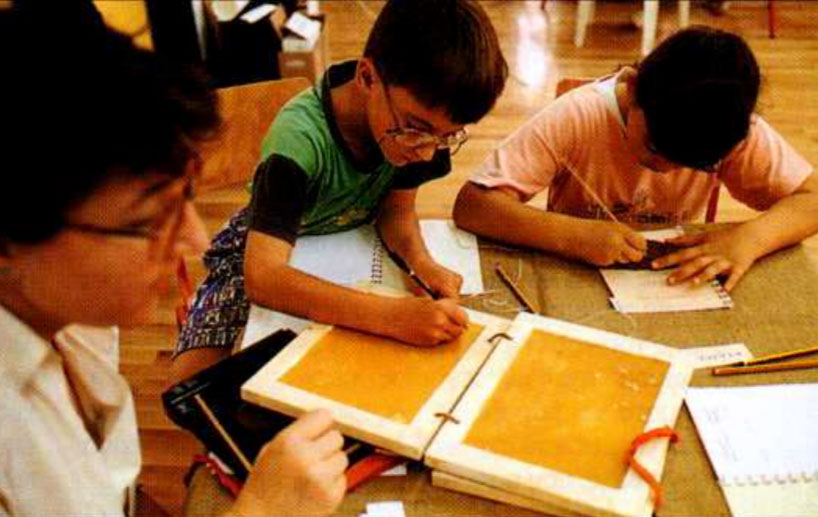 Δυο παιδιά με κέρινες πλακέτες.
Κατά το ακαδημαϊκό έτος 1995-1996, στο πλαίσιο του Προγράμματος Μελίνα, Εκπαίδευση και Πολιτισμός και με άμεσο πεδίο εφαρμογής την πρώτη Δημοτικού, επιλέχθηκε ως πεδίο διερεύνησης και πειραματισμού το θέμα της γραφής και ως εναλλακτική μέθοδος διδασκαλίας η «μάθηση μέσω αντικειμένων». Σε αναλογία με τη «μουσειοσκευή ή μουσειοβαλίτσα», δημιουργήθηκε η «βαλίτσα της γραφής». Το βάρος δεν δόθηκε στην ιστορία της γραφής, την επινόηση ή την αποκρυπτογράφησή της αλλά στην ιστορία των υλικών και της τεχνολογίας της. Δημιουργήθηκε μια συλλογή από υλικά και αντικείμενα για το γράψιμο και αναζητήθηκαν κατάλληλες συνοδευτικές εικόνες που δημιουργούν το ιστορικό-πολιτισμικό πλαίσιο.
Η βαλίτσα της γραφής περιλάμβανε πέντε ενότητες, που αντιπροσώπευαν τα κυριότερα υλικά-σταθμούς στην τεχνολογία και την τεχνική της ιστορίας της γραφής:
Δυο παιδιά με κέρινες πλακέτες.
Κατά το ακαδημαϊκό έτος 1995-1996, στο πλαίσιο του Προγράμματος Μελίνα, Εκπαίδευση και Πολιτισμός και με άμεσο πεδίο εφαρμογής την πρώτη Δημοτικού, επιλέχθηκε ως πεδίο διερεύνησης και πειραματισμού το θέμα της γραφής και ως εναλλακτική μέθοδος διδασκαλίας η «μάθηση μέσω αντικειμένων». Σε αναλογία με τη «μουσειοσκευή ή μουσειοβαλίτσα», δημιουργήθηκε η «βαλίτσα της γραφής». Το βάρος δεν δόθηκε στην ιστορία της γραφής, την επινόηση ή την αποκρυπτογράφησή της αλλά στην ιστορία των υλικών και της τεχνολογίας της. Δημιουργήθηκε μια συλλογή από υλικά και αντικείμενα για το γράψιμο και αναζητήθηκαν κατάλληλες συνοδευτικές εικόνες που δημιουργούν το ιστορικό-πολιτισμικό πλαίσιο.
Η βαλίτσα της γραφής περιλάμβανε πέντε ενότητες, που αντιπροσώπευαν τα κυριότερα υλικά-σταθμούς στην τεχνολογία και την τεχνική της ιστορίας της γραφής:
- Χαρτί, πινέλα, ραβδάκι στερεής μελάνης και νερό, υλικά που συνδέονται με την εφεύρεση του χαρτιού στην Κίνα
- Σκληρές ύλες (πηλός, πέτρες, κερωμένες πινακίδες, όστρακα αγγείων) πάνω στις οποίες έγραφαν στην αρχαιότητα, χαράζοντας με κάποιο αιχμηρό όργανο
- Ο πάπυρος, το καλάμι για τις γραφίδες, το μελάνι
- Η περγαμηνή, η πένα από καλάμι ή φτερό, βουλοκέρι για τα σφραγίσματα, υλικά για χειρόγραφους κώδικες και μεσαιωνικά ειλητάρια
- Τα υλικά που χρησιμοποίησαν οι αμέσως προηγούμενες και οι σημερινές γενιές: κονδυλοφόροι, πένες, μελανοδοχεία και στυπόχαρτο, στυλό bic, μαρκαδόροι.
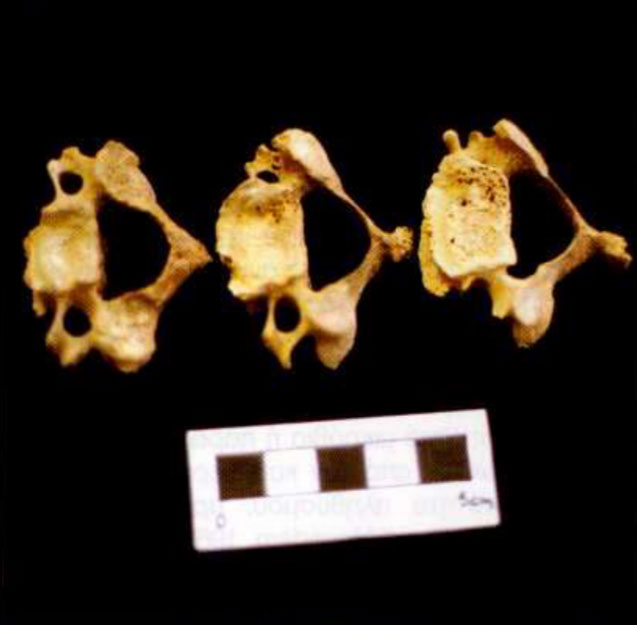 Αυχενικοί σπόνδυλοι με χαρακτηριστικές αλλοιώσεις σπονδυλοαρθρίτιδας.
Η επιστήμη της Παλαιοπαθολογίας μελετά τις ασθένειες που μπορούν να αναγνωριστούν στα ανθρώπινα και ζωικά οστά παλαιότερων εποχών. Η πληθώρα των πληροφοριών που μπορούν να συλλεγούν βοηθά στην ανασύσταση της κοινωνίας παλαιότερων πολιτισμών.
Σαράντα δύο σκελετοί που προέρχονται από ταφές της Ελληνιστικής περιόδου και αποκαλύφθηκαν σε σωστικές ανασκαφές στην πόλη των Χανίων αποτελούν το προς μελέτη υλικό. Από τους τάφους, κιβωτιόσχημους ή θαλαμοειδείς, οι περισσότεροι είχαν περισσότερους από ένα νεκρούς, τοποθετημένους σε ύπτια θέση.
Ο πληθυσμός που εξετάστηκε δεν έχει προηγούμενη αναφορά στη βιβλιογραφία. Ωστόσο, αυτό που επηρέασε αρνητικά τη μελέτη του υλικού ήταν η φτωχή διατήρηση του δείγματος που οφείλεται πρώτιστα στις συνθήκες ταφής και, κατά δεύτερο λόγο, στη σύληση των τάφων που επέφερε τη διατάραξη της ταφής και το διασκορπισμό των οστών.
Η φτωχή διατήρηση του δείγματος επηρέασε άμεσα την αναγνώριση του φύλου και τον υπολογισμό της ηλικίας. Σε 22 άτομα δεν αναγνωρίστηκε το φύλο, ενώ χαρακτηρίστηκαν, όχι μετά βεβαιότητας, 11 άτομα ως άνδρες και 9 άτομα ως γυναίκες. Στο δείγμα δεν βρέθηκαν άτομα κάτω των 17 ετών και η έλλειψη παιδικών ταφών παραμένει δυσερμήνευτη.
Τελικά συμπεράσματα για την κατάσταση της υγείας του πληθυσμού είναι δύσκολο να παρουσιαστούν, μπορούν όμως να γίνουν κάποιες γενικές παρατηρήσεις για τις ασθένειες που διαγνώσθηκαν στο δείγμα. Ιδιαίτερα ψηλά είναι τα ποσοστά ασθενειών των δοντιών. Η άποψη ότι οι πλούσιοι κάτοικοι της αρχαίας Μεσογείου υπέφεραν περισσότερο από τα δόντια τους παρά οι φτωχοί, ενισχύει την υπόθεση ότι τα άτομα από τις ταφές που μελετήθηκαν ανήκαν στα υψηλά κοινωνικά στρώματα.
Τα ποσοστά για τις αρθροπάθειες επηρεάστηκαν επίσης από τη φτωχή διατήρηση του δείγματος και ιδιαίτερα από την έντονη διάβρωση ή και έλλειψη των αρθρικών επιφανειών. Παρ’όλα αυτά διαγνώστηκαν τέσσερις περιπτώσεις σπονδυλαρθρίτιδας. Οι αυχενικοί σπόνδυλοι είχαν πληγεί περισσότερο, γεγονός που μάλλον οφείλεται στη χρήση του κεφαλιού για τη μεταφορά φορτίων. Ανάμεσα στις αρθροπάθειες που πλήττουν τη σπονδυλική στήλη, συγκαταλέγεται και η ασθένεια Forestier ή DISH. Παρατηρήθηκαν επίσης αλλοιώσεις στις οφθαλμικές κόγχες, οι οποίες σχετίζονται με ενδείξεις για την εκδήλωση μεταβολικών ασθενειών, εν προκειμένω σιδηροπενικής αναιμίας.
Στο δείγμα αναγνωρίστηκαν δυο περιπτώσεις μολυσματικών ασθενειών άγνωστης αιτίας, και συγκεκριμένα περιοστείτιδας. Επίσης καταγράφηκε και μια περίπτωση τραύματος. Πρόκειται για κάταγμα στο κάτω μέρος της ωλένης του αριστερού χεριού, το γνωστό ως «κάταγμα του Parry».
Αυχενικοί σπόνδυλοι με χαρακτηριστικές αλλοιώσεις σπονδυλοαρθρίτιδας.
Η επιστήμη της Παλαιοπαθολογίας μελετά τις ασθένειες που μπορούν να αναγνωριστούν στα ανθρώπινα και ζωικά οστά παλαιότερων εποχών. Η πληθώρα των πληροφοριών που μπορούν να συλλεγούν βοηθά στην ανασύσταση της κοινωνίας παλαιότερων πολιτισμών.
Σαράντα δύο σκελετοί που προέρχονται από ταφές της Ελληνιστικής περιόδου και αποκαλύφθηκαν σε σωστικές ανασκαφές στην πόλη των Χανίων αποτελούν το προς μελέτη υλικό. Από τους τάφους, κιβωτιόσχημους ή θαλαμοειδείς, οι περισσότεροι είχαν περισσότερους από ένα νεκρούς, τοποθετημένους σε ύπτια θέση.
Ο πληθυσμός που εξετάστηκε δεν έχει προηγούμενη αναφορά στη βιβλιογραφία. Ωστόσο, αυτό που επηρέασε αρνητικά τη μελέτη του υλικού ήταν η φτωχή διατήρηση του δείγματος που οφείλεται πρώτιστα στις συνθήκες ταφής και, κατά δεύτερο λόγο, στη σύληση των τάφων που επέφερε τη διατάραξη της ταφής και το διασκορπισμό των οστών.
Η φτωχή διατήρηση του δείγματος επηρέασε άμεσα την αναγνώριση του φύλου και τον υπολογισμό της ηλικίας. Σε 22 άτομα δεν αναγνωρίστηκε το φύλο, ενώ χαρακτηρίστηκαν, όχι μετά βεβαιότητας, 11 άτομα ως άνδρες και 9 άτομα ως γυναίκες. Στο δείγμα δεν βρέθηκαν άτομα κάτω των 17 ετών και η έλλειψη παιδικών ταφών παραμένει δυσερμήνευτη.
Τελικά συμπεράσματα για την κατάσταση της υγείας του πληθυσμού είναι δύσκολο να παρουσιαστούν, μπορούν όμως να γίνουν κάποιες γενικές παρατηρήσεις για τις ασθένειες που διαγνώσθηκαν στο δείγμα. Ιδιαίτερα ψηλά είναι τα ποσοστά ασθενειών των δοντιών. Η άποψη ότι οι πλούσιοι κάτοικοι της αρχαίας Μεσογείου υπέφεραν περισσότερο από τα δόντια τους παρά οι φτωχοί, ενισχύει την υπόθεση ότι τα άτομα από τις ταφές που μελετήθηκαν ανήκαν στα υψηλά κοινωνικά στρώματα.
Τα ποσοστά για τις αρθροπάθειες επηρεάστηκαν επίσης από τη φτωχή διατήρηση του δείγματος και ιδιαίτερα από την έντονη διάβρωση ή και έλλειψη των αρθρικών επιφανειών. Παρ’όλα αυτά διαγνώστηκαν τέσσερις περιπτώσεις σπονδυλαρθρίτιδας. Οι αυχενικοί σπόνδυλοι είχαν πληγεί περισσότερο, γεγονός που μάλλον οφείλεται στη χρήση του κεφαλιού για τη μεταφορά φορτίων. Ανάμεσα στις αρθροπάθειες που πλήττουν τη σπονδυλική στήλη, συγκαταλέγεται και η ασθένεια Forestier ή DISH. Παρατηρήθηκαν επίσης αλλοιώσεις στις οφθαλμικές κόγχες, οι οποίες σχετίζονται με ενδείξεις για την εκδήλωση μεταβολικών ασθενειών, εν προκειμένω σιδηροπενικής αναιμίας.
Στο δείγμα αναγνωρίστηκαν δυο περιπτώσεις μολυσματικών ασθενειών άγνωστης αιτίας, και συγκεκριμένα περιοστείτιδας. Επίσης καταγράφηκε και μια περίπτωση τραύματος. Πρόκειται για κάταγμα στο κάτω μέρος της ωλένης του αριστερού χεριού, το γνωστό ως «κάταγμα του Parry».
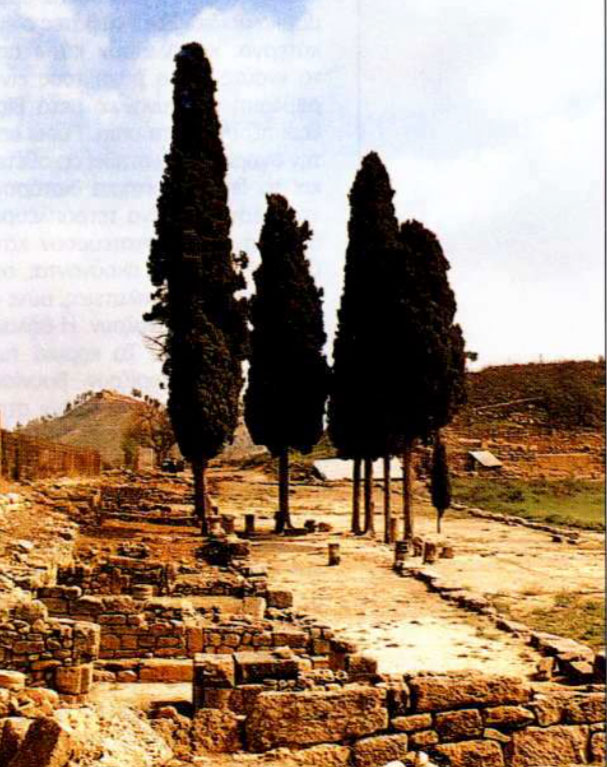 Η βόρεια στοά στη Μοργαντίνη, αποικία των Χαλκιδέων στη Σικελία.
Βιωματική περιγραφή της Μαργαντίνης, της σικελικής αποικίας των Χαλκιδέων στους πρόποδες της Αίτνας. Ο ταξιδευτής, σε αντίστιξη, προσεγγίζει την πόλη μέσα από τις μνήμες που φέρει από την Όλυνθο και, κυρίως, από την Αθήνα. Αλλά και από άλλες πόλεις όπου οι άνθρωποι συζητούσαν διαρκώς. Με λογοτεχνική γραφή αποτυπώνεται μια Μαργαντίνη που μοιάζει ολόκληρη με ορχήστρα θεάτρου, που απλώνεται ολοσκότεινη σαν ψίθυρος.
Η βόρεια στοά στη Μοργαντίνη, αποικία των Χαλκιδέων στη Σικελία.
Βιωματική περιγραφή της Μαργαντίνης, της σικελικής αποικίας των Χαλκιδέων στους πρόποδες της Αίτνας. Ο ταξιδευτής, σε αντίστιξη, προσεγγίζει την πόλη μέσα από τις μνήμες που φέρει από την Όλυνθο και, κυρίως, από την Αθήνα. Αλλά και από άλλες πόλεις όπου οι άνθρωποι συζητούσαν διαρκώς. Με λογοτεχνική γραφή αποτυπώνεται μια Μαργαντίνη που μοιάζει ολόκληρη με ορχήστρα θεάτρου, που απλώνεται ολοσκότεινη σαν ψίθυρος.
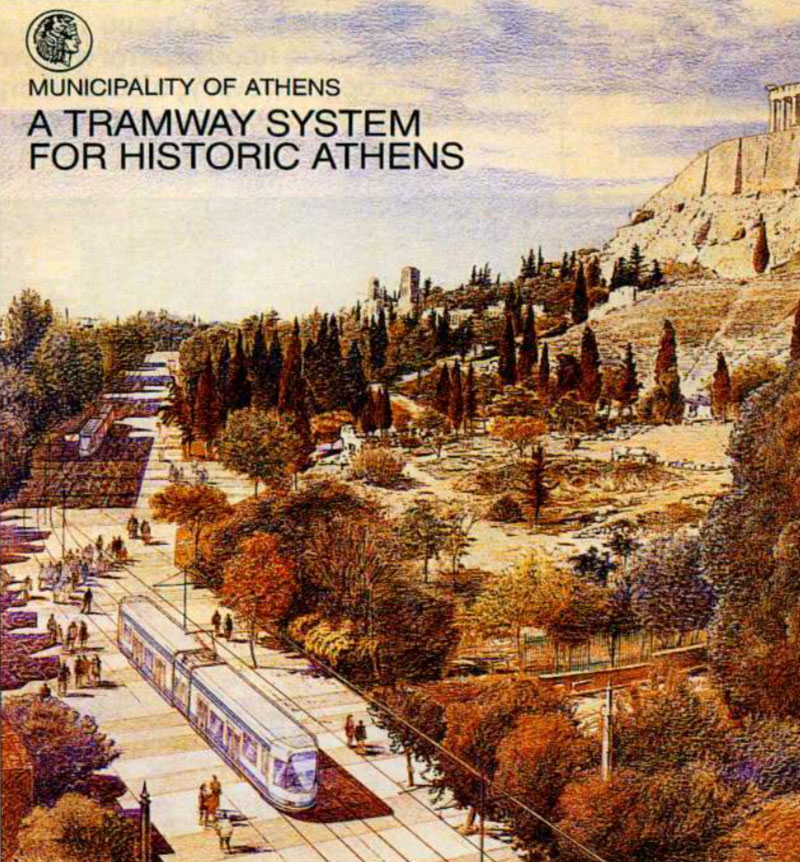 Σκαρίφημα από τη μελέτη του Δήμου Αθηναίων (1990), με σχηματική παρουσίαση της «πεζοδρομημένης» οδού Διονυσίου Αρεοπαγίτου.
Η πολιτιστική ταυτότητα της Αθήνας, μια χαρισμένη κληρονομιά, μένει ακόμη να αναδειχθεί. Με επιμονή προβάλλεται κάποια ασαφής «ενοποίηση» των αρχαιολογικών χώρων, πάρκων, μνημειακών συνόλων και αναδασωμένων λόφων στην καρδιά της πόλης με τη δημιουργία ενός «Πολιτιστικού Πάρκου». Αποσιωπάται όμως ότι η ιδέα, που ενέπνευσε το πρώτο σχέδιο πόλης το 1832, είχε ξαναζωντανέψει τρεις φορές μέσα στον 20ό αιώνα: από τον Mawson το 1919, τον Κώστα Μπίρη το 1946 και την ομάδα Αλέξανδρου Φωτιάδη το 1980.
Στόχος του Πολιτιστικού Πάρκου είναι ο συνδυασμός της μέγιστης δυνατής ανάδειξης της αρχιτεκτονικής κληρονομιάς με την καλύτερη δυνατή οικειοποίηση του πλέγματος πάρκων, αρχαιολογικών χώρων και παλιάς πόλης από τους Αθηναίους αλλά και τους Έλληνες και ξένους επισκέπτες.
Η ιδέα ενός μνημειακού περιπάτου νότια της Ακρόπολης διατυπώνεται ήδη στο «Γενικόν σχέδιον των Αθηνών» (1847) της λεγόμενης «Επιτροπής αξιωματικών». Διαφαίνεται ο στόχος της δημιουργίας ενός περιφερειακού «Βουλεβαρίου» που περιβάλλει στο νότο τόσο την παλιά πόλη όσο και την Ακρόπολη και τον Άρειο Πάγο. Την ώθηση για την κατασκευή του φαίνεται ότι έδωσαν οι ανασκαφικές δραστηριότητες στο θέατρο του Διονύσου, στο Ωδείο Ηρώδου του Αττικού και στη στοά του Ευμένους. Στην αποτύπωση της πόλης από τον C. von Stranz το 1862 αναγνωρίζονται καθαρά όλα τα γεωμετρικά χαρακτηριστικά του νέου περιφερειακού Βουλεβαρίου, που θα μείνουν αναλλοίωτα επί ένα σχεδόν αιώνα (έως το 1955): Το σκέλος της Αποστόλου Παύλου έχει πλάτος 10 μ. και το τμήμα της Διονυσίου Αρεοπαγίτου 15 μ. Και οι δύο οδικοί άξονες ήταν σκυρόστρωτοι ώς την πρώτη δεκαετία του 20ού αιώνα, οπότε ασφαλτοστρώθηκαν επί δημαρχίας Σπύρου Μερκούρη.
Στα μέσα της δεκαετίας του 1920 εγκαθίσταται μια γραμμή ηλεκτρικού τροχιοδρόμου κατά μήκος όλου του «εξοχικού Βουλεβαρίου», με στάσεις στου Μακρυγιάννη, στην πλατεία Ηρωδείου και στο Θησείο. Αφορμή για τον πολεοδομικό σχεδιασμό στην περιοχή δεν θα δώσει η ανάγκη κηποτεχνικής διαμόρφωσης του χώρου γύρω από την Ακρόπολη, αλλά η προσπάθεια βελτίωσης της πρόσβασης των αρχαιοτήτων. Διαφαίνεται τώρα η ανάπτυξη του μαζικού τουρισμού. Το 1954 αναθέτει ο Κωνσταντίνος Καραμανλής τα λεγόμενα «έργα Ακροπόλεως» στον καθηγητή Δημήτρη Πικιώνη. Ο Πικιώνης, χωρίς να επέμβει στη βασική χάραξη του άξονα Διονυσίου Αρεοπαγίτου-Αποστόλου Παύλου, διακριτικά διαμορφώνει τελικές προσβάσεις στα μνημεία της Ακρόπολης για τον πεζό, προσφέροντας την φυσική αλλά και την πνευματική προσέγγιση.
Εδώ και πάνω από μία δεκαετία συζητείται η «πεζοδρόμηση» του άξονα Διονυσίου Αρεοπαγίτου-Αποστόλου Παύλου. Τί όμως είναι επιθυμητό και τι δυνατό; Στο ερώτημα για το μέλλον του ιστορικού Βουλεβαρίου έρχεται να απαντήσει ο κλειστός αρχιτεκτονικός διαγωνισμός ιδεών που πρόσφατα προκήρυξε το Υπουργείο Περιβάλλοντος.
Σκαρίφημα από τη μελέτη του Δήμου Αθηναίων (1990), με σχηματική παρουσίαση της «πεζοδρομημένης» οδού Διονυσίου Αρεοπαγίτου.
Η πολιτιστική ταυτότητα της Αθήνας, μια χαρισμένη κληρονομιά, μένει ακόμη να αναδειχθεί. Με επιμονή προβάλλεται κάποια ασαφής «ενοποίηση» των αρχαιολογικών χώρων, πάρκων, μνημειακών συνόλων και αναδασωμένων λόφων στην καρδιά της πόλης με τη δημιουργία ενός «Πολιτιστικού Πάρκου». Αποσιωπάται όμως ότι η ιδέα, που ενέπνευσε το πρώτο σχέδιο πόλης το 1832, είχε ξαναζωντανέψει τρεις φορές μέσα στον 20ό αιώνα: από τον Mawson το 1919, τον Κώστα Μπίρη το 1946 και την ομάδα Αλέξανδρου Φωτιάδη το 1980.
Στόχος του Πολιτιστικού Πάρκου είναι ο συνδυασμός της μέγιστης δυνατής ανάδειξης της αρχιτεκτονικής κληρονομιάς με την καλύτερη δυνατή οικειοποίηση του πλέγματος πάρκων, αρχαιολογικών χώρων και παλιάς πόλης από τους Αθηναίους αλλά και τους Έλληνες και ξένους επισκέπτες.
Η ιδέα ενός μνημειακού περιπάτου νότια της Ακρόπολης διατυπώνεται ήδη στο «Γενικόν σχέδιον των Αθηνών» (1847) της λεγόμενης «Επιτροπής αξιωματικών». Διαφαίνεται ο στόχος της δημιουργίας ενός περιφερειακού «Βουλεβαρίου» που περιβάλλει στο νότο τόσο την παλιά πόλη όσο και την Ακρόπολη και τον Άρειο Πάγο. Την ώθηση για την κατασκευή του φαίνεται ότι έδωσαν οι ανασκαφικές δραστηριότητες στο θέατρο του Διονύσου, στο Ωδείο Ηρώδου του Αττικού και στη στοά του Ευμένους. Στην αποτύπωση της πόλης από τον C. von Stranz το 1862 αναγνωρίζονται καθαρά όλα τα γεωμετρικά χαρακτηριστικά του νέου περιφερειακού Βουλεβαρίου, που θα μείνουν αναλλοίωτα επί ένα σχεδόν αιώνα (έως το 1955): Το σκέλος της Αποστόλου Παύλου έχει πλάτος 10 μ. και το τμήμα της Διονυσίου Αρεοπαγίτου 15 μ. Και οι δύο οδικοί άξονες ήταν σκυρόστρωτοι ώς την πρώτη δεκαετία του 20ού αιώνα, οπότε ασφαλτοστρώθηκαν επί δημαρχίας Σπύρου Μερκούρη.
Στα μέσα της δεκαετίας του 1920 εγκαθίσταται μια γραμμή ηλεκτρικού τροχιοδρόμου κατά μήκος όλου του «εξοχικού Βουλεβαρίου», με στάσεις στου Μακρυγιάννη, στην πλατεία Ηρωδείου και στο Θησείο. Αφορμή για τον πολεοδομικό σχεδιασμό στην περιοχή δεν θα δώσει η ανάγκη κηποτεχνικής διαμόρφωσης του χώρου γύρω από την Ακρόπολη, αλλά η προσπάθεια βελτίωσης της πρόσβασης των αρχαιοτήτων. Διαφαίνεται τώρα η ανάπτυξη του μαζικού τουρισμού. Το 1954 αναθέτει ο Κωνσταντίνος Καραμανλής τα λεγόμενα «έργα Ακροπόλεως» στον καθηγητή Δημήτρη Πικιώνη. Ο Πικιώνης, χωρίς να επέμβει στη βασική χάραξη του άξονα Διονυσίου Αρεοπαγίτου-Αποστόλου Παύλου, διακριτικά διαμορφώνει τελικές προσβάσεις στα μνημεία της Ακρόπολης για τον πεζό, προσφέροντας την φυσική αλλά και την πνευματική προσέγγιση.
Εδώ και πάνω από μία δεκαετία συζητείται η «πεζοδρόμηση» του άξονα Διονυσίου Αρεοπαγίτου-Αποστόλου Παύλου. Τί όμως είναι επιθυμητό και τι δυνατό; Στο ερώτημα για το μέλλον του ιστορικού Βουλεβαρίου έρχεται να απαντήσει ο κλειστός αρχιτεκτονικός διαγωνισμός ιδεών που πρόσφατα προκήρυξε το Υπουργείο Περιβάλλοντος.
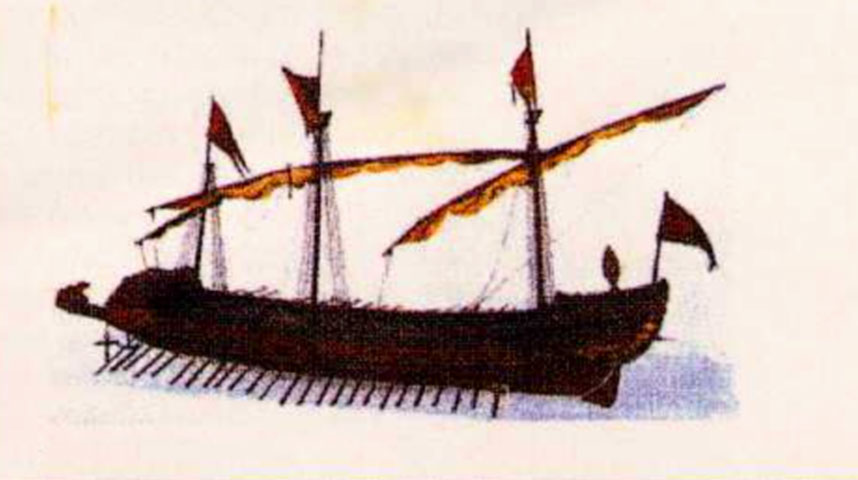 Το VEN.I.V.A. (Venetian Virtual Archives – Εικονικά Βενετικά Αρχεία), που ξεκίνησε τον Νοέμβριο του 1995, χρηματοδοτείται από την Ευρωπαϊκή Ένωση (πρόγραμμα Esprit). Για την υλοποίησή του συνεργάζονται ιδιωτικές επιχειρήσεις και πολιτιστικοί οργανισμοί από την Ιταλία, την Αυστρία και την Ελλάδα. Από ελληνικής πλευράς συμμετέχουν το Πανεπιστήμιο Κρήτης, η εταιρεία παροχής υπηρεσιών πληροφορικής Multimedia System Center, η εταιρεία τηλεπικοινωνιών Intracom, το Ίδρυμα Μελετών Λαμπράκη και το Μορφωτικό Ίδρυμα της Εθνικής Τραπέζης (Ιστορικό και Παλαιογραφικό Αρχείο). Αντικείμενο του έργου αποτελούν τα τεκμήρια που φυλάσσονται σε βιβλιοθήκες και αρχεία. Συγκεκριμένα, το έργο θα επιτρέψει την πρόσβαση σε έγγραφα, χάρτες, αρχιτεκτονικά σχέδια, χειρόγραφα και έντυπα βιβλία, διασκορπισμένα σε αρχεία και βιβλιοθήκες των τριών χωρών. Το ιστορικό πλαίσιο συμπίπτει με αυτό της Γαληνοτάτης Δημοκρατίας της Βενετίας, εκτείνεται δηλαδή από το μεσαίωνα έως το 1797.
Η Βενετία και η θάλασσα: Η αποικιοκρατική αυτοκρατορία της Βενετίας αρχίζει τη μεγάλη της επέκταση στα τέλη του 14ου αιώνα. Το CD-ROM «Η Βενετία και η θάλασσα» είναι η αφήγηση των ιστορικών γεγονότων που συνέβησαν μεταξύ της Γαληνοτάτης Δημοκρατίας και των παραθαλάσσιων κτήσεών της στην Ελλάδα: Κρήτη, Πελοπόννησο, Ιόνια νησιά. Είναι και μια προσπάθεια να καταλάβουμε πώς οι Βενετοί αντιλήφθηκαν, αν όχι ανακάλυψαν, την ταυτότητά τους. Παράλληλα, αποτελεί μια παρατήρηση των κατοίκων των νησιών, των πόλεων και των κάστρων, για να καταλάβουμε τόσο τους τύπους αντίστασης στη βενετική εισβολή όσο και τις ειρηνικές σχέσεις που δημιουργήθηκαν με οικογενειακούς δεσμούς και πιστές συμμαχίες.
Αρχείο: Οι προκαταλήψεις και η ελληνική πραγματικότητα: Τα αρχεία, μαζί με τα μουσεία και τις βιβλιοθήκες, διαφυλάσσουν ένα σημαντικό κομμάτι της ανθρώπινης εμπειρίας. Ωστόσο τα αρχεία είναι πολύ λιγότερο γνωστά από τις άλλες δύο κατηγορίες ιδρυμάτων. Η εικόνα του αρχείου-μαυσωλείου έχει απομακρύνει το ευρύ κοινό από ό,τι δεν είναι παρά η φυσική αντανάκλαση των δραστηριοτήτων ενός νομικού ή φυσικού προσώπου.
Το αρχείο δεν πρέπει να συγχέεται με τη βιβλιοθήκη. Ενώ το βιβλίο, στόχος της συγγραφικής δραστηριότητας, έχει καθαυτό (λογοτεχνική ή επιστημονική) αξία, το τεκμήριο έχει αξία ως μαρτυρία, ως απόδειξη ενός γεγονότος. Το αρχείο δεν περιορίζεται στα έγγραφα αλλά περιλαμβάνει σήμερα ποικίλα υλικά πέρα από το χαρτί, όπως φωτογραφίες, κασέτες, δίσκους, δισκέτες, μικροφιλμ και άλλα μαγνητικά υποστρώματα.
Μια άλλη πλάνη που πρέπει να διαλυθεί είναι ο περιορισμός του αρχείου στα «παλαιά έγγραφα». Η αρχειονομία, παρότι γεννήθηκε στη σκιά των ιστορικών σπουδών, βαθμιαία περιλαμβάνει τα λεγόμενα «ενεργά αρχεία» που παράγονται καθημερινά από ιδιώτες και οργανισμούς και περιμένουν τον ιστορικό του μέλλοντος.
Το ελληνικό κράτος έπρεπε να περιμένει έως το 1914 για να δει την ίδρυση των Γενικών Αρχείων του Κράτους. Αντίθετα, τα Ιόνια νησιά είχαν προ πολλού αποκτήσει «Αρχειοφυλακεία», που ιδρύθηκαν επί βενετοκρατίας και διατηρήθηκαν κατά την περίοδο της αγγλικής Προστασίας. Κατά συνέπεια, η Βενετοκρατία είναι από τις καλύτερα τεκμηριωμένες περιόδους της νεοελληνικής ιστορίας.
Το VEN.I.V.A. (Venetian Virtual Archives – Εικονικά Βενετικά Αρχεία), που ξεκίνησε τον Νοέμβριο του 1995, χρηματοδοτείται από την Ευρωπαϊκή Ένωση (πρόγραμμα Esprit). Για την υλοποίησή του συνεργάζονται ιδιωτικές επιχειρήσεις και πολιτιστικοί οργανισμοί από την Ιταλία, την Αυστρία και την Ελλάδα. Από ελληνικής πλευράς συμμετέχουν το Πανεπιστήμιο Κρήτης, η εταιρεία παροχής υπηρεσιών πληροφορικής Multimedia System Center, η εταιρεία τηλεπικοινωνιών Intracom, το Ίδρυμα Μελετών Λαμπράκη και το Μορφωτικό Ίδρυμα της Εθνικής Τραπέζης (Ιστορικό και Παλαιογραφικό Αρχείο). Αντικείμενο του έργου αποτελούν τα τεκμήρια που φυλάσσονται σε βιβλιοθήκες και αρχεία. Συγκεκριμένα, το έργο θα επιτρέψει την πρόσβαση σε έγγραφα, χάρτες, αρχιτεκτονικά σχέδια, χειρόγραφα και έντυπα βιβλία, διασκορπισμένα σε αρχεία και βιβλιοθήκες των τριών χωρών. Το ιστορικό πλαίσιο συμπίπτει με αυτό της Γαληνοτάτης Δημοκρατίας της Βενετίας, εκτείνεται δηλαδή από το μεσαίωνα έως το 1797.
Η Βενετία και η θάλασσα: Η αποικιοκρατική αυτοκρατορία της Βενετίας αρχίζει τη μεγάλη της επέκταση στα τέλη του 14ου αιώνα. Το CD-ROM «Η Βενετία και η θάλασσα» είναι η αφήγηση των ιστορικών γεγονότων που συνέβησαν μεταξύ της Γαληνοτάτης Δημοκρατίας και των παραθαλάσσιων κτήσεών της στην Ελλάδα: Κρήτη, Πελοπόννησο, Ιόνια νησιά. Είναι και μια προσπάθεια να καταλάβουμε πώς οι Βενετοί αντιλήφθηκαν, αν όχι ανακάλυψαν, την ταυτότητά τους. Παράλληλα, αποτελεί μια παρατήρηση των κατοίκων των νησιών, των πόλεων και των κάστρων, για να καταλάβουμε τόσο τους τύπους αντίστασης στη βενετική εισβολή όσο και τις ειρηνικές σχέσεις που δημιουργήθηκαν με οικογενειακούς δεσμούς και πιστές συμμαχίες.
Αρχείο: Οι προκαταλήψεις και η ελληνική πραγματικότητα: Τα αρχεία, μαζί με τα μουσεία και τις βιβλιοθήκες, διαφυλάσσουν ένα σημαντικό κομμάτι της ανθρώπινης εμπειρίας. Ωστόσο τα αρχεία είναι πολύ λιγότερο γνωστά από τις άλλες δύο κατηγορίες ιδρυμάτων. Η εικόνα του αρχείου-μαυσωλείου έχει απομακρύνει το ευρύ κοινό από ό,τι δεν είναι παρά η φυσική αντανάκλαση των δραστηριοτήτων ενός νομικού ή φυσικού προσώπου.
Το αρχείο δεν πρέπει να συγχέεται με τη βιβλιοθήκη. Ενώ το βιβλίο, στόχος της συγγραφικής δραστηριότητας, έχει καθαυτό (λογοτεχνική ή επιστημονική) αξία, το τεκμήριο έχει αξία ως μαρτυρία, ως απόδειξη ενός γεγονότος. Το αρχείο δεν περιορίζεται στα έγγραφα αλλά περιλαμβάνει σήμερα ποικίλα υλικά πέρα από το χαρτί, όπως φωτογραφίες, κασέτες, δίσκους, δισκέτες, μικροφιλμ και άλλα μαγνητικά υποστρώματα.
Μια άλλη πλάνη που πρέπει να διαλυθεί είναι ο περιορισμός του αρχείου στα «παλαιά έγγραφα». Η αρχειονομία, παρότι γεννήθηκε στη σκιά των ιστορικών σπουδών, βαθμιαία περιλαμβάνει τα λεγόμενα «ενεργά αρχεία» που παράγονται καθημερινά από ιδιώτες και οργανισμούς και περιμένουν τον ιστορικό του μέλλοντος.
Το ελληνικό κράτος έπρεπε να περιμένει έως το 1914 για να δει την ίδρυση των Γενικών Αρχείων του Κράτους. Αντίθετα, τα Ιόνια νησιά είχαν προ πολλού αποκτήσει «Αρχειοφυλακεία», που ιδρύθηκαν επί βενετοκρατίας και διατηρήθηκαν κατά την περίοδο της αγγλικής Προστασίας. Κατά συνέπεια, η Βενετοκρατία είναι από τις καλύτερα τεκμηριωμένες περιόδους της νεοελληνικής ιστορίας.
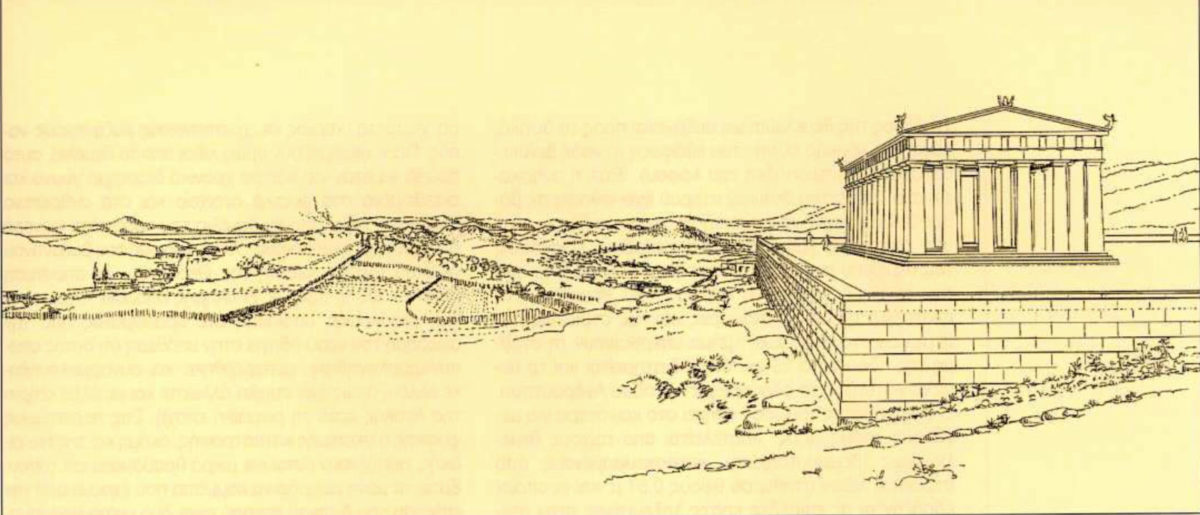 Αναπαράσταση του ναού της Αθηνάς Παλληνίδος. Σχέδιο Μ. Κορρέ.
Η Παλλήνη ήταν η ηγεμονεύουσα πόλη ενός «κοινού» με κέντρο το ιερό της Αθηνάς Παλληνίδος, μιας από τις ελάχιστες θεότητες της αρχαιότητας που είχαν παρασίτους. Ο μεγάλος τους αριθμός, που αναφέρεται σε επιγραφή των μέσων του 4ου αιώνα π.Χ., δείχνει την αίγλη της θεάς και τη μεγάλη απήχηση που είχε το ιερό της στους πιστούς της σε όλους τους δήμους της Αττικής. Σημαντικότατο στοιχείο για τη σπουδαιότητα του ιερού της Αθηνάς στην Παλλήνη είναι η συμμετοχή του «άρχοντα βασιλέα» της Αθήνας στις τελετουργίες που γίνονταν στο ιερό (επί Πυθοδώρου άρχοντος το 431/2).
Πρόκειται για δωρικό, περίπτερο, εξάστυλο ναό των μέσων του 5ου αιώνα π.Χ. με πλάτος 16,35 μ. και μήκος 35,25 μ. Ο αριθμός των κιόνων στις μακρές πλευρές ήταν 13 και το μεταξόνιο 2,685 μ. Το ιερό της Παλληνίδος μνημονεύεται από τον Ησύχιο, τον Αριστοτέλη, τον Ευριπίδη, τον Αριστοφάνη. Την κυριότερη όμως αναφορά κάνει ο Ηρόδοτος, ο οποίος τοποθετεί εδώ τη μάχη του Πεισίστρατου με τους Αλκμεωνίδες (541 ή 539 π.Χ.).
Η Παλλήνη συνδέεται με πολλούς αττικούς μύθους. Είναι το πεδίο της Γιγαντομαχίας, στη διάρκεια της οποίας η Αθηνά σκότωσε τον γίγαντα Πάλλαντα ή, σε άλλη εκδοχή, τη Γοργόνα, σχετίζεται με την ιστορία του Εριχθόνιου και με τον Θησέα και τον συνοικισμό του.
Την αρχαιότητα της λατρείας της Αθηνάς στην Παλλήνη μαρτυρούν τα πτηνόμορφα ειδώλια που βρίσκονται στην επίχωση των θεμελίων του κλασικού ναού, προέρχονται από γειτονικό αρχαϊκότατο ιερό και χρονολογούνται στο τέλος του 8ου, αρχές του 7ου αιώνα π.Χ. Έχουν σχετισθεί με λατρεία πηγαίων νερών, ενώ όσα από αυτά φέρουν κράνος ίσως αποτελούν πρώιμη μορφή της Αθηνάς Ιππίας.
Αναπαράσταση του ναού της Αθηνάς Παλληνίδος. Σχέδιο Μ. Κορρέ.
Η Παλλήνη ήταν η ηγεμονεύουσα πόλη ενός «κοινού» με κέντρο το ιερό της Αθηνάς Παλληνίδος, μιας από τις ελάχιστες θεότητες της αρχαιότητας που είχαν παρασίτους. Ο μεγάλος τους αριθμός, που αναφέρεται σε επιγραφή των μέσων του 4ου αιώνα π.Χ., δείχνει την αίγλη της θεάς και τη μεγάλη απήχηση που είχε το ιερό της στους πιστούς της σε όλους τους δήμους της Αττικής. Σημαντικότατο στοιχείο για τη σπουδαιότητα του ιερού της Αθηνάς στην Παλλήνη είναι η συμμετοχή του «άρχοντα βασιλέα» της Αθήνας στις τελετουργίες που γίνονταν στο ιερό (επί Πυθοδώρου άρχοντος το 431/2).
Πρόκειται για δωρικό, περίπτερο, εξάστυλο ναό των μέσων του 5ου αιώνα π.Χ. με πλάτος 16,35 μ. και μήκος 35,25 μ. Ο αριθμός των κιόνων στις μακρές πλευρές ήταν 13 και το μεταξόνιο 2,685 μ. Το ιερό της Παλληνίδος μνημονεύεται από τον Ησύχιο, τον Αριστοτέλη, τον Ευριπίδη, τον Αριστοφάνη. Την κυριότερη όμως αναφορά κάνει ο Ηρόδοτος, ο οποίος τοποθετεί εδώ τη μάχη του Πεισίστρατου με τους Αλκμεωνίδες (541 ή 539 π.Χ.).
Η Παλλήνη συνδέεται με πολλούς αττικούς μύθους. Είναι το πεδίο της Γιγαντομαχίας, στη διάρκεια της οποίας η Αθηνά σκότωσε τον γίγαντα Πάλλαντα ή, σε άλλη εκδοχή, τη Γοργόνα, σχετίζεται με την ιστορία του Εριχθόνιου και με τον Θησέα και τον συνοικισμό του.
Την αρχαιότητα της λατρείας της Αθηνάς στην Παλλήνη μαρτυρούν τα πτηνόμορφα ειδώλια που βρίσκονται στην επίχωση των θεμελίων του κλασικού ναού, προέρχονται από γειτονικό αρχαϊκότατο ιερό και χρονολογούνται στο τέλος του 8ου, αρχές του 7ου αιώνα π.Χ. Έχουν σχετισθεί με λατρεία πηγαίων νερών, ενώ όσα από αυτά φέρουν κράνος ίσως αποτελούν πρώιμη μορφή της Αθηνάς Ιππίας.
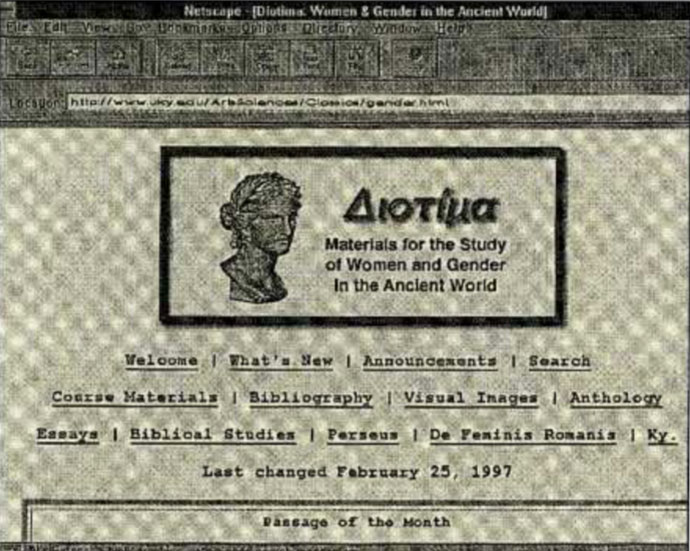 Στις σελίδες του «Διοτίμα» έχουν καταχωριστεί πληροφορίες για τη θέση της γυναίκας στην αρχαία κοινωνία.
Πρόκειται για μια προσπάθεια εντοπισμού «σελίδων» του Internet με περιεχόμενο την ελληνική Τέχνη και Αρχαιολογία. Η συστηματική έρευνα των συγγραφέων διήρκεσε έξι περίπου μήνες. Οι σελίδες προσδιορίστηκαν με τη μέθοδο αναζήτησης με λέξεις κλειδιά μέσω των μηχανών αναζήτησης. Μια προκαταρκτική εξέταση έδειξε ότι οι περισσότερες πληροφορίες παρέχονται από «τροφοδότες υπολογιστές» που εδρεύουν έξω από την Ελλάδα. Όσες σελίδες εντοπίζονται ως προερχόμενες από κόμβους εγκαταστημένους στην Ελλάδα ανήκουν σε κρατικούς φορείς, όπως πανεπιστήμια, υπουργεία και ινστιτούτα, κατά το πλείστον τεχνολογικά. Διαπιστώνεται, δηλαδή, ότι η ελληνική κοινότητα της Τέχνης δεν συμμετέχει στην παρουσίαση στο δίκτυο της δικής της κουλτούρας, και ο ρόλος αυτός έχει αναληφθεί από τρίτα μέρη. Ακολουθεί Κατάλογος Ελληνικών Σελίδων στο δίκτυο με θέματα Τέχνης. Ο κατάλογος απαρτίζεται από τις εξής σελίδες: Acropolis, Artopos, Άννα Μαυρομάτη, Church of Cyprus, Δημοτική Πινακοθήκη Ρόδου, Ηλίας Ηλιάδης, Democritus University of Thrace, Ίδρυμα Μείζονος Ελληνισμού, Internet Art Works, Κέντρο Ερευνών για την Τέχνη και τις Επιστήμες, Κεραμική Τέχνη, Μουσείο Κυκλαδικής Τέχνης, Μουσείο Λαλαούνη, Leucippus, Πελοποννησιακό Λαογραφικό Ίδρυμα, Santorinaios Manthos, Οργανισμός Πολιτιστικής Πρωτεύουσας Θεσσαλονίκης, The Hellenic Civilisation Database, Ulysses (Οδυσσεύς), The Landscape of the God-Trodden Mount Sinai, the Z-project, The Greek Manuscript Database From Bates College και Uranus.
Οι πληροφορίες στο Internet μπορούν να χρησιμοποιηθούν τόσο στην εκπαίδευση όσο και στην έρευνα. Από τις σελίδες που ερευνήθηκαν, ξεχωρίζουν όσες έχουν εκπαιδευτικό υλικό, βιβλία, λογισμικό για διδασκαλία, εξειδικευμένες ηλεκτρονικές βιβλιοθήκες, ηλεκτρονικές εφημερίδες αλλά και καθαρά ερευνητικά θέματα. Δομημένα ψηφιακά αρχεία , όπως το Perseus, επιτρέπουν στους ερευνητές να αναζητούν και να εντοπίζουν το αντικείμενο του ενδιαφέροντός τους. Οι αναζητήσεις αυτές υλοποιούνται γιατί τα βασικά στοιχεία του γραπτού λόγου ορίζονται πλήρως στο περιβάλλον του υπολογιστή. Στα εικονογραφημένα αντικείμενα, όπου η κατάσταση είναι διαφορετική και η αναζήτηση με λέξεις κλειδιά δεν είναι αξιόπιστη, η αναζήτηση γίνεται βάσει του περιεχομένου. Ως ερευνητικά έργα αναφέρονται The Amphoras Project, Ancient Medicine/Medicine Antiqua, The Hellenistic Greek Reference Grammar Project, The Ohio State Excavations at Isthmia και The Pylos Regional Archaeological Project (PRAP).
Το Ψηφιακό Μουσείο αποτελεί μια στροφή στις σχέσεις μεταξύ τέχνης και τεχνολογίας. Τα αντικείμενα τέχνης στον υπολογιστή θεωρούνται απλά αντικείμενα επεξεργασίας πληροφορίας και σε αυτό το νοητικό πλαίσιο στηρίζεται η παρουσία της Τέχνης στο δίκτυο. Αν αυτό ακριβώς το πλαίσιο εγείρει ερωτήματα στους επαγγελματίες των Μουσείων, οι ειδικοί των υπολογιστών έρχονται να τους καθησυχάσουν τονίζοντας τα οφέλη μιας τέτοιας σύζευξης.
Στις σελίδες του «Διοτίμα» έχουν καταχωριστεί πληροφορίες για τη θέση της γυναίκας στην αρχαία κοινωνία.
Πρόκειται για μια προσπάθεια εντοπισμού «σελίδων» του Internet με περιεχόμενο την ελληνική Τέχνη και Αρχαιολογία. Η συστηματική έρευνα των συγγραφέων διήρκεσε έξι περίπου μήνες. Οι σελίδες προσδιορίστηκαν με τη μέθοδο αναζήτησης με λέξεις κλειδιά μέσω των μηχανών αναζήτησης. Μια προκαταρκτική εξέταση έδειξε ότι οι περισσότερες πληροφορίες παρέχονται από «τροφοδότες υπολογιστές» που εδρεύουν έξω από την Ελλάδα. Όσες σελίδες εντοπίζονται ως προερχόμενες από κόμβους εγκαταστημένους στην Ελλάδα ανήκουν σε κρατικούς φορείς, όπως πανεπιστήμια, υπουργεία και ινστιτούτα, κατά το πλείστον τεχνολογικά. Διαπιστώνεται, δηλαδή, ότι η ελληνική κοινότητα της Τέχνης δεν συμμετέχει στην παρουσίαση στο δίκτυο της δικής της κουλτούρας, και ο ρόλος αυτός έχει αναληφθεί από τρίτα μέρη. Ακολουθεί Κατάλογος Ελληνικών Σελίδων στο δίκτυο με θέματα Τέχνης. Ο κατάλογος απαρτίζεται από τις εξής σελίδες: Acropolis, Artopos, Άννα Μαυρομάτη, Church of Cyprus, Δημοτική Πινακοθήκη Ρόδου, Ηλίας Ηλιάδης, Democritus University of Thrace, Ίδρυμα Μείζονος Ελληνισμού, Internet Art Works, Κέντρο Ερευνών για την Τέχνη και τις Επιστήμες, Κεραμική Τέχνη, Μουσείο Κυκλαδικής Τέχνης, Μουσείο Λαλαούνη, Leucippus, Πελοποννησιακό Λαογραφικό Ίδρυμα, Santorinaios Manthos, Οργανισμός Πολιτιστικής Πρωτεύουσας Θεσσαλονίκης, The Hellenic Civilisation Database, Ulysses (Οδυσσεύς), The Landscape of the God-Trodden Mount Sinai, the Z-project, The Greek Manuscript Database From Bates College και Uranus.
Οι πληροφορίες στο Internet μπορούν να χρησιμοποιηθούν τόσο στην εκπαίδευση όσο και στην έρευνα. Από τις σελίδες που ερευνήθηκαν, ξεχωρίζουν όσες έχουν εκπαιδευτικό υλικό, βιβλία, λογισμικό για διδασκαλία, εξειδικευμένες ηλεκτρονικές βιβλιοθήκες, ηλεκτρονικές εφημερίδες αλλά και καθαρά ερευνητικά θέματα. Δομημένα ψηφιακά αρχεία , όπως το Perseus, επιτρέπουν στους ερευνητές να αναζητούν και να εντοπίζουν το αντικείμενο του ενδιαφέροντός τους. Οι αναζητήσεις αυτές υλοποιούνται γιατί τα βασικά στοιχεία του γραπτού λόγου ορίζονται πλήρως στο περιβάλλον του υπολογιστή. Στα εικονογραφημένα αντικείμενα, όπου η κατάσταση είναι διαφορετική και η αναζήτηση με λέξεις κλειδιά δεν είναι αξιόπιστη, η αναζήτηση γίνεται βάσει του περιεχομένου. Ως ερευνητικά έργα αναφέρονται The Amphoras Project, Ancient Medicine/Medicine Antiqua, The Hellenistic Greek Reference Grammar Project, The Ohio State Excavations at Isthmia και The Pylos Regional Archaeological Project (PRAP).
Το Ψηφιακό Μουσείο αποτελεί μια στροφή στις σχέσεις μεταξύ τέχνης και τεχνολογίας. Τα αντικείμενα τέχνης στον υπολογιστή θεωρούνται απλά αντικείμενα επεξεργασίας πληροφορίας και σε αυτό το νοητικό πλαίσιο στηρίζεται η παρουσία της Τέχνης στο δίκτυο. Αν αυτό ακριβώς το πλαίσιο εγείρει ερωτήματα στους επαγγελματίες των Μουσείων, οι ειδικοί των υπολογιστών έρχονται να τους καθησυχάσουν τονίζοντας τα οφέλη μιας τέτοιας σύζευξης.
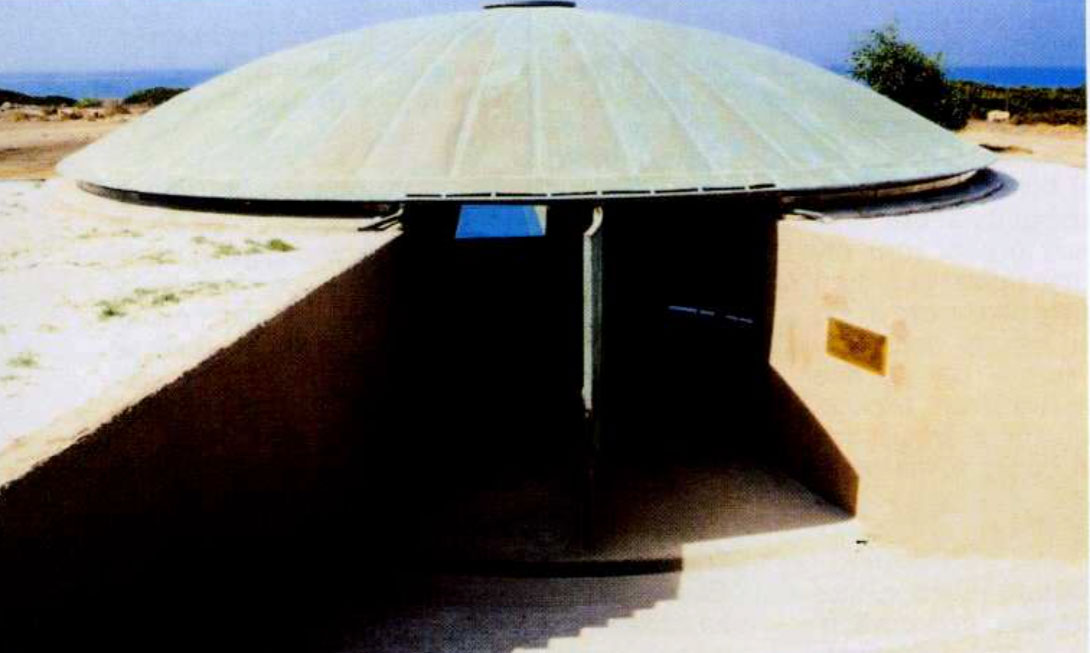 Μάα-Παλαιόκαστρο. Το αρχαιολογικό μουσείο.
Η Μάα-Παλαιόκαστρο, μικρό και άγονο ακρωτήρι στη δυτική ακτή της Κύπρου, είναι ο τόπος που επέλεξαν οι Μυκηναίοι για την πρώτη εγκατάστασή τους στο νησί. Στη θέση, που ανασκάφηκε συστηματικά από τον Βάσο Καραγιώργη, δημιουργήθηκε Μουσείο που κατασκευάστηκε με δαπάνη του Ιδρύματος Α. Γ. Λεβέντη και σε σχέδια Andrea Bruno. Το Μουσείο εγκαινιάστηκε τον Αύγουστο του 1996. Η ανέγερση ενός συμβατικού κτηρίου κρίθηκε αταίριαστη με τον έντονα φυσιοκρατικό χαρακτήρα του χώρου. Η κατασκευή είναι υπόγεια και μόνο η οροφή του είναι ορατή εξωτερικά, ένας χάλκινος θόλος που αναπλάθει τη μορφή των γύρω στρογγυλών θάμνων.
Η έκθεση σχεδιάστηκε με βάση οκτώ θεματικούς άξονες: «Ο χαλκός – πηγή πλούτου για την Κύπρο», «Το εισαγωγικό και εξαγωγικό εμπόριο της Κύπρου κατά το τέλος της εποχής του Χαλκού», «Το τέλος της εποχής του Χαλκού (1230 π.Χ. – 1050 π.Χ.) – μια περίοδος ευημερίας για την Κύπρο», «Σημαντικοί οικισμοί του τέλους της Εποχής του Χαλκού», «Ο οικισμός στη Μάα-Παλαιόκαστρο», «Ζωή και ασχολίες στον οικισμό της Μάας-Παλαιοκάστρου», «Γραφή», «Θρησκεία».
Ο φωτισμός του χώρου είναι φυσικός και βασίζεται στην αρχική έμπνευση του αρχιτέκτονα, ένα μακρύ κεκλιμένο κάτοπτρο που αντανακλά το εξωτερικό φως και το μεταφέρει στην υπόγεια αίθουσα. Ιδιαίτερα ασυνήθιστες είναι οι προθήκες, κατασκευασμένες από μια ημισφαιρική βάση από πωρόλιθο, επάνω στην οποία στηρίζεται ένας ανεστραμμένος κώνος από ατσάλι. Η ανεστραμμένη κυκλική βάση του κώνου προσφέρεται ως εκθετική επιφάνεια για δυο χάρτες και μια αεροφωτογραφία του ακρωτηρίου της Μάας, ενώ με την προσθήκη ενός κυλίνδρου από πλεξιγκλάς μετατρέπεται σε προθήκη για τα εκθέματα, αντίγραφα των αρχαιολογικών ευρημάτων.
Μάα-Παλαιόκαστρο. Το αρχαιολογικό μουσείο.
Η Μάα-Παλαιόκαστρο, μικρό και άγονο ακρωτήρι στη δυτική ακτή της Κύπρου, είναι ο τόπος που επέλεξαν οι Μυκηναίοι για την πρώτη εγκατάστασή τους στο νησί. Στη θέση, που ανασκάφηκε συστηματικά από τον Βάσο Καραγιώργη, δημιουργήθηκε Μουσείο που κατασκευάστηκε με δαπάνη του Ιδρύματος Α. Γ. Λεβέντη και σε σχέδια Andrea Bruno. Το Μουσείο εγκαινιάστηκε τον Αύγουστο του 1996. Η ανέγερση ενός συμβατικού κτηρίου κρίθηκε αταίριαστη με τον έντονα φυσιοκρατικό χαρακτήρα του χώρου. Η κατασκευή είναι υπόγεια και μόνο η οροφή του είναι ορατή εξωτερικά, ένας χάλκινος θόλος που αναπλάθει τη μορφή των γύρω στρογγυλών θάμνων.
Η έκθεση σχεδιάστηκε με βάση οκτώ θεματικούς άξονες: «Ο χαλκός – πηγή πλούτου για την Κύπρο», «Το εισαγωγικό και εξαγωγικό εμπόριο της Κύπρου κατά το τέλος της εποχής του Χαλκού», «Το τέλος της εποχής του Χαλκού (1230 π.Χ. – 1050 π.Χ.) – μια περίοδος ευημερίας για την Κύπρο», «Σημαντικοί οικισμοί του τέλους της Εποχής του Χαλκού», «Ο οικισμός στη Μάα-Παλαιόκαστρο», «Ζωή και ασχολίες στον οικισμό της Μάας-Παλαιοκάστρου», «Γραφή», «Θρησκεία».
Ο φωτισμός του χώρου είναι φυσικός και βασίζεται στην αρχική έμπνευση του αρχιτέκτονα, ένα μακρύ κεκλιμένο κάτοπτρο που αντανακλά το εξωτερικό φως και το μεταφέρει στην υπόγεια αίθουσα. Ιδιαίτερα ασυνήθιστες είναι οι προθήκες, κατασκευασμένες από μια ημισφαιρική βάση από πωρόλιθο, επάνω στην οποία στηρίζεται ένας ανεστραμμένος κώνος από ατσάλι. Η ανεστραμμένη κυκλική βάση του κώνου προσφέρεται ως εκθετική επιφάνεια για δυο χάρτες και μια αεροφωτογραφία του ακρωτηρίου της Μάας, ενώ με την προσθήκη ενός κυλίνδρου από πλεξιγκλάς μετατρέπεται σε προθήκη για τα εκθέματα, αντίγραφα των αρχαιολογικών ευρημάτων.
In archives, together with museums and libraries, an important section of human experience is preserved. However, archives are less well-known to us than the other two categories of institutions. The main obstacle to the acquaintance of the public with the records and documents kept in the archives is the picture that the average citizen has of the archives and their use. The term archive has three different, distinct meanings, that of an entity of records and documents, the archival service, and the building in which archives are housed.In the study of archives, the scientific branch of organizing and handling archives, archives are defined as "the entity of records and documents, regardless of date, material and format, which have been accepted or produced by a person or legal body in context of his activities." Archives must not be confused with libraries and are not confined to written records and documents. The study of Archives although born in the shadow of the Historic Studies, has gradually included in its field the so-called "active archives". In Greece archives and archival institutions are held in low esteem. Important documents have been destroyed for historical reasons or because of organizational weakness. However, in the archival institutions of the Ionian islands, first established by the Venetians, an important amount of precious documents are preserved.
Overall consideration of urban transformation during the mid-war period —as discussed in the previous article— leads us to the conclusion that full rehabilitation of the huge number of refugees was achieved in spite of the unfavourable conditions that prevailed both in the country's finances and in the media. On the other hand, the negative effects of this matter should not be ignored. These are mainly the pernicious, for the planning of settlements in Athens in particular, interference of private entrepreneurial activity in the public sector, its interference with the Ministry of Public Works and the municipal authorities. The then head of the Architectural Service of the Municipality of Athens, in his unpublished diary describes the various unlawful efforts of companies, such as the construction company "Kypriadis-Kyriazis & Co.", to ensure that the urban planning of private estates lying outside the approved city-plan should be undertaken by them. He makes a thorough reference to the pressure exercised on the heads of the Urban Planning Service at that time (early 1920s), to allow the owners of the estates to accomplish their objectives. In this way, an irrational and obviously destructive expansion of the city in all directions was initiated.
Two hundred years have passed since the first observations on the deterioration of animal bones from Paleontological finds were made. New remarks were later added to these, this time concerning isolated cases of human skeletal remnants. Today the science of Paleopathology studies entire population groups and tries to shed ample light on the health condition of earlier societies, through the team-work of American and English researchers,who are pioneers in the field. The information supplied by the study of bones is especially useful and equally important to that coming from the study of ceramics, metals and architectural remains. Teeth and bones are extremely resistable to various forms of deterioration and sometimes they serve as the only indication of the existence and activity of a person. The picture of health of earlier societies enables archaeologists to understand the effect of the environment and life conditions on man and also his efforts to face the adversities of nature. In the 1980s and 1990s a series of rescue excavations in the city of Chania brought to light a great number of graves dating from the historic years. The forty-two skeletons which served as our sample, come from Hellenistic burials. Most of the graves date from the first half of the third century BC as is proven by the offerings accompanying the deceased (pottery, coins, etc). This sample enable us to form a picture of the condition of health and the various diseases suffered by the population that is buried in the cemetery we have studied.
During the three decades of the twentieth century (1914-1940) which began and ended with the two World Wars and culminated in the Asia Minor Catastrophe, a series of events heralding the social, cultural and urban developments that follow are to be detected in all areas. In this period, the so-called ''urban phenomenon" goes through a phase of exceptional importance. The approach to such a complex matter not only has different scientific fields as its starting point , but also leads to many, occasionally conflicting, results. However, the diverse opinions converge into the following conclusions. The relationship of the "centre" to the "periphery" becomes hierarchical, with Athens, the capital, as the commercial, administrative, political and cultural ''summit". The fleeing of the agrarian population to the cities and the formation of urban working classes, are both connected to overseas emigration and the arrival of immigrants from Asia Minor, and present particularities. The evolution of towns and cities, and mainly of the capital, mirrors this peculiar mode of development. The incoming wave of refugees left its mark both on the country-side and on urban settlements, swelled the numbers both in the working and ruling classes, and contributed to the overgrown development of the capital and to the growth of social inequalities in the capital city. At the same time, the technical progress of the age had a decisive effect on the modern, mid-war towns and cities. The urban tissue undergoes transformations, mainly due to the extreme pressure of the newly arrived population, towns are extended in a controlled manner, there is an increase in settlement and building activity, the basic legislative rules concerning the city's functions are set. Due to state intervention and the development of private initiative, phenomena both praiseworthy (social housing) and negative (illegal building) appear. All the above affect the form of the town and city, and their impact can be felt down to our day.
The study of towns and villages in the first period of Ottoman rule (c. 1450-c. 1650) contributes to the Greek historiography of a period our knowledge of which is both incomplete and fragmentary. This article focuses on certain sectors of social and economic history and is based on data that has been drawn mainly from Ottoman archival sources, some of which are published here for the first time. Due to the conditions created by the exercise of Ottoman feudal power and the new terms of landowning, the towns and villages experienced a strong burst of development. This can be seen not only in the positive demographic changes - which are, as a matter of fact most impressive - but also in the magnitude of production, both agrarian and manufactural of the time. Towns as well as villages are examined, both in context of different regions and as entities that complement one another - constituting local-regional districts Given the relation of the town with its rural hinterland, for the interpretation of the developmental changes attention must also be given to the conditions of the division of labour between urban and rural areas, and to the obligatory transfer of population from one city or region to another practised by the Ottomans. However, after the middle of the sixteenth century the favourable climate for the development of towns and villages was progressively replaced by negative factors, such as extra taxes being levied.This had a negative effect on the productive population, exacerbated by the generally adverse circumstances, such as wars, epidemics, currency devaluation. Under such circumstances certain towns and villages experienced a decrease of population, the hierarchy of the settlement network was reversed and the unity of town and village was destroyed. The changes in the built space of towns after the Ottoman conquest are remarkable, not only because the towns were extended outside the limits of the late Byzantine - Frankish period, but also because the urban tissue, especially in the large towns, was radically remodelled. The organisation of the dwelling areas in machalades (neighbourhoods), the formation of the town centre as a strong urban entity, with a significant number of public buildings and the introduction of principles regulating the relation of urban functions and also the network connecting the town with its rural hinterland are characteristics of a new urban reality. The latter was created during the first decades of Ottoman rule and affected all the relevant developments thereafter.
In a study of the art sites on the World Wide Web, a number of sites with links, electronic resources, texts and images about Greek art and archaeology were collected from various art home-pages on the WWW. Analysis of the characteristics of these art sites was used to develop a list of online Greek artspace. The analytic categories which were developed inductively and the material included in each site, give us some idea of the dimensions of online presentation, the educational, technological, and communication capabilities of the Web in this area and leaves little doubt that it should act as a a stimulus to Greek museums and to the Classics Departments of Greek Universities to use this tool. A preliminary review of the features of the Greek Art Site on the Web, the details of which are provided below, indicates that most information is provided by servers established in areas outside Greece with the majority in Universities of the U.S. The majority of those sites established in Greece belong to state organisations such as universities, ministries and institutions mostly of a technological nature. No site belongs to a server of museums, galleries or art establishments. Thus the first impression is that the Greek art community does not contribute to the presentation of its own art on the Internet and this role has been undertaken by third parties The list provided here is a reasonable point of departure for educators or art historians interested in investigating these issues and the tools available today for using the Web as an adjunct to teaching and research. The list's classes of resources identify the predominant strains of activity related to Greek art history on the Web today and in each case provides the site's address on the Internet. If you are working with the WWW. most of the hypertext links provided in this paper, are built ready for clicking on at the address: http://www.ipml.duth.gr/surf -22g.html.
Man's agony over his fate and future fortunes is a primeval phenomenon. Powerful natural phenomena such as bad weather menacing crops, animals and human life, disease and unexplained death, malevolent thoughts and envy are some of the reasons for preserving this agony. Since to deal thoroughly with all relevant customs and beliefs would be an impossible task, this article confines itself to a selective approach, mainly on the basis of inscriptions which prove the antique origin of certain customs.
Greek settlements' tendency to transform, as well as transformation in the structure and role of urban centres and their relation with rural settlements are analyzed in this article. By the mid-1970s, the system and the urban structure of settlements, as they formed in Greece after 1950 , showed strong tendencies of regional diffusion both in urban centres and in rural settlements. After the single-city domination of the metropolitan capital city of Athens, a system of two metropolitan centres (Athens-Thessaloniki) and of seven to eight regional urban poles of attraction have formed today; the rest of the towns exert an influence on a rural radius, which has already been reinforced with certain local agricultural centres. A series of economic parameters, especially that of tourism, are responsible for the regional diffusion of urbanization in wide areas around towns and along coastal areas. The monocentric urban tissue changes due to the extent of housing and trade,it is also affected by relocation of industries.In addition, new housing areas of a suburban type are in demand in new or other peripheral rural settlements. The coastal areas of vacation homes are becoming rapidly urbanized, thus creating complicated problems in the mobility of production and in infrastructures. In addition new economic and social phenomena affect the mobility, the way and quality of life of the inhabitants. Urban formations are few and far between, they absorb rural vitality, but also reflect the countryside thus creating a new framework for the design and planning of cities.
After the redistribution of farm land and the assignment of the fertile fields to the Ottoman feudal lords following the Turkish occupation of Greece, a major demographic restructuring took place. The Greek population sought refuge in mountainous areas, especially those of Western Macedonia and Epirus. In their new homes, after a period of adjustment, these refugees developed activities, quite different from those they had practised until then. Their manufacturing occupations and corporations, that already appear in the fourteenth to fifteenth century, prospered remarkably in Macedonia and Thessaly during the eighteenth and nineteenth centuries. The purpose of this article is to detect the forms of the older settlements, the probable reasons for their abandonment and the transfer of the population to new sites. The situation in Thessaly is similar to that in Macedonia and the Peloponnese, where the mountainous settlements are reinforced with new populations that seek refuge from the plains to the mountains. From the fifteenth century onward the church and its adjacent small square essentially become the nucleus of the settlement. Many members of these communities become merchants, others emigrate to Constantinople, Venice and the cities of the Austro-Hungarian empire, where they trade in manufactured products, especially red yarns and finished leather, brought by caravans that originate in Macedonia. From the late seventeenth century this economic boom is also reflected in the structure of the settlements. It is then that the richest manors appear, in Northern Greece in particular, while the traditional postbyzantine construction and architectural typology is continued in the Peloponnese. Special attention is paid to the internal activities of the settlement unit and to its financial relation with the hinterland. The phenomenon of the grouping of these mountainous refuges and the professional specialisation of their inhabitants (barrel-makers, builders, wood-carvers, painters, silversmiths, metal workers, etc.) are examined as well.
Its unique cultural features are what make the city of Athens as important and prestigious as Rome or Constantinople. Where other cities of Central Europe try to stress such features in every way, for the Greeks this is an endowed heritage and the reason for Athens becoming the capital of Greeece in our times. The promotion of this cultural identity has recently become a major issue. The vague schema for the unification of archaeological sites, parks, monumental complexes and reforestrated hills in the center of the city, thus creating a "Cultural Park" is consistently mentioned, but what is concealed is that this idea is not new at all. The main concept of the cultural park lies in the combination of maximum promotion of culture with the optimum familiarization of both Athenians and foreign visitors with the old city's complex of parks and archaeological sites. This combination seems desirable, but its realization encounters serious obstacles, mainly town-planning ones. The transformation of the Dionysios Areopagitis-Apostolos Pavlos axis to a pedestrian zone is being discussed now for over a decade, although it is not clear what the best choice would be, making the area a pedestrian precinct, the gradual suppression of traffic or replacement by another network of pedestrian areas? The architectural competition, under the auspices of the Ministry of Environment, will most probably supply the best of answers to this question about the future of the historic boulevard.
The VEN.I.V.A. (Venetian Virtual Archives) project started in November 1995 and is being financed by the European Union through the ESPRIT program which is responsible for innovations in technology. Private firms and cultural organizations from three European countries —Italy, Austria, and Greece— collaborate towards realization of the project. The material dealt with by VEN.I.V.A. is the various records and documents, dating from the Medieval period to 1797, that are kept in libraries and archives. VEN.I.V.A. aims at the creation of a consultation system of archival and bibliographic material belonging to different organizations, which will be available on the Internet. The organizations will be virtually connected so that both on-site and on-line users will have access to the same documents through a series of free and added-value services. There is a description of the VEN.I.V.A. project in the http://www.tin.it/veniva, and a first presentation of the "virtual archive" at the net address http:// www.tin.it/ veniva/aw/archivto/isp/veniva.htm.
The foundations of the Athena Pallenis temple, located during a rescue excavation by the II Ephorate of Prehistoric and Classical Antiquities, are being excavated at Stavros, Hagia Paraskevi, at the intersection of Androutsou and Zalogou streets since 1994. Made of limestone, the foundations belong to a doric hexastyle temple of around the mid-fifth century BC. The temple has been assigned by M. Korres to the well-known "architect of Theseion", since it displays all the characteristics, typical of the other templed buildings that he created (temple of Poseidon at Cape Sounion, temple of Hephaistus at Theseion, temple of Nemesis at Ramnous). The very good preservation of the foundation walls allows a more or less accurate representation of the plan and superstructure of the temple. A large section of its southwestern and a smaller one of its north-western corner has unfortunately been destroyed by modern buildings, since the temple lies in a residential area in which systematic building inspection has only recently been established . The dimensions of the crepis are 36.25 x 16.35 m. while the foundations are preserved up to the fifth block of stone at the western side of the building. The sanctuary of Athena Pallenis was one of the most famous rural shrines of antiquity. The Archaic temple, of the age of Pesistratus, is mentioned by ancient authors such as Herodotus, Aristotle, Euripides, Aristophanes and others, but it has yet to be located. The area of ancient Palleni is also related to many ancient myths, such as the Gigantomachy, the Heracleids, and the myth of Theseus. According to local epigraphical data the sanctuary and temple of Athena Pallenis was the center of a federation in which Palleni, Gargettos, Paiania and propably Acharnes belonged and which lasted from the Archaic to the Roman period. Many marble members of the temple have been walled into Christian churches of the region, while only a few marble elements from its superstructure have been found in situ. This fact and the verified by excavational data termination of the temple's function in the Roman era leads to the conclusion that the sanctuary was very probably transferred to another, better location, as is also the case with other temples, a custom prevalent in the years of Augustus' reign. A depository of Geometric clay, bird-form figurines (8th-7th century BC) and various other clay and bronze offerings were excavated to the east of the temple in the last two years. The finds certify the existence of an important cult at the site, propably that of Athena Hippeia at an early stage.
After 1830, the networks of the urban centres of the new Greek state were remodelled due to redistribution of financial activities and the need to create an effective political and economic mechanism. Two main phases in the history of nineteenth-century Greek towns can be distinguished; the first coincides with the years of Kapodistrias' administration (1828-1832), the Regency and King Otto's reign (until 1843), the second lasts from 1856 to 1912. Kapodistrias and the Regency intended to apply a town-planning policy in the steps of functionalist European Neoclassicism. This town-planning concept served as a break with the past, on various ideological, institutional and morphological levels, and was the model used in the planning of major towns in the urban network inherited from the Ottoman period and in particular for the new capital. After 1856 the brunt of urban planning focused on both small and major towns with developmental potential, such as towns which were centres for raisin picking and exportation on the north and west coasts of the Peloponnese. At the same time the country's institutions became more regular and important public works were constructed (national road and railway networks, the Corinth Canal). New town-plans had a simple orthogonal composition with characteristic provision of public amenities for the town and its harbour. It is probably more closely related to the proposals for the cities of the new Balkan nation states than with those of Europe, where the industrial city had already posed altogether different problems to be solved.
Writing, an organized ensemble of signs or symbols, enables its users to record human thought and speech with clarity and to communicate with each another, regardless of local or temporal distance. The most important function of writing in developed societies is for the transmission of knowledge, since nowadays knowledge spreads mainly through the written word. In our time, at least in the case of Western-type societies, the learning of reading and writing is considered self-evident and the absolute right and obligation of all children of a school age. Investigation into the improvement of writing skills with artistic and cultural elements led to the creation of an elaborate "polytechnon" working plan,where motion, painting, poetry, and fairy-tales, are used as teaching aids in the introduction to the materials and devices of writing.
The colonial Venetian Empire starts its great expansion in the late fourteenth century. The CD-ROM "Venice and the Sea" is the narration of the historic events concerning the Serenissima Republic and its marine colonies in Greece, namely Crete, the Peloponnese and the Ionian Islands. This centuries long history was affected by financial and commercial factors, the complicated relations between the Venetian administrators and the various Greek social classes, and by the necessity of defence against the Turkish threat.
In this article life in colonial Morgantini is described in attractive literary style, and information on metropolitan Athens is supplied as well.
During the late period of Ottoman rule in the Balkans (18th-19th c), the great financial and imperialistic development of the powerful European states, in combination with the imminent partition of the once mighty Ottoman Empire, allowed the signing of international trade treatises, which were humiliating for Turkey and most advantageous for Europe. These treatises contributed decisively to the revival of the network of Greek settlements, in spite of the low levels of development of the country' s productive forces. The Greek settlement network shows two periods of development that of 1700 to 1821/27 and of the years 1821/27 to1913. At the end of the first period (1774-1821/27) there is a general, rapid economic development and activity to be found, mainly located in the manufacturing centres of Northern Greece,in the fertile currant-producing plains of the Peloponnese, and the naval islands of the Aegean. During the first period a type of unplanned settlement prevails, either in the form of a rural settlement, following local social functional / aesthetic principles (simple type (one neighbourhood), complex type (many neighbourhoods), water-front (a linear type), or in the form of a town (market town, company town). The town marketplace is formed in the years of the Ottoman rule on the basis of the ethnic and religious complexity of the urban social structure of the Balkans (neighbourhoods where different nationalities live separately; Christians, Muslims, Jews, etc). Ottoman culture was predominant in this kind of town (e.g. Ioannina). The town which is run by a company, succeeds the earlier model, introducing modernization to urban space according to the European models of design, while predominant in this town is Greek (Christian) retail culture (e.g. Thessaloniki). During the second period a dichotomy in the network of Greek settlements appears, which is due to the creation of the national state in Southern Greece (1821-1827). Thus, in the northern region limited urbanization and the model of the company town continues, with all its external influences and internal contradictions; while in the new state in southern Greece neoclassical cities are designed and introduced for political, ideological and social reasons. In the beginning, a limited urbanisation and polarisation appears in Athens (1821-1880), while in the next stage polarisation grows and Athens starts growing excessively (1880-1907/13). The built-up areas of Southern Greece are renovated -174 settlements (numbering 500 to 20.000 inhabitants), acquire a new town plan by 1912— and obtain a homogeneity in design and aesthetics, following neoclassical precepts.
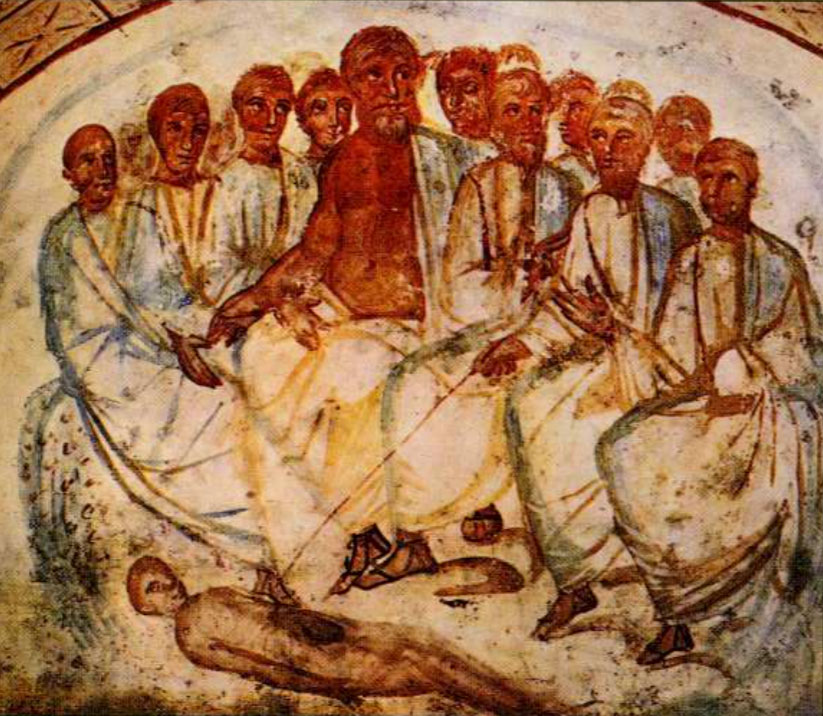 Παλαιοχριστιανική τοιχογραφία στην κατακόμβη της Via Latina. Εικονίζονται ο Αριστοτέλης και οι μαθητές του να φοράνε σανδάλια.
Τα σάνδαλα ή σανδάλια ή πέδιλα αποτελούνται από το κάττυμα (σόλα), συνήθως από δέρμα βοδιού σε ένα ή περισσότερα επάλληλα στρώματα, και από τους ιμάντας (λουριά), συνήθως από γιδοτόμαρο. Γνωστά είδη σανδαλιών ήταν αι βλαύται, αι βαυκίδες, αι ευμαρίδες, αι περσικαί, κ.ά. Τα αιγυπτιακά και τα μεσοποταμιακά πέδιλα δεν είχαν ιμάντες και έμοιαζαν αρκετά με τις σημερινές σαγιονάρες. Σάνδαλα βλέπουμε να φορούν Μινωίτες και οι θεοί στα κλασικά χρόνια. Όταν ήταν εξάρτημα επίσημου ενδύματος, το σανδάλι είχε περίτεχνα λουριά, διακοσμημένα και στιλβωμένα.
Βασικό στοιχείο υπόδεσης σε όλη τη Ρωμαϊκή περίοδο, τα ρωμαϊκά πέδιλα ήταν πολυτελέστερα. Κάποιοι τύποι τους χρησιμοποιήθηκαν από τον ρωμαϊκό στρατό.
Παλαιοχριστιανική τοιχογραφία στην κατακόμβη της Via Latina. Εικονίζονται ο Αριστοτέλης και οι μαθητές του να φοράνε σανδάλια.
Τα σάνδαλα ή σανδάλια ή πέδιλα αποτελούνται από το κάττυμα (σόλα), συνήθως από δέρμα βοδιού σε ένα ή περισσότερα επάλληλα στρώματα, και από τους ιμάντας (λουριά), συνήθως από γιδοτόμαρο. Γνωστά είδη σανδαλιών ήταν αι βλαύται, αι βαυκίδες, αι ευμαρίδες, αι περσικαί, κ.ά. Τα αιγυπτιακά και τα μεσοποταμιακά πέδιλα δεν είχαν ιμάντες και έμοιαζαν αρκετά με τις σημερινές σαγιονάρες. Σάνδαλα βλέπουμε να φορούν Μινωίτες και οι θεοί στα κλασικά χρόνια. Όταν ήταν εξάρτημα επίσημου ενδύματος, το σανδάλι είχε περίτεχνα λουριά, διακοσμημένα και στιλβωμένα.
Βασικό στοιχείο υπόδεσης σε όλη τη Ρωμαϊκή περίοδο, τα ρωμαϊκά πέδιλα ήταν πολυτελέστερα. Κάποιοι τύποι τους χρησιμοποιήθηκαν από τον ρωμαϊκό στρατό.
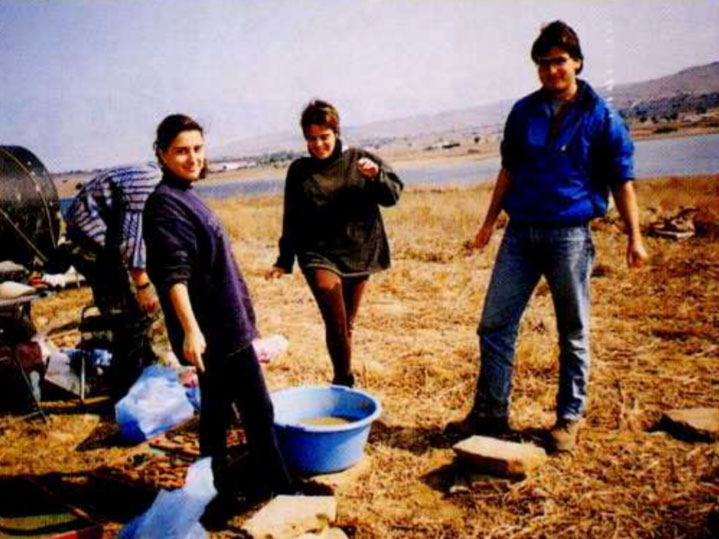 Αριστερά βρίσκονται τα κεραμικά που οι συντηρητές έπλυναν με γλυκό νερό μέσα στις γαλάζιες λεκάνες.
Στη διάρκεια μιας ανασκαφής οι αρχαιολόγοι βρίσκουν πρώτα κομμάτια από αγγεία ή από δουλεμένη πέτρα που έσπασαν όταν οι άνθρωποι που έζησαν αργότερα κίνησαν τα χώματα. Πιο βαθιά βρίσκουν θεμέλια ή και τμήματα κτιρίων ή τάφους. Τότε καθαρίζουν το χώρο από τα μπάζα και σχεδιάζουν την κάτοψή του. Το χώμα που βγαίνει από το σκάψιμο κοσκινίζεται ώστε να μην ξεφύγει το παραμικρό στοιχείο. Όσα κινητά ευρήματα έρχονται στο φως καθαρίζονται, σχεδιάζονται, φωτογραφίζονται, χρονολογούνται και καταγράφονται στο ημερολόγιο της ανασκαφής. Αφού συντηρηθούν, κάποια θα πάνε στις προθήκες και κάποια στις αποθήκες του μουσείου.
Αριστερά βρίσκονται τα κεραμικά που οι συντηρητές έπλυναν με γλυκό νερό μέσα στις γαλάζιες λεκάνες.
Στη διάρκεια μιας ανασκαφής οι αρχαιολόγοι βρίσκουν πρώτα κομμάτια από αγγεία ή από δουλεμένη πέτρα που έσπασαν όταν οι άνθρωποι που έζησαν αργότερα κίνησαν τα χώματα. Πιο βαθιά βρίσκουν θεμέλια ή και τμήματα κτιρίων ή τάφους. Τότε καθαρίζουν το χώρο από τα μπάζα και σχεδιάζουν την κάτοψή του. Το χώμα που βγαίνει από το σκάψιμο κοσκινίζεται ώστε να μην ξεφύγει το παραμικρό στοιχείο. Όσα κινητά ευρήματα έρχονται στο φως καθαρίζονται, σχεδιάζονται, φωτογραφίζονται, χρονολογούνται και καταγράφονται στο ημερολόγιο της ανασκαφής. Αφού συντηρηθούν, κάποια θα πάνε στις προθήκες και κάποια στις αποθήκες του μουσείου.
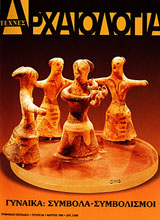
 Θρηνωδοί σε ταφική λάρνακα από την Τανάγρα.
Είναι η υπέρκομψη «Παριζιάνα» της Κνωσού γυναίκα-αντικείμενο;
Η συγγραφέας διατρέχει τη μακρά περίοδο από την Προϊστορία ως την ιστορική εποχή αξιοποιώντας κριτικά το υλικό της εικονογραφίας και τα συμπεράσματα της Εθνολογίας. Καθοριστική είναι η φρέσκια ματιά της φεμινιστικής ανθρωπολογίας που αναδεικνύει την κοινωνική ταυτότητα των γυναικών, παραμερίζοντας την αξιωματική θέση ότι η βιολογία τους τις καθορίζει. Συζητείται ως παντελώς αστήρικτη η θεωρία περί μητριαρχίας και η παρερμηνεία των γυναικείων παλαιολιθικών ειδωλίων που την ενθάρρυνε. Την αυθαίρετη υπόθεση της γυναικοκρατίας αντικαθιστά μια κοινωνία με «μητριστικά» χαρακτηριστικά που διακρίνεται για τη συλλογικότητα, την τελετουργική της διάσταση και τη συγκρότησή της με βάση τα γένη. Γυναικοκρατία δεν συνεπάγεται ούτε καν η μητρογραμμική γενεαλόγηση. Μια «μητριστικού» χαρακτήρα κοινωνία ερμηνεύει την εξάπλωση των γυναικείων ειδωλίων και στη Νεολιθική εποχή, όταν η καλλιέργεια του εδάφους, η κατασκευή εργαλείων, η εφεύρεση της αγγειοπλαστικής και η επινόηση της υφαντικής συμβάλλουν στην αυξημένη κοινωνική σπουδαιότητα της γυναίκας. Στην Παλαιοανακτορική Κρήτη, προς το παρόν λανθάνουν οι συνθήκες που δημιουργούν πατριαρχικούς θεσμούς: η εξάλειψη των γενών και η εμφάνιση συγκεντρωτικού κράτους και ισχυρής πολεμικής τάξης. Τη χαρακτηριστική γονιμική εικονογραφία της Προανακτορικής εποχής αντικαθιστούν τα ειδώλια λατρευτών στα ιερά κορυφής. Η τυποποιημένη ενδυμασία και κόμμωση των γυναικών συμβολίζει την ομαδική κοινωνική τους ταυτότητα και την ταυτότητα του γένους τους. Το ταξικά οργανωμένο κοινωνικό σύστημα είναι φανερό σε τοιχογραφίες της Κνωσού και της Θήρας από τη Νεοανακτορική περίοδο. Αυτό δηλώνουν και οι ενδυματολογικές διαφοροποιήσεις των ειδωλίων στα ιερά κορυφής. Με εξαίρεση το γυμνό στήθος που προβάλλει από το ανοιχτό περικόρμιο και συνδέεται αποκλειστικά με θρησκευτικές και τελετουργικές παραστάσεις, η κομψή και πολυτελής γυναικεία ενδυμασία μπορεί να ερμηνευτεί ως μια πρώτη εξάρτηση της γυναίκας από τον άντρα, καθώς τώρα τα γνωρίσματα της μητρότητας δίνουν τη θέση τους στη γυναίκα ως αντικείμενο της αντρικής ερωτικής διάθεσης. Αντίστοιχη ενδυματολογική φροντίδα επιδεικνύουν όχι μόνο οι θνητές των τοιχογραφιών αλλά και οι θεότητες της πλαστικής ή της σφραγιδογλυφίας.Τον 15ο αιώνα π.Χ., διαπιστώνεται η εισβολή μιας αντρικής θεότητας με πολεμικά χαρακτηριστικά στο χώρο της λατρείας γυναικείων θεοτήτων. «Επιφαινόμενες» θεότητες αναγνωρίζονται και στα ειδώλια με υψωμένα χέρια, και ένα σαφές πολυθεϊστικό σύστημα καθιστά παρωχημένη την άποψη περί «μοναδικής» λατρείας της Μητέρας-Θεάς. Νέα έμφαση αποδίδεται στα στοιχεία της εξουσίας και στη διάθεση για επιβλητικότητα που διέπει την ανακτορική τελετουργία. Από τις πινακίδες της Γραμμικής Β πληροφορούμαστε την ύπαρξη άνακτος, στρατιωτικής ηγεσίας και αρχόντων. Οι ταφικές λάρνακες πιστοποιούν τον αυστηρό διαχωρισμό των φύλων, αναθέτοντας στις γυναίκες το θρήνο του νεκρού. Από τον επάνω όροφο των ανακτόρων, οι γυναίκες των τοιχογραφιών παρακολουθούν τις εκδηλώσεις στους χώρους με δημόσιο χαρακτήρα. Θεατές απέναντι στα κοινωνικοπολιτικά δρώμενα θα παραμείνουν για αιώνες.
Θρηνωδοί σε ταφική λάρνακα από την Τανάγρα.
Είναι η υπέρκομψη «Παριζιάνα» της Κνωσού γυναίκα-αντικείμενο;
Η συγγραφέας διατρέχει τη μακρά περίοδο από την Προϊστορία ως την ιστορική εποχή αξιοποιώντας κριτικά το υλικό της εικονογραφίας και τα συμπεράσματα της Εθνολογίας. Καθοριστική είναι η φρέσκια ματιά της φεμινιστικής ανθρωπολογίας που αναδεικνύει την κοινωνική ταυτότητα των γυναικών, παραμερίζοντας την αξιωματική θέση ότι η βιολογία τους τις καθορίζει. Συζητείται ως παντελώς αστήρικτη η θεωρία περί μητριαρχίας και η παρερμηνεία των γυναικείων παλαιολιθικών ειδωλίων που την ενθάρρυνε. Την αυθαίρετη υπόθεση της γυναικοκρατίας αντικαθιστά μια κοινωνία με «μητριστικά» χαρακτηριστικά που διακρίνεται για τη συλλογικότητα, την τελετουργική της διάσταση και τη συγκρότησή της με βάση τα γένη. Γυναικοκρατία δεν συνεπάγεται ούτε καν η μητρογραμμική γενεαλόγηση. Μια «μητριστικού» χαρακτήρα κοινωνία ερμηνεύει την εξάπλωση των γυναικείων ειδωλίων και στη Νεολιθική εποχή, όταν η καλλιέργεια του εδάφους, η κατασκευή εργαλείων, η εφεύρεση της αγγειοπλαστικής και η επινόηση της υφαντικής συμβάλλουν στην αυξημένη κοινωνική σπουδαιότητα της γυναίκας. Στην Παλαιοανακτορική Κρήτη, προς το παρόν λανθάνουν οι συνθήκες που δημιουργούν πατριαρχικούς θεσμούς: η εξάλειψη των γενών και η εμφάνιση συγκεντρωτικού κράτους και ισχυρής πολεμικής τάξης. Τη χαρακτηριστική γονιμική εικονογραφία της Προανακτορικής εποχής αντικαθιστούν τα ειδώλια λατρευτών στα ιερά κορυφής. Η τυποποιημένη ενδυμασία και κόμμωση των γυναικών συμβολίζει την ομαδική κοινωνική τους ταυτότητα και την ταυτότητα του γένους τους. Το ταξικά οργανωμένο κοινωνικό σύστημα είναι φανερό σε τοιχογραφίες της Κνωσού και της Θήρας από τη Νεοανακτορική περίοδο. Αυτό δηλώνουν και οι ενδυματολογικές διαφοροποιήσεις των ειδωλίων στα ιερά κορυφής. Με εξαίρεση το γυμνό στήθος που προβάλλει από το ανοιχτό περικόρμιο και συνδέεται αποκλειστικά με θρησκευτικές και τελετουργικές παραστάσεις, η κομψή και πολυτελής γυναικεία ενδυμασία μπορεί να ερμηνευτεί ως μια πρώτη εξάρτηση της γυναίκας από τον άντρα, καθώς τώρα τα γνωρίσματα της μητρότητας δίνουν τη θέση τους στη γυναίκα ως αντικείμενο της αντρικής ερωτικής διάθεσης. Αντίστοιχη ενδυματολογική φροντίδα επιδεικνύουν όχι μόνο οι θνητές των τοιχογραφιών αλλά και οι θεότητες της πλαστικής ή της σφραγιδογλυφίας.Τον 15ο αιώνα π.Χ., διαπιστώνεται η εισβολή μιας αντρικής θεότητας με πολεμικά χαρακτηριστικά στο χώρο της λατρείας γυναικείων θεοτήτων. «Επιφαινόμενες» θεότητες αναγνωρίζονται και στα ειδώλια με υψωμένα χέρια, και ένα σαφές πολυθεϊστικό σύστημα καθιστά παρωχημένη την άποψη περί «μοναδικής» λατρείας της Μητέρας-Θεάς. Νέα έμφαση αποδίδεται στα στοιχεία της εξουσίας και στη διάθεση για επιβλητικότητα που διέπει την ανακτορική τελετουργία. Από τις πινακίδες της Γραμμικής Β πληροφορούμαστε την ύπαρξη άνακτος, στρατιωτικής ηγεσίας και αρχόντων. Οι ταφικές λάρνακες πιστοποιούν τον αυστηρό διαχωρισμό των φύλων, αναθέτοντας στις γυναίκες το θρήνο του νεκρού. Από τον επάνω όροφο των ανακτόρων, οι γυναίκες των τοιχογραφιών παρακολουθούν τις εκδηλώσεις στους χώρους με δημόσιο χαρακτήρα. Θεατές απέναντι στα κοινωνικοπολιτικά δρώμενα θα παραμείνουν για αιώνες.
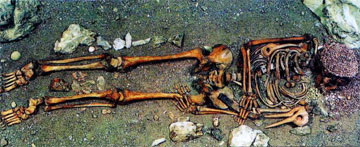 Ταφή της Ανώτερης Παλαιολιθικής στο σπήλαιο Arene Candide της Ιταλίας.
Σε όλη τη διάρκεια της Παλαιολιθικής εποχής τα σπήλαια πρόσφεραν φυσικό καταφύγιο στους ανθρώπους. Δεν ήταν μόνο χώροι κατοίκησης αλλά και χώροι ταφών και «ιερά». Παράλληλα όμως, δεν έλειπαν οι υπαίθριοι καταυλισμοί. Η Παλαιολιθική Αρχαιολογία σημαδεύτηκε εξαρχής από μια αντίφαση: αν και τα πρώτα ευρήματα ανακαλύφθηκαν στις αναβαθμίδες του ποταμού Somme στη Βόρεια Γαλλία, οι αρχαιολόγοι δεν επιχείρησαν ανασκαφές σε υπαίθριες θέσεις και περιορίστηκαν στα σπήλαια. Δημιουργήθηκε έτσι ο μύθος του «ανθρώπου των σπηλαίων». Πέρα από την πολιτισμική προκατάληψη, οι ανασκαφές των σπηλαίων ευνοήθηκαν και από πρακτικούς λόγους, καθώς ο εντοπισμός μιας υπαίθριας παλαιολιθικής θέσης είναι σχεδόν αδύνατος. Επιπλέον, λόγω της μακρόχρονης χρήσης τους, τα σπήλαια εμφανίζουν πολλά αρχαιολογικά στρώματα και προσφέρονται για διαχρονική μελέτη. Το γεγονός όμως αυτό αποτελεί και το μειονέκτημά τους, αφού η συνεχής κατοίκηση επιφέρει διαταράξεις και αναμοχλεύσεις. Τις πληροφορίες για την οργάνωση του χώρου και τα εθνογραφικά συμπεράσματα μπορούν να συμπληρώσουν οι αρκετά πιστές εικόνες των βραχύβιων υπαίθριων καταυλισμών.
Ταφή της Ανώτερης Παλαιολιθικής στο σπήλαιο Arene Candide της Ιταλίας.
Σε όλη τη διάρκεια της Παλαιολιθικής εποχής τα σπήλαια πρόσφεραν φυσικό καταφύγιο στους ανθρώπους. Δεν ήταν μόνο χώροι κατοίκησης αλλά και χώροι ταφών και «ιερά». Παράλληλα όμως, δεν έλειπαν οι υπαίθριοι καταυλισμοί. Η Παλαιολιθική Αρχαιολογία σημαδεύτηκε εξαρχής από μια αντίφαση: αν και τα πρώτα ευρήματα ανακαλύφθηκαν στις αναβαθμίδες του ποταμού Somme στη Βόρεια Γαλλία, οι αρχαιολόγοι δεν επιχείρησαν ανασκαφές σε υπαίθριες θέσεις και περιορίστηκαν στα σπήλαια. Δημιουργήθηκε έτσι ο μύθος του «ανθρώπου των σπηλαίων». Πέρα από την πολιτισμική προκατάληψη, οι ανασκαφές των σπηλαίων ευνοήθηκαν και από πρακτικούς λόγους, καθώς ο εντοπισμός μιας υπαίθριας παλαιολιθικής θέσης είναι σχεδόν αδύνατος. Επιπλέον, λόγω της μακρόχρονης χρήσης τους, τα σπήλαια εμφανίζουν πολλά αρχαιολογικά στρώματα και προσφέρονται για διαχρονική μελέτη. Το γεγονός όμως αυτό αποτελεί και το μειονέκτημά τους, αφού η συνεχής κατοίκηση επιφέρει διαταράξεις και αναμοχλεύσεις. Τις πληροφορίες για την οργάνωση του χώρου και τα εθνογραφικά συμπεράσματα μπορούν να συμπληρώσουν οι αρκετά πιστές εικόνες των βραχύβιων υπαίθριων καταυλισμών.
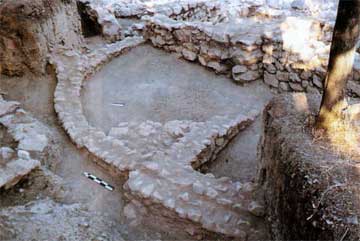 Τμήμα αψιδωτού σπιτιού στον οικισμό της Ασπίδας (ΜΕ ΙΙΙα).
Στη Μέση Χαλκοκρατία (2000/1900-1600 π.Χ.), η αναδίπλωση του ελλαδικού πολιτισμού που επιστρέφει στον αγροτικό βίο, αναστέλλει τα βήματα προς την αστικοποίηση που είχαν συντελεστεί στην Πρώιμη Χαλκοκρατία. Ωστόσο, αυτή η «στασιμότητα» του μεσοελλαδικού πολιτισμού αναδεικνύει τον ιδιαίτερο χαρακτήρα του, μέσα από τη ζωντανή παράδοση περιθωριοποιημένων πολιτισμικών εκφάνσεων. Στη Μεσοχαλκή περίοδο, το Άργος αποτελούσε έναν από τους πιο εκτεταμένους ελλαδικούς οικισμούς, που δεν ήταν όμως ενιαίος αλλά διέθετε τρεις πυρήνες: στις ανατολικές υπώρειες της Λάρισας, στις αντίστοιχες υπώρειες του λόφου της Ασπίδας και στην κορυφή του λόφου αυτού. Η αγροτική εγκατάσταση στην Αψίδα (ΜΕ ΙΙΙα) διακρίνεται από το περιορισμένο εμβαδόν των σπιτιών, την ελεύθερη τοποθέτησή τους στο χώρο και την έλλειψη κοινού προσανατολισμού. Στη ΜΕ ΙΙΙβ περίοδο τα σπίτια είναι ορθογώνια και μεγαλύτερα ενώ η διάταξή τους θυμίζει τα μεσαιωνικά τοιχόσπιτα. Τη χαλαρότητα των κοινωνικών δομών που χαρακτηρίζει τη ΜΕ εποχή επιβεβαιώνουν τα ταφικά έθιμα. Οι νεκροί θάβονται χωρίς κτερίσματα σε λάκκους, κιβωτιόσχημους τάφους ή πίθους (τα παιδιά), συνήθως διάσπαρτους ανάμεσα στα σπίτια του οικισμού. Η έλλειψη κεντρικής οργάνωσης της ΜΕ κοινωνίας διαφαίνεται και στον τρόπο παραγωγής και εμπορίας αγαθών. Προσαρμοσμένη σε κοινότητα χαμηλού οικονομικού επιπέδου και χωρίς έντονη κοινωνική διαφοροποίηση, η οικοτεχνική παραγωγή στερείται έμπνευσης και πειραματισμού. Εξαίρεση αποτελούν τα πήλινα αγγεία, χειροποίητα πιθοειδή και ανοικτά μεσαίου μεγέθους, συνήθως τροχήλατα. Στα ανοικτά αγγεία ανήκουν τα μινυακά αγγεία και τα αμαυρόχρωμα. Τη σχέση του οικισμού με τον εξωτερικό κόσμο μαρτυρούν οι εισαγωγές: πιθοειδή αγγεία από την Αίγινα, κύπελλα και πρόχοι από την Κρήτη και αμφοροειδή αγγεία μάλλον από κάποιο κέντρο παραγωγής στη Ν. Πελοπόννησο.
Τμήμα αψιδωτού σπιτιού στον οικισμό της Ασπίδας (ΜΕ ΙΙΙα).
Στη Μέση Χαλκοκρατία (2000/1900-1600 π.Χ.), η αναδίπλωση του ελλαδικού πολιτισμού που επιστρέφει στον αγροτικό βίο, αναστέλλει τα βήματα προς την αστικοποίηση που είχαν συντελεστεί στην Πρώιμη Χαλκοκρατία. Ωστόσο, αυτή η «στασιμότητα» του μεσοελλαδικού πολιτισμού αναδεικνύει τον ιδιαίτερο χαρακτήρα του, μέσα από τη ζωντανή παράδοση περιθωριοποιημένων πολιτισμικών εκφάνσεων. Στη Μεσοχαλκή περίοδο, το Άργος αποτελούσε έναν από τους πιο εκτεταμένους ελλαδικούς οικισμούς, που δεν ήταν όμως ενιαίος αλλά διέθετε τρεις πυρήνες: στις ανατολικές υπώρειες της Λάρισας, στις αντίστοιχες υπώρειες του λόφου της Ασπίδας και στην κορυφή του λόφου αυτού. Η αγροτική εγκατάσταση στην Αψίδα (ΜΕ ΙΙΙα) διακρίνεται από το περιορισμένο εμβαδόν των σπιτιών, την ελεύθερη τοποθέτησή τους στο χώρο και την έλλειψη κοινού προσανατολισμού. Στη ΜΕ ΙΙΙβ περίοδο τα σπίτια είναι ορθογώνια και μεγαλύτερα ενώ η διάταξή τους θυμίζει τα μεσαιωνικά τοιχόσπιτα. Τη χαλαρότητα των κοινωνικών δομών που χαρακτηρίζει τη ΜΕ εποχή επιβεβαιώνουν τα ταφικά έθιμα. Οι νεκροί θάβονται χωρίς κτερίσματα σε λάκκους, κιβωτιόσχημους τάφους ή πίθους (τα παιδιά), συνήθως διάσπαρτους ανάμεσα στα σπίτια του οικισμού. Η έλλειψη κεντρικής οργάνωσης της ΜΕ κοινωνίας διαφαίνεται και στον τρόπο παραγωγής και εμπορίας αγαθών. Προσαρμοσμένη σε κοινότητα χαμηλού οικονομικού επιπέδου και χωρίς έντονη κοινωνική διαφοροποίηση, η οικοτεχνική παραγωγή στερείται έμπνευσης και πειραματισμού. Εξαίρεση αποτελούν τα πήλινα αγγεία, χειροποίητα πιθοειδή και ανοικτά μεσαίου μεγέθους, συνήθως τροχήλατα. Στα ανοικτά αγγεία ανήκουν τα μινυακά αγγεία και τα αμαυρόχρωμα. Τη σχέση του οικισμού με τον εξωτερικό κόσμο μαρτυρούν οι εισαγωγές: πιθοειδή αγγεία από την Αίγινα, κύπελλα και πρόχοι από την Κρήτη και αμφοροειδή αγγεία μάλλον από κάποιο κέντρο παραγωγής στη Ν. Πελοπόννησο.
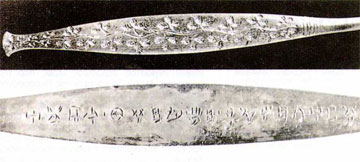 Η χρυσή περόνη με τη μινωική επιγραφή (Μουσείο Αγ. Νικολάου Κρήτης).
Στο Μουσείο Αγ. Νικολάου Κρήτης (αρ. 9675) εκτίθεται χρυσή μινωική περόνη με λεπτοδουλεμένο μοτίβο βάτου στην μπροστινή όψη και εγχάρακτη επιγραφή με 18 σύμβολα της γραμμικής Α στην πίσω. Η επιγραφή, στη λακωνική διάλεκτο, μεταφράζεται: «Δεκαεξάχρονη κανηφόρα, θα είσαι σεμνυνομένη στη θυσία και στις σπονδές». Η λακωνική διάλεκτος, δηλαδή η αρκαδική της εποχής, δυσκόλεψε τον Chadwick που δεν κατάφερε να τη μεταφράσει. Παρανοώντας ορισμένα συλλαβογράμματα, ο Πωλ Φωρ οδηγήθηκε σε λανθασμένη μετάφραση (Αρχαιολογία & Τέχνες, τεύχος 60). Η περόνη προέρχεται από τα Μάλια, από περιοχή που είχε δεχθεί αρκαδική επιρροή, όπως ο ανατολικός νομός Ηρακλείου και ειδικά η επαρχία Πεδιάδος.
Η χρυσή περόνη με τη μινωική επιγραφή (Μουσείο Αγ. Νικολάου Κρήτης).
Στο Μουσείο Αγ. Νικολάου Κρήτης (αρ. 9675) εκτίθεται χρυσή μινωική περόνη με λεπτοδουλεμένο μοτίβο βάτου στην μπροστινή όψη και εγχάρακτη επιγραφή με 18 σύμβολα της γραμμικής Α στην πίσω. Η επιγραφή, στη λακωνική διάλεκτο, μεταφράζεται: «Δεκαεξάχρονη κανηφόρα, θα είσαι σεμνυνομένη στη θυσία και στις σπονδές». Η λακωνική διάλεκτος, δηλαδή η αρκαδική της εποχής, δυσκόλεψε τον Chadwick που δεν κατάφερε να τη μεταφράσει. Παρανοώντας ορισμένα συλλαβογράμματα, ο Πωλ Φωρ οδηγήθηκε σε λανθασμένη μετάφραση (Αρχαιολογία & Τέχνες, τεύχος 60). Η περόνη προέρχεται από τα Μάλια, από περιοχή που είχε δεχθεί αρκαδική επιρροή, όπως ο ανατολικός νομός Ηρακλείου και ειδικά η επαρχία Πεδιάδος.
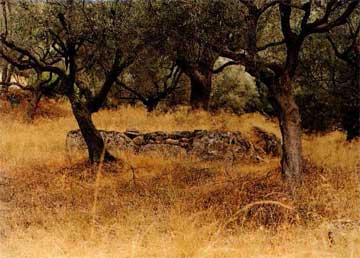 Ερείπια παραλληλόγραμμου κτηρίου από βορρά, στην περιοχή της Ελίκης.
Τον 2ο αιώνα μ.Χ., ο Παυσανίας γράφει ότι στον βυθό του Κορινθιακού φαίνονται τα ερείπια της αρχαίας Ελίκης, της σημαντικότερης αρχαίας αχαϊκής πόλης, που είχε καταποντιστεί το 373 π.Χ. από σεισμό. Τόσο οι προσπάθειες ερευνητών που, με πρωτοβουλία του Σπ. Μαρινάτου, ανέλαβαν τον εντοπισμό της βυθισμένης πόλης (1950-1974), όσο και οι αντίστοιχες προσπάθειες των αρθρογράφων (1985-1991) δεν έφεραν αποτέλεσμα. Μετά το 1991, επί ξηράς αυτή τη φορά, αρχίζουν οι γεωλογικές, γεωφυσικές και ανασκαφικές εργασίες με τη συστηματική εφαρμογή σύγχρονων επιστημονικών μεθόδων. Οι γεωτρήσεις έδειξαν ότι στην παραλιακή πεδιάδα υπάρχουν περισσότεροι από ένας θαμμένοι αρχαίοι ορίζοντες. Ο οικισμός της ρωμαϊκής Ελίκης εντοπίστηκε. Η παρουσία μυκηναϊκού ορίζοντα ενισχύθηκε από τον εντοπισμό νεκροταφείου με θαλαμοειδείς τάφους της ΥΕ ΙΙΒ-ΙΙΙΓ περιόδου. Σε στρατηγική θέση, στο ύψωμα του Αγ. Στεφάνου, σώζονται εκτεταμένα ερείπια πόλης. Σε σχεδόν ευθεία γραμμή, εντοπίστηκε βυθισμένος ο μόλος από το λιμάνι της. Ανήκουν τα ερείπια στη Βούρα, που καταστράφηκε και αυτή το 373 π.Χ.; Είναι το κοντινό σπήλαιο το μαντικό σπήλαιο του Βουραϊκού Ηρακλή; Αν, όπως δείχνει η στρωματογραφία, η Ελίκη διατάσσεται σε μια εκτεταμένη ζώνη κατά μήκος της πεδιάδας, είναι δηλαδή πράγματι εὐρεία όπως τη χαρακτηρίζει ο Όμηρος, ίσως τα ερείπια στο ύψωμα να ανήκουν σε κάποιον από τους δικούς της δήμους.
Ερείπια παραλληλόγραμμου κτηρίου από βορρά, στην περιοχή της Ελίκης.
Τον 2ο αιώνα μ.Χ., ο Παυσανίας γράφει ότι στον βυθό του Κορινθιακού φαίνονται τα ερείπια της αρχαίας Ελίκης, της σημαντικότερης αρχαίας αχαϊκής πόλης, που είχε καταποντιστεί το 373 π.Χ. από σεισμό. Τόσο οι προσπάθειες ερευνητών που, με πρωτοβουλία του Σπ. Μαρινάτου, ανέλαβαν τον εντοπισμό της βυθισμένης πόλης (1950-1974), όσο και οι αντίστοιχες προσπάθειες των αρθρογράφων (1985-1991) δεν έφεραν αποτέλεσμα. Μετά το 1991, επί ξηράς αυτή τη φορά, αρχίζουν οι γεωλογικές, γεωφυσικές και ανασκαφικές εργασίες με τη συστηματική εφαρμογή σύγχρονων επιστημονικών μεθόδων. Οι γεωτρήσεις έδειξαν ότι στην παραλιακή πεδιάδα υπάρχουν περισσότεροι από ένας θαμμένοι αρχαίοι ορίζοντες. Ο οικισμός της ρωμαϊκής Ελίκης εντοπίστηκε. Η παρουσία μυκηναϊκού ορίζοντα ενισχύθηκε από τον εντοπισμό νεκροταφείου με θαλαμοειδείς τάφους της ΥΕ ΙΙΒ-ΙΙΙΓ περιόδου. Σε στρατηγική θέση, στο ύψωμα του Αγ. Στεφάνου, σώζονται εκτεταμένα ερείπια πόλης. Σε σχεδόν ευθεία γραμμή, εντοπίστηκε βυθισμένος ο μόλος από το λιμάνι της. Ανήκουν τα ερείπια στη Βούρα, που καταστράφηκε και αυτή το 373 π.Χ.; Είναι το κοντινό σπήλαιο το μαντικό σπήλαιο του Βουραϊκού Ηρακλή; Αν, όπως δείχνει η στρωματογραφία, η Ελίκη διατάσσεται σε μια εκτεταμένη ζώνη κατά μήκος της πεδιάδας, είναι δηλαδή πράγματι εὐρεία όπως τη χαρακτηρίζει ο Όμηρος, ίσως τα ερείπια στο ύψωμα να ανήκουν σε κάποιον από τους δικούς της δήμους.
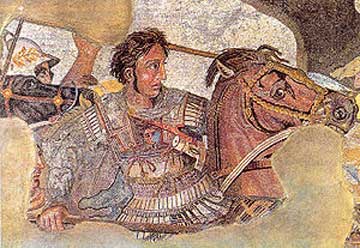 Ο Μέγας Αλέξανδρος. Ψηφιδωτό της Πομπηίας, Αρχαιολογικό Μουσείο Νεαπόλεως.
Αν δεν ακολουθήσει την ασκητική οδό για να βρει το δρόμο της προς τον τόπο της επαγγελίας, η ψυχή θα αναζητήσει την πηγή της αθανασίας. Το απόκρυφο έργο για τον Μέγα Αλέξανδρο προέρχεται από τις πολιτικο-εσχατολογικές θεωρήσεις των Αλεξανδρινών Εβραίων που αποδέχεται και αναπτύσσει η χριστιανική Αποκαλυπτική και Οραματική γραμματεία. Σε μια λόγια μεσαιωνική διασκευή της Μυθιστορίας του Μεγάλου Αλεξάνδρου, που υπάρχει στη σκοπιανή και τις άλλες σλαβικές γραμματείες, συναντούμε το μυθικό νήμα της αναζήτησης της ζωοδόχου πηγής. Ανάλογα παραδείγματα μαρτυρούνται για τους Αγίους Κωνσταντίνο και Ελένη, τον αυτοκράτορα Νικηφόρο Φωκά, τον κράλη της Σερβίας Μάρκο, κ.ά. Η πηγή της ζωής συνδέεται με το αθάνατο νερό. Το 1861 οι αδελφοί Μιλαντίνοφτσι δημοσίευσαν το μακεδονικό λαϊκό παραμύθι με τίτλο «Ο βασιλιάς Αλέξανδρος». Η αδελφή του, που άθελά της σπάει το μπουκάλι με το αθάνατο νερό, μεταμορφώνεται σε δελφίνι ή, όπως σε νεοελληνικές και ευρωπαϊκές διασκευές, σε γοργόνα. Τα τελευταία χρόνια μεγαλώνει ο αριθμός νέων καταγραφών των λαϊκών δημιουργιών για τον Αλέξανδρο, μορφή ιδιαίτερα δημοφιλή και για μια ευρύνοια που δεν του επέτρεπε τη διάκριση των ανθρώπων σε Έλληνες και βάρβαρους.
Ο Μέγας Αλέξανδρος. Ψηφιδωτό της Πομπηίας, Αρχαιολογικό Μουσείο Νεαπόλεως.
Αν δεν ακολουθήσει την ασκητική οδό για να βρει το δρόμο της προς τον τόπο της επαγγελίας, η ψυχή θα αναζητήσει την πηγή της αθανασίας. Το απόκρυφο έργο για τον Μέγα Αλέξανδρο προέρχεται από τις πολιτικο-εσχατολογικές θεωρήσεις των Αλεξανδρινών Εβραίων που αποδέχεται και αναπτύσσει η χριστιανική Αποκαλυπτική και Οραματική γραμματεία. Σε μια λόγια μεσαιωνική διασκευή της Μυθιστορίας του Μεγάλου Αλεξάνδρου, που υπάρχει στη σκοπιανή και τις άλλες σλαβικές γραμματείες, συναντούμε το μυθικό νήμα της αναζήτησης της ζωοδόχου πηγής. Ανάλογα παραδείγματα μαρτυρούνται για τους Αγίους Κωνσταντίνο και Ελένη, τον αυτοκράτορα Νικηφόρο Φωκά, τον κράλη της Σερβίας Μάρκο, κ.ά. Η πηγή της ζωής συνδέεται με το αθάνατο νερό. Το 1861 οι αδελφοί Μιλαντίνοφτσι δημοσίευσαν το μακεδονικό λαϊκό παραμύθι με τίτλο «Ο βασιλιάς Αλέξανδρος». Η αδελφή του, που άθελά της σπάει το μπουκάλι με το αθάνατο νερό, μεταμορφώνεται σε δελφίνι ή, όπως σε νεοελληνικές και ευρωπαϊκές διασκευές, σε γοργόνα. Τα τελευταία χρόνια μεγαλώνει ο αριθμός νέων καταγραφών των λαϊκών δημιουργιών για τον Αλέξανδρο, μορφή ιδιαίτερα δημοφιλή και για μια ευρύνοια που δεν του επέτρεπε τη διάκριση των ανθρώπων σε Έλληνες και βάρβαρους.
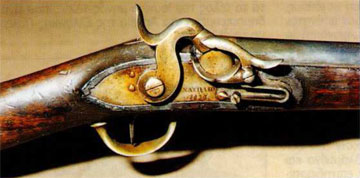 Μηχανισμός τουφεκιού με την επιγραφή ΝΑΥΠΛΙΟΝ 1833.
Απεσταλμένος από το Φιλανθρωπικό Κομιτάτο του Παρισιού, το 1825 φθάνει στο Ναύπλιο ο Γάλλος συνταγματάρχης Arnault (Αρνώ) μαζί με Γάλλους μηχανουργούς. Ιδρύει Οπλοστάσιο, ενσωματώνοντας και το παλιό Οπλουργείο, που κατασκευάζει τηλεβόλα, ελαφρά όπλα, λόγχες και εκρηκτικές ύλες. Για πρώτη φορά στην Ελλάδα, κατασκευάζονται χυτές σφαίρες κανονιών. Σχεδιάζονται νέοι τύποι όπλων για τον αποτελεσματικότερο εξοπλισμό των ατάκτων πολεμιστών. Το Μάρτιο του 1826, το Υπουργείο Πολέμου ζητεί να μεταφέρει ο Σαχίνης στο Μεσολόγγι το σχεδιασμένο για πολιορκίες «τουφέκι τηλεβόλον του Αρνώ». Η αναχώρηση του Αρνώ φαίνεται ότι οφείλεται σε διαφωνίες του με τον συνταγματάρχη Fabvier (Φαβιέρο). Τη σκυτάλη παίρνει ο Βαυαρός Heideck (Έιδεκ) που ανέλαβε και να επιβάλει την τάξη και την πειθαρχία στους στρατιώτες. Παραιτήθηκε τον Ιούλιο του 1829. Το Οπλοστάσιο του Ναυπλίου όμως λειτούργησε, με μερικές διακοπές, ως τα χρόνια της βασιλείας του Γεωργίου Α΄.
Μηχανισμός τουφεκιού με την επιγραφή ΝΑΥΠΛΙΟΝ 1833.
Απεσταλμένος από το Φιλανθρωπικό Κομιτάτο του Παρισιού, το 1825 φθάνει στο Ναύπλιο ο Γάλλος συνταγματάρχης Arnault (Αρνώ) μαζί με Γάλλους μηχανουργούς. Ιδρύει Οπλοστάσιο, ενσωματώνοντας και το παλιό Οπλουργείο, που κατασκευάζει τηλεβόλα, ελαφρά όπλα, λόγχες και εκρηκτικές ύλες. Για πρώτη φορά στην Ελλάδα, κατασκευάζονται χυτές σφαίρες κανονιών. Σχεδιάζονται νέοι τύποι όπλων για τον αποτελεσματικότερο εξοπλισμό των ατάκτων πολεμιστών. Το Μάρτιο του 1826, το Υπουργείο Πολέμου ζητεί να μεταφέρει ο Σαχίνης στο Μεσολόγγι το σχεδιασμένο για πολιορκίες «τουφέκι τηλεβόλον του Αρνώ». Η αναχώρηση του Αρνώ φαίνεται ότι οφείλεται σε διαφωνίες του με τον συνταγματάρχη Fabvier (Φαβιέρο). Τη σκυτάλη παίρνει ο Βαυαρός Heideck (Έιδεκ) που ανέλαβε και να επιβάλει την τάξη και την πειθαρχία στους στρατιώτες. Παραιτήθηκε τον Ιούλιο του 1829. Το Οπλοστάσιο του Ναυπλίου όμως λειτούργησε, με μερικές διακοπές, ως τα χρόνια της βασιλείας του Γεωργίου Α΄.
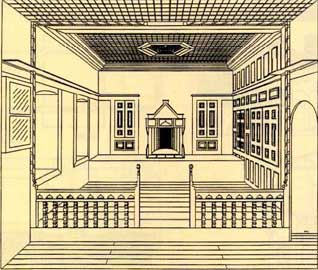 Ο καλός οντάς του αρχοντικού των Σακελλάριων.
Στα προνόμια που απέκτησε η πόλη της Κοζάνης γύρω στα τέλη του 17ου αιώνα, συγκαταλέγεται η απαγόρευση της διέλευσης και εγκατάστασης Τούρκων στρατιωτών. Σε μια αμιγώς λοιπόν χριστιανική πόλη, χτίστηκε το 1670 ο πρώτος πυρήνας του αρχοντικού των Σακελλάριων που, στεγάζοντας πέντε γενιές της οικογένειας, σταδιακά επεκτάθηκε και τροποποιήθηκε. Το 1932, ομάδα αρχιτεκτόνων, με επιβλέποντα καθηγητή τον Δ. Πικιώνη, επισκέφθηκε την Κοζάνη και αποτύπωσε διάφορα αρχοντικά της πόλης στο πλαίσιο της «Μελέτης του ελληνικού σπιτιού και της αρχιτεκτονικής του», για λογαριασμό του συλλόγου «Ελληνική Λαϊκή Τέχνη». Το 1934, ο αρχιτέκτονας Α. Ζάχος ανέλαβε την αναστήλωση του κτηρίου αποδίδοντάς του νεοκλασικά χαρακτηριστικά. Τέλος, το 1977 το αρχοντικό μεταμορφώθηκε «εν μία νυκτί» σε άχρωμη, τσιμεντένια πολυκατοικία. Ο αρθρογράφος προσφέρει μια εκτενή περιήγηση στην κατασκευαστική ιστορία του αρχοντικού, εμπλουτισμένη με πλήθος τοπικών όρων.
Ο καλός οντάς του αρχοντικού των Σακελλάριων.
Στα προνόμια που απέκτησε η πόλη της Κοζάνης γύρω στα τέλη του 17ου αιώνα, συγκαταλέγεται η απαγόρευση της διέλευσης και εγκατάστασης Τούρκων στρατιωτών. Σε μια αμιγώς λοιπόν χριστιανική πόλη, χτίστηκε το 1670 ο πρώτος πυρήνας του αρχοντικού των Σακελλάριων που, στεγάζοντας πέντε γενιές της οικογένειας, σταδιακά επεκτάθηκε και τροποποιήθηκε. Το 1932, ομάδα αρχιτεκτόνων, με επιβλέποντα καθηγητή τον Δ. Πικιώνη, επισκέφθηκε την Κοζάνη και αποτύπωσε διάφορα αρχοντικά της πόλης στο πλαίσιο της «Μελέτης του ελληνικού σπιτιού και της αρχιτεκτονικής του», για λογαριασμό του συλλόγου «Ελληνική Λαϊκή Τέχνη». Το 1934, ο αρχιτέκτονας Α. Ζάχος ανέλαβε την αναστήλωση του κτηρίου αποδίδοντάς του νεοκλασικά χαρακτηριστικά. Τέλος, το 1977 το αρχοντικό μεταμορφώθηκε «εν μία νυκτί» σε άχρωμη, τσιμεντένια πολυκατοικία. Ο αρθρογράφος προσφέρει μια εκτενή περιήγηση στην κατασκευαστική ιστορία του αρχοντικού, εμπλουτισμένη με πλήθος τοπικών όρων.
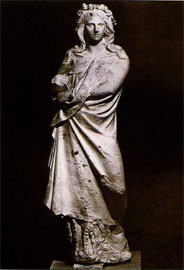 Η «΄Ορθια Κόρη». Μουσείο Χαλεπά στον Πύργο της Τήνου.
Στα τέλη του 19ου αιώνα αναπτύσσονται πολιτισμικές και οικονομικές σχέσεις ανάμεσα στις Κυκλάδες και το Λεωνίδιο, όπου το εμπόριο είχε ήδη δημιουργήσει ακμάζουσα αστική τάξη. Εκπρόσωποί της απαντούν στο νεοκλασικό νεκροταφείο των Αγίων Πάντων. Τα ταφικά μνημεία τους κατασκεύασαν κυρίως Τήνιοι καλλιτέχνες. Ανάμεσά τους ξεχωρίζει ο τάφος του Λεωνίδα Οικονόμου (1891) που, αν και ανυπόγραφος, προδίδει τον γλύπτη του με την απλότητα και την πλαστική ελευθερία στην απόδοση της «Όρθιας Κόρης» του, απαράλλαχτης με την «Κοιμωμένη» του Α΄ Νεκροταφείου Αθηνών. Ως πρότυπο χρησιμοποιήθηκε ο «Άγγελος Κυρίου», που το γύψινο πρόπλασμά του έγινε από τον Γιαννούλη Χαλεπά το 1877. Ανυπόγραφη είναι και η στήλη στο ταφικό μνημείο του Νικολάου Πολίτη. Ωστόσο αποδίδεται στον Ιωάννη Χαλεπά, πατέρα του Γιαννούλη, χάρη στις ομοιότητες με άλλα του επιτύμβια, αλλά και στην αναφορά του μνημείου στα κατάστιχά του. Οι επαγγελματικές σχέσεις του Ιωάννη Χαλεπά με οικογένειες του Λεωνιδίου επιβεβαιώνονται από σχέδια και γλυπτά του στην κατοχή των οικογενειών Μ. Γκιώνη και Ν. Πολίτη. Τα μαρμάρινα κωδωνοστάσια τριών εκκλησιών και άλλα ελάσσονα μνημεία μαρτυρούν την ποικιλία των παραγγελιών που η μικρή αρκαδική πόλη ανέθετε σε Τήνιους μαρμαρογλύπτες. Το τοπωνύμιο «Κοιμωμένη» στο Λεωνίδιο και κάποιοι παλιοί Λεωνιδιώτες εγκατεστημένοι στην Τήνο μαρτυρούν ακόμη και σήμερα τους δεσμούς που συνδέουν τους δύο τόπους.
Η «΄Ορθια Κόρη». Μουσείο Χαλεπά στον Πύργο της Τήνου.
Στα τέλη του 19ου αιώνα αναπτύσσονται πολιτισμικές και οικονομικές σχέσεις ανάμεσα στις Κυκλάδες και το Λεωνίδιο, όπου το εμπόριο είχε ήδη δημιουργήσει ακμάζουσα αστική τάξη. Εκπρόσωποί της απαντούν στο νεοκλασικό νεκροταφείο των Αγίων Πάντων. Τα ταφικά μνημεία τους κατασκεύασαν κυρίως Τήνιοι καλλιτέχνες. Ανάμεσά τους ξεχωρίζει ο τάφος του Λεωνίδα Οικονόμου (1891) που, αν και ανυπόγραφος, προδίδει τον γλύπτη του με την απλότητα και την πλαστική ελευθερία στην απόδοση της «Όρθιας Κόρης» του, απαράλλαχτης με την «Κοιμωμένη» του Α΄ Νεκροταφείου Αθηνών. Ως πρότυπο χρησιμοποιήθηκε ο «Άγγελος Κυρίου», που το γύψινο πρόπλασμά του έγινε από τον Γιαννούλη Χαλεπά το 1877. Ανυπόγραφη είναι και η στήλη στο ταφικό μνημείο του Νικολάου Πολίτη. Ωστόσο αποδίδεται στον Ιωάννη Χαλεπά, πατέρα του Γιαννούλη, χάρη στις ομοιότητες με άλλα του επιτύμβια, αλλά και στην αναφορά του μνημείου στα κατάστιχά του. Οι επαγγελματικές σχέσεις του Ιωάννη Χαλεπά με οικογένειες του Λεωνιδίου επιβεβαιώνονται από σχέδια και γλυπτά του στην κατοχή των οικογενειών Μ. Γκιώνη και Ν. Πολίτη. Τα μαρμάρινα κωδωνοστάσια τριών εκκλησιών και άλλα ελάσσονα μνημεία μαρτυρούν την ποικιλία των παραγγελιών που η μικρή αρκαδική πόλη ανέθετε σε Τήνιους μαρμαρογλύπτες. Το τοπωνύμιο «Κοιμωμένη» στο Λεωνίδιο και κάποιοι παλιοί Λεωνιδιώτες εγκατεστημένοι στην Τήνο μαρτυρούν ακόμη και σήμερα τους δεσμούς που συνδέουν τους δύο τόπους.
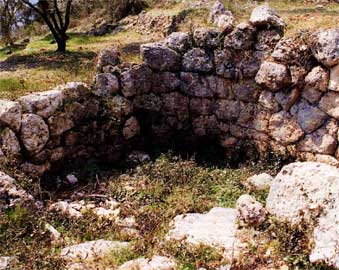 Ελλειψοειδές κτίσμα στη Σποριά της Λευκάδας.
Στους αιώνες της ξένης κατάκτησης του νησιού, τα 17 μοναστήρια του απέκτησαν σημαντική οικονομική δύναμη. Ένα από τα 6 που διατήρησαν την ισχύ τους ως το τέλος ήταν το μοναστήρι της «Κόκκινης Εκκλησιάς» που χτίστηκε το 1478. Η περιοχή στην οποία αναπτύχθηκαν οι αγροτικές δραστηριότητες του μοναστηριού βρίσκεται σε κοιλάδα στις νότιες πλαγιές των Σκάρων, ανάμεσα σε μικρές κοιλάδες και πλατώματα κατάλληλα για καλλιέργειες. Η μεγάλη του περιουσία διανεμήθηκε το 1927 στους αγρότες. Έξι μετόχια της μονής αναφέρονται στην καταγραφή του 1805, πέντε από τα οποία βρίσκονται στους Σκάρους. Είναι ο Αϊ-Γιάννης στην Ασφακιά, η Ραφτοπούλα, ο Αϊ-Γιώργης, η Μαρίτσα και η Βρύση του Πασά. Αρχαιολογικά ευρήματα, που προέκυψαν κυρίως από την προσπάθεια του W. Doerpfeld να αποδείξει ότι η Λευκάδα είναι η αρχαία Ιθάκη, μαρτυρούν ότι ο αγροτικός χώρος της μονής γνώρισε διαχρονική κατοίκηση από τη 2η χιλιετία π.Χ. Η μοναστηριακή οργάνωση αποκρυσταλλώνεται στη δομή του χώρου μέσα από οδικό δίκτυο επικοινωνιών, στο οποίο τα μετόχια αποτελούσαν σταθμούς οπτικής και ακουστικής επικοινωνίας.
Ελλειψοειδές κτίσμα στη Σποριά της Λευκάδας.
Στους αιώνες της ξένης κατάκτησης του νησιού, τα 17 μοναστήρια του απέκτησαν σημαντική οικονομική δύναμη. Ένα από τα 6 που διατήρησαν την ισχύ τους ως το τέλος ήταν το μοναστήρι της «Κόκκινης Εκκλησιάς» που χτίστηκε το 1478. Η περιοχή στην οποία αναπτύχθηκαν οι αγροτικές δραστηριότητες του μοναστηριού βρίσκεται σε κοιλάδα στις νότιες πλαγιές των Σκάρων, ανάμεσα σε μικρές κοιλάδες και πλατώματα κατάλληλα για καλλιέργειες. Η μεγάλη του περιουσία διανεμήθηκε το 1927 στους αγρότες. Έξι μετόχια της μονής αναφέρονται στην καταγραφή του 1805, πέντε από τα οποία βρίσκονται στους Σκάρους. Είναι ο Αϊ-Γιάννης στην Ασφακιά, η Ραφτοπούλα, ο Αϊ-Γιώργης, η Μαρίτσα και η Βρύση του Πασά. Αρχαιολογικά ευρήματα, που προέκυψαν κυρίως από την προσπάθεια του W. Doerpfeld να αποδείξει ότι η Λευκάδα είναι η αρχαία Ιθάκη, μαρτυρούν ότι ο αγροτικός χώρος της μονής γνώρισε διαχρονική κατοίκηση από τη 2η χιλιετία π.Χ. Η μοναστηριακή οργάνωση αποκρυσταλλώνεται στη δομή του χώρου μέσα από οδικό δίκτυο επικοινωνιών, στο οποίο τα μετόχια αποτελούσαν σταθμούς οπτικής και ακουστικής επικοινωνίας.
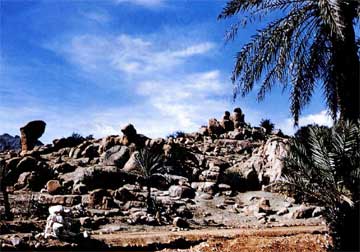 Τα ανθρώπινα κατάλοιπα παρέχουν πληροφορίες για τους κανόνες υγιεινής και το πολιτιστικό επίπεδο.
Η Περιβαλλοντολογική Αρχαιολογία έδωσε ιδιαίτερη έμφαση στην ανασύσταση του παρελθόντος μέσα από τα οργανικά και ανόργανα στοιχεία. Ανθρώπινα κατάλοιπα, ιδιαίτερα οι μαλακοί ιστοί, μας πληροφορούν για τις διατροφικές συνήθειες, τις ασθένειες, τους κανόνες υγιεινής και το πολιτισμικό επίπεδο. Οι κοπρόλιθοι, απολιθωμένα κόπρανα, επανέρχονται στην αρχική τους μορφή με συγκεκριμένη τεχνική ανάλυσης στο εργαστήριο, προτού εξεταστούν για να διαπιστωθεί η τροφή που κατανάλωνε ο προϊστορικός άνθρωπος. Έτσι εντοπίζονται τα υπολείμματα φυτικών ή ζωικών τροφών και μέσω αυτών πληροφορούμαστε για το φυσικό περιβάλλον, την ηλικία των ζώων, την ωρίμανση των φρούτων, τον τρόπο παρασκευής του φαγητού, καθώς και για την οικονομία και το όλο περιβάλλον. Στην Ελλάδα, η μελέτη των καταλοίπων άργησε πολύ να απασχολήσει τους αρχαιολόγους. Το περιβαλλοντολογικό πρόγραμμα σε εξέλιξη στην ευρύτερη περιοχή των Δελφών συμπεριλαμβάνει μελέτη κοπρολίθων. Αντίστοιχες μελέτες από την ανασκαφή στη Δυτική Οικία του Ακρωτηρίου στη Σαντορίνη περιμένουν τη δημοσίευσή τους.
Τα ανθρώπινα κατάλοιπα παρέχουν πληροφορίες για τους κανόνες υγιεινής και το πολιτιστικό επίπεδο.
Η Περιβαλλοντολογική Αρχαιολογία έδωσε ιδιαίτερη έμφαση στην ανασύσταση του παρελθόντος μέσα από τα οργανικά και ανόργανα στοιχεία. Ανθρώπινα κατάλοιπα, ιδιαίτερα οι μαλακοί ιστοί, μας πληροφορούν για τις διατροφικές συνήθειες, τις ασθένειες, τους κανόνες υγιεινής και το πολιτισμικό επίπεδο. Οι κοπρόλιθοι, απολιθωμένα κόπρανα, επανέρχονται στην αρχική τους μορφή με συγκεκριμένη τεχνική ανάλυσης στο εργαστήριο, προτού εξεταστούν για να διαπιστωθεί η τροφή που κατανάλωνε ο προϊστορικός άνθρωπος. Έτσι εντοπίζονται τα υπολείμματα φυτικών ή ζωικών τροφών και μέσω αυτών πληροφορούμαστε για το φυσικό περιβάλλον, την ηλικία των ζώων, την ωρίμανση των φρούτων, τον τρόπο παρασκευής του φαγητού, καθώς και για την οικονομία και το όλο περιβάλλον. Στην Ελλάδα, η μελέτη των καταλοίπων άργησε πολύ να απασχολήσει τους αρχαιολόγους. Το περιβαλλοντολογικό πρόγραμμα σε εξέλιξη στην ευρύτερη περιοχή των Δελφών συμπεριλαμβάνει μελέτη κοπρολίθων. Αντίστοιχες μελέτες από την ανασκαφή στη Δυτική Οικία του Ακρωτηρίου στη Σαντορίνη περιμένουν τη δημοσίευσή τους.
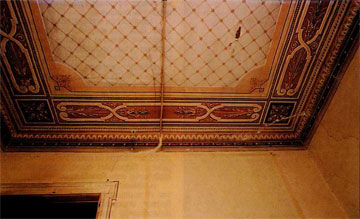 Λεπτομέρεια εσωτερικής οροφογραφίας στο σπίτι του Σπυρίδωνος Τρικούπη στο Άργος.
Ποια η ιστορία της πολεοδομίας από συστάσεως ελληνικού κράτους; Ακόμη και ο αδιάφορος για τον Τρικούπη αναγνώστης θα απολαύσει το άρθρο για τις σχετικές ενδείξεις. Το 1996 γιορτάζεται η επέτειος των 100 χρόνων από το θάνατο του Χαρ. Τρικούπη. Ο συγγραφέας δράττεται της ευκαιρίας να αντιπαραθέσει στους επίσημους εορτασμούς την κρατική αδιαφορία για το σπίτι στο Άργος, όπου γεννήθηκε ο πολιτικός, και που τώρα καταρρέει εγκαταλειμμένο από την Αγροτική Τράπεζα. Προτού οικοδομήσει το σπίτι του στην Αθήνα, όπου εγκαταστάθηκε στα οθωνικά χρόνια, ο Σπυρίδων Τρικούπης, πατέρας του Χαρίλαου, είχε χτίσει άλλα τρία μεγαλοπρεπή σπίτια στην Αίγινα, το Ναύπλιο (στη θέση του ξενοδοχείου Αμφιτρύων) και το Άργος. Το σπίτι της Αίγινας, που ο Ν. Δραγούμης αποκαλεί «υπουργικόν μέγαρον», αποτελεί σήμερα ιδιωτική ιδιοκτησία. Η Κυβέρνηση, με έγκριση του Καποδίστρια, αποδέχθηκε την πρόταση του Τρικούπη και αγόρασε το σπίτι του Ναυπλίου. Το 1830, ο Τρικούπης, στηριζόμενος στο προηγούμενο του δικαστικού Μ. Σικελιανού, αιτείται την παραχώρηση τεσσάρων στρεμμάτων για την οικοδόμηση σπιτιού στο Άργος, τόπο κατοικίας πολλών αντικαποδιστριακών όπως και ο ίδιος. Καθώς ο χώρος ανήκε στον Μεντρεσέ και δεν θίγονταν ιδιωτικά ή γενικά συμφέροντα, η Διοίκηση έκανε δεκτό το αίτημα. Η οικοδόμηση άρχισε άμεσα, όπως έπρεπε, σύμφωνα με την ισχύουσα πολεοδομική νομοθεσία για παραχώρηση εθνικής γης στις πόλεις με σκοπό τη δόμηση. Ακολουθεί μια ιστορία παραλόγου που ηχεί κάπως γνώριμη.
Λεπτομέρεια εσωτερικής οροφογραφίας στο σπίτι του Σπυρίδωνος Τρικούπη στο Άργος.
Ποια η ιστορία της πολεοδομίας από συστάσεως ελληνικού κράτους; Ακόμη και ο αδιάφορος για τον Τρικούπη αναγνώστης θα απολαύσει το άρθρο για τις σχετικές ενδείξεις. Το 1996 γιορτάζεται η επέτειος των 100 χρόνων από το θάνατο του Χαρ. Τρικούπη. Ο συγγραφέας δράττεται της ευκαιρίας να αντιπαραθέσει στους επίσημους εορτασμούς την κρατική αδιαφορία για το σπίτι στο Άργος, όπου γεννήθηκε ο πολιτικός, και που τώρα καταρρέει εγκαταλειμμένο από την Αγροτική Τράπεζα. Προτού οικοδομήσει το σπίτι του στην Αθήνα, όπου εγκαταστάθηκε στα οθωνικά χρόνια, ο Σπυρίδων Τρικούπης, πατέρας του Χαρίλαου, είχε χτίσει άλλα τρία μεγαλοπρεπή σπίτια στην Αίγινα, το Ναύπλιο (στη θέση του ξενοδοχείου Αμφιτρύων) και το Άργος. Το σπίτι της Αίγινας, που ο Ν. Δραγούμης αποκαλεί «υπουργικόν μέγαρον», αποτελεί σήμερα ιδιωτική ιδιοκτησία. Η Κυβέρνηση, με έγκριση του Καποδίστρια, αποδέχθηκε την πρόταση του Τρικούπη και αγόρασε το σπίτι του Ναυπλίου. Το 1830, ο Τρικούπης, στηριζόμενος στο προηγούμενο του δικαστικού Μ. Σικελιανού, αιτείται την παραχώρηση τεσσάρων στρεμμάτων για την οικοδόμηση σπιτιού στο Άργος, τόπο κατοικίας πολλών αντικαποδιστριακών όπως και ο ίδιος. Καθώς ο χώρος ανήκε στον Μεντρεσέ και δεν θίγονταν ιδιωτικά ή γενικά συμφέροντα, η Διοίκηση έκανε δεκτό το αίτημα. Η οικοδόμηση άρχισε άμεσα, όπως έπρεπε, σύμφωνα με την ισχύουσα πολεοδομική νομοθεσία για παραχώρηση εθνικής γης στις πόλεις με σκοπό τη δόμηση. Ακολουθεί μια ιστορία παραλόγου που ηχεί κάπως γνώριμη.
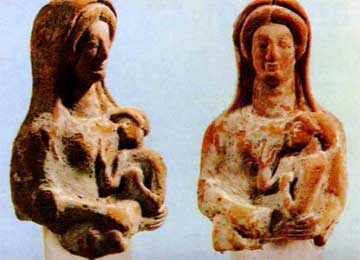 Ειδώλια κουροτρόφων μαρτυρούν την ιδιότητα της Αρτέμιδος ως προστάτριας των παιδιών.
Το Μουσείο χτίστηκε για να στεγάσει τα πλούσια ευρήματα, μαρμάρινα, πήλινα, αλαβάστρινα και χρυσά, από το Ιερό της Βραυρωνίας Αρτέμιδος που ανέσκαψε ο Ι. Παπαδημητρίου. Στεγάζει επίσης τα ευρήματα από τον αρχαίο δήμο του Μυρρινούντος, καθώς και τα γεωμετρικά ευρήματα από την Ανάβυσσο. Λατρεμένη από τα προϊστορικά χρόνια, ευπρόσδεκτη στην Ακρόπολη των Αθηνών τον 6ο αιώνα π.Χ., η Άρτεμις προστατεύει τα παιδιά στη μεταβατική τους ηλικία, όπως προΐσταται στους «ενδιάμεσους» υπαίθριους χώρους, στα όρια του άστεος και της άγριας φύσης.
Ειδώλια κουροτρόφων μαρτυρούν την ιδιότητα της Αρτέμιδος ως προστάτριας των παιδιών.
Το Μουσείο χτίστηκε για να στεγάσει τα πλούσια ευρήματα, μαρμάρινα, πήλινα, αλαβάστρινα και χρυσά, από το Ιερό της Βραυρωνίας Αρτέμιδος που ανέσκαψε ο Ι. Παπαδημητρίου. Στεγάζει επίσης τα ευρήματα από τον αρχαίο δήμο του Μυρρινούντος, καθώς και τα γεωμετρικά ευρήματα από την Ανάβυσσο. Λατρεμένη από τα προϊστορικά χρόνια, ευπρόσδεκτη στην Ακρόπολη των Αθηνών τον 6ο αιώνα π.Χ., η Άρτεμις προστατεύει τα παιδιά στη μεταβατική τους ηλικία, όπως προΐσταται στους «ενδιάμεσους» υπαίθριους χώρους, στα όρια του άστεος και της άγριας φύσης.
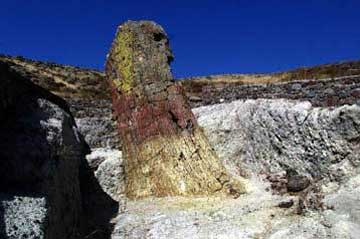 Το μεγαλύτερο απολιθωμένο δέντρο του κόσμου έχει βρεθεί στο απολιθωμένο δάσος της Λέσβου.
Η παράθεση είναι ενδεικτική. Για το πλήρες κείμενο της στήλης, δείτε το συνημμένο αρχείο pdf.
Το μεγαλύτερο απολιθωμένο δέντρο του κόσμου έχει βρεθεί στο απολιθωμένο δάσος της Λέσβου.
Η παράθεση είναι ενδεικτική. Για το πλήρες κείμενο της στήλης, δείτε το συνημμένο αρχείο pdf.
Ειδήσεις
Με διεθνή συνεργασία και με επιμελητή έκδοσης τον δρα Αλέξη Γ.Κ. Σαββίδη έχει ήδη ξεκινήσει το Εγκυκλοπαιδικό Προσωπογραφικό Λεξικό Βυζαντινής Ιστορίας και Πολιτισμού - Το Πελοποννησιακό Λαογραφικό Ίδρυμα σε συνεργασία με το Πρόγραμμα Μελίνα οργάνωσε τέσσερα εκπαιδευτικά προγράμματα: Λεωνίδιο-Τσακωνιά, Λεχαινά-Ηλεία, Καλαμάτα, Καρπενήσι Ευρυτανίας - Ιδιαίτερης επιστημονικής αξίας είναι τα ευρήματα από τις ανασκαφές στο Απολιθωμένο Δάσος της Λέσβου που πραγματοποιεί το Μουσείο Φυσικής ΙστορίαςΕκθέσεις
«Το ελληνικό κόσμημα - 6000 χρόνια παράδοσης» ήταν ο τίτλος της έκθεσης που οργάνωσε το ΥΠΠΟ στη Θεσσαλονίκη - Ήρθε στην Αθήνα η έκθεση για την Πολιόχνη, τον μοναδικής σημασίας οικισμό της Πρώιμης Χαλκοκρατίας στη ΛήμνοΔιαλέξεις
«Νομισματικοί θησαυροί από την Ερέτρια» ήταν το θέμα της ομιλίας του κ. Πέτρου Καλλιγά στην Αρχαιολογική Εταιρεία - Στην ιδιάζουσα περίπτωση του Οσίου Λουκά αναφέρθηκε ο ακαδημαϊκός Παύλος Μυλωνάς σε ομιλία του στην Ακαδημία ΑθηνώνΣυνέδρια
«Το Αιγαίο κατά τη Νεολιθική, τη Χαλκολιθική και την Πρώιμη Εποχή του Χαλκού» (7η-3η χιλιετία π.Χ.) ήταν το θέμα διεθνούς συμποσίου που διεξήχθη έξω από τη Σμύρνη - Στις Μαργαρίτες Μυλοποτάμου του νομού Ρεθύμνης διεξήχθη συνέδριο αφιερωμένο στο γυαλί από την αρχαιότητα ως σήμεραΒιβλία
Κατερίνα Κοσκινά (επιμ.), Nelly’s. Από την Αθήνα στη Νέα Υόρκη. Το έργο της Έλλης Σεραϊδάρη, Μπάστας-Πλέσσας, Αθήνα 1997 Συλλογικό έργο, Marmaria, le sanctuaire d’Athéna à Delphes, E.F.A, E.D.F., Paris 1997 Conrad M. Stibbe, Das andere Sparta, Philipp von Zabern, Mainz/Rhein 1997 Orhan Bingöl, Malerei und Mosaik der Antike in der Turkei, Philipp von Zabern, Mainz/Rhein 1997 Κ. Νάντια Σερεμετάκη, Παλιννόστηση αισθήσεων, Νέα Σύνορα Λιβάνη, Αθήνα 1997 Ντόρα Βασιλικού, Μυκηναϊκά σφραγιστικά δαχτυλίδια, Βιβλιοθήκη της εν Αθήναις Αρχαιολογικής Εταιρείας, αρ. 166, Αθήνα 1997
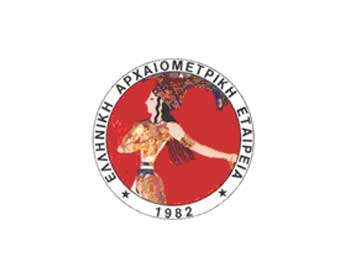 Το λογότυπο της Ελληνικής Αρχαιομετρικής Εταιρείας
Η παράθεση είναι ενδεικτική. Για το πλήρες κείμενο της στήλης, δείτε το συνημμένο αρχείο pdf.
Το λογότυπο της Ελληνικής Αρχαιομετρικής Εταιρείας
Η παράθεση είναι ενδεικτική. Για το πλήρες κείμενο της στήλης, δείτε το συνημμένο αρχείο pdf.
Ειδήσεις
Η Ελληνική Σπηλαιολογική Εταιρεία διοργανώνει Σεμινάριο Επιστημονικής και Αθλητικής ΣπηλαιολογίαςΣυνέδρια
Η πιθανότητα διασύνδεσης Κυκλάδων και Κρήτης εξετάστηκε στην επιστημονική συνάντηση που έγινε στο Sheffield της Αγγλίας με θέμα: «Metallurgy in the EBA Aegean: New evidence for production and consumption» - Ειδική επιστημονική ημερίδα διοργάνωσε η Εφορεία Παλαιοανθρωπολογίας - Σπηλαιολογίας για τα 20 χρόνια από την ίδρυσή της - Για την διεπιστημονική μελέτη των βυζαντινών εικόνων οργανώθηκε στη Γεννάδειο Βιβλιοθήκη Διεθνές Συμπόσιο γύρω από την «Τέχνη, Τεχνική και Τεχνολογία» τουςΒιβλία
N. Herz and E.G. Garrison, Geological Methods for Archaeology, Oxford University Press, Oxford 1997 Ana Maria Abraides, Pentelethen: The Export of Pentelic Marble and its Use in Architectural and Epigraphical Monuments. University f California at Berkley dissetration, Ann Arbor dissertation reprintΔημοσίευση
I. Liritzis, P. Guibert, F. Foti and M. Schvoerer, «The Temple of Apollo (Delphi) Strengthens Novel Thermoluminescence Dating Method», Geoarchaeology, 12 (1997), 479-496Caves were in use throughout the Palaeolithic era primarily as dwelling places and secondarily, in later phases, as burial sites and "sanctuaries". Although they were not the only habitation places of Palaeolithic man, the practice of the archaeologists to attempt Palaeolithic excavations only in caves has contributed to the dissemination of the myth of the "Man of the Caves". Modern research into the Palaeolithic era focuses both on caves and open-air sites, since the information supplied by these sources is complementary to each other.
Human excrements and especially the soft matter, in the rare cases they have survived, are of great importance. They can be conceived only under marginal conditions and generally if the action of microorganisms has been prevented. Relevant finds supply information regarding the nutritional habits, diseases, hygiene practice and overall cultural level. Tine coprolites (petrified excrements) are restored to their original form through a specific technical analysis and then they are examined in order to find what food was consumed by the Prehistoric man. As a result ,vegetable and animal remnants are identified and through them the natural environment, the age of animals, the ripening of fruits, the mode of food preparation, the season of consumption as well as the economy and the general environment is revealed. Coproliths are remnants significant to Archaeology, since they offer one more approach for knowing and studying the human past.
In 373 BC a strong earthquake and the tidal waves that followed destroyed Eliki, the most important town of ancient Achaia in the Aigialeia region, and made it disappear under the waters of the Corinthian Bay. The neighbouring town of Voura, which sank into a chasm, was also razed by the same seismic phenomenon. Voura, however, was rebuilt by its citizens who happened to be away at the moment of destruction. Pausanias, in the second century AD, visited a littoral site called Eliki, east of Aigion, and wrote that the ruins of the ancient town were visible at the bottom of the sea. Later, the alluvial deposits of the nearby rivers covered Eliki's ruins. Recent systematic research east of Aigion for the location and revelation of ancient Eliki brought to light new important data relevant to the ancient town and its broader region.
Around the late seventeenth century the settlement of Turkish soldiers in Kozani was strictly forbidden. Thus, due to this granted privilege the town remained purely Christian. In 1670 the first ,main wing, of the Sakellarios mansion was built and was later enlarged and modified, since it housed five generations of the family. In 1932 a group of architects of the National Polytechnic School of Athens making the measured drawings of various mansions of Kozani, made a complete documentation of the Sakellarios edifice in context of the Study of the Greek House, a project commissioned by the Greek Folk Art Association. In 1977 the mansion was demolished and a colourless concrete building took its place.
The rural activities of the "Kokkini Ekklisia" Monastery mainly take place south of Skaroi, on its extensions and on the plateaux adjacent to it. The closed plain of Nydri, the deep Vlychos bay, the ravine that goes by the name of Aspropotamos or Demossari, act as boundaries of the mountainous volume. It is an area typical of the district and closely connected with the activities that go on and the overall course of development of the place - not only during the last centuries which are marked by the function of the monastery. Evidence has survived from antiquity in a combination of routes dictated by the local natural environment, by impassable crossings deprived of any access to the sea.
During the Middle Bronze Age (2000/1900-1650 BC) mainland Greece went through one of the less impressive phases of its history, while by the end of the third millennium the Helladic civilization was pushed out of the limelight of developments which promoted Crete as the dominant power in the Aegean. The decline of the Helladic civilization is considered to be the result of interior convulsions which were probably connected whith the socio-economic realignments taking place in the broader Aegean region. The first steps towards the urbanization of the Early Bronze Age (3rd millennium) are suspended and a return to the rural economy is observed. The Argolis presents a special interest for the study of the Bronze Age in mainland Greece. Argos, one of the settlements continuously inhabited from the Neolithic period on, followed a remarkable historical course that culminated in the early Historical years, when it played a regulating role in the broader Helladic area. It seems that Argos in the Middle Bronze Age was one of the most extended Greek settlements, containing at least three important habitation nuclei, according to the excavational data.One in the eastern outskirt of Larissa (the acropolis of Argos), another on the foot of Aspida hill and a third one on the top of it.
In September 1825, the French colonel Arnault together with French engineers, sent by the Charitable Committee of Paris, arrived in Greece. Arnault founded an Arsenal in Nafplion, incorporating the old Armory for the construction of cannons and light firearms as well as polearms and explosives. The Nafplion Arsenal, which operated with minor interruptions until the first years of King George the first's reign, can be considered one of the first small industries of Modern Greece.
The small town of Leonidion on the eastern coast of the Peloponnese became especially prosperous in the second half of the nineteenth and the beginning of the twentieth century thanks to the commercial activities of its inhabitants both in Greece and abroad. The funerary monuments of the Neoclassical cemetery of Hagioi Pantes east of the town express the urban ideology prevailing at that time in the local society. Their creators were mainly artists from the island of Tenos. The Angel on the grave of Leonidas Oikonomou, although an unsigned work, is a distinct sculpture exhibiting simplicity and freedom of plasticity. Compared to its plaster cast this statue, which has been preserved in Tenos island can with certainty be assigned to Yannoulis Chalepas and, if dating from 1877, it can be be identified with the now lost "Angel of the Lord" by the same artist. The funerary stele on the grave of Nikolaos P. K. Politis, also an unsigned work, on the basis of the style and the prosopography, can be assigned to Yannoulis' father, the sculptor loannis Chalepas, in whose papers this specific sculpture is mentioned. The professional relations of Yannoulis Chalepas with families of Leonidion are confirmed by drawings and sculptures in the possession of M. Gionis and N. Politis' family. The marble bell-towers of three churches as well as other minor monuments reveal the variety of commissions given to Tenian sculptors by the small Arcadian town. The toponym "Koimomeni" (= Sleeping One) in Leonidion —that reminds one of the fair sculpture by Yannoulis Chalepas- and some inhabitants of the town who later settled on Tenos, testify to this day to the bond existing between the two places.
The female figurines of the Prehistoric period have been interpreted, according to a common theory, as representations of a Mother-Goddess, symbol of the fertility of nature and man, whose cult was extremely wide-spread. Due to their numerical superiority as compared to the male figurines that come down to us, they have been used as proof for the existence of a matriarchal system of social organization the well-known theory of "matriarchy"— although the connection of female deities with the social power, the authority and the evaluation of women in the specific era cannot concurrently be proved. Recent research, based on the various typological differences of the female figurines, has considerably altered the proposed interpretations for the indentification of their function, although it has restrained from assigning the production of the early figurines to a single reason of religious character. The projection of the female element in Prehistoric art does not simply allude to religious beliefs, but it also refers to social values connected with the participation of women in reproduction and rural production. The stressing of the fertility character of the female figurines, in combination with various other features, rather projects the "maternal" characteristics of the society in which a spirit of collectivity and a strong ritual dimension prevail. Women played a decisive role in this model of society. During the various phases of the Bronze Age and the Historic era the changes of the social structure, concerning reproduction and the organization of labour and politics, led to the gradual differentiation of women's social identity. The ideals of the male-governed Greek society of the Historic period now show in personified goddesses in whom their previous origin of fertility symbol still shows.
Eschatological inventions have always played an important role in the creation of works of art. Thus, the introduction of religious beliefs, which,at certain periods of time, blend in with new ideologies has as a consequence the dissemination of folk traditions that are observed in the mythological legacy that comes down to us. A literary Medieval adaptation of the Romance of Alexander the Great, which exists in our Medieval literature as well as other, Slavic adaptations of the myth, offer us vital leads to the tale of the search for the fountain of life.
The author of this article proposes a new deciphering of the inscription on the gold fibula which about ten years ago was donated by J. -P. Olivier to the Museum of Hagios Nikolaos, Crete. This rare inscription was published, although in a different deciphering from the present one, in our periodical (issue no. 60) by the French archaeologist P. Faure.
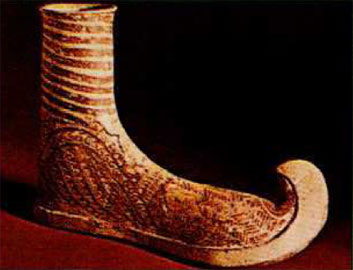 Μυκηναϊκό πήλινο ομοίωμα υποδήματος, παρόμοιο με τυρρηνική μπότα.
Οι «μπότες» εμφανίζονται ήδη στη μινωική εποχή, σε τοιχογραφία από το ανάκτορο της Κνωσού ή στο «κύπελο του πρίγκιπα» από την Αγία Τριάδα αλλά και στο μυκηναϊκό χρυσό κύπελο από το Βαφειό και τον «κρατήρα των πολεμιστών». Αἱ ἐνδρομίδες ήταν μπότες στρατιωτικές και στην αγγειογραφία φοριούνται από την Άρτεμη, τον Ερμή και τις Αμαζόνες. Αἱ ἀρβύλαι είναι για τους κυνηγούς, τους χωρικούς και τους οδοιπόρους. Αἱ σκυθικαί, αἱ σικυώνιαι και αἱ τυρρηνικαί ονομάζονται από τον τόπο προέλευσής τους. Χωρικές μπότες ήταν αἱ καρβάτιναι και οι φτιαγμένες από δέρματα ἀδέψητα, που κατάγονται από το μονόδερμα, το πρώτο κλειστό υπόδημα της Νεολιθικής εποχής.
Μυκηναϊκό πήλινο ομοίωμα υποδήματος, παρόμοιο με τυρρηνική μπότα.
Οι «μπότες» εμφανίζονται ήδη στη μινωική εποχή, σε τοιχογραφία από το ανάκτορο της Κνωσού ή στο «κύπελο του πρίγκιπα» από την Αγία Τριάδα αλλά και στο μυκηναϊκό χρυσό κύπελο από το Βαφειό και τον «κρατήρα των πολεμιστών». Αἱ ἐνδρομίδες ήταν μπότες στρατιωτικές και στην αγγειογραφία φοριούνται από την Άρτεμη, τον Ερμή και τις Αμαζόνες. Αἱ ἀρβύλαι είναι για τους κυνηγούς, τους χωρικούς και τους οδοιπόρους. Αἱ σκυθικαί, αἱ σικυώνιαι και αἱ τυρρηνικαί ονομάζονται από τον τόπο προέλευσής τους. Χωρικές μπότες ήταν αἱ καρβάτιναι και οι φτιαγμένες από δέρματα ἀδέψητα, που κατάγονται από το μονόδερμα, το πρώτο κλειστό υπόδημα της Νεολιθικής εποχής.
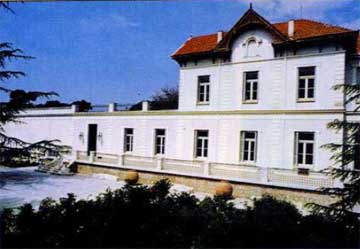 Μουσείο Φυσικής Ιστορίας Γουλανδρή.
Τα περισσότερα αντικείμενα που βρίσκουμε στις ανασκαφές είναι σπασμένα σε μικρά ή μεγαλύτερα κομμάτια. Η συγκόλλησή τους, μια δουλειά που μοιάζει με παζλ, γίνεται στα εργαστήρια συντήρησης των Μουσείων. Μουσειακά αντικείμενα όμως, δεν είναι μόνο τα αρχαία. Κάθε ιστορική περίοδος, κάθε θέμα έχει το μουσείο του.
Μουσείο Φυσικής Ιστορίας Γουλανδρή.
Τα περισσότερα αντικείμενα που βρίσκουμε στις ανασκαφές είναι σπασμένα σε μικρά ή μεγαλύτερα κομμάτια. Η συγκόλλησή τους, μια δουλειά που μοιάζει με παζλ, γίνεται στα εργαστήρια συντήρησης των Μουσείων. Μουσειακά αντικείμενα όμως, δεν είναι μόνο τα αρχαία. Κάθε ιστορική περίοδος, κάθε θέμα έχει το μουσείο του.
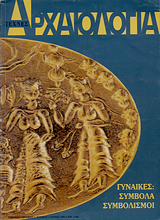
 Bachofen: ο εμπνευστής της «μητριαρχίας».
Η επιστήμη της Αρχαιολογίας δεν μπορεί πια να αγνοεί όσους προπαγανδίζουν ότι η μητριαρχία είναι μια περίοδος της προϊστορίας. Ιστορική αφορμή αυτής της θεωρίας υπήρξε η ανακάλυψη, τον 18ο αιώνα, των «εξωτικών» λαών που εφήρμοζαν το μητρικό δίκαιο. Η θεωρία συνδέεται άρρηκτα με τη μορφή του Ελβετού Bachofen (1815-1887) που, στο βιβλίο του για το Μητρικό Δίκαιο και στο πλαίσιο μιας εξελικτικής θεωρίας της ανθρωπότητας, βλέπει τη μητριαρχία και την πατριαρχία ως το πέρασμα από την αρχέγονη ύλη στο πνεύμα. Η επίδρασή του ανιχνεύεται στην Καταγωγή της Οικογένειας του Ένγκελς. Στη μελλοντική ουτοπία προς την «πορεία της λύτρωσης όλων των καταπιεσμένων», οι θεωρητικοί του σοσιαλισμού συμπεριέλαβαν και τις γυναίκες. Η μητριαρχία ως χειραφέτηση υπήρξε εφιάλτης για τους Γερμανούς εθνικοσοσιαλιστές, που την παρέκαμψαν μέσω της λατρείας της μητρότητας. Στη δεκαετία του ’70, στις ΗΠΑ και τη Γερμανία, αναπτύσσεται ο «σπιριτουαλιστικός φεμινισμός» με οικολογικές ανησυχίες, ρεύμα που, την επόμενη δεκαετία, μετεξελίχθηκε σε ένα είδος «θρησκείας της γυναίκας».
Οι έρευνες για τη μητριαρχία επικαλέστηκαν και αρχαιολογικές πηγές χωρίς να διστάσουν να γενικεύσουν τα αρχαιολογικά πορίσματα. Στη χρονική διάρκεια της ευρωπαϊκής παλαιολιθικής περιόδου, ειδώλια σαν την Αφροδίτη του Willendorf, την υποτιθέμενη θεά που ενσαρκώνει τη «μητέρα γη», όχι μόνο αποτελούν εξαίρεση αλλά δεν αποτελούν καν πρότυπο για τις γυναικείες μορφές που εμφανίζουν μεγάλη ποικιλομορφία. Ο νεολιθικός οικισμός του Çatalhöyük αναδείχθηκε σε κλασικό υπόδειγμα μητριαρχικής πόλης. Καταλυτικός υπήρξε ο ρόλος της προϊστορικής αρχαιολόγου Marija Gimbutas που, με συναισθηματική φόρτιση, μετέφρασε τη «γλώσσα της θεάς». Συμφύροντας διάφορες επιστήμες, με τη μέθοδο της «Αρχαιο-μυθολογίας» της κατέληξε στη θεωρία της Μεγάλης Θεάς που αντιπροσώπευε το σύμπαν και είχε τρεις διαστάσεις: τη γονιμότητα, το θάνατο και την ανανέωση. Λίγα μόνο νησιά της Μεσογείου, λέει, διατήρησαν τον μητριαρχικό πολιτισμό ως το 1500 π.Χ. Ανάμεσά τους, η Κρήτη. Στα ανάκτορα της Κνωσού, που με ρομαντική διάθεση αναστήλωσε ο Evans, οι τοιχογραφίες που ανακατασκεύασαν δύο Ελβετοί, «art nouveau» ζωγράφοι, κρύβουν ερμηνευτικές παγίδες. Ξεπερασμένα συμπεράσματα ανασύρονται προκειμένου να αποδειχθεί ότι η μινωική Κρήτη υπήρξε το τελευταίο οχυρό της μητριαρχίας.
Ελλείψει γραπτών πηγών, η αμφισημία των προϊστορικών ευρημάτων ισοπεδώνεται από μια θεωρία που αναζητεί σε αυτά «αποδείξεις» ενός οικουμενικού μητριαρχικού προτύπου. Ανάμεσα στην απόδειξη που απαιτεί η αρχαιολογία και την διαισθητική γνώση που επικαλείται η θεωρία της μητριαρχίας δεν μπορεί να υπάρξει συμβιβασμός. Ωστόσο, μπορούν να βρεθούν σημεία επαφής. Παράδειγμα: ο υπεύθυνος του προγράμματος για το Çatalhöyük αντιμετώπισε συχνά στο Internet γυναίκες «who believe the site is important in the emergence of the Goddess», και από τον Ιανουάριο του 1998 συνδιαλέγεται μέσω του ηλεκτρονικού ταχυδρομείου με μια εκπρόσωπο της «Goddess community».
Bachofen: ο εμπνευστής της «μητριαρχίας».
Η επιστήμη της Αρχαιολογίας δεν μπορεί πια να αγνοεί όσους προπαγανδίζουν ότι η μητριαρχία είναι μια περίοδος της προϊστορίας. Ιστορική αφορμή αυτής της θεωρίας υπήρξε η ανακάλυψη, τον 18ο αιώνα, των «εξωτικών» λαών που εφήρμοζαν το μητρικό δίκαιο. Η θεωρία συνδέεται άρρηκτα με τη μορφή του Ελβετού Bachofen (1815-1887) που, στο βιβλίο του για το Μητρικό Δίκαιο και στο πλαίσιο μιας εξελικτικής θεωρίας της ανθρωπότητας, βλέπει τη μητριαρχία και την πατριαρχία ως το πέρασμα από την αρχέγονη ύλη στο πνεύμα. Η επίδρασή του ανιχνεύεται στην Καταγωγή της Οικογένειας του Ένγκελς. Στη μελλοντική ουτοπία προς την «πορεία της λύτρωσης όλων των καταπιεσμένων», οι θεωρητικοί του σοσιαλισμού συμπεριέλαβαν και τις γυναίκες. Η μητριαρχία ως χειραφέτηση υπήρξε εφιάλτης για τους Γερμανούς εθνικοσοσιαλιστές, που την παρέκαμψαν μέσω της λατρείας της μητρότητας. Στη δεκαετία του ’70, στις ΗΠΑ και τη Γερμανία, αναπτύσσεται ο «σπιριτουαλιστικός φεμινισμός» με οικολογικές ανησυχίες, ρεύμα που, την επόμενη δεκαετία, μετεξελίχθηκε σε ένα είδος «θρησκείας της γυναίκας».
Οι έρευνες για τη μητριαρχία επικαλέστηκαν και αρχαιολογικές πηγές χωρίς να διστάσουν να γενικεύσουν τα αρχαιολογικά πορίσματα. Στη χρονική διάρκεια της ευρωπαϊκής παλαιολιθικής περιόδου, ειδώλια σαν την Αφροδίτη του Willendorf, την υποτιθέμενη θεά που ενσαρκώνει τη «μητέρα γη», όχι μόνο αποτελούν εξαίρεση αλλά δεν αποτελούν καν πρότυπο για τις γυναικείες μορφές που εμφανίζουν μεγάλη ποικιλομορφία. Ο νεολιθικός οικισμός του Çatalhöyük αναδείχθηκε σε κλασικό υπόδειγμα μητριαρχικής πόλης. Καταλυτικός υπήρξε ο ρόλος της προϊστορικής αρχαιολόγου Marija Gimbutas που, με συναισθηματική φόρτιση, μετέφρασε τη «γλώσσα της θεάς». Συμφύροντας διάφορες επιστήμες, με τη μέθοδο της «Αρχαιο-μυθολογίας» της κατέληξε στη θεωρία της Μεγάλης Θεάς που αντιπροσώπευε το σύμπαν και είχε τρεις διαστάσεις: τη γονιμότητα, το θάνατο και την ανανέωση. Λίγα μόνο νησιά της Μεσογείου, λέει, διατήρησαν τον μητριαρχικό πολιτισμό ως το 1500 π.Χ. Ανάμεσά τους, η Κρήτη. Στα ανάκτορα της Κνωσού, που με ρομαντική διάθεση αναστήλωσε ο Evans, οι τοιχογραφίες που ανακατασκεύασαν δύο Ελβετοί, «art nouveau» ζωγράφοι, κρύβουν ερμηνευτικές παγίδες. Ξεπερασμένα συμπεράσματα ανασύρονται προκειμένου να αποδειχθεί ότι η μινωική Κρήτη υπήρξε το τελευταίο οχυρό της μητριαρχίας.
Ελλείψει γραπτών πηγών, η αμφισημία των προϊστορικών ευρημάτων ισοπεδώνεται από μια θεωρία που αναζητεί σε αυτά «αποδείξεις» ενός οικουμενικού μητριαρχικού προτύπου. Ανάμεσα στην απόδειξη που απαιτεί η αρχαιολογία και την διαισθητική γνώση που επικαλείται η θεωρία της μητριαρχίας δεν μπορεί να υπάρξει συμβιβασμός. Ωστόσο, μπορούν να βρεθούν σημεία επαφής. Παράδειγμα: ο υπεύθυνος του προγράμματος για το Çatalhöyük αντιμετώπισε συχνά στο Internet γυναίκες «who believe the site is important in the emergence of the Goddess», και από τον Ιανουάριο του 1998 συνδιαλέγεται μέσω του ηλεκτρονικού ταχυδρομείου με μια εκπρόσωπο της «Goddess community».
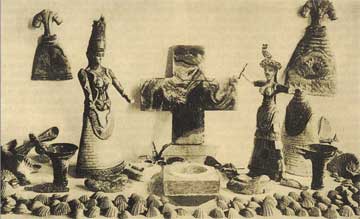 Πήλινα ειδώλια από την Κνωσό.
Η έλλειψη γραπτών πηγών παρεμποδίζει την ερμηνεία των προϊστορικών ευρημάτων. Αβοήθητοι, αντικρύζουμε μόνο τα τελετουργικά σκεύη μιας άγνωστης ιεροπραξίας. Δίχως μυθικά και λατρευτικά συμφραζόμενα, οι γυναικείες απεικονίσεις κινδυνεύουν να παρερμηνευθούν. Στους προϊστορικούς χρόνους του Αιγαίου, οι απεικονίσεις ανδρών σπανίζουν και οι αρσενικές θεότητες δεν παίζουν κανένα ρόλο. Ωστόσο, η εξαγωγή κοινωνιολογικών συμπερασμάτων από τα υλικά υπολείμματα θα ήταν ανόητη.
Αναγνωρίζουμε την παντοδυναμία μιας θεάς στις απεικονίσεις της γυναικείας μορφής που δαμάζει ζώα. Είναι οι απεικονίσεις απλά η αποκρυστάλλωση της λατρείας της θεότητας ή και τα ίδια τα είδωλα επενδύονται με θεϊκές δυνάμεις; Και οι δύο περιπτώσεις φαίνεται να ισχύουν την εποχή του Χαλκού στον αιγαιακό χώρο.
Στα όρθια κυκλαδικά ειδώλια της πρώιμης εποχής του Χαλκού αναγνωρίζουμε τις ύστερες νεολιθικές μορφές που συμβολίζουν τη γονιμότητα και τη δημιουργία. Η ευρύτατη παρουσία τους τόσο μέσα στον οικισμό όσο και στους τάφους υποδεικνύει την κυριαρχία της θεάς στη ζωή και στο θάνατο.
Η θεά είχε απήχηση και στην Κρήτη, όπου όχι μόνο βρέθηκαν κυκλαδικά της ειδώλια (Αρχάνες) αλλά δημιουργήθηκε και μια τοπική της εκδοχή, ο τύπος της Κουμάσας. Στα λιγοστά ανθρωπόμορφα σπονδικά αγγεία της προανακτορικής περιόδου, η γυναικεία θεά φοράει ήδη μακριά φούστα. Όμως, από τη στιγμή αυτή έως και την παλαιοανακτορική περίοδο, τα ομοιώματα της θεάς αντικαθίστανται με αφιερώματα που της προσφέρουν οι προσκυνητές της στα ιερά κορυφής, ομοιώματα ολόσωμων μορφών, μελών του σώματος, ζώων ή και κοπαδιών. Η παράσταση της θεάς θα αλλάξει παραμένοντας ίδια ως τους αρχαϊκούς χρόνους: ντυμένη με υψηλόβαθμη αυλική φορεσιά, η θεά εξουσιάζει τα φίδια.
Την πρώιμη και τη μέση εποχή του Χαλκού, στην κεντρική Ελλάδα η θρησκεία φαίνεται να είναι ανεικονική, ενώ στην ύστερη εποχή του Χαλκού υιοθετείται όλο το μινωικό ρεπερτόριο απεικονίσεων. Στο απόγειο της περιόδου αυτής σημειώνεται μια τομή. Πληθώρα μικρών πήλινων ειδωλίων της θεάς, του τύπου Φι, Ψι και Ταυ, κατακλύζουν την κεντρική Ελλάδα. Από τα ονόματα των θεών στις πινακίδες του Αρχείου της Πύλου, τίποτα δεν παραπέμπει στη μία και μοναδική θεά. Πρόκειται άραγε για τη συνύπαρξη, με τοπικές παραλλαγές, δύο δογμάτων επίσημης και λαϊκής λατρείας που θα επιβιώσουν και μετά το τέλος των σκοτεινών αιώνων έως ότου αντικατασταθούν από τους ολύμπιους θεούς; Στην Κρήτη, όμως, ούτε το πέρασμα των Δωριέων δεν θα μπορέσει να σβήσει τα ίχνη της θεάς του Αιγαίου. Η θεά είναι μία και έχει πολλά ονόματα.
Πήλινα ειδώλια από την Κνωσό.
Η έλλειψη γραπτών πηγών παρεμποδίζει την ερμηνεία των προϊστορικών ευρημάτων. Αβοήθητοι, αντικρύζουμε μόνο τα τελετουργικά σκεύη μιας άγνωστης ιεροπραξίας. Δίχως μυθικά και λατρευτικά συμφραζόμενα, οι γυναικείες απεικονίσεις κινδυνεύουν να παρερμηνευθούν. Στους προϊστορικούς χρόνους του Αιγαίου, οι απεικονίσεις ανδρών σπανίζουν και οι αρσενικές θεότητες δεν παίζουν κανένα ρόλο. Ωστόσο, η εξαγωγή κοινωνιολογικών συμπερασμάτων από τα υλικά υπολείμματα θα ήταν ανόητη.
Αναγνωρίζουμε την παντοδυναμία μιας θεάς στις απεικονίσεις της γυναικείας μορφής που δαμάζει ζώα. Είναι οι απεικονίσεις απλά η αποκρυστάλλωση της λατρείας της θεότητας ή και τα ίδια τα είδωλα επενδύονται με θεϊκές δυνάμεις; Και οι δύο περιπτώσεις φαίνεται να ισχύουν την εποχή του Χαλκού στον αιγαιακό χώρο.
Στα όρθια κυκλαδικά ειδώλια της πρώιμης εποχής του Χαλκού αναγνωρίζουμε τις ύστερες νεολιθικές μορφές που συμβολίζουν τη γονιμότητα και τη δημιουργία. Η ευρύτατη παρουσία τους τόσο μέσα στον οικισμό όσο και στους τάφους υποδεικνύει την κυριαρχία της θεάς στη ζωή και στο θάνατο.
Η θεά είχε απήχηση και στην Κρήτη, όπου όχι μόνο βρέθηκαν κυκλαδικά της ειδώλια (Αρχάνες) αλλά δημιουργήθηκε και μια τοπική της εκδοχή, ο τύπος της Κουμάσας. Στα λιγοστά ανθρωπόμορφα σπονδικά αγγεία της προανακτορικής περιόδου, η γυναικεία θεά φοράει ήδη μακριά φούστα. Όμως, από τη στιγμή αυτή έως και την παλαιοανακτορική περίοδο, τα ομοιώματα της θεάς αντικαθίστανται με αφιερώματα που της προσφέρουν οι προσκυνητές της στα ιερά κορυφής, ομοιώματα ολόσωμων μορφών, μελών του σώματος, ζώων ή και κοπαδιών. Η παράσταση της θεάς θα αλλάξει παραμένοντας ίδια ως τους αρχαϊκούς χρόνους: ντυμένη με υψηλόβαθμη αυλική φορεσιά, η θεά εξουσιάζει τα φίδια.
Την πρώιμη και τη μέση εποχή του Χαλκού, στην κεντρική Ελλάδα η θρησκεία φαίνεται να είναι ανεικονική, ενώ στην ύστερη εποχή του Χαλκού υιοθετείται όλο το μινωικό ρεπερτόριο απεικονίσεων. Στο απόγειο της περιόδου αυτής σημειώνεται μια τομή. Πληθώρα μικρών πήλινων ειδωλίων της θεάς, του τύπου Φι, Ψι και Ταυ, κατακλύζουν την κεντρική Ελλάδα. Από τα ονόματα των θεών στις πινακίδες του Αρχείου της Πύλου, τίποτα δεν παραπέμπει στη μία και μοναδική θεά. Πρόκειται άραγε για τη συνύπαρξη, με τοπικές παραλλαγές, δύο δογμάτων επίσημης και λαϊκής λατρείας που θα επιβιώσουν και μετά το τέλος των σκοτεινών αιώνων έως ότου αντικατασταθούν από τους ολύμπιους θεούς; Στην Κρήτη, όμως, ούτε το πέρασμα των Δωριέων δεν θα μπορέσει να σβήσει τα ίχνη της θεάς του Αιγαίου. Η θεά είναι μία και έχει πολλά ονόματα.
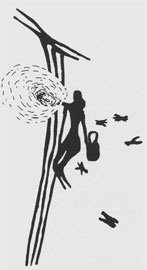 Γυναίκα συλλέγει μέλι.
Το αντροκεντρικό πρότυπο του «άνδρα κυνηγού» και της παιδοποιού γυναίκας οφείλει να επανεξεταστεί. Αν οι δυνατότεροι άντρες ασχολούνται με το κυνήγι μεγάλων θηλαστικών, αν η μητρότητα δεν επιτρέπει σε κάποιες γυναίκες να απουσιάζουν για μέρες από τον καταυλισμό, τίποτα δεν εμποδίζει τις υπόλοιπες γυναίκες να συμμετάσχουν σε μεικτές ομάδες για το κυνήγι μικρών ζώων, όπως τα ελάφια. Αλλά και οι μητέρες μπορούν, σε κοντινή ακτίνα, να προσφέρουν ψαρεύοντας, συλλέγοντας φυτικές τροφές και αυγά, κυνηγώντας μικρά ζώα. Μπορούν κάλλιστα να αναλάβουν τις καλλιέργειες φυτών, τη φροντίδα των εξημερωμένων ζώων, την επεξεργασία του μαλλιού, του γάλακτος και του λίπους τους. Γυναίκες εξοικειωμένες με το ζύμωμα και το ψήσιμο του ψωμιού μπορούν να χειριστούν την παραπλήσια τεχνική της παραγωγής πήλινων σκευών. Υφαίνοντας και ράβοντας, οι γυναίκες μπορούσαν να ντύνουν τους δικούς τους. Στην οργανωμένη νεολιθική κοινωνία, ο ρόλος της γυναίκας αγγίζει το απόγειό του. Τέτοιες ικανές και δραστήριες γυναίκες αναπαρίστανται ιδίως στα πρωιμότερα από τα θεσσαλικά ειδώλια, που η στεατοπυγία τους επιδέχεται διάφορες ερμηνείες. Η μαγειρική συνέδεσε τις γυναίκες με την εστία, σύμβολο οικογενειακής ενότητας. Αλλά και το σπίτι, πέρασμα από το «άγριο» στο «ήμερο», έγινε σύμβολο της εξουσίας τους. Ειδώλια που αναπαριστούν οικιακές δραστηριότητες θεωρείται πως απεικονίζουν γυναίκες, αν και δεν υπάρχει ένδειξη φύλου. Δεν πρέπει όμως να αποκλειστεί η συμμετοχή των αντρών στις οικιακές εργασίες. Ο οριστικός διαχωρισμός των ρόλων των δύο φύλων επήλθε αργότερα, με τη σταδιακή συστηματοποίηση της παραγωγής και τη συνεπακόλουθη αλλαγή των κοινωνικών κριτηρίων
Γυναίκα συλλέγει μέλι.
Το αντροκεντρικό πρότυπο του «άνδρα κυνηγού» και της παιδοποιού γυναίκας οφείλει να επανεξεταστεί. Αν οι δυνατότεροι άντρες ασχολούνται με το κυνήγι μεγάλων θηλαστικών, αν η μητρότητα δεν επιτρέπει σε κάποιες γυναίκες να απουσιάζουν για μέρες από τον καταυλισμό, τίποτα δεν εμποδίζει τις υπόλοιπες γυναίκες να συμμετάσχουν σε μεικτές ομάδες για το κυνήγι μικρών ζώων, όπως τα ελάφια. Αλλά και οι μητέρες μπορούν, σε κοντινή ακτίνα, να προσφέρουν ψαρεύοντας, συλλέγοντας φυτικές τροφές και αυγά, κυνηγώντας μικρά ζώα. Μπορούν κάλλιστα να αναλάβουν τις καλλιέργειες φυτών, τη φροντίδα των εξημερωμένων ζώων, την επεξεργασία του μαλλιού, του γάλακτος και του λίπους τους. Γυναίκες εξοικειωμένες με το ζύμωμα και το ψήσιμο του ψωμιού μπορούν να χειριστούν την παραπλήσια τεχνική της παραγωγής πήλινων σκευών. Υφαίνοντας και ράβοντας, οι γυναίκες μπορούσαν να ντύνουν τους δικούς τους. Στην οργανωμένη νεολιθική κοινωνία, ο ρόλος της γυναίκας αγγίζει το απόγειό του. Τέτοιες ικανές και δραστήριες γυναίκες αναπαρίστανται ιδίως στα πρωιμότερα από τα θεσσαλικά ειδώλια, που η στεατοπυγία τους επιδέχεται διάφορες ερμηνείες. Η μαγειρική συνέδεσε τις γυναίκες με την εστία, σύμβολο οικογενειακής ενότητας. Αλλά και το σπίτι, πέρασμα από το «άγριο» στο «ήμερο», έγινε σύμβολο της εξουσίας τους. Ειδώλια που αναπαριστούν οικιακές δραστηριότητες θεωρείται πως απεικονίζουν γυναίκες, αν και δεν υπάρχει ένδειξη φύλου. Δεν πρέπει όμως να αποκλειστεί η συμμετοχή των αντρών στις οικιακές εργασίες. Ο οριστικός διαχωρισμός των ρόλων των δύο φύλων επήλθε αργότερα, με τη σταδιακή συστηματοποίηση της παραγωγής και τη συνεπακόλουθη αλλαγή των κοινωνικών κριτηρίων
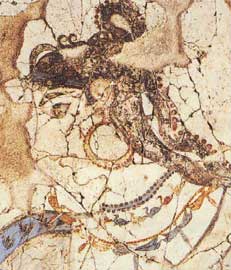 «Πότνια Θηρών» (λεπτομέρεια).
Κινούμενη ανάμεσα στην αρχαιολογία και την ανθρωπολογία, η συγγραφέας ερμηνεύει τις τοιχογραφίες από την Ξεστή 3, στο Ακρωτήρι της Θήρας. Το κτήριο, είδος μινωικής έπαυλης, είχε τουλάχιστον 13 δωμάτια και περιελάμβανε βύθισμα μέσα στο έδαφος, ένα άδυτον, για τελετουργικούς σκοπούς. Έχουν οι τοιχογραφίες του αδύτου, και πιθανόν όλου του κτηρίου, σχέση με διαβατήριες τελετές; Για να τις κατανοήσουμε πλήρως, οφείλουμε να τις αντιμετωπίσουμε ως σύνολο, εστιάζοντας στις μεταξύ τους σχέσεις. Οι διαφορές στην κόμμωση και την ενδυμασία υποδηλώνουν την ηλικιακή διάκριση. Τα κορίτσια διακρίνονται από την έλλειψη στήθους, το ξυρισμένο κεφάλι (γαλάζιο κρανίο) και τα κοντά τους μαλλιά. Οι γυναίκες που έχουν γνωρίσει τη μητρότητα έχουν μακριά μαλλιά και μεγάλα, προεξέχοντα στήθη. Στην αίθουσα 3, σε μια τελετουργική σκηνή με πιθανό μυητικό χαρακτήρα, οι «Κροκοσυλλέκτριες», κορίτσια με λαμπερές ενδυμασίες και κοσμήματα, προσφέρουν κρόκους σε μια καθιστή θεά με περίτεχνη κόμμωση, που περιβάλλεται από έναν πίθηκο κι ένα φύλακα γρύπα. Η σκηνή υποδηλώνει ότι το πέρασμα από την εφηβεία στην ώριμη ηλικία συνδέεται με μια θρησκευτική τελετουργία. Τά κορίτσια κινούνται στα βουνά, σε ένα χώρο μακριά από το άστυ όπου φύονται κρόκοι, και αυτό σηματοδοτεί μια διαβατήρια τελετή (A. Van Gennep, V. Turner). Οι ώριμες γυναίκες της ίδιας εικονογραφικής ενότητας τιμούν τη θεά σε διαφορετικό τοίχο, ξέχωρα από τα κορίτσια. Ο ίδιος ο στολισμός της θεάς με πάπιες, λιβελλούλες και άνθη κρόκων συνδυάζεται με γειτονικές τοιχογραφίες που παριστάνουν πάπιες, αρσενικές και θηλυκές, που ερωτοτροπούν, και χελιδόνια που φέρνουν λιβελλούλες στα νεογνά τους. Ο συνδυασμός παραπέμπει στην ιδέα της αναζωογόνησης και του κύκλου της ζωής. Οι πίθηκοι, που στο δωμάτιο 4 πανηγυρίζουν τη ζωή, αποτελούν σε πολλούς πολιτισμούς κατάλληλο σύμβολο για τη μύηση, καθώς θεωρείται ότι βρίσκονται «ανάμεσα και μεταξύ» των ανθρώπων, των ζώων και του θείου. Η τοιχογραφία του αδύτου απεικονίζει τρεις κοπέλες σε τρία στάδια της γυναικείας τους ανάπτυξης. Η νεότερη με το ξυρισμένο (γαλάζιο) κεφάλι δείχνει ξαφνιασμένη μπροστά σε ένα ιερό με μεγάλη θύρα. Τα κέρατα στα οποία απολήγει η θύρα στάζουν αίμα. Η πύλη είναι πέρασμα και μετάβαση σε άλλο κόσμο. Το γεγονός ότι δεν υπάρχει ένδειξη πως η τελετή μυήσεως συνδεόταν με το γάμο, πρέπει να ερμηνευτεί ως έλλειψη ενδιαφέροντος για την προβολή αυτής της αξίας σε ιδεολογικό επίπεδο.
«Πότνια Θηρών» (λεπτομέρεια).
Κινούμενη ανάμεσα στην αρχαιολογία και την ανθρωπολογία, η συγγραφέας ερμηνεύει τις τοιχογραφίες από την Ξεστή 3, στο Ακρωτήρι της Θήρας. Το κτήριο, είδος μινωικής έπαυλης, είχε τουλάχιστον 13 δωμάτια και περιελάμβανε βύθισμα μέσα στο έδαφος, ένα άδυτον, για τελετουργικούς σκοπούς. Έχουν οι τοιχογραφίες του αδύτου, και πιθανόν όλου του κτηρίου, σχέση με διαβατήριες τελετές; Για να τις κατανοήσουμε πλήρως, οφείλουμε να τις αντιμετωπίσουμε ως σύνολο, εστιάζοντας στις μεταξύ τους σχέσεις. Οι διαφορές στην κόμμωση και την ενδυμασία υποδηλώνουν την ηλικιακή διάκριση. Τα κορίτσια διακρίνονται από την έλλειψη στήθους, το ξυρισμένο κεφάλι (γαλάζιο κρανίο) και τα κοντά τους μαλλιά. Οι γυναίκες που έχουν γνωρίσει τη μητρότητα έχουν μακριά μαλλιά και μεγάλα, προεξέχοντα στήθη. Στην αίθουσα 3, σε μια τελετουργική σκηνή με πιθανό μυητικό χαρακτήρα, οι «Κροκοσυλλέκτριες», κορίτσια με λαμπερές ενδυμασίες και κοσμήματα, προσφέρουν κρόκους σε μια καθιστή θεά με περίτεχνη κόμμωση, που περιβάλλεται από έναν πίθηκο κι ένα φύλακα γρύπα. Η σκηνή υποδηλώνει ότι το πέρασμα από την εφηβεία στην ώριμη ηλικία συνδέεται με μια θρησκευτική τελετουργία. Τά κορίτσια κινούνται στα βουνά, σε ένα χώρο μακριά από το άστυ όπου φύονται κρόκοι, και αυτό σηματοδοτεί μια διαβατήρια τελετή (A. Van Gennep, V. Turner). Οι ώριμες γυναίκες της ίδιας εικονογραφικής ενότητας τιμούν τη θεά σε διαφορετικό τοίχο, ξέχωρα από τα κορίτσια. Ο ίδιος ο στολισμός της θεάς με πάπιες, λιβελλούλες και άνθη κρόκων συνδυάζεται με γειτονικές τοιχογραφίες που παριστάνουν πάπιες, αρσενικές και θηλυκές, που ερωτοτροπούν, και χελιδόνια που φέρνουν λιβελλούλες στα νεογνά τους. Ο συνδυασμός παραπέμπει στην ιδέα της αναζωογόνησης και του κύκλου της ζωής. Οι πίθηκοι, που στο δωμάτιο 4 πανηγυρίζουν τη ζωή, αποτελούν σε πολλούς πολιτισμούς κατάλληλο σύμβολο για τη μύηση, καθώς θεωρείται ότι βρίσκονται «ανάμεσα και μεταξύ» των ανθρώπων, των ζώων και του θείου. Η τοιχογραφία του αδύτου απεικονίζει τρεις κοπέλες σε τρία στάδια της γυναικείας τους ανάπτυξης. Η νεότερη με το ξυρισμένο (γαλάζιο) κεφάλι δείχνει ξαφνιασμένη μπροστά σε ένα ιερό με μεγάλη θύρα. Τα κέρατα στα οποία απολήγει η θύρα στάζουν αίμα. Η πύλη είναι πέρασμα και μετάβαση σε άλλο κόσμο. Το γεγονός ότι δεν υπάρχει ένδειξη πως η τελετή μυήσεως συνδεόταν με το γάμο, πρέπει να ερμηνευτεί ως έλλειψη ενδιαφέροντος για την προβολή αυτής της αξίας σε ιδεολογικό επίπεδο.
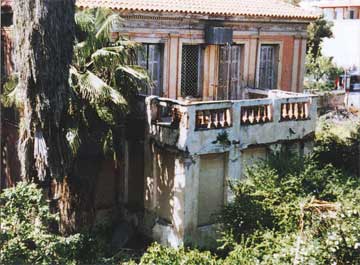 Η οικία Τρικούπη το 1998.
Αν και τα Αρχεία Αργολίδας δεν το μαρτυρούν ούτε υπάρχει άλλη επιβεβαίωση, θεωρείται αποδεκτό ότι ο Χαρίλαος Τρικούπης γεννήθηκε στο Ναύπλιο. Το σπίτι του πατέρα του Σπυρίδωνος, στο Άργος, πωλήθηκε το 1847 στον Π.Α. Κυπαρίσση και μεταπωλήθηκε στον εφέτη Νικ. Οικονόμου (Κωλέττη). Το σπίτι ήταν γνωστό με το όνομα «οικία Τρικούπη» ως το 1940 και ως «σπίτι του Κωλέττη» στη διάρκεια του Β΄ Παγκόσμιου Πολέμου και τον Εμφύλιο. Το 1982, το ΥΧΟΠ, με πρωτοβουλία του Γ. Πλυτά που προώθησε σθεναρά ο Αντ. Τρίτσης, χαρακτήρισε το σπίτι διατηρητέο. Το 1983 το ΥΠΠΟ χαρακτήρισε την οικία ως έργο τέχνης. Το 1985, οι κληρονόμοι Οικονόμου, που είχαν προσβάλει όλες τις προηγούμενες αποφάσεις, μεταβίβασαν την όλη ιδιοκτησία έναντι 49,5 εκατομμυρίων στην Αγροτική Τράπεζα, που έμελλε να επιδείξει πλήρη αδιαφορία για το κτίριο που κινδυνεύει από ολική κατάρρευση. Δημοσιεύματα στον αθηναϊκό Τύπο και διαμαρτυρίες δεν αποδίδουν, ενώ τόσο το ΥΠΕΧΩΔΕ όσο και ο Δήμος Άργους αρνούνται να επέμβουν για την αναστήλωση του κτιρίου
Η οικία Τρικούπη το 1998.
Αν και τα Αρχεία Αργολίδας δεν το μαρτυρούν ούτε υπάρχει άλλη επιβεβαίωση, θεωρείται αποδεκτό ότι ο Χαρίλαος Τρικούπης γεννήθηκε στο Ναύπλιο. Το σπίτι του πατέρα του Σπυρίδωνος, στο Άργος, πωλήθηκε το 1847 στον Π.Α. Κυπαρίσση και μεταπωλήθηκε στον εφέτη Νικ. Οικονόμου (Κωλέττη). Το σπίτι ήταν γνωστό με το όνομα «οικία Τρικούπη» ως το 1940 και ως «σπίτι του Κωλέττη» στη διάρκεια του Β΄ Παγκόσμιου Πολέμου και τον Εμφύλιο. Το 1982, το ΥΧΟΠ, με πρωτοβουλία του Γ. Πλυτά που προώθησε σθεναρά ο Αντ. Τρίτσης, χαρακτήρισε το σπίτι διατηρητέο. Το 1983 το ΥΠΠΟ χαρακτήρισε την οικία ως έργο τέχνης. Το 1985, οι κληρονόμοι Οικονόμου, που είχαν προσβάλει όλες τις προηγούμενες αποφάσεις, μεταβίβασαν την όλη ιδιοκτησία έναντι 49,5 εκατομμυρίων στην Αγροτική Τράπεζα, που έμελλε να επιδείξει πλήρη αδιαφορία για το κτίριο που κινδυνεύει από ολική κατάρρευση. Δημοσιεύματα στον αθηναϊκό Τύπο και διαμαρτυρίες δεν αποδίδουν, ενώ τόσο το ΥΠΕΧΩΔΕ όσο και ο Δήμος Άργους αρνούνται να επέμβουν για την αναστήλωση του κτιρίου
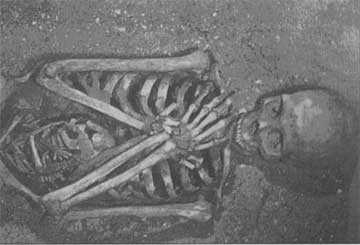 Σπάνια ταφή εγκύου.
Η συγγραφέας περιγράφει λεπτομερώς όλα τα στάδια μεταχείρισης των οστών που πρέπει να έχουν υπ’ όψη τους οι ανασκαφείς, ας είναι και μόνο για να διευκολύνουν μελλοντικές μελέτες. Χημικοί, φυσικοί και βιολογικοί παράγοντες, μεμονωμένοι ή σε συνδυασμό, επηρεάζουν τη διατήρηση των οστών. Η πολύ καλή διατήρηση ακόμη και οργανικών καταλοίπων (π.χ. τρίχες) παρουσιάζεται σε αμμώδη εδάφη ή σε περιοχές που καλύπτονται από πάγο. Εκτός από τον άνθρωπο, βακτήρια και μύκητες, ρίζες, μικρά και μεγάλα θηλαστικά, ακόμη και σαρκοφάγα σαλιγκάρια μπορούν να διαταράξουν το σκελετικό υλικό. Οι αλλοιώσεις που προκαλούνται απασχολούν την ταφονομία. Η προσεκτική αποκάλυψη των οστών από τον αρχαιολόγο θα βοηθήσει τον φυσικό ανθρωπολόγο να εντοπίσει την ηλικία και το φύλο. Πιο περίπλοκη είναι η κατάσταση όταν οι νεκροί βρίσκονται σε διαδοχικά στρώματα. Το δελτίο καταγραφής πρέπει να περιλαμβάνει πληροφορίες για τον τάφο και τα κτερίσματα, κυρίως όμως για το σκελετό. Σημαντική βοήθεια προσφέρουν οι φωτογραφίες αλλά και η σχεδιαστική αποτύπωση των οστών. Ακολουθούν κανόνες για τη μεταφορά και την αποθήκευση των οστών και διερευνάται η περίπτωση καύσης των νεκρών. Το άρθρο τελειώνει με την αισιόδοξη παρατήρηση ότι, έστω και αν οι παρούσες οικονομικές δυνατότητες δεν επιτρέπουν όνειρα, καλό είναι να προετοιμάζεται το έδαφος για ένα ειδικευμένο δυναμικό που αυξάνεται.
Σπάνια ταφή εγκύου.
Η συγγραφέας περιγράφει λεπτομερώς όλα τα στάδια μεταχείρισης των οστών που πρέπει να έχουν υπ’ όψη τους οι ανασκαφείς, ας είναι και μόνο για να διευκολύνουν μελλοντικές μελέτες. Χημικοί, φυσικοί και βιολογικοί παράγοντες, μεμονωμένοι ή σε συνδυασμό, επηρεάζουν τη διατήρηση των οστών. Η πολύ καλή διατήρηση ακόμη και οργανικών καταλοίπων (π.χ. τρίχες) παρουσιάζεται σε αμμώδη εδάφη ή σε περιοχές που καλύπτονται από πάγο. Εκτός από τον άνθρωπο, βακτήρια και μύκητες, ρίζες, μικρά και μεγάλα θηλαστικά, ακόμη και σαρκοφάγα σαλιγκάρια μπορούν να διαταράξουν το σκελετικό υλικό. Οι αλλοιώσεις που προκαλούνται απασχολούν την ταφονομία. Η προσεκτική αποκάλυψη των οστών από τον αρχαιολόγο θα βοηθήσει τον φυσικό ανθρωπολόγο να εντοπίσει την ηλικία και το φύλο. Πιο περίπλοκη είναι η κατάσταση όταν οι νεκροί βρίσκονται σε διαδοχικά στρώματα. Το δελτίο καταγραφής πρέπει να περιλαμβάνει πληροφορίες για τον τάφο και τα κτερίσματα, κυρίως όμως για το σκελετό. Σημαντική βοήθεια προσφέρουν οι φωτογραφίες αλλά και η σχεδιαστική αποτύπωση των οστών. Ακολουθούν κανόνες για τη μεταφορά και την αποθήκευση των οστών και διερευνάται η περίπτωση καύσης των νεκρών. Το άρθρο τελειώνει με την αισιόδοξη παρατήρηση ότι, έστω και αν οι παρούσες οικονομικές δυνατότητες δεν επιτρέπουν όνειρα, καλό είναι να προετοιμάζεται το έδαφος για ένα ειδικευμένο δυναμικό που αυξάνεται.
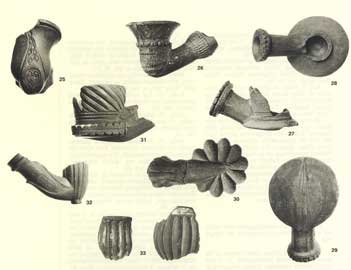 Πήλινες πίπες και ναργιλέδες από τις ανασκαφές του αρχαιολογικού χώρου της Βιβλιοθήκης Αδριανού Αθηνών.
Ο κατεστραμμένος από τους Έρουλους (267 μ.Χ.) χώρος της Βιβλιοθήκης του Αδριανού δεν ερήμωσε στους αιώνες που ακολούθησαν. Προτού μετατραπεί σε στρατώνα και φυλακές στην οθωνική Αθήνα, υπήρξε οχυρωμένο συγκρότημα και κατοικία του βοεβόδα. Ανάμεσα στα κινητά αντικείμενα που έφεραν στο φως οι ανασκαφές, συγκαταλέγονται δεκάδες λουλάδες από τον 17ο αιώνα, πήλινα εξαρτήματα του τσιμπουκιού. Αναγνωρισμένος για τις φαρμακευτικές του ιδιότητες, με το όνομα herba nicotina που πήρε από τον Γάλλο Jean Nicot, ο καπνός διαδόθηκε στους λαούς της Οθωμανικής Αυτοκρατορίας στο τέλος του 16ου ή στις αρχές του 17ου αιώνα. Η προέλευση της ανατολίτικης πήλινης πίπας, του τσιμπουκιού, δεν είναι σαφής. Σαφές όμως είναι ότι ο καπνός, πέρα από την ατομική απόλαυση, λειτούργησε εθιμοτυπικά στην κοινωνική ζωή Ελλήνων και Τούρκων ως μέρος ιεροτελεστίας. Τσιμπούκι, από την τουρκική-περσική λέξη çubuc, λέγεται το συνολικό σκεύος καπνίσματος που αποτελείται από τρία μέρη. Λουλάς είναι το πήλινο σκεύος, στην κοιλότητα του οποίου σιγοκαίει ο καπνός. Ξύλινο σωληνωτό στέλεχος, μήκους από 1 ως 4 μέτρα, το καθαυτό τσιμπούκι, προσαρμόζεται στο στόμιο του λουλά καταλήγοντας, με ή χωρίς επιστόμιο, στο στόμα του καπνιστή. Ενώ οι απλοί καπνιστές και οι μερακλήδες δεν χρησιμοποιούσαν επιστόμιο ώστε να απολαμβάνουν το άρωμα του ξύλου, επιστόμια από κεχριμπάρι, κοράλι, σμάλτο επιχρυσωμένο ή ασημοκαπνισμένο, ακόμη και διαμαντοστόλιστα, εντυπωσίασαν τους περιηγητές. Αν και τον 17ο αιώνα, όταν σουλτανικό διάταγμα απαγόρευσε τη χρήση του καπνού, οι λουλάδες είναι διστακτικού μεγέθους, από τον 18ο αιώνα αναβαθμίζονται τόσο, ώστε το σκάλισμα του καλουπιού τους αποδίδεται σε έμπειρους ασημιτζήδες. Η τυπολογία της διακόσμησης μοιάζει κοινή σε όλες τις χώρες της οθωμανικής κυριαρχίας. Για να γίνει πολυτελής η ευτελής ύλη του λουλά, η επιφάνεια μαλαμώνεται ή αποκτά ένθετα ασημένια στολίδια. Από τον 18ο αιώνα και εξής, μικρές σφραγίδες σηματοδοτούν τον τίτλο της επιχείρησης. Παρέχονται παραδείγματα χρονολόγησης των λουλάδων στον 17ο και 18ο αιώνα. Ως ξεχωριστή κατηγορία εξετάζεται ο λουλάς του ναργιλέ. Η πρωτοπορία του καπνίσματος με ναργιλέ αποδίδεται στην Περσία από τα τέλη του 16ου ή τις αρχές του 17ου αιώνα. Από τους πήλινους λουλάδες που βρέθηκαν στα ανώτερα στρώματα των ανασκαφών της Βιβλιοθήκης του Αδριανού, ιδιαίτερο ενδιαφέρον παρουσιάζουν εκείνοι που φέρουν επιγραφή με ελληνική μεγαλογράμματη γραφή, σπάνια και λατινική
Πήλινες πίπες και ναργιλέδες από τις ανασκαφές του αρχαιολογικού χώρου της Βιβλιοθήκης Αδριανού Αθηνών.
Ο κατεστραμμένος από τους Έρουλους (267 μ.Χ.) χώρος της Βιβλιοθήκης του Αδριανού δεν ερήμωσε στους αιώνες που ακολούθησαν. Προτού μετατραπεί σε στρατώνα και φυλακές στην οθωνική Αθήνα, υπήρξε οχυρωμένο συγκρότημα και κατοικία του βοεβόδα. Ανάμεσα στα κινητά αντικείμενα που έφεραν στο φως οι ανασκαφές, συγκαταλέγονται δεκάδες λουλάδες από τον 17ο αιώνα, πήλινα εξαρτήματα του τσιμπουκιού. Αναγνωρισμένος για τις φαρμακευτικές του ιδιότητες, με το όνομα herba nicotina που πήρε από τον Γάλλο Jean Nicot, ο καπνός διαδόθηκε στους λαούς της Οθωμανικής Αυτοκρατορίας στο τέλος του 16ου ή στις αρχές του 17ου αιώνα. Η προέλευση της ανατολίτικης πήλινης πίπας, του τσιμπουκιού, δεν είναι σαφής. Σαφές όμως είναι ότι ο καπνός, πέρα από την ατομική απόλαυση, λειτούργησε εθιμοτυπικά στην κοινωνική ζωή Ελλήνων και Τούρκων ως μέρος ιεροτελεστίας. Τσιμπούκι, από την τουρκική-περσική λέξη çubuc, λέγεται το συνολικό σκεύος καπνίσματος που αποτελείται από τρία μέρη. Λουλάς είναι το πήλινο σκεύος, στην κοιλότητα του οποίου σιγοκαίει ο καπνός. Ξύλινο σωληνωτό στέλεχος, μήκους από 1 ως 4 μέτρα, το καθαυτό τσιμπούκι, προσαρμόζεται στο στόμιο του λουλά καταλήγοντας, με ή χωρίς επιστόμιο, στο στόμα του καπνιστή. Ενώ οι απλοί καπνιστές και οι μερακλήδες δεν χρησιμοποιούσαν επιστόμιο ώστε να απολαμβάνουν το άρωμα του ξύλου, επιστόμια από κεχριμπάρι, κοράλι, σμάλτο επιχρυσωμένο ή ασημοκαπνισμένο, ακόμη και διαμαντοστόλιστα, εντυπωσίασαν τους περιηγητές. Αν και τον 17ο αιώνα, όταν σουλτανικό διάταγμα απαγόρευσε τη χρήση του καπνού, οι λουλάδες είναι διστακτικού μεγέθους, από τον 18ο αιώνα αναβαθμίζονται τόσο, ώστε το σκάλισμα του καλουπιού τους αποδίδεται σε έμπειρους ασημιτζήδες. Η τυπολογία της διακόσμησης μοιάζει κοινή σε όλες τις χώρες της οθωμανικής κυριαρχίας. Για να γίνει πολυτελής η ευτελής ύλη του λουλά, η επιφάνεια μαλαμώνεται ή αποκτά ένθετα ασημένια στολίδια. Από τον 18ο αιώνα και εξής, μικρές σφραγίδες σηματοδοτούν τον τίτλο της επιχείρησης. Παρέχονται παραδείγματα χρονολόγησης των λουλάδων στον 17ο και 18ο αιώνα. Ως ξεχωριστή κατηγορία εξετάζεται ο λουλάς του ναργιλέ. Η πρωτοπορία του καπνίσματος με ναργιλέ αποδίδεται στην Περσία από τα τέλη του 16ου ή τις αρχές του 17ου αιώνα. Από τους πήλινους λουλάδες που βρέθηκαν στα ανώτερα στρώματα των ανασκαφών της Βιβλιοθήκης του Αδριανού, ιδιαίτερο ενδιαφέρον παρουσιάζουν εκείνοι που φέρουν επιγραφή με ελληνική μεγαλογράμματη γραφή, σπάνια και λατινική
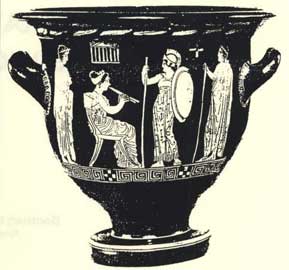 Κρατήρας του 420 π.Χ.
Όψιμες γραπτές πηγές συνδέουν ετυμολογικά τον πυρρίχιο με τον Πύρρο, την πυρά ή κάποιον Πύρριχο, Λάκωνα ή Κρητικό. Εμπνευστές του θεωρούνται οι Κουρήτες, η Αθηνά, οι Διόσκουροι ή οι Αμαζόνες. Άλλοι ένοπλοι χοροί της αρχαιότητας ήταν ο Καλαβρισμός στη Θράκη και την Καρία (Μ. Ασία), ο Τελεσίας στη Μακεδονία και η Καρπαία στη Θεσσαλία. Τον 6ο αιώνα π.Χ., ο πυρρίχιος εισήχθη από τη Σπάρτη στην Αθήνα ως αγώνισμα των Μεγάλων και Μικρών Παναθηναίων, πιθανόν και των εν Άστει Διονυσίων. Με όπλα την ασπίδα, το δόρυ και το τόξο, από πολεμικός μιμητικός χορός στα Παναθήναια, εξελίχθηκε σε χορό που παρίστανε στιγμιότυπα από τη ζωή του Διονύσου. Η Αθηνά είναι η μόνη θεότητα που εκτελεί τον πυρρίχιο, και ο Πλάτων ερμηνεύει το όνομα Παλλάδα από το γεγονός ότι «πάλλεται» στη διάρκεια του χορού. Τον πυρρίχιο εκτελεί στη γέννησή της η πάνοπλη θεά, καθώς ξεπηδάει από το κεφάλι του Δία. Ο ανδρικός πυρρίχιος απεικονίζεται στα αγγεία από το τελευταίο τέταρτο του 6ου αιώνα ως τα μέσα του 5ου, με προτίμηση στην ατομική εκτέλεση που μιμείται μάχη εναντίον αντιπάλου. Οι γυναικείες παραστάσεις είναι λίγες, υστερότερες (μέσα 5ου αιώνα -αρχές 4ου αιώνα π.Χ.) κι εντελώς διαφορετικές. Η συγγραφέας κατατάσσει τις 29 αγγειογραφίες που εξετάζει σε έξι εικονογραφικές κατηγορίες, όπου ο πυρρίχιος, πάντα μιμητικός χορός, εμφανίζεται με τρεις μορφές ως: α) εξάσκηση χορευτριών, β) ψυχαγώγηση ανδρών σε συμπόσιο ή γυναικών στο γυναικωνίτη και γ) στο πλαίσιο της λατρείας της Αρτέμιδος. Με συνοδεία αυλητρίδας, η πυρριχίστρια εκτελεί ατομικό χορό με όπλα που δεν είναι πάντα πραγματικά.
Κρατήρας του 420 π.Χ.
Όψιμες γραπτές πηγές συνδέουν ετυμολογικά τον πυρρίχιο με τον Πύρρο, την πυρά ή κάποιον Πύρριχο, Λάκωνα ή Κρητικό. Εμπνευστές του θεωρούνται οι Κουρήτες, η Αθηνά, οι Διόσκουροι ή οι Αμαζόνες. Άλλοι ένοπλοι χοροί της αρχαιότητας ήταν ο Καλαβρισμός στη Θράκη και την Καρία (Μ. Ασία), ο Τελεσίας στη Μακεδονία και η Καρπαία στη Θεσσαλία. Τον 6ο αιώνα π.Χ., ο πυρρίχιος εισήχθη από τη Σπάρτη στην Αθήνα ως αγώνισμα των Μεγάλων και Μικρών Παναθηναίων, πιθανόν και των εν Άστει Διονυσίων. Με όπλα την ασπίδα, το δόρυ και το τόξο, από πολεμικός μιμητικός χορός στα Παναθήναια, εξελίχθηκε σε χορό που παρίστανε στιγμιότυπα από τη ζωή του Διονύσου. Η Αθηνά είναι η μόνη θεότητα που εκτελεί τον πυρρίχιο, και ο Πλάτων ερμηνεύει το όνομα Παλλάδα από το γεγονός ότι «πάλλεται» στη διάρκεια του χορού. Τον πυρρίχιο εκτελεί στη γέννησή της η πάνοπλη θεά, καθώς ξεπηδάει από το κεφάλι του Δία. Ο ανδρικός πυρρίχιος απεικονίζεται στα αγγεία από το τελευταίο τέταρτο του 6ου αιώνα ως τα μέσα του 5ου, με προτίμηση στην ατομική εκτέλεση που μιμείται μάχη εναντίον αντιπάλου. Οι γυναικείες παραστάσεις είναι λίγες, υστερότερες (μέσα 5ου αιώνα -αρχές 4ου αιώνα π.Χ.) κι εντελώς διαφορετικές. Η συγγραφέας κατατάσσει τις 29 αγγειογραφίες που εξετάζει σε έξι εικονογραφικές κατηγορίες, όπου ο πυρρίχιος, πάντα μιμητικός χορός, εμφανίζεται με τρεις μορφές ως: α) εξάσκηση χορευτριών, β) ψυχαγώγηση ανδρών σε συμπόσιο ή γυναικών στο γυναικωνίτη και γ) στο πλαίσιο της λατρείας της Αρτέμιδος. Με συνοδεία αυλητρίδας, η πυρριχίστρια εκτελεί ατομικό χορό με όπλα που δεν είναι πάντα πραγματικά.
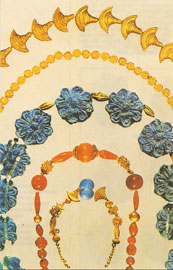 Κόσμημα από τις Αρχάνες.
Ήδη από τη δεύτερη χιλιετία π.Χ. κατασκευάζονται με μήτρα χάντρες και περίαπτα από μέταλλο ή υαλόμαζα, όπως μαρτυρεί τόσο η μινωική όσο και η μυκηναϊκή κοσμηματοτεχνία. Η χύτευση για την κατασκευή άλλου τύπου κοσμημάτων, όπως ενώτια ή δακτυλίδια, είναι μεταγενέστερη και ίσως έχει αιγυπτιακή προέλευση. Η αναπαράσταση της τεχνικής είναι δυνατή μέσα από τις μήτρες που ήρθαν στο φως αλλά και χάρη στο αναλλοίωτο της βασικής διαδικασίας που τη βλέπουμε να λειτουργεί ως σήμερα. Το υλικό σε ρευστή μορφή χύνεται σε μήτρα στο σχήμα του κοσμήματος, φτιαγμένη συνήθως από στεατίτη αλλά και από άλλες πέτρες ή μέταλλο, ακόμη κι από άμμο. Στόχος είναι η μαζική παραγωγή. Η ευρεία χρήση της χύτευσης ιδίως για περιδέραια, κατά την Ύστερη Ελλαδική περίοδο ΙΙ και ΙΙΙ, συμβαδίζει με τη σταδιακή αντικατάσταση των πολύτιμων υλικών (χρυσός, λαζουρίτης λίθος), με την υαλόμαζα και τη φαγεντιανή. Έτσι, το κόσμημα παύει να είναι απόκτημα μόνο των ευγενών.
Κόσμημα από τις Αρχάνες.
Ήδη από τη δεύτερη χιλιετία π.Χ. κατασκευάζονται με μήτρα χάντρες και περίαπτα από μέταλλο ή υαλόμαζα, όπως μαρτυρεί τόσο η μινωική όσο και η μυκηναϊκή κοσμηματοτεχνία. Η χύτευση για την κατασκευή άλλου τύπου κοσμημάτων, όπως ενώτια ή δακτυλίδια, είναι μεταγενέστερη και ίσως έχει αιγυπτιακή προέλευση. Η αναπαράσταση της τεχνικής είναι δυνατή μέσα από τις μήτρες που ήρθαν στο φως αλλά και χάρη στο αναλλοίωτο της βασικής διαδικασίας που τη βλέπουμε να λειτουργεί ως σήμερα. Το υλικό σε ρευστή μορφή χύνεται σε μήτρα στο σχήμα του κοσμήματος, φτιαγμένη συνήθως από στεατίτη αλλά και από άλλες πέτρες ή μέταλλο, ακόμη κι από άμμο. Στόχος είναι η μαζική παραγωγή. Η ευρεία χρήση της χύτευσης ιδίως για περιδέραια, κατά την Ύστερη Ελλαδική περίοδο ΙΙ και ΙΙΙ, συμβαδίζει με τη σταδιακή αντικατάσταση των πολύτιμων υλικών (χρυσός, λαζουρίτης λίθος), με την υαλόμαζα και τη φαγεντιανή. Έτσι, το κόσμημα παύει να είναι απόκτημα μόνο των ευγενών.
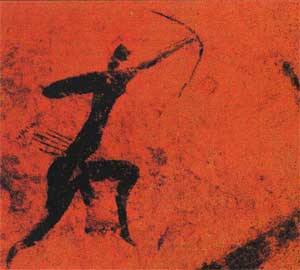 Προϊστορικός κυνηγός της Σαχάρας.
Από τα τελευταία στάδια της ύστερης παλαιολιθικής εποχής έως την εισαγωγή των πυροβόλων όπλων τον 16ο αιώνα, το τόξο χρησιμοποιήθηκε παγκόσμια στο κυνήγι και τον πόλεμο. Αποτελεί το επόμενο στάδιο στην εξέλιξη των τηλεβόλων όπλων, μετά το δόρυ, το καμάκι και τον εκτοξευτήρα. Οι πρώτες ασφαλείς ενδείξεις για τη χρήση τόξου ανήκουν στις αρχές της 9ης χιλιετίας και προέρχονται από το Stellmoor της Γερμανίας. Δεν είναι βέβαιο αν οι μικρόλιθοι τραπεζοειδούς σχήματος που βρέθηκαν σε μεσολιθικά και νεολιθικά στρώματα λειτουργούσαν ως αιχμές βελών (transverse arrowheads). Τέτοιες αιχμές, που τραυματίζουν ελαφρά χωρίς να σκοτώνουν το θήραμα, χρησιμοποιήθηκαν σε βασιλικά κυνήγια στη Μεσοποταμία και την Αίγυπτο και απεικονίζονται σε σφραγιδόλιθους από τη μεσομινωική Κρήτη. Στον «Τάφο του Αρχηγού της Φυλής» στη Βάρνα από την Ύστερη Χαλκολιθική εποχή, βρέθηκαν έξι χρυσά κυλινδρικά ελάσματα που διακοσμούσαν το τόξο του νεκρού. Ως εμβληματικό όπλο, το τόξο συνδέεται με καίριες στιγμές των ομηρικών επών και χαρακτηρίζει τα θεϊκά αδέλφια Απόλλωνα και Άρτεμη.
Προϊστορικός κυνηγός της Σαχάρας.
Από τα τελευταία στάδια της ύστερης παλαιολιθικής εποχής έως την εισαγωγή των πυροβόλων όπλων τον 16ο αιώνα, το τόξο χρησιμοποιήθηκε παγκόσμια στο κυνήγι και τον πόλεμο. Αποτελεί το επόμενο στάδιο στην εξέλιξη των τηλεβόλων όπλων, μετά το δόρυ, το καμάκι και τον εκτοξευτήρα. Οι πρώτες ασφαλείς ενδείξεις για τη χρήση τόξου ανήκουν στις αρχές της 9ης χιλιετίας και προέρχονται από το Stellmoor της Γερμανίας. Δεν είναι βέβαιο αν οι μικρόλιθοι τραπεζοειδούς σχήματος που βρέθηκαν σε μεσολιθικά και νεολιθικά στρώματα λειτουργούσαν ως αιχμές βελών (transverse arrowheads). Τέτοιες αιχμές, που τραυματίζουν ελαφρά χωρίς να σκοτώνουν το θήραμα, χρησιμοποιήθηκαν σε βασιλικά κυνήγια στη Μεσοποταμία και την Αίγυπτο και απεικονίζονται σε σφραγιδόλιθους από τη μεσομινωική Κρήτη. Στον «Τάφο του Αρχηγού της Φυλής» στη Βάρνα από την Ύστερη Χαλκολιθική εποχή, βρέθηκαν έξι χρυσά κυλινδρικά ελάσματα που διακοσμούσαν το τόξο του νεκρού. Ως εμβληματικό όπλο, το τόξο συνδέεται με καίριες στιγμές των ομηρικών επών και χαρακτηρίζει τα θεϊκά αδέλφια Απόλλωνα και Άρτεμη.
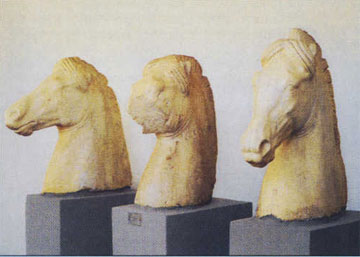 Μαρμάρινες προτομές αλόγων.
Το Μουσείο, που στεγάζεται σε νεοκλασικό κτήριο δωρεάς Ανδρέα Συγγρού, ιδρύθηκε το 1960. Το 1981, οι ζημιές από τους σεισμούς το ανάγκασαν να παραμείνει κλειστό για μια δεκαετία. Στις τρεις αίθουσές του εκτίθενται αντικείμενα από σωστικές ανασκαφές, τυχαία ευρήματα ή παραδόσεις από ιδιώτες και αντικείμενα της ιδιωτικής συλλογής Οικονόμου. Τα εκθέματα εκτείνονται από την παλαιολιθική ως και την ύστερη ρωμαϊκή εποχή. Ενδεικτικά αναφέρονται ο ανδριάντας του Αντίνοου που βρέθηκε μέσα σε λουτρό στην Αιδηψό, δύο χρυσά στεφάνια αθλητών, τρεις μαρμάρινες προτομές αλόγων, και πολλά άλλα. Επιγραφές και αγαλματικές απεικονίσεις επέτρεψαν να εξιστορηθούν οι λατρείες που επικρατούσαν στη Χαλκίδα κατά την αρχαιότητα.
Μαρμάρινες προτομές αλόγων.
Το Μουσείο, που στεγάζεται σε νεοκλασικό κτήριο δωρεάς Ανδρέα Συγγρού, ιδρύθηκε το 1960. Το 1981, οι ζημιές από τους σεισμούς το ανάγκασαν να παραμείνει κλειστό για μια δεκαετία. Στις τρεις αίθουσές του εκτίθενται αντικείμενα από σωστικές ανασκαφές, τυχαία ευρήματα ή παραδόσεις από ιδιώτες και αντικείμενα της ιδιωτικής συλλογής Οικονόμου. Τα εκθέματα εκτείνονται από την παλαιολιθική ως και την ύστερη ρωμαϊκή εποχή. Ενδεικτικά αναφέρονται ο ανδριάντας του Αντίνοου που βρέθηκε μέσα σε λουτρό στην Αιδηψό, δύο χρυσά στεφάνια αθλητών, τρεις μαρμάρινες προτομές αλόγων, και πολλά άλλα. Επιγραφές και αγαλματικές απεικονίσεις επέτρεψαν να εξιστορηθούν οι λατρείες που επικρατούσαν στη Χαλκίδα κατά την αρχαιότητα.
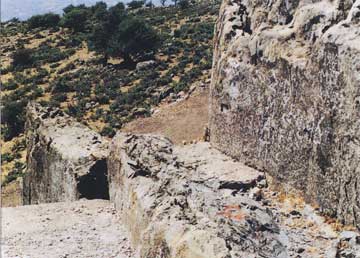 Ο λαξευμένος ιερός βράχος.
Στη δυτική κορυφή του όρους Λεπέτυμνου, με θέα στη Μικρά Ασία, τα γύρω νησιά και την πόλη της Μήθυμνας, κάθεται το εκκλησάκι του Αϊ-Λιά. Κόρακας έτρεφε τον άγιο στο ερημητήριό του, δύο κόρακες θρυλείται ότι φυλάγουν το μνημείο του Λεπέτυμνου, τοπικού ήρωα που παντρεύτηκε τη Μήθυμνα στα «τρωικά τα χρόνια». Στον λαξεμένο από ανθρώπινο χέρι χώρο, βρέθηκαν επιφανειακά ευρήματα: όστρακα αγγείων και πέντε κεφαλές από ειδώλια. Ο αρθρογράφος πιστεύει ότι πρόκειται για ιερό κορυφής που μάλλον συνδέεται με τη λατρεία του Λεπέτυμνου και πιθανολογεί τη γειτονική ύπαρξη προϊστορικής θέσης.
Ο λαξευμένος ιερός βράχος.
Στη δυτική κορυφή του όρους Λεπέτυμνου, με θέα στη Μικρά Ασία, τα γύρω νησιά και την πόλη της Μήθυμνας, κάθεται το εκκλησάκι του Αϊ-Λιά. Κόρακας έτρεφε τον άγιο στο ερημητήριό του, δύο κόρακες θρυλείται ότι φυλάγουν το μνημείο του Λεπέτυμνου, τοπικού ήρωα που παντρεύτηκε τη Μήθυμνα στα «τρωικά τα χρόνια». Στον λαξεμένο από ανθρώπινο χέρι χώρο, βρέθηκαν επιφανειακά ευρήματα: όστρακα αγγείων και πέντε κεφαλές από ειδώλια. Ο αρθρογράφος πιστεύει ότι πρόκειται για ιερό κορυφής που μάλλον συνδέεται με τη λατρεία του Λεπέτυμνου και πιθανολογεί τη γειτονική ύπαρξη προϊστορικής θέσης.
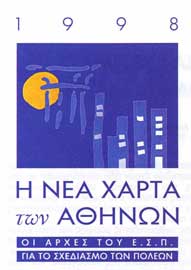 Η Νέα Χάρτα των Αθηνών.
Ο Δήμος Αθηναίων, ο Σύλλογος Ελλήνων Πολεοδόμων και Χωροτακτών (ΣΕΠΟΧ) και το Ευρωπαϊκό Συμβούλιο Πολεοδόμων (ECTP) συνδιοργάνωσαν στην Αθήνα το 1ο Διεθνές Συνέδριό τους (28-31 Μαΐου 1998). Παρουσιάζονται οι Δέκα Ενότητες Προτάσεων για τον Πολεοδομικό Σχεδιασμό που αποτέλεσαν το κείμενο της Νέας Χάρτας των Αθηνών. Το κείμενο, που επεξεργάστηκαν πολεοδόμοι 17 ευρωπαϊκών χωρών, δεν είναι στατικό και τελεσίδικο. Επικεντρώνεται στις ευρωπαϊκές πόλεις, λαμβάνει υπόψη του προηγούμενες ευρωπαϊκές μελέτες και τα πορίσματα του ΟΗΕ για τους οικισμούς Habitat II, αποδέχεται την έννοια της Αειφορίας και επιδιώκει την ενεργό συμμετοχή του πολίτη.
Η Νέα Χάρτα των Αθηνών.
Ο Δήμος Αθηναίων, ο Σύλλογος Ελλήνων Πολεοδόμων και Χωροτακτών (ΣΕΠΟΧ) και το Ευρωπαϊκό Συμβούλιο Πολεοδόμων (ECTP) συνδιοργάνωσαν στην Αθήνα το 1ο Διεθνές Συνέδριό τους (28-31 Μαΐου 1998). Παρουσιάζονται οι Δέκα Ενότητες Προτάσεων για τον Πολεοδομικό Σχεδιασμό που αποτέλεσαν το κείμενο της Νέας Χάρτας των Αθηνών. Το κείμενο, που επεξεργάστηκαν πολεοδόμοι 17 ευρωπαϊκών χωρών, δεν είναι στατικό και τελεσίδικο. Επικεντρώνεται στις ευρωπαϊκές πόλεις, λαμβάνει υπόψη του προηγούμενες ευρωπαϊκές μελέτες και τα πορίσματα του ΟΗΕ για τους οικισμούς Habitat II, αποδέχεται την έννοια της Αειφορίας και επιδιώκει την ενεργό συμμετοχή του πολίτη.
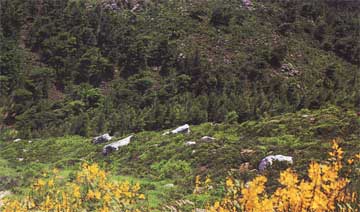 Όγκοι χαλαζία στην Πεντέλη.
Με αφορμή την ανακάλυψη παλαιολιθικών εξελικτικών σειρών στη λακωνική-μεσσηνιακή Μάνη, οργανώθηκε προκαταρκτική έρευνα στην ευρύτερη περιοχή του Αιγαίου, με στόχο τον εντοπισμό των πρώιμων σταδίων της παλαιολιθικής εξέλιξης. Αντίστοιχη έρευνα διενεργήθηκε και στην ανατολική Αττική. Τον Αύγουστο του 1979 αποκαλύφθηκαν τα πρώτα ευρήματα στο παρόχθιο σύστημα του Μεγάλου Ρέματος και ιδιαίτερα στις τοποθεσίες Κάτω Χαρβάτι, Ντράφι και Παλλήνη. Στη συνέχεια, νέοι υπαίθριοι χώροι εντοπίστηκαν στην περιοχή που απλώνεται από την Παλαιά Πεντέλη, τον Γέρακα, την Παλλήνη, την Παιανία, το Πικέρμι, τη Ραφήνα και, κατά μήκος της ανατολικής ακτής, φτάνει ως τα Λεγρενά. Η προκαταρκτική έρευνα αποκάλυψε ιδιαίτερα πλούσια και πρωτότυπα ευρήματα, αντιπροσωπευτικά των σημαντικότερων εξελικτικών σταδίων από το ανώτερο Μειόκαινο ως το τέλος της Παλαιολιθικής εποχής. Η λιθοτεχνία από το Ντράφι (Παλλήνη) είναι μία από τις σπουδαιότερες και χρονολογείται στα μέσα του κατώτερου Πλειστόκαινου. Μέρος από τα αποτελέσματα της προαναφερθείσας έρευνας ανακοινώθηκε στο 1ο Διεθνές Συμπόσιο για το Αιγαίο (Ικαρία, 1980) και στο 1ο Πανελλήνιο Συνέδριο Ανθρωπολογίας (Χαλκιδική, 1982).
Όγκοι χαλαζία στην Πεντέλη.
Με αφορμή την ανακάλυψη παλαιολιθικών εξελικτικών σειρών στη λακωνική-μεσσηνιακή Μάνη, οργανώθηκε προκαταρκτική έρευνα στην ευρύτερη περιοχή του Αιγαίου, με στόχο τον εντοπισμό των πρώιμων σταδίων της παλαιολιθικής εξέλιξης. Αντίστοιχη έρευνα διενεργήθηκε και στην ανατολική Αττική. Τον Αύγουστο του 1979 αποκαλύφθηκαν τα πρώτα ευρήματα στο παρόχθιο σύστημα του Μεγάλου Ρέματος και ιδιαίτερα στις τοποθεσίες Κάτω Χαρβάτι, Ντράφι και Παλλήνη. Στη συνέχεια, νέοι υπαίθριοι χώροι εντοπίστηκαν στην περιοχή που απλώνεται από την Παλαιά Πεντέλη, τον Γέρακα, την Παλλήνη, την Παιανία, το Πικέρμι, τη Ραφήνα και, κατά μήκος της ανατολικής ακτής, φτάνει ως τα Λεγρενά. Η προκαταρκτική έρευνα αποκάλυψε ιδιαίτερα πλούσια και πρωτότυπα ευρήματα, αντιπροσωπευτικά των σημαντικότερων εξελικτικών σταδίων από το ανώτερο Μειόκαινο ως το τέλος της Παλαιολιθικής εποχής. Η λιθοτεχνία από το Ντράφι (Παλλήνη) είναι μία από τις σπουδαιότερες και χρονολογείται στα μέσα του κατώτερου Πλειστόκαινου. Μέρος από τα αποτελέσματα της προαναφερθείσας έρευνας ανακοινώθηκε στο 1ο Διεθνές Συμπόσιο για το Αιγαίο (Ικαρία, 1980) και στο 1ο Πανελλήνιο Συνέδριο Ανθρωπολογίας (Χαλκιδική, 1982).
 Το λογότυπο της στήλης
Η νέα στήλη ενημερώνει τόσο τους ειδικούς επιστήμονες όσο και το φιλοπερίεργο κοινό για το συνεχώς διευρυνόμενο φάσμα των εφαρμογών των νέων τεχνολογιών στην Αρχαιολογία. Παρουσιάζονται: I) διεθνείς συναντήσεις για τις εφαρμογές της Πληροφορικής στην Αρχαιολογία και II) μια επιλογή από διεθνή συνέδρια για τον πολιτισμό και τις νέες τεχνολογίες. Iα: Computer Applications in Archaeology (CAA): New Techniques for Old Times", Iβ: Coloquio Internacional de Arqueologia e Informxtica (CIAEI), Iγ: International Union of Prehistoric and Protohistoric Sciences (UISPP) Commission 4: Data Management and Mathematical Methods in Archaeology. IΙα:Museums and the Web 1998, IΙβ: ICOM Triennial Conference: "Museums and Cultural Diversity, Ancient Cultures - New Worlds", IΙγ: Electronic Imaging and the Visual Arts - EVA, IΙδ: Second European Conference on Research and Advanced Technology for Digital Libraries.
Το λογότυπο της στήλης
Η νέα στήλη ενημερώνει τόσο τους ειδικούς επιστήμονες όσο και το φιλοπερίεργο κοινό για το συνεχώς διευρυνόμενο φάσμα των εφαρμογών των νέων τεχνολογιών στην Αρχαιολογία. Παρουσιάζονται: I) διεθνείς συναντήσεις για τις εφαρμογές της Πληροφορικής στην Αρχαιολογία και II) μια επιλογή από διεθνή συνέδρια για τον πολιτισμό και τις νέες τεχνολογίες. Iα: Computer Applications in Archaeology (CAA): New Techniques for Old Times", Iβ: Coloquio Internacional de Arqueologia e Informxtica (CIAEI), Iγ: International Union of Prehistoric and Protohistoric Sciences (UISPP) Commission 4: Data Management and Mathematical Methods in Archaeology. IΙα:Museums and the Web 1998, IΙβ: ICOM Triennial Conference: "Museums and Cultural Diversity, Ancient Cultures - New Worlds", IΙγ: Electronic Imaging and the Visual Arts - EVA, IΙδ: Second European Conference on Research and Advanced Technology for Digital Libraries.
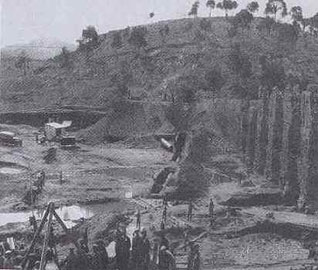 Έργα στο Αδριάνειο Υδραγωγείο Ν. Ιωνίας το 1929.
Η παράθεση είναι ενδεικτική. Για το πλήρες κείμενο της στήλης, δείτε το συνημμένο αρχείο pdf.
Έργα στο Αδριάνειο Υδραγωγείο Ν. Ιωνίας το 1929.
Η παράθεση είναι ενδεικτική. Για το πλήρες κείμενο της στήλης, δείτε το συνημμένο αρχείο pdf.
Ειδήσεις
Τη Σελεύκεια-Ζεύγμα και την Απάμεια θα εξαφανίσει το 1999 τουρκικό φράγμα στον Ευφράτη - Ερμαϊκή στήλη με την επιγραφή ΕΥΠΟΛΙΣ που ταυτίζει την προτομή με τον ανταγωνιστή του Αριστοφάνη βρέθηκε στον περίβολο της Βουλής - Θεσμοθετήθηκε η άδεια άσκησης επαγγέλματος του Συντηρητή Αρχαιοτήτων και Έργων Τέχνης - Αρχαϊκά μεταλλουργικά εργαστήρια στη Σκάλα Ωρωπού – κ.ά.Συνέδρια
Α΄ Συνάντηση Βυζαντινολόγων της Ελλάδας και της Κύπρου, 25-27 Σεπτεμβρίου 1998, Παν/μιο Ιωαννίνων - Διεθνή Συνάντηση για την Παλαιοανθρωπολογία της Μάνης διοργανώνει το Παν/μιο Αθηνών - «Επικοινωνίες και Μεταφορές στην Προβιομηχανική περίοδο» είναι το θέμα του ΙΑ΄ Συμποσίου Ιστορίας και Τέχνης, κ.ά.Διαλέξεις
Τον αρχαϊκό ναό του Απόλλωνα στη θεσσαλική αρχαία Μητρόπολη παρουσίασε στο Μουσείο Κυκλαδικής Τέχνης ο αρχαιολόγος κ. Ιντζεσίλογλου - Για τον Ξενώνα-Νοσοκομείο της Μονής του Παντοκράτορος μίλησε ο καθ. Σ. Γερουλάνος στο Μουσείο Κυκλαδικής ΤέχνηςΕκθέσεις
«Ανατολική Μεσόγειος: Κύπρος - Δωδεκάνησα - Κρήτη, 1600-600 π.Χ.» είναι το θέμα έκθεσης που συνδιοργανώνουν η ΚΓ΄ Εφορεία Προϊστορικών και Κλασικών Αρχαιοτήτων και το Παν/μιο Κρήτης - Ο Οργανισμός Πολιτιστικής Πρωτεύουσας οργάνωσε στο Τελλόγλειο Ίδρυμα Θεσσαλονίκης έκθεση έργων δυτικών καλλιτεχνών με θέμα τον Μ. ΑλέξανδροΒιβλία
Γιάννης Λουκιανός, Οι βοτσαλωτές αυλές των Κυκλάδων, Αθήνα 1998 - Machi Karali, Les maisons rurales de Tinos: Phaneromeni à Exomeria, Unesco 1997 - Nena Galanidou, «Home is where the earth is». The Spatial Organization of the Upper Palaeolithic Rockshelter Occupations at Klithi and Kastritsa in North-west Greece, British Archaeological Reports International Series 687, Oxford 1997 - Tamara Talbot Rice, Ο δημόσιος και ιδιωτικός βίος των Βυζαντινών - Δημήτρης Φιλιππίδης, Πέντε δοκίμια για τον Άρη Κωνσταντινίδη, Libro, Αθήνα 1997, κ.ά.
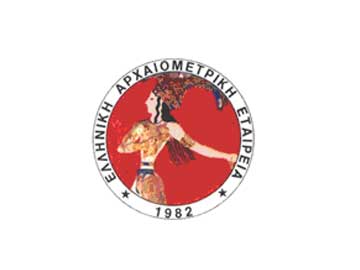 Το λογότυπο της Ελληνικής Αρχαιομετρικής Εταιρείας
Η παράθεση είναι ενδεικτική. Για το πλήρες κείμενο της στήλης, δείτε το συνημμένο αρχείο pdf.
Το λογότυπο της Ελληνικής Αρχαιομετρικής Εταιρείας
Η παράθεση είναι ενδεικτική. Για το πλήρες κείμενο της στήλης, δείτε το συνημμένο αρχείο pdf.
Ειδήσεις
Οι παλαιοκλιματολόγοι πιστεύουν ότι στη διάρκεια της τελευταίας παγετώδους περιόδου η στάθμη της Μεσογείου ήταν 100 μέτρα χαμηλότερη από τη σημερινή - Γιορτάστηκαν τα 50 χρόνια του Σουηδικού Ινστιτούτου ΑθηνώνΣυνέδρια
Πολυπρόσωπη ελληνική συμμετοχή στο 31ο Διεθνές Συμπόσιο Αρχαιομετρίας - Στη Lyon έγινε το 3ο Διεθνές Συμπόσιο «C-14 και Αρχαιολογία»Εκδόσεις
Ηλεκτρονική πρόσβαση στο περιοδικό Journal of the Balkan Geophysical Society - Το νέο ενημερωτικό φυλλάδιο Αρχαιοτηλεσκοπικά νέα εκδίδεται από Εργαστήριο του Ινστιτούτου Μεσογειακών Σπουδών του ΙΤΕThe discovery of Palaeolithic sequences of evolution in Laconian-Messenian Mani and in the Cyclades contributed to the organization of a project of preliminary research over a broad expanse round the Aegean. This research aimed at detection of the early stages of Palaeolithic evolution. Within this context, research was also carried out in East Attica. In August 1979 the first finds came to light in the riparian system of Megalo Rema and especially on the sites of Kato Harvati, Draphi and Panorama. New open-air sites were then located in the area extending from Palaia Penteli, Yeraka, Pallini, Paiania, Pikermi, Raphina, and along the east coast, to Legrena. During this preliminary research an especially rich as well as original material was revealed, which is assesed as representative of the major stages of evolution from the Upper Miocene to the end of the Palaeolithic era. One of the most important lithotechnies is that from Draphi (Pallini region), which dates from the middle of the Lower Pleistocene era. Part of the results of the forementioned research was reported on in the 1st International Symposium for the Aegean (Ikaria island, 1980) and in the 1st Panhellenic Congress of Anthropology (Halkidiki, 1982).
A peak sanctuary is located on the second, western peak of mount Lepetymnon which is about 931 m. high. Carved rocks and figurines and pottery of the Hellenistic period are the only remnants of a sanctuary, probably dedicated to the local hero and daemon Lepetymnos, husband of Methymna.
This article presents in a simple and concise way the procedure of disinterment, treatment and transportation of bones coming from various grave ensembles. This approach refers primarily to the cases of simple burials and cremations which were the more usual practice in ancient Greece. Unfortunately the conditions of the excavation of bones are not always ideal, therefore the archaeologist or experienced assistant must keep in mind certain principles for the proper treatment of the bones and the importance of information they can supply, i.e. the techniques of excavating simple burials and cremations as well as the photographic and graphic representation of bones, their packing, transportation and storage.
The hundredth anniversary from the death of Charilaos Trikoupis was celebrated with solemnity in 1996. On this occasion various congresses and two exhibitions were organized in Athens and relevant studies and articles were also published. On the contrary a minimum interest was shown in the concrete and material evidence connected with this politician, especially in the houses that his father, Spyridon Trikoupis, built in Aigina, Nauplion and Argos. This indifference shown about material testimonies, connected with historic persons who played an important role in modern Greece is seen in all its magnitude here as well. In this article ,a thorough account of the history of Spyridon Trikoupis' house in Argos is presented, a brief reference is made to the other houses that he erected in Aigai and Nauplion and at the same time a complete documentation according to which Charilaos Trikoupis was born in Argos in 1830. As regards Spyridon Trikoupis' house in Argos, we have the opinion that the thorough and complete publication of the history of this building is imperative for many reasons. First, because it has been completely abandoned by the Agricultural Bank of Greece, the latest owner of the house for many years now, secondly the opportunity of the anniversary of Charilaos Trikoupis' death, thirdly, the history of public building in the Capodistrian age in itself. Local society reacted so badly to the erection of this house in Argos that Capodistrias himself was obliged to issue a decree that limited the extent of land granted by the nation for the bulding of a house inside the town. A final reason is the practice of both the mass media and academic community to deal only with issues concerning Athens. As a result, important data about our architectural heritage from the Greek provinces continue to remain in the fringe of interest and only when threatened with immediate destruction do they temporarily attract public attention. Therefore, with the present article we would like to contribute to the inversion of this sad phenomenon.
Faith, religion and ritual cannot be interpreted only through the few preserved artefacts that come down to us. Therefore, we are obliged to use analogies with other regions or other periods for the interpretation of the representations of a certain culture or for the reconstruction of the nucleus of faith and personal devotion of the times. The Protohistory of the Aegean, from the Neolithic period down to the end of the Bronze Age, is not altogether rich in figurative representations, female images, however prevail among them. These rare representations have not been accidentally chosen from the everyday life of women. Thus, we must see in these figurines, reliefs, wall-paintings and seals a narrative thought and representation ,on one hand presupposing that magical explanations for the environment have been left behind; and on the other, that the humanization of the primeval power is realized in myths and in the representational arts. This reasoning is obvious in the Neolithic period, but already in the Early Bronze Age the civilizations of the Aegean follow diverse routes. Central Greece of the Early and Middle Bronze Age does not use a visual rendering of the goddess. The Cycladic civilization is rich in such representations, but after all it is Crete which leads the way. The powerful representation of the naked goddess of nature is now dressed in the town's attire, and thus the figurine of the ritual appears, Myth comes to the fore, engraved on seals or painted in frescoes. Although the inhabitants of Mycenae have a different notion of deity, they adopt the new image of the goddess. Soon, however, a new approach is formed. During the last phase of the Bronze Age the figurines of the goddess reappear in the entire area of the Aegean -in Crete, central Greece and on the islands— as a reaction to the authoritative, centralized power of the palaces. This time, however, the image of the goddess is placed in a defined architectural sorrounding, that is, the small sacred edifices, in which the goddess of the Aegean Sea continues to live even beyond the Dark Ages.
Casting was perhaps the most popular technique during the Bronze Age, as it allowed the massive production of all the well known motifs of the period, both in metal and glasspaste (or faience). The dozens of moulds that have been revealed during the excavations of many Bronze Age sites such as Knossos, Mycenae and Thebes, and the traditional character of the technique, which at least as far as the hand-made jewellery is concerned, has remained fairly the same, allows us to reconstruct it from the very beginning from the making of the model, to the moment the metal or the glasspaste is removed from the mould, so that the craftsman could add the last details.
The model of the traditional "man as hunter" and that of the woman who is defined only by her ability for reproduction, reflect the androcratic concept of archaeological theory, while archaeological data reveals a variety of roles that the two sexes may have played in a Prehistoric society. The separation of the roles of the two sexes should not always be made on the basis of their biological differences,one should also bear in mind the social and cultural structure of a community. However, from the very beginning we must accept that the woman's maternal role was always the decisive criterion for the rest of her activities. Thus, while a woman was probably physically unable to participate in the hunting of big mammals, there was nothing to prevent a woman, free of parental obligations, to take part in the hunting of smaller animals, such as deer, furthermore, a woman-mother could be engaged with the collection of plants, eggs, as well as with fishing and hunting of small animals, in order to provide food for her children. We must also assume that a woman would manufacture the tools (e.g. nets) for these activities, while a man would be responsible for the implements necessary for his engagements. To the woman in the community could also be assigned the early cultivation of plants, familiar to her from the period of their collection in wild form, as well as the care of the first domestic animals, probably brought to the settlements by the male hunters. In addition, the processing of the animal side products (milk, wool, fat) could very well be in keeping with her maternal duties. On the same assumption, activities such as the production of clay vessels could be assigned to women, since the process of moulding and baking clay is not very different from that of kneading and baking bread. The preparation of food, in general, must have become one of women's primary responsibilities, which therefore, connected them with the fireside, that not only was the main device for preparing food, but was also the center of family cohesion. Women could make the clothes of their own people as well, by weaving and sewing. Thus, in the well organized Neolithic society, the social role of woman reached its prime, since it was she who coordinated and at the same time reproduced life and thus increased and improved the family. However, her continuously multiplied obligations resulted in the gradual isolation of women in the home and to women's exclusion from any active participation in basic economy. An especially capable and active woman is portrayed on the female figurines of Thessaly, mainly those of earlier periods. But even when the role of woman was confined to the home, she continued to be a generating, dynamic force , organizing and administering her realm. Thus, the house became the symbol of her power, which progressively obtained bigger dimensions, areas of special utility, decoration, furniture, etc. Figurine representations showing various household activities, such as the grinding of seeds or kneading, have traditionally been attributed to women, although the sex is not represented on them. Nevertheless, it is highly probable that men also participated in household chores, especially when natural or other factors kept them at home (e.g. rough weather). The definite separation of the specific roles of the two sexes must have occured later, when the systematization of production as well as other social criteria and expediencies dictated it.
The frescoes from building "Xeste 3" at Akrotiri, on the island of Thera, constitute a coherent iconographical complex. The theme centres on womanhood, women's coming of age, and the concepts that are associated with it. The main scene, situated in the upper storey, depicts a seated goddess. She is flanked by a griffin and a monkey and receives an offering of saffron from a group of young girls. They are at a pre-marriage stage, as we can tell by their shaved (or partially shaved) heads and absence of breasts. Below this scene, on the ground floor, was a second goddess with a group of young girls undergoing initiation. A shrine topped with "horns" indicates the sacred character of the ceremony. On a different wall are mature women, with full breasts and hair bound up in a scarf. They too are carrying flowers, in order to offer them presumably to a goddess. If seen together, the paintings refer to rituals of maturation. Two more walls belong to this conceptual cycle. One depicts ducks flying among reeds and another monkeys engaged in a mock sword fight. Swallows feeding their young chicks in a nest are also depicted on the same frieze as the monkeys. The animal paintings suggest that womanhood and coming of age were linked with the cycles of nature. Animal, bird and insect life are used as symbols to link human and natural institutions and to suggest visual similes. Interestingly enough, the coming of age is not associated with the institution of marriage, as is the case in Greek historical times. The women are separated from men and the family ties are only hinted at without being explicitly shown.
The pyrrhic dance was an ancient Greek martial dance. It was the national dance of Sparta and a game of the Great and Minor Panathenaea in Athens, where it was performed by young male dancers and accompanied by music. It is a magnificent and impressive dance with an educational character. According to ancient written sources, the goddess Athena was the only deity who performed the pyrrhic dance. However, in certain very interesting representations on pottery the pyrrhic dance is also performed by women but in different places and for a different purpose. The main period of representation of the pyrrhic dance performed by women is the twenty years between 440 and 420 BC, although the women's dance is less often mentioned in written sources than the pyrrhic dance performed by men. The pyrrhic theme decorates ten shapes of pottery, mainly those in use during symposia and also used by women in their everyday life. The pyrrhic female dance appears on pottery in three variations; that of the exercising of dancers,the entertainment of men at symposia or of women in their quarters,and performance of the dance in context of the cult of the goddess Artemis. In all three variations it is a "mimic" dance. The women dancers try to represent a battle in its various phases. Their weapons are not always real ones, the dance performance is clearly individual and the existence of the adversary is purely intellectual- As far as the connection of the dance with the cult of Artemis is concerned, the pyrrhic dance is probably the revival of an older martial dance that was performed in the sanctuaries of the goddess, who is related to battles.
In circles of the 1970s Women's Movement the theory was created that Prehistory was a world -wide matriarchal age , a theory that served as a starting point for research into matriarchy. Female figurines of the European Palaeolithic and Neolithic period, which apparently document the existence of a religion of female deities and consequently of matriarchy, are referred to in the relevant bibliography as archaeological "evidence" in support of this opinion. In additon, the Neolithic settlement Catal Huyuk in Turkey and the Bronze Age palace of Knossos on Crete play a prominent role in this argument, which, however, does not meet the demands of a critical examination of sources and methods. In Germany the research into matriarchy, in which only the Americano-Lithuanian Protohistoric archaeologist Marija Gimbutas participated among all scholars of archaeology, becomes more and more popular. First political and later spiritualistic feminism percieved the matriarchal axiom. Its positions became meanwhile acceptable as "historic fact" in many circles thus becoming scientifically acceptable . In view of this development, it is about time that archaeology should participate in the issue of matriarchy. However, the relations of the two parties are tense. From the point of view of archaeology, the hypothesis for the existence of a Prehistoric matriarchy cannot be proven scientifically for reasons of methodology. From the point of view of the research into matriarchy, which partially presents clear characteristics, as opposed to rationalism and scholarship, the science considered as patriarchal is not the only way to knowledge. Even more, the so-called creative recollection of Prehistory and intuitive sensitivity about that period, are considered as ways towards a more integrated knowledge. Methodological and theoretical contrasts between the research into matriarchy and archaeology have a long history that goes back to the beginning of the scientific approach to the matriarchal notion in the 19th century. These contrasts occur between the supporters and the critics of the matriarchal notion and have repeatedly led to fierce controversies. This emotionally charged dispute has been further instigated by the fact that the notion of matriarchy seems to serve social purposes that run parallel to the development of society. While in 1861 Bachofen presented matriarchy as supportive of the patriarchal status quo in urban society, a little later this idea gained the character of a social utopia due to its being used as an argument for the socialist working movement.With the passage of time it was connected even closer with the criticism of patriarchy and, in the context of the political feminism of the 1970s it became a feminist fighting slogan. In context of contemporary spiritualistic feminism it gains more and more the characteristics of a Weltanschauung, of a religion of woman, which by its dedicated female supporters is considered as an opponent to the patriarchal ideology. According to many archaeologists, the research into matriarchy is not even historical , since it envelops the past in mysticism and ideologies, in order to serve the most diverse needs. In the eyes of the female supporters of matriarchy, archaeologists are prisoners to a patriarchal ideology, that characterizes their research and makes them either unable or unwilling to reach conclusions in favour of matriarchy through the research of archaeological sources. The chasm separating the research into matriarchy and archaeology runs very deep.The contrast of goals and methodologies are so strong, that any compromise seems impossible. Nevertheless, between the archaeological research into women and their sex and the research into matriarchy a common ground is revealed.The effort to marshal an alternative historiography, which takes in account the long denied need of women for their own history, along with the traditional, patriarchal recording of history. Within this context archaeological research could be inspired by the questions and versions of the matriarchal research, and the latter could in return benefit from the empirical data of archaeology. This form of contact and exchange of opinions is not a fantasy, but a reality.The conversation, through the Internet, of Ian Hodder, director of the new project for the settlement of Catal Huyuk in Turkey, and a female representative of the "Goddess Community", concerning the location of the finds and its interpretation, proves it beyond a shadow of a doubt.
Archaeological research to uncover the west wing of the Hadrian Library —destroyed by the Eruls in 267 AD— has produced important information about the use the site was put to not only during the early Christian and the Byzantine age, but also in the years of the Turkish occupation up to the twentieth century, included. A great number of movable objects of Greek and Turkish everyday life, besides building remnants, have been uncovered in the excavations in the layers of the ruins of the last centuries. Among them dozens of clay parts of narghile or hookah, the so-called tobacco burner, which are delicate, clay works of art and date from the seventeenth century, which was a time of the wide dissemination of tobacco smoking among the peoples of the Ottoman Empire and consequently popular with the Greeks. The peculiarity of form of this tobacco pipe of the East, so strikingly different from its counterpart of the West, from where smoking was introduced to the East, remains a question to be answered. It might be due to the distinctive character of the art of the East and its people. Where it was first made, is still unknown, since the proposed places of origin, Persia or Northern Africa, remain poorly documented . Furthermore, research to locate such workshops in the Helladic area, in spite of its century-long tradition in pottery is still inefficient.
For millenniums the bow has served as the most effective weapon for hunters and fighters. Its technical improvements and special use, as they are reported in time, reflect the specific needs of its users. From the last phases of the Late Paleolithic age to the introduction of fire arms in the sixteenth century, the bow has been worldwide not only a basic hunting weapon, but also an irreplaceable war machine. It has been established that many ancient civilizations used the bow, while the thorough study of its morphological evolution is a way of approaching certain practical needs of the people who used it. A means of survival, war machine, power symbol and an Olympic game in our time, the bow, in spite of its evolution, still remains a beloved children's toy, and its continuous use has made it an instrument of perennial value.
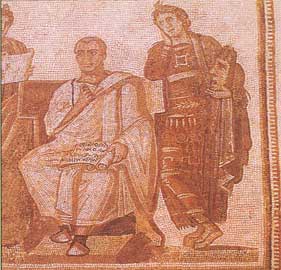 Η Μελπομένη, μούσα της τραγωδίας, φορεί κρηπίδες.
Οι μπότες στα αρχαία κείμενα ονομάζονται υποδήματα ή πέδιλα. Αν και κυρίως φτιαγμένες για άντρες, σε κομψότερη μορφή και με γούνινη επένδυση φοριούνται και από γυναίκες. Η ρωμαϊκή στρατιωτική μπότα, με παχύ σολόδερμα και καρφιά, λεγόταν caliga, ενώ αν είχε γούνινη επένδυση pero. Μπότες με κάτυμμα, ενισχυμένο με φελλό στη φτέρνα για να προσθέτει ύψος, ανήκουν σε γυναίκες. Οι αυτοκράτορες φορούσαν μπότες ψηλές με έντονο κόκκινο χρώμα. Για τις κρηπίδες επικρατεί διχογνωμία στους ερευνητές: άλλοι τις θεωρούν χαμηλή μπότα, άλλοι κάτι ανάμεσα σε σανδάλι και χαμηλό υπόδημα. Κρηπίδες, όπως και εμβάδες, φορούσαν και οι ηθοποιοί της κωμωδίας, ενώ στην τραγωδία χρησιμοποιούνταν κόθορνοι.
Η Μελπομένη, μούσα της τραγωδίας, φορεί κρηπίδες.
Οι μπότες στα αρχαία κείμενα ονομάζονται υποδήματα ή πέδιλα. Αν και κυρίως φτιαγμένες για άντρες, σε κομψότερη μορφή και με γούνινη επένδυση φοριούνται και από γυναίκες. Η ρωμαϊκή στρατιωτική μπότα, με παχύ σολόδερμα και καρφιά, λεγόταν caliga, ενώ αν είχε γούνινη επένδυση pero. Μπότες με κάτυμμα, ενισχυμένο με φελλό στη φτέρνα για να προσθέτει ύψος, ανήκουν σε γυναίκες. Οι αυτοκράτορες φορούσαν μπότες ψηλές με έντονο κόκκινο χρώμα. Για τις κρηπίδες επικρατεί διχογνωμία στους ερευνητές: άλλοι τις θεωρούν χαμηλή μπότα, άλλοι κάτι ανάμεσα σε σανδάλι και χαμηλό υπόδημα. Κρηπίδες, όπως και εμβάδες, φορούσαν και οι ηθοποιοί της κωμωδίας, ενώ στην τραγωδία χρησιμοποιούνταν κόθορνοι.
 Οι πρώτοι άνθρωποι.
Πριν από 3.000.000 χρόνια η γη ήταν το βασίλειο των ζώων. Ανάμεσά τους ζούσαν οι Αυστραλοπίθηκοι, οι πρώτοι άνθρωποι, κοντοί και τριχωτοί σαν πίθηκοι, όπως μας λένε οι παλαιοντολόγοι. Για να επιβιώσει ανάμεσα σε ζώα πιο γρήγορα και πιο δυνατά, ο άνθρωπος χρησιμοποίησε το όπλο που μόνον αυτός διέθετε: τη σκέψη. Ανακάλυψε τη φωτιά, που τρόμαζε τα άγρια ζώα, και, χτυπώντας δυο πέτρες, είδε πως μπορεί να φτιάξει λίθινα κοφτερά όπλα.
Οι πρώτοι άνθρωποι.
Πριν από 3.000.000 χρόνια η γη ήταν το βασίλειο των ζώων. Ανάμεσά τους ζούσαν οι Αυστραλοπίθηκοι, οι πρώτοι άνθρωποι, κοντοί και τριχωτοί σαν πίθηκοι, όπως μας λένε οι παλαιοντολόγοι. Για να επιβιώσει ανάμεσα σε ζώα πιο γρήγορα και πιο δυνατά, ο άνθρωπος χρησιμοποίησε το όπλο που μόνον αυτός διέθετε: τη σκέψη. Ανακάλυψε τη φωτιά, που τρόμαζε τα άγρια ζώα, και, χτυπώντας δυο πέτρες, είδε πως μπορεί να φτιάξει λίθινα κοφτερά όπλα.
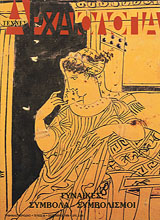
 Η Ελένη με τον Έρωτα στην αγκαλιά.
Ο μύθος δεν είναι παρά μια πολύπλοκη «γλώσσα» που μεταβιβάζει αποθησαυρισμένες πληροφορίες. Η ιστορική του εξέλιξη τον κάνει να μοιάζει με παλίμψηστο. Στα πρόσωπά του, η κοινωνία προβάλλει θετικά και αρνητικά πρότυπα, εντάσεις και συγκρούσεις. Ο Περικλής καταδικάζει τις γυναίκες στη σιωπή και οι ηρωίδες των μύθων εξασφαλίζουν τη φήμη τους υπερβαίνοντας το μέτρο. Πίσω από την πολλαπλότητα των μορφών, η έννοια γυναίκα στηρίζεται σε τέσσερις αρχετυπικές ιδέες: έρωτας, θυσία, δύναμη, γνώση. Το κρεβάτι (λέχος) δίνει στην παντρεμένη γυναίκα το όνομά της: άλοχος. Εκεί, σπρωγμένοι από τον ερωτικό πόθο, θεοί, ήρωες και θνητοί ενώνονται με τις εκλεκτές τους. Εκεί, εκείνες θα γεννήσουν τον καρπό αυτής της ένωσης, εκπληρώνοντας τη μοναδική σχεδόν προσδοκία που έχει από αυτές μια πατριαρχική κοινωνία. Εύγλωττη είναι και η χρήση του ρήματος «δαμάζω», που παραλληλίζει την ερωτική συνεύρεση με βίαιες αντρικές δραστηριότητες, όπως ο πόλεμος ή το κυνήγι. Στον απόηχό του κινούνται τα εικονογραφικά σχήματα της καταδίωξης και της αρπαγής. Το απόλυτο αντικείμενο του πόθου αποτελεί η ωραία Ελένη, χωρίς να επισύρει τον ψόγο. Αντίθετα, όταν η Φαίδρα γίνεται η ίδια ερωτικό υποκείμενο, καταστρέφει και την ίδια και το αντικείμενο του πόθου της. Στα όρια του έρωτα και της προσφοράς κινείται η υποδειγματική μορφή της Πηνελόπης. Η υπέρτατη προσφορά της θυσίας όμως, επιφυλάσσεται στις παρθένους που σώζουν σταθερά την κοινότητα των αντρών από τον μέγιστο κίνδυνο. Στην εικονογραφία όμως, η θυσία τους δεν βρήκε απήχηση. Οι τραγικοί ποιητές θα εσωτερικεύσουν το αρχέτυπο της γυναικείας προσφοράς, αναδεικνύοντας την Αντιγόνη σε ιδανική αδελφή και την Ηλέκτρα σε ιδανική θυγατέρα. Και τις δυο όμως ξεπερνά η ιδανική σύζυγος, η Άλκηστις. Σήμερα συχνά εκπλήσσει η απουσία του θέματος της μητρικής προσφοράς. Το γεγονός ερμηνεύεται από την υποβάθμιση του ρόλου της μητέρας σε μια πατριαρχική κοινωνία. Μια τέτοια κοινωνία δεν εκχωρεί σε γυναίκες τη δύναμη. Όταν όμως το κάνει για κάποιες, τις επενδύει με αρνητικές και σκοτεινές ιδιότητες. Αν ίσως η περίπτωση της Αταλάντης είναι ανώδυνη, τι να πει κανείς για την Κλυταιμνήστρα που ξεπέρασε κάθε όριο; Πολύ πιο επικίνδυνη από τις πολεμόχαρες Αμαζόνες που ζουν σε τόπους μακρινούς και πάντα δαμάζονται είτε στη μάχη είτε στο κρεβάτι. Οι δημοφιλείς Αμαζονομαχίες απεικονίζουν τη νίκη των Ελλήνων, του νόμου και της τάξης, του αρσενικού. Μια σειρά από θεϊκές μορφές δηλώνουν ότι, στο επίπεδο του μύθου, το αρχέτυπο της γνώσης είναι γένους θηλυκού. Είναι η Γαία η πρωτομάντις, η Θέτις, η σοφή κυρά της θάλασσας, η Δήμητρα που δίδαξε την καλλιέργεια και τα Μυστήρια, η Μήτις, η πολύτροπη νόηση, και, βέβαια, η κόρη της η Αθηνά. Η Κίρκη και η Μήδεια, μάγισσες και οι δυο από τη γενιά του Ήλιου. Με εξαίρεση την πολιούχο Αθηνά, οι άλλες γυναικείες θεές της γνώσης περιθωριοποιούνται, ξεθωριάζουν ή αποκτούν αρνητικό χαρακτήρα. Στην αγγειογραφία του 5ου αιώνα π.Χ. και στην κωμωδία, η Κίρκη παριστάνεται ταπεινωμένη ή πόρνη. Όσο για τη Μήδεια, στα χέρια του Ευριπίδη αναδείχθηκε στον χειρότερο εφιάλτη της πατριαρχικής κοινωνίας.
Η Ελένη με τον Έρωτα στην αγκαλιά.
Ο μύθος δεν είναι παρά μια πολύπλοκη «γλώσσα» που μεταβιβάζει αποθησαυρισμένες πληροφορίες. Η ιστορική του εξέλιξη τον κάνει να μοιάζει με παλίμψηστο. Στα πρόσωπά του, η κοινωνία προβάλλει θετικά και αρνητικά πρότυπα, εντάσεις και συγκρούσεις. Ο Περικλής καταδικάζει τις γυναίκες στη σιωπή και οι ηρωίδες των μύθων εξασφαλίζουν τη φήμη τους υπερβαίνοντας το μέτρο. Πίσω από την πολλαπλότητα των μορφών, η έννοια γυναίκα στηρίζεται σε τέσσερις αρχετυπικές ιδέες: έρωτας, θυσία, δύναμη, γνώση. Το κρεβάτι (λέχος) δίνει στην παντρεμένη γυναίκα το όνομά της: άλοχος. Εκεί, σπρωγμένοι από τον ερωτικό πόθο, θεοί, ήρωες και θνητοί ενώνονται με τις εκλεκτές τους. Εκεί, εκείνες θα γεννήσουν τον καρπό αυτής της ένωσης, εκπληρώνοντας τη μοναδική σχεδόν προσδοκία που έχει από αυτές μια πατριαρχική κοινωνία. Εύγλωττη είναι και η χρήση του ρήματος «δαμάζω», που παραλληλίζει την ερωτική συνεύρεση με βίαιες αντρικές δραστηριότητες, όπως ο πόλεμος ή το κυνήγι. Στον απόηχό του κινούνται τα εικονογραφικά σχήματα της καταδίωξης και της αρπαγής. Το απόλυτο αντικείμενο του πόθου αποτελεί η ωραία Ελένη, χωρίς να επισύρει τον ψόγο. Αντίθετα, όταν η Φαίδρα γίνεται η ίδια ερωτικό υποκείμενο, καταστρέφει και την ίδια και το αντικείμενο του πόθου της. Στα όρια του έρωτα και της προσφοράς κινείται η υποδειγματική μορφή της Πηνελόπης. Η υπέρτατη προσφορά της θυσίας όμως, επιφυλάσσεται στις παρθένους που σώζουν σταθερά την κοινότητα των αντρών από τον μέγιστο κίνδυνο. Στην εικονογραφία όμως, η θυσία τους δεν βρήκε απήχηση. Οι τραγικοί ποιητές θα εσωτερικεύσουν το αρχέτυπο της γυναικείας προσφοράς, αναδεικνύοντας την Αντιγόνη σε ιδανική αδελφή και την Ηλέκτρα σε ιδανική θυγατέρα. Και τις δυο όμως ξεπερνά η ιδανική σύζυγος, η Άλκηστις. Σήμερα συχνά εκπλήσσει η απουσία του θέματος της μητρικής προσφοράς. Το γεγονός ερμηνεύεται από την υποβάθμιση του ρόλου της μητέρας σε μια πατριαρχική κοινωνία. Μια τέτοια κοινωνία δεν εκχωρεί σε γυναίκες τη δύναμη. Όταν όμως το κάνει για κάποιες, τις επενδύει με αρνητικές και σκοτεινές ιδιότητες. Αν ίσως η περίπτωση της Αταλάντης είναι ανώδυνη, τι να πει κανείς για την Κλυταιμνήστρα που ξεπέρασε κάθε όριο; Πολύ πιο επικίνδυνη από τις πολεμόχαρες Αμαζόνες που ζουν σε τόπους μακρινούς και πάντα δαμάζονται είτε στη μάχη είτε στο κρεβάτι. Οι δημοφιλείς Αμαζονομαχίες απεικονίζουν τη νίκη των Ελλήνων, του νόμου και της τάξης, του αρσενικού. Μια σειρά από θεϊκές μορφές δηλώνουν ότι, στο επίπεδο του μύθου, το αρχέτυπο της γνώσης είναι γένους θηλυκού. Είναι η Γαία η πρωτομάντις, η Θέτις, η σοφή κυρά της θάλασσας, η Δήμητρα που δίδαξε την καλλιέργεια και τα Μυστήρια, η Μήτις, η πολύτροπη νόηση, και, βέβαια, η κόρη της η Αθηνά. Η Κίρκη και η Μήδεια, μάγισσες και οι δυο από τη γενιά του Ήλιου. Με εξαίρεση την πολιούχο Αθηνά, οι άλλες γυναικείες θεές της γνώσης περιθωριοποιούνται, ξεθωριάζουν ή αποκτούν αρνητικό χαρακτήρα. Στην αγγειογραφία του 5ου αιώνα π.Χ. και στην κωμωδία, η Κίρκη παριστάνεται ταπεινωμένη ή πόρνη. Όσο για τη Μήδεια, στα χέρια του Ευριπίδη αναδείχθηκε στον χειρότερο εφιάλτη της πατριαρχικής κοινωνίας.
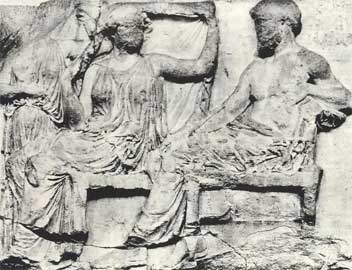 Ο Δίας και η Ήρα στην ανατολική ζωφόρο του Παρθενώνα.
Ο γιος του Πελασγού Τήμενος ίδρυσε στη Στύμφαλο για την Ήρα τρία ιερά: στην Ήρα παρθένο, στην Ήρα τελεία και στην Ήρα χήρα. Η τελευταία προσωνυμία της, γνωστή μόνο τοπικά, δηλώνει τη στερημένη από άντρα γυναίκα. Στο επίκεντρο της λατρείας της Ήρας, που διαπιστώνεται ήδη στις πινακίδες της Γραμμικής Β από την Πύλο, βρίσκεται ο «ιερός γάμος» της με τον Δία στη Σάμο. Σε θαλάσσιο λουτρό υποβάλλεται το λατρευτικό ξόανο της Ήρας στα Τόναια της Σάμου, που φαίνεται πως ακολουθούσαν τα Ηραία, τον ετήσιο εορτασμό του «ιερού γάμου». Πίσω από τον εορτασμό, διαφαίνονται οι διαβατήριες τελετές για κορίτσια στο κατώφλι της παντρειάς. Πολλές ενδείξεις στοιχειοθετούν ότι η Ήρα λατρευόταν και ως Παρθένος, δηλαδή ως κόρη που δεν έχει ακόμη γεννήσει. Τα κορίτσια πριν από το γάμο προσφέρουν θυσίες, τα προτέλεια, στην Ήρα Τελεία και τον Δία Τέλειο. Παρθένος και νύφη, αλλά όχι ακόμη μητέρα, η Ήρα λούζεται κάθε χρόνο στην πηγή Κάναθο της Αργολίδας για να συνδεθεί με τη γονιμότητα και τη μητρότητα. Στις Πλαταιές, στα Δαίδαλα, που καταλήγουν σε μεγάλη πυρά στην κορυφή του Κιθαιρώνα, γιορτάζονται η τελετή του «ιερού γάμου» και το νυφικό καθαρτήριο λουτρό. Στην Ολυμπία, όπου στο άδυτο του ναού της Ήρας έλαμπε το χρυσελεφάντινο σύνταγμα του ζευγαριού φιλοτεχνημένο από τον Πολύκλειτο, η μεγάλη πρωτοχρονιάτικη γιορτή των Ηραίων, το μήνα Παρθενιώνα, επικεντρωνόταν σε αγώνα δρόμου των παρθένων. Απόγονοι των Ηραίων, οι ολυμπιακοί αγώνες της κλασικής εποχής απαγόρευαν αυστηρά την παρουσία παντρεμένων γυναικών με εξαίρεση την ιέρεια της Δήμητρας Χαμύνης. Η ιέρεια υποκαθιστά τις παντρεμένες γυναίκες που σύμφωνα με το μύθο ίδρυσαν τα Ηραία, γυναίκες έμπειρες σαν αυτές που καθοδηγούν τα κορίτσια στις τελετές μύησης.
Ο Δίας και η Ήρα στην ανατολική ζωφόρο του Παρθενώνα.
Ο γιος του Πελασγού Τήμενος ίδρυσε στη Στύμφαλο για την Ήρα τρία ιερά: στην Ήρα παρθένο, στην Ήρα τελεία και στην Ήρα χήρα. Η τελευταία προσωνυμία της, γνωστή μόνο τοπικά, δηλώνει τη στερημένη από άντρα γυναίκα. Στο επίκεντρο της λατρείας της Ήρας, που διαπιστώνεται ήδη στις πινακίδες της Γραμμικής Β από την Πύλο, βρίσκεται ο «ιερός γάμος» της με τον Δία στη Σάμο. Σε θαλάσσιο λουτρό υποβάλλεται το λατρευτικό ξόανο της Ήρας στα Τόναια της Σάμου, που φαίνεται πως ακολουθούσαν τα Ηραία, τον ετήσιο εορτασμό του «ιερού γάμου». Πίσω από τον εορτασμό, διαφαίνονται οι διαβατήριες τελετές για κορίτσια στο κατώφλι της παντρειάς. Πολλές ενδείξεις στοιχειοθετούν ότι η Ήρα λατρευόταν και ως Παρθένος, δηλαδή ως κόρη που δεν έχει ακόμη γεννήσει. Τα κορίτσια πριν από το γάμο προσφέρουν θυσίες, τα προτέλεια, στην Ήρα Τελεία και τον Δία Τέλειο. Παρθένος και νύφη, αλλά όχι ακόμη μητέρα, η Ήρα λούζεται κάθε χρόνο στην πηγή Κάναθο της Αργολίδας για να συνδεθεί με τη γονιμότητα και τη μητρότητα. Στις Πλαταιές, στα Δαίδαλα, που καταλήγουν σε μεγάλη πυρά στην κορυφή του Κιθαιρώνα, γιορτάζονται η τελετή του «ιερού γάμου» και το νυφικό καθαρτήριο λουτρό. Στην Ολυμπία, όπου στο άδυτο του ναού της Ήρας έλαμπε το χρυσελεφάντινο σύνταγμα του ζευγαριού φιλοτεχνημένο από τον Πολύκλειτο, η μεγάλη πρωτοχρονιάτικη γιορτή των Ηραίων, το μήνα Παρθενιώνα, επικεντρωνόταν σε αγώνα δρόμου των παρθένων. Απόγονοι των Ηραίων, οι ολυμπιακοί αγώνες της κλασικής εποχής απαγόρευαν αυστηρά την παρουσία παντρεμένων γυναικών με εξαίρεση την ιέρεια της Δήμητρας Χαμύνης. Η ιέρεια υποκαθιστά τις παντρεμένες γυναίκες που σύμφωνα με το μύθο ίδρυσαν τα Ηραία, γυναίκες έμπειρες σαν αυτές που καθοδηγούν τα κορίτσια στις τελετές μύησης.
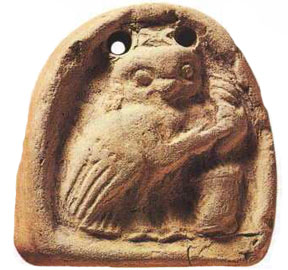 Αγνύθα με παράσταση κουκουβάγιας που γνέθει (300 π.Χ.).
Η μεταφορά της υφαντικής αξιοποιεί κυρίως δύο τεχνικές της: το γνέσιμο, με την αδιάκοπη κυκλική κίνηση, και την καθαυτό ύφανση, με τους μηχανισμούς της νόησης στον αρμονικό συνδυασμό των νημάτων, την ομόνοια. Κυριολεξία και μεταφορά συμπίπτουν στον Δόλον της Πηνελόπης.
Η σχέση της υφαντικής με την Αθηνά διέρχεται από τη σχέση της υφαντικής με τη νόηση. Η «σκόπιμη πρόβλεψη», που με τέχνη πραγματώνεται στον αργαλειό, ανήκει στο χώρο της εφηρμοσμένης εφευρετικότητας, δηλαδή στην Μήτιν, μητέρα της Αθηνάς. Η θεά δεν επινόησε μόνο αλλά και δίδαξε την τέχνη σε γυναίκες όπως η Πανδώρα, οι κόρες του Πανδάρεου, οι γυναίκες των Φαιάκων ή η Λυδή Αράχνη. Νεότερη από τη μορφή της Προμάχου που λατρεύεται στην Ακρόπολη, η μορφή της Αθηνάς Εργάνης διαμορφώνεται στην αρχαϊκή εποχή και λατρεύεται σε κοινό ναό με τον τεχνίτη Ήφαιστο, στο Θησείο. Κεντρική θέση στον εορτασμό των Μεγάλων Παναθηναίων είχε η προσφορά του πέπλου που ύφαιναν οι ἐργαστίναι. Μια άλλη παρθένος, η Άρτεμις, που διαφεντεύει τα όρια ανάμεσα στο ανήμερο και το ήμερο, που οδηγεί τη μετάβαση των άγουρων κοριτσιών στο γάμο όπως στην Βραυρώνα, έχει μια υπαινικτική μόνο σχέση με το γνέσιμο και τη ρόκα. Στην Οδύσσεια, η Ελένη που γνέθει παρομοιάζεται με τη χρυσηλάκατον Άρτεμη. Αν ο Κρητικός Δίας υπεξαιρεί την ύφανση για να φέρει την ομόνοια και να προστατέψει το γάμο, ο Διόνυσος την καταστρέφει ως ασύμβατη προς τη λατρεία του. Ο μύθος για τις Μινυάδες περιγράφει γλαφυρά πως ο θεός μεταμορφώνει τον αργαλειό που αυτές αρνούνται να εγκαταλείψουν σε βακχικό τοπίο.
Αγνύθα με παράσταση κουκουβάγιας που γνέθει (300 π.Χ.).
Η μεταφορά της υφαντικής αξιοποιεί κυρίως δύο τεχνικές της: το γνέσιμο, με την αδιάκοπη κυκλική κίνηση, και την καθαυτό ύφανση, με τους μηχανισμούς της νόησης στον αρμονικό συνδυασμό των νημάτων, την ομόνοια. Κυριολεξία και μεταφορά συμπίπτουν στον Δόλον της Πηνελόπης.
Η σχέση της υφαντικής με την Αθηνά διέρχεται από τη σχέση της υφαντικής με τη νόηση. Η «σκόπιμη πρόβλεψη», που με τέχνη πραγματώνεται στον αργαλειό, ανήκει στο χώρο της εφηρμοσμένης εφευρετικότητας, δηλαδή στην Μήτιν, μητέρα της Αθηνάς. Η θεά δεν επινόησε μόνο αλλά και δίδαξε την τέχνη σε γυναίκες όπως η Πανδώρα, οι κόρες του Πανδάρεου, οι γυναίκες των Φαιάκων ή η Λυδή Αράχνη. Νεότερη από τη μορφή της Προμάχου που λατρεύεται στην Ακρόπολη, η μορφή της Αθηνάς Εργάνης διαμορφώνεται στην αρχαϊκή εποχή και λατρεύεται σε κοινό ναό με τον τεχνίτη Ήφαιστο, στο Θησείο. Κεντρική θέση στον εορτασμό των Μεγάλων Παναθηναίων είχε η προσφορά του πέπλου που ύφαιναν οι ἐργαστίναι. Μια άλλη παρθένος, η Άρτεμις, που διαφεντεύει τα όρια ανάμεσα στο ανήμερο και το ήμερο, που οδηγεί τη μετάβαση των άγουρων κοριτσιών στο γάμο όπως στην Βραυρώνα, έχει μια υπαινικτική μόνο σχέση με το γνέσιμο και τη ρόκα. Στην Οδύσσεια, η Ελένη που γνέθει παρομοιάζεται με τη χρυσηλάκατον Άρτεμη. Αν ο Κρητικός Δίας υπεξαιρεί την ύφανση για να φέρει την ομόνοια και να προστατέψει το γάμο, ο Διόνυσος την καταστρέφει ως ασύμβατη προς τη λατρεία του. Ο μύθος για τις Μινυάδες περιγράφει γλαφυρά πως ο θεός μεταμορφώνει τον αργαλειό που αυτές αρνούνται να εγκαταλείψουν σε βακχικό τοπίο.
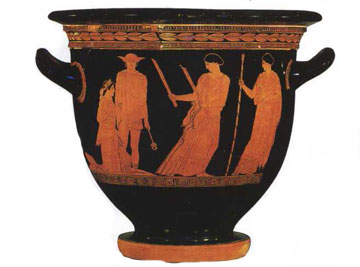 Κρατήρας (440 π.Χ.) με την επιστροφή της Περσεφόνης.
Για τους αρχαίους, η καλλιέργεια των σιτηρών και ο πολιτισμένος βίος είναι έννοιες αλληλένδετες. Ο J.-P. Vernant υποστήριξε ότι η αγροτική εργασία νοείται ως ένα είδος ηθικού βίου. Η μορφή της Δήμητρας συντάσσεται με την Περσεφόνη ή Κόρη. Σύμβολά τους είναι το στάχυ, η δάδα και ο χοίρος. Στην Αθήνα, οι Πεισιστρατίδες ευνόησαν τη λατρεία της Δήμητρας. Κάποιες από τις τελετές των δυο θεαινών ήταν αποκλειστικά για γυναίκες. Το φθινόπωρο, τα Θεσμοφόρια διαρκούσαν τρεις μέρες που ονομάζονταν άνοδος, νηστεία και καλλιγένεια. Λίγο νωρίτερα εορτάζονταν τα Ελευσίνια Μυστήρια, ανοιχτά σε όλους ανεξαιρέτως, που είχαν και πολιτική σημασία καθώς οι Αθηναίοι και οι σύμμαχοί τους έστελναν τις απαρχές, τους πρώτους ώριμους καρπούς. Η ίδρυσή τους συνδέεται με το μύθο της αρπαγής της Περσεφόνης και το βαρύ πένθος της μητέρας της. Στις αρχές του χειμώνα, τα Αλώα απευθύνονται τόσο στον Διόνυσο όσο και στη Δήμητρα, ενώ τα Σκίρα τελούνταν μετά το θερισμό και, όπως τα Θεσμοφόρια, ήταν αποκλειστικά γυναικεία γιορτή. Η σύνδεση των γυναικείων τελετών και του αγροτικού κύκλου οδήγησε σε πολυάριθμες ερμηνείες. Από τη σχολή του Κέιμπριτζ, στο ζήτημα που απασχόλησε τον F.M. Cornford, την J. Harrison και τον G. Thomson, δόθηκαν συμβολικές ή και μυητικές διαστάσεις. Αργότερα, η έρευνα ενέταξε τον αποκλεισμό των αντρών στο πλαίσιο των κοινωνικών και πολιτικών πρακτικών της αρχαίας πόλης. Από τη «Σχολή του Παρισιού», ο M. Detienne διακρίνει ένα πολιτικό μήνυμα στα Θεσμοφόρια, καθώς οι γυναίκες που συμπεριφέρονται ως πολίτες αντιστρέφουν ταυτόχρονα την αντρική τάξη των πραγμάτων. Σε πλήρη διάσταση, η L. Foxhall προβάλλει τη γυναικεία αλληλεγγύη και συνεργατικότητα, ενώ η M. Arthur τονίζει τη σχέση μάνας και Κόρης στο πλαίσιο της διαμόρφωσης μιας γυναικείας ταυτότητας. Τέλος, σε αντίθεση με την κρατούσα άποψη περί υποβοήθησης της γονιμότητας, η L. Nixon υποστήριξε ότι τα φυτά που εισάγονται στη λατρεία της Δήμητρας χρησιμοποιούνται από τις γυναίκες για την αντισυλληπτική τους δράση. Η αρθρογράφος καταλήγει επισημαίνοντας δύο παρεξηγήσεις: η πρώτη αποκλείει τις γυναίκες από την ενασχόληση με τη γεωργία. Η παρεξήγηση αυτή οφείλεται στη γενίκευση του κατά φύλο καταμερισμού εργασίας που περιγράφεται τον 4ο αιώνα π.Χ. στον Οικονομικόν του Ξενοφώντα. Η δεύτερη υπερτονίζει την έλλειψη πολιτικών δικαιωμάτων στις γυναίκες, παραβλέποντας ότι η συμμετοχή τους στις τελετές τις εντάσσει στο κοινωνικό σώμα, στην πόλη ως κοινότητα.
Κρατήρας (440 π.Χ.) με την επιστροφή της Περσεφόνης.
Για τους αρχαίους, η καλλιέργεια των σιτηρών και ο πολιτισμένος βίος είναι έννοιες αλληλένδετες. Ο J.-P. Vernant υποστήριξε ότι η αγροτική εργασία νοείται ως ένα είδος ηθικού βίου. Η μορφή της Δήμητρας συντάσσεται με την Περσεφόνη ή Κόρη. Σύμβολά τους είναι το στάχυ, η δάδα και ο χοίρος. Στην Αθήνα, οι Πεισιστρατίδες ευνόησαν τη λατρεία της Δήμητρας. Κάποιες από τις τελετές των δυο θεαινών ήταν αποκλειστικά για γυναίκες. Το φθινόπωρο, τα Θεσμοφόρια διαρκούσαν τρεις μέρες που ονομάζονταν άνοδος, νηστεία και καλλιγένεια. Λίγο νωρίτερα εορτάζονταν τα Ελευσίνια Μυστήρια, ανοιχτά σε όλους ανεξαιρέτως, που είχαν και πολιτική σημασία καθώς οι Αθηναίοι και οι σύμμαχοί τους έστελναν τις απαρχές, τους πρώτους ώριμους καρπούς. Η ίδρυσή τους συνδέεται με το μύθο της αρπαγής της Περσεφόνης και το βαρύ πένθος της μητέρας της. Στις αρχές του χειμώνα, τα Αλώα απευθύνονται τόσο στον Διόνυσο όσο και στη Δήμητρα, ενώ τα Σκίρα τελούνταν μετά το θερισμό και, όπως τα Θεσμοφόρια, ήταν αποκλειστικά γυναικεία γιορτή. Η σύνδεση των γυναικείων τελετών και του αγροτικού κύκλου οδήγησε σε πολυάριθμες ερμηνείες. Από τη σχολή του Κέιμπριτζ, στο ζήτημα που απασχόλησε τον F.M. Cornford, την J. Harrison και τον G. Thomson, δόθηκαν συμβολικές ή και μυητικές διαστάσεις. Αργότερα, η έρευνα ενέταξε τον αποκλεισμό των αντρών στο πλαίσιο των κοινωνικών και πολιτικών πρακτικών της αρχαίας πόλης. Από τη «Σχολή του Παρισιού», ο M. Detienne διακρίνει ένα πολιτικό μήνυμα στα Θεσμοφόρια, καθώς οι γυναίκες που συμπεριφέρονται ως πολίτες αντιστρέφουν ταυτόχρονα την αντρική τάξη των πραγμάτων. Σε πλήρη διάσταση, η L. Foxhall προβάλλει τη γυναικεία αλληλεγγύη και συνεργατικότητα, ενώ η M. Arthur τονίζει τη σχέση μάνας και Κόρης στο πλαίσιο της διαμόρφωσης μιας γυναικείας ταυτότητας. Τέλος, σε αντίθεση με την κρατούσα άποψη περί υποβοήθησης της γονιμότητας, η L. Nixon υποστήριξε ότι τα φυτά που εισάγονται στη λατρεία της Δήμητρας χρησιμοποιούνται από τις γυναίκες για την αντισυλληπτική τους δράση. Η αρθρογράφος καταλήγει επισημαίνοντας δύο παρεξηγήσεις: η πρώτη αποκλείει τις γυναίκες από την ενασχόληση με τη γεωργία. Η παρεξήγηση αυτή οφείλεται στη γενίκευση του κατά φύλο καταμερισμού εργασίας που περιγράφεται τον 4ο αιώνα π.Χ. στον Οικονομικόν του Ξενοφώντα. Η δεύτερη υπερτονίζει την έλλειψη πολιτικών δικαιωμάτων στις γυναίκες, παραβλέποντας ότι η συμμετοχή τους στις τελετές τις εντάσσει στο κοινωνικό σώμα, στην πόλη ως κοινότητα.
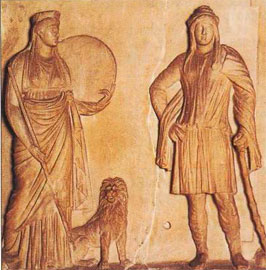 Η Κυβέλη και ο Άττις.
Η συγκριτική μελέτη του υλικού από τη Μεσοποταμία και τις χώρες της ανατολικής και δυτικής Μεσογείου, ακόμη κι από την Ελλάδα των ιστορικών χρόνων, δείχνει ότι η τελετή του ιερού γάμου είναι πανάρχαια και συνδέεται άμεσα με τις απαρχές της ιερής βασιλείας: η Μεγάλη Θεά της Φύσης, κατά κανόνα, σμίγει με τον θνητό εκλεκτό της για να γεννήσει τον πρώτο βασιλιά. Στην Ελλάδα, ο Ομηρικός Ύμνος στην Αφροδίτη από τον 7ο αιώνα π.Χ., περιγράφει το σμίξιμό της με τον Αγχίση και τη γέννηση του γιου τους Αινεία. Ο Αγχίσης αρχικά τρομάζει στη σκέψη να σμίξει με μια θεά, όπως κι ο Γιλγαμές που αρνείται τον έρωτα της Ιστάρ. Ο κυνηγός Ωρίων πεθαίνει από τα βέλη της Αρτέμιδος επειδή έσμιξε με την Ηώ. Ο Ιασίων σμίγει με τη Δήμητρα. Τον καίει ο κεραυνός του Δία. Πίσω από αυτούς τους μύθους αχνοφέγγει ο Ιερός Γάμος που υπόσχεται την ευλογία της γονιμότητας και εγγυάται τη διατήρηση της ζωής. Όπως η κρητική Ευρώπη και Πασιφάη, έτσι και η μικρασιάτισσα Κυβέλη είναι η κυρά των ταύρων. Η Δέσποινα του γενετήσιου ενστίκτου αγάπησε τον Άττι. Ο μύθος λέει πως ο Άττις, δείχνοντας την πλήρη του αφοσίωση στη θεά, πέθανε στην προσπάθεια να αυτοευνουχιστεί. Στην εκστατική λατρεία της θεάς, όσοι επαναλάμβαναν την πράξη του Άττι γίνονταν οι ευνούχοι της. Στην αρχή του καλοκαιριού, η Ανατολή, όπου παλιότερα οι Σουμέριες αποχαιρετούσαν τον Ντουμουζί, εραστή και θύμα της Ινάννα, αντηχούσε από το θρήνο για το χαμό του Ταμμούζ, του αγαπημένου της Αστάρτης. Την ίδια εποχή, στην Ελλάδα γιόρταζαν τα Αδώνεια. Ο εραστής της Αφροδίτης, γιος της αιμομικτικής σχέσης του βασιλιά της Κύπρου Κινύρα με την κόρη του Μύρρα, δεν πρόλαβε να χαρεί τη θεά, ούτε την Περσεφόνη που κι αυτή τον πόθησε. Βρήκε το θάνατο στο κυνήγι. Στην Κύπρο θεωρούσαν τον Γόλγο γιο του Άδωνι και της Αφροδίτης. Στην Ελλάδα επικεντρώθηκαν στο θρήνο για την απώλεια του αγαπημένου, που δεν άφησε ασυγκίνητη ούτε τη Σαπφώ.
Η Κυβέλη και ο Άττις.
Η συγκριτική μελέτη του υλικού από τη Μεσοποταμία και τις χώρες της ανατολικής και δυτικής Μεσογείου, ακόμη κι από την Ελλάδα των ιστορικών χρόνων, δείχνει ότι η τελετή του ιερού γάμου είναι πανάρχαια και συνδέεται άμεσα με τις απαρχές της ιερής βασιλείας: η Μεγάλη Θεά της Φύσης, κατά κανόνα, σμίγει με τον θνητό εκλεκτό της για να γεννήσει τον πρώτο βασιλιά. Στην Ελλάδα, ο Ομηρικός Ύμνος στην Αφροδίτη από τον 7ο αιώνα π.Χ., περιγράφει το σμίξιμό της με τον Αγχίση και τη γέννηση του γιου τους Αινεία. Ο Αγχίσης αρχικά τρομάζει στη σκέψη να σμίξει με μια θεά, όπως κι ο Γιλγαμές που αρνείται τον έρωτα της Ιστάρ. Ο κυνηγός Ωρίων πεθαίνει από τα βέλη της Αρτέμιδος επειδή έσμιξε με την Ηώ. Ο Ιασίων σμίγει με τη Δήμητρα. Τον καίει ο κεραυνός του Δία. Πίσω από αυτούς τους μύθους αχνοφέγγει ο Ιερός Γάμος που υπόσχεται την ευλογία της γονιμότητας και εγγυάται τη διατήρηση της ζωής. Όπως η κρητική Ευρώπη και Πασιφάη, έτσι και η μικρασιάτισσα Κυβέλη είναι η κυρά των ταύρων. Η Δέσποινα του γενετήσιου ενστίκτου αγάπησε τον Άττι. Ο μύθος λέει πως ο Άττις, δείχνοντας την πλήρη του αφοσίωση στη θεά, πέθανε στην προσπάθεια να αυτοευνουχιστεί. Στην εκστατική λατρεία της θεάς, όσοι επαναλάμβαναν την πράξη του Άττι γίνονταν οι ευνούχοι της. Στην αρχή του καλοκαιριού, η Ανατολή, όπου παλιότερα οι Σουμέριες αποχαιρετούσαν τον Ντουμουζί, εραστή και θύμα της Ινάννα, αντηχούσε από το θρήνο για το χαμό του Ταμμούζ, του αγαπημένου της Αστάρτης. Την ίδια εποχή, στην Ελλάδα γιόρταζαν τα Αδώνεια. Ο εραστής της Αφροδίτης, γιος της αιμομικτικής σχέσης του βασιλιά της Κύπρου Κινύρα με την κόρη του Μύρρα, δεν πρόλαβε να χαρεί τη θεά, ούτε την Περσεφόνη που κι αυτή τον πόθησε. Βρήκε το θάνατο στο κυνήγι. Στην Κύπρο θεωρούσαν τον Γόλγο γιο του Άδωνι και της Αφροδίτης. Στην Ελλάδα επικεντρώθηκαν στο θρήνο για την απώλεια του αγαπημένου, που δεν άφησε ασυγκίνητη ούτε τη Σαπφώ.
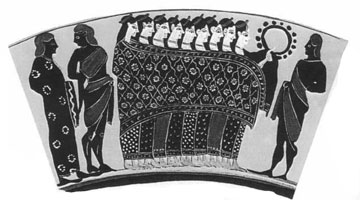 Εννέα γυναίκες κάτω από μανδύα.
Οι φιλόσοφοι αποδίδουν στις Χάριτες την ανταποδοτικότητα και την αμοιβαιότητα που εξασφαλίζουν την κοινωνική συνοχή, ενώ οι ποιητές τις συσχετίζουν με τη χαρά για τη γιορτή, τα τραγούδια και το χορό. Άλλοτε δύο, άλλοτε τρεις, οι Χάριτες λατρεύονται στην Αθήνα, τη Βοιωτία, τις Αμύκλες, την Ολυμπία, την Κω. Η εμφάνισή τους σε δυάδες ή τριάδες επιχειρεί να αφαιρέσει την ατομικότητα από το γυναικείο στοιχείο, όπως υποψιάζεται η N. Loraux; Θέση της συγγραφέως είναι ότι η ομαδικότητα στην εμφάνιση των Χαρίτων απορρέει από το συλλογικό χαρακτήρα που ενυπάρχει στην κοινωνικότητα και την εργασία, εν προκειμένω την υφαντική. Ο όρος χάρις έχει πολλές σημασίες. Πλάι στην έννοια της εξυπηρέτησης και της ευγνωμοσύνης, που συναντάμε στον Αριστοτέλη, μια άλλη σημασιολογική διάσταση αποδίδει στη χάριν μια ορατότητα, μια ακτινοβολία που στρέφει τα βλέμματα προς όποιον ή ό,τι περιβάλλεται από αυτήν. Συνθέτοντας τις σημασίες, η B. MacLachlan εισήγαγε την ερμηνεία της «κοινωνικής ευχαρίστησης» σε αμοιβαία βάση. Η συγγραφέας την επεκτείνει, συσχετίζοντάς την με υφαντά ενυφασμένα με πολύχρωμα σχέδια. Σε αυτά συνενώνονται οι προσφορές από ευγνωμοσύνη και η δύναμη της ακτινοβολίας. Στη σχέση του ζευγαριού, η ευγνωμοσύνη της γυναίκας έχει και μια ορατή διάσταση, καθώς από τα έργα της υφαντικής, όπως και από τα κοσμήματα, πηγάζει χάρις, ερωτική ακτινοβολία. Στη φορεσιά της Πανδώρας, όπου τα δαίδαλα (σχέδια) στο στεφάνι που φτιάχνει ο Ήφαιστος συναγωνίζονται σε λάμψη τα δαίδαλα του πέπλου που δίνει η Αθηνά, φαίνεται καθαρά ότι η χάρις είναι συνυφασμένη με κάτι το σωματικό ή με κάποιο αντικείμενο που διαθέτει λάμψη. Οι μελέτες της F. Frontisi-Ducroux έδειξαν ότι ο όρος δαιδάλεος αναφέρεται στην κατασκευή ένθετων σχεδίων ή ένθετων ανάγλυφων απεικονίσεων στη μεταλλοτεχνία και την ξυλουργική. Η παλαιά άποψη ότι στον αρχαίο πέτρινο αργαλειό ήταν αδύνατη η ύφανση σχεδίων, εμπόδισε τους ερευνητές να αντιστοιχίσουν τον όρο ποικίλος, που παραπέμπει στην πολυχρωμία και τα σχέδια του υφαντού, με τον όρο δαιδάλεος. Τέτοια υφάσματα είχαν πρωτίστως τελετουργική χρήση: σε νεκρώσιμες τελετές, στα Παναθήναια, σε γάμους ή στην υποδοχή ξένων. Εθνολογικά παραδείγματα και η ομαδική κατασκευή πέπλων αφιερωμένων στις θεές, μας επιτρέπουν να υποθέσουμε ότι η ύφανση ήταν συλλογική εργασία, μάλλον ανά δυάδες, όπως απεικονίζεται στην αττική λήκυθο του ζωγράφου του Άμασι (540 π.Χ.). Τα διακοσμημένα με σχέδια υφάσματα έχουν κοινωνική σημασία: εντάσσουν όποιον τα φοράει σε κάποιο σύνολο, χρησιμεύουν στην αναγνώριση προσώπων στην τραγωδία. Ο κοινός μανδύας που περιβάλλει ομάδα γυναικών σε αγγεία της κλασικής εποχής παραπέμπει σε μια τελετουργική κοινωνικότητα που έχει τις ρίζες της στην κοινή εργασία. Στις τελετές εντοπίζεται μια άλλη λειτουργία της χάριτος που συνδέεται με την ακτινοβολία ενός λόγου ή τραγουδιού. Η λάμψη τους δεν συναρτάται με το περιεχόμενο αλλά με τον ωραίο τρόπο εκφοράς ή εκτέλεσης. Χρησιμοποιώντας τη μεταφορά της υφαντικής, ο Βακχυλίδης και ο Πίνδαρος παραβάλλουν το γραπτό τους κείμενο με ένα κομμάτι ύφασμα με ένθετες εικόνες. Η σημασία του κειμένου και του εικονογραφημένου υφάσματος στην απομνημονευτική λειτουργία δικαιολογεί την εξέχουσα θέση που είχαν οι Χάριτες στην οργάνωση των γιορτών της κλασικής εποχής.
Εννέα γυναίκες κάτω από μανδύα.
Οι φιλόσοφοι αποδίδουν στις Χάριτες την ανταποδοτικότητα και την αμοιβαιότητα που εξασφαλίζουν την κοινωνική συνοχή, ενώ οι ποιητές τις συσχετίζουν με τη χαρά για τη γιορτή, τα τραγούδια και το χορό. Άλλοτε δύο, άλλοτε τρεις, οι Χάριτες λατρεύονται στην Αθήνα, τη Βοιωτία, τις Αμύκλες, την Ολυμπία, την Κω. Η εμφάνισή τους σε δυάδες ή τριάδες επιχειρεί να αφαιρέσει την ατομικότητα από το γυναικείο στοιχείο, όπως υποψιάζεται η N. Loraux; Θέση της συγγραφέως είναι ότι η ομαδικότητα στην εμφάνιση των Χαρίτων απορρέει από το συλλογικό χαρακτήρα που ενυπάρχει στην κοινωνικότητα και την εργασία, εν προκειμένω την υφαντική. Ο όρος χάρις έχει πολλές σημασίες. Πλάι στην έννοια της εξυπηρέτησης και της ευγνωμοσύνης, που συναντάμε στον Αριστοτέλη, μια άλλη σημασιολογική διάσταση αποδίδει στη χάριν μια ορατότητα, μια ακτινοβολία που στρέφει τα βλέμματα προς όποιον ή ό,τι περιβάλλεται από αυτήν. Συνθέτοντας τις σημασίες, η B. MacLachlan εισήγαγε την ερμηνεία της «κοινωνικής ευχαρίστησης» σε αμοιβαία βάση. Η συγγραφέας την επεκτείνει, συσχετίζοντάς την με υφαντά ενυφασμένα με πολύχρωμα σχέδια. Σε αυτά συνενώνονται οι προσφορές από ευγνωμοσύνη και η δύναμη της ακτινοβολίας. Στη σχέση του ζευγαριού, η ευγνωμοσύνη της γυναίκας έχει και μια ορατή διάσταση, καθώς από τα έργα της υφαντικής, όπως και από τα κοσμήματα, πηγάζει χάρις, ερωτική ακτινοβολία. Στη φορεσιά της Πανδώρας, όπου τα δαίδαλα (σχέδια) στο στεφάνι που φτιάχνει ο Ήφαιστος συναγωνίζονται σε λάμψη τα δαίδαλα του πέπλου που δίνει η Αθηνά, φαίνεται καθαρά ότι η χάρις είναι συνυφασμένη με κάτι το σωματικό ή με κάποιο αντικείμενο που διαθέτει λάμψη. Οι μελέτες της F. Frontisi-Ducroux έδειξαν ότι ο όρος δαιδάλεος αναφέρεται στην κατασκευή ένθετων σχεδίων ή ένθετων ανάγλυφων απεικονίσεων στη μεταλλοτεχνία και την ξυλουργική. Η παλαιά άποψη ότι στον αρχαίο πέτρινο αργαλειό ήταν αδύνατη η ύφανση σχεδίων, εμπόδισε τους ερευνητές να αντιστοιχίσουν τον όρο ποικίλος, που παραπέμπει στην πολυχρωμία και τα σχέδια του υφαντού, με τον όρο δαιδάλεος. Τέτοια υφάσματα είχαν πρωτίστως τελετουργική χρήση: σε νεκρώσιμες τελετές, στα Παναθήναια, σε γάμους ή στην υποδοχή ξένων. Εθνολογικά παραδείγματα και η ομαδική κατασκευή πέπλων αφιερωμένων στις θεές, μας επιτρέπουν να υποθέσουμε ότι η ύφανση ήταν συλλογική εργασία, μάλλον ανά δυάδες, όπως απεικονίζεται στην αττική λήκυθο του ζωγράφου του Άμασι (540 π.Χ.). Τα διακοσμημένα με σχέδια υφάσματα έχουν κοινωνική σημασία: εντάσσουν όποιον τα φοράει σε κάποιο σύνολο, χρησιμεύουν στην αναγνώριση προσώπων στην τραγωδία. Ο κοινός μανδύας που περιβάλλει ομάδα γυναικών σε αγγεία της κλασικής εποχής παραπέμπει σε μια τελετουργική κοινωνικότητα που έχει τις ρίζες της στην κοινή εργασία. Στις τελετές εντοπίζεται μια άλλη λειτουργία της χάριτος που συνδέεται με την ακτινοβολία ενός λόγου ή τραγουδιού. Η λάμψη τους δεν συναρτάται με το περιεχόμενο αλλά με τον ωραίο τρόπο εκφοράς ή εκτέλεσης. Χρησιμοποιώντας τη μεταφορά της υφαντικής, ο Βακχυλίδης και ο Πίνδαρος παραβάλλουν το γραπτό τους κείμενο με ένα κομμάτι ύφασμα με ένθετες εικόνες. Η σημασία του κειμένου και του εικονογραφημένου υφάσματος στην απομνημονευτική λειτουργία δικαιολογεί την εξέχουσα θέση που είχαν οι Χάριτες στην οργάνωση των γιορτών της κλασικής εποχής.
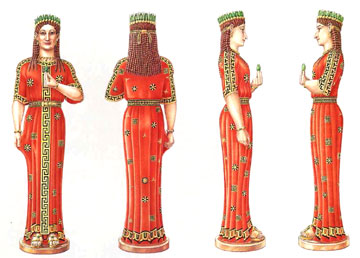 Τα έξοχα χρώματα του αγάλματος της Φρασίκλειας (σχ. Herbert Meinhold).
Από τη νεκρόπολη του αρχαίου δήμου Μυρρινούντος στην Αττική ξεπρόβαλαν το 1972 τα αρχαϊκά αγάλματα ενός Κούρου και μιας Κόρης. Ακόμη αδημοσίευτα, εκτίθενται στο Εθνικό Αρχαιολογικό Μουσείο. Η επιγραφή της βάσης ονομάζει την Κόρη Φρασίκλεια και τον Πάριο γλύπτη της Αριστίωνα. Η Φρασίκλεια (περί το 540 π.Χ.) ανήκει στην παράδοση της Κόρης του Βερολίνου (570/560 π.Χ.), αλλά αποτελεί μια πιο εξελιγμένη βαθμίδα. Η σχέση σώματος και ενδύματος θυμίζει τις Κόρες της Πάρου και τις Κόρες της Δήλου. Ωστόσο, η απόδοση του προσώπου μαρτυρεί ότι ο παριανός γλύπτης υιοθέτησε στοιχεία της αττικής τέχνης. Η υπέροχη βοστρυχωτή κόμη συγκρατείται πίσω με ταινία. Η περίτεχνη στεφάνη στο κεφάλι συνδυάζει σειρά μαργαριταριών με άνθη λωτού και κάλυκες. Περιδέραιο, ενώτια και βραχιόλι είναι τα πολύτιμα κοσμήματά της. Η Κόρη, που κρατάει κάλυκα λωτού, φοράει χειριδωτό, κολπωτό χιτώνα με ζώνη. Οι αραιές, πλατύγραμμες πτυχές που αρχίζουν κάτω από τη μέση, καταλήγουν στα γλωσσόσχημα κοσμήματα του ποδόγυρου. Τα πόδια, ακάλυπτα μπροστά, φορούν σανδάλια. Με την τεχνική της «γανώσεως», που χρησιμοποιούσε πάνω στο μάρμαρο μίγμα λαδιού και υγρού κεριού, οι γλύπτες απέδιδαν τη στιλπνότητα και το χρώμα του φυσικού δέρματος στο πρόσωπο και τα γυμνά μέλη. Στο άρθρο παρουσιάζονται, για πρώτη φορά, τέσσερα σχέδια που αναπαριστούν χρωματισμένο το διάκοσμο του αγάλματος. Μπροστά, κεντρική, κατακόρυφη ταινία με εγχάρακτο μαίανδρο διατρέχει το χιτώνα, ενώ λεπτότερη, παρόμοια ταινία στολίζει επάνω το τελείωμα του υφάσματος, περιβάλλοντας το άνοιγμα του λαιμού και τονίζοντας διπλά την ένωση των μανικιών. Το υπόλοιπο ένδυμα είναι διάσπαρτο με ποικίλους ρόδακες, γαμματοσταυρούς κι αστέρια. Τα κύρια χρώματα είναι το κόκκινο κεραμιδί (κιννάβαρι), το μαύρο και το κίτρινο.
Τα έξοχα χρώματα του αγάλματος της Φρασίκλειας (σχ. Herbert Meinhold).
Από τη νεκρόπολη του αρχαίου δήμου Μυρρινούντος στην Αττική ξεπρόβαλαν το 1972 τα αρχαϊκά αγάλματα ενός Κούρου και μιας Κόρης. Ακόμη αδημοσίευτα, εκτίθενται στο Εθνικό Αρχαιολογικό Μουσείο. Η επιγραφή της βάσης ονομάζει την Κόρη Φρασίκλεια και τον Πάριο γλύπτη της Αριστίωνα. Η Φρασίκλεια (περί το 540 π.Χ.) ανήκει στην παράδοση της Κόρης του Βερολίνου (570/560 π.Χ.), αλλά αποτελεί μια πιο εξελιγμένη βαθμίδα. Η σχέση σώματος και ενδύματος θυμίζει τις Κόρες της Πάρου και τις Κόρες της Δήλου. Ωστόσο, η απόδοση του προσώπου μαρτυρεί ότι ο παριανός γλύπτης υιοθέτησε στοιχεία της αττικής τέχνης. Η υπέροχη βοστρυχωτή κόμη συγκρατείται πίσω με ταινία. Η περίτεχνη στεφάνη στο κεφάλι συνδυάζει σειρά μαργαριταριών με άνθη λωτού και κάλυκες. Περιδέραιο, ενώτια και βραχιόλι είναι τα πολύτιμα κοσμήματά της. Η Κόρη, που κρατάει κάλυκα λωτού, φοράει χειριδωτό, κολπωτό χιτώνα με ζώνη. Οι αραιές, πλατύγραμμες πτυχές που αρχίζουν κάτω από τη μέση, καταλήγουν στα γλωσσόσχημα κοσμήματα του ποδόγυρου. Τα πόδια, ακάλυπτα μπροστά, φορούν σανδάλια. Με την τεχνική της «γανώσεως», που χρησιμοποιούσε πάνω στο μάρμαρο μίγμα λαδιού και υγρού κεριού, οι γλύπτες απέδιδαν τη στιλπνότητα και το χρώμα του φυσικού δέρματος στο πρόσωπο και τα γυμνά μέλη. Στο άρθρο παρουσιάζονται, για πρώτη φορά, τέσσερα σχέδια που αναπαριστούν χρωματισμένο το διάκοσμο του αγάλματος. Μπροστά, κεντρική, κατακόρυφη ταινία με εγχάρακτο μαίανδρο διατρέχει το χιτώνα, ενώ λεπτότερη, παρόμοια ταινία στολίζει επάνω το τελείωμα του υφάσματος, περιβάλλοντας το άνοιγμα του λαιμού και τονίζοντας διπλά την ένωση των μανικιών. Το υπόλοιπο ένδυμα είναι διάσπαρτο με ποικίλους ρόδακες, γαμματοσταυρούς κι αστέρια. Τα κύρια χρώματα είναι το κόκκινο κεραμιδί (κιννάβαρι), το μαύρο και το κίτρινο.
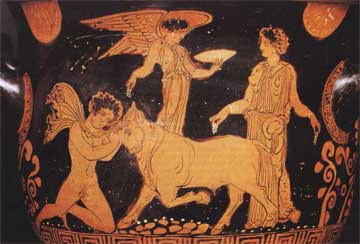 Μήδεια. Απουλικός κρατήρας του 370 π.Χ.
Οικόσιτη και εξημερωμένη νοικοκυρά ή γυναίκα με αποκλίνουσα συμπεριφορά; Σύζυγος στον αργαλειό ή νεράιδα και μάγισσα; «Πολιτισμός» ή ετερότητα; Ο συγγραφέας, αν και εμπνέεται κυρίως από τις Βάκχες, την «πολιτεία του Διονύσου», εστιάζει και σε άλλες τραγωδίες του Ευριπίδη (Άλκηστις, Μήδεια, Ιππόλυτος, Ελένη, Ιφιγένεια εν Αυλίδι και εν Ταύροις, Ικέτιδες), για να στοιχειοθετήσει την άποψη ότι η ιδιόλεκτος του ποιητή υποστηρίζει μια πολιτική αλληγορία που προβάλλει το διονυσιακό ιδεώδες στο πολιτειακό γίγνεσθαι. Στις Βάκχες, ο Διόνυσος υποβάλλει την επίγεια εξουσία στην ύστατη δοκιμασία: την αλλαγή φύσεως. Οι κοσμογονικές δυνάμεις της Μετ-Αμφίεσης αποκαλύπτονται, και ο θεός ιδρύει επί σκηνής την πολιτεία του. Οι καρτεσιανές κατηγορίες αδυνατούν να προσεγγίσουν την προ-ορθολογική σκέψη. Για να πάρει ο συνδυασμός θεάτρου και πολιτικής κεντρική θέση, οφείλουμε να ανατρέξουμε στις φιλοσοφικές καταβολές του Ευριπίδη, τον Αναξαγόρα και τους Σοφιστές. Ο ευτελισμός των αρχόντων, η αποκατάσταση του γυναικείου γένους στη σφαίρα της χαμένης του ιερότητας, η παλινόρθωση μιας προγονικής λατρείας που εκπροσωπούν οι Μαινάδες, αμφισβητούν έμμεσα τον κρατούντα Λόγον. Η υποχρεωτική υποταγή στον έλλογο πολιτισμό εξωθεί τη βάρβαρη Μήδεια στο έγκλημα που της υποβάλλει το ομαδικό ασυνείδητο. Επιλέγοντας να προβάλει, από το γένος των γυναικών, εκείνες που στασιάζουν, ο Ευριπίδης συνοψίζει στο πρόσωπό τους την πολιτική στάσιν όλων των περιθωριοποιημένων κοινωνικών κατηγοριών.
Μήδεια. Απουλικός κρατήρας του 370 π.Χ.
Οικόσιτη και εξημερωμένη νοικοκυρά ή γυναίκα με αποκλίνουσα συμπεριφορά; Σύζυγος στον αργαλειό ή νεράιδα και μάγισσα; «Πολιτισμός» ή ετερότητα; Ο συγγραφέας, αν και εμπνέεται κυρίως από τις Βάκχες, την «πολιτεία του Διονύσου», εστιάζει και σε άλλες τραγωδίες του Ευριπίδη (Άλκηστις, Μήδεια, Ιππόλυτος, Ελένη, Ιφιγένεια εν Αυλίδι και εν Ταύροις, Ικέτιδες), για να στοιχειοθετήσει την άποψη ότι η ιδιόλεκτος του ποιητή υποστηρίζει μια πολιτική αλληγορία που προβάλλει το διονυσιακό ιδεώδες στο πολιτειακό γίγνεσθαι. Στις Βάκχες, ο Διόνυσος υποβάλλει την επίγεια εξουσία στην ύστατη δοκιμασία: την αλλαγή φύσεως. Οι κοσμογονικές δυνάμεις της Μετ-Αμφίεσης αποκαλύπτονται, και ο θεός ιδρύει επί σκηνής την πολιτεία του. Οι καρτεσιανές κατηγορίες αδυνατούν να προσεγγίσουν την προ-ορθολογική σκέψη. Για να πάρει ο συνδυασμός θεάτρου και πολιτικής κεντρική θέση, οφείλουμε να ανατρέξουμε στις φιλοσοφικές καταβολές του Ευριπίδη, τον Αναξαγόρα και τους Σοφιστές. Ο ευτελισμός των αρχόντων, η αποκατάσταση του γυναικείου γένους στη σφαίρα της χαμένης του ιερότητας, η παλινόρθωση μιας προγονικής λατρείας που εκπροσωπούν οι Μαινάδες, αμφισβητούν έμμεσα τον κρατούντα Λόγον. Η υποχρεωτική υποταγή στον έλλογο πολιτισμό εξωθεί τη βάρβαρη Μήδεια στο έγκλημα που της υποβάλλει το ομαδικό ασυνείδητο. Επιλέγοντας να προβάλει, από το γένος των γυναικών, εκείνες που στασιάζουν, ο Ευριπίδης συνοψίζει στο πρόσωπό τους την πολιτική στάσιν όλων των περιθωριοποιημένων κοινωνικών κατηγοριών.
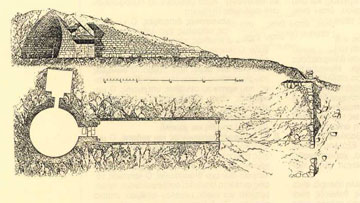 Τομή και κάτοψη μυκηναϊκού θολωτού τάφου.
Ο μυκηναϊκός θολωτός είναι ένα είδος τάφου μνημειακών διαστάσεων που πρωτοεμφανίζεται στη Μεσσηνία κατά την ΜΕ ΙΙΙ περίοδο και παρακολουθεί την ακμή και την παρακμή του μυκηναϊκού πολιτισμού ως τα τέλη της ΥΕ ΙΙΙΓ περιόδου κυρίως στην ηπειρωτική Ελλάδα. Τα κατασκευαστικά χαρακτηριστικά που, σε συνδυασμό, διακρίνουν τον μυκηναϊκό θολωτό από άλλους τάφους της εποχής του Χαλκού στο Αιγαίο είναι: α) ο υπόγειος και κυκλικός λιθόκτιστος θάλαμος, προσβάσιμος μέσω λαξευμένου δρόμου που οδηγεί σε κτιστή είσοδο με ανώφλι που ελαφρύνεται στατικά συνήθως με «κουφιστικό τρίγωνο», β) η λίθινη θόλος που σκεπάζει το θάλαμο, χτισμένη «κατά τον εκφορικό τρόπο», που καταλήγει σε μια μοναδική πέτρα, την «αρμονία», γ) ο τύμβος από χώμα που καλύπτει το οικοδόμημα. Το άρθρο επιχειρεί μια αναδρομή στις συζητήσεις εκατό περίπου χρόνων για την καταγωγή αυτού του ταφικού τύπου και μια κριτική αναθεώρησή τους βάσει νεότερων δεδομένων. Το πρόβλημα της καταγωγής του μυκηναϊκού θολωτού τάφου είχε εγκλωβιστεί στο γενικότερο ζήτημα περί «εκμινωισμού» του Αιγαίου. Η θεωρία της κρητικής του καταγωγής, που εν πολλοίς στηρίζεται στους «μινωικούς θολωτούς» τάφους Μεσαράς της ΜΜ Ι περιόδου, αποκρυσταλλώνεται από τους S. Hood και K. Branigan. Μεγαλύτερη ποικιλία ερμηνειών εμφανίζει η αντίθετη άποψη, ότι δηλαδή πρόκειται για φυσική εξέλιξη αρχιτεκτονικών τύπων της ηπειρωτικής Ελλάδας. Ο O.T.P.K. Dickinson δεν αποκλείει την πιθανότητα ορισμένοι από τους ΜΜ Ι και ΜΜ ΙΙ κρητικούς τάφους, όπως ο θολωτός Β Αρχανών, να έφεραν λίθινη εκφορική θόλο. Δέχεται την «εισβολή» της κρητικής μαστοριάς, επισημαίνοντας όμως ότι οι κατασκευαστικές διαφορές με τους κρητικούς τάφους (υπέργειοι, με εξωτερικούς παραθαλάμους, χωρίς τύμβο και δρόμο) αποκλείουν την απλή αντιγραφή κρητικών προτύπων. Θέτει επομένως το πρόβλημα στη βάση των ταφικών εθίμων. Ο μυκηναϊκός θολωτός χρησιμοποιείται για πλούσιες και ευάριθμες ταφές που καλύπτουν σχετικά σύντομο χρονικό διάστημα. Νεκρική λατρεία δεν έχει διαπιστωθεί. Αντίθετα, ο κρητικός τάφος προοριζόταν για πολυάριθμες ταφές, σπάνια πλούσιες. Το διάστημα χρήσης του είναι πολύ μεγάλο. Οι εξωτερικοί θάλαμοι προορίζονται για νεκρική λατρεία. Ιχνηλατώντας την προέλευση αρχιτεκτονικών μόνο χαρακτηριστικών απογυμνώνουμε το μνημείο από τα ταφικά έθιμα, την κοινωνική του λειτουργία και τα πολιτισμικά του συμφραζόμενα.
Τομή και κάτοψη μυκηναϊκού θολωτού τάφου.
Ο μυκηναϊκός θολωτός είναι ένα είδος τάφου μνημειακών διαστάσεων που πρωτοεμφανίζεται στη Μεσσηνία κατά την ΜΕ ΙΙΙ περίοδο και παρακολουθεί την ακμή και την παρακμή του μυκηναϊκού πολιτισμού ως τα τέλη της ΥΕ ΙΙΙΓ περιόδου κυρίως στην ηπειρωτική Ελλάδα. Τα κατασκευαστικά χαρακτηριστικά που, σε συνδυασμό, διακρίνουν τον μυκηναϊκό θολωτό από άλλους τάφους της εποχής του Χαλκού στο Αιγαίο είναι: α) ο υπόγειος και κυκλικός λιθόκτιστος θάλαμος, προσβάσιμος μέσω λαξευμένου δρόμου που οδηγεί σε κτιστή είσοδο με ανώφλι που ελαφρύνεται στατικά συνήθως με «κουφιστικό τρίγωνο», β) η λίθινη θόλος που σκεπάζει το θάλαμο, χτισμένη «κατά τον εκφορικό τρόπο», που καταλήγει σε μια μοναδική πέτρα, την «αρμονία», γ) ο τύμβος από χώμα που καλύπτει το οικοδόμημα. Το άρθρο επιχειρεί μια αναδρομή στις συζητήσεις εκατό περίπου χρόνων για την καταγωγή αυτού του ταφικού τύπου και μια κριτική αναθεώρησή τους βάσει νεότερων δεδομένων. Το πρόβλημα της καταγωγής του μυκηναϊκού θολωτού τάφου είχε εγκλωβιστεί στο γενικότερο ζήτημα περί «εκμινωισμού» του Αιγαίου. Η θεωρία της κρητικής του καταγωγής, που εν πολλοίς στηρίζεται στους «μινωικούς θολωτούς» τάφους Μεσαράς της ΜΜ Ι περιόδου, αποκρυσταλλώνεται από τους S. Hood και K. Branigan. Μεγαλύτερη ποικιλία ερμηνειών εμφανίζει η αντίθετη άποψη, ότι δηλαδή πρόκειται για φυσική εξέλιξη αρχιτεκτονικών τύπων της ηπειρωτικής Ελλάδας. Ο O.T.P.K. Dickinson δεν αποκλείει την πιθανότητα ορισμένοι από τους ΜΜ Ι και ΜΜ ΙΙ κρητικούς τάφους, όπως ο θολωτός Β Αρχανών, να έφεραν λίθινη εκφορική θόλο. Δέχεται την «εισβολή» της κρητικής μαστοριάς, επισημαίνοντας όμως ότι οι κατασκευαστικές διαφορές με τους κρητικούς τάφους (υπέργειοι, με εξωτερικούς παραθαλάμους, χωρίς τύμβο και δρόμο) αποκλείουν την απλή αντιγραφή κρητικών προτύπων. Θέτει επομένως το πρόβλημα στη βάση των ταφικών εθίμων. Ο μυκηναϊκός θολωτός χρησιμοποιείται για πλούσιες και ευάριθμες ταφές που καλύπτουν σχετικά σύντομο χρονικό διάστημα. Νεκρική λατρεία δεν έχει διαπιστωθεί. Αντίθετα, ο κρητικός τάφος προοριζόταν για πολυάριθμες ταφές, σπάνια πλούσιες. Το διάστημα χρήσης του είναι πολύ μεγάλο. Οι εξωτερικοί θάλαμοι προορίζονται για νεκρική λατρεία. Ιχνηλατώντας την προέλευση αρχιτεκτονικών μόνο χαρακτηριστικών απογυμνώνουμε το μνημείο από τα ταφικά έθιμα, την κοινωνική του λειτουργία και τα πολιτισμικά του συμφραζόμενα.
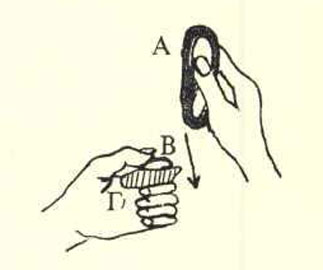 Κρούση με πριόβολο.
Η πειραματική αρχαιολογία κατάφερε να σχηματίσει πλήρη εικόνα του υλικού και της τεχνικής που απαιτούνται για την παραγωγή φωτιάς με μη σύγχρονα μέσα. Περιγράφονται διεξοδικά και οι τρεις χρησιμοποιούμενες μέθοδοι: η κρούση, η τριβή και η συμπίεση. Στην κρούση, χρησιμοποιείται πυριτόλιθος, κοινώς στουρναρόπετρα, το πριόβολο, μεταλλικό αντικείμενο φτιαγμένο από παλιά λίμα, και η ύσκα, μανιτάρι που φυτρώνει στους κορμούς βελανιδιάς ή πλατάνου. Στη μέθοδο της τριβής δύο ξύλινων ράβδων, τα πυρεία των αρχαίων Ελλήνων, χρησιμοποιούνται το τρύπανο και η εσχάρα. Τέλος, ο αεροσυμπιεστικός αναπτήρας βασίζεται στην αρχή της φυσικής, σύμφωνα με την οποία κάθε συμπιεζόμενο αέριο θερμαίνεται.
Κρούση με πριόβολο.
Η πειραματική αρχαιολογία κατάφερε να σχηματίσει πλήρη εικόνα του υλικού και της τεχνικής που απαιτούνται για την παραγωγή φωτιάς με μη σύγχρονα μέσα. Περιγράφονται διεξοδικά και οι τρεις χρησιμοποιούμενες μέθοδοι: η κρούση, η τριβή και η συμπίεση. Στην κρούση, χρησιμοποιείται πυριτόλιθος, κοινώς στουρναρόπετρα, το πριόβολο, μεταλλικό αντικείμενο φτιαγμένο από παλιά λίμα, και η ύσκα, μανιτάρι που φυτρώνει στους κορμούς βελανιδιάς ή πλατάνου. Στη μέθοδο της τριβής δύο ξύλινων ράβδων, τα πυρεία των αρχαίων Ελλήνων, χρησιμοποιούνται το τρύπανο και η εσχάρα. Τέλος, ο αεροσυμπιεστικός αναπτήρας βασίζεται στην αρχή της φυσικής, σύμφωνα με την οποία κάθε συμπιεζόμενο αέριο θερμαίνεται.
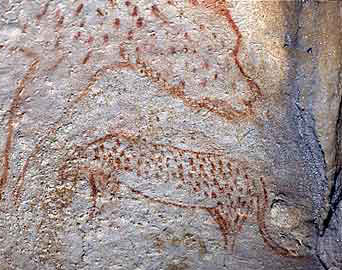 Αιλουροειδή ζωγραφισμένα σε μια αίθουσα της παλαιολιθικής σπηλιάς grotte Chauvet, που βρέθηκε το 1994 (Ardèche, Γαλλία).
«Απόλυτη» ονομάζεται η χρονολόγηση που δεν στηρίζεται σε άλλα συστήματα, στυλιστικά ή περιβαλλοντολογικά, αλλά σε ανεξάρτητες παραμέτρους των αρχαιολογικών ευρημάτων που μετριούνται εργαστηριακά. Ο πρόσφατος εκσυγχρονισμός των τεχνικών χρονολόγησης αναθεώρησε παγιωμένες απόψεις και αποκάλυψε ότι αυτές πήγαζαν από τις επιστημονικές μας προκαταλήψεις. Η γραμμική αντίληψη περί βιολογικής εξέλιξης του ανθρώπου ανατράπηκε, όταν αποδείχθηκε ότι στην Εγγύς Ανατολή ο Neanderthal και ο Homo sapiens sapiens συνυπήρξαν για τουλάχιστον 60.000 χρόνια. Το γεγονός ότι και οι δύο βρίσκονταν στο ίδιο πολιτισμικό επίπεδο διαχωρίζει τη βιολογική από την πολιτισμική εξέλιξη του ανθρώπου. Η τεχνολογία του λίθου στη Μέση Παλαιολιθική καταρρίπτει το μύθο της γραμμικής εξέλιξης από χονδροειδείς σε εκλεπτυσμένες μορφές. Οι αρχαιότερες βραχογραφίες στην Ευρώπη (Grotte Chauvet στη Γαλλία, 32.500 χρόνια πριν) με το νατουραλισμό και τη δεξιοτεχνία τους ανέτρεψαν την αντίληψη περί προοδευτικής εξέλιξης στην καλλιτεχνική έκφραση. Η παλαιολιθική Αρχαιολογία, όπου η χρονολογική ακρίβεια μετριέται σε μερικά λεπτά, μερικές χιλιετίες, μερικές δεκάδες ή εκατοντάδες χιλιάδες χρόνια και ορίζεται αντιστρόφως ανάλογα με τη γεωγραφική κλίμακα, οφείλει να αναπτύξει το δικό της θεωρητικό υπόβαθρο και ενδεχομένως να αναθεωρήσει μια αντίληψη του χρόνου που συνδέεται με τον δυτικό πολιτισμό. Μια διαφορετική οπτική θα επέτρεπε και την καλύτερη γνώση της Μέσης Παλαιολιθικής στην Ελλάδα.
Αιλουροειδή ζωγραφισμένα σε μια αίθουσα της παλαιολιθικής σπηλιάς grotte Chauvet, που βρέθηκε το 1994 (Ardèche, Γαλλία).
«Απόλυτη» ονομάζεται η χρονολόγηση που δεν στηρίζεται σε άλλα συστήματα, στυλιστικά ή περιβαλλοντολογικά, αλλά σε ανεξάρτητες παραμέτρους των αρχαιολογικών ευρημάτων που μετριούνται εργαστηριακά. Ο πρόσφατος εκσυγχρονισμός των τεχνικών χρονολόγησης αναθεώρησε παγιωμένες απόψεις και αποκάλυψε ότι αυτές πήγαζαν από τις επιστημονικές μας προκαταλήψεις. Η γραμμική αντίληψη περί βιολογικής εξέλιξης του ανθρώπου ανατράπηκε, όταν αποδείχθηκε ότι στην Εγγύς Ανατολή ο Neanderthal και ο Homo sapiens sapiens συνυπήρξαν για τουλάχιστον 60.000 χρόνια. Το γεγονός ότι και οι δύο βρίσκονταν στο ίδιο πολιτισμικό επίπεδο διαχωρίζει τη βιολογική από την πολιτισμική εξέλιξη του ανθρώπου. Η τεχνολογία του λίθου στη Μέση Παλαιολιθική καταρρίπτει το μύθο της γραμμικής εξέλιξης από χονδροειδείς σε εκλεπτυσμένες μορφές. Οι αρχαιότερες βραχογραφίες στην Ευρώπη (Grotte Chauvet στη Γαλλία, 32.500 χρόνια πριν) με το νατουραλισμό και τη δεξιοτεχνία τους ανέτρεψαν την αντίληψη περί προοδευτικής εξέλιξης στην καλλιτεχνική έκφραση. Η παλαιολιθική Αρχαιολογία, όπου η χρονολογική ακρίβεια μετριέται σε μερικά λεπτά, μερικές χιλιετίες, μερικές δεκάδες ή εκατοντάδες χιλιάδες χρόνια και ορίζεται αντιστρόφως ανάλογα με τη γεωγραφική κλίμακα, οφείλει να αναπτύξει το δικό της θεωρητικό υπόβαθρο και ενδεχομένως να αναθεωρήσει μια αντίληψη του χρόνου που συνδέεται με τον δυτικό πολιτισμό. Μια διαφορετική οπτική θα επέτρεπε και την καλύτερη γνώση της Μέσης Παλαιολιθικής στην Ελλάδα.
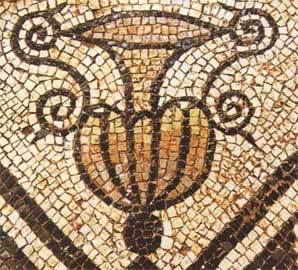 Λεπτομέρεια ψηφιδωτού δαπέδου.
Βορειοανατολικά της κοινότητας Στρογγυλής του νομού Άρτας, στην κορυφή του λόφου Ποδαρούλι, σώζονται τα ερείπια αγρέπαυλης, που αποτελούσε τον πυρήνα μιας αγροικίας με ελαιοτριβεία και βαλανείο. Στους ρωμαϊκούς χρόνους (1ος-3ος αιώνας μ.Χ.) την τοποθετούν τα κινητά ευρήματα: θραύσματα άβαφων αμφορέων, πήλινων ανάγλυφων λύχνων με υπογραφή του κεραμέα, ανάγλυφων σκύφων, αποτμήματα αρχιτεκτονικών μελών και λίγα νομίσματα. Η σύγκριση των ψηφιδωτών της δαπέδων με εκείνα της έπαυλης του Μάνιου Αντωνίνου στη γειτονική Νικόπολη και της «Οικίας των Ψηφιδωτών» στην Κόρινθο, τα χρονολογεί στα τέλη του 2ου με αρχές του 3ου αιώνα. Τα ψηφιδωτά δάπεδα έχουν γεωμετρικό και σχηματοποιημένο διάκοσμο από πλοχμούς, ρόδακες, κισσόφυλλα και αγγεία. Οι ψηφίδες έχουν χρώμα λευκό, μελανό ή σκουροπράσινο, ιώδες, κίτρινο ή ροδαλό. Στο κτήριο, που ανήκει στον τύπο της έπαυλης με διάδρομο ή στοά, διαπιστώθηκαν δύο οικοδομικές φάσεις. Κατά τη δεύτερη, καταργήθηκε ο δεύτερος όροφος και προστέθηκαν νέα δωμάτια στο ισόγειο. Η αγρέπαυλη αποτελείται από μια κύρια πτέρυγα και μια δεύτερη «βοηθητικών χώρων» που διαφοροποιούνται και από την τοιχοδομία τους. Στη δεύτερη οι τοιχοποιίες είναι από απλή ξερολιθιά, ενώ στην κύρια πτέρυγα είναι χτισμένες κατά το σύστημα opus incertum και επιχρισμένες με κονίαμα, εκτός από έναν τοίχο που φέρει επένδυση με οπτόπλινθους κατά το σύστημα opus testaceum.
Λεπτομέρεια ψηφιδωτού δαπέδου.
Βορειοανατολικά της κοινότητας Στρογγυλής του νομού Άρτας, στην κορυφή του λόφου Ποδαρούλι, σώζονται τα ερείπια αγρέπαυλης, που αποτελούσε τον πυρήνα μιας αγροικίας με ελαιοτριβεία και βαλανείο. Στους ρωμαϊκούς χρόνους (1ος-3ος αιώνας μ.Χ.) την τοποθετούν τα κινητά ευρήματα: θραύσματα άβαφων αμφορέων, πήλινων ανάγλυφων λύχνων με υπογραφή του κεραμέα, ανάγλυφων σκύφων, αποτμήματα αρχιτεκτονικών μελών και λίγα νομίσματα. Η σύγκριση των ψηφιδωτών της δαπέδων με εκείνα της έπαυλης του Μάνιου Αντωνίνου στη γειτονική Νικόπολη και της «Οικίας των Ψηφιδωτών» στην Κόρινθο, τα χρονολογεί στα τέλη του 2ου με αρχές του 3ου αιώνα. Τα ψηφιδωτά δάπεδα έχουν γεωμετρικό και σχηματοποιημένο διάκοσμο από πλοχμούς, ρόδακες, κισσόφυλλα και αγγεία. Οι ψηφίδες έχουν χρώμα λευκό, μελανό ή σκουροπράσινο, ιώδες, κίτρινο ή ροδαλό. Στο κτήριο, που ανήκει στον τύπο της έπαυλης με διάδρομο ή στοά, διαπιστώθηκαν δύο οικοδομικές φάσεις. Κατά τη δεύτερη, καταργήθηκε ο δεύτερος όροφος και προστέθηκαν νέα δωμάτια στο ισόγειο. Η αγρέπαυλη αποτελείται από μια κύρια πτέρυγα και μια δεύτερη «βοηθητικών χώρων» που διαφοροποιούνται και από την τοιχοδομία τους. Στη δεύτερη οι τοιχοποιίες είναι από απλή ξερολιθιά, ενώ στην κύρια πτέρυγα είναι χτισμένες κατά το σύστημα opus incertum και επιχρισμένες με κονίαμα, εκτός από έναν τοίχο που φέρει επένδυση με οπτόπλινθους κατά το σύστημα opus testaceum.
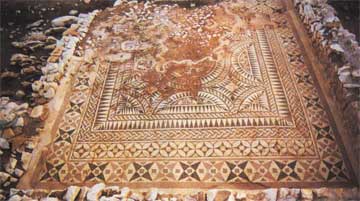 Το ψηφιδωτό δάπεδο μετά τις εργασίες συντήρησης.
Περιγράφεται διεξοδικά η συντήρηση του ψηφιδωτού σε ένα από τα δωμάτια της αγρέπαυλης που βρέθηκε κοντά στο χωριό Στρογγυλή του νομού Άρτας. Το ψηφιδωτό δάπεδο, 4,5x5 μ., ανήκει στην κατηγορία opus tesselatum και χρονολογείται στα τέλη του 2ου με τις αρχές του 3ου αιώνα μ.Χ. Η τεχνική κατασκευής του εναρμονίζεται πλήρως με τα ρωμαϊκά ψηφιδωτά της ευρύτερης περιοχής (Νικόπολη). Η στρωματογραφία του διαφέρει από εκείνη που παραδίδουν ο Βιτρούβιος και ο Πλίνιος: η μεν λιθοδομή υπάρχει, αλλά τα τρία άλλα υποστρώματα υποδομής έχουν αντικατασταθεί από ένα χονδρόκοκκο υπόστρωμα. Ο γεωμετρικός διάκοσμος περιλαμβάνει απλούς και τριταιονικούς πλοχμούς, κισσόφυλλα, οξυκόρυφα τρίγωνα, ακιδωτά άστρα, εφαπτόμενους κύκλους και ρόμβους. Αν και αυτά τα διακοσμητικά στοιχεία είναι πολύ διαδεδομένα, άλλο δάπεδο με παρόμοια σύνθεση δεν υπάρχει. Τα χρώματα των ψηφίδων είναι το λευκό, το πράσινο σε δύο αποχρώσεις, το ροζ σε δύο αποχρώσεις, το κίτρινο, ένα γκρι-μωβ δύο αποχρώσεων και το γκρι ανοιχτό. Τμήμα του ψηφιδωτού έχει υποστεί ανεπανόρθωτη φθορά, ενώ κάποια τμήματα από το εναπομείναν είναι σε σχετικά καλή κατάσταση. Σημαντική φθορά προκάλεσαν ρίζες συχνά αγκιστρωμένες στους αρμούς των ψηφίδων. Ο αρθρογράφος περιγράφει τα στάδια της δίμηνης in situ συντήρησης και εισηγείται την αποκόλληση τμημάτων του δαπέδου, όπου πρέπει να κατασκευαστεί η υποδομή και το υπόστρωμα, και τη συντήρηση των τμημάτων του ψηφιδωτού στο εργαστήριο. Απώτερος στόχος είναι η επανατοποθέτησή τους στον ίδιο χώρο κάτω από προστατευτικό στέγαστρο.
Το ψηφιδωτό δάπεδο μετά τις εργασίες συντήρησης.
Περιγράφεται διεξοδικά η συντήρηση του ψηφιδωτού σε ένα από τα δωμάτια της αγρέπαυλης που βρέθηκε κοντά στο χωριό Στρογγυλή του νομού Άρτας. Το ψηφιδωτό δάπεδο, 4,5x5 μ., ανήκει στην κατηγορία opus tesselatum και χρονολογείται στα τέλη του 2ου με τις αρχές του 3ου αιώνα μ.Χ. Η τεχνική κατασκευής του εναρμονίζεται πλήρως με τα ρωμαϊκά ψηφιδωτά της ευρύτερης περιοχής (Νικόπολη). Η στρωματογραφία του διαφέρει από εκείνη που παραδίδουν ο Βιτρούβιος και ο Πλίνιος: η μεν λιθοδομή υπάρχει, αλλά τα τρία άλλα υποστρώματα υποδομής έχουν αντικατασταθεί από ένα χονδρόκοκκο υπόστρωμα. Ο γεωμετρικός διάκοσμος περιλαμβάνει απλούς και τριταιονικούς πλοχμούς, κισσόφυλλα, οξυκόρυφα τρίγωνα, ακιδωτά άστρα, εφαπτόμενους κύκλους και ρόμβους. Αν και αυτά τα διακοσμητικά στοιχεία είναι πολύ διαδεδομένα, άλλο δάπεδο με παρόμοια σύνθεση δεν υπάρχει. Τα χρώματα των ψηφίδων είναι το λευκό, το πράσινο σε δύο αποχρώσεις, το ροζ σε δύο αποχρώσεις, το κίτρινο, ένα γκρι-μωβ δύο αποχρώσεων και το γκρι ανοιχτό. Τμήμα του ψηφιδωτού έχει υποστεί ανεπανόρθωτη φθορά, ενώ κάποια τμήματα από το εναπομείναν είναι σε σχετικά καλή κατάσταση. Σημαντική φθορά προκάλεσαν ρίζες συχνά αγκιστρωμένες στους αρμούς των ψηφίδων. Ο αρθρογράφος περιγράφει τα στάδια της δίμηνης in situ συντήρησης και εισηγείται την αποκόλληση τμημάτων του δαπέδου, όπου πρέπει να κατασκευαστεί η υποδομή και το υπόστρωμα, και τη συντήρηση των τμημάτων του ψηφιδωτού στο εργαστήριο. Απώτερος στόχος είναι η επανατοποθέτησή τους στον ίδιο χώρο κάτω από προστατευτικό στέγαστρο.
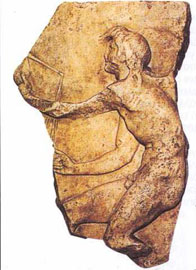 Ανάγλυφο του Καιρού που δείχνει πως πιάνεται μια ευκαιρία.
Πρωτοπόρος θεωρητικός της πολεμικής τέχνης, ο Αινείας ο Τακτικός, τον 4ο αιώνα π.Χ. στα Πολιορκητικά του, παραθέτει τρία επεισόδια που χρησιμεύουν στη συγγραφέα ως παραδείγματα. Σκοπός της είναι να καταδείξει ότι βασικό όπλο του πολέμου θεωρείται ο δόλος και ότι στην κλασική Ελλάδα γινόταν ευρεία χρήση της intoxication. Ο γαλλικός όρος intoxication δηλώνει τις μεθοδεύσεις που διαστρεβλώνουν την πραγματικότητα προκαλώντας ψευδαισθήσεις και απατηλές εντυπώσεις, με σκοπό να αποπροσανατολίσουν τον αντίπαλο. Τεχνικός όρος μετά τον Β΄ Παγκόσμιο πόλεμο, συνδέεται με τον ψυχολογικό πόλεμο και τον πόλεμο μεταξύ μυστικών υπηρεσιών. Προϋποθέτει «εμπνευστές», «πράκτορες» που συνεργάζονται μαζί τους και «θύματα», που τη σκέψη τους αποσκοπεί να «δηλητηριάσει». Στηρίζεται στο δόλο και επιλέγεται αντί της βίας. Ο Αινείας ο Τακτικός αποδεικνύει ότι, ήδη από την εποχή του, η intoxication είχε περάσει από την εμπειρική χρήση στη θεωρία της στρατηγικής. Στο πρώτο επεισόδιο, οι ολιγαρχικοί Κερκυραίοι το 361 π.Χ. χρησιμοποιώντας προσποίηση απαλλάσσονται από τους δημοκρατικούς τους αντιπάλους. Στο δεύτερο, οι πολιορκημένοι κάτοικοι μιας πόλης καταφέρνουν να εφησυχάσουν τον εχθρό πριν του επιτεθούν διασπείροντας ψευδείς πληροφορίες. Τέλος, σε κάποια πόλη οι άρχοντες, για να εξορίσουν τους πολιτικούς τους αντιπάλους, σκηνοθετούν επιδρομές εχθρών.
Ανάγλυφο του Καιρού που δείχνει πως πιάνεται μια ευκαιρία.
Πρωτοπόρος θεωρητικός της πολεμικής τέχνης, ο Αινείας ο Τακτικός, τον 4ο αιώνα π.Χ. στα Πολιορκητικά του, παραθέτει τρία επεισόδια που χρησιμεύουν στη συγγραφέα ως παραδείγματα. Σκοπός της είναι να καταδείξει ότι βασικό όπλο του πολέμου θεωρείται ο δόλος και ότι στην κλασική Ελλάδα γινόταν ευρεία χρήση της intoxication. Ο γαλλικός όρος intoxication δηλώνει τις μεθοδεύσεις που διαστρεβλώνουν την πραγματικότητα προκαλώντας ψευδαισθήσεις και απατηλές εντυπώσεις, με σκοπό να αποπροσανατολίσουν τον αντίπαλο. Τεχνικός όρος μετά τον Β΄ Παγκόσμιο πόλεμο, συνδέεται με τον ψυχολογικό πόλεμο και τον πόλεμο μεταξύ μυστικών υπηρεσιών. Προϋποθέτει «εμπνευστές», «πράκτορες» που συνεργάζονται μαζί τους και «θύματα», που τη σκέψη τους αποσκοπεί να «δηλητηριάσει». Στηρίζεται στο δόλο και επιλέγεται αντί της βίας. Ο Αινείας ο Τακτικός αποδεικνύει ότι, ήδη από την εποχή του, η intoxication είχε περάσει από την εμπειρική χρήση στη θεωρία της στρατηγικής. Στο πρώτο επεισόδιο, οι ολιγαρχικοί Κερκυραίοι το 361 π.Χ. χρησιμοποιώντας προσποίηση απαλλάσσονται από τους δημοκρατικούς τους αντιπάλους. Στο δεύτερο, οι πολιορκημένοι κάτοικοι μιας πόλης καταφέρνουν να εφησυχάσουν τον εχθρό πριν του επιτεθούν διασπείροντας ψευδείς πληροφορίες. Τέλος, σε κάποια πόλη οι άρχοντες, για να εξορίσουν τους πολιτικούς τους αντιπάλους, σκηνοθετούν επιδρομές εχθρών.
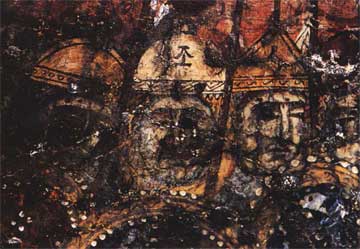 Λεπτομέρεια προσώπων των στρατιωτών της σκηνής του Λίθου.
Οι τοιχογραφίες του ναού του Αγίου Ιωάννου του Χρυσοστόμου στο Γεράκι της Λακωνίας χρονολογούνται στα τέλη του 13ου ή στις αρχές του 14ου αιώνα. Στο όγδοο διάχωρο του ημικυλινδρικού θόλου απεικονίζεται η σκηνή του «Λίθου». Στη θέση των Ρωμαίων στρατιωτών, εμφανίζονται στρατιώτες με χαρακτηριστικά Μογγόλων ή Τατάρων και με κράνη που φέρουν ιδεογράμματα. Η έρευνα κατέδειξε πως πρόκειται για το κινεζικό γράμμα hi (χι), που σημαίνει «μέγας, υποβλητικός». Δεδομένου ότι οι στρατοί στα βυζαντινά χρόνια δεν είχαν ενιαία αμφίεση αλλά χρησιμοποιούσαν συχνά τα λάφυρα που έπαιρναν από τους αντιπάλους τους, το κινεζικό ιδεόγραμμα δεν δηλώνει και ότι οι στρατιώτες είναι Κινέζοι. Διατυπώνεται η άποψη ότι όπως οι λαϊκοί ζωγράφοι στα χρόνια της Τουρκοκρατίας απεικονίζουν στις παραστάσεις της Σταύρωσης Τουρκαλβανούς, αντί για Ρωμαίους στρατιώτες, επειδή αυτούς έχουν γνωρίσει και από αυτούς έχουν υποφέρει, κάτι ανάλογο πρέπει να συμβαίνει και με το ζωγράφο του Γερακίου. Το ερώτημα τώρα είναι: πώς απέκτησε ο ζωγράφος τις «προσλαμβάνουσες παραστάσεις» του; Ο αρθρογράφος επιδίδεται σε μια ιστορική περιπλάνηση στους τρικυμισμένους τελευταίους αιώνες του Βυζαντίου, παρακολουθώντας την αυτοκρατορία των Μογγόλων και την εμφάνιση των Τατάρων. Το συμπέρασμά του είναι πως ο αγιογράφος είχε γνωρίσει τις ταταρικές επιδρομές που έγιναν στη Θράκη, ιδιαίτερα από την Αδριανούπολη μέχρι την Αίνο, κατά τα τέλη του 13ου και τις αρχές του 14ου αιώνα.
Λεπτομέρεια προσώπων των στρατιωτών της σκηνής του Λίθου.
Οι τοιχογραφίες του ναού του Αγίου Ιωάννου του Χρυσοστόμου στο Γεράκι της Λακωνίας χρονολογούνται στα τέλη του 13ου ή στις αρχές του 14ου αιώνα. Στο όγδοο διάχωρο του ημικυλινδρικού θόλου απεικονίζεται η σκηνή του «Λίθου». Στη θέση των Ρωμαίων στρατιωτών, εμφανίζονται στρατιώτες με χαρακτηριστικά Μογγόλων ή Τατάρων και με κράνη που φέρουν ιδεογράμματα. Η έρευνα κατέδειξε πως πρόκειται για το κινεζικό γράμμα hi (χι), που σημαίνει «μέγας, υποβλητικός». Δεδομένου ότι οι στρατοί στα βυζαντινά χρόνια δεν είχαν ενιαία αμφίεση αλλά χρησιμοποιούσαν συχνά τα λάφυρα που έπαιρναν από τους αντιπάλους τους, το κινεζικό ιδεόγραμμα δεν δηλώνει και ότι οι στρατιώτες είναι Κινέζοι. Διατυπώνεται η άποψη ότι όπως οι λαϊκοί ζωγράφοι στα χρόνια της Τουρκοκρατίας απεικονίζουν στις παραστάσεις της Σταύρωσης Τουρκαλβανούς, αντί για Ρωμαίους στρατιώτες, επειδή αυτούς έχουν γνωρίσει και από αυτούς έχουν υποφέρει, κάτι ανάλογο πρέπει να συμβαίνει και με το ζωγράφο του Γερακίου. Το ερώτημα τώρα είναι: πώς απέκτησε ο ζωγράφος τις «προσλαμβάνουσες παραστάσεις» του; Ο αρθρογράφος επιδίδεται σε μια ιστορική περιπλάνηση στους τρικυμισμένους τελευταίους αιώνες του Βυζαντίου, παρακολουθώντας την αυτοκρατορία των Μογγόλων και την εμφάνιση των Τατάρων. Το συμπέρασμά του είναι πως ο αγιογράφος είχε γνωρίσει τις ταταρικές επιδρομές που έγιναν στη Θράκη, ιδιαίτερα από την Αδριανούπολη μέχρι την Αίνο, κατά τα τέλη του 13ου και τις αρχές του 14ου αιώνα.
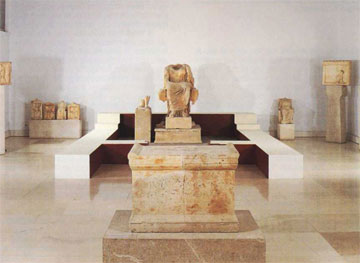 Η αίθουσα της Κυβέλης.
Τα εκθέματα του Μουσείου, κατά κύριο λόγο γλυπτά και κεραμική, αντιπροσωπευτικά της ιστορίας αλλά και του πληθυσμού της πόλης, προέρχονται από τον Πειραιά και τα νησιά του Αργοσαρωνικού. Μοναδικής σημασίας είναι τα ειδώλια του μινωικού ιερού κορυφής των Κυθήρων και του μυκηναϊκού ιερού των Μεθάνων, το έμβολο μιας τριήρους και το αγορανομικό ανάγλυφο της Σαλαμίνας, τα μουσικά όργανα από τον τάφο του ποιητή της Δάφνης, ο μοναδικός στον κόσμο αρχαϊκός κούρος-Απόλλων και το ταφικό μνημείο της Καλλιθέας
Η αίθουσα της Κυβέλης.
Τα εκθέματα του Μουσείου, κατά κύριο λόγο γλυπτά και κεραμική, αντιπροσωπευτικά της ιστορίας αλλά και του πληθυσμού της πόλης, προέρχονται από τον Πειραιά και τα νησιά του Αργοσαρωνικού. Μοναδικής σημασίας είναι τα ειδώλια του μινωικού ιερού κορυφής των Κυθήρων και του μυκηναϊκού ιερού των Μεθάνων, το έμβολο μιας τριήρους και το αγορανομικό ανάγλυφο της Σαλαμίνας, τα μουσικά όργανα από τον τάφο του ποιητή της Δάφνης, ο μοναδικός στον κόσμο αρχαϊκός κούρος-Απόλλων και το ταφικό μνημείο της Καλλιθέας
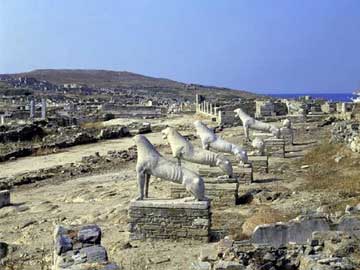 Οι λέοντες της Δήλου.
Η παράθεση είναι ενδεικτική. Για το πλήρες κείμενο της στήλης, δείτε το συνημμένο αρχείο pdf.
Οι λέοντες της Δήλου.
Η παράθεση είναι ενδεικτική. Για το πλήρες κείμενο της στήλης, δείτε το συνημμένο αρχείο pdf.
Ειδήσεις
Κάτω από την Αγία Μαρίνα στο Θησείο ξεπροβάλλει τεράστιος ναός του Δία του 5ου αιώνα π.Χ. - Στο πλαίσιο του διετούς αφιερώματος στον «Αγώνα κατά της παράνομης διακίνησης της πολιτισμικής κληρονομιάς» κατά τον εορτασμό της Διεθνούς Ημέρας των Μουσείων, το Ελληνικό Τμήμα του ICOM θα προβάλει φέτος τις περιπέτειες των κυπριακών θησαυρών - Αρχαίο ναυάγιο νότια από το Ηράκλειο εντόπισε η Εφορεία Ενάλιων Αρχαιοτήτων.Συνέδρια
Υπό την αιγίδα της εν Αθήναις Αρχαιολογικής Εταιρείας διοργανώθηκε Διεθνές Συμπόσιο για τις τοιχογραφίες της Θήρας - Σε Διεθνές Συνέδριο στα Τρίκαλα θα παρουσιαστεί για πρώτη φορά η δωδεκάχρονη ανασκαφική έρευνα στο σπήλαιο της Θεόπετρας - Έγινε το Β΄ Αρχαιολογικό Συμπόσιο του Τομέα Αρχαιολογίας και Ιστορίας της Τέχνης της Φιλοσοφικής Σχολής του Καποδιστριακού με τη συμμετοχή καθηγητών και φοιτητώνΕκθέσεις
Στο Κρατικό Μουσείο Καλών Τεχνών Πούσκιν της Μόσχας θα εκτεθούν κοσμήματα και αντικείμενα μικρογλυπτικής του Ηλία Λαλαούνη - Την οικουμενικότητα της αρχαίας Αλεξάνδρειας ζωντάνεψε με αρχαία εκθέματα, ταινίες και σύγχρονες φωτογραφίες η έκθεση στο παρισινό Petit Palais - Έλληνες εικαστικοί που εμπνεύστηκαν από το μύθο της Λήδας και του κύκνου εξέθεσαν τα έργα τους στην αίθουσα Υάκινθος.Βιβλία
Alain Schnapp (επιμ.), Préhistoire et Antiquité, Flammarion, Paris 1997 - Σ. Γερουλάνος και René Brider, Τραύμα, ΜΙΕΤ, Αθήνα 1998 - Η Ελλάδα του Μουσείου Μπενάκη, Μ. Μπενάκη, Αθήνα 1997 – Πέτρος Γ. Θέμελης, Γιάννης Π. Τουράτσογλου, Οι τάφοι του Δερβενίου, Αθήνα 1997 - Peter Brown, Ο κόσμος της ύστερης αρχαιότητας, 150-750 μ.Χ., Αλεξάνδρεια, Αθήνα 1998 - Γεώργιος Τσότσος, Μακεδονικά γεφύρια, University Studio Press, Θεσσαλονίκη 1997.
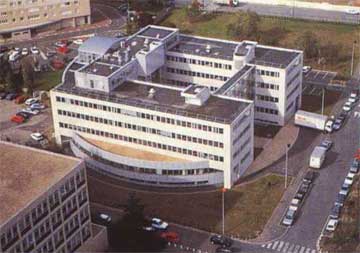 Το Ερευνητικό Κέντρο Maison d'Archéologie et d'Ethnologie στο Πανεπιστήμιο της Nanterre.
Πρόκειται για το πρώτο από τα δύο μέρη ενός αφιερώματος στις εφαρμογές της Πληροφορικής στην Αρχαιολογία σε πανεπιστημιακό μεταπτυχιακό επίπεδο. Τα Τμήματα Σπουδών κατατάσσονται σε δύο κατηγορίες: α) εκπαίδευση στο πλαίσιο ερευνητικής δραστηριότητας, που παρουσιάζεται στο παρόν τεύχος, και β) παρουσίαση συγκεκριμένων προγραμμάτων σπουδών. Το γαλλικό ερευνητικό κέντρο Archéologie et Systèmes d‘Information (CNRS, Université Paris I, Université Paris X) επικεντρώνει στα συστήματα αρχειοθέτησης, τεκμηρίωσης και στις εφαρμογές πολυμέσων που σχετίζονται με την Αρχαιολογία. Στο Ηνωμένο Βασίλειο, το Computing Archaeology Research Group (Staffordshire University) ειδικεύεται στη χρήση προτύπων για την αρχαιολογική ηλεκτρονική επικοινωνία, σε συστήματα γεωγραφικής και γεωφυσικής πληροφόρησης και στη γραφιστική απεικόνιση των δεδομένων.
Το Ερευνητικό Κέντρο Maison d'Archéologie et d'Ethnologie στο Πανεπιστήμιο της Nanterre.
Πρόκειται για το πρώτο από τα δύο μέρη ενός αφιερώματος στις εφαρμογές της Πληροφορικής στην Αρχαιολογία σε πανεπιστημιακό μεταπτυχιακό επίπεδο. Τα Τμήματα Σπουδών κατατάσσονται σε δύο κατηγορίες: α) εκπαίδευση στο πλαίσιο ερευνητικής δραστηριότητας, που παρουσιάζεται στο παρόν τεύχος, και β) παρουσίαση συγκεκριμένων προγραμμάτων σπουδών. Το γαλλικό ερευνητικό κέντρο Archéologie et Systèmes d‘Information (CNRS, Université Paris I, Université Paris X) επικεντρώνει στα συστήματα αρχειοθέτησης, τεκμηρίωσης και στις εφαρμογές πολυμέσων που σχετίζονται με την Αρχαιολογία. Στο Ηνωμένο Βασίλειο, το Computing Archaeology Research Group (Staffordshire University) ειδικεύεται στη χρήση προτύπων για την αρχαιολογική ηλεκτρονική επικοινωνία, σε συστήματα γεωγραφικής και γεωφυσικής πληροφόρησης και στη γραφιστική απεικόνιση των δεδομένων.
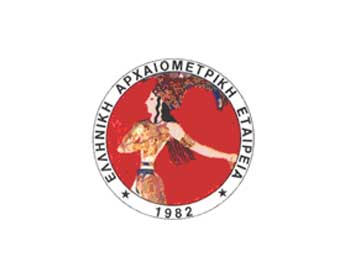 Το λογότυπο της Ελληνικής Αρχαιομετρικής Εταιρείας
Η παράθεση είναι ενδεικτική. Για το πλήρες κείμενο της στήλης, δείτε το συνημμένο αρχείο pdf.
Το λογότυπο της Ελληνικής Αρχαιομετρικής Εταιρείας
Η παράθεση είναι ενδεικτική. Για το πλήρες κείμενο της στήλης, δείτε το συνημμένο αρχείο pdf.
Συνέδρια
«Παλαιοανθρωπολογία της Χερσονήσου της Μάνης» ήταν το θέμα Διεθνούς Συμποσίου που έγινε στην Αθήνα και την Αρεόπολη - Τα πορίσματα για το προϊστορικό ναυάγιο του ακρωτηρίου των Ιρίων στον Αργολικό αξιολογήθηκαν σε διεπιστημονική Διεθνή Συνάντηση στις Σπέτσες - Στην Αθήνα συνδιοργανώνεται Διεθνές συνέδριο για τη Ζωοαρχαιολογία στην Ελλάδα - Το Εργαστήριο Αρχαιομετρίας του «Δημόκριτου» διοργανώνει την 5η Ευρωπαϊκή Συνάντηση για τα αρχαία κεραμικά (EMAC 99) - Διεπιστημονική ημερίδα στην Κύπρο με θέμα: «Δομικός λίθος».Δημοσιεύσεις
R.E. Taylor and M.J. Aitken (επιμ.), Chronometric Dating in Archaeology (Advances in Archaeological and Museum Science), τόμ. 2, 1997 - Κ. Κοντογιάννης, «Οι λίθοι στα κείμενα των Ελλήνων αλχημιστών», Ορυκτός Πλούτος 106 (1998), σ. 39-52 - G. Tsokas, A. Sarris, P. Tsourlos, C. Papazachos and A. Giannopoulos, «A large scale magnetic syrvey in Makrygialos (Pieria), Greece», Archaeological Prospection, 4 (1997), σ. 123-137.When a floor mosaic was discovered in a specific room of the Roman villa at Strogyli, during the excavational works there, it was decided that the mosaic should be left covered for its protection by a layer of earth which was to be removed in the following year, when the works would be resumed. However, the course of conservation had a slow pace, due to the difficulties the floor mosaic presented. The removal of the earth layer revealed a multitude of large and small roots coming through the mosaic, a considerable number of loose or missing tesserae, cracks and sunk sections of the mosaic layer, small and extended damages as well deteriorated parts of the mosaic surface. The mosaic belongs to the so-called opus tesseratum group, while each side of its tesserae measures 1 cm. Its decoration consists of geometric patterns (bands with alternating colours and decorative motifs). We would like to thank Ms A. Douzogli,at that time Ephor of the IB' Ephorate of Prehistoric and Classical Antiquities, for her support and understanding of the difficulties we faced, as well as the inhabitants of the Strogyli municipality and its mayor, Mr Thomas Botsaris, for the complete support and the hospitality they offered us.
Many scholars have dealt with the issue of the origin of the vaulted tomb, and the question whether it derives from Crete or mainland Greece is often involved in the general theoretical problem of the extent and nature of propagation of the Minoan civilization in the Aegean of the Middle and Late Bronze Age. The question of the origin of the Mycenaean vaulted tomb had indispensably been related with the more general issue of the "Minoization" of the Aegean, an issue which had become an open dispute in the bosom of the archaeological society during the years of "heroic" Archaeology. The Mycenaean vaulted tomb as a burial type prevailed mainly in mainland Greece. However, its construction presupposes an architectural dexterity which cannot be found there in the Meso-Helladic period, while it is highly possible that certain tombs in Messara on Crete —belonging to the Messara type-were roofed with a stone vault.
Podarouli hill stands at the foot of mount Mavrovouni , not far from the Rodia and Tsoukalou lagoons of the Amvrakikos Bay. On the hill and in the lower adjacent area there are scattered ancient remnants dating from various periods, mainly from the Roman era, these are the remains of the extensive complex of a country-house. The finding of sections of disintegrated floor mosaics in the country-house, at the northern part of the complex in 1992, led to urgent conservation of the mosaics by a group of specialists. According to excavational data, the country-house belonged to a rich land-owner, whose activities were protected by the authorities of the neighbouring city of Nicopolis, which was founded by the first Roman Emperor Octavian Augustus to commemorate his glorious victory in the naval battle of Actium in 31 BC. The completion of excavations at the country-house, the necessary conservation works and their protection by shelters are of great importance for the proper promotion of this archaeological site that is unique to North-western Greece.
In May 18, 1972, the archaeologist Euthymios Mastrokostas discovered the statues of a kouros and a kore in a trench, only 40 cm. deep, in the necropolis of Myrrinous, the present Merenta, about 30 km. southeast of Athens. The kore and kouros had been carefully placed so as to face one other. According to the conclusions of the excavator, the dating of the ceramic finds, which accompany the statues, leads to the propable assumption that the works were buried before the Persian invasion, around 490/480 BC, so as to prevent their destruction by the enemy. Scientific research relates Phrasikleia to the Kore from Keratea, the so-called "Berlin goddess", which on the basis of her garb, head decoration and body outline dates from 570 to 560 BC approximately. The preserved traces of colour on several statues of korai from the Acropolis of Athens allow us to ascertain the major importance of the colouring of the garments — in decorative bands and various designs - to perfect the statues' appearance. The complete image and the splendour of the original polychromy of the garments can be observed in the statue of Phrasikleia in the best possible way. As a matter of fact the perfectly preserved incised decoration of her chiton allows an almost perfect reconstruction of its entire decoration. Since no detailed photograph of the ornaments of the chiton or of the back view of the kore have been published as yet, four drawings which facilitate the understanding of their lay-out are presented here for the first time.
The patriarchal concept sentenced the overwhelming majority of women of ancient Greece to silence and obscurity, as becomes apparent from Pericles' Epitaphios, which was delivered by the Athenian leader in honour of those who fell in battle during the first year of the Peloponnesian War. This conspiracy of silence, which almost obliterated Greek women from the proscenium of History, is brought up in an impressive way in those myths, which have created some of the most sensational female figures known to humanity. However, before one deals with the women of mythology, or rather with aspects of women recorded in myth, the term in itself should be elucidated. Myth, which in antiquity served as the almost exclusive source of inspiration for poetry and representational arts, is nothing more than a system of communication, a complex and intricate "language", which treasures and transmits information and in no way remains unaltered or unconcerned by historical evolution.As a matter of fact, in the Greeks' case , who were not bound by dogma, holy books or canons as regards their dedication to a certain notion, myth was continuously changing in time and place. Through the study of heroines-models who convey the notion of woman in Greek myth, as they occur in the texts and artistic representation, one can reach certain general conclusions, which, although seemingly unexpected, are confirmed by all testimonies. The archetypes, around which the characters of the mythical heroines are woven -as if on canvas- and which are more or less personified by them, are those of love, sacrifice, strength and knowledge.
The ritual of sacred marriage was the focal point of worship of many cults of the ancient world and continued to be performed down to the end of antiquity, while some of its elements managed to overcome even the strict ideological barrier of the monotheistic religions of Christianity and Islam— and to survive to our day in the form of popular drama. Sacred Marriage can on occasion present itself in the cult of male deities, as in the case of festivities honouring Dionysos in Attica. However, as a rule,it is integral to the cult of the Great Goddess of Nature, who, although appearing under various names and in many circumstances, remains the Lady of Life and Death to her worshippers. The Great Goddess has many faces, many epithets, many images. However, she is essentially Aphrodite and Persephone in one, the be-all and end-all of creation, the endless power situated at the center of the cosmic spere bringing the universe together. In her hands love meets death and death becomes the starting point of new life.
Fire plays an important role in the history of mankind. There are not a few who think that man distinguished himself from the animals the moment that he put fire at his service. In order to achieve this objective, man invented various methods and used multiple techniques. Regardless of the purpose for which a fire is lit (ritual, domestic or magic), the methods applied are three, those of percussion, friction and compression. There are variants of the first two methods, depending on the geographical area of the planet in which they occur. Muscular strength or techniques in application are adjusted to the basic methods. Apart from the interest taken by international bibliography in the religious and social character of fire, we succeded, through Experimental Archaeology (University of Montpellier), to have a complete picture of the technique and matter required for lighting a fire with means of the past.
Since the middle of the century, when the term "psychological war" first appeared, scholars have sought its origin in the most remote periods of time. "Psychological action" in general is expressed in many forms such as those of treason, discouragement, intimidation, "intoxication". Psychological war is unbreakably connected with the deception of the opponent. Homer and the Bible precede von Canaris, Ewen Montagu and his group. Metis was Zeus' first wife, Athena his first child and Kairos his second one. If Sun-Tzu is the oldest known theoretician of the art of war, and in particular of a war based on the deception of the enemy, Aeneias Tacticus can be considered as one of the first ancient Greek theoreticians on the subject, who also believed in the effectiveness of indirect strategy. The aim of this article is, through three episodes given as examples, not only to prove that a wide use of "intoxication" was made in ancient Greece, but also to establish the transition from action to theory, since Aeneias consciously believes in war being mainly a confrontation that uses fraud as its main weapon. The term "intoxication" denotes a series of actions aiming at the creation of false impressions and distortion of objective reality; this procedure causes disorientation and illusion, so that a political or military goal is achieved.
Years ago, while studying the Byzantine wall-paintings of Hagios loannis Chrysostomos at Geraki in Laconia, we found certain symbols or Sinic ideograms on the helmets of the soldiers guarding Christ's sepulchre, in the scene of the Guardians at the Tomb, which is depicted in the eighth panel of the church's barrel vault. Therefore, the question arises, where the unknown Byzantine painter might have taken this interesting iconographic feature from. We could assume that a certain Tatarian unit might had participated in the military force with which Umur attacked the Byzantine territories between Monemvasia and Mystras. Therefore, if we date these wall-paintings as belonging to a slightly earlier period, then we can propose that the native or visiting artist of these frescos had got acquainted with Tatarian soldiers in 1335. However, it is more plausible that the hagiographer was familiar with the Tatarian invaders who raided Thrace, from Adrianople to Ainos, during the late thirteenth and early fourteenth century.
Doctrines concerning the female deities of the Greek Pantheon are necessarily connected with the social change that took place in the historic times leading to social differentiation of females. Such doctrines are a giveaway about social beliefs and conventions binding females of the city-state, beliefs established by the then prevalent notions about wives. Characteristic features of the wide-spread cult of the goddess Hera, quite distinct in rituals of the "sacred marriage", suggest that the goddess, who later became the protector of legal, institutional marriage, originally represented the "virgins"; these were the maidens who were just entering puberty,the stage of sexual maturity, and were being collectively prepared for experienced married life. Characteristic initiation rituals for virgins, which testify to the close relation of initiation and marriage, can be traced to the primeval festivals of Tonaeoi on Samos, of Daedaloi at Plataeae and Heraeoi at Olympia.
It is not easy to define or directly reveal the relationship between a deity and the art of weaving as may be the case with other human deeds. It is analyzed in many circles, technical and symbolic ones. Weaving was never absolutely and exclusively connected with a deity or ritual. But it is connected with rituals and feasts of different deities, bringing down to us various notions and symbolisms. The elements from the cycle of weaving that appear in a cult are characterized by coherence and consistency as regards a specific deity and they are always related to other activities and qualities of the deity; however,where weaving itself is concerned, that is the series of activities aiming at making textiles, these elements are splinted off. Techniques and activities of the weaving procedure are protected by or related to different deities and belong to various kinds of worship. Therefore, it might be useful to deal briefly with the cycle of weaving activities.
In Greek thought the cultivation of cereals is a notion connected with civilized life. Not only were offerings of crops included among the rituals of the cult of Demeter but also rituals for the dead, which, however, belonged to the realm of authority of her daughter Persephone, otherwise known as Kore . The ear of wheat, the torch and the pig were attributes of both deities, who were usually represented together. In this article we will not deal with the interpretations and the semantics of the rituals and the variations of the myth concerning the two goddesses. But we will present certain relevant views which have been overlooked until now; on one hand the idea that in antiquity women were not engaged with agriculture, and on the other the notion that they were excluded from political life. What has sealed modern thought is the model of labour distribution according to sex, a model developed in the fourth century BC by Xenophon in his Oeconomicus. This ideal model, according to which woman is suitable for indoors and man for outdoors labour (7. 35-37), was created in a period, when the institution of the family progressively gained political importance, and, therefore, the relationship of man and woman and man within the home had to be redefined.The two sexes cooperated in ritual boundaries rather than being in opposition to one another . Thus, while the rituals connected with the sowing and preparation of seeds were in the hands of women, those related to the harvest, such as the Dipolia, were under the authority of men. Demeter's rituals, however, were not exclusively connected with agriculture but also with the social and political structure of the city: The participation of slaves and foreigners in various religious festivals, such as the Panathenaea, indicates that the city was a social scheme incorporating "antagonistic" elements and at the same time part of a network of relations with other cities. Thus, the participation of the entire population in Demeter's rituals proves that not only inhabitants of the famous city of Attica, men and women, but also slaves and foreigners sent offerings of their crops to Eleusis.
Aristotle's fifth book of the Ethical Nicomacheia is devoted to the problem of fair balance. In those cases where good cannot be counterbalanced with good, there can be no reciprocity. Social coherence is also founded on reciprocity, according to the same Greek philosopher of the fourth century BC. The Graces are responsible for a continuous flow of offerings and services. The great importance given to the Graces where the proper function of society is concerned, is also reflected on their role in the various feasts. The decorated textiles, embellished with patterns, as woven by the Graces in a godly environment, hold a special symbolic meaning, since, when someone belongs to a certain group, it is visually conveyed through them. Thus, through this visual property, the Graces at the same time exercised the function of social incorporation, a function which must not be underestimated and which is only partially conveyed by the notion of reciprocity.
Social Anthropology has classified people's notions about Women into categories.Thus, on the one hand, there is the anthropological type of the "domestic" woman, who, in a submissive role, functions as a housewife, mother and housekeeper or as a home or "tame" figure, in Engel's model of the origin of this form of male "ownership". On the other hand, prevalent in people's notions —also existing as a male phobia— is the "exotic" version of woman, who more or less appears as a fairy, gnome, pixy, mermaid, ogress, vixen or witch, in all versions of this theme. One of the main virtues of Euripides' plays is the multiplicity and multifariousness of his poetic word, which can be evaluated as Myth, a quality owed to the Sophists. By representing recognition (in archetypal terms) as political salvation, the poet projects the Dionysiac ideal onto the realities of the state. City leaders' triviality, the defamation of the militaristic performance of his contemporaries, the reinstatement of the female sex in the sphere of its lost sanctity, the restoration of ancestral worship, all are used by Euripides indirectly in order to dispute the established word.
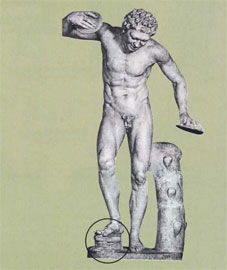 Κρούπεζα. Υπόδημα που φορούσαν οι μουσικοί για να κρατάνε το ρυθμό.
Μαλακά υποδήματα, κατασκευασμένα από πίλον, επεξεργασμένο μαλλί (κετσέ), ήταν αἱ ἐμβάδες και τὰ ἐμπίλια. Την ποικιλία των υποδημάτων εμπλουτίζουν τὰ διάβαθρα, τὰ ἔμβαθρα, αἱ κοκκίδες, τὰ τροχάδια και ἡ φαικάς. Ειδική θέση κατέχει ὁ κόθορνος, αρκετά φαρδύς ώστε να φοριέται αδιακρίτως στο δεξί και το αριστερό πόδι. Τον φορούσαν στις τραγωδίες οι πρωταγωνιστές και όσοι ηθοποιοί υποδύονταν θεούς. Το κάττυμα είχε ύψος 8 εκ., και το φόντι εικάζεται πως ήταν δερμάτινο κι έφτανε ως τη μέση της γάμπας. Αἱ κρούπεζαι ήταν το υπόδημα των μουσικών. Το μέταλλο στο διάκενο του καττύματος επέτρεπε στον αυλητή να κρατάει με το πόδι το ρυθμό.
Κρούπεζα. Υπόδημα που φορούσαν οι μουσικοί για να κρατάνε το ρυθμό.
Μαλακά υποδήματα, κατασκευασμένα από πίλον, επεξεργασμένο μαλλί (κετσέ), ήταν αἱ ἐμβάδες και τὰ ἐμπίλια. Την ποικιλία των υποδημάτων εμπλουτίζουν τὰ διάβαθρα, τὰ ἔμβαθρα, αἱ κοκκίδες, τὰ τροχάδια και ἡ φαικάς. Ειδική θέση κατέχει ὁ κόθορνος, αρκετά φαρδύς ώστε να φοριέται αδιακρίτως στο δεξί και το αριστερό πόδι. Τον φορούσαν στις τραγωδίες οι πρωταγωνιστές και όσοι ηθοποιοί υποδύονταν θεούς. Το κάττυμα είχε ύψος 8 εκ., και το φόντι εικάζεται πως ήταν δερμάτινο κι έφτανε ως τη μέση της γάμπας. Αἱ κρούπεζαι ήταν το υπόδημα των μουσικών. Το μέταλλο στο διάκενο του καττύματος επέτρεπε στον αυλητή να κρατάει με το πόδι το ρυθμό.
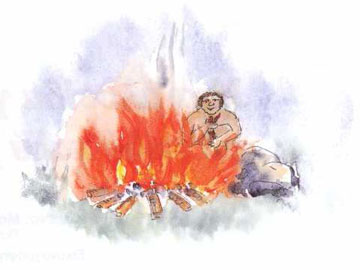 Οι πρώτοι άνθρωποι ανακαλύπτουν τη φωτιά.
Οι παλαιοντολόγοι, μελετώντας τα δόντια των σκελετών, ξέρουν αν οι άνθρωποι τρέφονταν με φυτά και ρίζες ή με το κρέας ζώων που κάποια μεγαλύτερα είχαν ήδη σκοτώσει. Δεν θα ήταν όμως τότε περιφρονητέα ούτε τα ποντίκια ή οι χελώνες, ούτε τα ζωύφια, όπως οι ακρίδες και τα σκουλήκια. Οι πρώτοι άνθρωποι γνώρισαν τη φωτιά βλέποντάς την να πέφτει από τον ουρανό, από τις φωτιές που άναβαν οι κεραυνοί. Εφευρετικοί, ανακάλυψαν ότι φωτιά ανάβει από την τριβή δύο ξύλων. Την χρησιμοποίησαν για να ζεσταθούν, να απομακρύνουν τα επικίνδυνα ζώα και για να ψήσουν την τροφή τους.
Οι πρώτοι άνθρωποι ανακαλύπτουν τη φωτιά.
Οι παλαιοντολόγοι, μελετώντας τα δόντια των σκελετών, ξέρουν αν οι άνθρωποι τρέφονταν με φυτά και ρίζες ή με το κρέας ζώων που κάποια μεγαλύτερα είχαν ήδη σκοτώσει. Δεν θα ήταν όμως τότε περιφρονητέα ούτε τα ποντίκια ή οι χελώνες, ούτε τα ζωύφια, όπως οι ακρίδες και τα σκουλήκια. Οι πρώτοι άνθρωποι γνώρισαν τη φωτιά βλέποντάς την να πέφτει από τον ουρανό, από τις φωτιές που άναβαν οι κεραυνοί. Εφευρετικοί, ανακάλυψαν ότι φωτιά ανάβει από την τριβή δύο ξύλων. Την χρησιμοποίησαν για να ζεσταθούν, να απομακρύνουν τα επικίνδυνα ζώα και για να ψήσουν την τροφή τους.
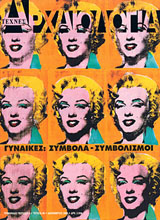
 Η Πλάσια Μάγκνα από την Πέργη της Μ. Ασίας με ενδυμασία ιέρειας (2ος αι. μ.Χ.).
Η γυναικεία συμμετοχή στον ευεργετισμό υπήρξε φαινόμενο περιορισμένο στο ελληνόφωνο τμήμα της Ρωμαϊκής Αυτοκρατορίας. Απαντά, ήδη από τους ελληνιστικούς χρόνους, μόνο στα νησιά του Αιγαίου (με εξαίρεση την Κρήτη και την Εύβοια), στα δυτικά παράλια της Μ. Ασίας και στην Κυρηναϊκή. Μετά την κατάρρευση της κλασικής πόλης και την υποβάθμιση των πολιτικών αξιωμάτων σε τιμητικούς τίτλους, την εγκαθίδρυση πελατειακών σχέσεων μεταξύ μονάρχη και πόλης στην ελληνιστική εποχή, οι Ρωμαίοι υποστήριξαν την ευεργεσία ως θεμέλιο λίθο της κοινωνικής ασυμμετρίας. Με την ανοχή τους διατηρήθηκε ως την κατάρρευση του αστικού πολιτισμού από τις καταστροφικές επιδρομές του 3ου αιώνα μ.Χ. Στα τιμητικά ψηφίσματα, ανάλογα με το φύλο, ο ευεργέτης καλείται «πατέρας», «μητέρα», «υιός», «θυγάτηρ» (της πόλεως ή της βουλής), υποδηλώνοντας την είσοδο της ιδιωτικής ζωής στη δημόσια και την πατερναλιστική σχέση της ελίτ με τον υπόλοιπο πληθυσμό. Η δύναμη έχει συγκεντρωθεί στα χέρια πλούσιων οικογενειών και ευφημισμοί καλύπτουν τις σχέσεις εκμετάλλευσης. Σε αυτό το πλαίσιο, και οι γυναίκες μπορούν να σταδιοδρομήσουν ως ευεργέτιδες κατά το παράδειγμα των βασιλισσών της ελληνιστικής εποχής, αποκτώντας τίτλους ασυνήθιστους για το φύλο τους. Ωστόσο, δύο διαφορές τις διακρίνουν από τους άντρες: μπορούν να τιμηθούν μόνο και μόνο επειδή εκπλήρωσαν τις αναπαραγωγικές τους υποχρεώσεις και, στα ψηφίσματα που τις τιμούν, τονίζεται πάντα η αρετή της συζύγου, μητέρας και οικοδέσποινας.
Η Πλάσια Μάγκνα από την Πέργη της Μ. Ασίας με ενδυμασία ιέρειας (2ος αι. μ.Χ.).
Η γυναικεία συμμετοχή στον ευεργετισμό υπήρξε φαινόμενο περιορισμένο στο ελληνόφωνο τμήμα της Ρωμαϊκής Αυτοκρατορίας. Απαντά, ήδη από τους ελληνιστικούς χρόνους, μόνο στα νησιά του Αιγαίου (με εξαίρεση την Κρήτη και την Εύβοια), στα δυτικά παράλια της Μ. Ασίας και στην Κυρηναϊκή. Μετά την κατάρρευση της κλασικής πόλης και την υποβάθμιση των πολιτικών αξιωμάτων σε τιμητικούς τίτλους, την εγκαθίδρυση πελατειακών σχέσεων μεταξύ μονάρχη και πόλης στην ελληνιστική εποχή, οι Ρωμαίοι υποστήριξαν την ευεργεσία ως θεμέλιο λίθο της κοινωνικής ασυμμετρίας. Με την ανοχή τους διατηρήθηκε ως την κατάρρευση του αστικού πολιτισμού από τις καταστροφικές επιδρομές του 3ου αιώνα μ.Χ. Στα τιμητικά ψηφίσματα, ανάλογα με το φύλο, ο ευεργέτης καλείται «πατέρας», «μητέρα», «υιός», «θυγάτηρ» (της πόλεως ή της βουλής), υποδηλώνοντας την είσοδο της ιδιωτικής ζωής στη δημόσια και την πατερναλιστική σχέση της ελίτ με τον υπόλοιπο πληθυσμό. Η δύναμη έχει συγκεντρωθεί στα χέρια πλούσιων οικογενειών και ευφημισμοί καλύπτουν τις σχέσεις εκμετάλλευσης. Σε αυτό το πλαίσιο, και οι γυναίκες μπορούν να σταδιοδρομήσουν ως ευεργέτιδες κατά το παράδειγμα των βασιλισσών της ελληνιστικής εποχής, αποκτώντας τίτλους ασυνήθιστους για το φύλο τους. Ωστόσο, δύο διαφορές τις διακρίνουν από τους άντρες: μπορούν να τιμηθούν μόνο και μόνο επειδή εκπλήρωσαν τις αναπαραγωγικές τους υποχρεώσεις και, στα ψηφίσματα που τις τιμούν, τονίζεται πάντα η αρετή της συζύγου, μητέρας και οικοδέσποινας.
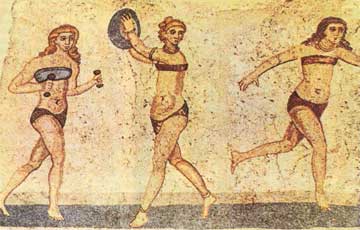 Ψηφιδωτό δάπεδο από τη Villa del Casale στην Piazza Armerina της Σικελίας. 4ος αι. μ.Χ.
Η θέση των γυναικών στο Βυζάντιο συναρτάται με τον ηθικό κώδικα αξιών της Εκκλησίας και τους θεσμούς μιας πατριαρχικής κοινωνίας αλλά επηρεάζεται από την κοινωνική τάξη και τη ζωή στην πόλη ή την ύπαιθρο. Τα κορίτσια παντρεύονταν στα 12 ή τα 13 τους τον σύζυγο που είχε επιλέξει ο πατέρας. Μόνον ακραίες συμπεριφορές του συζύγου ήταν νόμιμες αιτίες διαζυγίου. Η γυναίκα γινόταν αρχηγός της οικογένειάς της μόνον όταν έμενε χήρα, αν και η σεξουαλική της ζωή έμπαινε από τότε σε επιτήρηση. Ενδεικτικά, το 1551 στη Χίο, οι χήρες που δεν ήθελαν να ξαναπαντρευτούν όφειλαν φόρο σεξουαλικής απραξίας, το λεγόμενο «αργομουνιάτικο». Σύμφωνα με τους Πατέρες της Εκκλησίας, όταν οι γυναίκες έβγαιναν από το σπίτι όφειλαν να ρίχνουν στο κεφάλι τους πέπλο που άφηνε ακάλυπτα μόνο τα μάτια και τη μύτη. Πέρα από το γάμο και την τεκνογονία, κοινωνικά αποδεκτή ήταν η αφιέρωση στον μοναχικό βίο και τη φιλανθρωπική δράση. Βιοποριστικά επαγγέλματα ήταν της υφάντριας και της πλέκτριας, της καλιγράφισσας, της μυρεψού, της εμπόρου, της αρτοποιού και της μανάβισσας. Υπήρχαν επίσης επαγγελματίες ιατροί, μαίες και ιατρόμαιες. Έγκλειστες γυναίκες στο Βυζάντιο ήταν οι τυφλές, οι τρελές, οι γριές, οι λεπρές και οι κοινωνικά ανίσχυρες (ορφανές, χήρες, λεχώνες και ξένες). Σε αυτές πρόσφεραν μόνιμο ή προσωρινό καταφύγιο τα πολυάριθμα ευαγή ιδρύματα της Εκκλησίας. Ο τάφος των φτωχών γυναικών, λακκοειδής, κεραμοσκεπής, ακτέριστος, οριοθετημένος με ακατέργαστους λίθους, δεν έχει ούτε μια επιτύμβια λέξη. Το κέλυφος της σιωπής έσπασαν κάποιες γυναίκες της ανώτατης τάξης που αποκτούσαν μόρφωση πέρα από τα κοινά στοιχειώδη γράμματα. Με την υμνογραφία ασχολήθηκαν η Θέκλα, η Θεοδοσία, η Κασσιανή και η Παλαιολογία μοναχή. Γυναίκες επιστολογράφους συναντάμε σπανιότατα. Εκείνες που διατηρούσαν αλληλογραφία με τον Θεόδωρο Στουδίτη ήταν μοναχές. Θεωρείται ότι γυναίκες όλων των τάξεων υπερασπίστηκαν την εικονολατρεία που δύο αυτοκράτειρες, η Ειρήνη το 787 και η Θεοδώρα το 843, αποκατέστησαν επίσημα. Στις παραστάσεις των γυναικών που τιμωρούνται στην Κόλαση, πέρα από τις αναμενόμενες περιπτώσεις της πόρνης, της μαυλίστρας, της μάγισσας κ.ά., εμφανίζεται και η γυναίκα που αρνείται να τεκνοποιήσει, η αποστρέφουσα τα νήπια.
Ψηφιδωτό δάπεδο από τη Villa del Casale στην Piazza Armerina της Σικελίας. 4ος αι. μ.Χ.
Η θέση των γυναικών στο Βυζάντιο συναρτάται με τον ηθικό κώδικα αξιών της Εκκλησίας και τους θεσμούς μιας πατριαρχικής κοινωνίας αλλά επηρεάζεται από την κοινωνική τάξη και τη ζωή στην πόλη ή την ύπαιθρο. Τα κορίτσια παντρεύονταν στα 12 ή τα 13 τους τον σύζυγο που είχε επιλέξει ο πατέρας. Μόνον ακραίες συμπεριφορές του συζύγου ήταν νόμιμες αιτίες διαζυγίου. Η γυναίκα γινόταν αρχηγός της οικογένειάς της μόνον όταν έμενε χήρα, αν και η σεξουαλική της ζωή έμπαινε από τότε σε επιτήρηση. Ενδεικτικά, το 1551 στη Χίο, οι χήρες που δεν ήθελαν να ξαναπαντρευτούν όφειλαν φόρο σεξουαλικής απραξίας, το λεγόμενο «αργομουνιάτικο». Σύμφωνα με τους Πατέρες της Εκκλησίας, όταν οι γυναίκες έβγαιναν από το σπίτι όφειλαν να ρίχνουν στο κεφάλι τους πέπλο που άφηνε ακάλυπτα μόνο τα μάτια και τη μύτη. Πέρα από το γάμο και την τεκνογονία, κοινωνικά αποδεκτή ήταν η αφιέρωση στον μοναχικό βίο και τη φιλανθρωπική δράση. Βιοποριστικά επαγγέλματα ήταν της υφάντριας και της πλέκτριας, της καλιγράφισσας, της μυρεψού, της εμπόρου, της αρτοποιού και της μανάβισσας. Υπήρχαν επίσης επαγγελματίες ιατροί, μαίες και ιατρόμαιες. Έγκλειστες γυναίκες στο Βυζάντιο ήταν οι τυφλές, οι τρελές, οι γριές, οι λεπρές και οι κοινωνικά ανίσχυρες (ορφανές, χήρες, λεχώνες και ξένες). Σε αυτές πρόσφεραν μόνιμο ή προσωρινό καταφύγιο τα πολυάριθμα ευαγή ιδρύματα της Εκκλησίας. Ο τάφος των φτωχών γυναικών, λακκοειδής, κεραμοσκεπής, ακτέριστος, οριοθετημένος με ακατέργαστους λίθους, δεν έχει ούτε μια επιτύμβια λέξη. Το κέλυφος της σιωπής έσπασαν κάποιες γυναίκες της ανώτατης τάξης που αποκτούσαν μόρφωση πέρα από τα κοινά στοιχειώδη γράμματα. Με την υμνογραφία ασχολήθηκαν η Θέκλα, η Θεοδοσία, η Κασσιανή και η Παλαιολογία μοναχή. Γυναίκες επιστολογράφους συναντάμε σπανιότατα. Εκείνες που διατηρούσαν αλληλογραφία με τον Θεόδωρο Στουδίτη ήταν μοναχές. Θεωρείται ότι γυναίκες όλων των τάξεων υπερασπίστηκαν την εικονολατρεία που δύο αυτοκράτειρες, η Ειρήνη το 787 και η Θεοδώρα το 843, αποκατέστησαν επίσημα. Στις παραστάσεις των γυναικών που τιμωρούνται στην Κόλαση, πέρα από τις αναμενόμενες περιπτώσεις της πόρνης, της μαυλίστρας, της μάγισσας κ.ά., εμφανίζεται και η γυναίκα που αρνείται να τεκνοποιήσει, η αποστρέφουσα τα νήπια.
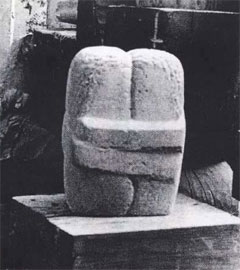 «Γιατί ο Brancusi έκανε το «Ζεύγος» από μία μόνο πέτρα»;
Η συγγραφέας στρέφει την καλλιτεχνική της ματιά σε βυζαντινές εικόνες, σε έργα τέχνης αρχαία και σύχρονα, αφυπνίζοντας με τις συνεχείς ερωτήσεις της τον αναγνώστη-θεατή στη συμβολική τους έννοια. Τον προβληματισμό της συνεπικουρεί η σύγχρονη αμφισβήτηση γύρω από θέματα φύλου και κοινωνικών ταυτοτήτων. «Γιατί ο Brancusi έκανε το “Ζεύγος” από μία μόνο πέτρα»; αναρωτιέται. Αποδίδοντας στον έρωτα συμπαντικές διαστάσεις, μας καλεί να βιώσουμε την ολιστική ερωτική ροή.
«Γιατί ο Brancusi έκανε το «Ζεύγος» από μία μόνο πέτρα»;
Η συγγραφέας στρέφει την καλλιτεχνική της ματιά σε βυζαντινές εικόνες, σε έργα τέχνης αρχαία και σύχρονα, αφυπνίζοντας με τις συνεχείς ερωτήσεις της τον αναγνώστη-θεατή στη συμβολική τους έννοια. Τον προβληματισμό της συνεπικουρεί η σύγχρονη αμφισβήτηση γύρω από θέματα φύλου και κοινωνικών ταυτοτήτων. «Γιατί ο Brancusi έκανε το “Ζεύγος” από μία μόνο πέτρα»; αναρωτιέται. Αποδίδοντας στον έρωτα συμπαντικές διαστάσεις, μας καλεί να βιώσουμε την ολιστική ερωτική ροή.
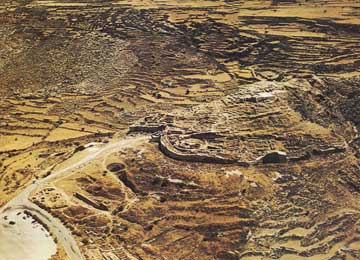 Ο λόφος με την ακρόπολη που ταυτίστηκε με τις Μυκήνες.
Αν και τη σκαπάνη του Σλήμαν κατηύθυνε ο Παυσανίας, η ταύτιση του τόπου των ανασκαφών του με τις πολύχρυσες Μυκήνες δεν αμφισβητήθηκε ποτέ. Ο συγγραφέας, πεπεισμένος για ένα λάθος που θεωρεί κραυγαλέο, εκθέτει την επιχειρηματολογία του. Κατ’ αρχάς διακρίνει την τοπογραφία των ομηρικών επών από εκείνη των ιστορικών χρόνων. Οι Έλληνες της ιστορικής αρχαιότητας, αν και ομολογούν την άγνοιά τους για την πραγματική θέση βασικών ομηρικών τοπονυμίων, διασπείρουν το γόητρο που τα συνόδευε απονέμοντάς τα στους τόπους της αρεσκείας τους. Από αυτό τον «εξομηρισμό» προέκυψαν τρεις Πύλοι του Νέστορα, πέντε Οιχαλίες, εννέα Εφύρες. Πριν από τον 8ο αιώνα π.Χ., κανένα στοιχείο δεν συνδέει το βασίλειο του Αγαμέμνονα με τη βορειοανατολική Πελοπόννησο. Οι Μυκήνες γνώρισαν από το τέλος της μυκηναϊκής εποχής μεγάλα διαστήματα πλήρους ή μερικής ερήμωσης. Εμπιστευόμενος μόνο τον Όμηρο, ο συγγραφέας αναζητεί την πολιτική γεωγραφία των επών. Δύο φορές στα έπη, ο δρόμος από την Τροία για τις Μυκήνες παρακάμπτει το ακρωτήρι του Κάβο-Μαλιά. Οι επτά πόλεις που ο Αγαμέμνονας τάζει για προίκα στον Αχιλλέα βρίσκονται κοντά στην αμμουδερή Πύλο. Με τη συνδρομή και άλλων ενδείξεων, υποστηρίζεται ότι οι ομηρικές Μυκήνες, παραθαλάσσια και μάλλον ατείχιστη πόλη, θα πρέπει να αναζητηθούν δυτικά του Μαλέα, στον κόλπο της Νεάπολης ή της Πλύτρας.
Ο λόφος με την ακρόπολη που ταυτίστηκε με τις Μυκήνες.
Αν και τη σκαπάνη του Σλήμαν κατηύθυνε ο Παυσανίας, η ταύτιση του τόπου των ανασκαφών του με τις πολύχρυσες Μυκήνες δεν αμφισβητήθηκε ποτέ. Ο συγγραφέας, πεπεισμένος για ένα λάθος που θεωρεί κραυγαλέο, εκθέτει την επιχειρηματολογία του. Κατ’ αρχάς διακρίνει την τοπογραφία των ομηρικών επών από εκείνη των ιστορικών χρόνων. Οι Έλληνες της ιστορικής αρχαιότητας, αν και ομολογούν την άγνοιά τους για την πραγματική θέση βασικών ομηρικών τοπονυμίων, διασπείρουν το γόητρο που τα συνόδευε απονέμοντάς τα στους τόπους της αρεσκείας τους. Από αυτό τον «εξομηρισμό» προέκυψαν τρεις Πύλοι του Νέστορα, πέντε Οιχαλίες, εννέα Εφύρες. Πριν από τον 8ο αιώνα π.Χ., κανένα στοιχείο δεν συνδέει το βασίλειο του Αγαμέμνονα με τη βορειοανατολική Πελοπόννησο. Οι Μυκήνες γνώρισαν από το τέλος της μυκηναϊκής εποχής μεγάλα διαστήματα πλήρους ή μερικής ερήμωσης. Εμπιστευόμενος μόνο τον Όμηρο, ο συγγραφέας αναζητεί την πολιτική γεωγραφία των επών. Δύο φορές στα έπη, ο δρόμος από την Τροία για τις Μυκήνες παρακάμπτει το ακρωτήρι του Κάβο-Μαλιά. Οι επτά πόλεις που ο Αγαμέμνονας τάζει για προίκα στον Αχιλλέα βρίσκονται κοντά στην αμμουδερή Πύλο. Με τη συνδρομή και άλλων ενδείξεων, υποστηρίζεται ότι οι ομηρικές Μυκήνες, παραθαλάσσια και μάλλον ατείχιστη πόλη, θα πρέπει να αναζητηθούν δυτικά του Μαλέα, στον κόλπο της Νεάπολης ή της Πλύτρας.
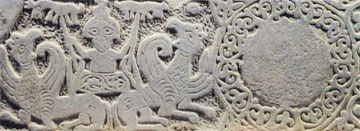 «Η άνοδος του Αλεξάνδρου στον ουρανό», 14ος αι. Περίβλεπτος, Μουσείο Μυστρά.
Δίψα για κατακτήσεις, δίψα για γνώση. Η συναρπαστική φυσιογνωμία του Αλέξανδρου δεν εξαντλείται στο πρόσωπο του στρατηλάτη. Πολύ περισσότερο βαραίνει το όραμά του να μετατρέψει τις μακρόχρονες αμοιβαίες ανταλλαγές ανάμεσα σε Ελλάδα και Ανατολή σε ένα νέο, κοινό πολιτισμό. Άραγε οι κάθε λογής «βάρβαροι» τον έκαναν θρύλο επειδή έπαψαν να νιώθουν «μη Έλληνες»; Η αλεξανδρινή τώρα γίνεται η κοινή τους γλώσσα. Στην ανεικονική Ινδία που προσκυνούσε μόνο τα ίχνη των πελμάτων του, ο Βούδας αίφνης αναπαρίσταται ολόσωμος, ντυμένος σαν Απόλλωνας. Η ινδική γλυπτική, ιδιαίτερα η τέχνη της Γκαντάρα-Ματούρα, διατήρησε για αιώνες τη σφραγίδα της ελληνικής τέχνης. Πρεσβευτής στον ηγεμόνα των Ινδιών, ο Μεγασθένης συγγράφει την αρχαιότερη ιστορία τους (3ος αιώνας π.Χ.). Γόνος του ηγεμόνα από ελληνίδα μητέρα, ο μεγάλος μεταρρυθμιστής Ashoka συντάσσει τους νόμους του στα αραμαϊκά και τα ελληνικά. Ανάλογη ήταν η επιρροή στη Συρία, την Παλαιστίνη, την Αρμενία και τη Βόρεια Αφρική. Η μετάφραση της Παλαιάς Διαθήκης τον 2ο αιώνα π.Χ. υποδηλώνει πως η κοινή ήταν πιο οικεία ακόμη και για τους Εβραίους. Απόγονος του Ηρακλή και γιος του Διός Άμμωνος, ο Αλέξανδρος θα παραμείνει ημίθεος για τους Ρωμαίους. Έχοντας προκαλέσει «παγκόσμιες» ανακατατάξεις και πεθαίνοντας νέος, ο Αλέξανδρος μεταπήδησε στη σφαίρα του θρύλου. Τον 3ο αιώνα μ.Χ. ο Ψευδο-Καλλισθένης συγγράφει μια ρομαντική βιογραφία εμπλουτισμένη από τη λαϊκή φαντασία. Τη λατινική της μετάφραση τον επόμενο αιώνα θα ακολουθήσουν μεσαιωνικές μεταφράσεις στις περισσότερες γλώσσες της Ευρώπης και της Ανατολής. Σικάντερ για τους Πέρσες, Αλ Ισκάνταρ για τους Άραβες, Σκέντερ ή Ισκαντάρ για τους Τούρκους. Ο Αλέξανδρος συνομιλεί με Ινδούς φακίρηδες, με τους σοφούς της Κίνας. Επισκέπτεται την Ιερουσαλήμ όπου ο Ιερεμίας του προφητεύει πως θα κυβερνήσει τον κόσμο. Μυείται στο χριστιανισμό. Ο Ισκαντάρ Dhoul Carnein («με τα δύο κέρατα») περνάει από την περσοζωροαστρική λογοτεχνία στο Κοράνι ως υποδειγματικός ήρωας του Ισλάμ. Ως Τούρκος ευγενής εμφανίζεται στην τουρκική παραλλαγή του Ψευδο-Καλλισθένη στα τέλη του 14ου αιώνα. Αντίστοιχα, στη Δύση μεταμορφώνεται σε Φράγκο, Γότθο, Ρώσο ή Σάξονα. Είναι ο ένας από τους εννέα σπουδαιότερους μεσαιωνικούς ήρωες. Οι περιπέτειές του αποκτούν μυθική χροιά. Αυτός και τα άλογά του λούζονται στην πηγή της αθανασίας. Έχοντας διατρέξει όλη τη γη, συνεχίζει την εξερεύνησή του στον ουρανό και στα βάθη του ωκεανού. Στην Αναγέννηση ο Αλέξανδρος, καθαρμένος από τη λαϊκή φαντασία, ανακτά την ιστορική του προσωπικότητα. Αντίθετα, στην Ελλάδα την εποχή της Τουρκοκρατίας κυριαρχεί η θρυλική, όχι η ιστορική μορφή του Αλέξανδρου. Στην προμετωπίδα της διακήρυξης που κυκλοφόρησε ο Ρήγας Φεραίος, ο Αλέξανδρος απεικονίζει τον πόθο για εθνική ανάσταση. Η «Ριμάδα» και η «Φυλλάδα» που εξιστορούν τη ζωή του, διαβάζονται φανατικά και εμπλουτίζονται με νέες παραλλαγές που περιλαμβάνουν και την αδελφή του, τη Γοργόνα. Ο Αλέξανδρος παραμένει δημοφιλής και μετά την ίδρυση του ελληνικού κράτους. Αντιμετωπίζει τον «κατηραμένον όφιν» στο Θέατρο Σκιών, εμπνέει τον Χαλεπά, τον Θεόφιλο, τον Εγγονόπουλο, τον Σεφέρη και τον Ρίτσο, και πολλούς άλλους δημιουργούς.
«Η άνοδος του Αλεξάνδρου στον ουρανό», 14ος αι. Περίβλεπτος, Μουσείο Μυστρά.
Δίψα για κατακτήσεις, δίψα για γνώση. Η συναρπαστική φυσιογνωμία του Αλέξανδρου δεν εξαντλείται στο πρόσωπο του στρατηλάτη. Πολύ περισσότερο βαραίνει το όραμά του να μετατρέψει τις μακρόχρονες αμοιβαίες ανταλλαγές ανάμεσα σε Ελλάδα και Ανατολή σε ένα νέο, κοινό πολιτισμό. Άραγε οι κάθε λογής «βάρβαροι» τον έκαναν θρύλο επειδή έπαψαν να νιώθουν «μη Έλληνες»; Η αλεξανδρινή τώρα γίνεται η κοινή τους γλώσσα. Στην ανεικονική Ινδία που προσκυνούσε μόνο τα ίχνη των πελμάτων του, ο Βούδας αίφνης αναπαρίσταται ολόσωμος, ντυμένος σαν Απόλλωνας. Η ινδική γλυπτική, ιδιαίτερα η τέχνη της Γκαντάρα-Ματούρα, διατήρησε για αιώνες τη σφραγίδα της ελληνικής τέχνης. Πρεσβευτής στον ηγεμόνα των Ινδιών, ο Μεγασθένης συγγράφει την αρχαιότερη ιστορία τους (3ος αιώνας π.Χ.). Γόνος του ηγεμόνα από ελληνίδα μητέρα, ο μεγάλος μεταρρυθμιστής Ashoka συντάσσει τους νόμους του στα αραμαϊκά και τα ελληνικά. Ανάλογη ήταν η επιρροή στη Συρία, την Παλαιστίνη, την Αρμενία και τη Βόρεια Αφρική. Η μετάφραση της Παλαιάς Διαθήκης τον 2ο αιώνα π.Χ. υποδηλώνει πως η κοινή ήταν πιο οικεία ακόμη και για τους Εβραίους. Απόγονος του Ηρακλή και γιος του Διός Άμμωνος, ο Αλέξανδρος θα παραμείνει ημίθεος για τους Ρωμαίους. Έχοντας προκαλέσει «παγκόσμιες» ανακατατάξεις και πεθαίνοντας νέος, ο Αλέξανδρος μεταπήδησε στη σφαίρα του θρύλου. Τον 3ο αιώνα μ.Χ. ο Ψευδο-Καλλισθένης συγγράφει μια ρομαντική βιογραφία εμπλουτισμένη από τη λαϊκή φαντασία. Τη λατινική της μετάφραση τον επόμενο αιώνα θα ακολουθήσουν μεσαιωνικές μεταφράσεις στις περισσότερες γλώσσες της Ευρώπης και της Ανατολής. Σικάντερ για τους Πέρσες, Αλ Ισκάνταρ για τους Άραβες, Σκέντερ ή Ισκαντάρ για τους Τούρκους. Ο Αλέξανδρος συνομιλεί με Ινδούς φακίρηδες, με τους σοφούς της Κίνας. Επισκέπτεται την Ιερουσαλήμ όπου ο Ιερεμίας του προφητεύει πως θα κυβερνήσει τον κόσμο. Μυείται στο χριστιανισμό. Ο Ισκαντάρ Dhoul Carnein («με τα δύο κέρατα») περνάει από την περσοζωροαστρική λογοτεχνία στο Κοράνι ως υποδειγματικός ήρωας του Ισλάμ. Ως Τούρκος ευγενής εμφανίζεται στην τουρκική παραλλαγή του Ψευδο-Καλλισθένη στα τέλη του 14ου αιώνα. Αντίστοιχα, στη Δύση μεταμορφώνεται σε Φράγκο, Γότθο, Ρώσο ή Σάξονα. Είναι ο ένας από τους εννέα σπουδαιότερους μεσαιωνικούς ήρωες. Οι περιπέτειές του αποκτούν μυθική χροιά. Αυτός και τα άλογά του λούζονται στην πηγή της αθανασίας. Έχοντας διατρέξει όλη τη γη, συνεχίζει την εξερεύνησή του στον ουρανό και στα βάθη του ωκεανού. Στην Αναγέννηση ο Αλέξανδρος, καθαρμένος από τη λαϊκή φαντασία, ανακτά την ιστορική του προσωπικότητα. Αντίθετα, στην Ελλάδα την εποχή της Τουρκοκρατίας κυριαρχεί η θρυλική, όχι η ιστορική μορφή του Αλέξανδρου. Στην προμετωπίδα της διακήρυξης που κυκλοφόρησε ο Ρήγας Φεραίος, ο Αλέξανδρος απεικονίζει τον πόθο για εθνική ανάσταση. Η «Ριμάδα» και η «Φυλλάδα» που εξιστορούν τη ζωή του, διαβάζονται φανατικά και εμπλουτίζονται με νέες παραλλαγές που περιλαμβάνουν και την αδελφή του, τη Γοργόνα. Ο Αλέξανδρος παραμένει δημοφιλής και μετά την ίδρυση του ελληνικού κράτους. Αντιμετωπίζει τον «κατηραμένον όφιν» στο Θέατρο Σκιών, εμπνέει τον Χαλεπά, τον Θεόφιλο, τον Εγγονόπουλο, τον Σεφέρη και τον Ρίτσο, και πολλούς άλλους δημιουργούς.
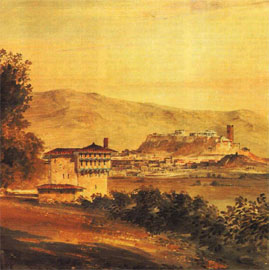 Το κονάκι του Χασεκή. Υδατογραφία του Gandy, 1818.
Ανάμεσα στην αρχαία Αθήνα και τον Ελαιώνα της, βρίσκονται τα ευφορότερα εδάφη για την καλλιέργεια κηπευτικών, εξ ου και η τοπική ονομασία Βοτανικός. Σήμερα η περιοχή έκτασης 120 στρεμμάτων στα αριστερά της Ιεράς Οδού και στα μισά της διαδρομής από την Αθήνα στο Αιγάλεω μοιάζει με μωσαϊκό ποικίλων χρήσεων. Περιλαμβάνει το πρώην αγρόκτημα του βοεβόδα Χατζή-Αλή Χασεκή με τα ερείπια από το οχυρωμένο κονάκι του (1774-1796), δύο κτίσματα του πρώιμου κλασικισμού της οθωνικής περιόδου και τα αιωνόβια δέντρα του πρώτου Βοτανικού Κήπου της χώρας. Σε αυτό το σημαντικότατο σύνολο της πολεοδομικής ιστορίας της νεότερης Αθήνας φιλοξενείται το Γεωπονικό της Πανεπιστήμιο. Στα χρόνια του Όθωνα το αγρόκτημα του βοεβόδα μετατράπηκε σε καλά οργανωμένο Βοτανικό Κήπο κατά τα ευρωπαϊκά πρότυπα, φιλοξενώντας και Δενδροκομείο προς ενίσχυση της υποτυπώδους γεωργίας της χώρας. Σώζονται μέχρι σήμερα οι μεγάλοι φοίνικες και τα ψηλά του κυπαρίσσια καθώς και μεγάλη ποικιλία δέντρων και θάμνων που ο συγγραφέας κατονομάζει αναλυτικά. Η μνημειακή Κρήνη του Χασεκή που κατασκευάστηκε τον 18ο αιώνα είναι η μοναδική βρύση της Τουρκοκρατίας που διατηρείται σήμερα στην Αθήνα. Τη σοβαρή προσπάθεια οργάνωσης Βοτανικού Κήπου τεκμηριώνει και το θερμαινόμενο Παλαιό Θερμοκήπιο που με την εισαγωγή νέων και σπάνιων φυτών αύξησε την ελληνική ποικιλία δέντρων και θάμνων. Ο Hansen κατασκευάζει πλάι του δεξαμενή. Μετά την απομάκρυνση του Όθωνα, η ελληνική αδιαφορία φέρνει την καταστροφή. Με πρωτοβουλία του Εργαστηρίου Ανθοκομίας και Αρχιτεκτονικής Κήπων και με δαπάνη του Γ.Π.Α. ανακατασκευάστηκε ο αρχικός σκελετός του Παλαιού Θερμοκηπίου και αποκαταστάθηκε η χρήση του για την εκπόνηση ερευνητικών εργασιών. Τα συντηρημένα οθωνικά κτίσματα χρησιμοποιούνται από το Πανεπιστήμιο. Μένει να συντηρηθούν και να αναδειχθούν τα κατάλοιπα της Τουρκοκρατίας για να κερδίσει η Αθήνα ακόμη έναν ιστορικό χώρο αναφοράς, που θα συνδυάζει στοιχεία αρχιτεκτονικής και κηποτεχνίας του 18ου και του 19ου αιώνα.
Το κονάκι του Χασεκή. Υδατογραφία του Gandy, 1818.
Ανάμεσα στην αρχαία Αθήνα και τον Ελαιώνα της, βρίσκονται τα ευφορότερα εδάφη για την καλλιέργεια κηπευτικών, εξ ου και η τοπική ονομασία Βοτανικός. Σήμερα η περιοχή έκτασης 120 στρεμμάτων στα αριστερά της Ιεράς Οδού και στα μισά της διαδρομής από την Αθήνα στο Αιγάλεω μοιάζει με μωσαϊκό ποικίλων χρήσεων. Περιλαμβάνει το πρώην αγρόκτημα του βοεβόδα Χατζή-Αλή Χασεκή με τα ερείπια από το οχυρωμένο κονάκι του (1774-1796), δύο κτίσματα του πρώιμου κλασικισμού της οθωνικής περιόδου και τα αιωνόβια δέντρα του πρώτου Βοτανικού Κήπου της χώρας. Σε αυτό το σημαντικότατο σύνολο της πολεοδομικής ιστορίας της νεότερης Αθήνας φιλοξενείται το Γεωπονικό της Πανεπιστήμιο. Στα χρόνια του Όθωνα το αγρόκτημα του βοεβόδα μετατράπηκε σε καλά οργανωμένο Βοτανικό Κήπο κατά τα ευρωπαϊκά πρότυπα, φιλοξενώντας και Δενδροκομείο προς ενίσχυση της υποτυπώδους γεωργίας της χώρας. Σώζονται μέχρι σήμερα οι μεγάλοι φοίνικες και τα ψηλά του κυπαρίσσια καθώς και μεγάλη ποικιλία δέντρων και θάμνων που ο συγγραφέας κατονομάζει αναλυτικά. Η μνημειακή Κρήνη του Χασεκή που κατασκευάστηκε τον 18ο αιώνα είναι η μοναδική βρύση της Τουρκοκρατίας που διατηρείται σήμερα στην Αθήνα. Τη σοβαρή προσπάθεια οργάνωσης Βοτανικού Κήπου τεκμηριώνει και το θερμαινόμενο Παλαιό Θερμοκήπιο που με την εισαγωγή νέων και σπάνιων φυτών αύξησε την ελληνική ποικιλία δέντρων και θάμνων. Ο Hansen κατασκευάζει πλάι του δεξαμενή. Μετά την απομάκρυνση του Όθωνα, η ελληνική αδιαφορία φέρνει την καταστροφή. Με πρωτοβουλία του Εργαστηρίου Ανθοκομίας και Αρχιτεκτονικής Κήπων και με δαπάνη του Γ.Π.Α. ανακατασκευάστηκε ο αρχικός σκελετός του Παλαιού Θερμοκηπίου και αποκαταστάθηκε η χρήση του για την εκπόνηση ερευνητικών εργασιών. Τα συντηρημένα οθωνικά κτίσματα χρησιμοποιούνται από το Πανεπιστήμιο. Μένει να συντηρηθούν και να αναδειχθούν τα κατάλοιπα της Τουρκοκρατίας για να κερδίσει η Αθήνα ακόμη έναν ιστορικό χώρο αναφοράς, που θα συνδυάζει στοιχεία αρχιτεκτονικής και κηποτεχνίας του 18ου και του 19ου αιώνα.
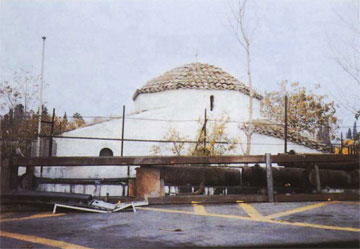 Το μεταβυζαντινό εκκλησίδιο του Αγίου Νικολάου.
Με το Γεωπονικό Πανεπιστήμιο Αθηνών συνορεύει χώρος 100 στρεμμάτων που χρησιμοποιείται ως αμαξοστάσιο του Οργανισμού Αστικών Συγκοινωνιών Αθηνών. Το ρυθμιστικό Σχέδιο της Αθήνας προβλέπει την απομάκρυνση του αμαξοστασίου και τη δημιουργία χώρου πρασίνου που θα ενσωματωθεί στον περιβάλλοντα χώρο του Γ.Π.Α. Από τη συνεργασία του Γ.Π.Α. (Εργαστήριο Ανθοκομίας και Αρχιτεκτονικής Κήπων) και του Τεχνικού Πανεπιστημίου Μονάχου (έδρα: Αρχιτεκτονική Τοπίου και Σύνθεση) προέκυψε μελέτη για την ανάπλαση και αξιοποίηση του εν λόγω χώρου. Το υπάρχον κτηριακό συγκρότημα, ανακαινισμένο και τεχνολογικά εξοπλισμένο, θα αποδοθεί στο Γεωπονικό Πανεπιστήμιο. Η μεγάλη ακάλυπτη ασφαλτοστρωμένη έκταση θα διαιρεθεί σύμφωνα με ειδικό διπλό κάνναβο (πλέγμα). Η άσφαλτος απομακρύνεται από τις επιλεγμένες επιφάνειες και διατηρείται στους χώρους διακίνησης. Η κηποτεχνική πρόταση αποσκοπεί στην αναδημιουργία των «Κήπων του Βοτανικού». Προτείνονται συγκεκριμένα καλλωπιστικά φυτά. Υπαίθριο αμφιθέατρο στολισμένο με ελιές και στραμμένο προς τον οπτικό άξονα του Λυκαβηττού, θα επιτρέπει στους ακροατές να απολαμβάνουν τη θέα των κήπων ακούγοντας τον ομιλητή που θα τους απευθύνεται κάτω από τις ελιές, κατά το πρότυπο του Πλάτωνα.
Το μεταβυζαντινό εκκλησίδιο του Αγίου Νικολάου.
Με το Γεωπονικό Πανεπιστήμιο Αθηνών συνορεύει χώρος 100 στρεμμάτων που χρησιμοποιείται ως αμαξοστάσιο του Οργανισμού Αστικών Συγκοινωνιών Αθηνών. Το ρυθμιστικό Σχέδιο της Αθήνας προβλέπει την απομάκρυνση του αμαξοστασίου και τη δημιουργία χώρου πρασίνου που θα ενσωματωθεί στον περιβάλλοντα χώρο του Γ.Π.Α. Από τη συνεργασία του Γ.Π.Α. (Εργαστήριο Ανθοκομίας και Αρχιτεκτονικής Κήπων) και του Τεχνικού Πανεπιστημίου Μονάχου (έδρα: Αρχιτεκτονική Τοπίου και Σύνθεση) προέκυψε μελέτη για την ανάπλαση και αξιοποίηση του εν λόγω χώρου. Το υπάρχον κτηριακό συγκρότημα, ανακαινισμένο και τεχνολογικά εξοπλισμένο, θα αποδοθεί στο Γεωπονικό Πανεπιστήμιο. Η μεγάλη ακάλυπτη ασφαλτοστρωμένη έκταση θα διαιρεθεί σύμφωνα με ειδικό διπλό κάνναβο (πλέγμα). Η άσφαλτος απομακρύνεται από τις επιλεγμένες επιφάνειες και διατηρείται στους χώρους διακίνησης. Η κηποτεχνική πρόταση αποσκοπεί στην αναδημιουργία των «Κήπων του Βοτανικού». Προτείνονται συγκεκριμένα καλλωπιστικά φυτά. Υπαίθριο αμφιθέατρο στολισμένο με ελιές και στραμμένο προς τον οπτικό άξονα του Λυκαβηττού, θα επιτρέπει στους ακροατές να απολαμβάνουν τη θέα των κήπων ακούγοντας τον ομιλητή που θα τους απευθύνεται κάτω από τις ελιές, κατά το πρότυπο του Πλάτωνα.
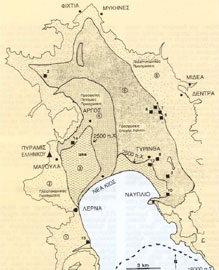 Χάρτης επιφανειακών αποθέσεων στην αργολική πεδιάδα.
Οι συγγραφείς επιδίδονται στην «αποσυμβολοποίηση» του μυθολογούμενου κατακλυσμού του Ίναχου με το σκεπτικό ότι η Αργολίδα, πλούσια σε μύθους και γεωαρχαιολογικά ευρήματα, παρέχει τη δυνατότητα να ταυτιστούν τα μυθολογούμενα γεγονότα με συγκεκριμένα γεωλογικά και κλιματικά φαινόμενα. Συγκρίσεις γίνονται με τον κατακλυσμό του Δευκαλίωνα, του Δαρδάνου και, κυρίως, του Ωγύγου, καθώς και με αντίστοιχες παραδόσεις της Εγγύς Ανατολής. Συνδυάζοντας τα γεωαρχαιολογικά στοιχεία με το μύθο συμπεραίνεται ότι η θρυλούμενη συγκέντρωση των πληθυσμών επί Ίναχου τοποθετείται τελικά στα χρόνια 2900-2800 π.Χ., όταν, μετά τις πλημμύρες, η αργολική πεδιάδα είναι εκμεταλλεύσιμη. Ότι η μεταμόρφωση του Ίναχου σε χείμαρρο από τον Ποσειδώνα υποδηλώνει την ξηρασία που, από τα τέλη της Πρώιμης Χαλκοκρατίας, βιώνει η περιοχή και το «πολυδίψιον» Άργος. Σε προχωρημένη φάση της ίδιας περιόδου, οι πηγές που συνδέονται με τον Δαναό και τις κόρες του μοιάζουν άμεσα συνδεδεμένες με το γεωλογικό υπόστρωμα (υπόγεια φρεάτια). Βάσει της μυθικής γενεαλογίας η δράση του Δαναού τοποθετείται γύρω στο 2500 π.Χ. Σε συνάρτηση πάντα με τα γεωαρχαιολογικά δεδομένα και με την όποια συνδρομή της ιστορικής μυθολογίας, ίσως μπορέσει να ανιχνευτεί μια πραγματική «πατρολογία» πίσω από τις μυθικές γενεαλογίες.
Χάρτης επιφανειακών αποθέσεων στην αργολική πεδιάδα.
Οι συγγραφείς επιδίδονται στην «αποσυμβολοποίηση» του μυθολογούμενου κατακλυσμού του Ίναχου με το σκεπτικό ότι η Αργολίδα, πλούσια σε μύθους και γεωαρχαιολογικά ευρήματα, παρέχει τη δυνατότητα να ταυτιστούν τα μυθολογούμενα γεγονότα με συγκεκριμένα γεωλογικά και κλιματικά φαινόμενα. Συγκρίσεις γίνονται με τον κατακλυσμό του Δευκαλίωνα, του Δαρδάνου και, κυρίως, του Ωγύγου, καθώς και με αντίστοιχες παραδόσεις της Εγγύς Ανατολής. Συνδυάζοντας τα γεωαρχαιολογικά στοιχεία με το μύθο συμπεραίνεται ότι η θρυλούμενη συγκέντρωση των πληθυσμών επί Ίναχου τοποθετείται τελικά στα χρόνια 2900-2800 π.Χ., όταν, μετά τις πλημμύρες, η αργολική πεδιάδα είναι εκμεταλλεύσιμη. Ότι η μεταμόρφωση του Ίναχου σε χείμαρρο από τον Ποσειδώνα υποδηλώνει την ξηρασία που, από τα τέλη της Πρώιμης Χαλκοκρατίας, βιώνει η περιοχή και το «πολυδίψιον» Άργος. Σε προχωρημένη φάση της ίδιας περιόδου, οι πηγές που συνδέονται με τον Δαναό και τις κόρες του μοιάζουν άμεσα συνδεδεμένες με το γεωλογικό υπόστρωμα (υπόγεια φρεάτια). Βάσει της μυθικής γενεαλογίας η δράση του Δαναού τοποθετείται γύρω στο 2500 π.Χ. Σε συνάρτηση πάντα με τα γεωαρχαιολογικά δεδομένα και με την όποια συνδρομή της ιστορικής μυθολογίας, ίσως μπορέσει να ανιχνευτεί μια πραγματική «πατρολογία» πίσω από τις μυθικές γενεαλογίες.
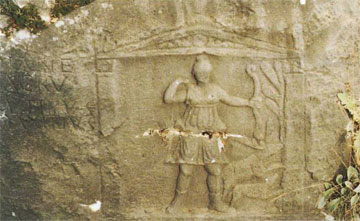 Η Άρτεμις κυριαρχεί στα βραχοανάγλυφα των Φιλίππων.
Η τοποθεσία των Φιλίππων στο νομό Καβάλας ανακαλύφθηκε το 1861 από τον Léon Heuzey της γαλλικής αρχαιολογικής αποστολής που, κατ‘εντολή του Ναπολέοντα Γ΄, εξερεύνησε τη Μακεδονία. Ο Heuzey περιέγραψε μόνο τις βραχογραφίες. Τα ιδιόμορφα βραχοανάγλυφα, που μοιάζουν με λαϊκές προσαρμογές κλασικών γλυπτών προτύπων, χρονολογούνται στα τέλη του 2ου και την αρχή του 3ου αιώνα μ.Χ. Η ερμηνεία τους ως νεκρικών αναγλύφων δεν είναι εύκολο να υποστηριχτεί. Πρόκειται για αναθηματικά ανάγλυφα που οι κάτοικοι της πόλης αφιέρωναν στους θεούς τους; Ποιοι ήταν όμως αυτοί οι κάτοικοι; Ρωμαίοι άποικοι, εκρωμαϊσμένοι ντόπιοι, Θράκες γηγενείς; Από τα 180 περίπου σκαλίσματα, τουλάχιστον τα μισά απεικονίζουν την Άρτεμη με κυνηγετική περιβολή, κοντό χιτώνα και ενδρομίδες, τόξο και φαρέτρα. Οι παραστάσεις της θεάς που καρφώνει μαχαίρι στο λαιμό ελαφιού θυμίζουν την αντίστοιχη απεικόνιση του Ηρακλή σε μετόπη του θησαυρού των Αθηναίων στους Δελφούς. Οι περισσότερες από τις άλλες γυναικείες μορφές, που αποδίδονται μετωπικά με χιτώνα και ιμάτιο, ταυτίστηκαν με την Ίσιδα. Απεικονίζονται άλλες θεότητες και ο «Θράξ ιππεύς».
Η Άρτεμις κυριαρχεί στα βραχοανάγλυφα των Φιλίππων.
Η τοποθεσία των Φιλίππων στο νομό Καβάλας ανακαλύφθηκε το 1861 από τον Léon Heuzey της γαλλικής αρχαιολογικής αποστολής που, κατ‘εντολή του Ναπολέοντα Γ΄, εξερεύνησε τη Μακεδονία. Ο Heuzey περιέγραψε μόνο τις βραχογραφίες. Τα ιδιόμορφα βραχοανάγλυφα, που μοιάζουν με λαϊκές προσαρμογές κλασικών γλυπτών προτύπων, χρονολογούνται στα τέλη του 2ου και την αρχή του 3ου αιώνα μ.Χ. Η ερμηνεία τους ως νεκρικών αναγλύφων δεν είναι εύκολο να υποστηριχτεί. Πρόκειται για αναθηματικά ανάγλυφα που οι κάτοικοι της πόλης αφιέρωναν στους θεούς τους; Ποιοι ήταν όμως αυτοί οι κάτοικοι; Ρωμαίοι άποικοι, εκρωμαϊσμένοι ντόπιοι, Θράκες γηγενείς; Από τα 180 περίπου σκαλίσματα, τουλάχιστον τα μισά απεικονίζουν την Άρτεμη με κυνηγετική περιβολή, κοντό χιτώνα και ενδρομίδες, τόξο και φαρέτρα. Οι παραστάσεις της θεάς που καρφώνει μαχαίρι στο λαιμό ελαφιού θυμίζουν την αντίστοιχη απεικόνιση του Ηρακλή σε μετόπη του θησαυρού των Αθηναίων στους Δελφούς. Οι περισσότερες από τις άλλες γυναικείες μορφές, που αποδίδονται μετωπικά με χιτώνα και ιμάτιο, ταυτίστηκαν με την Ίσιδα. Απεικονίζονται άλλες θεότητες και ο «Θράξ ιππεύς».
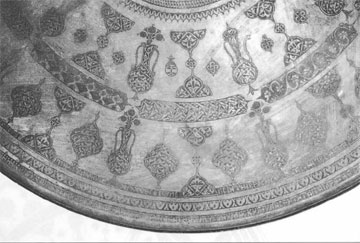 Ενεπίγραφες ταινίες και το εγχάρακτο αντρικό κεφάλι.
Συλλέκτης καταθέτει τη βιωματική περιγραφή της απόκτησης ενός ξεχωριστού αντικειμένου στα Γιάννενα. Το μπακιρένιο σινί, δίσκος με διάμετρο 1 μέτρο περίπου, διακοσμείται στην περιφέρειά του με τρεις ομόκεντρες στενές ταινίες. Την κεντρική ταινία με τα διακοσμητικά μοτίβα πλαισιώνουν δυο άλλες, ενεπίγραφες που περιέχουν το Πάτερ Ημών, με κάποιες ανορθογραφίες, και ευχές για την πόσιν και την βρῶσιν. Καταγράφεται το όνομα του τεχνίτη και η χρονολογία: Θοδωρής Θερίου 1746. Στην εσωτερική από τις δύο φαρδιές διακοσμητικές ζώνες διακρίνεται μικρό αντρικό κεφάλι, που μάλλον απεικονίζει τον τεχνίτη.
Ενεπίγραφες ταινίες και το εγχάρακτο αντρικό κεφάλι.
Συλλέκτης καταθέτει τη βιωματική περιγραφή της απόκτησης ενός ξεχωριστού αντικειμένου στα Γιάννενα. Το μπακιρένιο σινί, δίσκος με διάμετρο 1 μέτρο περίπου, διακοσμείται στην περιφέρειά του με τρεις ομόκεντρες στενές ταινίες. Την κεντρική ταινία με τα διακοσμητικά μοτίβα πλαισιώνουν δυο άλλες, ενεπίγραφες που περιέχουν το Πάτερ Ημών, με κάποιες ανορθογραφίες, και ευχές για την πόσιν και την βρῶσιν. Καταγράφεται το όνομα του τεχνίτη και η χρονολογία: Θοδωρής Θερίου 1746. Στην εσωτερική από τις δύο φαρδιές διακοσμητικές ζώνες διακρίνεται μικρό αντρικό κεφάλι, που μάλλον απεικονίζει τον τεχνίτη.
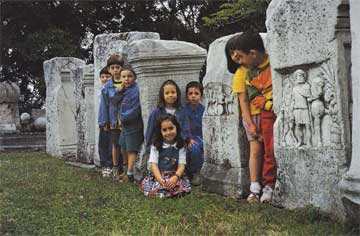 Παιχνίδι στον κήπο του Αρχαιολογικού Μουσείου Βέροιας.
Το εκπαιδευτικό πρόγραμμα του Αρχαιολογικού Μουσείου Βέροιας απευθύνεται σε μαθητές προσχολικής και πρωτοβάθμιας εκπαίδευσης επιδιώκοντας να αναπτύξει την αυτενέργειά τους. Τους προσφέρεται ένα ντόμινο, δύο παζλ και ένα φυλλάδιο . Στο παιχνίδι της αφής χρησιμοποιούνται αντίγραφα αγγείων. Μάλλινα και λινά υφάσματα τους επιτρέπουν να ντυθούν με χιτώνα και ιμάτιο ή πέπλο. Με γύψο και πλαστελίνη δημιουργούν εκμαγεία νομισμάτων. Με φυσικό πηλό μαθαίνουν πώς πλάθονται αγγεία δίχως κεραμικό τροχό. Διαφάνειες τους αποκαλύπτουν τον τρόπο παραγωγής και διακόσμησης των πήλινων αγγείων, τη σχέση του ανθρώπου με το αντικείμενο, την πρακτική της ανασκαφής και της συντήρησης. Αφού περιηγηθούν τα εκθέματα του Μουσείου, ταφικά σύνολα, επιτύμβιες στήλες και αγάλματα, τα παιδιά καλούνται να εντοπίσουν τις ομάδες και το υλικό των μουσειακών αντικειμένων.
Παιχνίδι στον κήπο του Αρχαιολογικού Μουσείου Βέροιας.
Το εκπαιδευτικό πρόγραμμα του Αρχαιολογικού Μουσείου Βέροιας απευθύνεται σε μαθητές προσχολικής και πρωτοβάθμιας εκπαίδευσης επιδιώκοντας να αναπτύξει την αυτενέργειά τους. Τους προσφέρεται ένα ντόμινο, δύο παζλ και ένα φυλλάδιο . Στο παιχνίδι της αφής χρησιμοποιούνται αντίγραφα αγγείων. Μάλλινα και λινά υφάσματα τους επιτρέπουν να ντυθούν με χιτώνα και ιμάτιο ή πέπλο. Με γύψο και πλαστελίνη δημιουργούν εκμαγεία νομισμάτων. Με φυσικό πηλό μαθαίνουν πώς πλάθονται αγγεία δίχως κεραμικό τροχό. Διαφάνειες τους αποκαλύπτουν τον τρόπο παραγωγής και διακόσμησης των πήλινων αγγείων, τη σχέση του ανθρώπου με το αντικείμενο, την πρακτική της ανασκαφής και της συντήρησης. Αφού περιηγηθούν τα εκθέματα του Μουσείου, ταφικά σύνολα, επιτύμβιες στήλες και αγάλματα, τα παιδιά καλούνται να εντοπίσουν τις ομάδες και το υλικό των μουσειακών αντικειμένων.
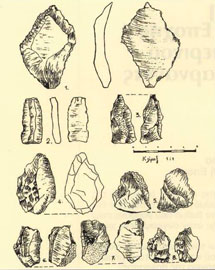 Λίθινα εργαλεία από τη σπηλιά Γαλατά και την ευρύτερη περιοχή.
Στη διάρκεια των γεωλογικών περίοδων του «Τεταρτογενούς αιώνα» (2.000.000 – 10.000 χρόνια πριν από σήμερα), του Πλειστόκαινου και του Ολόκαινου (της εποχής που διανύουμε σήμερα), σημειώθηκαν νέες γεωλογικές μεταμορφώσεις και γεωγραφικές διαφοροποιήσεις. Την Παλαιολιθική περίοδο δημιουργείται ο Κορινθιακός κόλπος. Επτάνησα, Ήπειρος, Στερεά, Θεσσαλία, Πελοπόννησος και Εύβοια ήταν ενωμένες. Δεν υπήρχε ο Αμβρακικός, ούτε ο Παγασητικός και ο Ευβοϊκός. Κρήτη και Πελοπόννησος επικοινωνούσαν ίσως με γέφυρα ξηράς. Η Αιγηίς περιελάμβανε όλη τη σημερινή Ελλάδα και τη δυτική Μικρά Ασία, ενώ η εδαφική χερσαία έκταση του Αιγαίου πελάγους συνέδεε αυτές τις περιοχές μεταξύ τους και με την Αφρική. Κατά τη διάρκεια της Μέσης και ιδίως της Νεότερης Παλαιολιθικής εποχής, τα διάσπαρτα λίθινα πελεκητά εργαλεία στο χώρο της Αιτωλίας και Ακαρνανίας (όπως αυτά που βρέθηκαν στο Σπήλαιο Γαλατά της Βαράσοβας) μαρτυρούν την έντονη παρουσία του ανθρώπου. Πρόκειται για κυνηγούς και τροφοσυλλέκτες που ζούσαν στον κάμπο ή σε σπηλιές. Το θαυμάσιο οικοσύστημα της περιοχής που υδροδοτείται από τον Αχελώο, τον Εύηνο, τον Μόρνο αλλά και από τις λίμνες της, ευνοούσε κάθε μορφή οικονομίας. Η περιοχή θα πρέπει να υπήρξε τόπος και χειμερινής εγκατάστασης των κυνηγών όταν, πριν από 20000 ως 10000 περίπου, επικράτησε στην Ελλάδα κλίμα εξαιρετικά ψυχρό. Όμως, το 8500 π.Χ. εγκαθίσταται οριστικά κλίμα εύκρατο, αρχίζει το Ολόκαινο και μάλλον λήγει η Παλαιολιθική εποχή.
Λίθινα εργαλεία από τη σπηλιά Γαλατά και την ευρύτερη περιοχή.
Στη διάρκεια των γεωλογικών περίοδων του «Τεταρτογενούς αιώνα» (2.000.000 – 10.000 χρόνια πριν από σήμερα), του Πλειστόκαινου και του Ολόκαινου (της εποχής που διανύουμε σήμερα), σημειώθηκαν νέες γεωλογικές μεταμορφώσεις και γεωγραφικές διαφοροποιήσεις. Την Παλαιολιθική περίοδο δημιουργείται ο Κορινθιακός κόλπος. Επτάνησα, Ήπειρος, Στερεά, Θεσσαλία, Πελοπόννησος και Εύβοια ήταν ενωμένες. Δεν υπήρχε ο Αμβρακικός, ούτε ο Παγασητικός και ο Ευβοϊκός. Κρήτη και Πελοπόννησος επικοινωνούσαν ίσως με γέφυρα ξηράς. Η Αιγηίς περιελάμβανε όλη τη σημερινή Ελλάδα και τη δυτική Μικρά Ασία, ενώ η εδαφική χερσαία έκταση του Αιγαίου πελάγους συνέδεε αυτές τις περιοχές μεταξύ τους και με την Αφρική. Κατά τη διάρκεια της Μέσης και ιδίως της Νεότερης Παλαιολιθικής εποχής, τα διάσπαρτα λίθινα πελεκητά εργαλεία στο χώρο της Αιτωλίας και Ακαρνανίας (όπως αυτά που βρέθηκαν στο Σπήλαιο Γαλατά της Βαράσοβας) μαρτυρούν την έντονη παρουσία του ανθρώπου. Πρόκειται για κυνηγούς και τροφοσυλλέκτες που ζούσαν στον κάμπο ή σε σπηλιές. Το θαυμάσιο οικοσύστημα της περιοχής που υδροδοτείται από τον Αχελώο, τον Εύηνο, τον Μόρνο αλλά και από τις λίμνες της, ευνοούσε κάθε μορφή οικονομίας. Η περιοχή θα πρέπει να υπήρξε τόπος και χειμερινής εγκατάστασης των κυνηγών όταν, πριν από 20000 ως 10000 περίπου, επικράτησε στην Ελλάδα κλίμα εξαιρετικά ψυχρό. Όμως, το 8500 π.Χ. εγκαθίσταται οριστικά κλίμα εύκρατο, αρχίζει το Ολόκαινο και μάλλον λήγει η Παλαιολιθική εποχή.
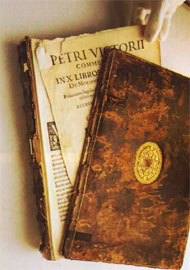 Μηχανικές φθορές στη βιβλιοδεσία και αποκόλληση φύλλων.
Μια ιστορική και σπάνια συλλογή 6.500 περίπου τόμων, με παλαίτυπα βιβλία του 16ου αιώνα και σπάνιες εκδόσεις του 17ου και του 19ου, μετέφερε από το Παρίσι στη γενέτειρά του το 1840 ο Κωνσταντίνος Νικολόπουλος. Η συλλογή στεγάζεται σήμερα στη Δημόσια Βιβλιοθήκη της Ανδρίτσαινας. Στο τρίμηνο Ιουλίου-Σεπτεμβρίου 1997, για πρώτη φορά στον ελληνικό χώρο, εφαρμόστηκε ένα πρόγραμμα για τον επιφανειακό καθαρισμό των βιβλίων και την καταγραφή και αξιολόγηση των φθορών τους. Μύκητες, που με την εύνοια της υψηλής θερμοκρασίας και της υγρασίας μπορούν να αποσαθρώσουν το χαρτί, η αποκόλληση τευχών ή φύλλων που διευκολύνουν τους επιτήδειους αναγνώστες στην αφαίρεση φύλλων με χαρακτική εικονογράφηση, είναι τα προβλήματα που παίρνουν προτεραιότητα. Για κάθε βιβλίο συντάχτηκε μηχανογραφικό δελτίο με τα καταλογογραφικά του στοιχεία και την αξιολόγηση των φθορών στις σελίδες και τη βιβλιοδεσία του.
Μηχανικές φθορές στη βιβλιοδεσία και αποκόλληση φύλλων.
Μια ιστορική και σπάνια συλλογή 6.500 περίπου τόμων, με παλαίτυπα βιβλία του 16ου αιώνα και σπάνιες εκδόσεις του 17ου και του 19ου, μετέφερε από το Παρίσι στη γενέτειρά του το 1840 ο Κωνσταντίνος Νικολόπουλος. Η συλλογή στεγάζεται σήμερα στη Δημόσια Βιβλιοθήκη της Ανδρίτσαινας. Στο τρίμηνο Ιουλίου-Σεπτεμβρίου 1997, για πρώτη φορά στον ελληνικό χώρο, εφαρμόστηκε ένα πρόγραμμα για τον επιφανειακό καθαρισμό των βιβλίων και την καταγραφή και αξιολόγηση των φθορών τους. Μύκητες, που με την εύνοια της υψηλής θερμοκρασίας και της υγρασίας μπορούν να αποσαθρώσουν το χαρτί, η αποκόλληση τευχών ή φύλλων που διευκολύνουν τους επιτήδειους αναγνώστες στην αφαίρεση φύλλων με χαρακτική εικονογράφηση, είναι τα προβλήματα που παίρνουν προτεραιότητα. Για κάθε βιβλίο συντάχτηκε μηχανογραφικό δελτίο με τα καταλογογραφικά του στοιχεία και την αξιολόγηση των φθορών στις σελίδες και τη βιβλιοδεσία του.
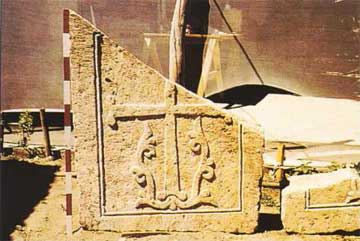 Εγχάρακτο λίθινο θραύσμα Μεσο-Βυζαντινής περιόδου από το Αμόριο.
Τον 7ο αιώνα το Αμόριο έγινε η πρωτεύουσα του Ανατολικού θέματος, προμαχώνα κατά της εξάπλωσης του Ισλάμ στους «Σκοτεινούς Αιώνες». Η θέση του πάνω σε οδική αρτηρία το έκανε πέρασμα όχι μόνο για τις στρατιές αλλά και για προσκυνητές. Το χώρο του Αμορίου ανακάλυψε ο Βρετανός περιηγητής William Hamilton το 1836, οι ανασκαφικές εργασίες όμως ξεκίνησαν μόλις το 1987. Αποκαλύφθηκε εντυπωσιακό περιφερειακό τείχος της Πρώιμης Βυζαντινής περιόδου που περιέκλειε τόσο την Άνω όσο και την Κάτω Πόλη και που καταστράφηκε πιθανόν στην πολιορκία του 838. Δεύτερο σύστημα οχυρώσεων γύρω από την Άνω Πόλη χρονολογείται στα τέλη του 7ου αιώνα. Μετά και τη δική του καταστροφή, αντικαταστάθηκε από άλλο τείχος στη Μέση Βυζαντινή περίοδο. Φούρνος αγγειοπλάστη στην Άνω Πόλη, μοναδικό δείγμα του είδους στη βυζαντινή Μ. Ασία, δείχνει ότι το Αμόριο ήταν σημαντικό εμπορικό και βιοτεχνικό κέντρο ως τον 10ο και τον 11ο αιώνα. Στην Κάτω Πόλη ανασκάφηκε εκκλησία, βασιλική με κλίτη αρχικά που, ύστερα από καταστροφική πυρκαγιά, ανοικοδομήθηκε εξ ολοκλήρου ως βασιλική με τρούλλο. Στην πρώτη της μορφή από τα τέλη του 5ου αιώνα, παρόμοια με τη μονή του Αγίου Ιωάννου του Στουδίου στην Κωνσταντινούπολη, είχε δάπεδο με μαρμαροθετήματα στο βήμα και το ναό, μαρμάρινο τέμπλο και άμβωνα. Χαρακτηριστική της Μέσης Βυζαντινής περιόδου είναι η νέα της μορφή που συγκρίνεται με την Αγία Ειρήνη στην Κωνσταντινούπολη. Με νέο μαρμάρινο δάπεδο και άμβωνα, ο ναός τοιχογραφήθηκε και η οροφή του διακοσμήθηκε με ψηφιδωτά από γυάλινες και χρυσές ψηφίδες. Η εκκλησία επέζησε ως τον 11ο ίσως και τον 12ο αιώνα.
Εγχάρακτο λίθινο θραύσμα Μεσο-Βυζαντινής περιόδου από το Αμόριο.
Τον 7ο αιώνα το Αμόριο έγινε η πρωτεύουσα του Ανατολικού θέματος, προμαχώνα κατά της εξάπλωσης του Ισλάμ στους «Σκοτεινούς Αιώνες». Η θέση του πάνω σε οδική αρτηρία το έκανε πέρασμα όχι μόνο για τις στρατιές αλλά και για προσκυνητές. Το χώρο του Αμορίου ανακάλυψε ο Βρετανός περιηγητής William Hamilton το 1836, οι ανασκαφικές εργασίες όμως ξεκίνησαν μόλις το 1987. Αποκαλύφθηκε εντυπωσιακό περιφερειακό τείχος της Πρώιμης Βυζαντινής περιόδου που περιέκλειε τόσο την Άνω όσο και την Κάτω Πόλη και που καταστράφηκε πιθανόν στην πολιορκία του 838. Δεύτερο σύστημα οχυρώσεων γύρω από την Άνω Πόλη χρονολογείται στα τέλη του 7ου αιώνα. Μετά και τη δική του καταστροφή, αντικαταστάθηκε από άλλο τείχος στη Μέση Βυζαντινή περίοδο. Φούρνος αγγειοπλάστη στην Άνω Πόλη, μοναδικό δείγμα του είδους στη βυζαντινή Μ. Ασία, δείχνει ότι το Αμόριο ήταν σημαντικό εμπορικό και βιοτεχνικό κέντρο ως τον 10ο και τον 11ο αιώνα. Στην Κάτω Πόλη ανασκάφηκε εκκλησία, βασιλική με κλίτη αρχικά που, ύστερα από καταστροφική πυρκαγιά, ανοικοδομήθηκε εξ ολοκλήρου ως βασιλική με τρούλλο. Στην πρώτη της μορφή από τα τέλη του 5ου αιώνα, παρόμοια με τη μονή του Αγίου Ιωάννου του Στουδίου στην Κωνσταντινούπολη, είχε δάπεδο με μαρμαροθετήματα στο βήμα και το ναό, μαρμάρινο τέμπλο και άμβωνα. Χαρακτηριστική της Μέσης Βυζαντινής περιόδου είναι η νέα της μορφή που συγκρίνεται με την Αγία Ειρήνη στην Κωνσταντινούπολη. Με νέο μαρμάρινο δάπεδο και άμβωνα, ο ναός τοιχογραφήθηκε και η οροφή του διακοσμήθηκε με ψηφιδωτά από γυάλινες και χρυσές ψηφίδες. Η εκκλησία επέζησε ως τον 11ο ίσως και τον 12ο αιώνα.
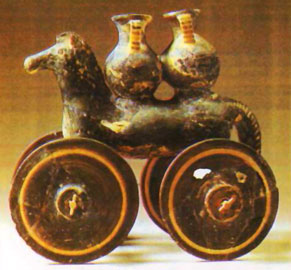 Πήλινο ομοίωμα ιππαρίου με τροχούς (παιχνίδι) από το Λευκαντί.
Τα ευρήματα στο Μουσείο, που εγκαινιάστηκε το 1991, εκτίθενται κατά χρονολογική σειρά, από την Προϊστορική (Λευκαντί, Παλιόχωρα Αμαρύνθου, Μαγούλα) ως τη Ρωμαϊκή περίοδο. Στους γεωμετρικούς χρόνους της ακμής, όταν Ερετριείς και Χαλκιδείς πρωτοστατούσαν στην ίδρυση αποικιών, η Ερέτρια έχει να επιδείξει μεγάλα αψιδωτά ή ορθογώνια κτίσματα. Λείψανα ναού του 8ου αιώνα π.Χ. αποκαλύφθηκαν κάτω από το ναό του Δαφνηφόρου Απόλλωνος που χρονολογείται στον 6ο αιώνα. Από το δυτικό του αέτωμα σώζεται το γνωστό σύμπλεγμα του Θησέα και της Αντιόπης. Κυρίαρχη ήταν η λατρεία του Απόλλωνα, προστάτη της πόλης, αλλά και της Άρτεμης που το ιερό της δεν έχει ακόμη βρεθεί. Από τους άλλους θεούς ξεχωρίζει ο Ναύστολος, προστάτης των διαρκώς εν πλω Ερετριέων. Εκτίθενται ταφικοί και παναθηναϊκοί αμφορείς καθώς και ό,τι απέμεινε από τον μακεδονικού τύπου τάφο των Ερώτων του τέλους του 4ου αιώνα π.Χ. Σύντομα θα εκτεθεί θησαυρός από 118 αργυρά αττικά νομίσματα.
Πήλινο ομοίωμα ιππαρίου με τροχούς (παιχνίδι) από το Λευκαντί.
Τα ευρήματα στο Μουσείο, που εγκαινιάστηκε το 1991, εκτίθενται κατά χρονολογική σειρά, από την Προϊστορική (Λευκαντί, Παλιόχωρα Αμαρύνθου, Μαγούλα) ως τη Ρωμαϊκή περίοδο. Στους γεωμετρικούς χρόνους της ακμής, όταν Ερετριείς και Χαλκιδείς πρωτοστατούσαν στην ίδρυση αποικιών, η Ερέτρια έχει να επιδείξει μεγάλα αψιδωτά ή ορθογώνια κτίσματα. Λείψανα ναού του 8ου αιώνα π.Χ. αποκαλύφθηκαν κάτω από το ναό του Δαφνηφόρου Απόλλωνος που χρονολογείται στον 6ο αιώνα. Από το δυτικό του αέτωμα σώζεται το γνωστό σύμπλεγμα του Θησέα και της Αντιόπης. Κυρίαρχη ήταν η λατρεία του Απόλλωνα, προστάτη της πόλης, αλλά και της Άρτεμης που το ιερό της δεν έχει ακόμη βρεθεί. Από τους άλλους θεούς ξεχωρίζει ο Ναύστολος, προστάτης των διαρκώς εν πλω Ερετριέων. Εκτίθενται ταφικοί και παναθηναϊκοί αμφορείς καθώς και ό,τι απέμεινε από τον μακεδονικού τύπου τάφο των Ερώτων του τέλους του 4ου αιώνα π.Χ. Σύντομα θα εκτεθεί θησαυρός από 118 αργυρά αττικά νομίσματα.
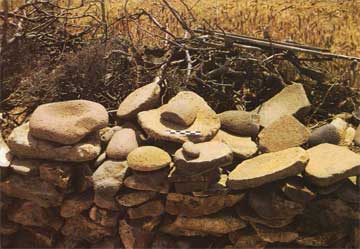 Λίθινα εργαλεία από τον Αετό στα Κοντίσια Άγρας.
Στη διαμόρφωση του οικιστικού πλέγματος της Λέσβου καίριο ρόλο έπαιξαν οι κόλποι της Γέρας και της Καλλονής. Κατά τους ιστορικούς, προχριστιανικούς χρόνους, ο κόλπος της Γέρας ανήκε στην επικράτεια της Μυτιλήνης, ενώ τον Κόλπο της Καλλονής νέμονταν όλες οι άλλες πόλεις-κράτη, η Πύρρα, η Αρίσβη, η Άντισα και η Ερεσός. Η περιοχή του κόλπου της Καλλονής αποτελείται από ηφαιστειογενή πετρώματα της τριτογενούς περιόδου. Τόσο οι αποθέσεις πυριτόλιθου όσο και τα αποθέματα των λατομείων θεωρούνται σημαντικά για τα δεδομένα της Νεολιθικής Εποχής και της Πρώιμης Χαλκοκρατίας. Για τον εντοπισμό νέων θέσεων της τελευταίας αυτής περιόδου ξεκίνησε την έρευνά του ο συγραφέας. Παρουσιάζονται οι οικισμοί στις θέσεις: Χαλακιές Πολυχνίτου, Κουρτήρ Λισβορίου, Προφήτης Ηλίας - Κατάπυργος Λισβορίου, στο λόφο της Αχλαδερής, στο λόφο του Προφήτη Ηλία της Αγίας Παρασκευής, στο ύψωμα Μόσυνα της Αγίας Παρασκευής, στο λόφο Παλιόκαστρο, στο ύψωμα Σκεπαστός, στο λόφο Κατσαράς, στο ύψωμα της Ξηροκαστρινής, στο λόφο του «Άγιου Λια», στο ύψωμα Καστρέλλι Παρακοίλων, στην Αποθήκα, στην κοιλάδα των Μακάρων, στην κοιλάδα Κοντίσια και στους λόφους Κάικο και Χάλικα.
Λίθινα εργαλεία από τον Αετό στα Κοντίσια Άγρας.
Στη διαμόρφωση του οικιστικού πλέγματος της Λέσβου καίριο ρόλο έπαιξαν οι κόλποι της Γέρας και της Καλλονής. Κατά τους ιστορικούς, προχριστιανικούς χρόνους, ο κόλπος της Γέρας ανήκε στην επικράτεια της Μυτιλήνης, ενώ τον Κόλπο της Καλλονής νέμονταν όλες οι άλλες πόλεις-κράτη, η Πύρρα, η Αρίσβη, η Άντισα και η Ερεσός. Η περιοχή του κόλπου της Καλλονής αποτελείται από ηφαιστειογενή πετρώματα της τριτογενούς περιόδου. Τόσο οι αποθέσεις πυριτόλιθου όσο και τα αποθέματα των λατομείων θεωρούνται σημαντικά για τα δεδομένα της Νεολιθικής Εποχής και της Πρώιμης Χαλκοκρατίας. Για τον εντοπισμό νέων θέσεων της τελευταίας αυτής περιόδου ξεκίνησε την έρευνά του ο συγραφέας. Παρουσιάζονται οι οικισμοί στις θέσεις: Χαλακιές Πολυχνίτου, Κουρτήρ Λισβορίου, Προφήτης Ηλίας - Κατάπυργος Λισβορίου, στο λόφο της Αχλαδερής, στο λόφο του Προφήτη Ηλία της Αγίας Παρασκευής, στο ύψωμα Μόσυνα της Αγίας Παρασκευής, στο λόφο Παλιόκαστρο, στο ύψωμα Σκεπαστός, στο λόφο Κατσαράς, στο ύψωμα της Ξηροκαστρινής, στο λόφο του «Άγιου Λια», στο ύψωμα Καστρέλλι Παρακοίλων, στην Αποθήκα, στην κοιλάδα των Μακάρων, στην κοιλάδα Κοντίσια και στους λόφους Κάικο και Χάλικα.
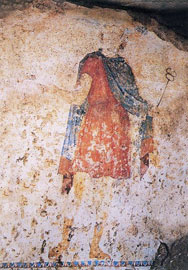 Ο Ερμής στον τάφο της Κρίσεως, στα Λευκάδια Νάουσας.
Η παράθεση είναι ενδεικτική. Για το πλήρες κείμενο της στήλης, δείτε το συνημμένο αρχείο pdf.
Ο Ερμής στον τάφο της Κρίσεως, στα Λευκάδια Νάουσας.
Η παράθεση είναι ενδεικτική. Για το πλήρες κείμενο της στήλης, δείτε το συνημμένο αρχείο pdf.
Ειδήσεις
Στην Κωνσταντινούπολη ήρθαν στο φως εντυπωσιακές τοιχογραφίες από το Μεγάλο Παλάτι - Ναυάγιο στον Αργολικό αποκαλύπτει θαλάσσιες διασυνδέσεις την εποχή του Τρωικού πολέμου - Στο Διαδίκτυο μπορούμε τώρα να δούμε τα κατεστραμμένα μνημεία της Πόλης - Από 7 κυβικά μέτρα μπετόν θα απαλλαγεί ο Παρθενώνας - Στο πωλητήριο του Μουσείου Καβάλας διατίθενται αντίγραφα με πιστοποιητικό της Αρχαιολογικής ΥπηρεσίαςΣυνέδρια
Σε πόλεις της Λιγηρίας (Liguria) οργανώθηκε το Η΄ Εθνικό Ιταλικό Συνέδριο Χριστιανικής Αρχαιολογίας, 21-26 Σεπτεμβρίου 1998 - Το έγχορδο νάβλα παρουσίασε ο καθ. Δ. Παντερμαλής σε διεθνές μουσικολογικό συνέδριο στη Θεσσαλονίκη - Διεθνές συνέδριο για την πλαστική των Κυκλάδων στην αρχαϊκή εποχή έγινε στην Αθήνα, 7-10 Σεπτεμβρίου 1998Διαλέξεις
«Όπερα και αρχαία τραγωδία» ήταν το θέμα διάλεξης που έδωσε ο γιατρός Φώτης Παπαθανασίου στο Μουσείο Κυκλαδικής Τέχνης (5.10.1998) - Η Αμερικανική Σχολή Κλασικών Σπουδών ανακοίνωσε το πρόγραμμα των διαλέξεων για την περίοδο 1998-99Εκθέσεις
«Η ζωή γύρω από μια ανασκαφή» (24.10-14.11.1998) είναι ο τίτλος της φωτογραφικής έκθεσης που παρουσιάζεται στο Ναύπλιο και αφορά τη δραστηριότητα των Σουηδών αρχαιολόγων στην Αργολίδα - «Ο Haller von Hallerstein στην Ελλάδα, 1810-1817» είναι ο τίτλος έκθεσης που θα πραγματοποιήσει το Ινστιτούτο της Δανίας στην ΑθήναΒιβλία
Βασίλειος Χ. Πετράκος, Οι επιγραφές του Ωρωπού, Η εν Αθήναις Αρχαιολογική Εταιρεία, Αθήνα 1998 - René Ginouvés, Dictionnaire Méthodique de l‘Architecture Grecque et Romaine III, École Française d‘Athènes et de Rome - André Bernard, Έλληνες Μάγοι, Βιβλιοπωλείο της Εστίας, Αθήνα 1997 - Δέσποινα Δανιηλίδου, Η οκτώσχημη ασπίδα στο Αιγαίο της 2ης π.Χ. χιλιετίας, Ακαδημία Αθηνών - Κέντρο Ερεύνης Αρχαιότητας, Αθήνα 1998 - Edmond Pognon, Η καθημερινή ζωή το έτος 1000, Παπαδήμα, Αθήνα 1998
 Το λογότυπο της στήλης
Στο προηγούμενο τεύχος παρουσιάστηκε ο τομέας της εκπαίδευσης στο πλαίσιο ερευνητικής δραστηριότητας που συμπληρώνεται εδώ με το The Humanities Advanced Technology and Information Institute (HATII) στο Πανεπιστήμιο της Γλασκώβης.
ΙΙ. Εξειδικευμένα διδακτικά προγράμματα
1. Department of Archaeology: MSc in Archaeological Computing στο Πανεπιστήμιο του Southampton
2. Department of Archaeology: MSc in Archaeological Information Systems στο Πανεπιστήμιο του York.
III. Μεταπτυχιακές σπουδές στην Ελλάδα
1. Πανεπιστήμιο Ιωαννίνων, Τμήματα Ιστορίας-Αρχαιολογίας και Φιλολογίας
2. Πολυτεχνική Σχολή Ξάνθης, Ινστιτούτο Πολιτιστικής και Εκπαιδευτικής Τεχνολογίας (ΙΠΕΤ)
3. Πανεπιστήμιο Κρήτης, «Προηγμένες μέθοδοι και συστήματα πληροφοριών στην Αρχαιολογία: έρευνα και διαχείριση των υλικών καταλοίπων των πολιτισμών του Αιγαίου». Το πρωτοποριακό διεπιστημονικό πρόγραμμα του Πανεπιστημίου Κρήτης είναι και το μόνο με συστηματική διδασκαλία.
Το λογότυπο της στήλης
Στο προηγούμενο τεύχος παρουσιάστηκε ο τομέας της εκπαίδευσης στο πλαίσιο ερευνητικής δραστηριότητας που συμπληρώνεται εδώ με το The Humanities Advanced Technology and Information Institute (HATII) στο Πανεπιστήμιο της Γλασκώβης.
ΙΙ. Εξειδικευμένα διδακτικά προγράμματα
1. Department of Archaeology: MSc in Archaeological Computing στο Πανεπιστήμιο του Southampton
2. Department of Archaeology: MSc in Archaeological Information Systems στο Πανεπιστήμιο του York.
III. Μεταπτυχιακές σπουδές στην Ελλάδα
1. Πανεπιστήμιο Ιωαννίνων, Τμήματα Ιστορίας-Αρχαιολογίας και Φιλολογίας
2. Πολυτεχνική Σχολή Ξάνθης, Ινστιτούτο Πολιτιστικής και Εκπαιδευτικής Τεχνολογίας (ΙΠΕΤ)
3. Πανεπιστήμιο Κρήτης, «Προηγμένες μέθοδοι και συστήματα πληροφοριών στην Αρχαιολογία: έρευνα και διαχείριση των υλικών καταλοίπων των πολιτισμών του Αιγαίου». Το πρωτοποριακό διεπιστημονικό πρόγραμμα του Πανεπιστημίου Κρήτης είναι και το μόνο με συστηματική διδασκαλία.
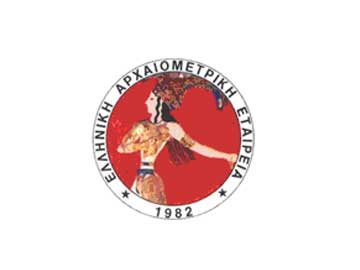 Το λογότυπο της Ελληνικής Αρχαιομετρικής Εταιρείας
Η παράθεση είναι ενδεικτική. Για το πλήρες κείμενο της στήλης, δείτε το συνημμένο αρχείο pdf.
- «Σπήλαιο Θεόπετρας - Δώδεκα Χρόνια Ανασκαφών και Ερευνας» ήταν το θέμα διεθνούς συνεδρίου που έγινε στα Τρίκαλα στις 6 και 7 Νοεμβρίου 1998
- Το Ίδρυμα «Αναστάσιος Γ. Λεβέντης» και ο καθ. Βάσος Καραγιώργης οργάνωσαν στις 29 και 30 Οκτωβρίου 1998 διεθνές συνέδριο με θέμα «Λευκόχριστη Κεραμική»
- Ο τομέας Αρχαιολογίας και Ιστορίας της Τέχνης του Α.Π.Θ. διοργάνωσε στη μνήμη του Δ.Ρ. Θεοχάρη τριήμερο συμπόσιο (26-28.11.1998) με θέμα: «Η προϊστορική έρευνα στην Ελλάδα και οι προοπτικές της: Θεωρητικοί και μεθοδολογικοί προβληματισμοί»
- Κάλεσμα για τη συντήρηση και ανάδειξη των μεταλλευτικών στοών του Αγ. Κηρύκου απευθύνει από την Ικαρία η «Πρωτοβουλία για τη Διατήρηση Μνημείων Μεταλλευτικής Δραστηριότητας»
- Το Πανεπιστήμιο Κρήτης εγκαινίασε διατμηματικό μεταπτυχιακό πρόγραμμα σπουδών με τίτλο «Συστήματα Πολιτισμικών Πληροφοριών και Διαχείρισης της Πολιτισμικής Κληρονομιάς»
Το λογότυπο της Ελληνικής Αρχαιομετρικής Εταιρείας
Η παράθεση είναι ενδεικτική. Για το πλήρες κείμενο της στήλης, δείτε το συνημμένο αρχείο pdf.
- «Σπήλαιο Θεόπετρας - Δώδεκα Χρόνια Ανασκαφών και Ερευνας» ήταν το θέμα διεθνούς συνεδρίου που έγινε στα Τρίκαλα στις 6 και 7 Νοεμβρίου 1998
- Το Ίδρυμα «Αναστάσιος Γ. Λεβέντης» και ο καθ. Βάσος Καραγιώργης οργάνωσαν στις 29 και 30 Οκτωβρίου 1998 διεθνές συνέδριο με θέμα «Λευκόχριστη Κεραμική»
- Ο τομέας Αρχαιολογίας και Ιστορίας της Τέχνης του Α.Π.Θ. διοργάνωσε στη μνήμη του Δ.Ρ. Θεοχάρη τριήμερο συμπόσιο (26-28.11.1998) με θέμα: «Η προϊστορική έρευνα στην Ελλάδα και οι προοπτικές της: Θεωρητικοί και μεθοδολογικοί προβληματισμοί»
- Κάλεσμα για τη συντήρηση και ανάδειξη των μεταλλευτικών στοών του Αγ. Κηρύκου απευθύνει από την Ικαρία η «Πρωτοβουλία για τη Διατήρηση Μνημείων Μεταλλευτικής Δραστηριότητας»
- Το Πανεπιστήμιο Κρήτης εγκαινίασε διατμηματικό μεταπτυχιακό πρόγραμμα σπουδών με τίτλο «Συστήματα Πολιτισμικών Πληροφοριών και Διαχείρισης της Πολιτισμικής Κληρονομιάς»
Unusual but also interesting reliefs are carved on the rocks of ancient Philippoi. They can be interpreted as votive reliefs honouring a deity or a cult, in memory of or part of a ritual for deceased persons. However, these rock reliefs are also remarkable for their great number. They date from the end of the second and the beginning of the third century AD and seem to convey a peculiar mixture of local and popular art, unknown in any other part of the then Greek section of the Roman Empire.
In the area of the University of Agronomy of Athens on Hiera Odos lie the architectural remnants of the Voevode of Athens Hatzi-Ali's mansion.These ruins, along with two buildings in the early style of Classicism of the Ottonian period and the perennial trees of the first Botanical Gardens of Greece, form an important part of the historical town-plan in modern Athens. The Ottonian buildings have been restored relatively recently and are presently being used by the university. The restoration and promotion of the historic gardens and Turkish remnants will offer Athens one more historic place of reference, in which elements of architecture and gardening of the 18th and 19th centuries will he harmoniously combined. The twenty-two years of Hatzi-Ali Hasseki's tyranny (1774-1776) are characterized, among others, by the avid appropriation of foreign property, which the Athenians were forced to cultivate. After the liberation of Athens from Turkish rule in 1833, the entire Hesseki property passed to the Greek state. Since 1838 the estate was gradually turned into a Botanical Gardens, then to an Agricultural University and finally to the Agronomy University of Athens. From the former Hatzi-Ali's mansion, only a part of the main wing has survived. This tower-like sructure had a series of embrasures instead of windows on the ground floor, while its entrance, which was on the first floor, was accessible through a suspension bridge. The so-called "Hasseki's fountain", dating from the 18th century, is still preserved intact to the east of the building, one meter below the present level οf Hiera Odos. The Old Greenhouse, although of different provenance, is another important feature of the estate. It has recently been furnished with a new iron framework, a replica of the old one, and with modern equipment.
Adjacent to the premises of the Agronomy University of Athens is an area of 25 acres, which is presently being used as a depot by the Organization of Public Transportation of Athens. The future transfer of the OPTA elsewhere, according to the Regulating Plan of the capital, offered the initiative for the working out of a complete plan of reformation and rehabilitation of the specific area. The two main features of the Votanikos depot are: an open-air area, which today appears as a large asphalted surface; and an extensive block of buildings. The replanning of the entire space and the promotion of the existing buildings which will thus obtain a new usage and function, is the target of this article. The general renovation of all building installations and their equipment with modern technology must be considered as a priority. The promotion of the large, open asphalted area seems rather problematic, but it can be facilitated through the division of the area according to a specific double net. Thus, a perfect traffic network can be created —with roads, pedestrian roads and squares — , and the "Botanical (Votanicos) Gardens" can be revived.
In the ten years of his reign Alexander the Great crushed powerful armies, annihilated great kingdoms and overwhelmed the ancient world with his presence; a strange and charismatic personality, as if he had come from another world, he was worshipped, even during his lifetime, as the offspring of a god. In all the countries he conquered, Alexander introduced and established new ways of organization and administration. Greek civilization reached these people as well as the Greek language.
The first stage of restoration of the rare books of the Public Library of Andritsaina commenced and was completed in the period between July and September of 1997. The nucleus of the Public Library of Andritsaina is the Collection of Konstantinos Nikolopoulos (1786-1841), who, just before his most unfortunate death, transferred his personal library from Paris, where he had compiled it, to Andritsaina, his native town. The donation,of about 6,500 volumes, comprises quite many incunabula and early editions of the 16th century as well as rare editions of the 17th and 19th century. The adventures and trials that the collection has undergone since 1840, when it was transferred to Andritsaina, were so many, that the need for its cleaning and care was urgent. Therefore, the first stage of work, in a long-term program of restoration, started immediately. Besides the cleaning of the books, a general estimate and recording of their damages had to be made, so that the future replacement of damaged books could be systematically carried out. To serve the purpose, a brief and concise form was prepared by the team of restorers, which was filled in after the cleaning of each book. The next stage included the processing by a computer of all the information included in the forms. The restoration of a book, regardless of its size, is an extremely expensive and time-consuming enterprise. Therefore,in the case of printed books, their rarity and historical importance must be taken into consideration, regardless of price, before they are restored.
Amorion figures prominently in the pages of Byzantine history throughout the period between the seventh and twelfth century. Due to its location on one of the major highways across Asia Minor, linking Constantinople with the eastern frontier and the Arab caliphate, Amorion was a key stronghold in the defence of Byzantine territory. According to one Arab source, it was regarded as the third largest city, after Constantinople and Thessaloniki, in the whole of the Byzantine Empire. It survived well into the eleventh century and perhaps even into the twelfth, before it was finally abandoned and left to fall gradually into ruin and decay during the Turkish period. The site of Amorion was first rediscovered by the British scholar and traveller Willian Hamilton in 1836. It has, however, largely been neglected as an archaeological site, and work only began there in 1987 under the direction of the late Professor R. Martin Hamson. The results of the past 10 years' work have shown that the site is a valuable storehouse of material for the study of Byzantine art history and archaeology. To date, the excavations are concentrated mainly on the military and ecclesiastical aspects of the site, although it is hoped in coming seasons to gain much more information about the nature of Byzantine domestic architecture and about the size and layout of the city, especially during the crucial years of the Dark Ages. The excavations have helped enormously in shedding new light on the history of Amorion, a large site covering some 70 hectars of land, by augmenting considerably the relevant documentary evidence. However, much has yet to be learnt, and it is to be hoped that sufficient funds will be raised in order to allow the excavations to continue into the twenty-first century. Amorion deserves to be given the chance to reveal more of its unrivalled treasures and so to take its rightful place in the history of Byzantium and in the archaeology of Asia Minor.
Accidentally, if we believe in divine Providence, the author bought a bronze tray and, after cleaning it he found out that not only was the prayer "Our Father which art in heaven ..." and the signature of the craftsman legible on its rim, but also that a male figure, the craftsman or owner of the tray, was represented on it.
The geographical peculiarity of Lesbos island has determined its history and destiny. The two gulfs, those of Gera and Kalloni, have played a predominant role in the formation of the urban tissue of the island. From a geological point of view, Kalloni Bay belongs to a tertiary volcanic formation and has important flint stone deposits, which supplied the material for vast exploitation during the Neolithic and the Early Bronze Age. This article presents the sites of the Early Bronze Ageare that located in the area of the Kalloni Bay and stresses the importance of the Skepasto site, which is equal to that of Kourtir.
An attempt to interpret the mythological Flood of Inachos and the heavy drought in Argolid is presented in this article, on the basis of available palaeogeographical, palaeoclimatological and geo-archaeological data in general. The genealogy of Argolid begins with Inachos, Phoroneus and Io and continues with their descendants, Epaphos, Libye, Aegyptos, Danaos, etc. By combining the geo-archaeological data, that is the obvious alluvial deposits of the Protohelladic I and II period, marine regression and the coastal change of the Argolid plain, also by examining the myths concerning the river-god Inachos and his descendants who tried to restore "order"to Argolid after a series of natural disasters, we can only assume that the various "incidents" of the "mythological" narration could have happened during the first half of the third millennium BC. The erection of the pyramidal structures in Argolid - at Hellinikon of Argos and at Lygourio— coincides with the end of this era, as has been ascertained by their recent nuclear dating. The attempt to interpret myths is undoubtedly a daring and risky venture. However, the authors' intention is to present recent data and alternative hypotheses, which seem to meet many demands of the interdisciplinary fields, at least where the mythological cycle of Argolid is concerned.
The phenomenon of benefaction, as it developed during the Hellenistic and Roman period, created the circumstances for the entrance, although restricted, of women into public life. The fact that the prerequisites for public office, which had already lost its political dimension, were only economic, allowed women to enter certain honorary offices, in those parts of the Greek world where tradition permitted it (Asia Minor, the Aegean). The vocabulary used in honorary inscriptions emphasized the relationship between parent and child, a direct reference to the relationship between benefactor and city .Benefactresses were equally honoured and enjoyed the same privileges as their male counterparts, although in women's case their virtues as wives and mothers were stressed , so that the ideology of women's confinement to the home could be preserved. The Roman law was against this innovation, therefore the phenomenon of beneficence was not developed in Italy and in the provinces of the West, where benefactors were honoured only as individuals, as opposed to the eastern part of the Roman Empire, where benefaction flourished until the destruction of the urban way of life by barbaric invasions in the late third century AD.
In Greece, the educational and communicational role played by museums is ineffective, especially where those children who must be approached in a special way are concerned. Recently certain Greek museums took the initiative to introduce educational programes for children. Their target is to transform the museum into a place of education, recreation and culture. This article proposes that the Archaeological Museum of Veroia should play a role in the education of children in the last three grades of elementary school. Adoption of the proposal will enable the children to approach everyday life, the artefacts and asthetics of the periods exhibited in the museum and, inspired by them, become true to themselves.
The presence, role and activity of women in Christian Byzantium are directly connected with the ethical code of values of the Church, the general ideology of the period, and the institutions and structure of the society, which was clearly a patriarchal one. The dominant role of men in the family and their easier access to education, political power and production made women inferior. The role played by women in the society and economic life of Byzantium depended on their education, temperament and social status. However, according to historical sources, there were some women, mainly of the upper class, who managed to break the wall of insolation and silence and play an important role in the fortunes of the state.
The ecological conditions of ancient Aetolia and Akarnania created an ideal ecosystem for their Palaeolithic inhabitants, who organized their lives either in the plains or in accessible caves. In any case, their settlements were situated close to sites which could serve their hunting activities and supply them, at the same time, with the necessary material for the organization of their dwellings that functioned both as shelters and workshops. Consequently, in the Middle (100,000-33,000) and especially during the Upper Palaeolithic age (33,0000-10,000), the presence and activity of man is intense in the area of the present Aetolia and Akarnania county, on selected sites, which are close to springs or near the two big rivers Acheloos and Evenos or by lakes, ravinges and swamps, and are crossed by animals or frequented by them. This assumption, that Palaeolithic sites are located in Aetolia and Akarnania -Galatas, Kryoneri, Agrinio, Hagios Konstantinos, Diamanteika, Lyssimacheia, Zapanti, Kouvaras, Krikelo, Hagios Nikolaos— this assumption is supported by the fact that all these parts are scattered with stone tools and by-products of Palaeolithic form. Such a remarkable accummulation of Palaeolithic finds leads to the conclusion that Palaeolithic men, propably hunters,encamped in these areas.
Modern archaeological literature about the Mycenaean era begins with the telegram Schliemann sent to King George on November 28, 1876, in which he announced the discovery of the royal tombs at Mycenae. Schliemann was proud of his excellent knowledge of Homeric geography, which presumably guided his mattock with such success. However, as a matter of fact, it was Pausanias' description, not Homer's that led him to Mycenae, as he confesses in the same telegram. It should be stressed here that there is a huge gap between the Homeric and the political geography of late antiquity. The Homeric poems supply a geographical and archaeological picture, which, according to the standards of studies in Greek Prehistory, is quite antiquated. The political geography presented in these epics, although real and accurate at the time of their composition, was already dated by the time of the wide dissemination of the Homeric poems and quite misleading, since many place-names had meanwhile fallen into oblivion. The modern debate concerning the location of the Homeric Ithaka gives us only a faint idea of what the situation was like in antiquity. We have no guarantee that the Greeks of historic antiquity ascribed Homeric place-names to the correct locations, a mistake that was perpertuated thereafter, a fallacy, that is, that first of all applies to Mycenae for the following, at least three, reasons: a. Mycenae remained totally or almost uninhabited for long intervals between the end of the Mycenaean and the beginning of historic antiquity. b. Ancient Greek authors admit that most of the cities of the putative kingdom or Agamemnon had different names before they were given the Homeric ones. c. There is no reference in the Homeric epics that the kingdom of Agamemnon, and consequently its capital, was located in the north-eastern Peloponnese. Before the eighth century B.C. there is no evidence whatsoever either in the epics or anywhere else that connects Mycenae with Argolida. Furthermore, philological and archaeological data seem to agree that on the one hand, the ancient Greeks gave Homeric names to cities of the northern Peloponnese, in replacement of the existing ones, and that on the other, we possess historical and archaeological information concerning important place-names in the south Peloponnese, which are identical with those of the kingdom of Agamemnon. The Homeric Mycenae, a coastal and propably unwalled city, should be sought west of the Cape of Maleas, in the Bay of Neapolis (Pavlopetri?) or Plytra, locations which both controlled the two main sea routes connecting the Aegean with the Ionian Sea and also Greece with Crete and Egypt. Finally, we must decide, whether the time has come to put things, or rather names, straight, reconsidering, at the same time, the entire Homeric question as well as the question of putting Greek Pre- and Proto-history on an entirely new basis.
The world of art is where symbols are consciously and specifically generated. Since we are here investigating the symbolism and symbols which convey to us the concept of Woman, instead of an essay, it would be elucidating to look into certain important symbolic aspects of woman, as conceived and expressed by artists throughout the centuries. In this case, however, we should not simply consider the aesthetic or historical aspects of the works of art, but we should focus on their symbolic content and then wonder what influenced and inspired the artists of each period in their symbolic and notional representation of Woman? How and in which way do these works concern us today? Finally, what are the allusions, thoughts and notions that they bring to the modern spectator and what for?
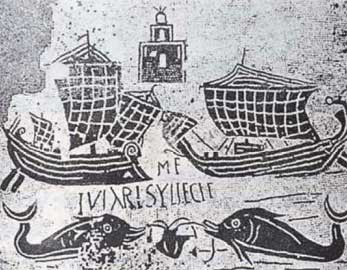 Την εποχή του Ιούλιου Καίσαρα τα θαλασσινά ταξίδια ήταν πια ασφαλή.
Την εποχή του Ιούλιου Καίσαρα, η «Ρωμαϊκή ειρήνη» επιτρέπει ασφαλή ταξίδια στην αυτοκρατορία σε στεριά και θάλασσα. Αν και οι πειρατές έχουν κατατροπωθεί, οι καιρικές συνθήκες περιορίζουν τα θαλασσινά ταξίδια στους μήνες Μάιο με Οκτώβριο. Στη στεριά, το προσεγμένο οδικό δίκτυο και τα πανδοχεία που υποδέχονται τους ταξιδιώτες και τα άλογά τους, ενθαρρύνουν τους καλλιεργημένους Ρωμαίους να ταξιδέψουν και να διηγηθούν τις εντυπώσεις τους. Φαντάσου πως είσαι ένας από αυτούς και θέλεις να περιηγηθείς τη Μεσόγειο. Ποια είναι τα αξιοθέατα που πρέπει οπωσδήποτε να επισκεφθείς; Για να οργανώσεις το ταξίδι σου πρέπει να ξέρεις ποια είναι τα «Επτά θαύματα του κόσμου».
Την εποχή του Ιούλιου Καίσαρα τα θαλασσινά ταξίδια ήταν πια ασφαλή.
Την εποχή του Ιούλιου Καίσαρα, η «Ρωμαϊκή ειρήνη» επιτρέπει ασφαλή ταξίδια στην αυτοκρατορία σε στεριά και θάλασσα. Αν και οι πειρατές έχουν κατατροπωθεί, οι καιρικές συνθήκες περιορίζουν τα θαλασσινά ταξίδια στους μήνες Μάιο με Οκτώβριο. Στη στεριά, το προσεγμένο οδικό δίκτυο και τα πανδοχεία που υποδέχονται τους ταξιδιώτες και τα άλογά τους, ενθαρρύνουν τους καλλιεργημένους Ρωμαίους να ταξιδέψουν και να διηγηθούν τις εντυπώσεις τους. Φαντάσου πως είσαι ένας από αυτούς και θέλεις να περιηγηθείς τη Μεσόγειο. Ποια είναι τα αξιοθέατα που πρέπει οπωσδήποτε να επισκεφθείς; Για να οργανώσεις το ταξίδι σου πρέπει να ξέρεις ποια είναι τα «Επτά θαύματα του κόσμου».